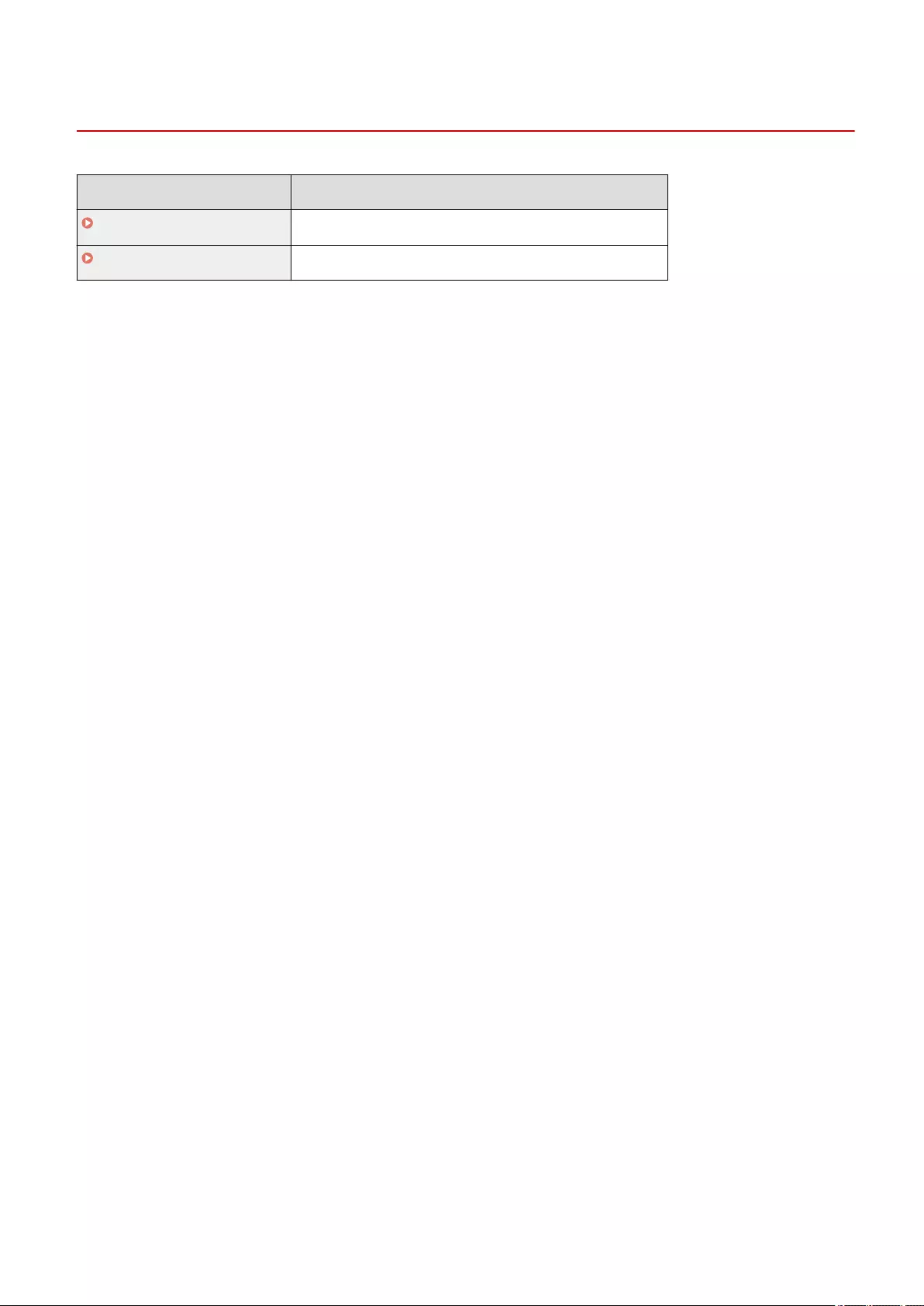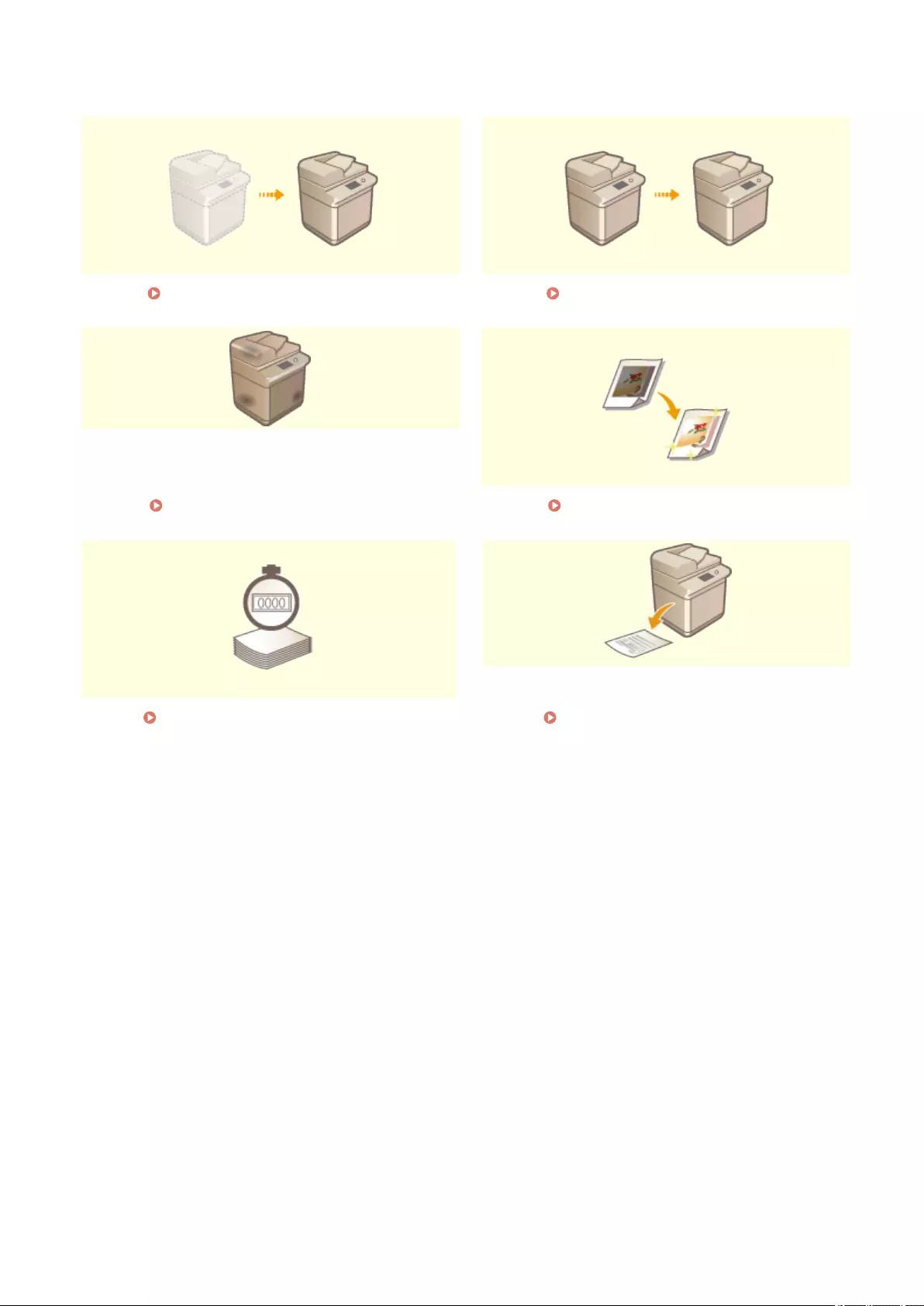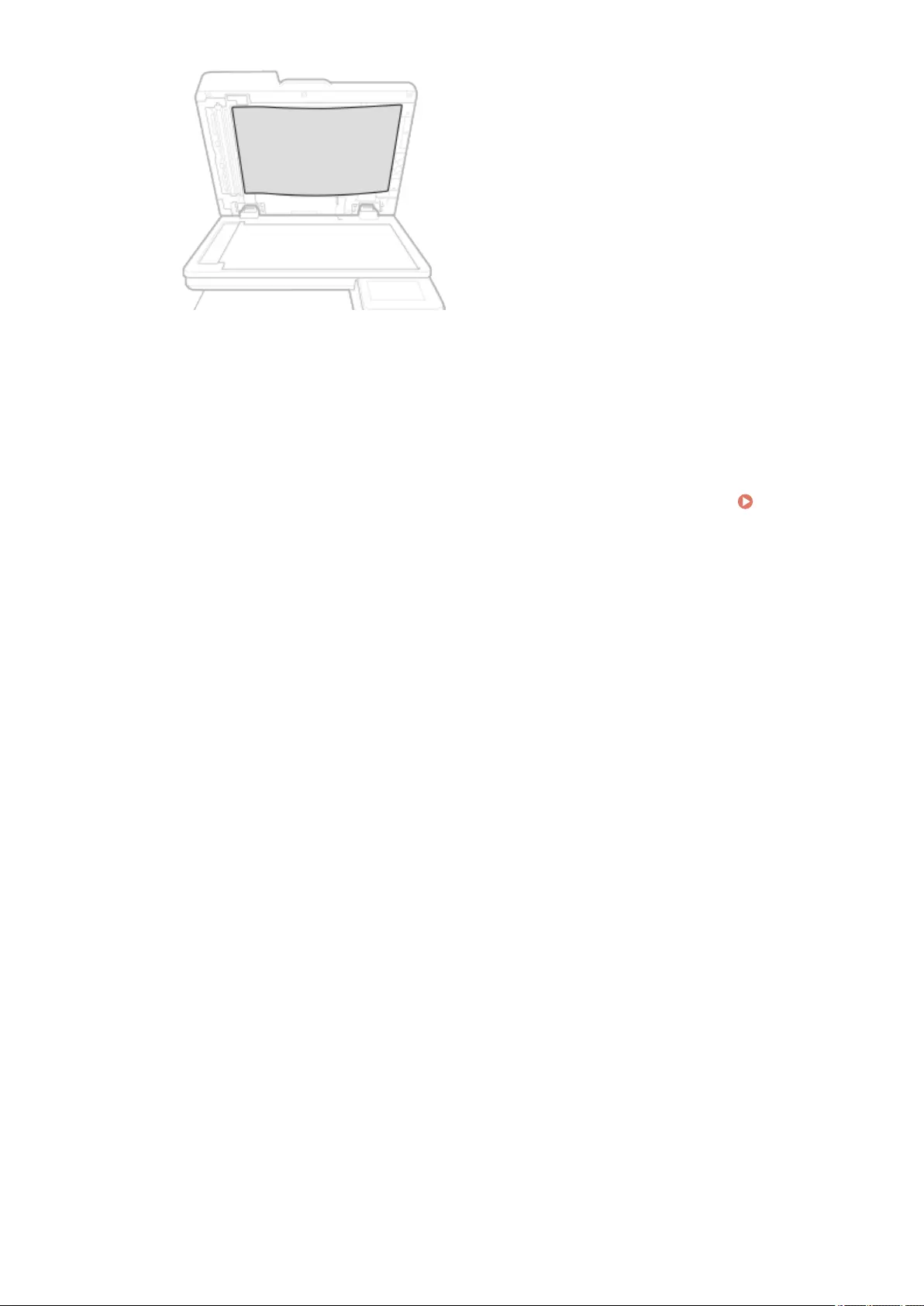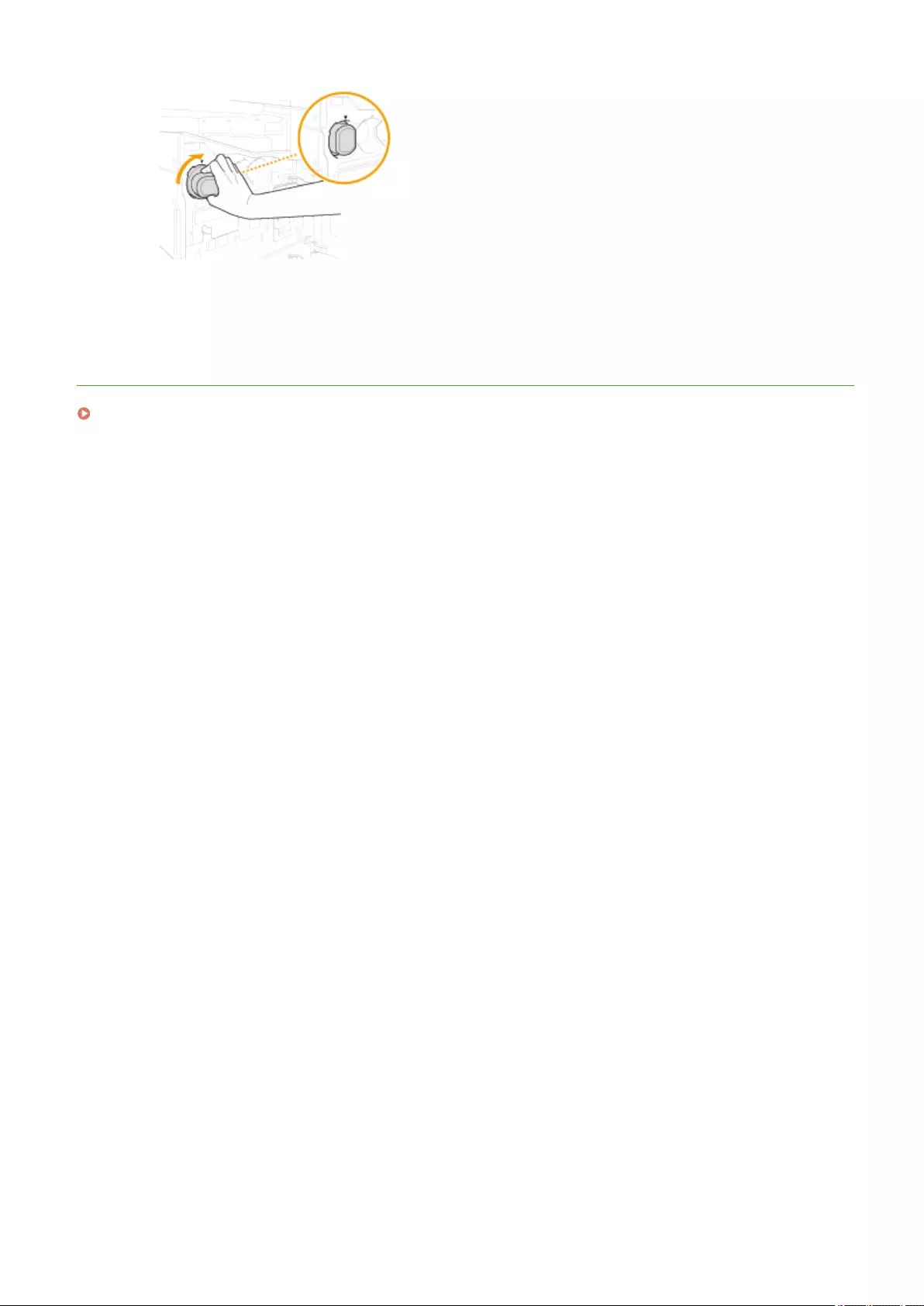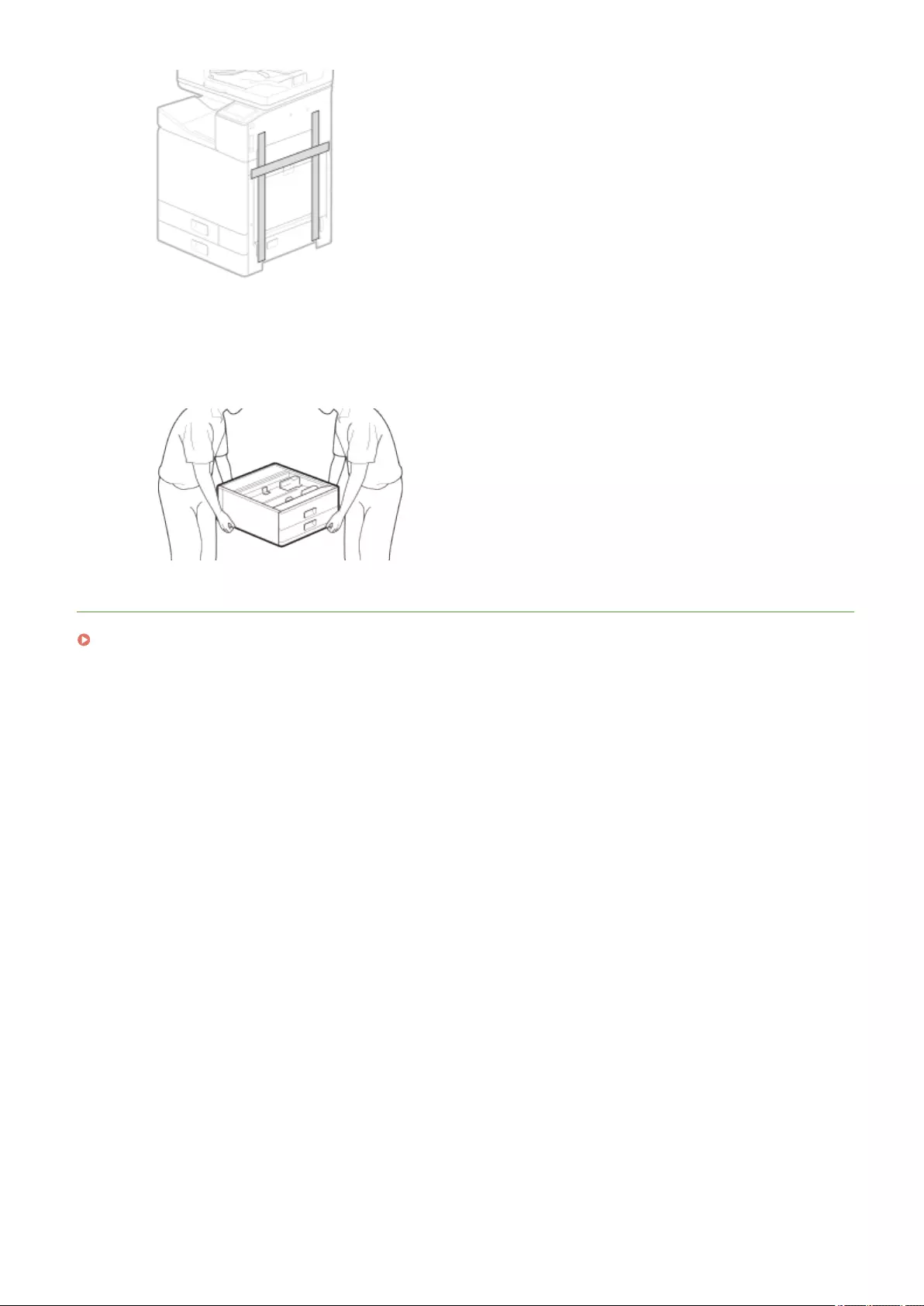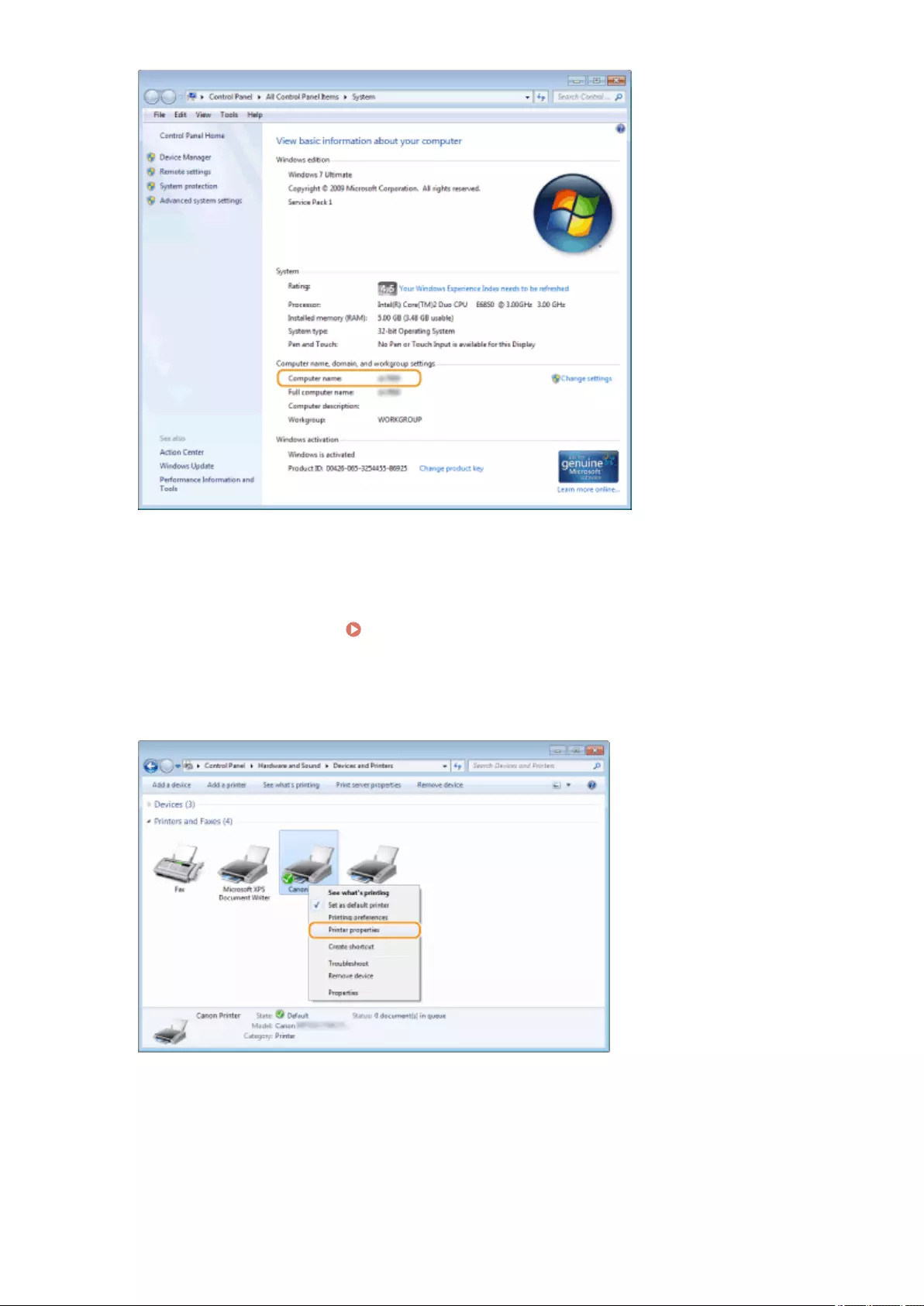Table of Contents
- Contents
- Setting Up
- Main Functions
- Preparations Required Before Use
- Preventing Unauthorized Access
- Setting Up Using the Setup Guide
- Setting the Date/Time
- Setting Up the Network Environment
- Installing Drivers
- Configuring Initial Settings for Fax Functions
- Configuring Scan Settings
- Basic Operations
- Parts and Their Functions
- Turning ON the Machine
- Using the Operation Panel
- Logging in to the Machine
- Placing Originals
- Loading Paper
- Basic Paper Loading Method
- Loading Envelopes
- Loading Preprinted Paper
- Specifying Paper Size and Type
- Specifying Paper Size and Type in the Paper Drawer
- Specifying Paper Size and Type in the Multi-Purpose Tray
- Registering Default Paper Settings for the Multi-Purpose Tray
- Registering a Custom Paper Size
- Limiting the Paper Sizes Displayed for the Multi-Purpose Tray
- Automatically Selecting an Appropriate Paper Source for Each Function
- Set the Automatic Detection Size of the Paper Drawer
- A5/STMT Distinction of Paper
- A4/LTR/16K Distinction of Paper
- B5/16K/EXEC Distinction of Paper
- Customizing the Display
- Changing the Default Settings for Functions
- Setting Sounds
- Entering Sleep Mode
- Registering Destinations
- Copying
- Faxing
- Printing
- Scanning
- Linking with Mobile Devices
- Managing the Machine
- Setting Access Privileges
- Configuring the Network Security Settings
- Restricting the Machine's Functions
- Increasing the Security of Documents
- Managing the Machine from a Computer (Remote UI)
- Updating the Firmware
- Initializing Settings
- Setting Menu List
- Maintenance
- Regular Cleaning
- Replacing the Ink Tanks
- Replacing the Maintenance Cartridge
- Replacing the Print Head
- Replacing the ADF Maintenance Kit
- Checking Remaining Amounts and Usage of Consumables
- Transporting the Machine
- Reinstalling the machine
- Disposing of the Machine
- Adjusting Image Quality
- Diagnosing the Print Head
- Checking the Condition of the Nozzles
- Adjusting Values for Text Color Reproducibility
- Correcting Colors
- Preventing Abrasion
- Aligning the Print Head
- Adjusting the Density and Ink Drying Time
- Adjusting Paper Curling after Printing
- Adjusting Margins
- Correcting Arching of Paper when Output
- Correcting White Streaks
- Viewing the Counter Value
- Printing Reports and Lists
- Consumables
- Frequently Asked Questions
- Appendix
- Drivers
- SIL OPEN FONT LICENSE
Canon WG7550 User Manual
Displayed below is the user manual for WG7550 by Canon which is a product in the Multifunctionals category. This manual has pages.
Related Manuals

Business Inkjet
WG7000 Series
Online Manual
WGMP1-0002-01 2018-12 en Copyright CANON INC. 2018

Contents
Setting Up ............................................................................................................................................................ 3
Main Functions ......................................................................................................................................................... 4
Preparations Required Before Use ............................................................................................................................. 5
Preventing Unauthorized Access ................................................................................................................................ 7
Setting Up Using the Setup Guide .............................................................................................................................. 9
Setting the Date/Time ............................................................................................................................................. 15
Setting Up the Network Environment ...................................................................................................................... 17
Selecting Wired LAN or Wireless LAN ..................................................................................................................... 19
Connecting to a Wired LAN .................................................................................................................................. 20
Connecting to a Wireless LAN ............................................................................................................................... 21
Setting Up Connection Using WPS Push Button Mode ....................................................................................... 23
Setting Up Connection Using WPS PIN Code Mode ........................................................................................... 25
Setting Up Connection by Selecting a Wireless Router ....................................................................................... 27
Setting Up Connection by Specifying Detailed Settings ...................................................................................... 30
Checking the SSID and Network Key ............................................................................................................... 33
Setting IP Addresses ........................................................................................................................................... 34
Setting IPv4 Address ..................................................................................................................................... 35
Setting IPv6 Addresses .................................................................................................................................. 38
Viewing Network Settings .................................................................................................................................... 41
Conguring Settings for Communication with a Computer ...................................................................................... 43
Conguring Printing Protocols and WSD Functions ........................................................................................... 44
Conguring Printer Ports ............................................................................................................................... 47
Setting Up Print Server .................................................................................................................................. 51
Conguring the Machine for Your Network Environment ......................................................................................... 54
Conguring Ethernet Settings ........................................................................................................................ 55
Changing the Maximum Transmission Unit ...................................................................................................... 57
Setting a Wait Time for Connecting to a Network .............................................................................................. 58
Conguring DNS .......................................................................................................................................... 59
Conguring SMB .......................................................................................................................................... 63
Conguring WINS ......................................................................................................................................... 65
Registering LDAP Servers .............................................................................................................................. 67
Monitoring and Controlling the Machine with SNMP ......................................................................................... 72
Other Network Settings ................................................................................................................................. 76
Installing Drivers .................................................................................................................................................... 81
Conguring Initial Settings for Fax Functions ........................................................................................................... 82
Deciding Which Fax Receive Mode to Use .............................................................................................................. 83
Registering the Fax Number and Unit Name .......................................................................................................... 84
Selecting the Receive Mode .................................................................................................................................. 85
Connecting the Telephone Line ............................................................................................................................ 86
Conguring Scan Settings ....................................................................................................................................... 88
Preparing to Use the Machine as a Scanner ........................................................................................................... 89
Procedure for Setting to Send E-Mail/Send and Receive I-Fax ................................................................................... 90
Conguring E-Mail/I-Fax Communication Settings ............................................................................................ 91
I

Procedure for Setting a Shared Folder as a Save Location ........................................................................................ 95
Procedure for Setting a FTP Server as a Save Location ............................................................................................. 96
Basic Operations .......................................................................................................................................... 99
Parts and Their Functions ...................................................................................................................................... 102
Front Side ........................................................................................................................................................ 103
Insert a USB Memory Device ........................................................................................................................ 105
Back Side ......................................................................................................................................................... 107
Interior ........................................................................................................................................................... 108
Feeder ............................................................................................................................................................ 109
Multi-Purpose Tray ........................................................................................................................................... 110
Paper Drawer ................................................................................................................................................... 111
Operation Panel ............................................................................................................................................... 112
Turning ON the Machine ....................................................................................................................................... 114
Turning OFF the Machine ................................................................................................................................... 115
Powering OFF at a Fixed Time ...................................................................................................................... 116
Using the Operation Panel .................................................................................................................................... 118
Basic Screens ................................................................................................................................................... 119
Home Screen ............................................................................................................................................. 120
<Status Monitor> Screen ............................................................................................................................. 123
Message Display ......................................................................................................................................... 125
Basic Operation ................................................................................................................................................ 126
Entering Text ................................................................................................................................................... 129
Logging in to the Machine ..................................................................................................................................... 131
Placing Originals ................................................................................................................................................... 133
Loading Paper ....................................................................................................................................................... 137
Basic Paper Loading Method .............................................................................................................................. 139
Loading Envelopes ............................................................................................................................................ 145
Loading Preprinted Paper .................................................................................................................................. 149
Specifying Paper Size and Type .......................................................................................................................... 152
Specifying Paper Size and Type in the Paper Drawer ....................................................................................... 153
Specifying Paper Size and Type in the Multi-Purpose Tray ................................................................................ 156
Registering Default Paper Settings for the Multi-Purpose Tray ......................................................................... 159
Registering a Custom Paper Size .................................................................................................................. 162
Limiting the Paper Sizes Displayed for the Multi-Purpose Tray .......................................................................... 163
Automatically Selecting an Appropriate Paper Source for Each Function ............................................................ 164
Set the Automatic Detection Size of the Paper Drawer ..................................................................................... 165
A5/STMT Distinction of Paper ....................................................................................................................... 166
A4/LTR/16K Distinction of Paper ................................................................................................................... 167
B5/16K/EXEC Distinction of Paper ................................................................................................................. 168
Customizing the Display ........................................................................................................................................ 169
Customizing the Home Screen ........................................................................................................................... 170
Registering Frequently Used Settings .................................................................................................................. 173
Changing the Default Settings for Functions .......................................................................................................... 175
Setting Sounds ...................................................................................................................................................... 177
II

Entering Sleep Mode ............................................................................................................................................. 179
Registering Destinations ....................................................................................................................................... 181
Registering Destinations in the Address Book ...................................................................................................... 183
Registering Multiple Destinations as a Group ................................................................................................. 186
Editing the Registered Destinations in the Address Book ................................................................................. 188
Copying .............................................................................................................................................................. 190
Copy Basic Features Screen ................................................................................................................................... 192
Basic Copy Operations ........................................................................................................................................... 194
Canceling Copies .............................................................................................................................................. 200
Checking the Copying Status and Log ................................................................................................................. 201
Enhancing and Adjusting Copy Quality ................................................................................................................... 203
Selecting the Type of Original for Copying ........................................................................................................... 204
Adjusting Sharpness for Copying (Sharpness) ...................................................................................................... 205
Erasing Dark Borders When Copying (Erase Frame) ............................................................................................... 206
Useful Copy Functions ........................................................................................................................................... 208
Copying Multiple Documents onto One Sheet (N on 1) .......................................................................................... 209
Copying a Facing Page Original as Two Separate Pages ......................................................................................... 210
Copying Different Size Originals Together (Different Size Originals) ........................................................................ 211
Finishing by Collating/Grouping ......................................................................................................................... 212
Making ID Card Copies ...................................................................................................................................... 214
Faxing .................................................................................................................................................................. 216
Fax Basic Features Screen ...................................................................................................................................... 219
Basic Operations for Sending Faxes ....................................................................................................................... 220
Canceling Sending Faxes ................................................................................................................................... 228
Receiving Faxes .................................................................................................................................................... 229
Useful Functions When Sending ............................................................................................................................. 233
Recalling Previously Used Settings for Sending (Recall Settings) ............................................................................. 234
Sending a Fax after a Phone Call (Manual Sending) ............................................................................................... 237
Saving a Copy of a Sent Original ......................................................................................................................... 239
Various Receiving Methods .................................................................................................................................... 240
Saving Received Documents into the Machine (Memory Reception) ........................................................................ 241
Forwarding the Received Documents Automatically ............................................................................................... 243
Checking Status and Log for Sent and Received Documents .................................................................................... 245
Sending Faxes from Your Computer (PC Fax) .......................................................................................................... 247
Sending PC Faxes ............................................................................................................................................. 248
Using Internet Fax (I-Fax) ...................................................................................................................................... 250
Sending I-Faxes ................................................................................................................................................ 251
Receiving I-Faxes .............................................................................................................................................. 258
Printing .............................................................................................................................................................. 260
Printing from a Computer ..................................................................................................................................... 261
Canceling Prints ............................................................................................................................................... 263
III

Checking the Printing Status and Log .................................................................................................................. 265
Various Printing Methods ...................................................................................................................................... 267
Printing a Document Secured by a PIN (Secure Print) ............................................................................................ 268
Printing via Secure Print .............................................................................................................................. 269
Printing from a USB Memory Device (Memory Media Print) .................................................................................... 272
Scanning ........................................................................................................................................................... 281
Scan Basic Features Screen .................................................................................................................................... 283
Basic Operations for Scanning Originals ................................................................................................................ 286
Scanning and Saving to a Computer .................................................................................................................... 287
Saving Data to a USB Memory Device .................................................................................................................. 289
Sending Data by E-Mail/Saving Data to a Shared Folder or FTP Server ..................................................................... 293
Canceling Sending Documents ........................................................................................................................... 302
Checking Status and Log for Scanned Originals .................................................................................................... 303
Scanning Clearly ................................................................................................................................................... 305
Adjusting Image Quality .................................................................................................................................... 306
Adjusting Density ............................................................................................................................................. 307
Adjusting Sharpness When Scanning (Sharpness) ................................................................................................. 308
Scanning Different Size Originals Together (Different Size Originals) ....................................................................... 310
Useful Scanning Functions .................................................................................................................................... 311
Adjusting Balance between File Size and Image Quality ......................................................................................... 312
Recalling Previously Used Settings for Sending/Saving (Recall Settings) ................................................................... 313
Specifying E-Mail Settings .................................................................................................................................. 315
Using Your Computer to Scan (Remote Scan) .......................................................................................................... 318
Scanning Documents from an Application ........................................................................................................... 319
Using ScanGear WG .......................................................................................................................................... 321
Using WSD ....................................................................................................................................................... 322
Scanning Originals Using WSD (WSD Scan) .................................................................................................... 324
Linking with Mobile Devices ............................................................................................................ 328
Connecting with Mobile Devices ............................................................................................................................ 329
Connecting via a Wireless LAN Router (LAN Connection) ........................................................................................ 330
Connecting Directly (Access Point Mode) ............................................................................................................. 332
Utilizing the Machine through Applications ........................................................................................................... 336
Printing with Default Print Service (Android) .......................................................................................................... 337
Managing the Machine by the Remote Control ....................................................................................................... 338
Managing the Machine ........................................................................................................................ 341
Setting Access Privileges ....................................................................................................................................... 343
Setting the System Manager ID and PIN .............................................................................................................. 344
Setting the Department ID Management ............................................................................................................. 346
Setting a Remote UI PIN .................................................................................................................................... 352
LDAP Server Authentication ............................................................................................................................... 354
Conguring the Network Security Settings ............................................................................................................ 358
IV

Restricting Communication by Using Firewalls ..................................................................................................... 360
Specifying IP Addresses for Firewall Settings .................................................................................................. 361
Specifying MAC Addresses for Firewall Settings .............................................................................................. 364
Changing Port Numbers .................................................................................................................................... 367
Setting a Proxy ................................................................................................................................................. 368
Conguring the Key and Certicate for TLS .......................................................................................................... 370
Generating the Key and Certicate for Network Communication ...................................................................... 373
Generating a Key and Certicate Signing Request (CSR) ................................................................................... 376
Registering the Key and Certicate for Network Communication ...................................................................... 379
Conguring IPSec Settings ................................................................................................................................. 381
Conguring IEEE 802.1X Authentication Settings .................................................................................................. 388
Restricting the Machine's Functions ...................................................................................................................... 392
Restricting Access to Address Book and Sending Functions .................................................................................... 394
Restricting Use of the Address Book ............................................................................................................. 395
Limiting Available Destinations ..................................................................................................................... 396
Restricting the Fax Sending Functions ........................................................................................................... 398
Restricting Printing from a Computer .................................................................................................................. 400
Restricting USB Functions .................................................................................................................................. 401
Disabling HTTP Communication ......................................................................................................................... 403
Disabling Remote UI ......................................................................................................................................... 404
Increasing the Security of Documents .................................................................................................................... 405
Generating a Device Signature Key ..................................................................................................................... 406
Managing the Machine from a Computer (Remote UI) ............................................................................................ 407
Starting Remote UI ........................................................................................................................................... 408
Checking the Status and Logs ............................................................................................................................ 411
Setting Up Menu Options from Remote UI ........................................................................................................... 416
Registering Destinations from Remote UI ............................................................................................................ 419
Importing/Exporting the Setting Data ................................................................................................................. 423
Updating the Firmware ......................................................................................................................................... 426
Initializing Settings ............................................................................................................................................... 428
Setting Menu List ...................................................................................................................................... 431
<Preferences> ....................................................................................................................................................... 432
<Display Settings> ............................................................................................................................................ 433
<English Keyboard Layout> ................................................................................................................................ 435
<Timer/Energy Settings> ................................................................................................................................... 436
<Network> ....................................................................................................................................................... 440
<External Interface> .......................................................................................................................................... 448
<Accessibility> .................................................................................................................................................. 449
<Adjustment/Maintenance> .................................................................................................................................. 450
<Adjust Image Quality> ..................................................................................................................................... 451
<Maintenance> ................................................................................................................................................ 454
<Function Settings> .............................................................................................................................................. 456
<Common> ...................................................................................................................................................... 457
<Copy> ............................................................................................................................................................ 461
V

<Printer> ......................................................................................................................................................... 462
<Send> ............................................................................................................................................................ 484
<Receive/Forward> ........................................................................................................................................... 490
<Store/Access Files> .......................................................................................................................................... 494
<Secure Print> .................................................................................................................................................. 496
<Set Destination> .................................................................................................................................................. 497
<Management Settings> ....................................................................................................................................... 498
<User Management> ........................................................................................................................................ 499
<Device Management> ...................................................................................................................................... 500
<Remote UI Settings/Update Firmware> .............................................................................................................. 502
<Data Management> ........................................................................................................................................ 503
<Security Settings> ........................................................................................................................................... 505
Maintenance ................................................................................................................................................. 508
Regular Cleaning .................................................................................................................................................. 510
Cleaning the Exterior ........................................................................................................................................ 511
Cleaning the Platen Glass .................................................................................................................................. 512
Cleaning the Feeder .......................................................................................................................................... 514
Cleaning the Interior ......................................................................................................................................... 518
Cleaning the Paper Path .............................................................................................................................. 519
Cleaning the Sensor Area ............................................................................................................................ 523
Cleaning the Print Head .............................................................................................................................. 526
Replacing the Ink Tanks ........................................................................................................................................ 528
Replacing the Maintenance Cartridge .................................................................................................................... 532
Replacing the Print Head ....................................................................................................................................... 536
Replacing the ADF Maintenance Kit ....................................................................................................................... 545
Checking Remaining Amounts and Usage of Consumables ..................................................................................... 549
Transporting the Machine ..................................................................................................................................... 551
When Transporting the Machine on Casters Keeping It Level with the Ground ......................................................... 553
When Machine May Tilt during Transport (No Long-Period Storage of 6 Months or More after Transport) ................... 555
When Machine May Tilt during Transport (Long-Period Storage of 6 Months or More after Transport) ........................ 564
Reinstalling the machine ....................................................................................................................................... 573
Disposing of the Machine ...................................................................................................................................... 576
Adjusting Image Quality ....................................................................................................................................... 582
Diagnosing the Print Head ................................................................................................................................. 584
Checking the Condition of the Nozzles ................................................................................................................ 590
Adjusting Values for Text Color Reproducibility ..................................................................................................... 593
Correcting Colors ............................................................................................................................................. 595
Correcting Colors in All Paper Types .............................................................................................................. 596
Correcting Colors for Each Paper Type .......................................................................................................... 599
Manual (Visual Check) ................................................................................................................................. 602
Preventing Abrasion ......................................................................................................................................... 604
Aligning the Print Head ..................................................................................................................................... 605
Adjusting the Density and Ink Drying Time .......................................................................................................... 608
VI

Adjusting Paper Curling after Printing ................................................................................................................. 610
Adjusting Margins ............................................................................................................................................ 612
Correcting Arching of Paper when Output ........................................................................................................... 615
Correcting White Streaks ................................................................................................................................... 616
Viewing the Counter Value .................................................................................................................................... 619
Printing Reports and Lists ..................................................................................................................................... 621
Consumables ........................................................................................................................................................ 625
Frequently Asked Questions ............................................................................................................ 628
Common Problems ................................................................................................................................................ 630
Installation/Settings Problems ........................................................................................................................... 631
Copying/Printing Problems ................................................................................................................................ 635
Faxing/Telephone Problems ............................................................................................................................... 638
When You Cannot Print Properly ............................................................................................................................ 640
Printing Results Are Not Satisfactory ................................................................................................................... 641
Paper Creases or Curls ...................................................................................................................................... 651
Paper Is Fed Incorrectly ..................................................................................................................................... 653
A Message or a Number Starting with "#" (an Error Code) Is Displayed .................................................................... 655
Countermeasures for Each Message ................................................................................................................... 656
Countermeasures for Each Error Code ................................................................................................................ 677
Clearing Paper Jams .............................................................................................................................................. 686
Paper Jams in the Feeder ................................................................................................................................... 688
Paper Jams in the Main Unit ............................................................................................................................... 691
Paper Jams in a Paper Source ............................................................................................................................. 695
When a Problem Cannot Be Solved ......................................................................................................................... 699
Appendix ........................................................................................................................................................... 701
Third Party Software ............................................................................................................................................. 703
Feature Highlights ................................................................................................................................................ 704
Going Green and Saving Money ......................................................................................................................... 705
Improving Eciency ......................................................................................................................................... 707
Going Digital .................................................................................................................................................... 709
So Much More .................................................................................................................................................. 711
Specications ....................................................................................................................................................... 713
Printer ............................................................................................................................................................ 714
Scan ................................................................................................................................................................ 718
Copy ............................................................................................................................................................... 719
FAX ................................................................................................................................................................. 720
SEND .............................................................................................................................................................. 721
Network .......................................................................................................................................................... 722
Printing Solutions ............................................................................................................................................. 723
Other Specications .......................................................................................................................................... 724
Available Paper ..................................................................................................................................................... 726
Options ................................................................................................................................................................ 731
VII

Optional Equipment .......................................................................................................................................... 732
Manuals and Their Contents .................................................................................................................................. 733
Using Online Manual ............................................................................................................................................. 734
Screen Layout of Online Manual ......................................................................................................................... 735
Viewing Online Manual ...................................................................................................................................... 738
Basic Windows Operations .................................................................................................................................... 739
Notice .................................................................................................................................................................. 747
Drivers ................................................................................................................................................................ 758
Windows ............................................................................................................................................................... 759
macOS .................................................................................................................................................................. 761
VIII

Setting Up
Setting Up ............................................................................................................................................................... 3
Main Functions ...................................................................................................................................................... 4
Preparations Required Before Use ....................................................................................................................... 5
Preventing Unauthorized Access .......................................................................................................................... 7
Setting Up Using the Setup Guide ........................................................................................................................ 9
Setting the Date/Time ......................................................................................................................................... 15
Setting Up the Network Environment ............................................................................................................... 17
Selecting Wired LAN or Wireless LAN .............................................................................................................. 19
Connecting to a Wired LAN ............................................................................................................................. 20
Connecting to a Wireless LAN ......................................................................................................................... 21
Setting Up Connection Using WPS Push Button Mode ............................................................................. 23
Setting Up Connection Using WPS PIN Code Mode .................................................................................. 25
Setting Up Connection by Selecting a Wireless Router ............................................................................. 27
Setting Up Connection by Specifying Detailed Settings ............................................................................ 30
Checking the SSID and Network Key ........................................................................................................ 33
Setting IP Addresses ....................................................................................................................................... 34
Setting IPv4 Address ................................................................................................................................ 35
Setting IPv6 Addresses ............................................................................................................................ 38
Viewing Network Settings ............................................................................................................................... 41
Conguring Settings for Communication with a Computer ............................................................................ 43
Conguring Printing Protocols and WSD Functions ................................................................................. 44
Conguring Printer Ports ......................................................................................................................... 47
Setting Up Print Server ............................................................................................................................ 51
Conguring the Machine for Your Network Environment ............................................................................... 54
Conguring Ethernet Settings ................................................................................................................. 55
Changing the Maximum Transmission Unit ............................................................................................. 57
Setting a Wait Time for Connecting to a Network .................................................................................... 58
Conguring DNS ...................................................................................................................................... 59
Conguring SMB ...................................................................................................................................... 63
Conguring WINS .................................................................................................................................... 65
Registering LDAP Servers ......................................................................................................................... 67
Monitoring and Controlling the Machine with SNMP ............................................................................... 72
Other Network Settings ........................................................................................................................... 76
Installing Drivers ................................................................................................................................................. 81
Conguring Initial Settings for Fax Functions ................................................................................................... 82
Deciding Which Fax Receive Mode to Use ....................................................................................................... 83
Setting Up
1

Registering the Fax Number and Unit Name .................................................................................................. 84
Selecting the Receive Mode ............................................................................................................................ 85
Connecting the Telephone Line ...................................................................................................................... 86
Conguring Scan Settings ................................................................................................................................... 88
Preparing to Use the Machine as a Scanner ................................................................................................... 89
Procedure for Setting to Send E-Mail/Send and Receive I-Fax ......................................................................... 90
Conguring E-Mail/I-Fax Communication Settings ................................................................................... 91
Procedure for Setting a Shared Folder as a Save Location .............................................................................. 95
Procedure for Setting a FTP Server as a Save Location ................................................................................... 96
Setting Up
2

Setting Up
2579-000
Before using the functions of the machine, the environmental conditions must be set in advance. To begin with, check
the sequences of ow required to complete the setup, and then perform the actual settings. Preparations Required
Before Use(P. 5)
●The functions installed on the machine vary depending on the model you purchased. Before using the
machine, see Main Functions(P. 4) and check the available functions.
Conguring Initial Settings of the Machine (Setup Guide)
●You can easily congure the initial settings required to use the machine, such as date, time, and network
settings, by following the on-screen guidance. Setting Up Using the Setup Guide(P. 9)
Setting Up
3

Main Functions
2579-001
This manual covers all the functions of the model series you purchased. Before getting started, check which functions
are available on the model you purchased.
: With function : Without function
Function WG7x50Z series WG7x50F series WG7x50 series WG7x40 series
Copy
Fax
Print
Scan
Feeder 2-sided scanning
2-sided printing
Shift sorter
Wireless LAN
NFC
Default System Manager ID 7654321 7654321 7654321 7654321
Default System Manager PIN 7654321 7654321 7654321 7654321
Cassette Feeding Unit CF10 *
*This is an optional item.
●For the available driver types, see the User Software DVD-ROM supplied with the machine, or see the Canon
website (global.canon).
LINKS
Viewing Online Manual(P. 738)
Setting Up
4

Preparations Required Before Use
2579-002
Set up the machine following steps 1 to 5 in order. For more information about a particular step, click on the link to go
to the corresponding section. In addition, to use the machine safely, also check Preventing Unauthorized
Access(P. 7) .
Step 1 Setting Up Using the Setup Guide(P. 9)
Step 2 Setting Up the Network Environment(P. 17)
●Congure the network settings that are not covered in the Setup Guide. If you do not need
to use the Setup Guide, congure the network settings from here.
Step 3 Installing Drivers(P. 81)
Step 4 Conguring Initial Settings for Fax Functions(P. 82)
Step 5 Conguring Scan Settings(P. 88)
Setting Up
5

Setting from the Remote UI
●When the network environment settings are complete, you can eciently set the machine from a computer
using Remote UI. Starting Remote UI(P. 408)
Importing data from another machine to save time
●As long as the model is the same, you can save setting data registered on another Canon printer/
multifunction machine to a computer (export) and load the setting data to this machine (import).
Importing/Exporting the Setting Data(P. 423)
Setting Up
6

Preventing Unauthorized Access
2579-003
This section describes the security measures on how to prevent unauthorized access from the external network. This is
a must-read for all users and administrators before using this machine, other printers, and multifunction machines
connected to the network. In recent years, a printer/multifunction machine connected to the network can offer you a
variety of useful functions, such as printing from a computer, operating from a computer using the remote function,
and sending scanned documents via the Internet. On the other hand, it is essential to take security measures to
reduce the security risk for information leakage, as a printer/multifunction machine has become more exposed to
threats, such as unauthorized access and theft, when it is connected to the network. This section explains necessary
settings you need to specify to prevent unauthorized access before using a printer/multifunction machine connected
to the network.
Security Measures to Prevent Unauthorized Access from the External Network
Assigning a Private IP Address(P. 7)
Using Firewall to Restrict Transmission(P. 8)
Specifying the TLS Encrypted Communication (P. 8)
Setting PIN to Manage Information Stored in the Multifunction Machine(P. 8)
Assigning a Private IP Address
An IP address is a numerical label assigned to each device participating in a computer network. A "global IP address" is
used for the communication connecting to the Internet, and a "private IP address" is used for the communication
within a local area network, such as a LAN in the company. If a global IP address is assigned, your printer/
multifunction machine is open to the public and can be accessed via the Internet. Thus, the risk of information leakage
due to unauthorized access from external network increases. On the other hand, if a private IP address is assigned,
your printer/multifunction machine is closed to a local area network and can be accessed by only users on your local
area network, such as a LAN in the company.
Global IP Address
Can be accessed from the external network
Private IP Address
Can be accessed from the users within a local area network
Basically, assign a private IP address to your printer/multifunction machine. Make sure to conrm the IP address,
assigned to the printer/multifunction machine you are using, is a private IP address or not. A private IP address is
found in one of the following ranges.
Ranges for Private IP addresses
●From 10.0.0.0 to 10.255.255.255
●From 172.16.0.0 to 172.31.255.255
●From 192.168.0.0 to 192.168.255.255
For information on how to conrm the IP address, see Setting IPv4 Address(P. 35) .
●If a global IP address is assigned to a printer/multifunction machine, you can create a network environment
to reduce the risk of unauthorized access by installing security software, such as a rewall that prevents
Setting Up
7

access from the external networks. If you want to assign a global IP address to and use a printer/
multifunction machine, contact your network administrator.
Using Firewall to Restrict Transmission
A rewall is a system that prevents unauthorized access from the external networks and protects against attacks/
intrusions to a local area network. You can use a rewall on your network environment to block access from the
external network that appears to be dangerous, by restricting communication from specied IP address of the
external network. The function installed to a Canon printer/multifunction machine enables you to set up the IP
address lter. For information on how to set up an IP address lter, see Specifying IP Addresses for Firewall
Settings(P. 361) .
Specifying the TLS Encrypted Communication
For information on the TLS Encrypted Communication, see Conguring the Network Security Settings(P. 358) ,
and on the procedures to specify, see Conguring the Key and Certicate for TLS(P. 370) .
Setting PIN to Manage Information Stored in the Multifunction Machine
If a malicious third party attempts to gain unauthorized access to a printer/multifunction machine, setting PIN to
information stored in the machine will reduce the risk of information leakage. Canon printers/multifunction machines
enable you to protect various type of information by setting PIN.
Setting PIN to Each Function
●Setting PIN for Using Remote UI
For more information, see Setting a Remote UI PIN(P. 352) .
●Setting PIN for the System Manager Settings
For more information, see Setting the System Manager ID and PIN(P. 344) .
●Address Book PIN
For more information on setting a PIN, see Restricting Use of the Address Book(P. 395) .
Listed above are some examples of security measures for preventing unauthorized access. For more information on
the other security measures, see Managing the Machine(P. 341) and take necessary security measures for
preventing unauthorized access to suit your environment.
Setting Up
8

Setting Up Using the Setup Guide
2579-004
When the machine is turned on ( Turning ON the Machine(P. 114) ) for the rst time, the Setup Guide starts up to
assist you to congure the initial settings of the machine by following the on-screen guidance. In the Setup Guide, the
setting screens are displayed in the following order
●Check included items referring to "Getting Started." Manuals and Their Contents(P. 733)
●Some setting items may not be displayed depending on your country or region.
Step 1 Setting the Display Language and the Country or Region
Set the language to be displayed on the operation panel screen or in reports, as well as the
country or region where the machine will be used.
1Select a language.
2Select <Yes>.
3Select a country or region.
Step 2 Setting the Date and Time
Adjust the machine's date/time.
1Select a time zone.
What is UTC?
●Coordinated Universal Time (UTC) is the primary time standard by which the
world regulates clocks and time. The correct UTC time zone setting is required
for Internet communications.
2Enter the date and time, and select <Apply>.
Step 3 Removing the Shipping Lock Pin and Attaching the Handhold Cover
Remove the shopping lock pin from inside the main unit, and attach the handhold cover.
1Select <Unlock>.
2When <Open the front cover.> is displayed, open the front cover.
3Pull the shipping lock pin (orange) out without bending, and select <Next>.
●Discard the removed pin.
Setting Up
9

4Lift the lever (blue), pull the print head locking rod out without bending, and select
<Next>.
●Stow the print head locking rod.
●The Print Head Locking Rod is required during transport. Do not dispose and
store in a safe place.
5Attach the handhold cover, and select <Next>.
Setting Up
10

6Use a coin to turn the screws to fasten.
7Close the front cover of the main unit.
Step 4 Installing the Ink Tanks
Install the ink tanks.
1Select <Unlock>.
2When <Open the front cover.> is displayed, open the front cover.
3Install the ink tanks.
●Before installing an ink tank, conrm that the color of the ink tank and the
color indicated on the slot of the main unit are the same.
●Align the mark on the main unit and the mark on the ink tank, and
push the ink tank in until it stops.
●Turn clockwise until the ink tank clicks.
●Install ink tanks for all four colors.
4Close the front cover of the main unit.
●Ink begins lling in the main unit for the rst time, and takes from 40 to 70
minutes.
●Do not turn the machine off while ink is lling.
Setting Up
11

●If lling is interrupted by turning off the machine, etc., additional ink tanks may
be required.
●You can continue up to adjusting margins for paper drawers 3 and 4 while ink
is lling.
Step 5 Conrming Sending of Machine Information
Please conrm the details of settings for providing information on the machine.
1Check the details, and select <Next>.
2Select <Do Not Accept> or <Accept>.
Step 6 Setting the Access Security Measures
Set a PIN to access the Remote UI. Because the Remote UI can be used to change the machine
settings from a computer, setting of a PIN is recommended.
1Select <Yes>.
●If you select <No>, PIN is not set, and the Setup Guide proceeds to step 7.
●You can also set the access security measure of the Remote UI later ( Setting
a Remote UI PIN(P. 352) ). Setting a PIN ensures greater security and is
recommended.
2Enter a PIN, and then select <Apply>.
3Enter the same PIN, and then select <Apply>.
●Do not forget your PIN.
Step 7 Setting the Wireless LAN
Congure the settings to connect to the network using the wireless LAN.
1Select <Yes>.
●If you select <No>, wireless LAN is not set, and the Setup Guide proceeds to
step 8 or step 9. Select <No> to connect via wired LAN or USB.
●If using the Setup Guide, connection is by DHCP and automatically allocates the
IP address. To congure an IP address other than by DHCP, such as setting a
xed IP address, select <No> and perform Setting IP Addresses(P. 34)
after the Setup Guide exits.
2Select <OK>.
3Select the setting method.
●For more information about the wireless LAN settings, see Connecting to a
Wireless LAN(P. 21) .
Step 8 Adjusting Margins in Paper Drawers 3 and 4 (Optional)
If an optional cassette feeding unit is installed, enter the margin adjustment values.
1Pull out paper drawer 3 and check the margin adjustment value.
Setting Up
12

2Select <Start>.
3Enter <Left Margin for Drawer 3> and <Left Margin for Drawer 4>, and select
<Apply>.
●Tap the entry eld, and enter the values.
4Gently insert the paper drawer into the machine.
Step 9 Printing Out and Check a Nozzle Check Pattern
Print out and check a nozzle check pattern to check the print head condition. If streaks or
unevenness appear in the printed result, perform cleaning.
1Load paper in the paper drawer. Loading Paper in the Paper Drawer(P. 139)
●Load at least 10 sheets of plain paper in any of these paper sizes:
A3/11x17/LTR/A4 (A3 or 11x17 recommended).
2Check that the displayed paper size is loaded, and select <Start>.
➠The machine prints a nozzle check pattern.
3Check the printed pattern, and select <A> or <B>.
●If the printed result appears okay, press <A> to complete the nozzle check.
●If streaks or unevenness appear in the printed result, press <B> to perform
cleaning.
●Print head cleaning can be performed later. Cleaning the Print
Head(P. 526)
➠When the Setup Guide is complete, the Home screen appears.
Setting Up
13

Setting Up
14

Setting the Date/Time
2579-005
Set the date and time for the machine. The date and time are used as the reference for the functions specifying the
time, therefore, they need to be set accurately.
Setting the Time Zone(P. 15)
Setting the Current Date and Time(P. 15)
Setting the Daylight Saving Time(P. 16)
●Some setting items may not be displayed depending on your country or region.
Setting the Time Zone
If the time zone setting is changed, the values set in <Current Date/Time Settings> are also changed accordingly.
1Select <Menu> in the Home screen. Home Screen(P. 120)
2Select <Preferences> <Timer/Energy Settings> <Date/Time Settings> <Time
Zone>.
3Select the time zone.
What is UTC?
●Coordinated Universal Time (UTC) is the primary time standard by which the world regulates clocks and
time. Time differences exist depending on the country or area where the machine is used. The correct UTC
time zone setting is required for Internet communications.
Setting the Current Date and Time
1Select <Menu> in the Home screen. Home Screen(P. 120)
Setting Up
15

2Select <Preferences> <Timer/Energy Settings> <Current Date/Time Settings>.
3Enter the date and time.
●Tap the entry eld, and enter the date and time.
4Select <Apply>.
●Set <Time Zone> before setting the current date and time. If the <Time Zone> setting is changed later, the
current date and time are also changed accordingly.
●The display format of the date and time can be changed, respectively.
<Date Format>(P. 437)
<Time Format>(P. 437)
Setting the Daylight Saving Time
If daylight saving time is enabled, specify the dates from which and to which daylight saving time is in effect.
1Select <Menu> in the Home screen. Home Screen(P. 120)
2Select <Preferences> <Timer/Energy Settings> <Date/Time Settings> <Daylight
Saving Time Settings>.
3Select <Off> or <On> in <Daylight Saving Time>.
●When you select <On>, select <Start Date> and <End Date>, and set the month and day for each item. To set
the day, specify "what day of which week."
4Select <Apply>.
Setting Up
16

Setting Up the Network Environment
2579-006
When connecting the machine to a wired or wireless local area network (LAN), you need to set an IP address unique to
the selected network. Select "wired" or "wireless" depending on your communication environment and networking
devices. For specic IP address settings, contact your Internet service provider or Network Administrator.
●If the machine is connected to an unsecured network, your personal information might be leaked to a third
party.
●The machine cannot connect to both wired and wireless LANs at the same time.
●If using a wireless LAN, remove the LAN cable to congure settings.
●The machine does not come with a LAN cable or router. Have them ready as necessary.
●For more information about your networking devices, see the instruction manuals for the devices or contact
your manufacturer.
◼Before You Start
Follow these steps to connect the machine to a network.
Check your computer settings.
●Make sure that the computer is correctly connected to the network. For more
information, see the instruction manuals for the devices you are using, or contact the
device manufacturers.
●Make sure that the network settings have been completed on the computer. If the
network has not been set up properly, you will not be able to use the machine on the
network, even if you perform the rest of the procedure below.
●Depending on the network, you may need to change settings for the communication
method or the Ethernet type ( Conguring Ethernet Settings(P. 55) ). For more
information, contact your Internet service provider or Network Administrator.
●To check the MAC address of the machine.
Viewing the MAC Address for Wired LAN(P. 41)
Viewing the MAC Address and Information for Wireless LAN(P. 42)
Setting Up
17

●To connect to an IEEE 802.1X network, see Conguring IEEE 802.1X
Authentication Settings(P. 388) .
Select wired or wireless LAN.
Selecting Wired LAN or Wireless LAN(P. 19)
Connect to a wired or wireless LAN.
●Proceed to the section that corresponds to the setting you selected in step 2.
Connecting to a Wired LAN(P. 20)
Connecting to a Wireless LAN(P. 21)
Set the IP address as necessary.
●At the time of purchase, the machine is set to automatically acquire an IP address.
Change this setting if you want to use a specic IP address. Setting IP
Addresses(P. 34)
LINKS
Conguring Settings for Communication with a Computer(P. 43)
Conguring the Machine for Your Network Environment(P. 54)
Setting Up
18

Selecting Wired LAN or Wireless LAN
2579-007
After you decide on wired or wireless LAN to connect the machine to the computer, select wired LAN or wireless LAN
using the operation panel. Note that if you change the setting from <Wired LAN> to <Wireless LAN> or vice versa, you
will need to uninstall the drivers installed on your computer and then reinstall them. For more information, see the
manuals for the drivers ( Drivers(P. 758) ).
1Select <Menu> in the Home screen. Home Screen(P. 120)
2Select <Preferences> <Network>.
●If the login screen appears, enter the correct ID and PIN. Logging in to the Machine(P. 131)
3Select <Select Wired/Wireless LAN>.
4Select <Wired LAN> or <Wireless LAN>.
LINKS
Setting Up the Network Environment(P. 17)
Connecting to a Wired LAN(P. 20)
Connecting to a Wireless LAN(P. 21)
Setting Up
19

Connecting to a Wired LAN
2579-008
Connect the machine to a computer via a router. Use a LAN cable to connect the machine to the router.
1Connect a LAN cable.
●Connect the machine to a router by using a LAN cable.
●Push the connector into the socket until it clicks into place.
2Wait for several minutes.
➠The IP address is set automatically.
●You can set the IP address manually. Setting IP Addresses(P. 34)
LINKS
Setting Up the Network Environment(P. 17)
Setting Up
20

Connecting to a Wireless LAN
2579-009
Wireless routers (or access points) connect the machine to a computer via radio waves. If your wireless router is
equipped with Wi-Fi Protected Setup (WPS), conguring your network is automatic and easy. If your networking
devices do not support automatic conguration, or if you want to specify authentication and encryption settings in
detail, you need to manually set up the connection. Make sure that your computer is correctly connected to the
network.
Setting Up Connection Using WPS(P. 21)
Manually Setting Up Connection(P. 22)
Risk of information leak
●Use wireless LAN connection at your own discretion and at your own risk. If the machine is connected to an
unsecured network, your personal information might be leaked to a third party because radio waves used in
wireless communication can go anywhere nearby, even beyond walls.
Wireless LAN security
●The wireless LAN function of this machine supports WEP, WPA-PSK, and WPA2-PSK. For the wireless security
compatibility of your wireless router, see the instruction manuals for your networking devices or contact
your manufacturer.
Required devices for wireless LAN connection
●The machine does not come with a wireless router. Have the router ready as necessary.
Setting Up Connection Using WPS
When using WPS, two modes are available: push button mode and PIN code mode.
◼Push Button Mode
Find the WPS mark shown below on the package of your wireless router. Also make sure that there is a WPS button on
your networking device. Setting Up Connection Using WPS Push Button Mode(P. 23)
Setting Up
21

◼PIN Code Mode
Some WPS routers do not support the push button mode. If WPS PIN code mode is mentioned on the package or in
the instruction manuals of your networking device, set up the connection by entering the PIN code. Setting Up
Connection Using WPS PIN Code Mode(P. 25)
●If the wireless router is set to use WEP authentication, you may not be able to set up connection using WPS.
Manually Setting Up Connection
When manually setting up a wireless connection, you can either select a wireless router or manually enter the required
information. Regardless of the method, make sure that you have the required setup information, including the SSID
and network key. Checking the SSID and Network Key(P. 33)
◼Selecting a Wireless Router
Select this setup option if you need to manually set up the connection but want to complete the setup as easily as
possible. Setting Up Connection by Selecting a Wireless Router(P. 27)
◼Manually Entering the Setup Information
If you want to specify security settings in detail, such as authentication and encryption settings, manually enter the
SSID and network key to set up the connection. Setting Up Connection by Specifying Detailed Settings(P. 30)
LINKS
Setting Up the Network Environment(P. 17)
Selecting Wired LAN or Wireless LAN(P. 19)
Setting Up
22

Setting Up Connection Using WPS Push Button Mode
2579-00A
If your wireless router supports WPS push button mode, you can easily set up a connection with a WPS button.
●How to operate the wireless router may vary on each device. See the instruction manuals for your
networking device for help.
1Select <Menu> in the Home screen. Home Screen(P. 120)
2Select <Preferences> <Network>.
●If the login screen appears, enter the correct ID and PIN. Logging in to the Machine(P. 131)
3Select <Wireless LAN Settings>.
●If the <Do you want to enable the wireless LAN?> message is displayed, select <Yes>.
4Read the message that is displayed, and select <OK>.
5Select <WPS Push Button Mode>.
6Select <Yes>.
7Press and hold the WPS button on the wireless router.
●The button must be pressed within 2 minutes after selecting <Yes> in step 6.
●Depending on the networking device, you may need to press and hold the button for 2 seconds or longer.
See the instruction manuals for your networking device for help.
If an error message is displayed during setup
●Select <Close> and return to step 5.
8Wait until message <Connected.> is displayed.
Setting Up
23

9Select <Close>.
➠Wait several minutes until the IP address and other items are set automatically.
Signal strength
●When more than one wireless router is available for connection, the machine connects to the device
with the strongest signal. Signal strength is measured using RSSI (Received Signal Strength Indication).
●You can set the IP address manually. Setting IP Addresses(P. 34)
●While the machine is connected to the wireless LAN, the Wi-Fi icon is displayed in the Home screen or
the Basic Features screen of each function. Basic Screens(P. 119)
Reducing power consumption
●You can set the machine to enter <Power Save Mode> based on signals emitted from the wireless router.
<Power Save Mode>(P. 441)
If the IP address of the machine has changed
●In a DHCP environment, the IP address of the machine may be changed automatically. If this happens, the
connection is maintained as long as the machine and the computer belong to the same subnet.
LINKS
Connecting to a Wireless LAN(P. 21)
Setting Up
24

Setting Up Connection Using WPS PIN Code Mode
2579-00C
If your wireless router supports WPS PIN code mode, generate a PIN code with the machine and register the code to
the networking device.
●How to operate the wireless router may vary on each device. See the instruction manuals for your
networking device for help.
From a Computer
1Access your wireless router from a computer and display the screen for entering a
WPS PIN code.
●For more information, see the instruction manuals for your networking device.
From the Operation Panel
2Select <Menu> in the Home screen. Home Screen(P. 120)
3Select <Preferences> <Network>.
●If the login screen appears, enter the correct ID and PIN. Logging in to the Machine(P. 131)
4Select <Wireless LAN Settings>.
●If the <Do you want to enable the wireless LAN?> message is displayed, select <Yes>.
5Read the message that is displayed, and select <OK>.
6Select <WPS PIN Code Mode>.
7Select <Yes>.
➠The PIN code is generated and shown on the display.
From a Computer
8Register the generated PIN code to the wireless router.
●Register the PIN code on the setup screen displayed in step 1.
Setting Up
25

●The PIN code must be registered within 10 minutes after selecting <Yes> in step 7.
If an error message is displayed during setup
●Select <Close> and return to step 6.
From the Operation Panel
9Wait until the message <Connected.> is displayed.
10 Select <Close>.
➠Wait several minutes until the IP address and other items are set automatically.
Signal strength
●When more than one wireless router is available for connection, the machine connects to the device
with the strongest signal. Signal strength is measured using RSSI (Received Signal Strength Indication).
●You can set the IP address manually. Setting IP Addresses(P. 34)
●While the machine is connected to the wireless LAN, the Wi-Fi icon is displayed in the Home screen or
the Basic Features screen of each function. Basic Screens(P. 119)
Reducing power consumption
●You can set the machine to enter <Power Save Mode> based on signals emitted from the wireless router.
<Power Save Mode>(P. 441)
If the IP address of the machine has changed
●In a DHCP environment, the IP address of the machine may be changed automatically. If this happens, the
connection is maintained as long as the machine and the computer belong to the same subnet.
LINKS
Connecting to a Wireless LAN(P. 21)
Setting Up
26

Setting Up Connection by Selecting a Wireless Router
2579-00E
You can search the wireless routers (or access points) available for connection and select one from the display of the
machine. For the network key, enter a WEP key or PSK. Before selecting a wireless router, check and write down the
required setup information, including the SSID and network key ( Checking the SSID and Network Key(P. 33) ).
Security settings
●If the wireless connection is set up by selecting a wireless router, the WEP authentication method is set to
<Open System> or the WPA/WPA2 encryption method is set to <Auto> (AES-CCMP or TKIP). If you want to
select <Shared Key> for WEP authentication or <AES-CCMP> for WPA/WPA2 encryption, you need to set up
the connection using <Enter Manually>. Setting Up Connection by Specifying Detailed Settings(P. 30)
1Select <Menu> in the Home screen. Home Screen(P. 120)
2Select <Preferences> <Network>.
●If the login screen appears, enter the correct ID and PIN. Logging in to the Machine(P. 131)
3Select <Wireless LAN Settings>.
●If the <Do you want to enable the wireless LAN?> message is displayed, select <Yes>.
4Read the message that is displayed, and select <OK>.
5Select <SSID Settings>.
6Select <Select Access Point>.
➠The machine starts searching for available wireless routers.
●If a message is displayed telling that access point cannot be found, see Countermeasures for Each
Message(P. 656) .
7Select a wireless LAN router.
●Select the router whose SSID matches the one that you have written down, and select <Next>.
Setting Up
27

To view details of security settings
●Select the wireless LAN router, and select <Details>. To return to the original screen, select .
If your wireless router is not found
●Check whether the machine is properly installed and ready to connect to the network. Installation/
Settings Problems(P. 631)
8Enter the network key that you have written down.
●Enter the network key, and select <Apply>.
●On how to enter text, see Entering Text(P. 129) .
9Select <Yes>.
If an error message is displayed during setup
●Select <Close>, check whether the network key is correct, and return to step 5.
10 Wait until message <Connected.> is displayed.
11 Select <Close>.
➠Wait several minutes until the IP address and other items are set automatically.
Signal strength
●When more than one wireless router is available for connection, the machine connects to the device
with the strongest signal. Signal strength is measured using RSSI (Received Signal Strength Indication).
●You can set the IP address manually. Setting IP Addresses(P. 34)
●While the machine is connected to the wireless LAN, the Wi-Fi icon is displayed in the Home screen or
the Basic Features screen of each function. Basic Screens(P. 119)
Reducing power consumption
●You can set the machine to enter <Power Save Mode> based on signals emitted from the wireless router.
<Power Save Mode>(P. 441)
Setting Up
28

Setting Up Connection by Specifying Detailed Settings
2579-00F
If you want to specify the security settings in detail or cannot establish the wireless connection using the other
procedures, manually enter all the required information for the wireless LAN connection. Before specifying detailed
settings, check and write down the required information, including the SSID, network key, and wireless security
protocols ( Checking the SSID and Network Key(P. 33) ).
1Select <Menu> in the Home screen. Home Screen(P. 120)
2Select <Preferences> <Network>.
●If the login screen appears, enter the correct ID and PIN. Logging in to the Machine(P. 131)
3Select <Wireless LAN Settings>.
●If the <Do you want to enable the wireless LAN?> message is displayed, select <Yes>.
4Read the message that is displayed, and select <OK>.
5Select <SSID Settings> <Enter Manually>.
6Enter the SSID that you have written down.
●Enter the SSID, and select <Apply>.
●On how to enter text, see Entering Text(P. 129) .
7Specify the security settings based on the information that you have written down.
●If you do not need to specify the security settings, select <None>.
Using WEP
1Select <WEP>.
2Select an authentication method.
Setting Up
30

<Open System>
Sets open system authentication, which is also called "open authentication."
<Shared Key>
Uses the WEP key as a password.
When <Open System> is selected
●When connecting to a wireless LAN, the machine experiences an authentication error if the shared key
authentication is set on the wireless router. If this happens, the machine automatically changes the
setting to <Shared Key> and retries the connection.
3Select the WEP key you want to edit.
●Select the WEP key (1 to 4), and select <Edit>.
●Up to four WEP keys can be registered.
4Enter the network key that you have written down.
●Enter the network key, and select <Apply>.
5Select the desired WEP key.
●Select the WEP key you have edited, and select <Register>.
Using WPA-PSK or WPA2-PSK
1Select <WPA/WPA2-PSK>.
2Select an encryption method.
<Auto>
Sets the machine to automatically select AES-CCMP or TKIP to match the setting of the wireless router.
<AES-CCMP>
Sets AES-CCMP as the encryption method.
3Enter the network key that you have written down.
●Enter the network key, and select <Apply>.
Setting Up
31

8Select <Yes>.
If an error message is displayed during setup
●Select <Close>, check whether the specied settings are correct, and return to step 5.
9Wait until message <Connected.> is displayed.
10 Select <Close>.
➠Wait several minutes until the IP address and other items are set automatically.
Signal strength
●When more than one wireless router is available for connection, the machine connects to the device
with the strongest signal. Signal strength is measured using RSSI (Received Signal Strength Indication).
●You can set the IP address manually. Setting IP Addresses(P. 34)
●While the machine is connected to the wireless LAN, the Wi-Fi icon is displayed in the Home screen or
the Basic Features screen of each function. Basic Screens(P. 119)
Reducing power consumption
●You can set the machine to enter <Power Save Mode> based on signals emitted from the wireless router.
<Power Save Mode>(P. 441)
If the IP address of the machine has changed
●In a DHCP environment, the IP address of the machine may be changed automatically. If this happens, the
connection is maintained as long as the machine and the computer belong to the same subnet.
LINKS
Connecting to a Wireless LAN(P. 21)
Setting Up
32

Checking the SSID and Network Key
2579-0E3
When manually setting up a wireless connection, you need to specify the SSID and network key of your wireless router.
The SSID and network key may be indicated on these networking devices. Check your devices and write down the
necessary information before setting up the connection. For more information, see the instruction manuals for your
networking devices or contact your manufacturer.
SSID A name given for identifying a specic wireless LAN. Some other terms used for SSID include
"access point name" and "network name."
Network Key A keyword or password used for encrypting data or authenticating a network. Some other
terms used for network key include "encryption key," "WEP key," "WPA/WPA2 passphrase,"
and "preshared key (PSK)."
Wireless Security Protocols
(Authentication/Encryption)
When manually setting up a wireless connection by specifying detailed settings, you need to
specify security settings. Check the following information:
●Security types (WEP/WPA-PSK/WPA2-PSK)
●Authentication method (Open System/Shared Key)
●Encryption method (TKIP/AES-CCMP)
LINKS
Connecting to a Wireless LAN(P. 21)
Setting Up Connection by Selecting a Wireless Router(P. 27)
Setting Up Connection by Specifying Detailed Settings(P. 30)
Setting Up
33

Setting IP Addresses
2579-00J
Connecting the machine to a network requires a unique network IP address. Two versions of IP addresses are
available: IPv4 and IPv6. Congure these settings depending on the network environment. To use IPv6 addresses, you
need to properly congure the IPv4 address settings.
Setting IPv4 Address(P. 35)
Setting IPv6 Addresses(P. 38)
Setting Up
34

Setting IPv4 Address
2579-00K
The machine's IPv4 address can be either assigned automatically by a dynamic IP
addressing protocol, such as DHCP, or entered manually. When connecting the
machine to a wired LAN, make sure that the connectors of the LAN cable are rmly
inserted into the sockets ( Connecting to a Wired LAN(P. 20) ). You can test the
network connection if necessary.
Setting IPv4 Address(P. 35)
Testing the Network Connection(P. 36)
Setting IPv4 Address
1Select <Menu> in the Home screen. Home Screen(P. 120)
2Select <Preferences> <Network>.
●If the login screen appears, enter the correct ID and PIN. Logging in to the Machine(P. 131)
3Select <TCP/IP Settings> <IPv4 Settings> <IP Address Settings>.
4Congure IP address settings.
<Auto Acquire>
Select to automatically assign an IP address via DHCP protocol. When <On> is displayed, automatic
addressing is enabled.
<Manually Acquire>
Select to congure the IP address settings by manually entering an IP address. In order to select this option,
the automatic acquirement must be set to <Off>.
<Check Settings>
Select when you want to view the current IP address settings.
Automatically assigning an IP address
1Select <Auto Acquire>.
2Select <On> in <Auto Acquire>.
3Select <DHCP> in <Select Protocol>.
Setting Up
35

If you do not want to use DHCP/BOOTP/RARP to assign an IP address
●Select <Off>. If you select <DHCP> when these services are unavailable, the machine will waste time
and communications resources searching the network for these services.
4Check that <Auto IP> is set to <On>.
●If <Off> is selected, change the setting to <On>.
5Select <Apply>.
●IP addresses assigned via DHCP override the address obtained via Auto IP.
Manually entering an IP address
1Select <Auto Acquire>, and select <Off> <Apply> in <Auto Acquire>.
2Select <Manually Acquire>.
3Enter <IP Address>, <Subnet Mask>, and <Gateway Address>, and select <Apply>.
5Restart the machine.
●Turn OFF the machine, wait for at least 10 seconds, and turn it back ON.
Checking whether the settings are correct
●Make sure that the Remote UI screen can be displayed with your computer ( Starting Remote
UI(P. 408) ). If a computer is not available, you can check the connection by using the operation panel (
Testing the Network Connection(P. 36) ).
When you have changed the IP address after installing the printer driver
●When the MFNP port is used, the connection is maintained as long as the machine and the computer belong
to the same subnet; therefore, you do not need to add a new port. When the standard TCP/IP port is used,
you need to add a new port. Conguring Printer Ports(P. 47)
*If you do not know which port is used, see Checking the Printer Port(P. 744) .
Testing the Network Connection
1Select <Menu> in the Home screen. Home Screen(P. 120)
2Select <Preferences> <Network>.
●If the login screen appears, enter the correct ID and PIN. Logging in to the Machine(P. 131)
3Select <TCP/IP Settings> <IPv4 Settings> <PING Command>.
Setting Up
36

Setting IPv6 Addresses
2579-00L
The IPv6 addresses of the machine can be congured via the Remote UI. Before
setting IPv6 addresses, check the IPv4 address settings ( Viewing IPv4
Settings(P. 41) ). You need to set the correct IPv4 settings to use IPv6 addresses.
Note that the scan function that uses the scanner driver or WG Scan Utility is not
available in an IPv6 environment. The machine can use the following multiple IPv6
addresses:
Type Description
Link-local address An address that is only valid within a subnet or link and cannot be used to communicate with
devices beyond a router. A link-local address is automatically set when the IPv6 function of the
machine is enabled.
Manual address An address that is entered manually. When using this address, specify the prex length and default
router address.
Stateless address An address that is generated automatically using the MAC address of the machine and the network
prex that is advertised by the router. Stateless addresses are discarded when the machine is
restarted (or turned ON).
Stateful address An address obtained from a DHCP server using DHCPv6.
●For more information about the basic operations to be performed when setting the machine from the
Remote UI, see Setting Up Menu Options from Remote UI(P. 416) .
1Start the Remote UI and log in to System Manager Mode. Starting Remote
UI(P. 408)
2Click [Settings/Registration] on the Portal page. Remote UI Screen(P. 409)
3Select [Network Settings] [IPv6 Settings].
4Click [Edit].
5Select the [Use IPv6] check box and congure the required settings.
Setting Up
38

[Use IPv6]
Select the check box to enable IPv6 on the machine. When not using IPv6, clear the check box.
[Use Stateless Address]
Select the check box when using a stateless address. When not using a stateless address, clear the check box.
[Use Manual Address]
When you want to manually enter an IPv6 address, select the check box and enter the IP address, prex
length, and default router address in the corresponding text boxes.
[IP Address]
Enter an IPv6 address. Addresses that start with "ff" (or multicast address) cannot be entered.
[Prex Length]
Enter a number that indicates how many bits are available for the network address.
[Default Router Address]
Specify the IPv6 address of the default router as necessary. Addresses that start with "ff" (or multicast
address) cannot be entered.
[Use DHCPv6]
Select the check box when using a stateful address. When not using DHCPv6, clear the check box.
6Click [OK].
7Restart the machine.
●Turn OFF the machine, wait for at least 10 seconds, and turn it back ON.
Checking whether the settings are correct
●Make sure that the Remote UI screen can be displayed with your computer by using the IPv6 address of the
machine. Starting Remote UI(P. 408)
Setting Up
39

Selecting settings from the operation panel
●IPv6 settings can also be accessed from <Menu> in the Home screen. <IPv6 Settings>(P. 442)
When you have changed the IP address after installing the printer driver
●You need to add a new port. Conguring Printer Ports(P. 47)
LINKS
Setting IPv4 Address(P. 35)
Viewing Network Settings(P. 41)
Setting Up
40

Viewing Network Settings
2579-00R
Viewing IPv4 Settings(P. 41)
Viewing IPv6 Settings(P. 41)
Viewing the MAC Address for Wired LAN(P. 41)
Viewing the MAC Address and Information for Wireless LAN(P. 42)
●The IP address is not correctly congured if it is displayed as "0.0.0.0".
●Connecting the machine to a switching hub or bridge may result in a connection failure even when the IP
address is correctly congured. This problem can be solved by setting a certain interval before the machine
starts communicating. Setting a Wait Time for Connecting to a Network(P. 58)
●You can print a list of the current network settings. User Data List/System Manager Data List(P. 623)
Viewing IPv4 Settings
<Status Monitor> <Network Information> <IPv4> Select the setting to view Check the
settings
Viewing IPv6 Settings
<Status Monitor> <Network Information> <IPv6> Select the setting to view Check the
settings
Viewing the MAC Address for Wired LAN
1Select <Menu> in the Home screen. Home Screen(P. 120)
2Select <Preferences> <Network>.
●If the login screen appears, enter the correct ID and PIN. Logging in to the Machine(P. 131)
3Select <Ethernet Driver Settings>.
➠The MAC address is displayed.
Setting Up
41

Viewing the MAC Address and Information for Wireless LAN
1Select <Menu> in the Home screen. Home Screen(P. 120)
2Select <Preferences> <Network>.
●If the login screen appears, enter the correct ID and PIN. Logging in to the Machine(P. 131)
3Select <Wireless LAN Settings>.
●If the <Do you want to enable the wireless LAN?> message is displayed, select <Yes>.
4Read the message that is displayed, and select <OK>.
5Select <Connection Information>.
6Select the setting to view.
Viewing security information
●To view WEP and WPA/WPA2-PSK information, select <Security Settings>.
Viewing from the <Status Monitor> screen
●<Wireless LAN Status> and <Latest Error Information> can be viewed from <Status Monitor>.
<Status Monitor> <Network Information> <Network Connection Type> Select the setting to view
LINKS
Connecting to a Wireless LAN(P. 21)
Setting IPv4 Address(P. 35)
Setting IPv6 Addresses(P. 38)
Conguring DNS(P. 59)
Setting Up
42

Conguring Settings for Communication with a
Computer
2579-00S
Specify the protocol and port when operating the machine from a computer via the network. Before conguring the
machine for printing or faxing from a computer, perform the basic setup procedures. For more information, see the
manuals for the drivers ( Drivers(P. 758) ).
Conguring Printing Protocols and WSD Functions(P. 44)
Conguring Printer Ports(P. 47)
Setting Up Print Server(P. 51)
●Protocols explained here are rules for delivering document data between a computer and the machine, and
can be selected according to intended purposes or the network environment.
●Ports are gateways for passing data between network devices. If a communication failure occurs in the
network connection, the port settings may be the cause of the problem.
Setting Up
43

Conguring Printing Protocols and WSD Functions
2579-00U
Congure the protocols that are used for printing documents from a networked computer.
●For more information about the basic operations to be performed when setting the machine from the
Remote UI, see Setting Up Menu Options from Remote UI(P. 416) .
1Start the Remote UI and log in to System Manager Mode. Starting Remote
UI(P. 408)
2Click [Settings/Registration] on the Portal page. Remote UI Screen(P. 409)
3Click [Network Settings].
4Congure printing protocols.
Conguring LPD or RAW
1Select [LPD Settings] or [RAW Settings] [Edit].
2Congure the settings as necessary.
[Use LPD Printing]
Select the check box to print via LPD. When not using LPD printing, clear the check box.
[Use RAW Printing]
Select the check box to print via RAW. When not using RAW printing, clear the check box.
[RX Timeout]
Set a value as the restart wait time for data reception. If data reception does not resume within the set
time, printing is canceled.
3Click [OK].
Setting Up
44

Conguring WSD
1Select [WSD Settings] [Edit].
2Congure the settings as necessary.
[Use WSD Printing]
Select the check box to print via WSD. When not using WSD printing, clear the check box.
[Use WSD Browsing]
Select the check box to obtain information about the machine from a computer via WSD. This check box is
automatically selected when the [Use WSD Printing] check box is selected.
[Use WSD Scanning]
WSD scanning enables you to scan documents to a computer without installing the scanner driver. Select
the check box to scan documents via WSD. When not using WSD scanning, clear the check box.
[Use Computer Scanning]
Select the check box to use WSD scanning by operating the machine with the operation panel. This check
box can only be selected when the [Use WSD Scanning] check box is selected. To perform scanning, select
<Scan> in the Home screen and specify a WSD-connected computer as a scan destination ( Scanning
and Saving to a Computer(P. 287) ).
[Use Multicast Discovery]
Select the check box to set the machine to reply to multicast discovery messages. If the check box is
cleared, the machine stays in sleep mode even when multicast discovery messages are owing on the
network.
3Click [OK].
5Restart the machine.
●Turn OFF the machine, wait for at least 10 seconds, and turn it back ON.
Selecting settings from the operation panel
●LPD, RAW, and WSD settings can also be accessed from <Menu> in the Home screen.
<LPD Settings>(P. 443)
<RAW Settings>(P. 443)
<WSD Settings>(P. 443)
Setting up WSD network devices
●The WSD network devices can be added from the printer folder. Open the printer folder ( Displaying the
Printer Folder(P. 739) ) click [Add a device] or [Add a printer] and follow the on-screen instructions. For
Setting Up
45

more information about how to install the driver for the WSD network, see the manuals for the drivers (
Drivers(P. 758) ).
To change the port number
●The same port number used for the machine and a computer must be used for printing protocol.
Conguring Printer Ports(P. 47)
Changing Port Numbers(P. 367)
LINKS
Conguring Printer Ports(P. 47)
Setting Up
46

Conguring Printer Ports
2579-00W
Printing errors can occur when the IP address of the machine has been changed, or when a printer has been added via
the Windows printer folder. These errors are typically caused by incorrect printer port settings. For example, an
incorrect port number or port type may have been specied. In such situations, your attempt to print fails because the
document data cannot reach the machine. To x this type of problem, congure the printer port settings on the
computer.
●To perform the following procedure, log in to your computer with an administrator account.
1Open the printer folder. Displaying the Printer Folder(P. 739)
2Right-click the driver icon for this machine, and click [Printer properties] or
[Properties].
3Click the [Ports] tab and congure the required settings.
Adding a port
If you have changed the IP address of the machine or you have selected an incorrect port while installing
drivers from the Windows printer folder, add a new port. There are two types of port: "MFNP Port" and
"Standard TCP/IP Port." Select the port type according to your environment.
MFNP Port
(only for IPv4 environment)
This is a port that allows the IP address of the machine to be detected automatically.
Even if the IP address of the machine is changed, the connection is maintained,
provided that the machine and the computer are in the same subnet. You do not need
to add a new port every time the IP address is changed. If you are using the machine
in an IPv4 environment, you should normally select this type of port.
●You can add an MFNP port only when you installed the driver from the provided
DVD-ROM, or when you downloaded and installed the printer driver or the fax
driver from the Canon website.
Setting Up
47

Standard TCP/IP Port This is a standard Windows port. When you use this type of port, you need to add a
new port every time that the IP address of the machine is changed. Select this type of
port when you are using the machine in an IPv6 environment and when you cannot
add an MFNP port.
Adding an MFNP port
1Click [Add Port].
2Select [Canon MFNP Port] in [Available port types] and click [New Port].
3Select [Auto Detect] and select the machine when it is detected, and then click [Next].
If the machine is not detected
●Click [Refresh]. If the problem persists, select [IP address] or [MAC address], enter the IP address or
MAC address of the machine ( Viewing Network Settings(P. 41) ) and then click [Next].
4Click [Add] [Finish].
5Click [Close].
Adding a standard TCP/IP port
1Click [Add Port].
2Select [Standard TCP/IP Port] in [Available port types] and click [New Port].
3Click [Next].
4Enter the IP address or the DNS name of the machine, and click [Next].
●The [Port Name] is entered automatically. If necessary, you can change it.
Setting Up
48

●When the next screen is displayed, follow the instructions on the screen.
*When you select the [Device Type], select [Canon Network Printing Device with P9100] under [Standard].
5Click [Finish].
6Click [Close].
Changing the port type or number
If the printing protocol (LPD or RAW) has been changed on the machine side ( Conguring Printing
Protocols and WSD Functions(P. 44) ) or the port number has been changed ( Changing Port
Numbers(P. 367) ), the corresponding settings on the computer must also be congured. This operation is
not needed for WSD ports.
MFNP port
1Click [Congure Port].
2Under [Protocol Type], select [RAW] or [LPR], and change the [Port Number].
3Click [OK].
Standard TCP/IP port
1Click [Congure Port].
2Under [Protocol], select [Raw] or [LPR].
Setting Up
49

Setting Up Print Server
2579-00X
With a print server, you can reduce the load on the computer that you print from. The print server also makes it
possible to install the drivers on each computer over the network, which saves you the trouble of installing the drivers
on each computer by using the provided DVD-ROM. To set up a computer on the network as a print server, congure
the settings for sharing the printer.
●To perform the following procedure, log in to your computer with an administrator account.
●You may be unable to install drivers over the network depending on the operating system and the bit
architecture (32-bit or 64-bit) of the print server and client computers.
●When implementing a print server in a domain environment, consult your Network Administrator.
To carry out Department ID Management when using a print server
●"Canon Driver Information Assist Service" must be added during the printer driver installation. For more
information, see the manuals for the drivers ( Drivers(P. 758) ).
1Open the printer folder. Displaying the Printer Folder(P. 739)
2Right-click the printer driver icon for this machine and click [Printer properties] or
[Properties].
3Click the [Sharing] tab, select [Share this printer], and enter the share name of the
machine.
●Click the [Change Sharing Options] button if displayed.
4Install additional drivers as necessary.
●This operation is required if you want to install the drivers in other computers running a different bit
architecture via the print server.
Setting Up
51

1Click [Additional Drivers].
2Select the check box for the bit architecture that other computers are running, and click [OK].
●Select additional drivers from the following, according to the operating system of the print server.
Print server Select the check box for
32-bit operating systems [x64]
64-bit operating systems [x86] under [Processor]
●If you do not know whether your Windows operating system is a 32-bit or 64-bit version, see
Checking the Bit Architecture(P. 742) .
3Insert the provided DVD-ROM into the drive on the computer, click [Browse] to specify the folder that
contains the drivers, and then click [OK].
●If the print server runs a 32-bit operating system, select [intdrv] [UFRII] [x64] [Driver] folders
on the provided DVD-ROM.
●If the print server runs a 64-bit operating system, select [intdrv] [UFRII] [32bit] [Driver] folders
on the provided DVD-ROM.
4Follow the on-screen instructions to install additional drivers.
5Click [OK].
◼Installing the Drivers on a Computer via the Print Server
1Locate the shared printer in the print server. Displaying Shared Printers in the
Print Server(P. 740)
2Double-click the shared printer.
Setting Up
52

Conguring the Machine for Your Network
Environment
2579-00Y
The conguration of a network varies depending on the purpose of the network. The machine has been designed to
be compatible with as many network congurations as possible, and it is equipped with a variety of technologies.
Consult your Network Administrator and set a conguration to suit your network environment.
Conguring Ethernet Settings(P. 55)
Changing the Maximum Transmission Unit(P. 57)
Setting a Wait Time for Connecting to a Network(P. 58)
Conguring DNS(P. 59)
Conguring SMB(P. 63)
Conguring WINS(P. 65)
Registering LDAP Servers(P. 67)
Monitoring and Controlling the Machine with SNMP(P. 72)
Other Network Settings(P. 76)
Setting Up
54

Conguring Ethernet Settings
2579-010
Ethernet is a standard for communicating data in a local area network (LAN). You can
set the communication mode and the Ethernet type. In general, the machine can be
used without changing the defaults, but you can change these settings to suit your
network environment.
1Select <Menu> in the Home screen. Home Screen(P. 120)
2Select <Preferences> <Network>.
●If the login screen appears, enter the correct ID and PIN. Logging in to the Machine(P. 131)
3Select <Ethernet Driver Settings>.
4Select whether to congure Ethernet settings automatically or manually.
●If auto-detection is enabled, the machine detects and automatically sets the Ethernet communication mode
and the type that can be used.
Conguring Ethernet settings automatically
Select <On> in <Auto Detect>.
Conguring Ethernet settings manually
1Select <Off> in <Auto Detect>.
2<Communication Mode> select the communication mode.
<Half Duplex>
Alternately sends and receives communication data. Select when the machine is connected to a
networking device using half duplex.
Setting Up
55

<Full Duplex>
Simultaneously sends and receives communication data. Use this setting for most environments.
3<Ethernet Type> select the Ethernet type.
4Select <Apply>.
5Restart the machine.
●Turn OFF the machine, wait for at least 10 seconds, and turn it back ON.
LINKS
Changing the Maximum Transmission Unit(P. 57)
Setting a Wait Time for Connecting to a Network(P. 58)
Setting Up
56

Changing the Maximum Transmission Unit
2579-011
In most Ethernet networks, the maximum size of a packet that can be sent is 1500 bytes. A packet refers to a chunk of
data into which the original data is divided before being sent. The maximum transmission unit (MTU) may vary on each
network. Change the settings of the machine as necessary. For more information, contact your Network Administrator.
1Select <Menu> in the Home screen. Home Screen(P. 120)
2Select <Preferences> <Network>.
●If the login screen appears, enter the correct ID and PIN. Logging in to the Machine(P. 131)
3Select <TCP/IP Settings> <MTU Size>.
4Select the MTU.
5Restart the machine.
●Turn OFF the machine, wait for at least 10 seconds, and turn it back ON.
LINKS
Conguring Ethernet Settings(P. 55)
Setting a Wait Time for Connecting to a Network(P. 58)
Setting Up
57

Setting a Wait Time for Connecting to a Network
2579-012
When a network is designed to enjoy redundant connectivity with multiple switching hubs or bridges, it must have a
mechanism to prevent packets from looping. One effective solution is to dene the role of each switch port. However,
communication may still be disrupted for several tens of seconds immediately after you change the way that network
devices are connected, or if you add a new device. If this type of problem occurs, set a wait time for connecting to the
network.
1Select <Menu> in the Home screen. Home Screen(P. 120)
2Select <Preferences> <Network>.
●If the login screen appears, enter the correct ID and PIN. Logging in to the Machine(P. 131)
3Select <Waiting Time for Connection at Startup>.
4Enter the waiting time required to start a communication with the network, and
select <Apply>.
LINKS
Conguring Ethernet Settings(P. 55)
Changing the Maximum Transmission Unit(P. 57)
Setting Up
58

Conguring DNS
2579-013
DNS (Domain Name System) provides a service for name resolution that associates a host (or domain) name with an IP
address. Congure the DNS, mDNS, or DHCP option settings as necessary. Note that the procedures for conguring
DNS are different for IPv4 and IPv6.
●For more information about the basic operations to be performed when setting the machine from the
Remote UI, see Setting Up Menu Options from Remote UI(P. 416) .
1Start the Remote UI and log in to System Manager Mode. Starting Remote
UI(P. 408)
2Click [Settings/Registration] on the Portal page. Remote UI Screen(P. 409)
3Click [Network Settings].
4Congure DNS settings.
Conguring IPv4 DNS
1Select [IPv4 Settings] [Edit].
2Congure IPv4 DNS settings.
Setting Up
59

[DHCP Option Settings]
[Acquire Host Name]
Select the check box to enable Option 12 to obtain the host name from the DHCP server.
[DNS Dynamic Update]
Select the check box to enable Option 81 to dynamically update the DNS records through the DHCP
server.
[Acquire DNS Server Address]
Select the check box to enable Option 6 to obtain a DNS server address from the DHCP server.
[Acquire Domain Name]
Select the check box to enable Option 15 to obtain a domain name from the DHCP server.
[Acquire WINS Server Address]
Select the check box to enable Option 44 to obtain a WINS server address from the DHCP server.
[Acquire SMTP Server Address]
Select the check box to enable Option 69 to obtain an SMTP server address from the DHCP server.
[Acquire POP Server Address]
Select the check box to enable Option 70 to obtain a POP3 server address from the DHCP server.
[DNS Settings]
[Primary DNS Server Address]
Enter the IP address of a DNS server.
[Secondary DNS Server Address]
Enter the IP address of a secondary DNS server, if any.
[Host Name]
Enter alphanumeric characters for the host name of the machine that is to be registered to the DNS
server.
[Domain Name]
Enter alphanumeric characters for the name of the domain the machine belongs to, such as
"example.com."
[DNS Dynamic Update]
Select the check box to dynamically update the DNS records whenever the machine's IP address is
changed. When specifying the interval between updates, enter the time in hours in the [DNS
Dynamic Update Interval] text box.
Setting Up
60

[mDNS Settings]
[Use mDNS]
Adopted by Bonjour, mDNS (multicast DNS) is a protocol for associating a host name with an IP
address without using DNS. Select the check box to enable mDNS and enter the mDNS name in the
[mDNS Name] text box.
3Click [OK].
Conguring IPv6 DNS
1Select [IPv6 Settings] [Edit].
2Congure IPv6 DNS settings.
●The [Use IPv6] check box must be selected to congure the settings. Setting IPv6 Addresses(P. 38)
[DHCP Option Settings]
[Acquire DNS Server Address]
Select the check box to enable Option 23 to obtain a DNS server address from the DHCP server.
[Acquire Domain Name]
Select the check box to enable Option 24 to obtain a domain name from the DHCP server.
[DNS Settings]
[Primary DNS Server Address]
Enter the IP address of a DNS server. Addresses that start with "ff" (or multicast address) cannot be
entered.
[Secondary DNS Server Address]
Enter the IP address of a secondary DNS server, if any. Addresses that start with "ff" (or multicast
address) cannot be entered.
[Use Same Host Name/Domain Name as IPv4]
Select the check box to use the same host and domain names as in IPv4.
[Host Name]
Enter alphanumeric characters for the host name of the machine that is to be registered to the DNS
server.
[Domain Name]
Setting Up
61

Enter alphanumeric characters for the name of the domain the machine belongs to, such as
"example.com."
[DNS Dynamic Update]
Select the check box to dynamically update the DNS records whenever the machine's IP address is
changed. To specify the type(s) of addresses you want to register to the DNS server, select the
check box for [Register Manual Address], [Register Stateful Address], or [Register Stateless
Address]. To specify the interval between updates, enter the time in hours in the [DNS Dynamic
Update Interval] text box.
[mDNS Settings]
[Use mDNS]
Adopted by Bonjour, mDNS (multicast DNS) is a protocol for associating a host name with an IP
address without using DNS. Select the check box to enable mDNS.
[Use Same mDNS Name as IPv4]
Select the check box to use the same mDNS name as in IPv4. To set a different name, clear the
check box and enter the mDNS name in the [mDNS Name] text box.
3Click [OK].
5Restart the machine.
●Turn OFF the machine, wait for at least 10 seconds, and turn it back ON.
Selecting settings from the operation panel
●DNS settings can also be accessed from <Menu> in the Home screen. <DNS Settings>(P. 442)
LINKS
Setting IPv4 Address(P. 35)
Setting IPv6 Addresses(P. 38)
Viewing Network Settings(P. 41)
Setting Up
62

Conguring SMB
2579-014
Server Message Block (SMB) is a protocol for sharing resources, such as les and
printers, with more than one device in a network. The machine uses SMB to store
scanned documents into a shared folder. Depending on your network, you may have
to set the NetBIOS name and workgroup name.
NetBIOS Name
In a Windows network that uses NetBIOS, NetBIOS names are used for identifying network-connected
computers as well as for le sharing and other network services. Most computers use the computer name as
the NetBIOS name.
Workgroup Name
Workgroup name is a name for grouping multiple computers so that basic network functions, such as le
sharing, become available in a Windows network. Specify the workgroup name to identify the group that the
machine belongs to.
●For more information about the basic operations to be performed when setting the machine from the
Remote UI, see Setting Up Menu Options from Remote UI(P. 416) .
1Start the Remote UI and log in to System Manager Mode. Starting Remote
UI(P. 408)
2Click [Settings/Registration] on the Portal page. Remote UI Screen(P. 409)
3Select [Network Settings] [SMB Settings].
4Click [Edit].
5Specify the required settings.
Setting Up
63

[NetBIOS Name]
Enter alphanumeric characters for the NetBIOS name of the machine.
[Workgroup Name]
Enter alphanumeric characters for the name of the workgroup that the machine belongs to.
●NetBIOS names or workgroup names that start with an asterisk (*) cannot be registered to a WINS server.
6Click [OK].
7Restart the machine.
●Turn OFF the machine, wait for at least 10 seconds, and turn it back ON.
LINKS
Conguring WINS(P. 65)
Setting Up
64

Conguring WINS
2579-015
Windows Internet Name Service (WINS) is a name resolution service that associates a NetBIOS name (a computer or
printer name in an SMB network) with an IP address. To enable WINS, the WINS server must be specied.
●In order to specify WINS server settings, NetBIOS name and workgroup name are required to be set.
Conguring SMB(P. 63)
●The function is not available in an IPv6 network.
●For more information about the basic operations to be performed when setting the machine from the
Remote UI, see Setting Up Menu Options from Remote UI(P. 416) .
1Start the Remote UI and log in to System Manager Mode. Starting Remote
UI(P. 408)
2Click [Settings/Registration] on the Portal page. Remote UI Screen(P. 409)
3Select [Network Settings] [WINS Settings].
4Click [Edit].
5Select the [WINS Resolution] check box, and specify the required settings.
[WINS Resolution]
Select the check box to use WINS for name resolution. When not using WINS, clear the check box.
[WINS Server Address]
Enter the IP address of the WINS server.
Setting Up
65

●If the IP address of the WINS server is obtained from a DHCP server, the obtained IP address overrides the
IP address entered in the [WINS Server Address] text box.
6Click [OK].
7Restart the machine.
●Turn OFF the machine, wait for at least 10 seconds, and turn it back ON.
Selecting settings from the operation panel
●WINS settings can also be accessed from <Menu> in the Home screen. <WINS Settings>(P. 443)
LINKS
Setting IPv4 Address(P. 35)
Setting Up
66

Registering LDAP Servers
2579-016
If an LDAP server is implemented in the network, you can search the server for fax
numbers or e-mail addresses, and then specify them as destinations or register
them in the Address Book. Note also that if send function authentication ( LDAP
Server Authentication(P. 354) ) is enabled, you must register the server used for
authentication. You can register a maximum of ve LDAP servers each for searching
and for authentication to the machine. Register LDAP servers via the Remote UI.
●For more information about the basic operations to be performed when setting the machine from the
Remote UI, see Setting Up Menu Options from Remote UI(P. 416) .
1Start the Remote UI and log in to System Manager Mode. Starting Remote
UI(P. 408)
2Click [Settings/Registration] on the Portal page. Remote UI Screen(P. 409)
3Click [LDAP Server Settings].
4Click [Register New Server] for [LDAP Server (For Search)] or [LDAP Server (For
Authentication)].
●LDAP server registration needs to be performed separately either for searching or for authentication. To use
an LDAP server for searching for fax and e-mail destinations, register it for searching, and to use it for
authenticating sending of e-mail or faxes, register it for authenticating.
To edit registered server information
●Click a text link under [Server Name] for the edit screen.
To delete registered server information
●Click [Delete] on the right of the server name you want to delete click [OK].
5Register the LDAP server.
Register the server used for searches
Register the server for searching for fax or e-mail destinations.
Setting Up
67

[Server Name]
Enter the name to be assigned to the LDAP server.
[Server Address]
Enter the IP address of the LDAP server or enter alphanumeric characters for the host name of the server
(example: ldap.example.com).
[Server Address] and DNS
●To prevent errors from occurring when searching for destinations, make sure to check the
following:
- If the host name is entered for [Server Address], make sure that a DNS server is available in the network.
- If the IP address is entered for [Server Address], check whether the DNS server supports only forward
lookup. If the server supports only forward lookup, select [Do Not Use] or [Use] for [Login Information]. If
you select [Use (Security Authentication)], make sure that the DNS server supports reverse lookup.
[Position to Start Search]
Specify the node in the directory information tree (DIT) that you want to start search from. Leaving the text box
blank sets the machine to start search from an arbitrary node selected automatically.
●When specifying the node, enter "DC=," followed by a host name (a dot-delimited character string in the
Active Directory domain name), and separate each of the entries with a comma. If the domain name is
"john.example.com," for example, enter "DC=john,DC=example,DC=com."
[Use TLS]
Select the check box to encrypt communication with the LDAP server using TLS.
●This is enabled only when [Use] or [Use (Security Authentication)] is selected in [Login
Information].
[Port Number]
Enter the port number used for communicating with the LDAP server.
[Search Timeout]
Setting Up
68

Specify how long the machine searches.
[Login Information]
Select [Do Not Use], [Use], or [Use (Security Authentication)] depending on the type of authentication
implemented by the LDAP server. When [Use] or [Use (Security Authentication)] is selected, the user name and
password must be specied.
[Do Not Use] Select not to authenticate the machine using the login information.
[Use] Select to authenticate the machine using the login information.
[Use (Security Authentication)]
Select to use data obtained by Kerberos, a network authentication protocol, for the
authentication password. If this setting is selected, the clock of the machine needs to be
synchronized with that of the LDAP server.
[Display Authentication Screen When Searching]
Select the check box to require the user to enter the user name and password when a search is requested. If the
[Use Same Authentication Information as When Send Operation Started] check box is selected, the user name
and password used for authentication when sending faxes or scans are also used here. If the check box is
cleared, authentication is carried out using the information entered in [User Name] and [Password].
[Use Same Authentication Information as When Send Operation Started]
Set whether the authentication information when the fax or scan function was used is also used when
searching. This check box is normally displayed selected; however, it is only valid when the [Display
Authentication Screen When Searching] check box is selected.
[User Name]
Enter the user name of the machine that was registered to the LDAP server.
●When [Use] is selected for [Login Information], enter the user name in the form "(domain name)\(user
name)" (example: domain1\user1).
●When [Use (Security Authentication)] is selected, enter the user name only (example: user1).
[Set/Change Password]
To specify or change the password, select the check box and enter alphanumeric characters in the [Password]
text box.
[Domain Name]
When [Use (Security Authentication)] is selected for [Login Information], enter alphanumeric characters for the
directory tree name in Active Directory (example: example.com).
[Conrm TLS Certicate for LDAP Server Access]
Select the check box to verify the certicate when encrypting communication with the LDAP server using TLS.
Also, select the [Add CN to Verication Items] check box as necessary.
Registering the authentication server
If the use of the fax and scan functions is restricted, register the server used for authentication.
Setting Up
69

[Server Name]
Enter the name to be assigned to the LDAP server.
[Server Address]
Enter the IP address of the LDAP server or enter alphanumeric characters for the host name of the server
(example: ldap.example.com).
[Server Address] and DNS
●To prevent errors from occurring when searching for destinations, make sure to check the
following:
- If the host name is entered for [Server Address], make sure that a DNS server is available in the network.
- If the IP address is entered for [Server Address], check whether the DNS server supports only forward
lookup. If the server supports only forward lookup, select [Use] for [Login Information]. If you select [Use
(Security Authentication)], make sure that the DNS server supports reverse lookup.
[Position to Start Search]
Specify the node in the directory information tree (DIT) that you want to start search from. Leaving the text box
blank sets the machine to start search from an arbitrary node selected automatically.
●When specifying the node, enter "DC=," followed by a host name (a dot-delimited character string in the
Active Directory domain name), and separate each of the entries with a comma. If the domain name is
"john.example.com," for example, enter "DC=john,DC=example,DC=com."
[Use TLS]
Select the check box to encrypt communication with the LDAP server using TLS.
●This is enabled only when [Use] is selected in [Login Information].
[Port Number]
Enter the port number used for communicating with the LDAP server.
[Authentication/Attribute Acquisition Timeout]
Specify how long authentication and attribute acquisition can continue.
Setting Up
70

[User Name Attribute]
Enter the attribute name, to be compared with a user name entered during authentication, consisting of
alphanumeric characters (Example: "sAMAccountName").
●Not required if [Use (Security Authentication)] is selected in [Login Information].
[E-Mail Address Attribute]
Enter the attribute name, to be used for obtaining an e-mail address from the authentication server, consisting
of alphanumeric characters (Example: "mail").
[Login Information]
Select [Use] or [Use (Security Authentication)] depending on the type of authentication implemented by the
LDAP server.
[Use] Select to authenticate the machine using the System Manager ID.
[Use (Security Authentication)]
Select to use data obtained by Kerberos, a network authentication protocol, for the
authentication password. If this setting is selected, the clock of the machine needs to be
synchronized with that of the LDAP server.
[Use System Manager ID]
If [Use] is selected in [Login Information], this species whether authentication using the system manager ID is
used. To use the system manager ID, select the check box and specify the user name and password used for
authentication. If you deselect the check box, logins are anonymous (no user name).
[User Name]
Enter the user name of the machine that was registered to the LDAP server in the form "(domain name)\(user
name)" (example: domain1\user1).
[Set/Change Password]
To specify or change the password, select the check box and enter alphanumeric characters in the [Password]
text box.
[Domain Name]
When [Use (Security Authentication)] is selected for [Login Information], enter alphanumeric characters for the
directory tree name in Active Directory (example: example.com).
[Conrm TLS Certicate for LDAP Server Access]
Select the check box to verify the certicate when encrypting communication with the LDAP server using TLS.
Also, select the [Add CN to Verication Items] check box as necessary.
6Click [OK].
LINKS
Conguring SNTP(P. 76)
Basic Operations for Sending Faxes(P. 220)
Basic Operations for Scanning Originals(P. 286)
LDAP Server Authentication(P. 354)
Setting Up
71

Monitoring and Controlling the Machine with SNMP
2579-017
Simple Network Management Protocol (SNMP) is a protocol for monitoring and controlling communication devices in a
network by using Management Information Base (MIB). The machine supports SNMPv1 and security-enhanced
SNMPv3. You can check the status of the machine from a computer when you print documents or use the Remote UI.
You can enable either SNMPv1 or SNMPv3, or both at the same time. Specify the settings for each version to suit your
network environment and the purpose of use.
SNMPv1
SNMPv1 uses information called "community" to dene the scope of SNMP communication. Because this
information is exposed to the network in plain text, your network will be vulnerable to attacks. If you want to
ensure network security, disable SNMPv1 and use SNMPv3.
SNMPv3
With SNMPv3, you can implement network device management that is protected by robust security features.
Note that TLS must be enabled for the Remote UI before conguring SNMPv3 ( Conguring the Key and
Certicate for TLS(P. 370) ).
●The machine does not support the trap notication feature of SNMP.
●To change the port number of SNMP, see Changing Port Numbers(P. 367) .
●SNMP management software, when installed on a computer on the network, enables you to congure,
monitor, and control the machine remotely from the computer. For more information, see the instruction
manuals for your management software.
●For more information about the basic operations to be performed when setting the machine from the
Remote UI, see Setting Up Menu Options from Remote UI(P. 416) .
1Start the Remote UI and log in to System Manager mode. Starting Remote
UI(P. 408)
2Click [Settings/Registration] on the Portal page. Remote UI Screen(P. 409)
3Select [Network Settings] [SNMP Settings].
4Click [Edit].
Setting Up
72

5Specify SNMPv1 settings.
●If you do not need to change SNMPv1 settings, proceed to the next step.
[Use SNMPv1]
Select the check box to enable SNMPv1. You can specify the rest of SNMPv1 settings only when this check box
is selected.
[Use Community Name 1]/[Use Community Name 2]
Select the check box to specify a community name. If you do not need to specify a community name, clear
the check box.
[Community Name]
Enter alphanumeric characters for the name of the community.
[MIB Access Permission]
For each community, select [Read/Write] or [Read Only] for the access privileges to MIB objects.
[Read/Write] Permits both viewing and changing the values of MIB objects.
[Read Only] Permits only viewing the values of MIB objects.
[Use Dedicated Community]
Dedicated Community is a preset community, intended exclusively for Administrators using Canon software,
such as imageWARE Enterprise Management Console (iW Management Console). Select the check box to use
Dedicated Community, and specify [MIB Access Permission]. If you do not need to use Dedicated Community,
clear the check box.
6Specify SNMPv3 settings.
●If you do not need to change SNMPv3 settings, proceed to the next step.
Setting Up
73

[Use SNMPv3]
Select the check box to enable SNMPv3. You can specify the rest of SNMPv3 settings only when this check box
is selected.
[Enable User]
Select the check box to enable [User Settings 1]/[User Settings 2]/[User Settings 3]. To disable user settings,
clear the corresponding check box.
[User Name]
Enter alphanumeric characters for the user name.
[MIB Access Permission]
Select [Read/Write] or [Read Only] for the access privileges to MIB objects.
[Read/Write] Permits both viewing and changing the values of MIB objects.
[Read Only] Permits only viewing the values of MIB objects.
[Security Settings]
Select [Authentication On/Encryption On], [Authentication On/Encryption Off], or [Authentication Off/
Encryption Off] for the desired combination of authentication and encryption settings.
[Authentication Algorithm]
Click the [Authentication On/Encryption On] or [Authentication On/Encryption Off] for [Security Settings] for
the algorithm that corresponds to your environment.
[Encryption Algorithm]
Click the [Authentication On/Encryption On] for [Security Settings] for the algorithm that corresponds to your
environment.
[Set/Change Password]
To set or change the password, select the check box and enter alphanumeric characters for the password in
the [Authentication Password] or [Encryption Password] text box. For conrmation, enter the same password
in the [Conrm] text box. Passwords can be set independently for authentication and encryption algorithms.
7Specify Printer Management Information Acquisition Settings.
Setting Up
74

●With SNMP, the printer management information, such as printing protocols and printer ports, can be
monitored and obtained regularly from a computer on the network.
[Acquire Printer Management Information from Host]
Select the check box to enable monitoring of the printer management information of the machine via SNMP.
To disable monitoring of the printer management information, clear the check box.
8Click [OK].
9Restart the machine.
●Turn OFF the machine, wait for at least 10 seconds, and turn it back ON.
Disabling SNMPv1
●If SNMPv1 is disabled, some of the functions of the machine become unavailable, such as obtaining machine
information via the printer driver.
Using the operation panel
●You can enable or disable the SNMP settings from <Menu> in the Home screen. <SNMP Settings>(P. 443)
Enabling Both SNMPv1 and SNMPv3
●If both versions of SNMP are enabled, it is recommended that MIB access permission in SNMPv1 be set to
[Read Only]. MIB access permission can be set independently in SNMPv1 and SNMPv3 (and for each user in
SNMPv3). Selecting [Read/Write] (full access permission) in SNMPv1 negates the robust security features
that characterize SNMPv3 because most of the machine settings can then be controlled with SNMPv1.
LINKS
Conguring the Key and Certicate for TLS(P. 370)
Setting Up
75

Other Network Settings
2579-018
Congure the following items according to your network environment.
Conguring FTP PASV Mode(P. 76)
Conguring SNTP(P. 76)
Monitoring the Machine from the Device Management Systems(P. 77)
Conguring FTP PASV Mode
PASV is an FTP communication mode used for le transfer. To connect to an FTP server through a rewall, you must
use PASV mode. First check that the PASV mode is set on the FTP server.
●Whether PASV mode is used for FTP depends on your network environment and the settings on the FTP
server to which data is being sent. For more information, contact your Network Administrator.
<Menu> <Preferences> <Network> <TCP/IP Settings> <Use FTP PASV Mode> <On>
Restart the machine
Conguring SNTP
Simple Network Time Protocol (SNTP) enables you to adjust the system clock by using the time server on the network.
If SNTP is used, the time server is checked at the specied intervals; therefore, the correct time can always be
maintained. The time is adjusted based on Coordinated Universal Time (UTC), so specify the time zone setting before
conguring SNTP ( Setting the Date/Time(P. 15) ). SNTP settings can be specied via the Remote UI.
●The SNTP of the machine supports both NTP (version 3) and SNTP (versions 3 and 4) servers.
●For more information about the basic operations to be performed when setting the machine from the
Remote UI, see Setting Up Menu Options from Remote UI(P. 416) .
1Start the Remote UI and log in to System Manager Mode. Starting Remote
UI(P. 408)
2Click [Settings/Registration] on the Portal page. Remote UI Screen(P. 409)
3Select [Network Settings] [SNTP Settings].
4Click [Edit].
Setting Up
76

5Select the [Use SNTP] check box and specify the required settings.
[Use SNTP]
Select the check box to use SNTP for synchronization. If you do not want to use SNTP, clear the check box.
[NTP Server Name]
Enter the IP address of the NTP or the SNTP server. If DNS is available on the network, you can enter a host
name (or FQDN) consisting of alphanumeric characters instead (example: ntp.example.com).
[Polling Interval]
Specify the interval between one synchronization and the next.
6Click [OK].
7Restart the machine.
●Turn OFF the machine, wait for at least 10 seconds, and turn it back ON.
Testing communication with the NTP/SNTP server
●You can view communication status with the registered server by clicking [Settings/Registration] [Network
Settings] [Check NTP Server] in [SNTP Settings]. If a proper connection has been established, the result is
displayed as shown below. Note that this operation does not adjust the system clock.
Monitoring the Machine from the Device Management Systems
You can facilitate the collection and management of various information about networked devices by implementing
device management software, such as imageWARE Enterprise Management Console (iW Management Console)*, into
the network. Information such as device settings and error logs is retrieved and distributed via the server computer. If
the machine is connected to such a network, imageWARE Enterprise Management Console (iW Management Console)
searches the network for the machine by using protocols such as Service Location Protocol (SLP) to gather information
Setting Up
77

from the machine, such as power supply status information. SLP settings can be specied via the Remote UI. This
section also describes the procedure to congure settings for communication between the machine and plug-ins for
imageWARE Enterprise Management Console (iW Management Console).
*For more information about imageWARE Enterprise Management Console (iW Management Console), contact your local
authorized Canon dealer.
To use imageWARE Enterprise Management Console (iW Management Console) plug-ins
●You need to enable the settings of the dedicated port and the SNMP settings. As for the SNMP settings, set
[MIB Access Permission] to [Read/Write] for both SNMPv1 and SNMPv3.
<Use Dedicated Port>(P. 444)
Monitoring and Controlling the Machine with SNMP(P. 72)
Remote UI Operations
●For more information about the basic operations to be performed when setting the machine from the
Remote UI, see Setting Up Menu Options from Remote UI(P. 416) .
◼Conguring SLP Communication with Device Management Software
1Start the Remote UI and log in to System Manager Mode. Starting Remote
UI(P. 408)
2Click [Settings/Registration] on the Portal page. Remote UI Screen(P. 409)
3Click [Network Settings].
4Specify SLP settings.
Specifying multicast device discovery
1Select [Multicast Discovery Settings] [Edit].
2Select the [Respond to Discovery] check box and specify the required settings.
[Respond to Discovery]
Select the check box to set the machine to respond to device management software multicast discovery
packets and enable monitoring by device management software.
Setting Up
78

●To change the port number for multicast discovery, see Changing Port Numbers(P. 367) .
[Scope Name]
To include the machine into a specic scope, enter alphanumeric characters for the scope name.
3Click [OK].
Notifying a device management software of the power status of the machine
1Select [Sleep Mode Notication Settings] [Edit].
2Select the [Notify] check box and specify the required settings.
[Notify]
Select the check box to notify a device management software of the power status of the machine. When
[Notify] is selected, you can expect the machine to avoid unnecessary communication during sleep mode
and reduce the total power consumption.
[Port Number]
Change the port number for this function according to the network environment.
[Number of Routers to Traverse]
Specify how many routers the notication packets can pass through.
[Notication Interval]
Specify how often the machine noties a device management software of its power status.
3Click [OK].
5Restart the machine.
●Turn OFF the machine, wait for at least 10 seconds, and turn it back ON.
◼Conguring Settings for Communication between the Machine and Plug-ins
You can specify the settings to enable communication between the machine and imageWARE Enterprise Management
Console (iW Management Console) plug-ins. Use of plug-ins allows you to manage the machine's settings from
imageWARE Enterprise Management Console (iW Management Console).
Setting Up
79

<Menu> <Preferences> <Network> <Device Settings Management> <On>
Setting Up
80

Installing Drivers
2579-019
Install the various drivers and associated software on your computer.
1Make the necessary preparation before proceeding with the installation.
●Install the optional devices on the main unit in advance. Optional Equipment(P. 732)
●Insert the DVD-ROM into the drive on the computer.
●You can download drivers and software you are going to use from the Canon website (global.canon).
●When new versions of drivers and software become available, they will be uploaded to the Canon website.
You can download them as necessary after checking their system requirements.
●Depending on your machine or environmental conditions, some functions may not be available.
●Some of the drivers are not supported depending on the OS. For more information about the supported
status of the latest OS, see the Canon website.
2Proceed with the installation.
●For more information about the installation procedure, see the manuals for the drivers and software you are
going to use. Drivers(P. 758)
●Installation of drivers is impossible if sending and receiving of the IP address are not permitted in [Firewall
Settings]. For more information, see Specifying IP Addresses for Firewall Settings(P. 361) .
●If sending and receiving of the IP address of the computer on which drivers are installed become disabled by
[Firewall Settings], it is no longer possible to perform printing or send faxes from that computer.
Setting Up
81

Conguring Initial Settings for Fax Functions
2579-01A
Follow steps 1 to 4 described below to congure the fax settings. First, determine which receive mode best suits your
intended use, and then follow the on-screen instructions to congure the settings. For more information about a
particular step, click on the link to go to the corresponding section.
Step 1 Deciding Which Fax Receive Mode to Use(P. 83)
Step 2 Registering the Fax Number and Unit Name(P. 84)
Step 3 Selecting the Receive Mode(P. 85)
Step 4 Connecting the Telephone Line(P. 86)
Setting Up
82

Deciding Which Fax Receive Mode to Use
2579-01C
Before conguring the fax settings, determine which receive mode best suits your intended use.
Intended use Receive mode
Use fax only/Never use telephone <Auto>
This setting is for when you want to use the machine exclusively for receiving faxes,
and you do not want to use the telephone.
Mostly use telephone/Almost never use fax <Manual>
Connect your telephone to the machine. This setting is for when you mostly want to
use the telephone. You can receive incoming faxes manually.
Use both fax and telephone Use answering machine <Answering Machine>
Connect your answering machine. Callers can record a
message if they call while you are away from the telephone.
The machine automatically receives incoming faxes.
Use standard telephone <Fax/Tel (Auto Switch)>
Connect your telephone. The machine automatically receives
incoming faxes, and the telephone rings for incoming calls.
●Depending on the type of telephone connected to it, the machine may not be able to send or receive faxes
properly.
●If you have subscribed to a Distinctive Ring Pattern Detection (DRPD) service provided by your telephone
company, <DRPD> is also available for the receiving mode. Receiving Faxes(P. 229)
●You may be able to manually set receive modes other than those described above, depending on your
country or region. Receiving Faxes(P. 229)
»Continue to Registering the Fax Number and Unit Name(P. 84)
LINKS
Receiving Faxes(P. 229)
Setting Up
83

Registering the Fax Number and Unit Name
2579-01E
Register the fax number and unit name of your machine. This information is printed at the top of each page sent from
the machine.
1Select <Menu> in the Home screen. Home Screen(P. 120)
2Select <Function Settings> <Common> <Fax Setup Guide>.
3Select <Set Up Now>.
4Select <Next>.
5Enter the fax number, and select <Apply>.
6Select <Next>.
7Enter the unit name (such as a user name or company name), and select <Apply>.
●On how to enter text, see Entering Text(P. 129) .
➠When the unit name has been registered, the RX mode setting screen is displayed.
»Continue to Selecting the Receive Mode(P. 85)
LINKS
Receiving Faxes(P. 229)
Setting Up
84

Selecting the Receive Mode
2579-01F
Select the receive mode that suits your intended use beforehand ( Deciding Which Fax Receive Mode to
Use(P. 83) ).
1Select <Next>.
2Select the receive mode.
●Select <Yes> or <No> to select the receive mode for the operations you intend to carry out.
●If you have subscribed to a Distinctive Ring Pattern Detection (DRPD) service provided by your telephone
company, <DRPD> is also available for the receiving mode. Receiving Faxes(P. 229)
●You may be able to manually set receive modes other than those described below, depending on your
country or region. Receiving Faxes(P. 229)
To set the receive mode to <Auto>
Select <No>.
To set the receive mode to <Answering Machine>
Select <Yes> <Yes>.
To set the receive mode to <Fax/Tel (Auto Switch)>
Select <Yes> <No> <Yes>.
To set the receive mode to <Manual>
Select <Yes> <No> <No>.
3Select <Apply>.
➠When the RX mode has been set, the telephone line connection method is displayed.
»Continue to Connecting the Telephone Line(P. 86)
LINKS
Receiving Faxes(P. 229)
Setting Up
85

Connecting the Telephone Line
2579-01H
Connect the telephone line to the machine.
1Connect the telephone line to the machine.
●Connect the included telephone cable to the telephone line jack on the machine ( ) and the telephone line
jack on the wall.
●If you are using a telephone or answering machine, connect it to the external telephone jack ( ).
●If you use handset, connect it to the external telephone jack ( ).
●If you are connecting an external telephone with fax functions, set up the telephone to receive faxes
manually.
2Select <End> after the telephone line has been connected.
3Select <Yes>.
If the machine does not automatically set the type of telephone line
Follow the procedure below to set the type of telephone line. If you are not sure of the type of phone line you
are using, contact your local telephone company. <Select Line Type> may not be available depending on the
country where you are using the machine.
<Menu> <Function Settings> <Send> <Fax Settings> <Set Line> <Select Line Type>
Select the type of telephone line
Setting Up
86

Conguring Scan Settings
2579-0E4
To send scanned originals directly by e-mail or I-Fax or save them to shared folders or FTP server, you need to
congure the network. Set the necessary conguration depending on your purpose and network environment.
Saving to a Computer
Preparing to Use the Machine as a Scanner(P. 89)
Scanning to E-mail or I-Fax
Procedure for Setting to Send E-Mail/Send and Receive I-Fax(P. 90)
Scanning to Shared Folders
Procedure for Setting a Shared Folder as a Save Location(P. 95)
Saving to FTP Server
Procedure for Setting a FTP Server as a Save Location(P. 96)
LINKS
Scan(P. 718)
SEND(P. 721)
Setting Up
88

Preparing to Use the Machine as a Scanner
2579-01K
To use this machine as a scanner, you must complete preparations in advance, including installation of software to a
computer. For more information, see the manuals for the drivers ( Drivers(P. 758) ). In Windows, when connecting
this machine to a computer via a wireless or wired LAN, you need to register this machine in "WG Network Scanner
Selector" using the following procedure. This procedure is not required if the machine and your computer are
connected via USB.
●The scan function is not available if the machine and your computer are connected in an IPv6 environment.
Use IPv4 or a USB connection.
1Click in the system tray.
2Select the check box for the machine, and click [OK].
Setting Up
89

Procedure for Setting to Send E-Mail/Send and Receive
I-Fax
2579-0E5
Before conguring the machine for scanning to e-mail, check the setup ow shown below.
Make sure that the machine and the computer are correctly connected.
Connecting to a Wireless LAN(P. 21)
Connecting to a Wired LAN(P. 20)
Make sure that you have the following information:
●The IP address of the machine. Viewing Network Settings(P. 41)
●An e-mail address to be registered as a destination.
●Information about the e-mail server, including the SMTP server name, port
numbers, whether authentication is required, and the user name and password
for authentication.
●For more information about the e-mail server settings, contact your Internet
service provider or Network Administrator.
Set the machine conguration.
●Conguring E-Mail/I-Fax Communication Settings Conguring E-Mail/I-Fax
Communication Settings(P. 91)
Setting Up
90

Conguring E-Mail/I-Fax Communication Settings
2579-01S
Use the Remote UI to congure the detailed send and receive settings, such as the settings for using the machine to
send and receive I-Faxes and the settings for POP authentication and encryption of communication before you send e-
mail or I-Faxes. Contact your provider or network administrator for the required settings.
●For more information about the basic operations to be performed when setting the machine from the
Remote UI, see Setting Up Menu Options from Remote UI(P. 416) .
1Start the Remote UI and log in to System Manager Mode. Starting Remote
UI(P. 408)
2Click [Settings/Registration] on the Portal page. Remote UI Screen(P. 409)
3Select [TX Settings] [Network Settings - E-Mail/I-Fax Settings].
4Click [Edit].
5Specify the required settings.
[SMTP Server]
Enter alphanumeric characters as the SMTP server name (or IP address) for sending e-mail and I-Faxes.
[E-Mail Address]
Enter alphanumeric characters for the e-mail address that you want to use for the machine.
[POP Server]
Enter alphanumeric characters as the SMTP server name or IP address for sending e-mail and I-Faxes.
[User Name]
Enter alphanumeric characters as the user name for the specied e-mail account when a POP3 server is used.
[Set/Change Password]
To set or change the password when a POP3 server is used, select the check box and enter alphanumeric
characters in [Password].
Setting Up
91

Specify the settings required for I-Fax reception
[POP RX]
Select the check box to receive I-Faxes.
[POP Interval]
This sets the interval (in minutes) used for automatically connecting to the POP3 server. If there are any I-Fax
documents on the server, they are automatically received and printed.
To disable automatic reception
●Set [POP Interval] to [0]. When [0] is set, you receive I-Faxes manually. Receiving I-Faxes
Manually(P. 258)
Conguring POP Authentication before Sending
POP before SMTP authentication prevents unauthorized users from using e-mail and I-Faxes by performing
user authentication on the POP3 server.
[Use POP Authentication Before Sending]
To use the POP3 server for authentication before you send e-mail or I-Faxes, select the check box.
[Use APOP Authentication]
Select the check box to use APOP to encrypt the password during the authentication process.
Conguring SMTP authentication
If you congure SMTP authentication (SMTP AUTH), user identication by user name and password is
performed at the time of sending e-mail or I-Fax.
Setting Up
92

[Use SMTP Authentication (SMTP AUTH)]
To enable authentication on the SMTP server, select the check box and enter alphanumeric characters in the
[User Name] text box.
[Set/Change Password]
To specify or change the password, enter alphanumeric characters in the [Password] text box.
Conguring encrypted communication
You can congure encryption of communication with an SMTP or POP3 server.
[Use TLS for SMTP]
Select the check box to use TLS for encrypting communication with the SMTP server. Select the check box for
[Verify Certicate] or [Add CN to Verication Items] depending on your needs.
[Use TLS for POP]
Select the check box to encrypt communication with the POP3 server using TLS. Select the [Verify Certicate]
and [Add CN to Verication Items] check boxes as required.
6Click [OK].
7Restart the machine.
●Turn OFF the machine, wait for at least 10 seconds, and turn it back ON.
Setting Up
93

●Depending on the network you are using, you may need to change the SMTP or POP3 port setting (
Changing Port Numbers(P. 367) ). For more information, contact your Internet service provider or Network
Administrator.
LINKS
Procedure for Setting to Send E-Mail/Send and Receive I-Fax(P. 90)
Basic Operations for Scanning Originals(P. 286)
Using Internet Fax (I-Fax)(P. 250)
Specifying E-Mail Settings(P. 315)
Setting Up
94

Procedure for Setting a Shared Folder as a Save
Location
2579-0E6
Before conguring the machine for scanning to shared folders, check the setup ow shown below.
Make sure that the machine and the computer are correctly connected.
Connecting to a Wireless LAN(P. 21)
Connecting to a Wired LAN(P. 20)
Make sure that you have the following information:
●The IP address of the machine. Viewing Network Settings(P. 41)
●The name of the computer where the shared folder is located. Checking the
Computer Name(P. 743)
●Path to and the name of the shared folder (If access restrictions are set to the
folder, the user name and password information is also needed).
Set the machine conguration.
Setting Up the Network Environment(P. 17)
Conguring the Machine for Your Network Environment(P. 54)
Conguring SMB(P. 63)
Setting Up
95

Procedure for Setting a FTP Server as a Save Location
2579-01X
Before conguring the machine for scanning to FTP Server, check the setup ow shown below.
Make sure that the machine and the computer are correctly connected.
Connecting to a Wireless LAN(P. 21)
Connecting to a Wired LAN(P. 20)
Make sure that you have the following information:
●The IP address of the machine. Viewing Network Settings(P. 41)
●FTP server name.
●Path to the FTP server and folder name.
●User name, password (only if set).
●If the path, folder name, user name, password, etc. for the FTP server are
unknown, contact you Network Administrator.
●To change the FTP port number. Changing Port Numbers(P. 367)
Check whether you need to use PASV mode.
●If a rewall is installed between the machine and the FTP server, you must set
PASV mode. Conguring FTP PASV Mode(P. 76)
●Also make sure that <Use HTTP> and <Use Remote UI> are set to <On>.
Disabling HTTP Communication(P. 403)
Disabling Remote UI(P. 404)
Register the FTP server address.
Registering Destinations from Remote UI(P. 419)
Setting Up
96

Basic Operations
Basic Operations ............................................................................................................................................... 99
Parts and Their Functions ................................................................................................................................. 102
Front Side ..................................................................................................................................................... 103
Insert a USB Memory Device .................................................................................................................. 105
Back Side ...................................................................................................................................................... 107
Interior ......................................................................................................................................................... 108
Feeder .......................................................................................................................................................... 109
Multi-Purpose Tray ....................................................................................................................................... 110
Paper Drawer ............................................................................................................................................... 111
Operation Panel ........................................................................................................................................... 112
Turning ON the Machine ................................................................................................................................... 114
Turning OFF the Machine ............................................................................................................................. 115
Powering OFF at a Fixed Time ................................................................................................................ 116
Using the Operation Panel ............................................................................................................................... 118
Basic Screens ................................................................................................................................................ 119
Home Screen ......................................................................................................................................... 120
<Status Monitor> Screen ........................................................................................................................ 123
Message Display .................................................................................................................................... 125
Basic Operation ............................................................................................................................................ 126
Entering Text ................................................................................................................................................ 129
Logging in to the Machine ................................................................................................................................ 131
Placing Originals ............................................................................................................................................... 133
Loading Paper .................................................................................................................................................... 137
Basic Paper Loading Method ........................................................................................................................ 139
Loading Envelopes ....................................................................................................................................... 145
Loading Preprinted Paper ............................................................................................................................ 149
Specifying Paper Size and Type .................................................................................................................... 152
Specifying Paper Size and Type in the Paper Drawer ............................................................................. 153
Specifying Paper Size and Type in the Multi-Purpose Tray ..................................................................... 156
Registering Default Paper Settings for the Multi-Purpose Tray .............................................................. 159
Registering a Custom Paper Size ........................................................................................................... 162
Limiting the Paper Sizes Displayed for the Multi-Purpose Tray .............................................................. 163
Automatically Selecting an Appropriate Paper Source for Each Function ............................................... 164
Set the Automatic Detection Size of the Paper Drawer .......................................................................... 165
A5/STMT Distinction of Paper ................................................................................................................ 166
Basic Operations
97

A4/LTR/16K Distinction of Paper ............................................................................................................ 167
B5/16K/EXEC Distinction of Paper .......................................................................................................... 168
Customizing the Display ................................................................................................................................... 169
Customizing the Home Screen ..................................................................................................................... 170
Registering Frequently Used Settings ........................................................................................................... 173
Changing the Default Settings for Functions .................................................................................................. 175
Setting Sounds ................................................................................................................................................... 177
Entering Sleep Mode ......................................................................................................................................... 179
Registering Destinations .................................................................................................................................. 181
Registering Destinations in the Address Book .............................................................................................. 183
Registering Multiple Destinations as a Group ........................................................................................ 186
Editing the Registered Destinations in the Address Book ...................................................................... 188
Basic Operations
98

Basic Operations
2579-01Y
This chapter describes basic operations, such as how to use the operation panel or how to load the paper, that are
frequently performed to use the functions of the machine.
◼Parts and Their Functions
This section describes the exterior and interior parts of the machine and their functions, as well as how to use the keys
on the operation panel and how to view the display. Parts and Their Functions(P. 102)
◼Turning ON the Machine
This section describes how to turn the machine ON and OFF. Turning ON the Machine(P. 114)
◼Using the Operation Panel
This section describes how to use the display for tasks such as selecting items and adjusting settings. Also, it describes
how to enter characters and numbers. Using the Operation Panel(P. 118)
◼Logging in to the Machine
This section describes how to log in when a login screen is displayed. Logging in to the Machine(P. 131)
Basic Operations
99

◼Placing Originals
This section describes how to place originals on the platen glass and in the feeder. Placing Originals(P. 133)
◼Loading Paper
This section describes how to load the paper into the paper drawer and multi-purpose tray. Loading Paper(P. 137)
◼Customizing the Display
This section describes how to rearrange buttons or create shortcut buttons in order to make it easier to use screens
shown in the display. Customizing the Display(P. 169)
◼Changing the Default Settings for Functions
This section describes how to change the setting that is displayed initially when a function is selected. Changing the
Default Settings for Functions(P. 175)
Basic Operations
100

◼Setting Sounds
This section describes how to adjust the volume of various machine sounds, such as those produced when fax sending
is complete or when an error occurs. Setting Sounds(P. 177)
◼Entering Sleep Mode
This section describes how to set the sleep mode. Entering Sleep Mode(P. 179)
◼Registering Destinations
This section describes how to register destinations for sending faxes or scanned documents. Registering
Destinations(P. 181)
Basic Operations
101

Parts and Their Functions
2579-020
This section describes the parts of the machine (exterior, front and back side, and interior) and how they function. In
addition to describing the parts of the machine used for such basic operations as loading paper and replacing the ink
tanks, this section also describes the keys on the operation panel and display. Read this section for tips on how to use
the machine properly.
Front Side(P. 103)
Back Side(P. 107)
Interior(P. 108)
Feeder(P. 109)
Multi-Purpose Tray(P. 110)
Paper Drawer(P. 111)
Operation Panel(P. 112)
Basic Operations
102

Front Side
2579-0E7
Operation panel
The operation panel consists of keys such as Home key, Stop key, a display, and status indicators. You can
perform all the operations and specify settings from the operation panel.
Operation Panel(P. 112)
Basic Screens(P. 119)
Feeder (Auto Document Feeder (ADF))
Automatically feeds originals into the machine for scanning. When two or more sheets are loaded in the
feeder, originals can be scanned continuously. Feeder(P. 109)
USB port (for USB device connection)
Use this port to connect a third-party USB memory device. Connecting a USB memory device allows you to
print data from the memory device or store scanned originals on the memory device.
Insert a USB Memory Device(P. 105)
Printing from a USB Memory Device (Memory Media Print)(P. 272)
Saving Data to a USB Memory Device(P. 289)
Right cover of the main unit
Open this cover when clearing a paper jam inside the machine. Paper Jams in a Paper Source(P. 695)
Power switch
Press the power switch when turning ON or OFF the machine. To restart the machine, turn OFF the machine,
wait for at least 10 seconds, and turn it back ON.
Turning ON the Machine(P. 114)
Turning OFF the Machine(P. 115)
Multi-purpose tray
Load the paper into the multi-purpose tray when you want to temporarily use a type of paper different from
that which is loaded in the paper drawer.
Basic Operations
103

Multi-Purpose Tray(P. 110)
Loading Paper in the Multi-Purpose Tray(P. 141)
Side cover of the standard paper drawer
Open this cover when clearing a paper jam inside the machine. Paper Jams in a Paper Source(P. 695)
Side cover of the cassette feeding unit
Open this cover when clearing a paper jam inside the machine. Paper Jams in a Paper Source(P. 695)
Glass cleaning sheet storage box
Use this box to store sheets for cleaning the platen glass.
NFC (Near Field Communication) mark
You can also use functions such as printing by waving a mobile device with Canon Print Business installed
over this mark. Connecting with Mobile Devices(P. 329)
Output tray
Paper is output here when printing nishes.
Shift sorter
Printed sheets are output sorted per each number of copies.
Front cover of the main unit
Open this cover when replacing the ink tanks, the maintenance cartridge, or the print head.
Replacing the Ink Tanks(P. 528)
Replacing the Maintenance Cartridge(P. 532)
Replacing the Print Head(P. 536)
Paper drawer 1
Load the type of paper that you frequently use. Paper Drawer(P. 111)
Paper drawer 2
Load the type of paper that you frequently use. You can load paper that cannot be loaded in the paper
drawer 1, such as LGL/A3 size paper. Paper Drawer(P. 111)
●For more information about the conguration of optional equipment installed on the machine, see
Options(P. 731) .
Basic Operations
104

Insert a USB Memory Device
2579-022
Insert a USB memory into the USB port on the right side of the machine. You can directly print data from a USB
memory or directly save scanned originals on a USB memory.
Before using a USB memory device
●The supported formats of USB memory device are FAT16 and FAT32.
●It is necessary to set <Use Scan Function> and <Use Print Function> to <On>. <Memory Media
Settings>(P. 495)
The following devices and uses are not supported:
●USB memory devices that have security functions installed
●USB memory devices that do not meet the USB standards
●Memory card readers connected via USB
●USB memory devices used via a USB hub
Handling of USB memory devices
●Make sure that the USB memory device is correctly oriented before inserting it. If you attempt to insert it in
incorrect orientation, the memory device and the machine may be damaged.
●Do not remove, bump or otherwise move the USB memory device while data is being imported or exported.
Also, do not turn OFF the machine while processing is in progress.
●You may not be able to save data properly on some USB memory devices.
●If you cannot connect your USB memory device to the machine's USB memory port, you may require a USB
extension cable. Inquire at an electronics store.
◼Remove the USB Memory Device
●Always use the following procedure when removing USB memory devices. Using other methods to remove
USB memory devices may result in damage to the device and the machine.
1Select <Status Monitor>.
2Select <Rmv. Mem. Media>.
Basic Operations
105

Back Side
2579-0E8
Handset jack (HAND SET)
Connect a handset. Connecting the Telephone Line(P. 86)
External telephone jack
Connect your telephone or answering machine. Connecting the Telephone Line(P. 86)
Telephone line jack
Connect a telephone cable when connecting the machine to a telephone line. Connecting the Telephone
Line(P. 86)
LAN port
Connect a LAN cable when connecting the machine to a wired LAN router, etc. Connecting to a Wired
LAN(P. 20)
USB port (for computer connection)
Connect a USB cable when connecting the machine and a computer.
Basic Operations
107

Interior
2579-0E9
Print Head
Ejects ink on the paper. Replace when the expiration of the print head lifetime is reached. Replacing the
Print Head(P. 536)
Ink Tank
Install the ink tanks. Load the BK (black), C (cyan), M (magenta), and Y (yellow) ink tanks in the slots from the
left to the right respectively. Replacing the Ink Tanks(P. 528)
Maintenance Cartridge
Absorbs ink used during maintenance tasks such as head cleaning. Replace the maintenance cartridge when
it becomes full. Replacing the Maintenance Cartridge(P. 532)
Print Head Locking Rod
Use when transporting the machine. Transporting the Machine(P. 551)
Transport Unit Cover 1
Check here when paper is jammed in the machine. Paper Jams in the Main Unit(P. 691)
Transport Guide
Carries the paper to in front of the print head for printing. Check this unit when a paper jam has occurred
inside the main unit. Paper Jams in the Main Unit(P. 691)
Transport Unit Cover 2
Check here when paper is jammed in the machine. Paper Jams in the Main Unit(P. 691)
Basic Operations
108

Feeder
2579-0EA
Feeder cover
Open this cover when removing paper jammed in the feeder. Paper Jams in the Feeder(P. 688)
Slide guides
Adjust these guides according to the width of an original.
Original supply tray
Originals placed here are automatically fed into the feeder. When two or more sheets are loaded, originals
can be scanned continuously. Placing Originals(P. 133)
●Place originals with the scan side up.
Original stopper
Lightly holds down originals so that they are output neatly. You do not need to manually adjust its position.
Original output tray
Scanned originals are output here.
Document feed scanning area
Originals placed in the feeder are scanned in this area.
Platen glass
When scanning books, thick originals, thin originals, and other originals that cannot be scanned using the
feeder, place them on the platen glass. Placing Originals(P. 133)
●Place originals with the scan side down.
●Do not place any objects in the original output area. Doing so may cause damage to the originals.
●Regularly clean the feeder and platen glass in order to obtain proper print results. Regular
Cleaning(P. 510)
Basic Operations
109

Multi-Purpose Tray
2579-0EC
Paper guides
Adjust the paper guides to exactly the width of the loaded paper to ensure that paper is fed straight into the
machine.
Paper tray
Open the paper tray when loading paper.
●Place paper sideways with the print side down.
Tray extension
Pull out the tray extension when loading large-sized paper.
LINKS
Loading Paper in the Multi-Purpose Tray(P. 141)
Loading Envelopes(P. 145)
Basic Operations
110

Paper Drawer
2579-0EE
Paper Drawer 1
Paper guide (Left guide)
Press the top part of the left guide and slide it.
Paper guide (Front guide)
Press the top part of the front guide and slide it.
Paper Drawer 2
Paper guide (Left guide)
Press the top part of the left guide and slide it.
Paper guide (Front guide)
Press the top part of the front guide and slide it.
LINKS
Loading Paper in the Paper Drawer(P. 139)
Optional Equipment(P. 732)
Basic Operations
111

Operation Panel
2579-0EF
Display
You can view the progress of the machine and error statuses. The display is also a touch panel, so you can
specify settings by touching the screen directly.
Basic Screens(P. 119)
Basic Operation(P. 126)
Sound Volume key
Press to adjust volume. Setting Sounds(P. 177)
Energy Saver key
Press to put the machine into sleep mode. The key lights up green when the machine is in sleep mode. Press
the key again to exit sleep mode. Entering Sleep Mode(P. 179)
Data indicator
Blinks while operations such as sending or printing are being performed. Lights up when there are
documents waiting to be processed.
Error indicator
Blinks or lights up when an error such as a paper jam occurs
Home key
Press to display the Home screen, which provides access to the setting menu and functions such as copy and
scan.
Home Screen(P. 120)
Customizing the Home Screen(P. 170)
Stop key
Press to cancel printing and other operations.
Basic Operations
112

Turning ON the Machine
2579-0EH
This section describes how to turn ON the machine.
1Make sure that the power plug is rmly inserted into the power outlet.
2Open the power switch cover and press the power switch toward " ".
3Close the power switch cover.
➠The startup screen appears on the touch panel display. Operation Panel(P. 112)
●You can select the screen that is displayed rst after the machine is turned ON. <Default Screen After
Startup/Restoration>(P. 433)
●The response of the touch panel display and keys on the control panel may not be optimal immediately after
the machine is turned ON.
●If the machine is connected to a powered off Mac computer by USB cable, the computer may turn on
automatically when this machine does. In this case, disconnect the USB cable from the machine. You may
also be able to solve this problem by using a USB hub between the machine and the computer.
LINKS
Turning OFF the Machine(P. 115)
Basic Operations
114

Turning OFF the Machine
2579-0EJ
This section describes how to turn OFF the machine.
Check the machine's operation status before turning it OFF
●Do not turn OFF the machine while using the Fax/I-fax function. I-fax or fax documents cannot be sent or
received when the machine is turned OFF.
●If the machine is turned OFF during scanning or printing, a paper jam may occur.
●Do not turn OFF the machine while it is operating, such as during maintenance. This can cause the machine
to use excess ink the next time it is turned ON.
When removing the power plug
●It may take a while for the power to turn OFF completely. Do not remove the power plug until the display
and lamps turn OFF.
1Open the power switch cover and press the power switch toward " ".
●Check that the display and lamps are turned OFF.
2Close the power switch cover.
●To restart the machine, wait for at least 10 seconds after the system is turned off.
●You can specify the time for each day of the week and congure a setting to automatically turn OFF the
machine. Powering OFF at a Fixed Time(P. 116)
LINKS
Turning ON the Machine(P. 114)
Basic Operations
115

Powering OFF at a Fixed Time
2579-02C
You can make a setting so that the power is automatically tuned OFF at a specied time on each day of the week. This
allows you to avoid useless power consumption that may occur due to failure to turn OFF the power. By default, this
function is disabled.
●After the power is turned OFF by Auto Shutdown, the machine may perform maintenance for several
minutes the next time it is turned ON. When the machine is performing maintenance, it make take a while
until printing starts.
●Auto Shutdown may not be available, depending on your country or region.
●For information about the basic operation to set up the machine from Remote UI, see Setting Up Menu
Options from Remote UI(P. 416) .
1Start the Remote UI and log in to System Manager Mode. Starting Remote
UI(P. 408)
2Click [Settings/Registration] on the Portal page. Remote UI Screen(P. 409)
3Select [Timer Settings] [Edit].
4Select the check box for [Set Auto Shutdown Weekly Timer], and set the time to turn
OFF the power.
Basic Operations
116

[Set Auto Shutdown Weekly Timer]
Selecting the check box allows you to set the time to turn OFF the power on each day of the week.
[Sunday] to [Saturday]
Enter the desired time to turn OFF the power. For any day of the week, leaving the time eld blank means
that the auto shutdown function is disabled for that day.
5Click [OK].
If the power is not turned OFF automatically at the specied time*
●When the Data indicator is lit up or blinking
●When the menu screen or Check Counter screen is displayed
●When settings data is being imported/exported
●When the rmware is being updated
●When maintenance is being performed
*If the power cannot be turned OFF automatically at the specied time, a retry will be performed up to 60 times at intervals
of one minute. If the power cannot be turned OFF even after retrying 60 times, auto shutdown will be impossible for that
day.
Basic Operations
117

Using the Operation Panel
2579-02E
You can use the display and keys of the operation panel to congure machine settings or operate functions. This
section describes basic usage of the display and keys.
Basic Screens(P. 119)
Basic Operation(P. 126)
Entering Text(P. 129)
●If you want to invert the light and dark parts of the display: <Invert Screen Colors>(P. 449)
●If you want to adjust the brightness of the display: <Brightness>(P. 449)
LINKS
Operation Panel(P. 112)
Basic Operations
118

Basic Screens
2579-02F
The Home screen or settings screen appears on the display, allowing you to initiate functions such as copy and scan.
You can also use the display to check information such as error messages and the machine's operation status. The
screen is also a touch panel, so you can perform operations by touching the screen directly.
Home Screen(P. 120)
<Status Monitor> Screen(P. 123)
Message Display(P. 125)
●You can customize the Home screen by rearranging frequently used buttons for easier access to the
respective functions. Customizing the Display(P. 169)
To Know How to Operate
●On some screens, the <?> button allows you to view the descriptions of functions or how to operate.
Basic Operations
119

Home Screen
2579-0EK
The Home screen is displayed when the power is turned ON or by pressing on the operation panel. Use this screen
to specify settings for and register functions.
●The arrangement of displayed buttons may differ depending on your country or region.
Change page
Use this to view another page in the Home screen. You can also
ick sideways to change pages.
<Check Counter>
Displays the totals for black and white and color printouts
separately. Viewing the Counter Value(P. 619)
<Log Out>
Use this button to log out from the machine.
<Status Monitor>
Press to check the printing status, to view the usage history, or
to view the network settings such as the IP address of the
machine. You can also check the status of the machine, such as
the remaining amount of paper and ink, or whether any errors
occurred. <Status Monitor> Screen(P. 123)
Wi-Fi icon
Displayed when the machine is connected to a wireless LAN.
<Copy>
Use this button to start copying. Copying(P. 190)
<Fax>
Use this button to send a fax from the machine.
Faxing(P. 216)
<Scan>
Scans an original and converts it into an electronic le. You can
save scanned les on your computer or send them via e-mail.
Scanning(P. 281)
<Memory Media Print>
Basic Operations
120

Prints les stored in a USB memory media. Printing from a
USB Memory Device (Memory Media Print)(P. 272)
<Secure Print>
Use this function to print a secure document. Printing a
Document Secured by a PIN (Secure Print)(P. 268)
<Menu>
<Function Settings>, <Preferences>, and many other machine
settings start from this button. Setting Menu List(P. 431)
<Address Book>
Use this to register or edit the destinations for e-mails and
faxes. You can also display a registered destination when
sending an e-mail or fax. Registering Destinations(P. 181)
<Paper Settings>
This button is also used for specifying the size and type of paper
loaded in the paper drawer and multi-purpose tray.
Specifying Paper Size and Type(P. 152)
<Mobile Portal>
Use this to establish a connection to a mobile device.
Connecting with Mobile Devices(P. 329)
<Home Screen Settings>
Allows you to change the order that Home screen buttons are
displayed in. Customizing the Home Screen(P. 170)
<Update Firmware>
Allows you to update the rmware via the Internet. Updating
the Firmware(P. 426)
<ID Card Copy>
Use this function to copy the front and back sides of a driver's
license or other card onto the same side of a page. Making
ID Card Copies(P. 214)
<Operation Guide>
Press to view operation guidance and error causes/solutions.
Shortcut buttons
Display "Favorite Settings" that are registered to Copy, Fax, and
Scan. Adding Buttons to the Home Screen(P. 170)
LINKS
Basic Operations
121

<Status Monitor> Screen
2579-02J
When you select <Status Monitor>, a screen appears in which you can check the progress of document processing as
well as the status of the machine (the amount of ink remaining in the ink tanks, etc.) and network settings such as the
machine's IP address.
<Error Information/Notication>
Displays the details of any errors that occurred. Countermeasures for Each Message(P. 656)
<Device Information>
Displays the status of the machine, such as the amount of paper or the amount of ink remaining in the ink
tanks.
<Paper Information>
Displays whether paper is loaded in each paper source.
<Consumables Information>
Displays model numbers of consumables installed in the machine, the amount of ink remaining in the ink
tanks, and space used in the maintenance cartridge.
<Secure Print Memory Usage>
Displays the amount of memory currently used for storing secured document data. Printing a
Document Secured by a PIN (Secure Print)(P. 268)
<Version Information>
Displays rmware version information.
<Serial Number>
Displays the serial number of the machine.
<Print Head Information>
Displays print head usage. When transporting the machine or replacing the print head, displays
information on the number of consumables for ink tanks and the maintenance cartridge that are required.
Basic Operations
123

Status and logs of copied, printed, and sent/received documents
Displays the current status of the selected item. The <Copy/Print Job> screen is shown below as an example.
<Network Information>
Displays the network settings such as the IP address of the machine and status such as the condition of
wireless LAN communications. Viewing Network Settings(P. 41)
<Rmv. Mem. Media>
Used to safely remove a USB memory device. This is only displayed when a USB memory device is connected
to the machine. Remove the USB Memory Device(P. 105)
Basic Operations
124

Message Display
2579-02K
Messages are displayed on the screen in situations such as when paper or ink runs out. Countermeasures for
Each Message(P. 656)
When an Error Occurs
In some cases when an error occurs, instructions on how to respond to the error are displayed. Follow the on-
screen instructions to solve the problem. The screen displayed when a paper jam occurs is shown below as an
example.
Basic Operations
125

Basic Operation
2579-02L
The display is a touch panel, allowing you to operate directly on the screen.
Avoid the following actions.
●The display may malfunction or be damaged.
-Pressing forcefully
- Pressing with pointed objects (ngernails, ballpoint pen, pencil, etc.)
- Operating with wet/soiled hands
- Operating the display while an object is placed on it
●Before using the touch panel display, peel off the protective lm from the display.
Tap
Touch the screen lightly and quickly. Use for selecting or nalizing items.
Flick
Flick with the nger on the display. The effect of icking varies depending on the screen. For instance, icking in
the Home screen moves you one page in the direction of the ick.
◼Selecting Items
Tap an item name or button to make a selection.
Basic Operations
126

If an item is mistakenly touched
●Slide your nger away then release it from the screen to cancel the selection.
To return to the previous screen
●Tap to return to the previous screen.
◼Scrolling the Screen
The scroll bar appears on the screen when there is still information that is undisplayed. If the scroll bar is displayed,
ick the screen to scroll in the direction of the ick. Note that the scroll bar only appears while the screen is being
touched.
◼Changing the Setting Value
Tap <+>/<-> to adjust the setting on the scale. You can also adjust a setting by icking the slider left or right.
Basic Operations
127

●You can change a variety of display-related settings, such as the display language: <Display
Settings>(P. 433)
●You can change the screen that is automatically displayed when the machine remains idle for a specied
length of time: <Function After Auto Reset>(P. 438)
●You can change various settings about the operability such as screen brightness: <Accessibility>(P. 449)
Basic Operations
128

Entering Text
2579-02R
When entering text or a number, use the keyboard displayed on the screen. The numeric keys are displayed on the
screen to enter only numbers.
Switching the Type of Character
Tap <a> or <1/#> to switch the type of character that is entered.
●To enter upper case characters, tap .
Changing Keyboard Pages
When the keyboard consists of multiple pages, tap or to change pages.
Deleting Text
One character is deleted each time is tapped. Holding down allows you to delete successive
characters.
Moving the Cursor (Entering a Space)
Tap or to move the cursor. To enter a space, move the cursor to the end of the text, and tap .
When the Numeric Keys are Displayed
When you are supposed to enter only a numeric value, the numeric keys are displayed on the screen. Tap
numeric keys to enter the numeric value.
Basic Operations
129

Value range
●The values in ( ) displayed the entry box are the enterable value range.
When buttons other than the numeric keys are displayed
●When <+>/<-> or / are displayed, you can tap the buttons to increase or decrease the numeric
value or move the cursor.
Basic Operations
130

Logging in to the Machine
2579-02S
If Department ID Management is enabled or System Manager IDs are enabled, you must log in before using the
machine. You also need to log in if use of the fax and scan functions is restricted.
Department ID Management Login(P. 131)
Logging in to Authorized Send(P. 132)
●The System Manager ID and PIN are set to "7654321" at the factory. It is recommended that you change this
setting for higher security.
Department ID Management Login
When the login screen appears, use the procedure below to enter the Department ID and PIN.
1Enter the ID.
1Select <Department ID> or <System Manager ID>.
2Enter the ID.
●If no PIN is registered, proceed to step 3.
2Enter the PIN.
1Select <PIN>.
2Enter the PIN.
3Select <Log In>.
➠The login screen will be changed to the Home screen.
●After you nish using the machine, select <Log Out> to display the login screen.
Basic Operations
131

Logging in to Authorized Send
If the Send function authorization setting ( LDAP Server Authentication(P. 354) ) is enabled, the Authorized Send
login screen appears when the fax or scan function is used.
1Enter your user name.
1Select <User Name>.
2Enter your user name.
●On how to enter text, see Entering Text(P. 129) .
2Enter the password.
1Select <Password>.
2Enter the password.
3Select <Server Name>, and select the server for your authentication.
●Select the LDAP server where your user name and password are registered.
4Select <Log In>.
➠The login screen switches to the fax or scan function Home screen.
●After you nish using the machine, select <Log Out> to display the login screen.
If the <Select Logout Type> screen appears
●If you are logged in to both Authorized Send and Department ID Management, a dialog box appears in
which you can select the items you want to log out of. In the case where you want to log out of Authorized
Send (fax or scan function) while remaining logged in to Department ID Management, select <Log Out
from Authenticated Sending>. In any other cases, select <Log Out from All Authenticated Functions>.
LINKS
Setting the Department ID Management(P. 346)
Setting the System Manager ID and PIN(P. 344)
Basic Operations
132

Placing Originals
2579-0EL
Place originals on the platen glass or in the feeder. Use the platen glass when scanning thick or bound documents
such as books. You can load two or more sheets of originals in the feeder so that they can be scanned continuously.
For information on loadable sizes, etc., see Copy(P. 719) or Scan(P. 718) .
Placing Originals on the Platen Glass(P. 134)
Placing Originals in the Feeder(P. 135)
Use originals that are completely dry
●When placing originals, make sure that any glue, ink, or correction uid on the originals has completely
dried.
To avoid paper jams
●Do not place the following types of originals in the feeder as this may cause paper jams:
- Wrinkled or creased paper
-Carbon paper
- Curled or rolled paper
- Coated paper
- Torn originals
- Originals with large holes
- Onion skin or thin paper
- Stapled or clipped originals
- Paper printed by a thermal transfer printer
- Transparencies
- Originals with notes attached
- Originals pasted together
- Originals placed in a clear le
To scan originals more accurately
●Originals placed in the feeder are scanned while being fed into the machine. On the other hand, originals
placed on the platen glass remain in a xed position while they are scanned. To ensure more accurate
scanning results, placing originals on the platen glass is recommended.
Basic Operations
133

To scan tracing paper or transparencies
●To scan transparent originals (for example, tracing paper or transparencies), place them on the platen glass
and cover them with plain white paper.
Placing Originals on the Platen Glass
1Open the feeder.
2Place the original face down on the platen glass.
●Align the corner of the original with the top-left corner of the platen glass.
●When copying 2-sided original, place the original so that the top and the bottom are properly positioned,
as shown in the illustration below.
3Gently close the feeder.
➠The original is ready for scanning.
●When scanning is complete, remove the original from the platen glass.
Basic Operations
134

Placing Originals in the Feeder
1Spread the slide guides apart.
●Move the slide guides outward until they are slightly farther apart than the actual width of the original.
2Fan the original stack and align the edges.
●Fan the original stack in small batches, and align the edges by lightly tapping the stack on a at surface a few
times.
3Place the originals face up in the feeder.
●Make sure that the original stack does not exceed the load limit line ( ).
●If originals are loaded so that they exceed the load limit line, scanning may stop or a paper jam may occur.
●Always smooth out any folds in your originals before placing them into the feeder. If the original is folded,
an error screen may be displayed because the size of originals cannot be detected correctly.
●Thin originals may become creased, if used in a high temperature or high humidity environment.
Basic Operations
135

●When copying 2-sided original, place the original so that the top and the bottom are properly positioned,
as shown in the illustration below.
●You can place different sized originals and scan them all at once.
Copying Different Size Originals Together (Different Size Originals)(P. 211)
Scanning Different Size Originals Together (Different Size Originals)(P. 310)
4Align the slide guides against the edges of the original.
●Move the slide guides inward until they are aligned securely against the edges of the original.
➠Originals are ready for scanning.
Align the slide guides securely against the edges of the original
●Slide guides that are too loose or too tight can cause misfeeds or paper jam.
While originals are being scanned
●Do not add or remove originals.
When scanning is complete
●Remove the scanned originals from the original output tray to prevent paper jams.
When placing thin paper originals
●Make sure that you do not push too hard when placing the original. The original may not be fed correctly,
or may cause a paper jam.
When repeatedly scanning the same original
●It is recommended that you do not repeatedly scan the same original more than ve times (this varies
depending on paper quality). The original may fold or become wrinkled, or become dicult to send.
Basic Operations
136

Loading Paper
2579-02W
You can load the paper into the paper drawer or multi-purpose tray. Load the paper you usually use into the paper
drawer. The paper drawer is convenient when using large amounts of paper. Use the multi-purpose tray when you
temporarily use a size or type of paper that is not loaded in the paper drawer. See Available Paper(P. 726) for
available paper sizes and types.
About Paper
Precautions for Paper(P. 137)
Storing the Paper Printed with the Machine(P. 138)
How to Load Paper
Loading Paper in the Paper Drawer(P. 139)
Loading Paper in the Multi-Purpose Tray(P. 141)
Loading Envelopes(P. 145)
Loading Preprinted Paper(P. 149)
Conguring the Settings for the Loaded Paper
Specifying Paper Size and Type(P. 152)
Precautions for Paper
Do not use the following types of paper:
●Using such paper will cause not only unsatisfactory results, but also the printer to jam or malfunction.
- Paper, etc. with photos adhered or thick postcards
- Folded, curled, or wrinkled paper
- Damp paper
- Paper that is too thin (basis weight less than 52 g/m2 (13.8 lb))
- Paper that is too thick (basis weight more than 250 g/m2 (92.5 lb), except for Canon genuine paper)
- Paper thinner than a postcard, or plain paper or notepad paper cut to a small size (when printing on paper
smaller than A5)
- Picture postcards
- Envelopes with a double ap
- Nagagata-size envelopes with adhesive aps
- Envelopes with an embossed or treated surface
- Envelopes whose gummed aps are already moistened and adhesive
- Paper that is not rectangular or square
- Paper bound with staples or glue
Basic Operations
137

- Paper with an adhesive surface on the back such as label seal
-Paper decorated with glitter, etc.
- OHP transparencies
- Tracing paper
- Coated paper (Canon genuine paper: high-quality-printing paper <HR-101S> can be used)
- Pre-punched
- Glossy paper
Notes on use of paper
●Only use paper that has fully acclimatized to the environment in which the machine is installed. Using paper
that has been stored under different temperature or humidity conditions may cause paper jams or result in
poor print quality.
●Be careful not to rub or scratch the surfaces of any types of paper when handling.
●Hold the paper as closely as possible to its edges and try not to touch the printing surface. The print quality
may be degraded if the printing surface is smudged with sweat or oil that comes from your hands.
Paper handling and storage
●It is recommended that you use paper as soon as possible after unwrapping. Paper remaining unused
should be covered with the original wrapping paper and stored on a at surface.
●Keep the paper wrapped in its original package to protect the paper from moisture or dryness.
●Do not store the paper in such a way that may cause it to curl or fold.
●Do not store the paper vertically or do not stack too much paper.
●To avoid curling, when you do not print, put unused paper back into the package and keep it on a level
surface. And also, store it avoiding heat, humidity, and direct sunlight.
Storing the Paper Printed with the Machine
When handling/storing the paper printed with the machine, take the following precautions.
◼How to Store the Printed Paper
●Do not touch the printed surface until the ink is dried. Even when the ink is dried, be careful not to touch the printed
surface as much as possible when handling. Due to the nature of the pigment ink, the ink on the printed surface
may be removed when being rubbed or scratched.
●Store on a at surface.
●To store over a long period of time (two years or longer), store in binders or equivalent.
●When the paper is stored over a long period of time, it may become discolored and thus the print may seem to have
undergone a change of color.
●Do not store in a place where the temperature or humidity is high.
LINKS
Registering a Custom Paper Size(P. 162)
Basic Operations
138

Basic Paper Loading Method
2579-0ER
This section describes the method for loading paper that is used relatively frequently such as plain paper or recycled
paper. Load the paper you usually use into the paper drawer. Use the multi-purpose tray when you temporarily use a
size or type of paper that is not loaded in the paper drawer.
Loading Paper in the Paper Drawer(P. 139)
Loading Paper in the Multi-Purpose Tray(P. 141)
●For the optional cassette feeding unit, follow the procedure of paper drawer 2 to load paper.
Loading Paper in the Paper Drawer
1Hold the handle of the paper drawer and pull it out until it stops.
Paper drawer 1 Paper drawer 2
2Adjust the positions of the paper guides to the paper size you want to use.
●Align the left and front guides with the size indicators for the paper to be loaded by sliding each guide while
pressing the top part of that guide.
Paper drawer 1 Paper drawer 2
Basic Operations
139

●Slide the guides until they click into place. If the left guide and front guide are not aligned correctly, the
paper size will not correctly appear on the touch panel display. It is also necessary to adjust the guides
correctly to avoid causing a paper jam, dirty prints, or making the inside of the machine dirty.
Paper size indicators
●The abbreviations on the paper size indicators in the paper drawer indicate paper sizes as follows:
●LGL: Legal
●LTR: Letter
●EXEC: Executive
●STMT: Statement
●For information on available paper sizes, see Available Paper(P. 726) .
3Load the paper.
●Fan the paper stack well, and tap it on a at surface to align the edges of the paper stack.
●Fan all four sides of the paper stack well.
1Make sure that the paper size setting of the paper drawer matches the size of the paper to load in
the paper drawer.
2Load the paper stack with the side to print face up, and against the side wall of the paper drawer.
Paper drawer 1 Paper drawer 2
Do not exceed the load limit line when loading paper
●Make sure that the paper stack does not exceed the load limit line ( ). Loading too much paper can
cause paper jams.
Basic Operations
140

Do not exceed the load limit line when loading paper
●Make sure that the paper stack does not exceed the load limit line. Loading too much paper can cause
paper jams.
Paper (excluding envelopes):
Envelopes:
●If you use paper with a logo mark, pay attention to the orientation when loading it in the paper source.
Loading Preprinted Paper(P. 149)
●When placing envelopes, pay attention to the orientation and the preparations before placing envelopes.
Loading Envelopes(P. 145)
●For paper that can be loaded in each paper drawer, see Specications(P. 713) .
●If there are instructions on the paper package about which side of the paper to load, follow those
instructions.
●Paper may overlap when it is fed or a paper jam may occur, depending on the cut surface of the paper.
Changing the paper orientation and loading it again may reduce the effect of the cut surface.
●If paper runs out and printing is stopped, load a new paper stack. Printing restarts after the new paper
stack is loaded.
4Gently insert the paper drawer into the machine.
When changing the paper size and type
●If you load a different type of paper into the machine, make sure to change the settings. If you do not
change the settings, the machine cannot print properly. Specifying Paper Size and Type in the Paper
Drawer(P. 153)
Loading Paper in the Multi-Purpose Tray
1Open the multi-purpose tray.
Basic Operations
141

●Pull out the tray extension when loading large-sized paper.
2Adjust the paper guides to match the size of the paper.
3Insert the paper into the multi-purpose tray until the paper stops.
●Fan the paper stack well, and tap it on a at surface to align the edges of the paper stack.
●Fan all four sides of the paper stack well.
●Load the paper with the print side face down.
Basic Operations
142

➠The screen for specifying the paper size and type is displayed when the paper is fully inserted.
Do not exceed the load limit line when loading paper
●Make sure that the paper stack does not exceed the load limit line ( ). Loading too much paper can
cause paper jams.
●If you use envelopes or paper with a logo mark, pay attention to the orientation when loading them in the
paper source.
Loading Envelopes(P. 145)
Loading Preprinted Paper(P. 149)
4Check the paper size and paper type, and select <Apply>.
●If you load free size paper, or if the displayed size or type is different from the actual paper that is loaded, see
Specifying Paper Size and Type in the Multi-Purpose Tray(P. 156) .
●A paper jam or other printing problems may occur if the size and type of paper specied in the printer
driver do not match those of the actual paper loaded in the multi-purpose tray.
●If the machine does not recognize the paper even if loaded in the multi-purpose tray, correct any slight
curling in the paper so that the four corners are lower than 0.1 inches (2.5 mm), and then load the paper
again.
●Check that the paper is being detected with the paper settings.
When the paper is not recognized When the paper is recognized
Basic Operations
143

Loading Envelopes
2579-0ES
Load envelopes in the paper drawer or the multi-purpose tray. Make sure to atten any curls on envelopes before
loading them. Also pay attention to the orientation of envelopes and which side should be face up.
Before Loading Envelopes(P. 145)
Loading the Envelopes in the Paper Drawer 1(P. 146)
Loading Envelopes in the Multi-Purpose Tray(P. 147)
●This section describes how to load envelopes with the proper orientation, as well as procedures that you
need to complete before loading envelopes. For a description of the general procedure for loading
envelopes in the paper drawer or multi-purpose tray, see Basic Paper Loading Method(P. 139) .
Before Loading Envelopes
Follow the procedure below to prepare the envelopes before loading.
●Wrinkles may occur depending on the type of envelopes or the storage environment for the envelopes.
1Check the aps on the envelopes.
●These envelopes can be loaded with the aps open or closed: Yougatanaga 3, Yougata 4, Yougata 6,
Monarch, COM10, DL, ISO-C5.
●Do not close the ap for Nagagata 3, Nagagata 4, or Kakugata 2.
2Flatten them to release any remaining air, and make sure that the edges are pressed
tightly.
3Loosen any stiff corners of the envelopes and atten any curls.
Basic Operations
145

4Align the edges of the envelopes on a at surface.
Loading the Envelopes in the Paper Drawer 1
1Adjust the position of the paper guides.
2Load the envelopes.
Load the envelopes as indicated below, with the front side of the envelopes (the side without the glued areas)
face up.
Yougatanaga 3, Yougata 4, Yougata 6, Monarch, COM10 No.10, DL, ISO-C5
●If the aps are closed, load the envelopes so that their aps are on the far side.
Basic Operations
146

●If the aps are open, do not close them, and load the envelopes so that their aps are on the far side.
Envelopes with aps open more than 1 15/16 inches (50 mm) cannot be loaded. Close the aps rst.
Nagagata 3, Nagagata 4
Load the envelopes so that their aps are on the left side.
●Be careful that the paper guides are not squeezing the envelopes.
If the envelopes are squeezed, they may not be fed correctly.
●If envelopes are not fed from the paper drawer, try feeding them from the multi-purpose tray.
●Envelopes cannot be loaded in paper drawer 2, 3, or 4.
Loading Envelopes in the Multi-Purpose Tray
Load the envelopes as shown in the following illustrations, with the front side of the envelopes (the side without the
glued areas) face down.
Yougatanaga 3, Yougata 4, Yougata 6, Monarch, COM10 No.10, DL, ISO-C5
●If the aps are closed, load the envelopes so that their aps are on the far side.
Basic Operations
147

●If the aps are open, do not close them, and load the envelopes so that their aps are on the far side.
Envelopes with aps open more than 1 15/16 inches (50 mm) cannot be loaded. Close the aps rst.
Nagagata 3, Kakugata 2
Load the envelopes so that their aps are on the right side.
●If the envelopes are not fed properly even if they have been prepared according to the procedures, load only
half or less of the number of envelopes.
If the envelopes are still not fed properly, load them individually in the multi-purpose tray instead of loading
several together.
Basic Operations
148

Loading Preprinted Paper
2579-0EU
When you load paper that has been preprinted with a logo, pay attention to the orientation of the paper regardless of
whether you use the paper drawer or the multi-purpose tray. Load the paper properly so that printing is performed on
the same side as the logo.
Loading Paper with Logos in the Paper Drawer(P. 150)
Loading Paper with Logos in the Multi-Purpose Tray(P. 150)
When performing a copy operation, also pay attention to the orientation of the original
document
●Place the original in the feeder with the side to copy face up, or place the original on the platen glass with
the side to copy face down, as shown in the following illustrations.
Feeder (Portrait layout document of LTR-,
A4-, B5-, A5-size)
Platen glass (Portrait layout document of LTR-, A4-,
B5-, A5-size)
Feeder (Landscape layout document of LTR-,
A4-, B5-, A5-size)
Platen glass (Landscape layout document of LTR-,
A4-, B5-, A5-size)
Feeder (Portrait layout document of 11 inch
x 17 inch, LGL-, A3-, B4-size)
Platen glass (Portrait layout document of 11 inch x
17 inch, LGL-, A3-, B4-size)
Basic Operations
149

Feeder (Landscape layout document of 11
inch x 17 inch, LGL-, A3-, B4-size)
Platen glass (Landscape layout document of 11 inch
x 17 inch, LGL-, A3-, B4-size)
●This section describes how to load preprinted paper with the proper orientation. For a description of the
general procedure for loading paper in the paper drawer or multi-purpose tray, see Basic Paper Loading
Method(P. 139) .
Loading Paper with Logos in the Paper Drawer
Load the paper with the logo printed side (the side to print) face up, as shown in the following illustrations.
Portrait orientation paper The printing results
Landscape orientation paper The printing results
Loading Paper with Logos in the Multi-Purpose Tray
Load the paper with the logo printed side (the side to print) face down, as shown in the following illustrations.
Basic Operations
150

Portrait orientation paper The printing results
Landscape orientation paper The printing results
Basic Operations
151

Specifying Paper Size and Type
2579-032
You must specify the paper size and type settings to match the paper that is loaded. Make sure to change the paper
settings when you load the paper that is different from the previously loaded paper.
Specifying Paper Size and Type in the Paper Drawer(P. 153)
Specifying Paper Size and Type in the Multi-Purpose Tray(P. 156)
Registering Default Paper Settings for the Multi-Purpose Tray(P. 159)
Registering a Custom Paper Size(P. 162)
Limiting the Paper Sizes Displayed for the Multi-Purpose Tray(P. 163)
Automatically Selecting an Appropriate Paper Source for Each Function(P. 164)
Set the Automatic Detection Size of the Paper Drawer(P. 165)
A5/STMT Distinction of Paper(P. 166)
A4/LTR/16K Distinction of Paper(P. 167)
B5/16K/EXEC Distinction of Paper(P. 168)
●If the setting does not match the size and type of loaded paper, a paper jam or printing error may occur.
Basic Operations
152

Specifying Paper Size and Type in the Paper Drawer
2579-0EW
1Select <Paper Settings> in the Home screen. Home Screen(P. 120)
2Check the paper size and type that is displayed.
●When loading standard size paper, the paper size is automatically detected. If both paper size and paper type
are correct, the following operation is not necessary.
● and are displayed only when the optional cassette feeding unit is installed.
●If the displayed paper size is different from the loaded paper size, the paper may not be loaded properly.
Load the paper again.
3Select the target paper drawer.
4Select paper size.
When setting the standard size paper type
1Select <Auto>.
2Select the paper type.
Basic Operations
153

When loading custom size paper
1Select <Custom Size>.
2Specify the length of the <X> side and <Y> side.
●Select <X> or <Y>, and enter the length of each side using <+>/<->, with / to move the cursor
between the digits for inputting whole numbers and fractions.
●If you register the paper size you use frequently on buttons <S1> to <S3>, you can call them up with
one touch. Registering a Custom Paper Size(P. 162)
3Select <Apply>.
4Select the paper type.
When loading envelopes
●Envelopes can not be set in the paper drawer 2, 3, or 4.
1Select <Envelope>.
2Select envelope type.
3Select <Apply>.
LINKS
Loading Paper in the Paper Drawer(P. 139)
Limiting the Paper Sizes Displayed for the Multi-Purpose Tray(P. 163)
Basic Operations
154

Specifying Paper Size and Type in the Multi-Purpose
Tray
2579-0EX
The screen shown here is displayed when paper is loaded in the multi-purpose tray. Follow the on-screen instructions
to specify settings that match the size and type of the loaded paper.
If the screen shown above is not displayed when paper is loaded
●If you always load the same paper in the multi-purpose tray, you can skip the paper setting operations by
registering the paper size and type as the default setting. When the default setting is registered, however,
the screen shown above is not displayed. To display the screen, select <Specify When Loading Paper> (
Registering Default Paper Settings for the Multi-Purpose Tray(P. 159) ).
When only changing the paper type
●Follow step 2 and the following steps.
1Select the paper size.
When loading standard size paper
1Select <Standard Size>.
2Select the paper size in the <Frequently Used Sizes> tab.
●If the loaded paper size is not displayed, select <Other Sizes> tab.
Basic Operations
156

When loading custom size paper
1Select <Custom Size>.
2Specify the length of the <X> side and <Y> side.
●Select <X> or <Y>, and enter the length of each side using <+>/<->, with / to move the cursor
between the digits for inputting whole numbers and fractions.
●If you register the paper size you use frequently on buttons <S1> to <S3>, you can call them up with
one touch. Registering a Custom Paper Size(P. 162)
3Select <Apply>.
When loading envelope
1Select <Envelope>.
2Select the type of envelopes.
3Select <Apply>.
2Select <Change Ppr. Type>.
3Select paper type.
Basic Operations
157

Registering Default Paper Settings for the Multi-
Purpose Tray
2579-0EY
You can register default paper settings for the multi-purpose tray. Registering default settings can save yourself the
effort of having to specify the settings each time you load the same paper into the multi-purpose tray.
●After the default paper setting is registered, the paper setting screen is not displayed when paper is loaded,
and the same setting is always used. If you load a different paper size or type without changing the paper
settings, the machine may not print properly. To avoid this problem, select <Specify When Loading Paper> in
step 3, and then load the paper.
1Select <Paper Settings> in the Home screen. Home Screen(P. 120)
2Select multi-purpose tray.
3Set the paper size/type.
When loading standard size paper
1Select <Standard Size>.
2Select the paper size in the <Frequently Used Sizes> tab.
●If the loaded paper size is not displayed, select <Other Sizes> tab.
Basic Operations
159

3Select paper type.
When loading custom size paper
1Select <Custom Size>.
2Specify the length of the <X> side and <Y> side.
●Select <X> or <Y>, and enter the length of each side using <+>/<->, with / to move the cursor
between the digits for inputting whole numbers and fractions.
●If you register the paper size you use frequently on buttons <S1> to <S3>, you can call them up with
one touch. Registering a Custom Paper Size(P. 162)
3Select <Apply>.
4Select paper type.
When loading envelope
1Select <Envelope>.
2Select the type of envelopes.
3Select <Apply>.
Basic Operations
160

Registering a Custom Paper Size
2579-036
You can register up to three frequently used custom paper sizes.
1Select <Paper Settings> in the Home screen. Home Screen(P. 120)
2Select <Register Custom Paper>.
3Select the registration number.
Deleting a setting
●Select <Delete> <Yes>.
4Specify the length of the <X> side and <Y> side.
●Select <X> or <Y>, and enter the length of each side using <+>/<->, with / to move the cursor between
the digits for inputting whole numbers and fractions.
5Select <Apply>.
Setting to the registered custom size
The paper sizes that are registered in the procedure above can be called when <Custom Size> is selected on the
paper size selection screen for the paper drawer or multi-purpose tray.
LINKS
Basic Paper Loading Method(P. 139)
Basic Operations
162

Limiting the Paper Sizes Displayed for the Multi-
Purpose Tray
2579-0F0
You can ensure that only frequently used paper sizes are shown in the <Frequently Used Sizes> tab of the screen for
selecting the paper size setting.
1Select <Paper Settings> in the Home screen. Home Screen(P. 120)
2Select <Select Frequently Used Paper Sizes>.
3Select <Multi-Purpose Tray>.
4Clear the check boxes for paper sizes you do not want displayed.
●Ensure that only the check boxes for frequently used paper sizes are selected.
●Paper sizes that are not selected can be viewed by selecting <Other Sizes> tab in the paper size setting
selection screen.
5Select <Apply>.
LINKS
Specifying Paper Size and Type in the Multi-Purpose Tray(P. 156)
Registering Default Paper Settings for the Multi-Purpose Tray(P. 159)
Basic Operations
163

Automatically Selecting an Appropriate Paper Source
for Each Function
2579-0F1
Enable or disable the automatic paper source selection feature for each paper source. If this feature is set to <On>, the
machine automatically selects a paper source that is loaded with paper of the appropriate size for each print job. Also,
when the paper in the selected paper source runs out, this feature enables continuous printing by switching from that
paper source to another that is loaded with the same paper size.
1Select <Menu> in the Home screen. Home Screen(P. 120)
2Select <Function Settings> <Common> <Paper Feed Settings>.
3Select <Paper Source Auto Selection>.
4Select the target function.
●When the target function is report/list printing or memory media print, select <Other>.
5For each paper source to which you want to apply the automatic paper source
selection feature, select <On>.
●<Drawer 3> and <Drawer 4> are displayed only when the optional cassette feeding unit is installed.
●Always specify <On> for at least one paper drawer. If you specify <Off> for all the paper drawers, then you
cannot nish the setting procedure.
6Select <Apply>.
Basic Operations
164

Set the Automatic Detection Size of the Paper Drawer
2579-0F2
For each paper drawer, register the paper size to be detected automatically. This setting is useful when the size of the
paper to be fed has been decided for each paper drawer. You can also set the paper size to be detected automatically
for the multi-purpose tray.
●Be sure to register the paper size correctly. If you do not register the paper size correctly, paper jams may
occur.
1Select <Paper Settings> in the Home screen. Home Screen(P. 120)
2Select <Paper Size Group for Auto Recognition in Drawer>.
3Select the paper drawer to change the size.
●<Drawer 3> and <Drawer 4> are displayed only when the optional cassette feeding unit is installed.
4Select the paper size you want to auto-sensing.
Basic Operations
165

A5/STMT Distinction of Paper
2579-0F3
For each paper drawer, you can set the paper size to use for the operation when the paper loaded in that paper
drawer is either A5 or STMT.
This item is effective when <All Sizes> is selected in <Ppr. Size Group for Auto Recog. in Drawer> ( Set the
Automatic Detection Size of the Paper Drawer(P. 165) ) and <Auto> is selected in <Paper Size> ( Specifying
Paper Size and Type in the Paper Drawer(P. 153) ).
1Select <Paper Settings> in the Home screen. Home Screen(P. 120)
2Select <A5/STMT Paper Selection>.
3Select the paper source.
●<Drawer 3> and <Drawer 4> are displayed only when the optional cassette feeding unit is installed.
4Select <A5> or <STMT> for the paper size to automatically detect.
5Check the message, then select <Close>.
Basic Operations
166

A4/LTR/16K Distinction of Paper
2579-0J6
You can set the paper size to use for the operation when the paper loaded in paper drawer 1 is A4, LTR, or 16K.
This item is effective when <All Sizes> is selected in <Ppr. Size Group for Auto Recog. in Drawer> ( Set the
Automatic Detection Size of the Paper Drawer(P. 165) ) and <Auto> is selected in <Paper Size> ( Specifying
Paper Size and Type in the Paper Drawer(P. 153) ).
1Select <Paper Settings> in the Home screen. Home Screen(P. 120)
2Select <A4/LTR/16K Paper Selection>.
3Select <Drawer 1>.
4Select <A4> or <LTR> for the paper size to automatically detect.
5Check the message, then select <Close>.
Basic Operations
167

B5/16K/EXEC Distinction of Paper
2579-0J7
You can set the paper size to use for the operation when the paper loaded in that paper drawer is B5, 16K, or EXEC.
This item is effective when <All Sizes> is selected in <Ppr. Size Group for Auto Recog. in Drawer> ( Set the
Automatic Detection Size of the Paper Drawer(P. 165) ) and <Auto> is selected in <Paper Size> ( Specifying
Paper Size and Type in the Paper Drawer(P. 153) ).
1Select <Paper Settings> in the Home screen. Home Screen(P. 120)
2Select <B5/16K/EXEC Paper Selection>.
3Select the paper source.
●<Drawer 3> and <Drawer 4> are displayed only when the optional cassette feeding unit is installed.
4Select <B5>, <16K>, or <EXEC> for the paper size to automatically detect.
5Check the message, then select <Close>.
Basic Operations
168

Customizing the Display
2579-039
In order to make the Home screen easier to use, you can customize it. In addition, you can work more eciently by
registering your favorite settings to the Basic Features screen for each function.
Customizing the Home Screen
You can rearrange buttons that are displayed in the Home screen. In addition, you can customize the Home
screen to make it easier to select functions by adding shortcut buttons. Customizing the Home
Screen(P. 170)
Registering "Favorite Settings"
To make it possible to quickly call up the same settings for Copy, Fax, and Scan, you can register them as your
favorite settings. You can add registered setting combinations to the Home screen as shortcut buttons.
Registering Frequently Used Settings(P. 173)
Basic Operations
169

Customizing the Home Screen
2579-03A
You can add/delete shortcut buttons displayed in the Home screen according to your application or a preferred
arrangement. You can also change the order that they are displayed in.
Adding Buttons to the Home Screen(P. 170)
Changing the Arrangement of Buttons(P. 171)
Adding Buttons to the Home Screen
You can add shortcut buttons to the Home screen for frequently used functions such as <Copy>, <Fax>, and <Scan>.
For example, you can carry out tasks more quickly and eciently by assigning a sequence of settings (e.g. "Scan both
sides of an original, save it as a highly compressed PDF le and send it via e-mail") to a single button.
●The settings to be added as a shortcut button must be registered beforehand as Favorite Settings.
Registering Frequently Used Settings(P. 173)
1Select <Home Screen Settings> in the Home screen. Home Screen(P. 120)
●If the login screen appears, enter the correct ID and PIN. Logging in to the Machine(P. 131)
2Select <Select Button to Display>.
3Select the function with the Favorite Settings you want to add as a button.
4Select the check box for all settings to be displayed in the Home screen and select
<Apply>.
Removing registered buttons
Basic Operations
170

●Clear the check box for the name of the button you want to remove and then select <Apply>. Once you
remove a registered button, a space appears where the button was displayed in the Home screen. If
necessary, delete the space.
5Read the message that is displayed, and select <OK>.
➠A button for the newly selected settings is added to the Home screen.
●If the Home screen is full and no more settings can be registered, delete registered buttons and spaces
in <Home Screen Settings>.
Changing the Arrangement of Buttons
To make the buttons easier to use, you can rearrange the buttons however you like. For instance, you can put the most
frequently used functions rst, or arrange the function buttons together with shortcut buttons for Favorite Settings.
You can also insert a blank (space) instead of a button to make it easier to view the Home screen.
1Select <Home Screen Settings> in the Home screen. Home Screen(P. 120)
●If the login screen appears, enter the correct ID and PIN. Logging in to the Machine(P. 131)
2Select <Set Display Order>.
3Select the button to move.
●The selected button is highlighted. Tap the selected button again to deselect it.
4Select <Move Left> or <Move Right>.
●The button moves as many times as you tapped.
●A long touch on <Move Left> or <Move Right> moves the selected button continuously.
Inserting a blank
●When <Insert Blank> is selected, a blank is inserted on the left side of the selected button.
●If the button at the end is selected, a blank is inserted even if <Move Right> is selected.
Deleting a blank
●Select the blank to be deleted, and select <Del. Blank>.
Basic Operations
171

Registering Frequently Used Settings
2579-03C
If you register your frequently used settings as "favorite settings," you can quickly call up the same settings every time
you make copies, send a fax, or scan. In addition, if you register complicated settings as "favorite settings," you can
quickly call them up for ease of operation. You can also assign registered setting combinations to a shortcut button
displayed in the Home screen. This section describes how to register frequently used settings and how to call them up
when making a copy.
Registering Settings(P. 173)
Recalling Registered Settings(P. 174)
●You can also register a fax or scan destination in the frequently used settings, however, it cannot be
changed once it is registered. To change a registered destination, delete the settings and then register them
again.
Registering Settings
1Select <Copy> in the Home screen. Home Screen(P. 120)
2Change the values for the settings you want to register. Basic Copy
Operations(P. 194)
3Select <Other Settings> <Favorite Settings>.
4Select unregistered settings, and select <Register>.
●To change the content of a registered setting, select that setting and select <Edit>.
5Check the details of the settings to be registered, and select <Register>.
●To change the value of a setting to be registered, select the setting.
●To rename the setting, select <Name>. On how to enter text, see Entering Text(P. 129) .
Basic Operations
173

6Select whether to register the settings as a shortcut button.
●If you select <Yes>, a message appears. Check the message and then select <OK>. The registered setting
combination is added to the Home screen as a shortcut button.
●If the Home screen is full and the shortcut button cannot be added, use <Home Screen Settings> to delete
registered buttons or blanks. Customizing the Home Screen(P. 170)
●Registered settings are retained even when the machine is turned OFF.
●If you want to delete a registered setting, select <Copy> <Other Settings> <Favorite Settings> select
the settings, and select <Delete> <Yes>.
Recalling Registered Settings
Simply select the setting combination that suits your purpose from the favorite settings.
<Copy> <Other Settings> <Favorite Settings> Select the setting combination to be recalled,
and select <Apply>
●Once you have recalled the setting combination, you can also change the copy settings as needed.
LINKS
Basic Copy Operations(P. 194)
Basic Operations for Sending Faxes(P. 220)
Basic Operations for Scanning Originals(P. 286)
Basic Operations
174

Changing the Default Settings for Functions
2579-03E
The default settings are the settings that are displayed whenever you turn ON the machine, or when you select
<Reset>. If you change these default settings to match the operations that you perform frequently, you can eliminate
the need to specify the same settings every time you perform an action.
◼Copy
<Menu> <Function Settings> <Copy> <Change Default Settings (Copy)> Select the setting
Change the default value of the selected item <Apply>
◼FAX
<Menu> <Function Settings> <Send> <Fax Settings> <Change Default Settings (Fax)>
Select the setting Change the default value of the selected item <Apply>
◼USB Memory
<Menu> <Function Settings> <Store/Access Files> <Common Settings> <Scan and Store
Settings> <USB Memory Settings> <Change Default Settings (USB Memory)> Select the
setting Change the default value of the selected item <Apply>
◼Memory Media Print
<Menu> <Function Settings> <Store/Access Files> <Common Settings> <Access Stored
Files Settings> <Change Default Settings (Memory Media Print)> Select the setting Change
the default value of the selected item <Apply>
◼E-Mail
<Menu> <Function Settings> <Send> <Scan and Store Settings> <E-Mail Settings>
<Change Default Settings (E-Mail)> Select the setting Change the default value of the
selected item <Apply>
Basic Operations
175

◼I-Fax
<Menu> <Function Settings> <Send> <Scan and Store Settings> <I-Fax Settings>
<Change Default Settings (I-Fax)> Select the setting Change the default value of the selected
item <Apply>
◼Shared Folder/FTP Server
<Menu> <Function Settings> <Send> <Scan and Send Settings> <File Settings> <Change
Default Settings (File)> Select the setting Change the default value of the selected item
<Apply>
●If you select <Initialize> on each setting screen, you can restore the default settings.
LINKS
Basic Copy Operations(P. 194)
Basic Operations for Sending Faxes(P. 220)
Printing from a USB Memory Device (Memory Media Print)(P. 272)
Basic Operations for Scanning Originals(P. 286)
Basic Operations
176

Setting Sounds
2579-03F
The machine produces sounds in a variety of situations, such as when fax sending is complete or when a paper jam or
error occurs. You can set the volume of each of these sounds individually.
◼Adjusting <Fax Volume>
1Press the ( ) key.
2Adjust the volume, and select <Apply>.
●To mute the sound, move the cursor all the way to the left.
◼Adjusting <Other Volume Set.>
1Press the ( ) key.
●For the model without fax functionality, proceed to step 3.
2Select <Other Volume Set.>.
3Select a setting.
Setting Description Action
<Ring Tone> Sound produced when an incoming fax is
received
Go to step 4.
<TX Done Tone> Sound produced when fax sending is
complete
<RX Done Tone> Sound produced when fax receiving is
complete
<Scanning Done Tone> Sound produced when fax original scanning
is complete
Basic Operations
177

Setting Description Action
<Entry Tone> Conrmation sound each time a key on the
operation panel or button on the display is
pressed
Select <On> (produce a tone) or
<Off> (not produce a tone).
<Invalid Entry Tone> Sound produced when an invalid key
operation is performed, such as when you
enter a number outside the valid setting
range
<Restock Supplies Tone> Sound produced when an ink tank is empty
or the maintenance cartridge is full
<Warning Tone> Sound produced when a paper jam or other
error occurs
<Front Cover Lock Warning Tone> Sound produced when trying to open the
front cover when it is still locked
<Job Done Tone> Sound produced when an operation such as
copying or scanning is complete
<Energy Saver Alert> Sound produced when the machine enters or
exits sleep mode
<Original in Feeder Detection Tone> Sound produced when an original is loaded
in the feeder
4Adjust the volume, and select <Apply>.
●To mute the sound, move the cursor all the way to the left.
End sound only for error
In <Sound Only When Error Occurs>, select <On>, and select <Apply>.
Basic Operations
178

Entering Sleep Mode
2579-03H
The sleep mode function reduces the amount of power consumed by the machine by disabling power ow to the
operation panel. If no operations will be performed on the machine for a while, such as during a lunch break, you can
save power simply by pressing on the operation panel.
When in sleep mode
●When the machine enters sleep mode, lights up yellow green.
Situations in which the machine does not enter sleep mode
●When the machine is in operation
●When the Data indicator is lit up or blinking
●When the machine is performing an operation such as adjustment or cleaning
●When a paper jam occurs
●When the receiver of the external telephone is off the hook
●When the machine is set such that the fax incoming ring will not sound
●When the menu screen is displayed
●When a job is waiting to be scanned to a USB memory device or to a computer
●When an error message is displayed on the screen (There are some exceptions. The machine sometimes
enters sleep mode when an error message is displayed.)
●When the machine is communicating with an LDAP server, etc.
●When the SSID/network key screen for Direct Connection is displayed
●When settings are being imported or exported
Changing the Auto Sleep Time Value
Auto Sleep Time is a function that automatically puts the machine into the sleep mode if it remains idle for a
specied length of time. We recommend using the factory default settings to reduce power usage. If you want
to change the amount of time that elapses before the machine enters the auto sleep mode, perform the
procedure below.
Basic Operations
179

<Menu> <Preferences> <Timer/Energy Settings> <Auto Sleep Time> Set the amount of
time that elapses before the machine automatically enters sleep mode <Apply>
Changing the Sleep Mode Setting to the Specied Time
You can congure a setting so that the machine is placed into the sleep mode at the specied time. You can also
congure a setting so that the sleep mode is released at the specied time.
<Menu> <Preferences> <Timer/Energy Settings> Select <Auto Sleep Daily Timer> or <Sleep
Mode Exit Time Settings> Select <On> in <Set This Function>, and enter the time <Apply>
Exiting Sleep Mode
You can press or any other key on the operation panel to exit the sleep mode (Excluding Sound Volume key).
●You can also tap the display to exit sleep mode.
●If an external telephone is connected, the machine exits sleep mode when you take the receiver off
the hook.
Basic Operations
180

Registering Destinations
2579-03J
You can register frequently used fax/scan destinations in the Address Book and
easily select them when needed ( Registering Destinations in the Address
Book(P. 183) ). Destinations can be searched alphabetically, from lists in the Address
Book, or by entering three-digit numbers (coded dial numbers). You can also specify
destinations more quickly by using the following features.
◼Favorites
Registering a lot of addresses in the Address Book makes it dicult to nd the destination you need. To avoid this
situation, register frequently used destinations as Favorites. Destinations registered in Favorites can be searched from
the < > in the Address Book.
◼Group Dial
You can select multiple destinations that have already been registered and register them together as a group. You can
send faxes or e-mails to multiple destinations at the same time. Groups can also be registered in Favorites.
Registering Multiple Destinations as a Group(P. 186)
◼Index
The registered destinations are classied into indexes depending on the initial character or the type of address.
Changing indexes allows you to perform a destination search quickly. Tap / or ick the target index sideways
to change the display.
<All>
Displays all the destinations registered in the Address Book.
< >
Displays a list of destinations registered in Favorites.
<A-Z>/<0-9>/<ABC> to <YZ>
Displays destinations with recipient names whose rst characters correspond to the characters of the selected
index.
< >
Displays destinations for faxes.
< >
Displays destinations for e-mails.
< >
Displays destinations for I-Faxes.
Basic Operations
181

< >
Displays destinations for shared folders and FTP servers. Registration of destinations is performed from the
computer.
Registering Destinations from Remote UI(P. 419)
< >
Displays a list of destinations registered in Group Dial.
●Use the computer to register a shared folder or FTP server as the destination for scans. Registering
Destinations from Remote UI(P. 419)
●You can save the Address Book as a le on your computer (although you cannot use the computer to edit
the Address Book). You can also import a saved Address Book from the computer to the machine.
Importing/Exporting the Setting Data(P. 423)
●You can print a list of destinations registered in the Address Book. Address Book List(P. 623)
●If your oce has an LDAP server installed, you can make search to nd user information on the server and
register it in the Address Book. You need to specify the settings for connecting to an LDAP server
beforehand. Registering LDAP Servers(P. 67)
Basic Operations
182

Registering Destinations in the Address Book
2579-03K
This section describes how to register destinations from the operation panel. You can also use the Remote UI to
register destinations. Registering Destinations from Remote UI(P. 419)
1Select <Address Book> in the Home screen. Home Screen(P. 120)
2Select <Register Dest.>
●If a screen appears prompting you to enter a PIN, enter the PIN for the Address Book and select <Apply>.
Restricting Use of the Address Book(P. 395)
3Select the type of address to register.
Registering destinations with the LDAP server
If your oce has an LDAP server installed, you can make search to nd user information on the server and
register it in the Address Book.
●To make registration from the LDAP server, you need to specify the settings for connecting to the LDAP
server beforehand. Registering LDAP Servers(P. 67)
1Select <LDAP Server>.
2Select the LDAP server you are using.
3Select conditions for user information to be searched.
●Name, fax numbers, e-mail addresses, organization names, and organization unit are available criteria
for searching destinations.
4Enter the search target character string, and select <Apply>.
●On how to enter text, see Entering Text(P. 129) .
●To specify multiple search criteria, repeat steps 3 and 4.
5Select <Search Method>.
Basic Operations
183

6Select conditions to display the search result.
<Using All Conditions Below>
Searches and displays the users that meet all the search criteria specied in steps 3 and 4.
<Using Some Conditions Below>
If users that meet even one of the criteria specied in steps 3 and 4 are found, displays all those users.
7Select <Start Search>.
➠The users meeting your search criteria are displayed.
●If the authentication screen appears when you select <Start Search>, enter the user name of the
machine and the password registered in the LDAP server, and select <Apply>. Registering LDAP
Servers(P. 67)
8Select a user you want to register in the Address Book.
9Select <Apply>.
➠The user name and the fax number or e-mail address registered on the LDAP server of the selected
user are registered in the Address Book.
Registering destinations from recall settings
If recall settings are provided, you can select <Recall Settings> and register the destinations.
4Select <Name>.
●Registering <Name> is optional. If you register <Name>, the destination can be searched alphabetically.
5Enter the name, and select <Apply>.
●On how to enter text, see Entering Text(P. 129) .
6Select <Fax Number>, <E-Mail Address>, or <I-Fax Address>.
7Enter the destination, and select <Apply>.
Making detailed settings (only when registered for fax)
After selecting <Set Details>, a screen similar to the following is displayed.
Basic Operations
184

<ECM TX>
If an error occurs in an image that is being sent, the error is checked and corrected to prevent an improper
image from being sent when setting <On>.
<TX Speed>
If it takes time for transmissions to start, such as when there is a poor telephone connection, you can adjust the
transmission start speed downward.
<Long Distance>
Specify <International (1)> to <International (3)> according to the transmission conditions when registering
overseas fax numbers.
●You can also specify <ECM TX> and <TX Speed> from <Menu> <Function Settings> <Send>
<Fax Settings>. However, settings made from <Address Book> are enabled for the detailed settings
of destinations registered in the Address Book.
8Select <Register As>.
9Select <Favorites> or <Coded Dial>.
●If you select <Coded Dial>, select the destination number, or select <Use Numeric Keys> and enter the
destination number.
10 Select <Apply>.
●You can make a group of destinations already registered in the Address Book and register it as one
destination. For more information, see Registering Multiple Destinations as a Group(P. 186) .
●When you want to change or delete items of information about destinations registered in the Address Book,
see Editing the Registered Destinations in the Address Book(P. 188) .
Basic Operations
185

Registering Multiple Destinations as a Group
2579-03L
You can select multiple destinations that have already been registered and register them together as a group. This
section describes how to register a group from the operation panel. You can also use the Remote UI to register a
group. Registering Destinations from Remote UI(P. 419)
●Only destinations of the same type of address can be registered in the same group.
●Shared folders or FTP servers cannot be registered in a group as destinations.
1Select <Address Book> in the Home screen. Home Screen(P. 120)
2Select <Register Dest.> <Group>.
●If a screen appears prompting you to enter a PIN, enter the PIN for the Address Book and select <Apply>.
Restricting Use of the Address Book(P. 395)
3Select <Name>.
●Registering <Name> is optional. If you register <Name>, the destination can be searched alphabetically.
4Enter the name, and select <Apply>.
●On how to enter text, see Entering Text(P. 129) .
5Select <Destination>.
6Select <Add>.
7Select the index containing the destination you want to register. Index(P. 181)
8Select the destination, and select <Apply>.
Basic Operations
186

9Repeat steps 6 to 8 until you have registered all of the destinations that you want to
register, and then select <Apply>.
To view information about the destination
●Select the target destination, and select <Details>.
To remove a destination from the group
●Select the destination that you want to remove from the group, and select <Delete> <Yes>.
10 Select <Register As>.
11 Select <Favorites> or <Coded Dial>.
●If you select <Coded Dial>, select the destination number, or select <Use Numeric Keys> and enter the
destination number.
12 Select <Apply>.
Basic Operations
187

Editing the Registered Destinations in the Address
Book
2579-03R
You can change your settings, such as changing a registered fax number or name, changing the type of destination
registered as a fax number to an e-mail destination, changing a coded dial number, and adding or deleting group
destinations. You can also delete destinations or groups.
●If you delete a destination from the Address Book, it is also deleted from the favorite settings. Registering
Frequently Used Settings(P. 173)
1Select <Address Book> in the Home screen. Home Screen(P. 120)
2Select the index containing the destination you want to edit. Index(P. 181)
3Select the destination, and select <Edit>.
●If you select <Details>, you can view information about the destination.
●To delete the destination, select <Delete> <Yes>.
●If a screen appears prompting you to enter a PIN, enter the PIN for the Address Book and select <Apply>.
Restricting Use of the Address Book(P. 395)
4After editing the necessary items, select <Apply>.
Basic Operations
188

Copying
Copying ................................................................................................................................................................ 190
Copy Basic Features Screen .............................................................................................................................. 192
Basic Copy Operations ...................................................................................................................................... 194
Canceling Copies .......................................................................................................................................... 200
Checking the Copying Status and Log .......................................................................................................... 201
Enhancing and Adjusting Copy Quality ............................................................................................................ 203
Selecting the Type of Original for Copying ................................................................................................... 204
Adjusting Sharpness for Copying (Sharpness) .............................................................................................. 205
Erasing Dark Borders When Copying (Erase Frame) ..................................................................................... 206
Useful Copy Functions ....................................................................................................................................... 208
Copying Multiple Documents onto One Sheet (N on 1) ................................................................................. 209
Copying a Facing Page Original as Two Separate Pages ............................................................................... 210
Copying Different Size Originals Together (Different Size Originals) ............................................................. 211
Finishing by Collating/Grouping ................................................................................................................... 212
Making ID Card Copies ................................................................................................................................. 214
Copying
189

Copying
2579-0F4
This chapter describes basic copy operations and various other useful functions, such as color balance adjustment and
ID card copy.
◼Using Basic Operations
Copy Basic Features Screen(P. 192)
Basic Copy Operations(P. 194)
Canceling Copies(P. 200)
Checking the Copying Status and Log(P. 201)
◼Enhancing Quality Enhancing and Adjusting Copy Quality(P. 203)
Selecting the Type of Original for
Copying(P. 204)
Adjusting Sharpness for Copying
(Sharpness)(P. 205)
Erasing Dark Borders When
Copying (Erase Frame)(P. 206)
◼Using Useful Copy Functions Useful Copy Functions(P. 208)
Copying Multiple Documents
onto One Sheet (N on 1)(P. 209)
Copying a Facing Page Original
as Two Separate Pages(P. 210)
Copying Different Size Originals
Together (Different Size Originals)
(P. 211)
Copying
190

Copy Basic Features Screen
2579-0F5
When you select <Copy> in the Home screen, the Copy Basic Features screen appears.
Current setting status and setting buttons
The setting status, such as copy ratio, copy paper, and number of copies, are displayed. To copy correctly, be
sure to check the settings displayed here. When you want to change a setting, select the desired setting item.
Basic Copy Operations(P. 194)
<2-Sided>
You can select a combination of 1-sided copying and 2-sided copying for the original and printout paper.
Congure the detailed settings from <Other Settings>. Basic Copy Operations(P. 194)
Scans one side of an original and prints the scanned data on one side of the paper.
Scans one side of an original and prints the scanned data on both sides of the paper.
Scans both sides of an original and prints the scanned data on both sides of the paper.
Scans both sides of an original and prints the scanned data on one side of the paper.
<N on 1>
You can select an "N on 1" pattern to arrange multi-page originals on the same side of one sheet. Specify the
detailed settings from <Other Settings>. Copying Multiple Documents onto One Sheet (N on 1)(P. 209)
Does not apply N on 1.
Prints data for two consecutive pages on one side of a sheet of paper.
Prints data for four consecutive pages on one side of a sheet of paper.
<Other Settings>
You can call the detailed settings or favorite settings that are not displayed in the Copy Basic Features screen.
<Reset>
You can collectively restore the default settings.
Copying
192

<Start>
Use this button to start copying.
Copying
193

Basic Copy Operations
2579-0F6
This section describes the basic operation procedure used to copy an original.
1Place the original(s). Placing Originals(P. 133)
2Select <Copy> in the Home screen. Home Screen(P. 120)
3Select <Number of Copies> in the Copy Basic Features screen. Copy Basic Features
Screen(P. 192)
4Enter the number of copies, and select <Close>.
●If you have entered an incorrect value, use to clear it.
5Specify the copy settings as necessary.
Selecting Color Copying or Black and White Copying
Adjusting Density
2-Sided Copying
Enlarging or Reducing
Selecting Copy Paper
Selecting Color Copying or Black and White Copying
Normally, the machine automatically detects whether the original is color or black and
white for copying, but you can also specify it. For example, this enables you to use full-color
mode or black and white mode accordingly, such as to save ink by copying color originals in
black and white.
<Select Color> color to copy with <Auto (Color/B&W)>, <Full Color> and <Black &
White> <Close>
<Auto (Color/B&W)>
Automatically detects the color of the original. Color pages are copied in four colors (CMYK), and black and
white pages are copied in black (K) only.
<Full Color>
Copies in four colors (CMYK), regardless of the color of the original.
Copying
194

<Black & White>
Copies in black (K) only, regardless of the color of the original.
●Originals with colors close to black, originals with light colors, or originals with small color areas may
be detected as black and white originals, even if you set <Auto (Color/B&W)>.
Adjusting Density
Adjust the density of the scan if the text or images in an original are excessively light
or dark. For example, you can sharpen text and lines written using a pencil.
Adjusting Entire Density(P. 195)
Adjust the background density. You can make a clear copy of originals with colored
backgrounds, or originals such as a newspaper that is printed on thin paper on
which text or images on the other side are visible through the paper. Adjusting
the Background Density(P. 195)
◼Adjusting Entire Density
<Other Settings> <Density> Adjust the density <Apply>
◼Adjusting the Background Density
<Other Settings> <Density> <Adjust Background Density> <Adjust (Manual)> Adjust the
background density <Apply> <Apply>
●Depending on the original color, portions other than the background may be affected.
●If you select <Density by Color>, you can adjust the background density for each color.
Copying
195

2-Sided Copying
You can copy two pages of an original on both sides of the paper. You can also copy
a 2-sided original on both sides of the paper, or on two separate pages.
●<2-Sided> may not be available with some sizes and types of paper. Available Paper(P. 726)
<Other Settings> <2-Sided Printing> Select the type of 2-sided copying <Apply>
Types of 2-sided copying
The illustration below shows the types of 2-sided copying.
<1-Sided->2-Sided> <2-Sided->2-Sided> <2-Sided->1-Sided>
<Orig./Fin. Type>
Specify the original orientation, opening type, and nishing type.
Enlarging or Reducing
●Setting items depend on your country or region.
Copying
196

You can enlarge or reduce copies by using a preset copy ratio such as <STMT->LTR>/
<A5->A4>, or by setting a custom copy ratio in increments of 1 %.
●If you make a setting for <N on 1> after setting the copy ratio, the setting of reduction ratio in <N on
1> takes priority.
<Copy Ratio> Select the copy ratio
Preset copy ratio
Select a copy ratio.
Numeric keys
You can set any copy ratio from 25 % to 400 % in 1 % increments.
Selecting Copy Paper
Specify the paper source that contains the paper to use for printing out copies.
●You must rst specify the size and type of paper that is loaded in the paper source.
Specifying Paper Size and Type(P. 152)
Loading Paper(P. 137)
●Some setting items may not be displayed depending on your country or region.
Copying
197

<Paper> Select the paper source or <Auto Select Paper (LTR/LGL)> <Close>
Automatically selects the Letter or Legal size paper depending on the original size loaded in
the feeder.
Uses the paper that is loaded in the multi-purpose tray to make copies.
, Uses the paper that is loaded in the paper drawer (Drawer 1, 2)
of the machine to make copies.
, Uses the paper that is loaded in the optional cassette feeding unit (Drawer 3, 4) to make
copies.
●<Auto Select Paper (LTR/LGL)> may not be displayed depending on the model you are using.
●<Auto Select Paper (LTR/LGL)> is not available when no original is loaded in the feeder.
●<Auto Select Paper (LTR/LGL)> is not available when using <N on 1>, <Erase Frame>, or <ID Card
Copy>.
●For information about other copy settings, see Enhancing and Adjusting Copy Quality(P. 203) or
Useful Copy Functions(P. 208) .
6Select <Start>.
➠Copying starts.
●If you want to cancel, select <Cancel> <Yes>. Canceling Copies(P. 200)
When placing originals in the feeder in step 1
The original is automatically scanned.
When placing originals on the platen glass in step 1
For 2-sided copying or N on 1 copying, the screen prompting you to load the next original is displayed.
1Place the next original on the platen glass, and select <Scan Next Original>.
●You can also specify <Density> and <Original Type> separately for each original.
Copying
198

●Repeat this step until you nish scanning the entire original.
2Select <Start Printing>.
●When the <Paper settings and loaded size do not match.> or <The memory is full. Scanning will be
canceled. Do you want to print?> message is shown in the display. Countermeasures for Each
Message(P. 656)
When copying originals with text or images that extend to the edges of the page
●The edges of the original might not be copied. For more information about the scan margins, see
Printer(P. 714) .
●If you always want to make copies with the same settings: Changing the Default Settings for
Functions(P. 175)
●If you want to register a combination of settings to use when needed: Registering Frequently Used
Settings(P. 173)
LINKS
Checking the Copying Status and Log(P. 201)
Copying
199

Canceling Copies
2579-03X
If you want to cancel copying immediately after selecting <Start>, select <Cancel> on the screen or press on the
operation panel. You can also cancel copying after checking the copy status.
◼Select <Cancel> on the Screen That is Displayed While Copying
◼Press to Cancel
If the Screen Displays a List of Documents When is Pressed
Originals have been scanned and are waiting to be printed. Select a copy document to be canceled, and select
<Cancel> <Yes>.
◼Check the copy job status before canceling
<Status Monitor> <Copy/Print Job> Select the copy document in the <Copy/Print Job Status>
tab <Cancel> <Yes>
LINKS
Basic Copy Operations(P. 194)
Copying
200

Checking the Copying Status and Log
2579-03Y
You can check the current copy statuses and the logs for copied documents.
●When <Display Job Log> is set to <Off>, you cannot check the copy job log. <Display Job Log>(P. 501)
Useful in the Following Cases
●When some long time has already passed after scanning of your original to be copied but printing of the
document has not started yet, you may want to see the waiting list of the documents waiting to be printed.
●When you cannot nd your printouts that you thought had been copied, you may want to see whether an
error has occurred.
1Select <Status Monitor>.
2Select <Copy/Print Job>.
3Check the copy statuses and logs.
To check the copy statuses
1Select the document whose status you want to check in the <Copy/Print Job Status> tab.
➠Displays detailed information about the document.
To check the copy logs
1Select the document whose log you want to check in the <Copy Job Log> tab.
●<OK> is displayed when a document was copied successfully, and <Error> is displayed when a
document failed to be copied because it was canceled or there was some error.
Copying
201

Enhancing and Adjusting Copy Quality
2579-040
You can improve the copy quality by specifying more detailed settings, such as adjusting the brightness, erasing
unnecessary shadows, etc.
Selecting the Type of Original for
Copying(P. 204)
Adjusting Sharpness for Copying
(Sharpness)(P. 205)
Erasing Dark Borders When
Copying (Erase Frame)(P. 206)
Copying
203

Selecting the Type of Original for Copying
2579-0F7
You can select the optical image quality for the copy depending on the original type,
such as text-only documents, documents with charts and graphs, or magazine
photos.
<Copy> <Other Settings> <Original Type> Select the original type
<Text/Photo/Map> Suitable when copying originals that contain both text and photos, or originals that include
detailed lines, such as maps.
<Printed Image> Suitable when making a clear copy of originals that contain printed photos (photos made of
halftone dots), such as magazines or pamphlets.
<Text> Suitable when copying documents that only contain text.
LINKS
Basic Copy Operations(P. 194)
Copying
204

Adjusting Sharpness for Copying (Sharpness)
2579-042
You can adjust sharpness of the copied image. Increase the sharpness to sharpen
blurred text and lines, or decrease the sharpness to improve the appearance of
magazine photos.
<Copy> <Other Settings> <Sharpness> Adjust the sharpness <Apply>
Example: If you want to sharpen text and lines written in pencil
Example: If you want to improve the appearance of magazine photos
LINKS
Basic Copy Operations(P. 194)
Copying
205

Erasing Dark Borders When Copying (Erase Frame)
2579-0F8
When copying originals that are smaller than the output paper size, frame lines may
appear around the edges in the copied image. When copying facing pages from
thick book, dark borders may appear. <Erase Frame> enables you to erase these
frame lines and dark borders.
●The width of the frame to erase is increased or decreased relative to the <Copy Ratio> setting.
●<Erase Frame> is not available when using <N on 1>.
◼Erasing the frames in copies of documents
<Copy> <Other Settings> <Erase Frame> <Erase Original Frame> Specify the width of the
frame to erase <Apply> Select the original size on the <Scan Size> screen
Example: If you want to erase the dark borders and frame lines
◼Erasing the dark borders in copies of books
<Copy> <Other Settings> <Erase Frame> <Erase Book Frame> Specify the width of the
frame to erase for <Center Frame Width> or <Outer Frame Width> <Apply> Select the original
size on the <Scan Size> screen
Example: If you want to erase the dark borders and frame lines for books
Copying
206

Useful Copy Functions
2579-0F9
In order to eliminate waste of paper, you can copy multiple sheets onto one page, or check the nish to prevent a
miscopy. Also, there is a function to copy originals of different sizes together or to copy both sides of a card, etc. onto
one page.
Copying Multiple Documents
onto One Sheet (N on 1)(P. 209)
Copying a Facing Page Original
as Two Separate Pages(P. 210)
Copying Different Size Originals
Together (Different Size Originals)
(P. 211)
Finishing by Collating/
Grouping(P. 212)
Making ID Card Copies(P. 214)
Copying
208

Copying Multiple Documents onto One Sheet (N on 1)
2579-046
You can reduce the size of a multiple-page original and arrange all pages on one side
of the paper. You can save the number of sheets as the document can be copied on
fewer pages than those of the original.
●Using <N on 1> reduces the copy ratio automatically (the copy ratio is displayed on the screen). If the
copying process has not started, you can further reduce the image size by lowering the numeric value that is
automatically displayed. But the edges of the original might not be copied if you increase it.
●<N on 1> is not available when using <Erase Frame>.
●When you copy multiple originals onto one page, margins may be created in the copied image.
●The color mode cannot be specied individually for each original.
<Copy> <Other Settings> <N on 1> Select the number of pages to be combined, and select
<Next> Select the original size on the <Scan Size> screen On the <Output Size> screen, select
the paper source that contains the paper you want to use
Number of pages to be combined
Select the number of pages to be combined on one side of paper. For example, <4 on 1> means that "a four-
page original can be combined on a single sheet."
<Layout>
Specify how to arrange the originals on the page.
LINKS
Basic Copy Operations(P. 194)
Copying
209

Copying a Facing Page Original as Two Separate Pages
2579-0FA
You can copy an original with two facing pages such as books and magazines into
separate pages, dividing the left and right pages. You can make 2-sided copies as
well by copying the right page onto the front side and the left page onto the back
side.
●When scanning facing pages of a book or bound original, place the original on the platen glass. Place it face
down with its corner aligned with the top-left corner of the platen glass, as shown below.
<Copy> <Other Settings> <Book->2 Pages> <On> (On (Left Opening Book))
LINKS
Basic Copy Operations(P. 194)
Copying
210

Copying Different Size Originals Together (Different
Size Originals)
2579-0FC
You can place different size originals in the feeder and scan them at one time. You
can eliminate the need to select paper and place the original again.
●You are limited to certain combinations of original sizes for scanning. Scanning with an improper
combination may cause damage to the originals or paper jams.
●Do not place the originals together that are of different weights or paper types, as this may cause damage
to the originals or paper jams.
●If the originals have the same height, they can be copied/scanned at once even if they have different widths
as in the gure below. Align the edges of the same size and set them in the feeder.
<Copy> <Other Settings> <Different Size Originals> <On>
LINKS
Basic Copy Operations(P. 194)
Copying
211

Finishing by Collating/Grouping
2579-047
When copying two copies or more from the feeder, you can select collating or
grouping for the order of printouts. Select "Collate" to print in sequential page order.
Select "Group" to print bundles of each page, as in 10 sheets for the rst page, 10
sheets for the second page, and so forth.
<Copy> <Other Settings> <Finishing> <Collate (Page Order)> or <Group (Same Pages)>
<Collate (Page Order)>
The copies are grouped into complete sets in sequential page order. For example, if you are making three
copies of a ve-page original, the printouts will be arranged in the following page order: 1, 2, 3, 4, 5, 1, 2, 3, 4, 5,
1, 2, 3, 4, 5.
<Group (Same Pages)>
A set number of copies grouped by pages are made. For example, if you are making three copies of a ve-page
original, the printouts will be arranged in the following page order: 1, 1, 1, 2, 2, 2, 3, 3, 3, 4, 4, 4, 5, 5, 5.
◼Other Finishing Functions (WG7x50Z series)
Depending on the model, you can use other nishing functions. Optional Equipment(P. 732)
Offset
The copies are slightly offset sideways in the output tray as shown below.
Copying
212

Making ID Card Copies
2579-048
You can use <ID Card Copy> to copy the front and back sides of a card onto the same
side of a page. This function is useful when copying a driver's license or ID card.
●<Copy Ratio> is automatically set to <100%>.
●The color mode cannot be specied individually for the front and back sides.
Place the card on the platen glass <ID Card Copy> <Start> Turn the card over <Scan Next
Original>
LINKS
Basic Copy Operations(P. 194)
Copying
214

Faxing
Faxing ................................................................................................................................................................... 216
Fax Basic Features Screen ................................................................................................................................. 219
Basic Operations for Sending Faxes ................................................................................................................. 220
Canceling Sending Faxes .............................................................................................................................. 228
Receiving Faxes ................................................................................................................................................. 229
Useful Functions When Sending ....................................................................................................................... 233
Recalling Previously Used Settings for Sending (Recall Settings) .................................................................. 234
Sending a Fax after a Phone Call (Manual Sending) ...................................................................................... 237
Saving a Copy of a Sent Original ................................................................................................................... 239
Various Receiving Methods .............................................................................................................................. 240
Saving Received Documents into the Machine (Memory Reception) ............................................................. 241
Forwarding the Received Documents Automatically ...................................................................................... 243
Checking Status and Log for Sent and Received Documents ......................................................................... 245
Sending Faxes from Your Computer (PC Fax) .................................................................................................. 247
Sending PC Faxes ......................................................................................................................................... 248
Using Internet Fax (I-Fax) ................................................................................................................................. 250
Sending I-Faxes ............................................................................................................................................ 251
Receiving I-Faxes .......................................................................................................................................... 258
Faxing
215

Faxing
2579-049
This chapter describes fax settings, basic fax operations and various other useful functions to suit your needs, such as
PC Fax to send documents directly from computers, Address Book to specify destinations easily, and Forwarding to
receive faxes even when you are out of the oce.
●You need to complete some procedures before using fax functions. Conguring Initial Settings for Fax
Functions(P. 82)
●You need to register destinations in the Address Book before using this feature. Registering
Destinations(P. 181)
◼Using Basic Operations
Fax Basic Features Screen(P. 219)
Basic Operations for Sending Faxes(P. 220)
Canceling Sending Faxes(P. 228)
Receiving Faxes(P. 229)
Checking Status and Log for Sent and Received Documents(P. 245)
◼Using Useful Functions When Sending Useful Functions When Sending(P. 233)
Recalling Previously Used
Settings for Sending (Recall
Settings)(P. 234)
Sending a Fax after a Phone Call
(Manual Sending)(P. 237)
Saving a Copy of a Sent
Original(P. 239)
Faxing
216

◼Receiving According to Your Purposes Various Receiving Methods(P. 240)
Saving Received Documents into the Machine (Memory Reception)(P. 241)
◼Forwarding All the Received Documents
Forwarding the Received Documents Automatically(P. 243)
◼Sending Faxes Directly from Your Computer
Sending Faxes from Your Computer (PC Fax)(P. 247)
Faxing
217

Fax Basic Features Screen
2579-04A
Selecting <Fax> in the Home screen displays the FAX Basic Features screen that appears when you sending faxes.
<Enter Dest.> tab
Select this tab to directly enter a destination.
<Specify Destination> tab
Select this tab to search for an LDAP server, enter a coded dial, or specify a destination using the recall
settings.
Basic Operations for Sending Faxes(P. 220)
Recalling Previously Used Settings for Sending (Recall Settings)(P. 234)
<TX/RX Settings> tab
Select this tab to specify the scanning settings. You can change the RX mode ( Deciding Which Fax
Receive Mode to Use(P. 83) ) of the machine.
<Conrm Destination>
You can check or change the name and fax number of the specied destination as well as the number of
destinations.
<Address Book>
Specify destinations registered in the Address Book.
<Reset>
You can collectively restore the default settings.
<Start>
Use this button to start faxing.
Faxing
219

Basic Operations for Sending Faxes
2579-04C
This section describes the basic operation procedure used to fax an original.
●You need to complete some procedures before using fax functions. Conguring Initial Settings for Fax
Functions(P. 82)
1Place the original(s). Placing Originals(P. 133)
2Select <Fax> in the Home screen. Home Screen(P. 120)
●If the login screen appears, specify the user name, the password, and the authentication server. Logging
in to Authorized Send(P. 132)
3Select <Reset> in the Fax Basic Features screen. Fax Basic Features Screen(P. 219)
●If the destinations set by the previous user are still selected, this can cause transmission errors. Always reset
the settings before sending.
4Specify the destination.
Specifying from Address Book
Specifying from Coded Dial Numbers
Entering Destinations Directly
Specifying Destinations in an LDAP Server
Specifying from Address Book
The Address Book enables you to specify a destination by selecting from a list of
registered destinations or by searching by name for destinations with recipient
names.
●You need to register destinations in the Address Book before using this feature. Registering
Destinations(P. 181)
1Select <Address Book>.
Faxing
220

2Select an index. Index(P. 181)
3Select the check box for the desired destination, and select <Apply>.
●If a destination is selected from <Address Book> in the Home screen, the Fax Basic Features screen can be
displayed while the selected destination remains being specied.
Specifying from Coded Dial Numbers
Three-digit numbers (coded dial numbers) are assigned to addresses in the Address
Book. You can specify an address simply by entering its coded dial number.
●To use coded dial numbers, the destination must be registered in the Address Book beforehand.
Registering Destinations(P. 181)
1Select <Coded Dial> in the <Specify Destination> tab.
2Enter a three-digit number.
●If you have entered an incorrect value, use to clear it.
If a conrmation screen appears
●When <Conrm When Coded Dial TX> is set to <On>, a screen is displayed that shows the destination and
the name for the number. (For Group Dial, the destination name and the number of destinations are
Faxing
221

shown.) Check the contents and if everything is correct, select <OK>. To specify a different destination,
select <Cancel> and then re-enter the three-digit coded dial number. Displaying Destinations in
Address Book(P. 396)
Entering Destinations Directly
For a destination that is not registered in the Address Book, specify it by entering a fax number.
1Enter the fax number in the <Enter Dest.> tab.
●If your machine is connected to a PBX (Private Branch Exchange), select <R> before entering the destination.
If <R> is not available, you need to register the R-key settings. <R-Key Setting>(P. 488)
●If you have entered an incorrect value, use to clear it.
Adding a destination
●To enter a second or subsequent destination, select <Next Dest.>.
If a conrmation screen appears
●When <Conrm Entered Fax Number> is set to <On>, the input screen reappears so that you can
conrm the destination ( Conrming the Entered Fax Number(P. 398) ). Enter the destination
again.
If <R> is not displayed
●May not be displayed depending on your country or region.
Sending a fax abroad
●Enter the international access code, the country code, and the fax number to specify the destination.
If you are not able to successfully connect to a recipient, select <Pause> and insert a pause between
numbers.
Specifying Destinations in an LDAP Server
If your oce has an LDAP server installed, you can specify a destination using user
information in the server. Access the LDAP server via the machine to search for the
appropriate user information and specify it as destination.
●You need to specify the settings for connecting to an LDAP server beforehand. Registering LDAP
Servers(P. 67)
1Select <LDAP Server> in the <Specify Destination> tab.
Faxing
222

2Select the LDAP server you are using.
3Select conditions for user information to be searched.
●Name, fax numbers, e-mail addresses, organization names, and organization unit are available criteria for
searching destinations.
4Enter the search target character string, and select <Apply>.
●On how to enter text, see Entering Text(P. 129) .
●To specify multiple search criteria, repeat steps 3 and 4.
5Select <Search Method>.
6Select conditions to display the search result.
<Using All Conditions Below>
Searches and displays the users that meet all the search criteria specied in steps 3 and 4.
<Using Some Conditions Below>
If users that meet even one of the criteria specied in steps 3 and 4 are found, displays all those users.
7Select <Start Search>.
➠The users meeting your search criteria are displayed.
●If the authentication screen appears when you select <Start Search>, enter the user name of the machine
and the password registered in the LDAP server, and select <Apply>. Registering LDAP Servers(P. 67)
8Select the check box for the user that you want to specify as destination, and select
<Apply>.
Faxing
223

Adding a destination
●To send a fax to multiple destinations at a time (sequential broadcast), repeat the appropriate steps to
enter all destinations.
●You can also recall previously used destinations. Recalling Previously Used Settings for Sending
(Recall Settings)(P. 234)
To delete destinations
If you specied multiple destinations, you can delete destinations as necessary.
1Select <Conrm Destination>.
2Select the check box for the destination to be deleted, and select <Remove from Dest.>.
●If you select the Group Dial check box, you can view the destinations registered in the group by
selecting <Details> <Destination>.
3Select <Yes>.
5Specify the scanning settings as necessary.
Adjusting Image Quality
Scanning 2-Sided Originals
Adjusting Image Quality
You can select the resolution suitable for your original type. The higher the
resolution is, the clearer the image becomes, but the longer it takes to send.
Selecting Resolution(P. 224)
You can adjust the density of the fax if the text or images in an original are too light
or dark. Adjusting Density(P. 225)
You can adjust the sharpness of the image. Increase the sharpness to sharpen
blurred text and lines, or decrease the sharpness to improve the appearance of
magazine photos. Adjusting Sharpness(P. 225)
◼Selecting Resolution
Select <Resolution> in the <TX/RX Settings> tab Select the resolution
Faxing
224

◼Adjusting Density
Select <Density> in the <TX/RX Settings> tab Adjust the density <Apply>
◼Adjusting Sharpness
Select <Sharpness> in the <TX/RX Settings> tab Adjust the sharpness <Apply>
Example: If you want to sharpen text and lines written in pencil
Example: If you want to improve the appearance of magazine photos
Faxing
225

Scanning 2-Sided Originals
The machine can automatically scan the front and back sides of originals in the
feeder.
●The machine cannot scan both sides of originals automatically when the originals are placed on the platen
glass or when the machine is set to Manual Sending.
Select <2-Sided Original> in the <TX/RX Settings> tab Select <Book Type> or <Calendar Type>
<Book Type>
Select for originals whose images on the front and back sides face the same direction.
<Calendar Type>
Select for originals whose images on the front and back sides face in opposite directions.
6Select <Start>.
●If the <Conrm Destination> screen is displayed, check whether the destination is correct, and then select
<Start Scanning>.
➠Scanning of the original starts.
●If you want to cancel, select <Cancel> <Yes>. Canceling Sending Faxes(P. 228)
When placing originals in the feeder in step 1
When scanning is complete, the faxes are sent.
When placing originals on the platen glass in step 1
When scanning is complete, follow the procedure below.
1Select the original size.
●When there is only one page to be scanned, proceed to step 3.
2Place the next original on the platen glass, and select <Scan Next>.
●Repeat this step until you nish scanning all of the pages.
Faxing
226

3Select <Start Sending>.
➠The faxes are sent.
●If you always want to send faxes with the same settings: Changing the Default Settings for
Functions(P. 175)
●If you want to register a combination of settings to use when needed: Registering Frequently Used
Settings(P. 173)
●If you want to sound an alarm when the handset is off the hook: <Off-Hook Alarm>(P. 485)
LINKS
Canceling Sending Faxes(P. 228)
Useful Functions When Sending(P. 233)
Checking Status and Log for Sent and Received Documents(P. 245)
Faxing
227

Canceling Sending Faxes
2579-04E
If you want to cancel sending faxes immediately after selecting <Start>, select <Cancel> on the display or press on
the operation panel. You can also cancel sending faxes after checking the fax status.
◼Select <Cancel> on the screen during fax transmission
◼Press to cancel
If the screen displays a list of documents when is pressed
Originals have been scanned and are waiting to be processed. Select the document to cancel, and select
<Cancel> <Yes>.
◼Check the transmission status before canceling
<Status Monitor> <TX Job> Select the document in the <TX Job Status> tab <Cancel> <Yes>
LINKS
Basic Operations for Sending Faxes(P. 220)
Checking Status and Log for Sent and Received Documents(P. 245)
Faxing
228

Receiving Faxes
2579-0FE
This section describes the methods for receiving faxes and how to set up the machine to receive faxes. You need to
complete some procedures for using fax functions before specifying the receiving settings. Conguring Initial
Settings for Fax Functions(P. 82)
●Some settings may not be displayed depending on your country or region.
◼Methods for Receiving Faxes
The machine provides the following receiving methods. Select the method that best suits your needs and then set it up
by following the procedures in Setting Up the Machine to Receive Faxes(P. 231) .
<Auto>
Dedicated to receiving faxes
The machine receives faxes automatically. Even if someone makes a call to you, you cannot talk
to the caller.
<Fax/Tel (Auto
Switch)>
When the call is a fax
The machine receives the fax automatically.
When the call is a telephone call
An incoming call rings. Pick up the handset to answer the call.
●You need to connect your telephone to the machine beforehand.
<Manual>
When the call is a fax
An incoming call rings. Pick up the handset. If you hear a beep, select <Fax> <Start
Receiving> to receive faxes.
When the call is a telephone call
An incoming call rings. Pick up the handset and start your conversation.
●You need to connect your telephone/handset to the machine beforehand.
●You can set the machine to automatically receive faxes when an incoming call rings within a
specied timeframe. <Switch to Auto RX>(P. 492)
Faxing
229

<Answering
Machine>
When the call is a fax
After an incoming call rings, the machine receives the fax automatically.
When the call is a telephone call
The answering machine activates, enabling the caller to leave a message. If you pick up the
handset before the answering machine starts recording a message, you can talk with the caller.
●You need to connect your answering machine to the machine beforehand.
●Set the answering machine to answer after a few rings.
●We recommend that you add approximately 4 seconds of silence at the beginning of the
message or set the maximum recording time to 20 seconds.
<DRPD: Select Fax>
If you have subscribed to a Distinctive Ring Pattern Detection (DRPD) service provided by your
telephone company, this receiving mode is available. This service assigns two or more
telephone numbers with distinctive ring patterns to a single telephone line. You can use one of
these numbers for faxes and one for telephone calls.
When the machine receives a call, it automatically recognizes the ring pattern and your
telephone rings differently depending on whether the call is a fax or telephone call. If the ring
pattern is for a fax, the machine automatically receives the fax.
●For more information about this service, contact your telephone company.
●You need to connect your telephone to the machine beforehand.
<Net Switch>
The machine distinguishes between fax and telephone calls. This mode is only available for
certain countries and requires a subscription to a network switch service.
●You need to connect your telephone or the handset to the machine beforehand.
Telstra FaxStream. Duet (Only for Australia)
In Australia, Telstra offers the FaxStream. Duet capability. If you subscribe to this service, your
line is assigned two numbers: one for fax and one for phone. When the fax number is called,
the network sends a specic ringing tone which your machine recognizes and automatically
handles as a fax call. If the phone number is called, a different ringing tone is sent out from the
network so that the call is handled as a voice call. This means that there is no switching delay at
the caller's end. Contact Telstra for connection information.
●Triple ring (short-short-short) for fax receiving.
Three short rings, at regular intervals.
●Any ring except triple ring (depending on your switchboard) for telephone conversation.
●You need to subscribe to the FaxStream service beforehand.
Telecom FaxAbility (Only for New Zealand)
Faxing
230

In New Zealand, Telecom N.Z. offers the FaxAbility capability. This service allows you to assign
two numbers to your line: one for fax and one for telephone. When the fax number is called,
the network sends a specic ring tone which your machine recognizes and automatically
handles as a fax call. If the telephone number is called, a different ring tone is sent out from
the network so that the call is handled as a voice call. This means that there is no switching
delay at the caller's end. Contact Telecom for connection information.
●You need to subscribe to the FaxAbilty service beforehand.
●Depending on the type of telephone connected to it, the machine may not be able to send or receive faxes
properly.
●If you are connecting an external telephone with fax functions, set the telephone to not receive faxes
automatically.
●If you pick up the telephone handset and hear a beep, the call is a fax. You can receive the fax just by using
the telephone to enter a specic ID number. Using a Telephone to Receive Faxes (Remote Reception)
(P. 232)
◼Setting Up the Machine to Receive Faxes
1Select <Fax> in the Home screen. Home Screen(P. 120)
●When the login screen appears, enter your user name and password and set up the authentication server.
Logging in to Authorized Send(P. 132)
2Select <RX Mode> in the <TX/RX Settings> tab of the Fax Basic Features screen. Fax
Basic Features Screen(P. 219)
3Select the receiving method.
When selecting <Fax/Tel (Auto Switch)>
Specify the following three settings as necessary. When the setting is complete, select <Apply>.
<Ring Start Time>
Enables you to specify the duration during which the machine determines whether an incoming call is a fax or a
telephone call.
<Incoming Ring Time>
Enables you to specify the duration during which an incoming call rings for a telephone call.
Faxing
231

<Action After Ring>
Enables you to specify how the machine operates if you do not pick up the handset while an incoming call is
ringing. Select <End> to disconnect the call or <Receive> to receive an incoming fax.
When selecting <DRPD: Select Fax>
Select the ring pattern that your telephone company assigned to your fax number.
●If you want to print received documents on both sides of paper: <Print on Both Sides>(P. 491)
●If you want to print information, such as reception date and time, at the bottom of received documents:
<Print RX Page Footer>(P. 493)
◼Using a Telephone to Receive Faxes (Remote Reception)
When you pick up the telephone and get a fax signal, you do not need to go to the machine to receive the fax. Just
enter a specic ID number with the telephone, and you can start receiving the fax.
●When the telephone is not directly connected with the machine, the remote reception function is not
available.
1When an incoming call rings, pick up the telephone handset.
2If you hear a beep, enter the ID number for Remote Reception with the telephone.
●For more information about setting the ID number, see <Remote RX>(P. 492) .
3Hang up the handset.
LINKS
Checking Status and Log for Sent and Received Documents(P. 245)
Various Receiving Methods(P. 240)
Faxing
232

Useful Functions When Sending
2579-04H
This section describes how to forward a fax again to a previously specied destination, how to send a fax after a phone
call, and how to save a copy of a fax document.
Recalling Previously Used
Settings for Sending (Recall
Settings)(P. 234)
Sending a Fax after a Phone Call
(Manual Sending)(P. 237)
Saving a Copy of a Sent
Original(P. 239)
Faxing
233

Recalling Previously Used Settings for Sending (Recall
Settings)
2579-04J
You can recall the destinations specied in the past. When you specify a previously
used destination, the machine also sets the same fax settings such as density you
used the last time you sent documents to that destination.
●When <Restrict Resending from Log> is set to <On>, you cannot use this feature. Disabling Use of
Previously Used Destinations(P. 396)
●Turning OFF the machine or setting <Restrict New Destinations> to <On> deletes the past destinations, and
disables this feature. Restricting New Destinations that Can Be Specied(P. 396)
●The destinations in Manual Sending are not available for this feature. Sending a Fax after a Phone Call
(Manual Sending)(P. 237)
●When you specify a destination using this feature, any destinations that you have already specied are
deleted.
1Place the original(s). Placing Originals(P. 133)
2Select <Fax> in the Home screen. Home Screen(P. 120)
●If the login screen appears, specify the user name, the password, and the authentication server. Logging
in to Authorized Send(P. 132)
3Select <Reset> in the Fax Basic Features screen. Fax Basic Features Screen(P. 219)
●If the destinations set by the previous user are still selected, this can cause transmission errors. Always reset
the settings before sending.
4Select <Recall Settings> in the <Specify Destination> tab.
5Select the destination.
Faxing
234

➠The selected destination and the fax settings used at the time are specied. You can also change the
settings before sending.
To delete destinations
When you transmitted to multiple destinations, you can delete destinations as necessary.
1Select <Conrm Destination>.
2Select the check box for the destination to be deleted, and select <Remove from Dest.>.
●If you select the Group Dial check box, you can view the destinations registered in the group by
selecting <Details> <Destination>.
3Select <Yes>.
6Specify the scanning settings as necessary. Basic Operations for Sending
Faxes(P. 220)
7Select <Start>.
●If the <Conrm Destination> screen is displayed, check whether the destination is correct, and then select
<Start Scanning>.
➠Scanning of the original starts.
●If you want to cancel, select <Cancel> <Yes>. Canceling Sending Faxes(P. 228)
When placing originals in the feeder in step 1
When scanning is complete, the faxes are sent.
When placing originals on the platen glass in step 1
When scanning is complete, follow the procedure below.
1Select the original size.
●When there is only one page to be scanned, proceed to step 3.
2Place the next original on the platen glass, and select <Scan Next>.
●Repeat this step until you nish scanning all of the pages.
Faxing
235

Sending a Fax after a Phone Call (Manual Sending)
2579-04K
You can send faxes manually at the end of a phone conversation. When you hear a
beep over the phone, it means the recipient is trying to receive your faxes. Select
<Start> to send your faxes.
●You need to connect your telephone to the machine beforehand.
1Place the original(s). Placing Originals(P. 133)
●The machine cannot automatically scan both sides of the originals in Manual Sending.
●When the original is placed on the platen glass, only one page can be sent.
2Select <Fax> in the Home screen. Home Screen(P. 120)
●If the login screen appears, specify the user name, the password, and the authentication server. Logging
in to Authorized Send(P. 132)
3Select <Reset> in the Fax Basic Features screen. Fax Basic Features Screen(P. 219)
●If the destinations set by the previous user are still selected, this can cause transmission errors. Always reset
the settings before sending.
4Specify the scanning settings as necessary. Basic Operations for Sending
Faxes(P. 220)
5Dial the recipient's fax number.
6Ask the recipient to set their fax machine to receive your faxes.
●If you hear a beep, proceed to step 7.
7Select <Start>.
●If you place the original on the platen glass, select the original size.
➠Scanning of the original starts.
●If you want to cancel, select <Cancel> <Yes>. Canceling Sending Faxes(P. 228)
8Hang up the handset.
Faxing
237

Saving a Copy of a Sent Original
2579-04L
In addition to the address specied when the fax is sent, you can also send faxed
documents to a preset storage address for archiving. This is useful for keeping a log
of what has been sent. You can specify a fax number, an e-mail address, a shared
folder on the computer, an FTP server or an I-Fax as the storage address.
●Only destinations in the Address Book can be specied as a storage address. To use the Address Book, the
destination must be registered beforehand. Registering Destinations(P. 181)
<Menu> <Function Settings> <Send> <Fax Settings> <Archive TX Document> Select
<On> and select <Archive Address> Select the check box for the target archive destination in the
Address Book, and select <Apply> <Apply>
Faxing
239

Various Receiving Methods
2579-04R
You can store received faxes in the machine's memory without printing them. You can reduce fax paper waste by
checking the detailed information of fax documents and only printing necessary documents.
Saving Received Documents into the Machine (Memory Reception)(P. 241)
Faxing
240

Saving Received Documents into the Machine (Memory
Reception)
2579-04S
You can store received faxes into memory of the machine, and then print them later.
This feature can prevent unauthorized persons from seeing condential documents
unintentionally.
Storing Documents into Memory(P. 241)
Printing Documents in Memory(P. 241)
Checking/Forwarding/Deleting Documents in Memory(P. 242)
Storing Documents into Memory
To store received documents into memory, set <Use Memory Lock> to <On>. You can also specify optional settings
such as a security setting and a time setting that species a period of time during the day in which received
documents are stored in memory.
<Menu> <Function Settings> <Receive/Forward> <Common Settings> <Set Fax/I-Fax
Inbox> <Fax Memory Lock Settings> Select <On> in <Use Memory Lock> Specify each setting
<Apply>
<Report Print>
Enables you to print RX Result reports every time documents are stored into memory. To print reports, select
<On>. You also need to set <RX Result Report> to <On>. RX Result Report(P. 623)
<Memory Lock Time>
Specify a period of time during the day in which received documents are stored in memory. If you do not set a
period of time, the machine stores every document into memory when Memory Reception is turned on.
Printing Documents in Memory
To print received documents in memory, set <Use Memory Lock> to <Off>. All the documents in memory are printed.
●You cannot select a specic document for printing.
●If a time for the feature to deactivate has been specied, the documents are automatically printed at the
specied time.
Faxing
241

<Menu> <Function Settings> <Receive/Forward> <Common Settings> <Set Fax/I-Fax
Inbox> <Fax Memory Lock Settings> Select <Off> in <Use Memory Lock> <Apply>
Checking/Forwarding/Deleting Documents in Memory
You can check an outline of each document stored in memory, including sender fax numbers and number of pages
sent. You can also select and forward a document stored in memory, and delete an unnecessary document, if any.
1Select <Status Monitor>.
2Select <RX Job>.
3In the <RX Job Status> tab, select the document you want to check/forward/delete.
➠Displays detailed information about the document.
●To forward the document, select <Forward>, and specify the appropriate destination.
●To delete the document, select <Delete> <Yes>.
LINKS
Receiving Faxes(P. 229)
Checking Status and Log for Sent and Received Documents(P. 245)
Faxing
242

Forwarding the Received Documents Automatically
2579-04U
The machine can forward all the received documents to specied destinations. Even if you are out of the oce, you
can receive fax information anytime, anywhere.
Specifying Settings for Documents to be Forwarded Automatically(P. 243)
Printing Documents to be Forwarded(P. 243)
Printing/Resending/Deleting Documents that Failed to be Forwarded(P. 243)
Specifying Settings for Documents to be Forwarded Automatically
While the Forwarding feature is activated, all the documents to be received are automatically forwarded.
<Menu> <Function Settings> <Receive/Forward> <Fax Settings> <Forwarding Settings>
<Forwarding Function> Select <On> in <Use Forwarding Function> <Forwarding Destination>
Select the check box for the target forwarding destination in the Address Book, and select
<Apply> <Apply>
Printing Documents to be Forwarded
If you want to check the documents to be forwarded for yourself, you can set the machine to print the documents
whenever they are forwarded, or to print only the documents that failed to be forwarded.
<Menu> <Function Settings> <Receive/Forward> <Fax Settings> <Forwarding
Settings> <Print Images> Select <On> or <Only When Error Occurs>
Printing/Resending/Deleting Documents that Failed to be Forwarded
You can store documents that failed to be forwarded in memory, and print, resend, or delete them later.
◼Storing Documents that Failed to be Forwarded in Memory
<Menu> <Function Settings> <Receive/Forward> <Fax Settings> <Forwarding Settings>
<Store Images in Memory> <Only When Error Occurs>
◼Printing/Resending/Deleting Documents Stored in Memory
1Select <Status Monitor>.
Faxing
243

2Select <Fax Forwarding Errors>.
3Select the document you want to print/resend/delete.
➠Displays detailed information about the document.
●To print the document, select <Print> <Yes>.
●To resend the document, select <Forward>, select the check box for the target destination, and then
select <Apply>.
●To delete the document, select <Delete> <Yes>.
LINKS
Receiving Faxes(P. 229)
Checking Status and Log for Sent and Received Documents(P. 245)
Faxing
244

Checking Status and Log for Sent and Received
Documents
2579-04W
The statuses and communication logs for sent and received fax and I-Fax documents can be checked separately for
sending and receiving.
●When <Display Job Log> is set to <Off>, you cannot check the communication logs. <Display Job
Log>(P. 501)
1Select <Status Monitor>.
2Select <TX Job> or <RX Job>.
3Check the statuses and communication logs for sent and received documents.
To check the statuses for sent and received documents
1Select the document whose status you want to check in the <TX Job Status> or <RX Job Status> tab.
➠Displays detailed information about the document.
●If you specied multiple destinations, the number of specied destinations is displayed on the
screen. To check the details of specied multiple destinations, select <Destination>.
To check the communication logs for sent and received documents
1Select the document whose log you want to check in the <TX Job Log> or <RX Job Log> tab.
●<OK> is displayed when a document was sent or received successfully, and <Error> is displayed when
a document failed to be sent or received because it was canceled or there was some error.
➠Displays detailed information about the document.
Faxing
245

When a three-digit number is shown in the case of <Error>
●This number represents an error code. Countermeasures for Each Error Code(P. 677)
LINKS
Basic Operations for Sending Faxes(P. 220)
Canceling Sending Faxes(P. 228)
Receiving Faxes(P. 229)
Sending I-Faxes(P. 251)
Receiving I-Faxes(P. 258)
Printing Reports and Lists(P. 621)
Faxing
246

Sending Faxes from Your Computer (PC Fax)
2579-04X
You can send fax documents created on your computer application directly from your computer. This feature
eliminates the need to print documents for faxing and saves paper. You need to specify the basic fax settings (
Conguring Initial Settings for Fax Functions(P. 82) ) and install the fax driver on your computer. For more
information about how to install the fax driver, see the manual for the driver ( Drivers(P. 758) ).
Sending PC Faxes(P. 248)
●Depending on the operating system and the version of the fax driver you are using, the fax driver screens in
this manual may differ from your screens.
About the Fax Driver Help
●Clicking [Help] on the fax driver screen displays the Help screen. On this screen you can see information that
is not in the Online Manual, including information about driver features such as registering frequently used
settings and how to set up those features.
Faxing
247

Sending PC Faxes
2579-04Y
●When <Allow Fax Driver TX> is set to <Off> on the machine, you cannot send faxes from computers.
Restricting Fax Sending from a Computer(P. 398)
●You need to enable Department ID Management on the fax driver you are using if Department ID
Management is enabled on the machine. For more information, click [Help] on the fax driver screen.
Setting the Department ID Management(P. 346)
1Open a document in an application and display the print dialog box.
●How to display the print dialog box differs for each application. For more information, see the instruction
manual for the application you are using.
2Select the fax driver for this machine, and click [Print].
3Specify the destination.
To specify only one destination
1Click the [Enter Destination] tab.
2Set the communication mode and fax number (or URI).
To specify multiple destinations at once
1Click the [Select Destination] tab.
2Click [Add Destination].
3Set the communication mode and fax number (or URI), and click [OK].
Faxing
248

4Repeat steps 2 and 3 to add concurrent destinations.
●You can also add a destination by clicking [Add Next Destination] in step 3.
●If you need to specify a number to dial an outside line, select [Detailed Settings] [Add Outside Dialing
Prex to G3/G4/IP Fax Number] and enter the number in an external line connection number. The specied
number is added to the beginning of the fax number when the machine dials.
●To make it easier to specify destinations using the Address Book.
●Selecting [Store Sent Fax Information and Image] enables you to store the logs for sending documents and
check detailed information of a sent document along with its image, including destinations and number of
pages. For more information, click [Help] on the fax driver screen.
●When the [Conrm Fax Number] or [Conrm URI] eld is active, also enter the appropriate number in the
eld. The setting of whether to conrm entered numbers can be changed in the fax driver screen. For
more information, click [Help] on the fax driver screen.
4Click [Send] to send the document.
Faxing
249

Using Internet Fax (I-Fax)
2579-050
The Internet Fax (I-Fax) function allows you to send and receive faxes over the Internet. Originals are sent attached as
TIFF images les to e-mail. Since a telephone connection is not used, you can send faxes to distant locations and send
documents with many pages without worrying about communications charges. Some advance preparation is required,
such as specifying the mail server settings. Procedure for Setting to Send E-Mail/Send and Receive I-Fax(P. 90)
Sending I-Faxes(P. 251)
Receiving I-Faxes(P. 258)
Faxing
250

Sending I-Faxes
2579-051
To send a fax to a computer or another I-Fax-compatible device, specify an e-mail address instead of a fax number as
the destination. If you send an I-Fax to a computer, it is sent as an e-mail attachment in TIFF format. And in the same
way as when you send e-mail to a computer, you can specify multiple destinations and specify Cc and Bcc destinations.
1Place the original(s). Placing Originals(P. 133)
2Select <Scan> in the Home screen. Home Screen(P. 120)
●If the login screen appears, specify the user name, the password, and the authentication server. Logging
in to Authorized Send(P. 132)
3Select <I-Fax> in the Scan Basic Features screen. Scan Basic Features Screen(P. 283)
4Specify the destination.
Specifying from Address Book
Specifying from Coded Dial Numbers
Entering Destinations Directly
Specifying Destinations in an LDAP Server
Specifying from Address Book
The Address Book enables you to specify a destination by selecting from a list of
registered destinations or by searching by name for destinations with recipient
names.
●You need to register destinations in the Address Book before using this feature. Registering
Destinations(P. 181)
1Select <Address Book> in the <Specify Destination> tab.
2Select <To>.
3Select an index. Index(P. 181)
Faxing
251

4Select the check box for the desired destination, and select <Apply>.
●If a destination is selected from <Address Book> in the Home screen, the Basic Features screen for I-Fax
sending can be displayed while the selected destination remains being specied.
Specifying from Coded Dial Numbers
Three-digit numbers (coded dial numbers) are assigned to addresses in the Address
Book. You can specify an address simply by entering its coded dial number.
●To use coded dial numbers, the destination must be registered in the Address Book beforehand.
Registering Destinations(P. 181)
1Select <Coded Dial> in the <Specify Destination> tab.
2Select <To>.
3Enter a three-digit number.
●If you have entered an incorrect value, use to clear it.
If a conrmation screen appears
Faxing
252

●When <Conrm When Coded Dial TX> is set to <On>, a screen is displayed that shows the destination and
the name for the number. (For Group Dial, the destination name and the number of destinations are
shown.) Check the contents and if everything is correct, select <OK>. To specify a different destination,
select <Cancel> and then re-enter the three-digit coded dial number. Displaying Destinations in
Address Book(P. 396)
Entering Destinations Directly
For a destination that is not registered in the Address Book, specify it by entering an I-Fax address.
1Select <Use Keyboard> in the <Specify Destination> tab.
2Enter the I-Fax address, and select <Apply>.
●On how to enter text, see Entering Text(P. 129) .
Specifying Destinations in an LDAP Server
If your oce has an LDAP server installed, you can specify a destination using user
information in the server. Access the LDAP server via the machine to search for the
appropriate user information and specify it as destination.
●You need to specify the settings for connecting to an LDAP server beforehand. Registering LDAP
Servers(P. 67)
1Select <LDAP Server> in the <Specify Destination> tab.
2Select the LDAP server you are using.
3Select conditions for user information to be searched.
●Name, fax numbers, e-mail addresses, organization names, and organization unit are available criteria for
searching destinations.
Faxing
253

4Enter the search target character string, and select <Apply>.
●On how to enter text, see Entering Text(P. 129) .
●To specify multiple search criteria, repeat steps 3 and 4.
5Select <Search Method>.
6Select conditions to display the search result.
<Using All Conditions Below>
Searches and displays the users that meet all the search criteria specied in steps 3 and 4.
<Using Some Conditions Below>
If users that meet even one of the criteria specied in steps 3 and 4 are found, displays all those users.
7Select <Start Search>.
➠The users meeting your search criteria are displayed.
●If the authentication screen appears when you select <Start Search>, enter the user name of the machine
and the password registered in the LDAP server, and select <Apply>. Registering LDAP Servers(P. 67)
8Select the check box for the user that you want to specify as destination, and select
<Apply>.
If a screen on which a destination is already specied appears
●You can only send to your own e-mail address. To send to other destinations, you must congure the send
function authentication settings so that e-mail transmission is not restricted. Contact your administrator
for details. LDAP Server Authentication(P. 354) .
Specifying destinations from the transmission records
●You can also recall previously used destinations. Recalling Previously Used Settings for Sending/
Saving (Recall Settings)(P. 313)
5Specify multiple destinations, including Cc/Bcc destinations, as necessary.
●Select the method used to specify destinations in the <Specify Destination> tab, and then specify the
destination.
Faxing
254

●If you selected <LDAP Server> or <Specify Myself as Destination>, the destination is specied in the <To>
eld.
●<Cc> and <Bcc> addresses can only be selected using <Address Book> or <Coded Dial>.
To delete destinations
If you specied multiple destinations, you can delete destinations as necessary.
1Select <Conrm Destination>.
2Select the check box for the destination to be deleted, and select <Remove from Dest.>.
●If you select the Group check box, you can view the destinations registered in the group by selecting
<Details> <Destination>.
3Select <Yes>.
6Specify the scanning settings as necessary.
●For more information about each setting, see Sending Data by E-Mail/Saving Data to a Shared Folder or
FTP Server(P. 293) or Scanning Clearly(P. 305) .
7Specify the subject, message, and reply-to address for the e-mail as necessary.
To specify subject/message
1Select <Subject/Message> in the <Send Settings> tab.
2Select <Subject>
3Enter the subject, and select <Apply>.
4Select <Message>.
5Enter the message, and select <Apply>.
6Select <Apply>.
To specify reply-to address
Specify the reply-to address when you want to notify the recipient of an e-mail address different from that of
the machine as the reply-to address. Select the target reply-to address from the destinations registered in the
Faxing
255

Address Book, and specify it. If the destination has not been registered in the Address Book, see
Registering Destinations(P. 181) .
1Select <Reply To> in the <Send Settings> tab.
2Select <Specify from Address Book>.
3Select the check box for the desired reply-to address, and select <Apply>.
●The reply-to address that can be specied is always one of the e-mail addresses registered in the
Address Book.
8Select <Start>.
●If the <Conrm Destination> screen is displayed, check whether the destination is correct, and then select
<Start Scanning>.
➠Scanning of the original starts.
●If you want to cancel, select <Cancel> <Yes>. Canceling Sending Faxes(P. 228)
When placing originals in the feeder in step 1
When scanning is complete, the I-Faxes are sent.
When placing originals on the platen glass in step 1
When scanning is complete, follow the procedure below.
1If there are additional pages of originals to be scanned, place the next original on the platen glass,
and select <Scan Next>.
●Repeat this step until you nish scanning all of the pages.
●When there is only one page to be scanned, proceed to the next step.
2Select <Start Sending>.
➠The I-Faxes are sent.
If the <SMTP Authentication> screen appears
●Enter the user name and password, and select <Apply>.
If a Send Error Occurs
Error notications are sometimes sent to the e-mail address set to the machine. If you leave it as-is, it may
result in an insucient remaining capacity of mailbox depending on your mail server. It is recommended that
you clear the mailbox periodically.
To clear the mailbox
●When the mailbox is cleared, all e-mail in the server mailbox is deleted. When you specify the e-mail
account that you use usually, you should rst check whether any e-mail in the mailbox needs to be kept.
1Start the Remote UI and log in to System Manager Mode. Starting Remote UI(P. 408)
Faxing
256

2Click [Settings/Registration] on the Portal page. Remote UI Screen(P. 409)
3Select [TX Settings] [Network Settings - E-Mail/I-Fax Settings].
4Click [Clear] in [Clear Mail Box].
5Read the message that is displayed, and click [OK].
➠E-mail is deleted from the mailbox.
●If you always want to send with the same settings: Changing the Default Settings for Functions(P. 175)
●If you want to register a combination of settings to use when needed: Registering Frequently Used
Settings(P. 173)
●If you want to specify the I-Fax sender name: <Register Unit Name>(P. 484)
LINKS
Checking Status and Log for Sent and Received Documents(P. 245)
Faxing
257

Receiving I-Faxes
2579-0FF
◼When an I-Fax Arrives
When an I-Fax arrives, the Data indicator on the operation panel blinks. After the I-Fax is completely received, the
document is printed out automatically and the indicator goes out.
●To cancel reception, select <Status Monitor> <RX Job> select a document in the <RX Job Status> tab
<Delete> <Yes>.
◼Receiving I-Faxes Manually
If you want to connect to the server before receiving I-Faxes automatically, or if you want to congure the machine so
that it does not receive I-Faxes automatically, use the method below to receive I-Faxes manually. If there is a document
on the server, printing begins.
<Status Monitor> <RX Job> <Check I-Fax RX>
◼Printout Paper
Regardless of the received document size, incoming I-Faxes are printed at the size specied in <RX Print Size>. <RX
Print Size>(P. 490)
●If paper of the size specied in <RX Print Size> is not loaded in the paper drawer, the <No Paper> error
message is displayed. Countermeasures for Each Message(P. 656)
●If you want to print received documents on both sides of paper: <Print on Both Sides>(P. 490)
LINKS
Checking Status and Log for Sent and Received Documents(P. 245)
Faxing
258

Printing
Printing ................................................................................................................................................................ 260
Printing from a Computer ................................................................................................................................ 261
Canceling Prints ........................................................................................................................................... 263
Checking the Printing Status and Log ........................................................................................................... 265
Various Printing Methods ................................................................................................................................. 267
Printing a Document Secured by a PIN (Secure Print) ................................................................................... 268
Printing via Secure Print ........................................................................................................................ 269
Printing from a USB Memory Device (Memory Media Print) ......................................................................... 272
Printing
259

Printing
2579-053
There are many ways to use the machine as a printer. You can print documents on your computer by using the printer
driver or print image les from a USB memory device. Make full use of the print functions to suit your needs.
◼Printing from a Computer
You can print a document made on your computer by using the printer driver.
Printing from a Computer(P. 261)
◼Useful Functions When Printing
You can assign a PIN to the print data to enhance security or directly print les stored in a USB memory device.
Various Printing Methods(P. 267)
Printing from Mobile Devices
●Linking mobile devices such as smartphones or tablets to this machine provides a quick and easy way to
print photos and web pages.
Linking with Mobile Devices(P. 328)
Printing
260

Printing from a Computer
2579-054
You can print a document made with an application on your computer by using the printer driver. There are useful
settings on the printer driver, such as enlarging/reducing and 2-sided printing, that enable you to print your
documents in various ways. Before you can use this function, you need to complete some procedures, such as
installing the printer driver on your computer. For more see the manual for the driver ( Drivers(P. 758) ).
.
About the Printer Driver Help(P. 261)
To Use the Optional Items(P. 261)
Basic Printing Operations(P. 261)
About the Printer Driver Help
Clicking [Help] on the printer driver screen displays the Help screen. On this screen, you can see the detailed
descriptions that are not in the Online Manual.
To Use the Optional Items
If the optional cassette feeding unit is attached to the machine, the following setting in the printer driver may be
required.
●To perform the following procedure, log in to your computer with an administrator account.
Open the printer folder (Displaying the Printer Folder) Right-click the printer driver icon for this
machine [Preferences] or [Properties] [Device Settings] tab [Paper Source] [Optional
Drawer/Cassette] [2-Cassette Feeding Unit] [OK]
Basic Printing Operations
This section describes how to print a document on your computer by using the printer driver.
Paper settings on the machine
●Normally, it is necessary to specify the paper size and type for the paper loaded in each paper source before
proceeding to printing.
Printing
261

1Open a document in an application and display the print dialog box.
2Select the printer driver for this machine, and click [Preferences] or [Properties].
3Specify the print settings as necessary, and click [OK].
●Switch the tab according to the settings.
4Click [Print] or [OK].
➠Printing starts.
●If you want to cancel printing, see Canceling Prints(P. 263) .
LINKS
Checking the Printing Status and Log(P. 265)
Printing
262

Canceling Prints
2579-055
You can cancel printing from your computer or on the operation panel of the machine.
From a Computer(P. 263)
From the Operation Panel(P. 264)
From a Computer
You can cancel printing from the printer icon displayed on the system tray on the desktop.
1Double-click the printer icon.
When the printer icon is not displayed
●Open the printer folder ( Displaying the Printer Folder(P. 739) ), right-click the printer driver icon for
this machine, and click [See what's printing] (or double-click the icon of the printer driver for this machine).
2Select the document you want to cancel, and click [Document] [Cancel].
3Click [Yes].
➠Printing of the selected document is canceled.
●Several pages may be output after you cancel printing.
Canceling from the Remote UI
●You can cancel printing from the [Job Status] page on the Remote UI: Checking Current Status of Print
Documents(P. 411)
Canceling from an application
●On some applications, a screen like shown below appears. You can cancel printing by clicking [Cancel].
Printing
263

From the Operation Panel
Cancel printing using or <Status Monitor>.
◼Press to Cancel
If the Screen Displays a List of Documents When is Pressed
Select the document you want to cancel, and select <Cancel> <Yes>.
◼Check the Print Job Status Before Canceling
<Status Monitor> <Copy/Print Job> Select the document in the <Copy/Print Job Status> tab
<Cancel> <Yes>
●Several pages may be output after you cancel printing.
LINKS
Basic Printing Operations(P. 261)
Checking the Printing Status and Log(P. 265)
Printing
264

Checking the Printing Status and Log
2579-056
You can check the current print statuses and the logs for printed documents.
●When <Display Job Log> is set to <Off>, you cannot check the print logs. <Display Job Log>(P. 501)
Useful in the Following Cases
●When your documents are not printed for a long time, you may want to see the waiting list of the
documents waiting to be printed.
●When you cannot nd your printouts that you thought had been printed, you may want to see whether an
error has occurred.
1Select <Status Monitor>.
2Select <Copy/Print Job>.
3Check the print statuses and logs.
To check the print statuses
1Select the document whose status you want to check in the <Copy/Print Job Status> tab.
➠Displays detailed information about the document.
To check the print logs
1Select the document whose log you want to check in the <Print Job Log> tab.
●<OK> is displayed when a document was printed successfully, and <Error #> is displayed when a
document failed to be printed because it was canceled or there was some error.
Printing
265

➠Displays detailed information about the document.
●The displayed document name or user name may not reect the actual document or user name.
When a three-digit number is shown in the case of <Error #>
●This number represents an error code. Countermeasures for Each Error Code(P. 677)
LINKS
Basic Printing Operations(P. 261)
Canceling Prints(P. 263)
Printing
266

Various Printing Methods
2579-057
This section describes how to print a document by adding a PIN, and how to print a le stored on a USB memory
device without using the printer driver.
Printing a Document Secured by a PIN (Secure
Print)(P. 268)
Printing from a USB Memory Device (Memory
Media Print)(P. 272)
Printing
267

Printing a Document Secured by a PIN (Secure Print)
2579-058
By setting a PIN to a document when printing from a computer, the document is held in the memory of the machine,
and is not printed until the correct PIN is entered on the operation panel of the machine. This function is called "Secure
Print," and the document that is protected by a PIN is called a "secured document." Using Secure Print keeps printouts
of condential documents from being left unattended.
Printing via Secure Print(P. 269)
Printing
268

Printing via Secure Print
2579-059
This section describes how to print a document from an application as a secured document. The rst part of this
section describes how to send a secured document to the machine, and the second part of this section describes how
to print the secured document on the machine.
Sending a Secured Document from a Computer to the Machine(P. 269)
Printing Out Secured Documents(P. 270)
Changing the Valid Time Period for Secured Documents(P. 271)
Sending a Secured Document from a Computer to the Machine
1Open a document in an application and display the print dialog box.
2Select the printer driver for this machine, and click [Preferences] or [Properties].
3Select [Secure Print] in [Output Method].
➠The [Information] pop-up screen is displayed. Check the message, and click [Yes] or [No].
4Specify the print settings as necessary, and click [OK].
●Switch the tab according to the settings.
5Click [Print] or [OK].
➠After the secured document is sent to the machine, it is held in the memory of the machine waiting to be
printed.
Printing
269

Printing Out Secured Documents
Prints secured documents sent to the machine. After a valid time period ( Changing the Valid Time Period for
Secured Documents(P. 271) ) has elapsed, the secured document will be deleted from the memory of the machine
and can no longer be printed.
●If secured documents are left unprinted, they occupy the memory and may prevent the machine from
printing even ordinary (not secured) documents. Make sure that you print your secured documents as soon
as you can.
●You can check how much memory is being used for secured documents.
<Status Monitor> <Device Information> <Secure Print Memory Usage>
1Select <Secure Print> in the Home screen. Home Screen(P. 120)
●You cannot proceed to the next step if the <Remote Scanner> screen shown below is displayed. In this
case, select to close the screen, and select <Secure Print>.
2Select the check box for the secured document to print, and select <Start>.
●You can select multiple documents that have the same PIN.
If a screen for user selection is displayed
●If secured documents from two or more users are stored in memory, the screen for user selection is
displayed prior to the screen for le selection. Select your user name.
Deleting a secured document
●You can collectively delete multiple documents. Select the check box for the secured document to delete,
and select <Delete> <Yes>.
3Enter the PIN, and select <Apply>.
●When you select multiple documents with different PINs in step 2, a message is displayed. Select the
secured documents again in step 2.
➠Printing starts.
●If you want to cancel printing, select <Cancel> <Yes>.
Printing
270

Changing the Valid Time Period for Secured Documents
You can change the valid time period from the time secured document data is sent to the machine until the time it is
deleted within a certain period of time.
1Select <Menu> in the Home screen. Home Screen(P. 120)
2Select <Function Settings>.
3Select <Secure Print>.
●If the login screen appears, enter the correct ID and PIN. Logging in to the Machine(P. 131)
4Select <Secure Print Deletion Time>.
When <Secure Print Deletion Time> cannot be selected
●Set <Use Secure Print> to <On>.
Disabling Secure Print
●Set <Use Secure Print> to <Off>, and then restart the machine.
5Specify how long the machine holds secured documents, and select <Apply>.
●The secured document is deleted from the memory of the machine unless it is printed before the time
specied here elapses.
6Select <Apply>.
7Restart the machine.
●Turn OFF the machine, wait for at least 10 seconds, and turn it back ON.
LINKS
Checking the Printing Status and Log(P. 265)
Restricting Printing from a Computer(P. 400)
Printing
271

Printing from a USB Memory Device (Memory Media
Print)
2579-05A
You can print les directly by connecting a USB memory device to the machine. Using this function, you can print
without using a computer. For more information about the available USB memory devices and how to insert/remove
the USB memory device, see Insert a USB Memory Device(P. 105) .
1Select <Memory Media Print> in the Home screen. Home Screen(P. 120)
2Select the check box for the le to print.
●You can select multiple les.
●To clear a selection, select the le you have selected ( ) again.
●Selecting a folder displays its contents. To return to the folder in the upper level, select .
●Folders and les in a level deeper than the fth directory are not displayed.
●When you move to another folder, the previous le selections will be cleared.
To select all les
1Select <Select All>.
●To clear all selections, select <Clear Selection>.
2If le types are mixed, select <JPEG/TIFF Files> or <PDF Files>.
To change the le display method
You can select the le display method from "Preview"/"Details."
Preview Details
Printing
272

●You cannot view the contents of a PDF le.
●You can specify the le display method used to display the <Memory Media Print> screen. <Default
Display Settings>(P. 494)
To change the le sort order
You can change the sort order of the les in a USB memory device.
●You can specify a sort setting such as <Name (Ascending)> or <Date/Time (Ascending)> as the default
setting for the le sort order. <File Sort Default Settings>(P. 494)
1Select <Sort Files>.
2Select the criteria for le sorting.
●When you select <Date/Time (Ascending)> or <Date/Time (Descending)>, les are sorted based on the
modication dates and time of the les.
3Select <Apply>.
4Specify the print settings as necessary.
●You can select <Reset> to restore all the default print settings.
<Paper>
Select the paper source that contains the paper to use for printing.
Printing
273

Uses the paper that is loaded in the multi-purpose tray to print les.
, Uses the paper that is loaded in the paper drawer (Drawer 1, 2) of the machine to print les.
, Uses the paper that is loaded in the optional cassette feeding unit (Drawer 3, 4) to make
copies.
●When specifying other print settings, select <Close>.
<Brightness>
You can adjust the brightness of images.
●When specifying other print settings, select <Close>.
<Number of Copies>
Enter the number of copies.
●When specifying other print settings, select <Close>.
<2-Sided>
You can select 1-sided printing or 2-sided printing.
Prints on one side of paper.
Prints on both sides of paper in such a way that the printed pages are opened horizontally
when bound.
Printing
274

Prints on both sides of paper in such a way that the printed pages are opened vertically
when bound.
●<2-Sided> may not be available with some sizes or types of paper. Available Paper(P. 726)
<N on 1>
●<N on 1> is not available for printing TIFF les.
You can select an "N on 1" pattern to print multiple pages of image data on one side of a sheet of paper.
Does not apply N on 1.
Prints two pages of image data on one side of a sheet of paper.
Prints four pages of image data on one side of a sheet of paper.
(PDF only)
Prints eight pages of image data on one side of a sheet of paper.
●For a PDF le, you can print 9 or 16 pages of image data on one side of a sheet of paper by using <N on 1>
under <Set PDF Details>.
<Set JPEG/TIFF Details>
You can change the print settings for JPEG and TIFF images.
Printing
275

<2-Sided Printing>
You can make 2-sided printouts. Select the binding position.
<N on 1> (JPEG les only)
Prints data for multiple pages of image data on the same side of a sheet of paper. You can specify the number
of pages to print on one side of a sheet of paper. For example, to print four pages on one side of a sheet of
paper, select <4 on 1>.
<Original Type>
You can select the type of original depending on the image to print.
<Photo Priority>
Gives priority to printing photo images smoothly.
<Text Priority>
Gives priority to printing text clearly.
<Set PDF Details>
You can change the print settings for PDFs.
<2-Sided Printing>
You can make 2-sided printouts. Select the binding position.
<N on 1>
Prints data for multiple pages of image data on the same side of a sheet of paper. You can specify the number
of pages to print on one side of a sheet of paper. For example, to print four pages on one side of a sheet of
paper, select <4 on 1>.
Printing
276

<Print Range>
Specify pages you want to print.
<All Pages>
Prints all pages.
<Specied Pages>
Specify the range of pages you want to print. Enter the desired value in each of <Start Page> and <End Page>,
and select <Apply>.
●When the specied page range does not match any of the pages of the PDF le, printing is not performed.
<Enlarge/Reduce to Fit Paper Size>
Specify whether to enlarge or reduce the original according to the print range of paper. Note that size
enlargement/reduction will not affect the aspect ratio of the original.
<Enlarge Print Area>
Specify whether to extend the print range to the paper size.
●If you set to <On>, part of print data may not be printed in edge areas or paper may be partly smudged
depending on the document.
<Print Comments>
This setting species whether to print annotations in the PDF le.
<Off>
Prints no annotations.
<Auto>
Prints only those annotations that are specied to be printed in the PDF le.
<Password to Open Document>
You can print password protected PDF les by entering the password required to open them. Enter the
password, and select <Apply>.
Printing
277

<Other Settings>
<Pure Black Text>
You can print black text of which color information is "R=G=B=0%," "C=M=Y=100%," or "C=M=Y=0%/K=100%,"
using only the K (black) ink. See <Pure Black Text>(P. 478) for the description of the setting.
<RGB Source Prole>
Select the source prole for color matching to print RGB data, according to the monitor you are using. See
<RGB Source Prole>(P. 478) for the description of the setting.
<CMYK Simulation Prole>
This setting allows you to specify the simulation target to print the CMYK (Cyan Magenta Yellow blacK) data.
The machine converts CMYK data into a device dependent CMYK color model based on this simulation. See
<CMYK Simulation Prole>(P. 478) for the description of the setting.
<Use Grayscale Prole>
Specify whether to convert gray data to CMYK (cyan, magenta, yellow, and black) data using the grayscale
prole of the machine. See <Use Grayscale Prole>(P. 479) for the description of the setting.
<Output Prole>
Select the appropriate prole for print data. See <Output Prole>(P. 479) for the description of the
setting.
<Matching Method>
Select the element to be prioritized when making color adjustment in <RGB Source Prole>. See
<Matching Method>(P. 480) for the description of the setting.
<Grayscale Conversion>
Specify the way of printing color data in black and white. See <Grayscale Conversion>(P. 481) for the
description of the setting.
<Print Quality>
<Ink Saving>
Selecting <On> prints in ink saving mode. Select <On> when you want to check the layout or other
appearance characteristics before proceeding to nal printing of a large job. See <Ink Saving>(P. 463)
for the description of the setting.
<Resolution>
Specify the resolution to process print data. See <Resolution>(P. 463) for the description of the setting.
<Super Smooth>
Prints white text and lines on a black background clearly. See <Super Smooth>(P. 463) for the
description of the setting.
<Sharpen Text>
Prints white text and lines on a black background clearly. See <Sharpen Text>(P. 464) for the
description of the setting.
<Increase Line Density>
Makes pale-colored thin lines and text easier to see. Set this when gray lines are interrupted. See
<Increase Line Density>(P. 464) for the description of the setting.
<Line Control>
Specify the processing method used to reproduce lines. See <Line Control>(P. 464) for the description
of the setting.
<Width Adjustment>
Congure a setting to print text or ne lines in bold. See <Width Adjustment>(P. 464) for the
description of the setting.
5Select <Start>.
➠Black and white printing starts by selecting <B&W>, and color printing by selecting <Color>.
●If you want to cancel printing, select <Cancel> <Yes>.
Printing
278

Scanning
Scanning .............................................................................................................................................................. 281
Scan Basic Features Screen ............................................................................................................................... 283
Basic Operations for Scanning Originals ......................................................................................................... 286
Scanning and Saving to a Computer ............................................................................................................. 287
Saving Data to a USB Memory Device ........................................................................................................... 289
Sending Data by E-Mail/Saving Data to a Shared Folder or FTP Server ......................................................... 293
Canceling Sending Documents ..................................................................................................................... 302
Checking Status and Log for Scanned Originals ........................................................................................... 303
Scanning Clearly ................................................................................................................................................ 305
Adjusting Image Quality ............................................................................................................................... 306
Adjusting Density ......................................................................................................................................... 307
Adjusting Sharpness When Scanning (Sharpness) ........................................................................................ 308
Scanning Different Size Originals Together (Different Size Originals) ........................................................... 310
Useful Scanning Functions ............................................................................................................................... 311
Adjusting Balance between File Size and Image Quality ............................................................................... 312
Recalling Previously Used Settings for Sending/Saving (Recall Settings) ....................................................... 313
Specifying E-Mail Settings ............................................................................................................................. 315
Using Your Computer to Scan (Remote Scan) .................................................................................................. 318
Scanning Documents from an Application .................................................................................................... 319
Using ScanGear WG ...................................................................................................................................... 321
Using WSD .................................................................................................................................................... 322
Scanning Originals Using WSD (WSD Scan) ............................................................................................ 324
Scanning
280

Scanning
2579-05C
You can scan original documents by using the operation panel of the machine or an application on a computer.
Whichever way you use, the scanned originals are converted into electronic le formats such as PDFs. Use the scan
function to convert large-volume paper documents into les so that you can organize them easily.
●To use this machine as a scanner, you must complete preparations in advance, including installation of
software to a computer. For more information, see the manuals for the drivers or software (
Drivers(P. 758) ). To connect the machine to your computer via a network, you must register the machine to
the installed software. Preparing to Use the Machine as a Scanner(P. 89)
●Depending on the operating system and the version of the scanner driver or applications you are using, the
screens in this manual may differ from your screens.
◼Using Basic Operations
You can scan and save originals to your computer by using the operation panel of the machine. You can also save
originals to a USB memory device or send them as e-mail attachments.
Scan Basic Features Screen(P. 283)
Basic Operations for Scanning
Originals(P. 286)
Canceling Sending Documents(P. 302)
Checking Status and Log for Scanned
Originals(P. 303)
◼Enhancing Quality
You can nd instructions on how to resolve problems such as "blurry photos" or "text unreadable due to too deep
color of the paper."
Scanning Clearly(P. 305)
◼Eciently, Reliably
You can nd instructions on how to enhance eciency when sending data and descriptions of useful settings.
Scanning
281

Useful Scanning Functions(P. 311)
◼Scanning from a Computer
You can scan originals placed on the machine from a computer. The scanned originals are saved to the computer. You
can scan using WG Scan Utility (included with the machine), or with other applications such as an image-processing or
word-processing application.
Using Your Computer to Scan (Remote Scan)(P. 318)
Scanning from Mobile Devices
●Linking mobile devices such as smartphones or tablets to this machine provides a quick and easy way to
scan originals set on this machine. Linking with Mobile Devices(P. 328)
Scanning
282

Scan Basic Features Screen
2579-05E
When you select <Scan> in the Home screen, the Scan Basic Features screen appears.
<Computer>
Saves the scanned data to a computer. Basic Features Screen for Computer Scanning(P. 283)
<Remote Scanner>
Puts the machine into the online status when originals are scanned from a computer. Using Your
Computer to Scan (Remote Scan)(P. 318)
<USB Memory>
Saves the scanned data to a USB memory device. Basic Features Screen for USB Scanning(P. 284)
<E-Mail>
Sends the scanned data by e-mail. Basic Features Screen for E-Mail Sending/I-Fax Sending/File
Saving(P. 284)
<I-Fax>
Sends the scanned data by I-Fax. Basic Features Screen for E-Mail Sending/I-Fax Sending/File
Saving(P. 284)
<File>
Saves the scanned data to a shared folder or FTP server. Basic Features Screen for E-Mail Sending/I-Fax
Sending/File Saving(P. 284)
Basic Features Screen for Computer Scanning
Scan type
Select the scan setting. Scanning and Saving to a Computer(P. 287)
Scanning
283

<Start>
Use this button to start scanning.
Basic Features Screen for USB Scanning
Send Settings
The original is scanned based on the settings specied here.
<Reset>
You can collectively restore the default settings.
<Start>
Use this button to start scanning. Selecting <B&W> starts black and white scanning. Selecting <Color> starts
color scanning.
Basic Features Screen for E-Mail Sending/I-Fax Sending/File Saving
E-Mail Sending I-Fax Sending
File Saving
<Specify Destination> tab
Select this tab to search for a destination in the Address Book or an LDAP server, enter a coded dial, or
specify a destination using the recall settings.
Scanning
284

Sending Data by E-Mail/Saving Data to a Shared Folder or FTP Server(P. 293)
Recalling Previously Used Settings for Sending/Saving (Recall Settings)(P. 313)
<Send Settings> tab
Select this tab to specify the scanning settings.
<Conrm Destination>
You can check or change the name and address of the specied destination as well as the number of
destinations.
<Reset>
You can collectively restore the default settings.
<Start>
Use this button to start scanning. Selecting <B&W> starts black and white scanning. Selecting <Color> starts
color scanning.
Scanning
285

Basic Operations for Scanning Originals
2579-05F
This section describes the basic procedures for scanning originals.
◼Scanning
Scanning and Saving to a
Computer(P. 287)
Saving Data to a USB Memory
Device(P. 289)
Sending Data by E-Mail/Saving
Data to a Shared Folder or FTP
Server(P. 293)
◼Operating Jobs
Canceling Sending Documents(P. 302)
Checking Status and Log for Scanned Originals(P. 303)
Scanning
286

Scanning and Saving to a Computer
2579-05H
The sequence of "scanning an original and saving it to a computer" can only be done when scanning from the
machine. Scan while specifying what computer originals will be saved to; whether to scan originals in color or black
and white; whether to save originals as PDFs or JPEGs; and other settings. Incidentally, if you want to specify a
computer connected to the network as the destination, you must register the machine with the computer in advance
( Preparing to Use the Machine as a Scanner(P. 89) ).
1Place the original(s). Placing Originals(P. 133)
2Select <Scan> in the Home screen. Home Screen(P. 120)
●If the login screen appears, specify the user name, the password, and the authentication server. Logging
in to Authorized Send(P. 132)
3Select <Computer> in the Scan Basic Features screen. Scan Basic Features
Screen(P. 283)
●If only a computer connected to the machine via USB is used, proceed to step 5.
4Select the destination computer.
5Select the scan type in the Computer Scan Basic Features screen. Basic Features
Screen for Computer Scanning(P. 283)
●The scan types and settings that are displayed can be conrmed and changed by using WG Scan Utility. For
more information, click [Instructions] on WG Scan Utility.
●If you are a macOS user, see the manuals for the drivers or software ( Drivers(P. 758) ).
6Select <Start>.
➠Scanning of the original starts.
●If you want to cancel, select <Cancel> <Yes>. Canceling Sending Documents(P. 302)
●You cannot scan while the ScanGear WG is displayed. Close
the screen before scanning.
Scanning
287

When placing originals in the feeder in step 1
When scanning is complete, the save destination folder is displayed on the computer.
When placing originals on the platen glass in step 1
When scanning is complete, follow the procedure below (except if you selected JPEG as a le format).
1If there are additional pages of originals to be scanned, place the next original on the platen glass, and
select <Scan Next>.
●Repeat this step until you nish scanning all of the pages.
●When there is only one page to be scanned, proceed to the next step.
2Select <Finish>.
➠The save destination folder is displayed on the computer.
About the save destination folder
●By default, the scanned data is saved to the My Documents folder. A subfolder named with the scanning
date is created, and the data is saved to that folder.
●You can change the save destination from the WG Scan Utility. For more information, click [Instructions] on
WG Scan Utility.
Scanning
288

Saving Data to a USB Memory Device
2579-05J
This section describes how to scan the original and save the scanned data to a USB memory device.
●Before saving data to a USB memory device, insert a USB memory device into the USB port. For information
about the available USB memory devices and how to insert and remove a USB memory device, see Insert
a USB Memory Device(P. 105) .
1Place the original(s). Placing Originals(P. 133)
2Select <Scan> in the Home screen. Home Screen(P. 120)
●If the login screen appears, specify the user name, the password, and the authentication server. Logging
in to Authorized Send(P. 132)
3Select <USB Memory> in the Scan Basic Features screen. Scan Basic Features
Screen(P. 283)
4Specify the scanning settings as necessary.
Specifying the Scanning Size of the Original
Selecting a File Format
Scanning 2-Sided Originals
Specifying the Scanning Size of the Original
You can specify the scanning size of your original.
<Scan Size> Select the original size
Scanning
289

Selecting a File Format
You can select the le format to which originals are scanned from PDF/JPEG/TIFF.
For PDF, you can select Compact PDF that reduces the data size or the PDF format
that enables a text search by including text data scanned with OCR (optical
character recognition). You can also create a PDF le with enhanced security by
encrypting data or adding the signature.
<File Format> Select a le format
●If you select JPEG in <File Format> and try to scan an original from the platen glass, you can only scan
one page. To scan a multiple-page original all at once, use the feeder. Each page of the original is
saved as a separate le. If you select TIFF or PDF, you can scan multiple-page originals either from the
platen glass or from the feeder. In this case, whether the original is to be saved as a single le or each
page as a separate le can be specied in Dividing a PDF File by Page(P. 290) or Dividing a TIFF
File by Page(P. 290) .
●<PDF (Compact)> and <PDF (Compact/OCR)> compress photos and illustrations on originals more
than <PDF> and <PDF (OCR)>. The le will be smaller, but the image quality of some originals or the
number of originals that can be scanned at once may be lower.
●In <PDF (Compact/OCR)> and <PDF (OCR)> you can congure the settings so that the machine
automatically detects the original direction during scanning based on the direction of the text read by
the OCR function. <OCR (Text Searchable) Settings>(P. 460)
◼Dividing a PDF File by Page
Specify whether to convert the original with multiple pages into a single PDF le or create a separate PDF le for
each page. This setting can be congured for each PDF format.
<File Format> <Set PDF Details> Select the PDF format <Divide into Pages> Select <Off> or
<On> <Apply>
◼Dividing a TIFF File by Page
Specify whether to convert the original with multiple pages into a single TIFF le or create a separate TIFF le
for each page.
<File Format> <Set TIFF Details> Select <Off> or <On>
Scanning
290

Scanning 2-Sided Originals
The machine can automatically scan the front and back sides of originals in the
feeder.
●The machine cannot scan both sides of originals automatically when the originals are placed on the platen
glass.
<2-Sided Original> Select <Book Type> or <Calendar Type>
<Book Type>
Select for originals whose images on the front and back sides face the same direction.
<Calendar Type>
Select for originals whose images on the front and back sides face in opposite directions.
●For information about other scan settings, see Scanning Clearly(P. 305) or Adjusting Balance
between File Size and Image Quality(P. 312) .
5Select <Start>.
➠Scanning of the original starts.
●If you want to cancel, select <Cancel> <Yes>. Canceling Sending Documents(P. 302)
When placing originals in the feeder in step 1
When scanning is complete, the saving process starts.
When placing originals on the platen glass in step 1
When scanning is complete, follow the procedure below (except if you selected JPEG as a le format).
1If there are additional pages of originals to be scanned, place the next original on the platen glass, and
select <Scan Next>.
●Repeat this step until you nish scanning all of the pages.
●When there is only one page to be scanned, proceed to the next step.
Scanning
291

2Select <Finish>.
➠The saving process starts.
●A new folder is created on the USB memory device, and the scanned document is stored in that folder. The
le name of a scanned document is automatically assigned based on the following format: the characters
SCAN followed by a four-digit number.le extension name.
●If you always want to scan with the same settings: Changing the Default Settings for Functions(P. 175)
●If you want to register a combination of settings to use when needed: Registering Frequently Used
Settings(P. 173)
Scanning
292

Sending Data by E-Mail/Saving Data to a Shared Folder
or FTP Server
2579-05K
This section describes the procedures for scanning originals and sending the scanned data directly from the machine
by attaching it to an e-mail or saving it to a shared folder or FTP server.
●Before you can send the data directly by e-mail, you need to complete certain procedures, such as specifying
the e-mail server settings. Procedure for Setting to Send E-Mail/Send and Receive I-Fax(P. 90)
●Before you can save the data to a shared folder or FTP server, you need to complete certain procedures,
such as specifying the location to save the scanned originals to.
Procedure for Setting a Shared Folder as a Save Location(P. 95)
Procedure for Setting a FTP Server as a Save Location(P. 96)
1Place the original(s). Placing Originals(P. 133)
2Select <Scan> in the Home screen. Home Screen(P. 120)
●If the login screen appears, specify the user name, the password, and the authentication server. Logging
in to Authorized Send(P. 132)
3Select <E-Mail> or <File> in the Scan Basic Features screen. Scan Basic Features
Screen(P. 283)
4Specify the destination.
Specifying from Address Book
Specifying from Coded Dial Numbers
Entering Destinations Directly (E-Mail Sending)
Specifying Destinations in an LDAP Server
Specifying from Address Book
The Address Book enables you to specify a destination by selecting from a list of
registered destinations or by searching by name for destinations with recipient
names.
●You need to register destinations in the Address Book before using this feature. Registering
Destinations(P. 181)
Scanning
293

●Register the shared folder or FTP server address from a computer.
Registering Destinations from Remote UI(P. 419)
1Select <Address Book> in the <Specify Destination> tab.
2Select <To>.
3Select an index. Index(P. 181)
4Select the check box for the desired destination, and select <Apply>.
●If a destination is selected from <Address Book> in the Home screen, the Basic Features screen for e-mail
sending or le saving can be displayed while the selected destination remains being specied.
Specifying from Coded Dial Numbers
Three-digit numbers (coded dial numbers) are assigned to addresses in the Address
Book. You can specify an address simply by entering its coded dial number.
●To use coded dial numbers, the destination must be registered in the Address Book beforehand.
Registering Destinations(P. 181)
●Register the shared folder or FTP server address from a computer.
Registering Destinations from Remote UI(P. 419)
1Select <Coded Dial> in the <Specify Destination> tab.
2Select <To>.
Scanning
294

3Enter a three-digit number.
●If you have entered an incorrect value, use to clear it.
If a conrmation screen appears
●When <Conrm When Coded Dial TX> is set to <On>, a screen is displayed that shows the destination and
the name for the number. (For Group Dial, the destination name and the number of destinations are
shown.) Check the contents and if everything is correct, select <OK>. To specify a different destination,
select <Cancel> and then re-enter the three-digit coded dial number. Displaying Destinations in
Address Book(P. 396)
Entering Destinations Directly (E-Mail Sending)
For a destination that is not registered in the Address Book, specify it by entering an e-mail address.
1Select <Use Keyboard> in the <Specify Destination> tab.
2Enter the e-mail address, and select <Apply>.
●On how to enter text, see Entering Text(P. 129) .
Specifying Destinations in an LDAP Server
If your oce has an LDAP server installed, you can specify a destination using user
information in the server. Access the LDAP server via the machine to search for the
appropriate user information and specify it as destination.
●You need to specify the settings for connecting to an LDAP server beforehand. Registering LDAP
Servers(P. 67)
1Select <LDAP Server> in the <Specify Destination> tab.
Scanning
295

2Select the LDAP server you are using.
3Select conditions for user information to be searched.
●Name, fax numbers, e-mail addresses, organization names, and organization unit are available criteria for
searching destinations.
4Enter the search target character string, and select <Apply>.
●On how to enter text, see Entering Text(P. 129) .
●To specify multiple search criteria, repeat steps 3 and 4.
5Select <Search Method>.
6Select conditions to display the search result.
<Using All Conditions Below>
Searches and displays the users that meet all the search criteria specied in steps 3 and 4.
<Using Some Conditions Below>
If users that meet even one of the criteria specied in steps 3 and 4 are found, displays all those users.
7Select <Start Search>.
➠The users meeting your search criteria are displayed.
●If the authentication screen appears when you select <Start Search>, enter the user name of the machine
and the password registered in the LDAP server, and select <Apply>. Registering LDAP Servers(P. 67)
8Select the check box for the user that you want to specify as destination, and select
<Apply>.
Scanning
296

If a screen on which a destination is already specied appears
●You can only send to destinations that are not restricted. To send to other destinations, you must
congure the send function authentication settings in such a way that transmission is not restricted.
Contact your administrator for details. LDAP Server Authentication(P. 354)
Specifying destinations from the transmission records
●You can also recall previously used destinations. Recalling Previously Used Settings for Sending/
Saving (Recall Settings)(P. 313)
Saving the data to a shared folder or FTP server
●Only one destination can be specied.
5When sending an e-mail, specify multiple destinations, including Cc/Bcc destinations,
as necessary.
●Select the method used to specify destinations in the <Specify Destination> tab, and then specify the
destination.
●If you selected <LDAP Server> or <Specify Myself as Destination>, the destination is specied in the <To>
eld.
●<Cc> and <Bcc> addresses can only be selected using <Address Book> or <Coded Dial>.
To delete destinations
If you specied multiple destinations, you can delete destinations as necessary.
1Select <Conrm Destination>.
2Select the check box for the destination to be deleted, and select <Remove from Dest.>.
●If you select Group, select <Details> <Destination>; you can view the destinations registered in the
group.
3Select <Yes>.
6Specify the scanning settings as necessary.
Specifying the Scanning Size of the Original
Selecting a File Format
Scanning 2-Sided Originals
Scanning
297

Specifying the Scanning Size of the Original
You can specify the scanning size of your original.
Select <Scan Size> in the <Send Settings> tab Select the original size
Selecting a File Format
You can select the le format to which originals are scanned from PDF/JPEG/TIFF. For
PDF, you can select Compact PDF that reduces the data size or the PDF format that
enables a text search by including text data scanned with OCR (optical character
recognition). You can also create a PDF le with enhanced security by encrypting
data or adding the signature.
Select <File Format> in the <Send Settings> tab Select a le format
●If you select JPEG in <File Format> and try to scan an original from the platen glass, you can only scan
one page. To scan a multiple-page original all at once, use the feeder. Each page of the original is
saved as a separate le. If you select TIFF or PDF, you can scan multiple-page originals either from the
platen glass or from the feeder. In this case, whether the original is to be saved as a single le or each
page as a separate le can be specied in Dividing a PDF File by Page(P. 298) or Dividing a TIFF
File by Page(P. 299) .
●<PDF (Compact)> and <PDF (Compact/OCR)> compress photos and illustrations on originals more
than <PDF> and <PDF (OCR)>. The le will be smaller, but the image quality of some originals or the
number of originals that can be scanned at once may be lower.
●In <PDF (Compact/OCR)> and <PDF (OCR)> you can congure the settings so that the machine
automatically detects the original direction during scanning based on the direction of the text read by
the OCR function. <OCR (Text Searchable) Settings>(P. 460)
◼Dividing a PDF File by Page
Specify whether to convert the original with multiple pages into a single PDF le or create a separate PDF le for
each page. This setting can be congured for each PDF format.
Scanning
298

Select <File Format> in the <Send Settings> tab <Set PDF Details> Select the PDF format
<Divide into Pages> Select <Off> or <On> <Apply>
◼Dividing a TIFF File by Page
Specify whether to convert the original with multiple pages into a single TIFF le or create a separate TIFF le
for each page.
Select <File Format> in the <Send Settings> tab <Set TIFF Details> Select <Off> or <On>
Scanning 2-Sided Originals
The machine can automatically scan the front and back sides of originals in the
feeder.
●The machine cannot scan both sides of originals automatically when the originals are placed on the platen
glass.
Select <2-Sided Original> in the <Send Settings> tab Select <Book Type> or <Calendar Type>
<Book Type>
Select for originals whose images on the front and back sides face the same direction.
<Calendar Type>
Select for originals whose images on the front and back sides face in opposite directions.
●For information about other scan settings, see Scanning Clearly(P. 305) or Adjusting Balance
between File Size and Image Quality(P. 312) .
●For e-mail, you can specify the subject, message, reply-to address, and priority as necessary. Specifying
E-Mail Settings(P. 315)
Scanning
299

7Select <Start>.
●If the <Conrm Destination> screen is displayed, check whether the destination is correct, and then select
<Start Scanning>.
➠Scanning of the original starts.
●If you want to cancel, select <Cancel> <Yes>. Canceling Sending Documents(P. 302)
When placing originals in the feeder in step 1
When scanning is complete, the sending/saving process starts.
When placing originals on the platen glass in step 1
When scanning is complete, follow the procedure below (except if you selected JPEG as a le format).
1If there are additional pages of originals to be scanned, place the next original on the platen glass, and
select <Scan Next>.
●Repeat this step until you nish scanning all of the pages.
●When there is only one page to be scanned, proceed to the next step.
2Select <Start Sending>.
➠The sending/saving process starts.
If the <File Authentication> or <SMTP Authentication> screen appears
●Enter the user name and password, and select <Apply>.
File name of the sent document
●The le name of a sent document is automatically assigned based on the following format: communication
management number (four digits)_sent date and time_document number (three digits).le extension
name.
If an E-Mail Send Error Occurs
Error notications are sometimes sent to the e-mail address set to the machine. If you leave it as-is, it may
result in an insucient remaining capacity of mailbox depending on your mail server. It is recommended that
you clear the mailbox periodically.
To clear the mailbox
●When the mailbox is cleared, all e-mail in the server mailbox is deleted. When you specify the e-mail
account that you use usually, you should rst check whether any e-mail in the mailbox needs to be kept.
1Start the Remote UI and log in to System Manager Mode. Starting Remote UI(P. 408)
2Click [Settings/Registration] on the Portal page. Remote UI Screen(P. 409)
3Select [TX Settings] [Network Settings - E-Mail/I-Fax Settings].
4Click [Clear] in [Clear Mail Box].
5Read the message that is displayed, and click [OK].
➠E-mail is deleted from the mailbox.
Scanning
300

Canceling Sending Documents
2579-05L
If you want to cancel sending documents immediately after selecting <Start>, select <Cancel> on the display or press
. You can also cancel sending documents after checking the sending status.
◼Select <Cancel> to cancel
◼Press to cancel
If the screen displays a list of documents when is pressed
Originals have been scanned and are waiting to be processed. Select the document to cancel, and select
<Cancel> <Yes>.
◼Check the transmission status before canceling
<Status Monitor> <TX Job> Select the document in the <TX Job Status> tab <Cancel> <Yes>
LINKS
Basic Operations for Scanning Originals(P. 286)
Checking Status and Log for Scanned Originals(P. 303)
Scanning
302

Checking Status and Log for Scanned Originals
2579-05R
You can check the status and log for scanned originals sent directly from the machine.
●When <Display Job Log> is set to <Off>, you cannot check the logs for sent documents. <Display Job
Log>(P. 501)
1Select <Status Monitor>.
2Select <TX Job>.
3Check the statuses and logs for sent documents.
To check the statuses for sent documents
1Select the document whose status you want to check in the <TX Job Status> tab.
➠Displays detailed information about the document.
●If you specied multiple destinations, the number of specied destinations is displayed on the
screen. To check the details of specied multiple destinations, select <Destination>.
To check the logs for sent documents
1Select the document whose log you want to check in the <TX Job Log> tab.
●<OK> is displayed when a document was sent successfully, and <Error> is displayed when a document
failed to be sent because it was canceled or there was some error.
➠Displays detailed information about the document.
When a three-digit number is shown in the case of <Error #>
Scanning
303

Scanning Clearly
2579-0FH
When creating les for brochures that contain many pictures or reports written in pencil, you can adjust density and
brightness to achieve clearer image quality.
Adjusting Image Quality(P. 306) Adjusting Density(P. 307) Adjusting Sharpness When
Scanning (Sharpness)(P. 308)
Scanning Different Size Originals
Together (Different Size Originals)
(P. 310)
Scanning
305

Adjusting Image Quality
2579-05U
You can select the image quality for the scan depending on the original type, such as
text-only originals, originals with charts and graphs, or magazine photos.
Saving Data to a USB Memory Device
<Scan> <USB Memory> <Original Type> Select the original type.
Sending Data by E-Mail/I-Fax or Saving Data to the Server
<Scan> Specify destinations in <E-Mail>/<I-Fax>/<File> Select <Original Type> in the <Send
Settings> tab Select the original type
LINKS
Basic Operations for Scanning Originals(P. 286)
Sending I-Faxes(P. 251)
Scanning
306

Adjusting Density
2579-05W
You can adjust the density of the scan if the text or images in a original are too light
or dark.
Saving Data to a USB Memory Device
<Scan> <USB Memory> <Density> Adjust the density <Apply>
Sending Data by E-Mail/I-Fax or Saving Data to the Server
<Scan> Specify destinations in <E-Mail>/<I-Fax>/<File> Select <Density> in the <Send Settings>
tab Adjust the density <Apply>
LINKS
Basic Operations for Scanning Originals(P. 286)
Sending I-Faxes(P. 251)
Adjusting Sharpness When Scanning (Sharpness)(P. 308)
Scanning
307

Adjusting Sharpness When Scanning (Sharpness)
2579-05X
You can adjust the sharpness of the image. Increase the sharpness to sharpen
blurred text and lines, or decrease the sharpness to improve the appearance of
magazine photos.
Saving Data to a USB Memory Device
<Scan> <USB Memory> <Sharpness> Adjust the sharpness <Apply>
Sending Data by E-Mail/I-Fax or Saving Data to the Server
<Scan> Specify destinations in <E-Mail>/<I-Fax>/<File> Select <Sharpness> in the <Send
Settings> tab Adjust the sharpness <Apply>
Example: If you want to sharpen text and lines written in pencil
Example: If you want to improve the appearance of magazine photos
Scanning
308

Scanning Different Size Originals Together (Different
Size Originals)
2579-0FJ
You can place different size originals in the feeder and scan them at the same time.
This eliminates the need to place originals separately.
●The combination of original sizes that you can scan is limited. Scanning with an improper combination may
cause damage to the originals or paper jams. Specications(P. 713)
●Do not place the originals together that are of different weights or paper types. Doing so may cause damage
to the originals or paper jams.
●If the originals have the same height, they can be copied/scanned at once even if they have different widths
as in the gure below. Align the edges of the same size and set them in the feeder.
Saving Data to a USB Memory Device
<Scan> <USB Memory> <Diff. Size Originals> <On>
Sending Data by E-Mail/I-Fax or Saving Data to the Server
<Scan> Specify destinations in <E-Mail>/<I-Fax>/<File> Select <Diff. Size Originals> in the <Send
Settings> tab <On>
Scanning
310

Useful Scanning Functions
2579-0FK
The machine is equipped with useful functions such as those that can create secure PDF les to prevent them from
being tampered with, and that can send data again to previously specied destinations.
Adjusting Balance between File Size and Image
Quality(P. 312)
Recalling Previously Used Settings for Sending/
Saving (Recall Settings)(P. 313)
Specifying E-Mail Settings(P. 315)
Scanning
311

Adjusting Balance between File Size and Image Quality
2579-061
You can specify the le compression ratio when converting scanned originals into
the JPEG format. <Small: Memory Priority> makes the compression ratio higher than
normal to create smaller les with lower image quality. On the other hand, <Large:
Image Quality Priority> makes the compression ratio lower than normal larger les
with higher image quality.
Saving Data to a USB Memory Device
<Scan> <USB Memory> <Data Size> Specify the setting
Sending Data by E-Mail or Saving Data to the Server
<Scan> Specify destinations in <E-Mail>/<File> Select <Data Size> in the <Send Settings> tab
Specify the setting
LINKS
Basic Operations for Scanning Originals(P. 286)
Scanning
312

Recalling Previously Used Settings for Sending/Saving
(Recall Settings)
2579-062
You can select a destination from among the past destinations. When you specify a
previously used destination, the machine also sets the same scan settings such as
density you used the last time you sent documents to that destination.
●When <Restrict Resending from Log> is set to <On>, you cannot use this feature. Disabling Use of
Previously Used Destinations(P. 396)
●Turning OFF the machine or setting <Restrict New Destinations> to <On> deletes the past destinations, and
disables this feature. Restricting New Destinations that Can Be Specied(P. 396)
●When you specify a destination using this feature, any destinations that you have already specied are
deleted.
1Place the original(s). Placing Originals(P. 133)
2Select <Scan> in the Home screen. Home Screen(P. 120)
●If the login screen appears, specify the user name, the password, and the authentication server. Logging
in to Authorized Send(P. 132)
3Select <E-Mail>, <I-Fax>, or <File> in the Scan Basic Features screen. Scan Basic
Features Screen(P. 283)
4Select <Recall Settings> in the <Specify Destination> tab.
5Select the destination.
➠The selected destination and its scan settings are specied. You can also change the settings before
sending.
Scanning
313

To delete destinations (e-mail/I-Fax)
If you specied multiple destinations, you can delete destinations as necessary.
1Select <Conrm Destination>.
2Select the check box for the destination to be deleted, and select <Remove from Dest.>.
●If you select the Group check box, you can view the destinations registered in the group by selecting
<Details> <Destination>.
3Select <Yes>.
6Select <Start>.
●If the <Conrm Destination> screen is displayed, check whether the destination is correct, and then select
<Start Scanning>.
➠Scanning of the original starts.
●If you want to cancel, select <Cancel> <Yes>. Canceling Sending Documents(P. 302)
When placing originals in the feeder in step 1
When scanning is complete, the sending/saving process starts.
When placing originals on the platen glass in step 1
When scanning is complete, follow the procedure below (except if you selected JPEG as a le format).
1If there are additional pages of originals to be scanned, place the next original on the platen glass, and
select <Scan Next>.
●Repeat this step until you nish scanning all of the pages.
●When there is only one page to be scanned, proceed to the next step.
2Select <Start Sending>.
➠The sending/saving process starts.
If the <File Authentication> or <SMTP Authentication> screen appears
●Enter the user name and password, and select <Apply>.
LINKS
Basic Operations for Scanning Originals(P. 286)
Sending I-Faxes(P. 251)
Scanning
314

Specifying E-Mail Settings
2579-063
When attaching a scanned originals to an e-mail, you can specify the subject,
message, reply-to address, and priority for the e-mail before sending it.
1Place the original(s). Placing Originals(P. 133)
2Select <Scan> in the Home screen. Home Screen(P. 120)
●If the login screen appears, specify the user name, the password, and the authentication server. Logging
in to Authorized Send(P. 132) .
3Select <E-Mail> in the Scan Basic Features screen. Scan Basic Features
Screen(P. 283)
4Specify the destination, and congure the scan settings as necessary. Basic
Operations for Scanning Originals(P. 286)
5Specify the subject, message, reply-to address, and priority for the e-mail.
To specify subject/message
1Select <Subject/Message> in the <Send Settings> tab.
2Select <Subject>.
3Enter the subject, and select <Apply>.
●On how to enter text, see Entering Text(P. 129) .
4Select <Message>.
5Enter the message, and select <Apply>.
6Select <Apply>.
To specify reply-to address
Specify the reply-to address when you want to notify the recipient of an e-mail address different from that of
the machine as the reply-to address. Select the target reply-to address from the destinations registered in the
Scanning
315

Address Book, and specify it. If the destination has not been registered in the Address Book, see
Registering Destinations(P. 181) .
1Select <Reply To> in the <Send Settings> tab.
2Select <Specify from Address Book>.
3Select the check box for the desired reply-to address, and select <Apply>.
To specify priority
1Select <Priority> in the <Send Settings> tab.
2Select a priority level.
6Select <Start>.
●If the <Conrm Destination> screen is displayed, check whether the destination is correct, and then select
<Start Scanning>.
➠Scanning of the original starts.
●If you want to cancel, select <Cancel> <Yes>. Canceling Sending Documents(P. 302)
When placing originals in the feeder in step 1
When scanning is complete, the e-mails are sent.
When placing originals on the platen glass in step 1
When scanning is complete, follow the procedure below (except if you selected JPEG as a le format).
1If there are additional pages of originals to be scanned, place the next original on the platen glass, and
select <Scan Next>.
●Repeat this step until you nish scanning all of the pages.
●When there is only one page to be scanned, proceed to the next step.
2Select <Start Sending>.
➠The e-mails are sent.
If the <SMTP Authentication> screen appears
●Enter the user name and password, and select <Apply>.
●If you always want to scan with the same settings: Changing the Default Settings for Functions(P. 175)
●If you want to register a combination of settings to use when needed: Registering Frequently Used
Settings(P. 173)
●If you want to specify the e-mail sender name: <Register Unit Name>(P. 484)
Scanning
316

Using Your Computer to Scan (Remote Scan)
2579-064
To scan from a computer, you can use WG Scan Utility or an application such as an image processing or word
processing application. If you use ScanGear WG supplied with the machine, you can congure advanced scan settings
( Using ScanGear WG(P. 321) ).
●When using the machine with a USB connection, exit sleep mode before scanning. Entering Sleep
Mode(P. 179)
Scanning Using WG Scan Utility
WG Scan Utility is an application included with the machine that enables you to scan
documents or images to a computer. You can forward the scanned data to a specied
application, or attach it to an e-mail message. For more information, click [Instructions]
on WG Scan Utility.
●If you are a macOS user, see the manuals for the drivers or software ( Drivers(P. 758) ).
Scanning Using an Application
You can scan images by using an application such as a word-processing or
image-processing application, and load the images directly into the application.
You do not need to start another application to scan. Scanning Documents
from an Application(P. 319)
Scanning
318

Scanning Documents from an Application
2579-065
You can scan originals from applications such as image-processing or word-
processing software. The scanned image is directly loaded in the application,
allowing you to edit or process the image immediately. The following procedure
varies depending on the application.
●The application must be compatible with TWAIN or WIA*. For more information, see the instruction manual
for your application.
*TWAIN is a standard for connecting image input devices, such as scanners, with computers. WIA is a function that is an
integrated standard in Windows.
1Place the original(s). Placing Originals(P. 133)
●The second or subsequent originals may not be scanned, or an error message may be displayed
depending on the application. In such a case, place and scan one original at a time.
●When <Auto Online> is set to <Off>, you must select <Scan> <Remote Scanner> in the Home screen to
bring the machine online. <Auto Online>(P. 459)
2From the application, select the start scan command.
●The procedure for selecting the start scan command varies depending on the application. For more
information, see the instruction manual for your application.
3Select the scanner driver for this machine.
●Select ScanGear WG or WIA. If you select ScanGear WG, you can congure advanced scan settings.
4Specify the scanning settings as necessary.
5Click [Scan].
➠Scanning of the original starts.
●When scanning is complete, the scanned image is forwarded to an application.
How to use ScanGear WG
●Click on the ScanGear WG screen, and see the Help.
Scanning
319

Using ScanGear WG
2579-066
ScanGear WG is a scanner driver included with the machine. You can use ScanGear WG to
congure advanced scan settings when you scan. The way of starting ScanGear WG differs
depending of the way of scanning from the computer.
Starting from WG Scan Utility
When scanning from WG Scan Utility, click [ScanGear] to start ScanGear WG. For more information, click
[Instructions] on WG Scan Utility.
●If you are a macOS user, see the manuals for the drivers or software ( Drivers(P. 758) ).
Starting from an application
To scan from applications such as image-processing or word-processing software, select ScanGear WG as
scanner driver. Scanning Documents from an Application(P. 319)
Functions of ScanGear WG
●Previewing the image before scanning
●Specifying the scanning area
●Adjusting the detailed image quality
How to use ScanGear WG
●Click on the ScanGear WG screen, and see the Help.
Scanning
321

Using WSD
2579-0FL
"WSD (Web Services on Devices)" is a function to search devices located on the network. Using WSD enables you to
automatically nd the machine on the network from a computer, and start scanning the original on the machine. This
function is called "WSD Scan." You need to complete some procedures before using WSD Scan. Preparing for WSD
Scan(P. 322)
◼Preparing for WSD Scan
From the control panel
1Select <Menu> in the Home screen. Home Screen(P. 120)
2Select <Preferences> <Network> <TCP/IP Settings> <WSD Settings>.
3Select <On> in <Use WSD Scanning> and then select <On> in <Use Computer
Scanning>.
4Select <Apply>.
From a computer
5Click [Start] [Devices and Printers].
6Click [Add a device].
Scanning
322

7Select this machine and click [Next].
●Follow the on-screen instructions to operate.
●If this machine is not displayed, a Firewall setting problem may exist. For more information, see the
instruction manual of the computer.
Scanning
323

Scanning Originals Using WSD (WSD Scan)
2579-0FR
This section describes how to scan originals from a computer using WSD.
From the control panel
1Place the original(s). Placing Originals(P. 133)
2Select <Scan> in the Home screen. Home Screen(P. 120)
3Select <Remote Scanner>.
➠Now you are ready for scanning from your computer.
From a computer
4Click [Start] [All Programs] [Windows Fax and Scan].
5Click [Scan].
6Click [New Scan].
Scanning
324

●When the [Select Device] dialog box is displayed, select the machine and click [OK].
7From the [Source] drop-down list, select the location where the original is placed.
●When placing the original on the platen glass, select [Flatbed]. When placing in the feeder, select [Feeder
(Scan one side)].
8Specify the scan settings as necessary.
●Selecting the type of original from the [Prole] drop-down list enables you to make adjustments for the
optimal image quality. For originals mainly consisting of text, select [Document]. For originals consisting of
photographs only, select [Photo (Default)].
●From the [File type] drop-down list, select the le format for the saved image of the scanned original.
●To check the scanned image with the specied settings reected, click [Preview].
9Click [Scan].
➠Scanning an original starts.
Scanning
325

●When scanning is complete, the scanned document is displayed in the list of les on the [Windows Fax and
Scan] screen and saved in the [Scanned Documents] folder of [Document].
Registering frequently used scan settings
●If you always scan with the same settings, follow the procedures below to register the settings. You
can easily and conveniently recall them when scanning.
Select [Add prole] from the [Prole] drop-down list Specify the scan settings you want to register
Enter a name in the [Prole name] text box Click [Save Prole]
Sending the document to a computer using WSD
●You can also send the scanned document to computers on the network that support WSD. In this
case, select <Computer> on the Main Menu select the computer you want to send.
The [Windows Fax and Scan] screen and the folder open in the computer, and the scanned document
is displayed.
Scanning
326

Linking with Mobile Devices
Linking with Mobile Devices .................................................................................................................... 328
Connecting with Mobile Devices ...................................................................................................................... 329
Connecting via a Wireless LAN Router (LAN Connection) .............................................................................. 330
Connecting Directly (Access Point Mode) ...................................................................................................... 332
Utilizing the Machine through Applications .................................................................................................... 336
Printing with Default Print Service (Android) .................................................................................................. 337
Managing the Machine by the Remote Control .............................................................................................. 338
Linking with Mobile Devices
327

Linking with Mobile Devices
2579-0FS
Linking the machine with mobile devices such as smart phones and tablets enables you to use an appropriate
application to perform printing, or other operation with ease. In addition, you can operate the machine from mobile
devices via remote control to conrm printing status and change the settings of the machine.
Connecting with Mobile Devices(P. 329)
Connecting Directly (Access Point Mode)(P. 332)
Utilizing the Machine through Applications(P. 336)
Printing with Default Print Service (Android)(P. 337)
Managing the Machine by the Remote Control(P. 338)
●Depending on your mobile device, the machine may not operate correctly.
Linking with Mobile Devices
328

Connecting with Mobile Devices
2579-068
There are two methods used to connect a mobile device with the machine: connecting via a wireless LAN router, and
communicating wirelessly and directly with the machine. Select a connection method in accordance with the
communication environment and the device you are using. Perform communication with mobile devices from <Mobile
Portal> ( Home Screen(P. 120) ).
◼Connecting via a Wireless LAN Router
Just as connecting a computer to the machine, connect a mobile device to the machine via a wireless LAN router.
Connecting via a Wireless LAN Router (LAN Connection)(P. 330)
◼Connecting Directly
Directly connect a mobile device to the machine wirelessly without using wireless LAN. It is possible to immediately
connect to the machine wirelessly even outside of a wireless LAN environment. Connecting Directly (Access Point
Mode)(P. 332)
Linking with Mobile Devices
329

Connecting via a Wireless LAN Router (LAN Connection)
2579-069
If a wireless LAN router is connected to the network connected to the machine, you can establish a communication
with a mobile device via the wireless LAN router in the same way for a computer. For information about how to
connect a mobile device to your wireless LAN router, see the instruction manuals for your networking devices or
contact your manufacturer. Connect the machine to a router via the wired or wireless LAN. Setting Up the Network
Environment(P. 17)
●To perform the procedures below, use the IPv4 address. Setting IPv4 Address(P. 35)
●Select <LAN Connection> and proceed with the procedure, if the <Direct Connection> screen is displayed
after <Mobile Portal> is selected in the procedure below.
●For information about the operating systems compatible with Canon Print Business, the detailed setting
procedure, and the operating procedure, please see the application's Help or the Canon website
(global.canon/gomp/).
1. Connecting Manually
1Select <Mobile Portal> in the Home screen. Home Screen(P. 120)
2Connect from the mobile device to the IP address that appears on the screen.
2. Connecting Using a QR Code
1Select <Mobile Portal> in the Home screen. Home Screen(P. 120)
2Select <QR Code>.
3Launch Canon Print Business on the mobile device. Utilizing the Machine through
Applications(P. 336)
4Read the QR code displayed on the screen using the mobile device.
Linking with Mobile Devices
330

◼Connecting Using the NFC (Android)
Before using the NFC, check whether <Use NFC> is set to <On>. <Use NFC>(P. 501)
1Launch Canon Print Business on the mobile device. Utilizing the Machine through
Applications(P. 336)
2Enable the NFC settings of the mobile device.
3Move the mobile device closer to the NFC mark of the machine. Operation
Panel(P. 112)
Linking with Mobile Devices
331

Connecting Directly (Access Point Mode)
2579-06A
Even in an environment without a wireless LAN router, using "Access Point Mode," which can directly connect a mobile
device to the machine wirelessly, enables you to connect the mobile device on hand to the machine without dicult
settings.
Preparing for Direct Connection (Access Point Mode)(P. 332)
Connecting Directly(P. 333)
Preparing for Direct Connection (Access Point Mode)
Establish a connection by using Access Point Mode in the following order.
Check the network settings of the machine.
●Set the IPv4 address. Setting IPv4 Address(P. 35)
Preparing the mobile device
●Congure settings to connect the mobile device to Wi-Fi.
Put the machine into the connection standby status.
●<Menu> <Preferences> <Network> <Direct Connection Settings> set
<Use Direct Connection> to <On>.
Specifying the value for time until auto termination
●You can specify the time to automatically establish a disconnection when the direct connection is enabled.
<Direct Connection Termination>(P. 441)
Connecting multiple mobile devices at the same time
●Congure the machine's SSID and network key arbitrarily. <Access Point Mode Settings>(P. 441)
Linking with Mobile Devices
332

Canon Print Business
●For information about the operating systems compatible with Canon Print Business, the detailed setting
procedure, and the operating procedure, please see the application's Help or the Canon website
(global.canon/gomp/).
Connecting Directly
●It may take time until connection of the machine and the mobile device is established.
◼Connecting Manually
1Select <Mobile Portal> in the Home screen. Home Screen(P. 120)
●When any mobile device is already connected, proceed to step 3.
2Select <Connect>.
3Congure the Wi-Fi settings from the mobile device using the SSID and network key
information that appear on the screen.
4When the target operation is completed, select <Disconnect>.
◼Connecting Using a QR Code
1Select <Mobile Portal> in the Home screen. Home Screen(P. 120)
●When any mobile device is already connected, proceed to step 3.
2Select <Connect>.
3Select <QR Code>.
4Launch Canon Print Business on the mobile device. Utilizing the Machine through
Applications(P. 336)
5Read the QR code displayed on the screen using the mobile device.
Linking with Mobile Devices
333

6When the target operation is completed, then select <Disconnect>.
◼Connecting Using the NFC (Android)
Before using the NFC, check whether <Use NFC> is set to <On>. <Use NFC>(P. 501)
1Select <Mobile Portal> in the Home screen. Home Screen(P. 120)
●When any mobile device is already connected, proceed to step 3.
2Select <Connect>.
3Launch Canon Print Business on the mobile device. Utilizing the Machine through
Applications(P. 336)
4Enable the NFC settings of the mobile device.
5Move the mobile device closer to the NFC mark of the machine. Operation
Panel(P. 112)
6When the target operation is completed, then select <Disconnect>.
●Select <Connection Information> on the <Direct Connection> screen to check the connected mobile device.
●While connecting via direct connection, you may not be able to connect to the Internet depending on the
mobile device you are using.
●If a wireless connection from the mobile device is not performed within 5 minutes while the SSID and
network key are displayed, the connection waiting state terminates.
Linking with Mobile Devices
334

●If the status without data transmission between the mobile device and the machine continues during
communication by direct connection, the communication may end.
●Power saving performance of sleep mode degrades while connecting via direct connection.
●If the machine is used with a wireless LAN, you need to keep the machine connected to the wireless LAN
when using direct connection. When the machine is not connected to a wireless LAN or the connection
process is not complete yet, the direct connection process cannot begin. If the connection between the
machine and the wireless LAN is lost during communication through direct connection, the communication
may end.
●When you nish the desired operation, be sure to terminate the connection between the machine and the
mobile device. If they remain connected, power saving performance of sleep mode degrades.
●If you use the direct connection, do not set the IP address manually on the mobile device. Doing so may
prevent proper communication after using the direct connection.
Linking with Mobile Devices
335

Utilizing the Machine through Applications
2579-06C
Perform printing and other operations from the mobile device connected to the machine using applications. Various
applications including those exclusive to Canon are supported. Use properly in accordance with your device, the
application, and the situation.
◼Using Canon Print Business
This application is used to perform printing and other operations from mobile devices that support iOS/Android. When
printing, it is not necessary to perform operations on the machine. For more information on supported operating
systems, detailed setting methods, and operations, see the application's Help or the Canon website (global.canon/
gomp/).
●You can download Canon Print Business for free, but you will be charged the Internet connection fee.
◼Printing with Canon Print Service
You can easily print from the menu of applications that support the Android print subsystem. For more information on
supported operating systems and detailed settings and procedures, see the Canon website (global.canon).
◼Printing by Mopria®
The machine also supports Mopria®. Using Mopria® enables you to print from mobile devices that support Android
using common operations and settings, even if manufacturers and models differ. For example, if you are using
printers supporting Mopria® made by multiple manufacturers or a printer supporting Mopria® that is located in a
place you are visiting, you can print without installing an application exclusive for each manufacturer or model. For
more information on supporting models or operation environments, see http://www.mopria.org.
Conrming Mopria® Settings
Log in to the Remote UI with Administrator privileges ( Starting Remote UI(P. 408) ) [Settings/
Registration] [Network Settings] [Mopria Settings] [Edit] Check that the [Use Mopria]
check box is selected [OK]
Linking with Mobile Devices
336

Printing with Default Print Service (Android)
2579-0K4
If your Android terminal supports Default Print Service, you can print from the Default Print Service of your Android
terminal.
To print on the machine using Default Print Service, it is necessary to enable Mopria® settings.
Conrming Mopria® settings
Log in to the Remote UI with Administrator privileges ( Starting Remote UI(P. 408) ) [Settings/
Registration] [Network Settings] [Mopria Settings] [Edit] select the [Use Mopria] check
box [OK]
●In order to use the Canon machine/printer from the Default Print Service of your Android terminal, you must
rst congure the following settings on your Android terminal.
●Enable Default Print Service.
●Disable or uninstall Mopria®.
●Disable or uninstall Canon Print Service.
Linking with Mobile Devices
337

Managing the Machine by the Remote Control
2579-06R
You can use the Remote UI from a smart phone or tablet Web browser. You can conrm the machine status or
perform various settings from a mobile device.
Supported Web Browsers
Web browsers supporting the Remote UI for mobile devices are the following.
Android OS
●Chrome
iOS
●Safari
Starting the Remote UI from Mobile Devices
Enter the IP address of the machine on the Web browser to start the Remote UI. Prior to operation, conrm the IP
address set for the machine ( Viewing Network Settings(P. 41) ). If it is unknown, ask your network administrator.
1Start the Web browser of the mobile device.
2Enter "http://< the IP address of the machine>/" in the address entry column.
●If you want to use an IPv6 address, enclose the IPv6 address with brackets.
Example: http://[fe80::2e9e:fcff:fe4e:dbce]/
●For a "Smartphone Version" of the Remote UI, a portion of items displayed are omitted. If you want to
conrm all of the items, see the "PC Version."
LINKS
Managing the Machine from a Computer (Remote UI)(P. 407)
Linking with Mobile Devices
338

Managing the Machine
Managing the Machine ............................................................................................................................... 341
Setting Access Privileges .................................................................................................................................. 343
Setting the System Manager ID and PIN ...................................................................................................... 344
Setting the Department ID Management ..................................................................................................... 346
Setting a Remote UI PIN ............................................................................................................................... 352
LDAP Server Authentication .......................................................................................................................... 354
Conguring the Network Security Settings .................................................................................................... 358
Restricting Communication by Using Firewalls ............................................................................................. 360
Specifying IP Addresses for Firewall Settings ......................................................................................... 361
Specifying MAC Addresses for Firewall Settings ..................................................................................... 364
Changing Port Numbers ............................................................................................................................... 367
Setting a Proxy ............................................................................................................................................. 368
Conguring the Key and Certicate for TLS .................................................................................................. 370
Generating the Key and Certicate for Network Communication .......................................................... 373
Generating a Key and Certicate Signing Request (CSR) ........................................................................ 376
Registering the Key and Certicate for Network Communication .......................................................... 379
Conguring IPSec Settings ........................................................................................................................... 381
Conguring IEEE 802.1X Authentication Settings ......................................................................................... 388
Restricting the Machine's Functions ................................................................................................................ 392
Restricting Access to Address Book and Sending Functions ......................................................................... 394
Restricting Use of the Address Book ...................................................................................................... 395
Limiting Available Destinations .............................................................................................................. 396
Restricting the Fax Sending Functions ................................................................................................... 398
Restricting Printing from a Computer ........................................................................................................... 400
Restricting USB Functions ............................................................................................................................. 401
Disabling HTTP Communication ................................................................................................................... 403
Disabling Remote UI ..................................................................................................................................... 404
Increasing the Security of Documents ............................................................................................................. 405
Generating a Device Signature Key ............................................................................................................... 406
Managing the Machine from a Computer (Remote UI) ................................................................................... 407
Starting Remote UI ....................................................................................................................................... 408
Checking the Status and Logs ....................................................................................................................... 411
Setting Up Menu Options from Remote UI ................................................................................................... 416
Registering Destinations from Remote UI .................................................................................................... 419
Importing/Exporting the Setting Data .......................................................................................................... 423
Managing the Machine
339

Updating the Firmware ..................................................................................................................................... 426
Initializing Settings ........................................................................................................................................... 428
Managing the Machine
340

Managing the Machine
2579-06S
To reduce the various risks associated with the use of this machine, such as leaks of personal information or
unauthorized use by third parties, constant and effective security measures are required. An administrator should
manage important settings, such as access privileges and security settings, to ensure that the machine is used safely.
◼Conguring the Basic Management System
Setting Access Privileges(P. 343) Conguring the Network Security Settings(P. 358)
◼Preparing for Risks from Negligence or Misuse
Restricting the Machine's Functions(P. 392) Increasing the Security of Documents(P. 405)
◼Ensuring Effective Management
Managing the Machine from a Computer (Remote UI)(P. 407)
Managing the Machine
341

Setting Access Privileges
2579-06U
Protect the machine from unauthorized access by only allowing users with access privileges to use the machine.
Access privileges are set separately for system administrators, general users, and the Remote UI. When privileges are
set, the user must enter an ID and PIN to print or change settings.
Set up an account with full access privileges called "System Manager ID" for a system manager. Registering an account
called "Department ID" allows you to manage general users. Using a Department ID, you can set a PIN for using this
machine as well as keep track of the number of pages printed for each department ID. And by setting a Remote UI
Access PIN, you can restrict use of the Remote UI.
System Manager ID
System Manager ID is an account with full access privileges. If you specify a System Manager ID, you need to
log on to the machine using the System Manager ID information in order to access items that requires
administrator privileges such as <Network> and <Management Settings>. We recommend that you set and
register the System Manager ID. Otherwise, anyone will be able to change the machine settings. Only one
System Manager ID can be registered. Setting the System Manager ID and PIN(P. 344)
Department ID (Department ID Management)
You can specify access privileges for a user (or group of users) by registering a Department ID. You can register
multiple Department IDs. If a user tries to operate the machine when Department IDs are enabled, a login
screen is displayed, and the user must enter their own Department ID and PIN to use the machine. Information
such as how many pages have been printed for each Department ID can be compiled. Setting the
Department ID Management(P. 346)
Remote UI PIN (Remote UI Access PIN)
This is a PIN for using the Remote UI. Only users who know the PIN can access the Remote UI. Setting a
Remote UI PIN(P. 352)
Authentication Settings for Send Function (Authorized Send)
If your system has an LDAP server installed, you can set LDAP server authentication to be carried out when the
fax or scan function is used. LDAP Server Authentication(P. 354)
Managing the Machine
343

Setting the System Manager ID and PIN
2579-06W
Set the system manager account, with both the System Manager ID and PIN set to "7654321". If the System Manager
ID is specied, you can access items that require administrator privileges, for example, <Network> and <Management
Settings>, only when the System Manager ID and PIN have been entered correctly. The System Manager ID settings
information is critical to the security of the machine, so make sure that only Administrators know the System Manager
ID and PIN.
1Select <Menu> in the Home screen. Home Screen(P. 120)
2Select <Management Settings>.
If the System Manager ID has already been set
●If the login screen appears, enter the correct ID and PIN. Logging in to the Machine(P. 131)
3Select <User Management> <System Manager Information Settings>.
4Select <System Manager ID and PIN>.
5Specify the System Manager ID and PIN.
●Specify the <System Manager ID> <System Manager PIN>.
●Enter numbers for each item, and select <Apply>.
●The Conrm screen is displayed. Enter the PIN once again to conrm.
●You cannot register an ID or PIN that consists only of zeros, such as "00" or "0000000."
●To cancel the System Manager ID and PIN settings, clear the information you entered in and select
<Apply> with the elds blank.
Setting the System Manager Name
1Select <System Manager Name>.
2Enter the System Manager Name, and select <Apply>.
●On how to enter text, see Entering Text(P. 129) .
Managing the Machine
344

●Do not forget your PIN. If you forget your PIN, contact your dealer or the service center.
Conguring settings via the Remote UI
●Start the Remote UI and log in to System Manager Mode. Click [Settings/Registration] [User Management]
[System Manager Information] [Edit] and specify the necessary settings on the displayed screen.
●By using the Remote UI, you can register a variety of information, including contact information,
Administrator comments, the installation location of the machine, as well as the settings that you can
register by using the operation panel. The registered information can be viewed on the [Device Information]
page of the Remote UI. Checking System Manager Information(P. 413)
Logging in to the machine
●If you try to access items that require administrator privileges, for example, <Network> and <Management
Settings>, when the System Manager ID is specied, the Login screen is displayed. Logging in to the
Machine(P. 131)
●You must also enter the System Manager ID and PIN to log in using the Remote UI in System Manager
Mode. Starting Remote UI(P. 408)
LINKS
Setting Access Privileges(P. 343)
Setting the Department ID Management(P. 346)
Managing the Machine
345

Setting the Department ID Management
2579-06X
You can control access to the machine by using multiple IDs for multiple users or groups. If a user tries to operate the
machine when Department ID Management is enabled, a login screen is displayed, and the user must enter their own
Department ID and PIN to use the machine. When Department ID Management is enabled, usage of functions, such as
printing, is recorded for each Department ID. To congure Department ID Management, register department IDs as
necessary and then enable Department ID Management function. When you want to enable Department ID
Management for jobs from a computer, you need to congure additional settings on the computer side.
Registering/Editing Department ID and PIN(P. 346)
Enabling the Department ID Management(P. 348)
Enabling the Department ID Management for Jobs from a Computer(P. 349)
Blocking Jobs When Department ID Is Unknown(P. 350)
●For more information about the basic operations to be performed when setting the machine from the
Remote UI, see Setting Up Menu Options from Remote UI(P. 416) .
Registering/Editing Department ID and PIN
Register a Department ID and set a PIN for it. Register all the department IDs to be managed.
1Start the Remote UI and log in to System Manager Mode. Starting Remote
UI(P. 408)
2Click [Settings/Registration] on the Portal page. Remote UI Screen(P. 409)
3Select [User Management] [Department ID Management].
4Register or edit Department IDs.
Registering a Department ID
1Click [Register New Department].
2Specify the required settings.
Managing the Machine
346

[Department ID]
Enter the Department ID number to be registered.
[Set PIN]
To set a PIN, select the check box and enter the same number both in the [PIN] and [Conrm] text boxes.
[Restrict Functions]
You can restrict the number of pages to print and the available functions for departments to be
registered. To restrict the number of pages to print, select the check box for the target type, and enter
the appropriate number of pages in [Number of Pages]. Select the check box for the target functions to
restrict functions.
●If the [Restrict Scan] check box is selected, the Save to USB Memory Device, Send E-mail, and Save to
Shared Folder or FTP Server functions are all restricted. You can also restrict other methods that scan
documents by importing them to a computer, but in that case you cannot block access for each
Department ID ( Blocking Jobs When Department ID Is Unknown(P. 350) ).
3Click [OK].
Editing the settings of the registered Department ID
1Click the corresponding text link under [Department ID] to edit.
2Change the settings as necessary and click [OK].
Deleting a Department ID
●Click [Delete] on the right of the Department ID you want to delete click [OK].
[Department ID Page Total]
●You can check the total number of pages for jobs that have been executed to date on a department ID basis.
Managing the Machine
347

●If you want to return the counts to zero, click the corresponding text link under [Department ID] and click
[Clear Count] [OK]. If you want to return the counts of all Department IDs to zero, click [Clear All Counts]
[OK].
Enabling the Department ID Management
After you register as many Department IDs as necessary, enable Department ID Management.
1Start the Remote UI and log in to System Manager Mode. Starting Remote
UI(P. 408)
2Click [Settings/Registration] on the Portal page. Remote UI Screen(P. 409)
3Select [User Management] [Department ID Management].
4Click [Edit].
5Select the [Department ID Management] check box.
[Department ID Management]
Select the check box to enable Department ID Management. If you do not want to use Department ID
Management, clear the check box.
●For information about the [Allow Print Jobs with Unknown IDs]/[Allow Scan Jobs with Unknown IDs]/[Allow
Black & White Copy Jobs] check boxes, see Blocking Jobs When Department ID Is Unknown(P. 350) .
Managing the Machine
348

6Click [OK].
Using the operation panel
●You can also switch Department ID Management On/Off from <Menu> in the Home screen. <Department
ID Management>(P. 499)
Logging in to the machine
●When you try to operate the machine when Department ID Management is enabled, the login screen is
displayed. Logging in to the Machine(P. 131)
Enabling the Department ID Management for Jobs from a Computer
When you want to enable Department ID Management for jobs from a computer, you need to specify the department
ID and PIN using the driver pre-installed on each computer.
●To perform the following procedure, log in to your computer with an administrator account.
1Open the printer folder. Displaying the Printer Folder(P. 739)
2Right-click the driver icon for this machine, and click [Printer properties] or
[Properties].
3Click the [Device Settings] tab.
4Enable the Department ID Management function.
Printer driver
Select the [Set User Information] check box, and select [Department ID Management] in [User Management].
Fax driver
Select [Department ID Management] under [User Management].
5Click [Settings] found to the right.
6Specify the settings as necessary and click [OK].
Managing the Machine
349

[Allow PIN Setting]
Select the check box to enable the PIN setting.
[Department ID]
Enter the Department ID number.
[PIN]
Enter the PIN corresponding to the Department ID as necessary.
[Verify]
Click to verify that the correct ID and PIN are entered. This function is not available if the machine and the
computer are connected via a USB or WSD (Web Services on Devices) port.
[Conrm Department ID/PIN When Printing]/[Conrm Department ID/PIN When Sending Faxes]
Select the check box to display the [Conrm Department ID and PIN.] pop-up screen each time you send job
from a computer.
[Do Not Use Department ID Management When B&W Printing]
Select the check box to send black and white print data as an unknown ID job.
[Authenticate Department ID/PIN at Device]
Select the check box if the machine and the computer are connected via a USB or WSD port.
7Click [OK].
Logging in to the machine
●When you try to send job from a computer when Department ID
Management is enabled, the following pop-up screen is displayed
(unless the [Conrm Department ID/PIN When Printing]/[Conrm
Department ID/PIN When Sending Faxes] check box is cleared):
Blocking Jobs When Department ID Is Unknown
If you do not change the default settings, any user can print from a computer, scan (via <Computer> and <Remote
Scanner>), send a PC fax from a computer, or make black and white copies without entering an ID and PIN even when
Department ID Management is enabled for the machine. You can change the default settings so that the machine
cannot be used for these functions without a correct ID and PIN.
1Start the Remote UI and log in to System Manager Mode. Starting Remote
UI(P. 408)
2Click [Settings/Registration] on the Portal page. Remote UI Screen(P. 409)
Managing the Machine
350

3Select [User Management] [Department ID Management].
4Click [Edit].
5Clear the check boxes as necessary.
[Allow Print Jobs with Unknown IDs]
In order to send job from a computer when Department ID Management is enabled, you need to enter the
correct ID and PIN ( Enabling the Department ID Management for Jobs from a Computer(P. 349) ).
However, if the check box is selected for this setting, jobs are executed even when the ID and PIN are not
entered. When you want to congure a setting so that no jobs are executed unless the correct department ID
and PIN are entered, clear the check box.
[Allow Scan Jobs with Unknown IDs]
If the check box is selected, you can select <Computer> or <Remote Scanner> on the main screen and scan
documents into a computer anytime. If the check box is cleared, you cannot scan documents into a computer
if Department ID Management is enabled. It is not possible to restrict scanning of documents into a
computer for individual department IDs.
[Allow Black & White Copy Jobs]
If the check box is selected when Department ID Management is enabled, you can copy in black and white
without entering the correct ID and PIN. Clear the check box to require entering an ID and PIN.
6Click [OK].
LINKS
Setting Access Privileges(P. 343)
Setting the System Manager ID and PIN(P. 344)
Managing the Machine
351

Setting a Remote UI PIN
2579-06Y
You can set a PIN for access to the Remote UI. All users use a common PIN.
●When Department ID Management is enabled, setting here is not required. Setting the Department ID
Management(P. 346)
●For more information about the basic operations to be performed when setting the machine from the
Remote UI, see Setting Up Menu Options from Remote UI(P. 416) .
1Start the Remote UI and log in to System Manager Mode. Starting Remote
UI(P. 408)
2Click [Settings/Registration] on the Portal page. Remote UI Screen(P. 409)
3Select [License/Other] [Remote UI Settings].
4Click [Edit].
5Select the [Use Remote UI Access PIN] check box and set the PIN.
[Use Remote UI Access PIN]
If you select the check box, you must enter a PIN to access the Remote UI.
[Set/Change PIN]
To set or change a PIN, select the check box and enter the same number both in the [PIN] and [Conrm] text
boxes.
6Click [OK].
Managing the Machine
352

Using the operation panel
●Remote UI Access PIN settings can also be accessed from <Menu> in the Home screen. <Remote UI
Settings>(P. 502)
If <Management Settings> are initialized
●The Remote UI Access PIN is also initialized. After an initialization, reset the PIN. <Initialize
Menu>(P. 504)
LINKS
Setting Access Privileges(P. 343)
Setting the System Manager ID and PIN(P. 344)
Managing the Machine
353

LDAP Server Authentication
2579-070
If your system has an LDAP server installed, you can ensure that LDAP server authentication is carried out when the
send function is used. This enables you to prevent unauthorized use by third parties and information disclosure. Once
the authorization settings are enabled, the Authorized Send screen appears when the fax or scan function is used and
operation can only continue if it is correctly authorized by the LDAP server. Use the settings described here to
congure LDAP server authentication. For more information about registering the server to be used for
authentication, see Registering LDAP Servers(P. 67) .
●For more information about the basic operations to be performed when setting the machine from the
Remote UI, see Setting Up Menu Options from Remote UI(P. 416) .
1Start the Remote UI and log in to System Manager Mode. Starting Remote
UI(P. 408)
2Click [Settings/Registration] on the Portal page. Remote UI Screen(P. 409)
3Select [TX Settings] [Authentication Settings for Send Function].
4Click [Edit].
5Select the [Display Authentication Screen When Sending Operation Starts] check box
and select whether a conrmation screen is displayed at logout.
[Display Authentication Screen When Sending Operation Starts]
Select the check box to display the Authorized Send login screen when the fax or scan function is used (LDAP
server authentication).
[Display Conrmation Screen When Logging Out]
Select the check box to display a screen that allows you to selectively log out when you are logged on for
both Authorized Send and Department ID Management. If you clear this check box, no selection screen is
displayed when you log out and you are logged out from both Authorized Send and Department ID
Management.
Managing the Machine
354

6Congure the settings for sending e-mail/I-Faxes.
[E-Mail/I-Fax Sending]
Select whether to allow sending e-mail and I-Faxes.
[Do Not Allow] Blocks sending e-mail and I-Faxes. <E-Mail> and <I-Fax> in the scan function can no
longer be used.
[Allow] Permits outgoing e-mail and I-Faxes.
[Only Allow Sending to Myself] Blocks all outgoing e-mail and I-Faxes other than those to users with authorized e-
mail addresses. The e-mail addresses of authorized users must be registered on the
LDAP server.
[Authentication Method]
When [Allow] or [Only Allow Sending to Myself] is selected in [E-Mail/I-Fax Sending], this allows you to specify
whether an authentication screen is shown on the SMTP server when e-mail is sent.
[Display the authentication screen using the same
user name as when the sending operation started]
Displays the authentication screen showing the same user
name and password entered in the Authorized Send login
screen.
[Display the authentication screen without any
authentication information]
Displays the authentication screen with the user name and
password elds blank.
[Use device-specic authentication information and
do not display the authentication screen]
No authentication screen is displayed when e-mail or I-Faxes are
sent. Authorization on the SMTP server is carried out using the
user name and password set in [E-Mail/I-Fax Settings]
Conguring E-Mail/I-Fax Communication Settings(P. 91) .
[Specify Authentication User Destination as Sender]
Select the check box when the e-mail address of an authorized user will be set as the sender. The e-mail
addresses of authorized users must be registered on the LDAP server. If you clear this check box, the e-mail
address set in the [E-Mail/I-Fax Settings] is set as the sender.
7Congure the le transfer settings (for saving to shared folders and FTP servers).
Managing the Machine
355

[File Sending]
Select whether to allow saving to shared folders and FTP servers.
[Do Not Allow] Blocks saving to shared folders and FTP servers. <File> in the scan
function can no longer be used.
[Allow] Saving to shared folders and FTP servers is not blocked.
[Only Allow Sending to Myself or
Specied Folder]
Blocks all saving to shared folders and FTP servers other than specied
folders. The data is saved to folders registered on the LDAP server or to
the folder specied in [Specify Destination Folder].
When [Allow] is specied in [File Sending]
[Authentication Method]
Allows you to specify whether an authentication screen is shown on the server when sending.
[Display the authentication screen using the same
authentication information as when the sending operation
started]
Displays the authentication screen showing the same user
name and password entered in the Authorized Send login
screen.
[Display the authentication screen without any
authentication information]
Displays the authentication screen with the user name and
password elds blank.
[Use the authentication information from the address book
and do not display the authentication screen]
No authentication screen is displayed when sending.
Authentication is carried out on the server using the user
name and password set in the Address Book.
When [Only Allow Sending to Myself or Specied Folder] is specied in [File Sending]
[Authentication Method]
Allows you to specify whether an authentication screen is shown on the server when sending.
[Use the same authentication information as
when the sending operation started]
Carries out authorization on the server using the user name and
password entered in the Authorized Send login screen. Selecting the
[Display Authentication Screen] check box displays the authentication
screen with this user name and password already entered when you
send the data.
[Display the authentication screen without any
authentication information]
Displays the authentication screen with the user name and password
elds blank.
Managing the Machine
356

[Specify Destination Folder]
Selecting this check box allows you to specify the folder where the data is saved. If the check box is not selected,
the save destination is set based on authorized user information registered on the LDAP server.
[Host Name] Enter a host name for the shared folder or FTP server.
[Folder Path]
Enter a path name for the save destination folder (excluding the host name). When the [Add
User Name] check box is selected, the user name and path used for LDAP authentication are
added.
8Congure the settings for sending faxes.
[Fax Sending]
Select whether to allow sending faxes. [Do Not Allow] prevents the user from sending faxes from the
machine.
9Click [OK].
LINKS
Registering LDAP Servers(P. 67)
Managing the Machine
357

Conguring the Network Security Settings
2579-071
Authorized users may incur unanticipated losses from attacks by malicious third parties, such as sning, spoong,
and tampering of data as it ows over a network. To protect your important and valuable information from these
attacks, the machine supports the following features to enhance security and secrecy.
Firewall Settings
Unauthorized access by third parties, as well as network attacks and intrusions, can be blocked by limiting
communication only to devices that have a specic IP address or MAC address. Restricting Communication
by Using Firewalls(P. 360)
Changing Port Numbers
A protocol that is used to exchange information with other devices is assigned port numbers that are
predetermined according to the type of protocol. The port number must be the same for all communication
devices; therefore, changing it to an arbitrary number is important to prevent hacking from outside.
Changing Port Numbers(P. 367)
Proxy Settings
When the client devices are connected to an external network, communication is established through the proxy
server. When the proxy server is used, websites can be browsed more safely, therefore, security can be
expected to be enhanced. Setting a Proxy(P. 368)
TLS Encrypted Communication
TLS is a protocol for encryption for data sent over a network and is often used for communication via a Web
browser or an e-mail application. TLS enables secure network communication when you access the machine
from a computer via the Remote UI. Conguring the Key and Certicate for TLS(P. 370)
Managing the Machine
358

IPSec Communication
While TLS only encrypts data used on a specic application, such as a Web browser or an e-mail application,
IPSec encrypts the whole (or payloads of) IP packets. This enables IPSec to offer a more versatile security system
than TLS. Conguring IPSec Settings(P. 381)
IEEE 802.1X Authentication
IEEE 802.1X is a standard and mechanism for blocking unauthorized access to the network by collectively
managing user authentication information. If a device tries to connect to the 802.1X network, the device must
go through user authentication in order to prove that the connection is made by an authorized user.
Authentication information is sent to and checked by a RADIUS server, which permits or rejects communication
to the network depending on the authentication result. If authentication fails, a LAN switch (or an access point)
blocks access from the outside of the network. The machine can connect to an 802.1X network as a client
device. Conguring IEEE 802.1X Authentication Settings(P. 388)
Managing the Machine
359

Restricting Communication by Using Firewalls
2579-072
Without proper security, unauthorized third parties can access computers and other communication devices that are
connected to a network. To prevent this unauthorized access, specify the settings for packet lter, a feature that
restricts communication to devices with specied IP addresses or MAC addresses.
Specifying IP Addresses for Firewall Settings(P. 361)
Specifying MAC Addresses for Firewall Settings(P. 364)
Managing the Machine
360

Specifying IP Addresses for Firewall Settings
2579-073
You can either limit communication to only devices with specied IP addresses, or block devices with specied IP
addresses but permit other communications. You can specify a single IP address or a range of IP addresses.
●For more information about the basic operations to be performed when setting the machine from the
Remote UI, see Setting Up Menu Options from Remote UI(P. 416) .
1Start the Remote UI and log in to System Manager Mode. Starting Remote
UI(P. 408)
2Click [Settings/Registration] on the Portal page. Remote UI Screen(P. 409)
3Select [Network Settings] [Firewall Settings].
4Click [Edit] for the target IP address lter.
●Select the lter that matches the target IP address. To restrict data sent from the machine to a computer,
select [Outbound Filter]. To restrict data received from a computer, select [Inbound Filter].
5Specify the settings for packet ltering.
●Select the default policy to allow or reject the communication of other devices with the machine, and then
specify IP addresses for exceptions.
Managing the Machine
361

1Select the [Use Filter] check box and click the [Reject] or [Allow] radio button for the [Default Policy].
[Use Filter]
Select the check box to restrict communication. Clear the check box to disable the restriction.
[Default Policy]
Select the precondition to allow or reject the communication of other devices with the machine.
[Reject]
Select to pass communication packets only when they are sent to or received from
devices whose IP addresses are entered in [Exception Addresses]. Communications
with other devices are prohibited.
[Allow]
Select to block communication packets when they are sent to or received from
devices whose IP addresses are entered in [Exception Addresses]. Communications
with other devices are permitted.
2Specify address exceptions.
●Enter the IP address (or the range of IP addresses) in the [Address to Register] text box and click
[Add].
Check for entry errors
●If IP addresses are incorrectly entered, you may be unable to access the machine from the Remote UI,
in which case you need to set <IPv4 Address Filter> or <IPv6 Address Filter> to <Off>.
<IPv4 Address Filter>(P. 446)
<IPv6 Address Filter>(P. 446)
Entry form for IP addresses
Description Example
Entering a single address
IPv4:
Delimit numbers with periods. 192.168.0.10
IPv6:
Delimit alphanumeric characters with
colons.
fe80::10
Specifying a range of addresses Insert a hyphen between the addresses. 192.168.0.10-192.168.0.20
Specifying a range of addresses with a prex Enter the address, followed by a slash and
a number indicating the prex length.
192.168.0.32/27
fe80::1234/64
When [Reject] is selected for an outbound lter
●Outgoing multicast and broadcast packets cannot be ltered.
Deleting an IP address from exceptions
●Select an IP address and click [Delete].
Managing the Machine
362

3Click [OK].
6Restart the machine.
●Turn OFF the machine, wait for at least 10 seconds, and turn it back ON.
Using the operation panel
●You can also enable or disable IP address ltering from <Menu> in the Home screen.
<IPv4 Address Filter>(P. 446)
<IPv6 Address Filter>(P. 446)
LINKS
Specifying MAC Addresses for Firewall Settings(P. 364)
Managing the Machine
363

Specifying MAC Addresses for Firewall Settings
2579-074
You can limit communication to only devices with specied MAC addresses, or block devices with specied MAC
addresses but permit other communications.
This function is unavailable when the machine is connected to a wireless LAN.
●For more information about the basic operations to be performed when setting the machine from the
Remote UI, see Setting Up Menu Options from Remote UI(P. 416) .
1Start the Remote UI and log in to System Manager Mode. Starting Remote
UI(P. 408)
2Click [Settings/Registration] on the Portal page. Remote UI Screen(P. 409)
3Select [Network Settings] [Firewall Settings].
4Click [Edit] for the target MAC address lter.
●To restrict data sent from the machine to a computer, select [Outbound Filter]. To restrict data received from
a computer, select [Inbound Filter].
5Specify the settings for packet ltering.
●Select the precondition (default policy) to allow or reject the communication of other devices with the
machine, and then specify MAC addresses for exceptions.
Managing the Machine
364

1Select the [Use Filter] check box and click the [Reject] or [Allow] radio button for the [Default Policy].
[Use Filter]
Select the check box to restrict communication. Clear the check box to disable the restriction.
[Default Policy]
Select the precondition to allow or reject other devices to communicate with the machine.
[Reject]
Select to pass communication packets only when they are sent to or received from
devices whose MAC addresses are entered in [Exception Addresses].
Communications with other devices are prohibited.
[Allow]
Select to block communication packets when they are sent to or received from
devices whose MAC addresses are entered in [Exception Addresses].
Communications with other devices are permitted.
2Specify address exceptions.
●Enter the MAC address in the [Address to Register] text box and click [Add].
●You do not need to delimit the address with hyphens or colons.
Check for entry errors
●If MAC addresses are incorrectly entered, you may become unable to access the machine from the
Remote UI, in which case you need to set <MAC Address Filter> to <Off>. <MAC Address
Filter>(P. 446)
When [Reject] is selected for an outbound lter
●Outgoing multicast and broadcast packets cannot be ltered.
Deleting a MAC address from exceptions
●Select a MAC address and click [Delete].
Managing the Machine
365

3Click [OK].
6Restart the machine.
●Turn OFF the machine, wait for at least 10 seconds, and turn it back ON.
Using the operation panel
●You can also enable or disable MAC address ltering from <Menu> in the Home screen. <MAC Address
Filter>(P. 446)
LINKS
Specifying IP Addresses for Firewall Settings(P. 361)
Managing the Machine
366

Changing Port Numbers
2579-075
Ports serve as endpoints for communicating with other devices. Typically, conventional port numbers are used for
major protocols, but devices that use these port numbers are vulnerable to attacks because these port numbers are
well-known. To enhance security, your Network Administrator may change the port numbers. When a port number has
been changed, the new number must be shared with the communicating devices, such as computers and servers.
Specify the port number settings depending on the network environment.
●To change the port number for proxy server, see Setting a Proxy(P. 368) .
●To change the port number for LDAP server, see Registering LDAP Servers(P. 67) .
1Select <Menu> in the Home screen. Home Screen(P. 120)
2Select <Preferences> <Network>.
●If the login screen appears, enter the correct ID and PIN. Logging in to the Machine(P. 131)
3Select <TCP/IP Settings> <Port Number Settings>.
4Selecting the protocol of which you want to change the port number.
Learning more about the protocols
●<LPD>/<RAW>/<WSD Multicast Discovery> Conguring Printing Protocols and WSD Functions(P. 44)
●<HTTP> Disabling HTTP Communication(P. 403)
●<POP3>/<SMTP> Conguring E-Mail/I-Fax Communication Settings(P. 91)
●<SNMP> Monitoring and Controlling the Machine with SNMP(P. 72)
●<Multicast Discovery> Monitoring the Machine from the Device Management Systems(P. 77)
●<FTP> Procedure for Setting a FTP Server as a Save Location(P. 96)
5Enter the port number, and select <Apply>.
6Restart the machine.
●Turn OFF the machine, wait for at least 10 seconds, and turn it back ON.
LINKS
Conguring Printer Ports(P. 47)
Managing the Machine
367

Setting a Proxy
2579-076
A proxy (or HTTP proxy server) refers to a computer or software that carries out HTTP communication for other
devices, especially when communicating with resources outside the network, such as when browsing Web sites. The
client devices connect to the outside network through the proxy server, and do not communicate directly to the
resources outside. Setting a proxy not only facilitates management of trac between in-house and outside networks
but also blocks unauthorized access and consolidates anti-virus protection for enhanced security. When setting a
proxy, make sure that you have the necessary proxy information, including the IP address, port number, and a user
name and password for authentication.
●For more information about the basic operations to be performed when setting the machine from the
Remote UI, see Setting Up Menu Options from Remote UI(P. 416) .
1Start the Remote UI and log in to System Manager Mode. Starting Remote
UI(P. 408)
2Click [Settings/Registration] on the Portal page. Remote UI Screen(P. 409)
3Select [Network Settings] [Proxy Settings].
4Click [Edit].
5Select the [Use Proxy] check box and specify the required settings.
[Use Proxy]
Select the check box to use the specied proxy server when communicating with an HTTP server.
[HTTP Proxy Server Address]
Enter the address of the proxy server. Specify the IP address or host name depending on the environment.
[HTTP Proxy Server Port Number]
Change the port number as necessary.
Managing the Machine
368

[Use Proxy within Same Domain]
Select the check box to also use the specied proxy server for communication with devices in the same
domain.
[Use Proxy Authentication]
To enable authentication by the proxy server, select the check box and enter alphanumeric characters for the
user name in the [User Name] text box.
[Set/Change Password]
To set or change the password for the proxy authentication, when it is enabled, select the check box and
enter alphanumeric characters for the new password in the [Password] text box.
6Click [OK].
Managing the Machine
369

Conguring the Key and Certicate for TLS
2579-077
You can encrypt communication between the machine and a Web browser on the computer by using Transport Layer
Security (TLS). TLS is a mechanism for encrypting data sent or received over the network. TLS must be enabled when
the Remote UI is used for specifying settings for IPSec (Pre-Shared Key Method), IEEE 802.1X authentication (TTLS/
PEAP), or SNMPv3. To use TLS encrypted communication for the Remote UI, you need to specify a "key and certicate"
(server certicate) you want to use before enabling TLS. Generate or install the key and certicate for TLS before
enabling TLS.
●For more information about the basic operations to be performed when setting the machine from the
Remote UI, see Setting Up Menu Options from Remote UI(P. 416) .
1Start the Remote UI and log in to System Manager Mode. Starting Remote
UI(P. 408)
2Click [Settings/Registration] on the Portal page. Remote UI Screen(P. 409)
3Select [Network Settings] [TLS Settings].
4Click [Key and Certicate].
5Click [Register Default Key] on the right of the key and certicate you want to use.
Viewing details of a certicate
●You can check the details of the certicate or verify the certicate by clicking the corresponding text link
under [Key Name], or the certicate icon.
6Select [License/Other] [Remote UI Settings].
Managing the Machine
370

7Click [Edit].
8Select the [Use TLS] check box and click [OK].
9Restart the machine.
●Turn OFF the machine, wait for at least 10 seconds, and turn it back ON.
Using the operation panel
●You can also enable or disable TLS encrypted communication from <Menu> in the Home screen. <Remote
UI>(P. 502)
Starting the Remote UI with TLS
●If you try to start the Remote UI when TLS is enabled, a security alert may be displayed regarding the
security certicate. In this case, check that the correct URL is entered in the address eld, and then proceed
to display the Remote UI screen. Starting Remote UI(P. 408)
Using TLS to encrypt e-mail/I-Fax communication
●If the SMTP server and the POP3 server support TLS, you can enable TLS for communication with these
servers ( Conguring E-Mail/I-Fax Communication Settings(P. 91) ). For more information about the
SMTP server and the POP3 server, contact your Internet service provider or Network Administrator.
Limiting the TLS version
●Select [Allowed Versions] on the [TLS Settings] page of Remote UI, and specify the upper limit and lower
limit.
Managing the Machine
371

LINKS
Generating the Key and Certicate for Network Communication(P. 373)
Generating a Key and Certicate Signing Request (CSR)(P. 376)
Registering the Key and Certicate for Network Communication(P. 379)
Conguring IPSec Settings(P. 381)
Conguring IEEE 802.1X Authentication Settings(P. 388)
Monitoring and Controlling the Machine with SNMP(P. 72)
Registering LDAP Servers(P. 67)
Managing the Machine
372

Generating the Key and Certicate for Network
Communication
2579-078
A key and certicate can be generated with the machine when it is required for encrypted communication via
Transport Layer Security (TLS). You can use TLS when accessing the machine via the Remote UI. Self-signed certicates
are used with the key and certicate generated in "Network Communication."
●If you want to use a server certicate that has a CA signature, you can generate a CSR together with a key
instead of a certicate. Generating a Key and Certicate Signing Request (CSR)(P. 376)
●For more information about the basic operations to be performed when setting the machine from the
Remote UI, see Setting Up Menu Options from Remote UI(P. 416) .
1Start the Remote UI and log in to System Manager Mode. Starting Remote
UI(P. 408)
2Click [Settings/Registration] on the Portal page. Remote UI Screen(P. 409)
3Select [Device Management] [Key and Certicate Settings].
4Click [Generate Key].
Deleting a registered key and certicate
●Click [Delete] on the right of the key and certicate you want to delete click [OK].
●A key and certicate cannot be deleted if it is currently used for some purpose, such as when "[TLS]" or
"[IEEE 802.1X]" is displayed under [Key Usage]. In this case, disable the function or replace the other key
and certicate before deleting it.
5Select [Network Communication] and click [OK].
6Specify settings for the key and certicate.
Managing the Machine
373

[Key Settings]
[Key Name]
Enter alphanumeric characters for naming the key. Set a name that will be easy for you to nd later in a
list.
[Signature Algorithm]
Select the signature algorithm from the drop-down list.
[Key Algorithm]
Select the key generation algorithm from [RSA] or [ECDSA], then select the key length from the drop-
down list. In either case, the larger the number for the key length is, the higher the security level
becomes. However, the communication speed becomes slower.
●When [SHA384] or [SHA512] is selected in [Signature Algorithm], [512-bit] cannot be selected as the
key length when [RSA] is selected in [Key Algorithm].
[Certicate Settings]
[Validity Start Date (YYYY/MM/DD)]
Enter the validity start date of the certicate, in the order of: year, month, day.
[Validity End Date (YYYY/MM/DD)]
Enter the validity end date of the certicate, in the order of: year, month, day. A date earlier than
[Validity Start Date (YYYY/MM/DD)] cannot be set.
[Country/Region]
Click the [Select Country/Region] radio button and select the country/region from the drop-down list.
You can also click the [Enter Internet Country Code] radio button and enter a country code, such as "US"
for the United States.
[State]/[City]
Enter alphanumeric characters for the location as necessary.
[Organization]/[Organization Unit]
Enter alphanumeric characters for the organization name as necessary.
[Common Name]
Enter alphanumeric characters for the common name of the certicate as necessary. "Common Name"
is often abbreviated as "CN."
Managing the Machine
374

7Click [OK].
●Generating a key and certicate may take some time.
●After the key and certicate is generated, it is automatically registered to the machine.
LINKS
Registering the Key and Certicate for Network Communication(P. 379)
Conguring the Key and Certicate for TLS(P. 370)
Conguring IPSec Settings(P. 381)
Managing the Machine
375

Generating a Key and Certicate Signing Request (CSR)
2579-079
Because certicates generated on the machine do not have a CA signature, a communication error may result
depending on devices it communicates with. To have the certicate authority issue the certicate with the CA
signature, you need to obtain data of CSR (Certicate Signing Request), which the administrator can generate from
Remote UI. When the certicate is issued, register it in the key with the CSR generated.
Generating a Key and CSR(P. 376)
Registering a Certicate to a Key(P. 378)
●For more information about the basic operations to be performed when setting the machine from the
Remote UI, see Setting Up Menu Options from Remote UI(P. 416) .
Generating a Key and CSR
1Start the Remote UI and log in to System Manager Mode. Starting Remote
UI(P. 408)
2Click [Settings/Registration] on the Portal page. Remote UI Screen(P. 409)
3Select [Device Management] [Key and Certicate Settings].
4Click [Generate Key].
Deleting a registered key and certicate
●Click [Delete] on the right of the key and certicate you want to delete click [OK].
●A key and certicate cannot be deleted if it is currently used for some purpose, such as when "[TLS]" or
"[IEEE 802.1X]" is displayed under [Key Usage]. In this case, disable the function or replace the key and
certicate before deleting it.
5Select [Key and Certicate Signing Request (CSR)] and click [OK].
6Specify settings for the key and CSR.
Managing the Machine
376

[Key Settings]
[Key Name]
Enter alphanumeric characters for naming the key. Set a name that will be easy for you to nd later in a
list.
[Signature Algorithm]
Select the signature algorithm from the drop-down list.
[Key Algorithm]
Select the key generation algorithm from [RSA] or [ECDSA], then select the key length from the drop-
down list. In any case, the larger the number for the key length, the slower the communication.
However, the security is tighter.
●When [SHA384] or [SHA512] is selected in [Signature Algorithm], [512-bit] cannot be selected as the
key length when [RSA] is selected in [Key Algorithm].
[Certicate Signing Request (CSR) Settings]
[Country/Region]
Click the [Select Country/Region] radio button and select the country/region from the drop-down list.
You can also click the [Enter Internet Country Code] radio button and enter a country code, such as "US"
for the United States.
[State]/[City]
Enter alphanumeric characters for the location as necessary.
[Organization]/[Organization Unit]
Enter alphanumeric characters for the organization name as necessary.
[Common Name]
Enter alphanumeric characters for the common name of the certicate as necessary. "Common Name"
is often abbreviated as "CN."
7Click [OK].
●Generating a key and CSR may take some time.
Managing the Machine
377

8Click [Store in File].
●A dialog box for storing the le appears. Choose where to store the le and click [Save].
➠The CSR le is stored on the computer.
9Attach the stored le and submit the application to the certication authority.
Registering a Certicate to a Key
The key with the CSR generated cannot be used until the certicate issued from the certicate authority based on the
CSR is registered in the key. Once the certication authority has issued the certicate, register it using the procedure
below.
1Start the Remote UI and log in to System Manager Mode. Starting Remote
UI(P. 408)
2Click [Settings/Registration] on the Portal page. Remote UI Screen(P. 409)
3Select [Device Management] [Key and Certicate Settings].
4Click [Key Name] or [Certicate] required to register the certicate.
5Click [Register Certicate].
6Click [Browse], specify the le for the certicate signing request, and click [Register].
LINKS
Conguring the Key and Certicate for TLS(P. 370)
Generating the Key and Certicate for Network Communication(P. 373)
Registering the Key and Certicate for Network Communication(P. 379)
Conguring IPSec Settings(P. 381)
Managing the Machine
378

Registering the Key and Certicate for Network
Communication
2579-07A
You can obtain the key and certicate, and the CA certicate from a certication authority (CA) for use with the
machine. Install and register the obtained key and certicate le and CA certicate le in this machine using Remote
UI. Check the key and certicate, and CA certicate conditions that are required for the machine in advance.
●For more information about the basic operations to be performed when setting the machine from the
Remote UI, see Setting Up Menu Options from Remote UI(P. 416) .
1Start the Remote UI and log in to System Manager Mode. Starting Remote
UI(P. 408)
2Click [Settings/Registration] on the Portal page. Remote UI Screen(P. 409)
3Select [Device Management] [Key and Certicate Settings] or [CA Certicate
Settings].
●Click [Key and Certicate Settings] to install a key and certicate, or [CA Certicate Settings] to install a CA
certicate.
4Click [Register Key and Certicate] or [Register CA Certicate].
Deleting a registered key and certicate or CA certicate
●Click [Delete] on the right of the key and certicate or CA certicate you want to delete click [OK]. You
cannot delete the preinstalled CA certicates.
●A key and certicate cannot be deleted if it is currently used for some purpose, such as when "[TLS]" or
"[IEEE 802.1X]" is displayed under [Key Usage]. In this case, disable the function or replace the key and
certicate before deleting it.
Disabling or enabling the preinstalled CA certicates
●Click [Disable] on the right of the preinstalled CA certicate you want to disable. To enable the certicate
again, click [Enable] on the right of the certicate.
5Click [Install].
Managing the Machine
379
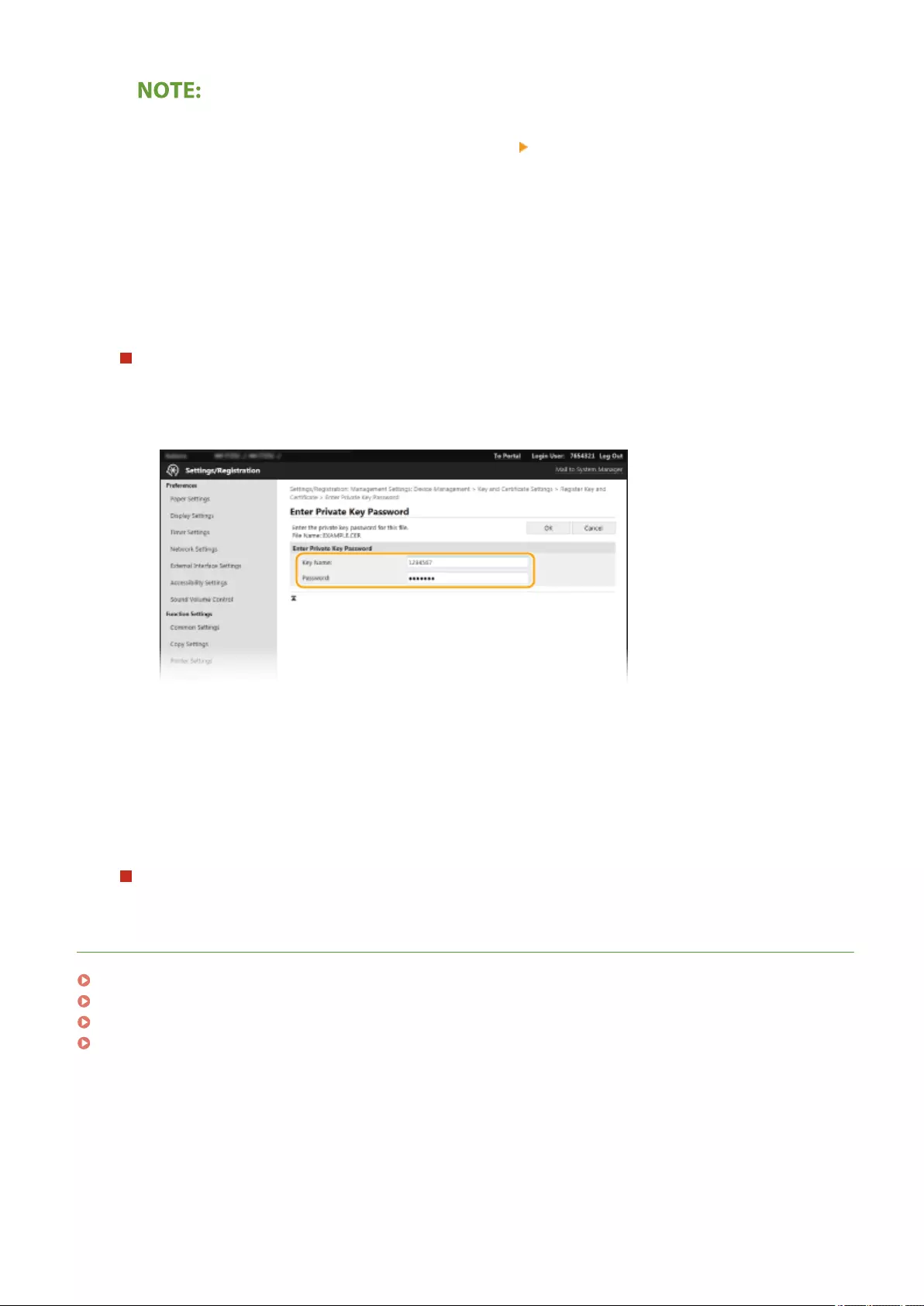
Deleting the key and certicate le or CA certicate le
●Click [Delete] on the right of the le you want to delete click [OK].
6Click [Browse], specify the le to install, and click [Start Installation].
➠The key and certicate le or the CA certicate le is installed on the machine from a computer.
7Register the key and certicate or CA certicate.
Registering a key and certicate
1Click [Register] on the right of the key and certicate le you want to register.
2Enter the name of the key and password.
[Key Name]
Enter alphanumeric characters for the name of the key to be registered.
[Password]
Enter alphanumeric characters for the password of the private key set for the le to be registered.
3Click [OK].
Registering a CA certicate
Click [Register] on the right of the CA certicate le you want to register.
LINKS
Generating the Key and Certicate for Network Communication(P. 373)
Conguring the Key and Certicate for TLS(P. 370)
Conguring IPSec Settings(P. 381)
Conguring IEEE 802.1X Authentication Settings(P. 388)
Managing the Machine
380

Conguring IPSec Settings
2579-07C
Internet Protocol Security (IPSec or IPsec) is a protocol suite for encrypting data transported over a network, including
Internet networks. While TLS only encrypts data used on a specic application, such as a Web browser or an e-mail
application, IPSec encrypts either whole IP packets or the payloads of IP packets, offering a more versatile security
system. The IPSec of the machine works in transport mode, in which the payloads of IP packets are encrypted. With
this feature, the machine can connect directly to a computer that is in the same virtual private network (VPN). Check
the system requirements and set the necessary conguration on the computer before you congure the machine.
Using IPSec with IP address lter
●IP address lter settings are applied before the IPSec policies. Specifying IP Addresses for Firewall
Settings(P. 361)
Conguring IPSec Settings
Before using IPSec for encrypted communication, you need to register security policies (SP). A security policy consists
of the groups of settings described below. After registering policies, specify the order in which they are applied.
Selector
Selector denes conditions for IP packets to apply IPSec communication. Selectable conditions include IP
addresses and port numbers of the machine and the devices to communicate with.
IKE
IKE congures the IKEv1 that is used for key exchange protocol. Note that instructions vary depending on the
authentication method selected.
[Pre-Shared Key Method]
This authentication method uses a common key word, called Shared Key, for communication between the
machine and other devices. Enable TLS for the Remote UI before specifying this authentication method (
Conguring the Key and Certicate for TLS(P. 370) ).
[Digital Signature Method]
The machine and the other devices authenticate each other by mutually verifying their digital signatures.
Generate or install the key and certicate beforehand ( Registering the Key and Certicate for Network
Communication(P. 379) ).
AH/ESP
Specify the settings for AH/ESP, which is added to packets during IPSec communication. AH and ESP can be used
at the same time. You can also select whether or not to enable PFS for tighter security.
Managing the Machine
381

●For more information about the basic operations to be performed when setting the machine from the
Remote UI, see Setting Up Menu Options from Remote UI(P. 416) .
1Start the Remote UI and log in to System Manager Mode. Starting Remote
UI(P. 408)
2Click [Settings/Registration] on the Portal page. Remote UI Screen(P. 409)
3Select [Network Settings] [IPSec Settings].
4Click [Edit].
5Select the [Use IPSec] check box and click [OK].
●If you want the machine to only receive packets that match one of the security policies that you dene in the
steps below, clear the [Receive Non-Policy Packets] check box.
6Click [Register New Policy].
7Specify the Policy Settings.
1In the [Policy Name] text box, enter alphanumeric characters for a name that is used for identifying the
policy.
2Select the [Enable Policy] check box.
8Specify the Selector Settings.
Managing the Machine
382

[Local Address]
Click the radio button for the type of IP address of the machine to apply the policy.
[All IP Addresses] Select to use IPSec for all IP packets.
[IPv4 Address] Select to use IPSec for all IP packets that are sent to or from the IPv4 address of the
machine.
[IPv6 Address] Select to use IPSec for all IP packets that are sent to or from an IPv6 address of the
machine.
[Remote Address]
Click the radio button for the type of IP address of the other devices to apply the policy.
[All IP Addresses] Select to use IPSec for all IP packets.
[All IPv4 Addresses] Select to use IPSec for all IP packets that are sent to or from IPv4 addresses of the
other devices.
[All IPv6 Addresses] Select to use IPSec for all IP packets that are sent to or from IPv6 addresses of the
other devices.
[IPv4 Manual Settings] Select to specify a single IPv4 address or a range of IPv4 addresses to apply IPSec.
Enter the IPv4 address (or the range) in the [Addresses to Set Manually] text box.
[IPv6 Manual Settings] Select to specify a single IPv6 address or a range of IPv6 addresses to apply IPSec.
Enter the IPv6 address (or the range) in the [Addresses to Set Manually] text box.
[Addresses to Set Manually]
If [IPv4 Manual Settings] or [IPv6 Manual Settings] is selected for [Remote Address], enter the IP address to
apply the policy. You can also enter a range of addresses by inserting a hyphen between the addresses.
Entering IP addresses
Description Example
Entering a single address IPv4:
Delimit numbers with periods.
192.168.0.10
Managing the Machine
383
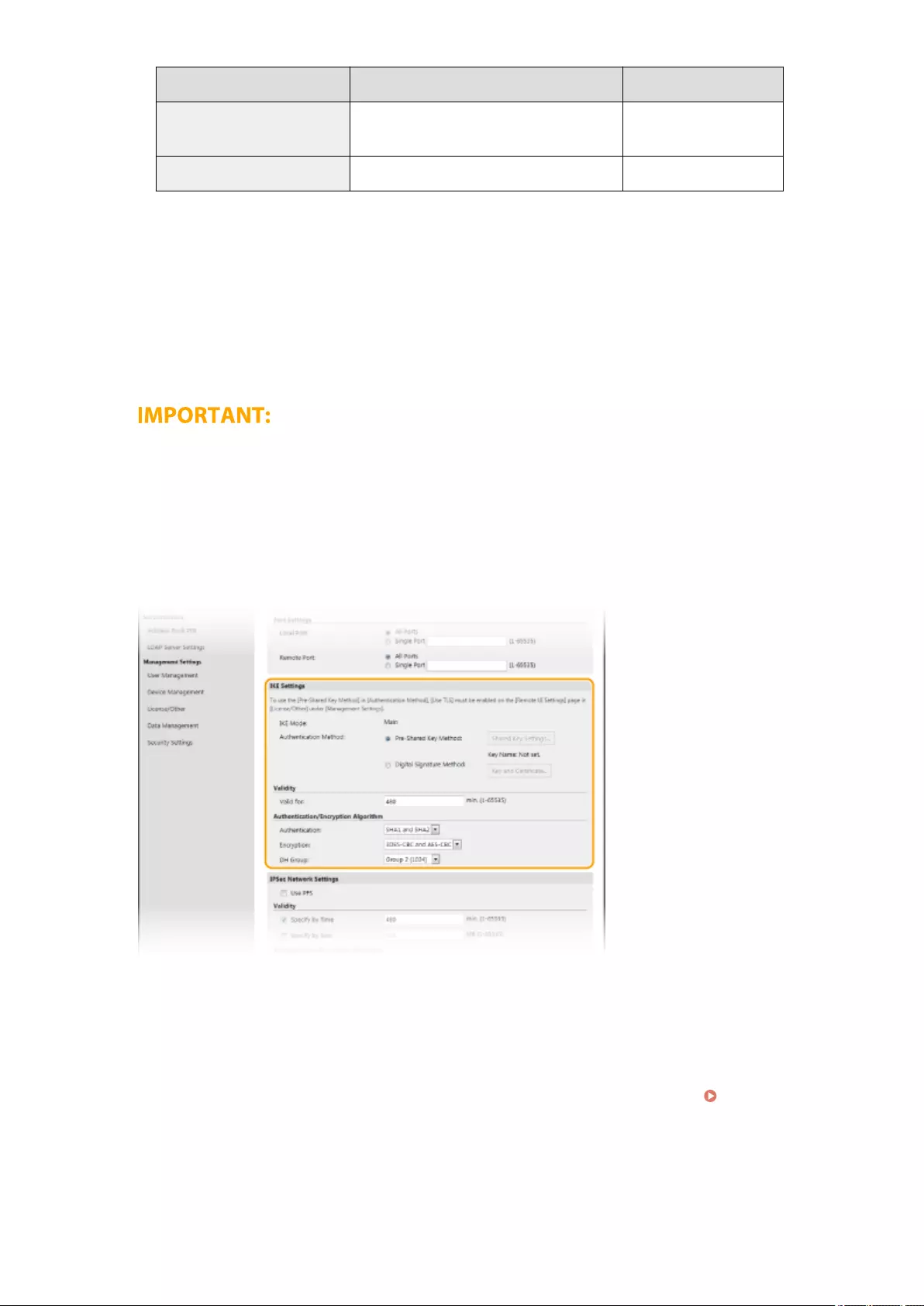
Description Example
IPv6:
Delimit alphanumeric characters with colons.
fe80::10
Specifying a range of addresses Insert a hyphen between the addresses. 192.168.0.10-192.168.0.20
[Subnet Settings]
When manually specifying IPv4 address, you can express the range by using the subnet mask. Enter the
subnet mask using periods to delimit numbers (example:"255.255.255.240").
[Prex Length]
Specifying the range of IPv6 addresses manually also allows you to specify the range using prexes. Enter a
range between 0 and 128 as the prex length.
[Local Port]/[Remote Port]
If you want to create separate policies for each protocol, such as HTTP or WSD, enter the appropriate port
number for the protocol to determine whether to use IPSec.
IPSec is not applied to the following packets
●Loopback, multicast, and broadcast packets
●IKE packets (using UDP on port 500)
●ICMPv6 neighbor solicitation and neighbor advertisement packets
9Specify the IKE Settings.
[IKE Mode]
The mode used for the key exchange protocol is displayed. The machine supports the main mode, not the
aggressive mode.
[Authentication Method]
Select [Pre-Shared Key Method] or [Digital Signature Method] for the method used when authenticating the
machine. You need to enable TLS for the Remote UI before selecting [Pre-Shared Key Method]. You need to
generate or install the key and certicate before selecting [Digital Signature Method]. Conguring the
Key and Certicate for TLS(P. 370)
[Valid for]
Specify how long a session lasts for IKE SA (ISAKMP SA). Enter the time in minutes.
[Authentication]/[Encryption]/[DH Group]
Select an algorithm from the drop-down list. Each algorithm is used in the key exchange.
Managing the Machine
384

[Authentication] Select the hash algorithm.
[Encryption] Select the encryption algorithm.
[DH Group] Select the Die-Hellman group, which determines the key strength.
Authenticating a machine using a pre-shared key
1Click the [Pre-Shared Key Method] radio button for [Authentication Method] and then click [Shared Key
Settings].
2Enter alphanumeric characters for the pre-shared key and click [OK].
3Specify the [Valid for] and [Authentication]/[Encryption]/[DH Group] settings.
Authenticating a machine using digital signature method
1Click the [Digital Signature Method] radio button for [Authentication Method] and then click [Key and
Certicate].
2Click [Register Default Key] on the right of the key and certicate you want to use.
Viewing details of a certicate
●You can check the details of the certicate or verify the certicate by clicking the corresponding text
link under [Key Name], or the certicate icon.
3Specify the [Valid for] and [Authentication]/[Encryption]/[DH Group] settings.
10 Specify the IPSec Network Settings.
[Use PFS]
Select the check box to enable Perfect Forward Secrecy (PFS) for IPSec session keys. Enabling PFS enhances
the security while increasing the load on the communication. Make sure that PFS is also enabled for the other
devices.
[Specify by Time]/[Specify by Size]
Set the conditions for terminating a session for IPSec SA. IPSec SA is used as a communication tunnel. Select
either or both of the check boxes as necessary. If both check boxes are selected, the IPSec SA session is
terminated when either of the conditions has been satised.
[Specify by Time] Enter a time in minutes to specify how long a session lasts.
[Specify by Size] Enter a size in megabytes to specify how much data can be transported in a session.
Managing the Machine
385

[Select Algorithm]
Select the [ESP], [ESP (AES-GCM)], or [AH (SHA1)] check box(es) depending on the IPSec header and the
algorithm used. AES-GCM is an algorithm for both authentication and encryption. If [ESP] is selected, also
select algorithms for authentication and encryption from the [ESP Authentication] and [ESP Encryption] drop-
down lists.
[ESP Authentication] To enable the ESP authentication, select [SHA1] for the hash algorithm. Select [Do Not
Use] if you want to disable the ESP authentication.
[ESP Encryption] Select the encryption algorithm for ESP. You can select [NULL] if you do not want to
specify the algorithm, or select [Do Not Use] if you want to disable the ESP encryption.
[Connection Mode]
The connection mode of IPSec is displayed. The machine supports transport mode, in which the payloads of
IP packets are encrypted. Tunnel mode, in which whole IP packets (headers and payloads) are encapsulated
is not available.
11 Click [OK].
●If you need to register an additional security policy, return to step 6.
12 Arrange the order of policies listed under [Registered IPSec Policies].
●Policies are applied from one at the highest position to the lowest. Click [Up] or [Down] to move a policy up or
down the order.
Editing a policy
●Click the corresponding text link under [Policy Name] for the edit screen.
Deleting a policy
●Click [Delete] on the right of the policy name you want to delete click [OK].
13 Restart the machine.
●Turn OFF the machine, wait for at least 10 seconds, and turn it back ON.
Managing the Machine
386

Conguring IEEE 802.1X Authentication Settings
2579-07E
The machine can connect to an 802.1X network as a client device. A typical 802.1X network consists of a RADIUS server
(authentication server), LAN switch (authenticator), and client devices with authentication software (supplicants). If a
device tries to connect to the 802.1X network, the device must go through user authentication in order to prove that
the connection is made by an authorized user. Authentication information is sent to and checked by a RADIUS server,
which permits or rejects communication to the network depending on the authentication result. If authentication fails,
a LAN switch (or an access point) blocks access from the outside of the network.
IEEE 802.1X Authentication Method
Select the authentication method from the options below. If necessary, install or register a key and certicate or
a CA certicate before conguring IEEE 802.1X authentication ( Registering the Key and Certicate for
Network Communication(P. 379) ).
TLS
The machine and the authentication server authenticate each other by mutually verifying their certicates. A
key and certicate issued by a certication authority (CA) is required for the client authentication (when
authenticating the machine). For the server authentication, a CA certicate installed via the Remote UI can be
used in addition to a CA certicate preinstalled in the machine.
TTLS
This authentication method uses a user name and password for the client authentication and a CA certicate
for the server authentication. MSCHAPv2 or PAP can be selected as the internal protocol. TTLS can be used
with PEAP at the same time. Enable TLS for the Remote UI before conguring this authentication method (
Conguring the Key and Certicate for TLS(P. 370) ).
PEAP
The required settings are almost the same as those of TTLS. MSCHAPv2 is used as the internal protocol.
Enable TLS for the Remote UI before conguring this authentication method ( Conguring the Key and
Certicate for TLS(P. 370) ).
●For more information about the basic operations to be performed when setting the machine from the
Remote UI, see Setting Up Menu Options from Remote UI(P. 416) .
1Start the Remote UI and log in to System Manager Mode. Starting Remote
UI(P. 408)
Managing the Machine
388

2Click [Settings/Registration] on the Portal page. Remote UI Screen(P. 409)
3Select [Network Settings] [IEEE 802.1X Settings].
4Click [Edit].
5Select the [Use IEEE 802.1X] check box, and enter the login name in the [Login Name]
text box.
[Use IEEE 802.1X]
Select the check box to enable IEEE 802.1X authentication.
[Login Name]
Enter alphanumeric characters for a name (EAP identity) that is used for identifying the user.
6Congure the required settings according to the specied authentication method.
Setting TLS
1Select the [Use TLS] check box and click [Key and Certicate].
●You cannot use TLS with TTLS or PEAP.
2Click [Register Default Key] on the right of the key and certicate you want to use for the client
authentication.
Viewing details of a certicate
●You can check the details of the certicate or verify the certicate by clicking the corresponding text
link under [Key Name], or the certicate icon.
Managing the Machine
389
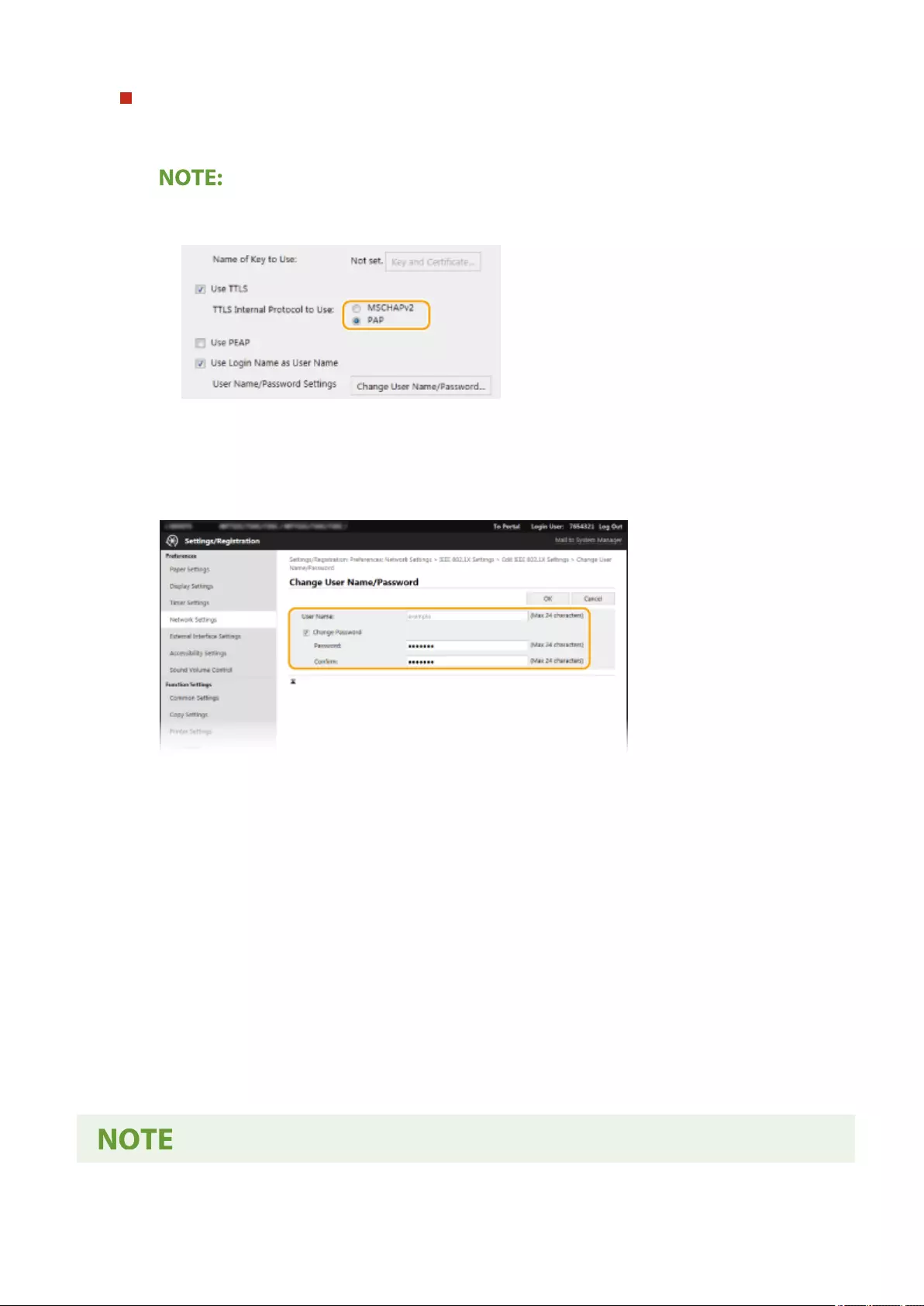
Setting TTLS/PEAP
1Select the [Use TTLS] or [Use PEAP] check box.
Internal protocol for TTLS
●You can select MSCHAPv2 or PAP.
2Click [Change User Name/Password].
●To specify a user name other than the login name, clear the [Use Login Name as User Name] check
box. Select the check box if you want to use the login name as the user name.
3Set the user name/password.
[User Name]
Enter alphanumeric characters for the user name.
[Change Password]
To set or change the password, select the check box and enter alphanumeric characters for the new
password both in the [Password] and [Conrm] text boxes.
4Click [OK].
7Click [OK].
8Restart the machine.
●Turn OFF the machine, wait for at least 10 seconds, and turn it back ON.
Managing the Machine
390

Restricting the Machine's Functions
2579-07F
Some of the functions of the machine may rarely be used or provide opportunities for misuse. For security purposes,
the machine can be set to limit its capabilities by partially or completely disabling these functions.
Restricting Access to Address Book and Sending Functions
You can specify the PIN in the Address Book to disable a general user from modifying data or limit destinations
that can be specied for fax sending. You can also disable a user from collectively sending a fax to multiple
destinations (Sequential Broadcast). Restricting Access to Address Book and Sending Functions(P. 394)
Restricting Printing from a Computer
You can limit "printing from computer" only to secure documents so that no print jobs can be executed unless
the PIN is entered on the machine side. Restricting Printing from a Computer(P. 400)
Restricting USB Functions
The USB connection allows an easy connection with peripheral devices, but it may cause a security risk such as
an information leakage. You can restrict a USB connection with a computer or saving to a USB memory device.
Restricting USB Functions(P. 401)
Disabling HTTP Communication
When not performing operations via the network, for example, when using the machine via USB connection,
you can disable HTTP communication to prevent a hacking via the HTTP port. Disabling HTTP
Communication(P. 403)
Managing the Machine
392

Restricting Access to Address Book and Sending
Functions
2579-07H
Some cases of information leakage can be prevented by limiting the available fax and e-mail destinations to those
registered in the Address Book or LDAP servers, or by setting a PIN for the Address Book so that unauthorized users
cannot add or edit Address Book entries. You can also avoid sending documents to unintended recipients if the
machine is set to ask you to enter the fax number twice for conrmation.
Restricting Use of the Address Book(P. 395)
Limiting Available Destinations(P. 396)
Restricting the Fax Sending Functions(P. 398)
Managing the Machine
394

Restricting Use of the Address Book
2579-07J
The Address Book can be set to require users to enter a PIN in order to add new
entries to the Address Book or edit existing entries. Setting a PIN to the Address
Book can reduce the risk of documents being sent to unintended recipients because
changes to the Address Book can only be made by users who know the PIN.
1Select <Menu> in the Home screen. Home Screen(P. 120)
2Select <Set Destination>.
●If the login screen appears, enter the correct ID and PIN. Logging in to the Machine(P. 131)
3Select <Address Book PIN>.
4Specify the PIN.
●Enter the number, and select <Apply>.
●The Conrm screen is displayed. Enter the PIN once again to conrm.
●You cannot set a PIN that consists only of zeros, such as "00" or "0000000".
●To cancel the PIN setting, clear the information you entered in and select <Apply> with the eld blank.
In addition to setting the Address Book PIN, you can further enhance security by performing the following
operations:
●Restricting the addition of new destinations, see Restricting New Destinations that Can Be
Specied(P. 396) .
●Disabling the PC fax function, see Restricting Fax Sending from a Computer(P. 398) .
LINKS
Registering Destinations(P. 181)
Registering Destinations from Remote UI(P. 419)
Managing the Machine
395

Limiting Available Destinations
2579-07K
By limiting destinations that can be specied to those registered in the Address Book
or LDAP servers, you can reduce the possibility of specifying unintended destinations
and prevent users from leaking information. You can congure the setting to display
the conrmation screen to prevent the user from misdialing when specifying a coded
dial number in the Address Book.
Restricting New Destinations that Can Be Specied(P. 396)
Disabling Use of Previously Used Destinations(P. 396)
Displaying Destinations in Address Book(P. 396)
Checking Destinations when Sending Data(P. 397)
Restricting New Destinations that Can Be Specied
Restrict destinations that can be specied when sending faxes or scanned documents to "those already registered in
the Address Book," "those previously used," or "those searchable from the LDAP servers." When this function is
enabled, the machine prohibits users from entering destinations using the numeric keys, adding new entries to the
Address Book, and editing the existing Address Book entries.
<Menu> <Function Settings> <Send> <Common Settings> <Restrict New
Destinations> <On>
●This function does not limit the available destinations for PC faxing. Restricting Fax Sending from a
Computer(P. 398)
Disabling Use of Previously Used Destinations
Prohibits the specication of destinations from the transmission records. Using this restriction prevents destinations
being selected from the transmission records for "Send Fax," "Scan and Send as E-mail" and "Scan and Save to Shared
Folder or FTP Server."
<Menu> <Function Settings> <Send> <Common Settings> <Restrict Resending from
Log> <On>
Displaying Destinations in Address Book
When using coded dial numbers to specify destinations, you need to precisely remember whose destination (or what
group) is registered in what coded dial number. If you do not remember all these numbers accurately, you may send
your documents to unintended destinations. You can avoid sending data to unintended recipients by conguring the
Managing the Machine
396

machine to display the details of the coded dial number you selected/entered as a sending destination on the screen
before you send documents to that destination.
<Menu> <Function Settings> <Send> <Common Settings> <Conrm When Coded Dial
TX> <On>
Checking Destinations when Sending Data
You can congure a setting so that the destination conrmation screen is displayed when fax, e-mail, or I-Fax sending
starts. If <Only for Sequential Broadcast> is selected, the conrmation screen is displayed only when multiple
destinations are specied.
<Menu> <Function Settings> <Send> <Common Settings> <Conrm Dest. Before
Sending> Select <On> or <Only for Sequential Broadcast>
LINKS
Sending I-Faxes(P. 251)
Sending Data by E-Mail/Saving Data to a Shared Folder or FTP Server(P. 293)
Recalling Previously Used Settings for Sending/Saving (Recall Settings)(P. 313)
Restricting Use of the Address Book(P. 395)
Restricting the Fax Sending Functions(P. 398)
Managing the Machine
397

Restricting the Fax Sending Functions
2579-07L
You can set various restrictions for sending faxes, which can prevent information leakage to third parties or sending
documents to unintended destinations.
Conrming the Entered Fax Number(P. 398)
Restricting Fax Sending from a Computer(P. 398)
Restricting Sequential Broadcasts(P. 398)
Conrming the Entered Fax Number
You can congure the setting to display the conrmation screen to prevent the user from misdialing when entering a
destination fax number using the numeric keys.
<Menu> <Function Settings> <Send> <Fax Settings> <Conrm Entered Fax Number>
<On>
Restricting Fax Sending from a Computer
You can prohibit users from PC faxing (faxing from a computer).
<Menu> <Function Settings> <Send> <Fax Settings> <Allow Fax Driver TX> <Off>
Restricting Sequential Broadcasts
You can prohibit a function that collectively sends a fax to multiple destinations (Sequential Broadcast).
<Menu> <Function Settings> <Send> <Fax Settings> <Restrict Sequential
Broadcast> <On>
LINKS
Basic Operations for Sending Faxes(P. 220)
Recalling Previously Used Settings for Sending (Recall Settings)(P. 234)
Managing the Machine
398
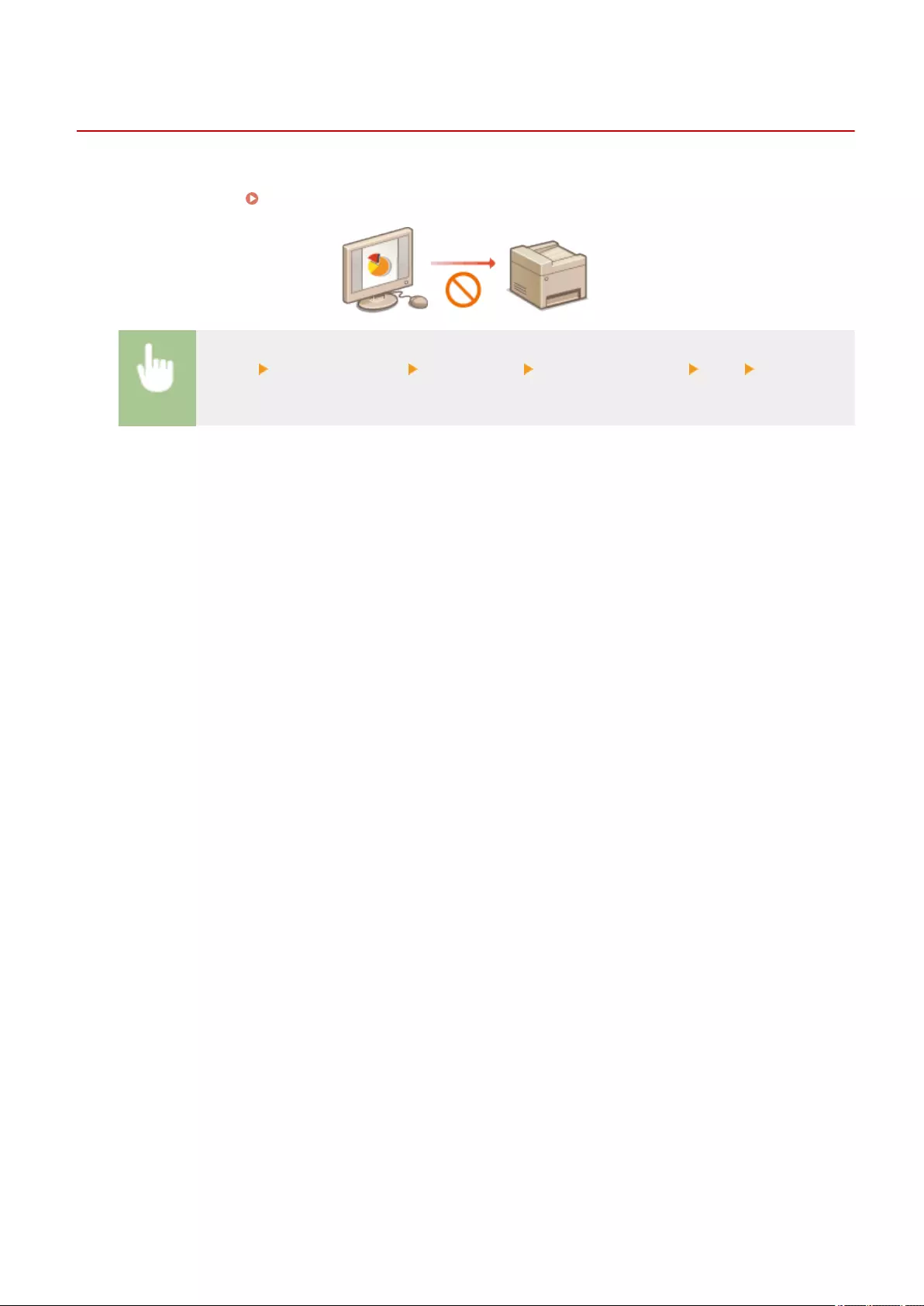
Restricting Printing from a Computer
2579-07R
You can drastically reduce information leakage risks by limiting the documents printable from a computer to the
Secure Print documents ( Printing a Document Secured by a PIN (Secure Print)(P. 268) ).
<Menu> <Function Settings> <Secure Print> <Restrict Printer Jobs> <On> Restart the
machine
Managing the Machine
400

Restricting USB Functions
2579-07S
USB is a convenient way of connecting peripheral devices and storing or relocating data, but USB can also be a source
of information leakage if it is not properly managed. Be especially careful when handling USB memory devices. This
section describes how to restrict connection via the USB port of the machine and how to prohibit use of USB memory
devices.
Restricting the USB Connection with a Computer(P. 401)
Restricting the Scan to USB Function(P. 401)
Restricting the USB Print Function(P. 401)
Restricting the USB Connection with a Computer
You can disable the computer connection USB port located on the left side of the machine. If this port is disabled, the
machine cannot communicate with a computer via USB. This setting does not affect the right-side USB port, which is
for attaching USB memory devices.
<Menu> <Preferences> <External Interface> <USB Settings> Select <Off> in <Use as USB
Device> <Apply> Restart the machine
Restricting the Scan to USB Function
You can disable storing scanned original data into a USB memory device.
<Menu> <Function Settings> <Store/Access Files> <Memory Media Settings> Select <Off>
in <Use Scan Function> <Apply> Restart the machine
Restricting the USB Print Function
You can disable printing data from a USB memory device. The data in the USB memory device cannot be printed.
<Menu> <Function Settings> <Store/Access Files> <Memory Media Settings> Select <Off>
in <Use Print Function> <Apply> Restart the machine
LINKS
Managing the Machine
401

Disabling HTTP Communication
2579-07U
HTTP is used for communications over the network, such as when you access the machine via the Remote UI. If you
are using a USB connection or are otherwise not using HTTP, you can disable HTTP to block malicious third-party
intrusions via the unused HTTP port.
●Disabling HTTP disables some of the network capabilities, such as the Remote UI and WSD printing.
<Menu> <Preferences> <Network> <TCP/IP Settings> <Use HTTP> <Off> <Yes>
LINKS
Managing the Machine from a Computer (Remote UI)(P. 407)
Changing Port Numbers(P. 367)
Conguring Printing Protocols and WSD Functions(P. 44)
Managing the Machine
403
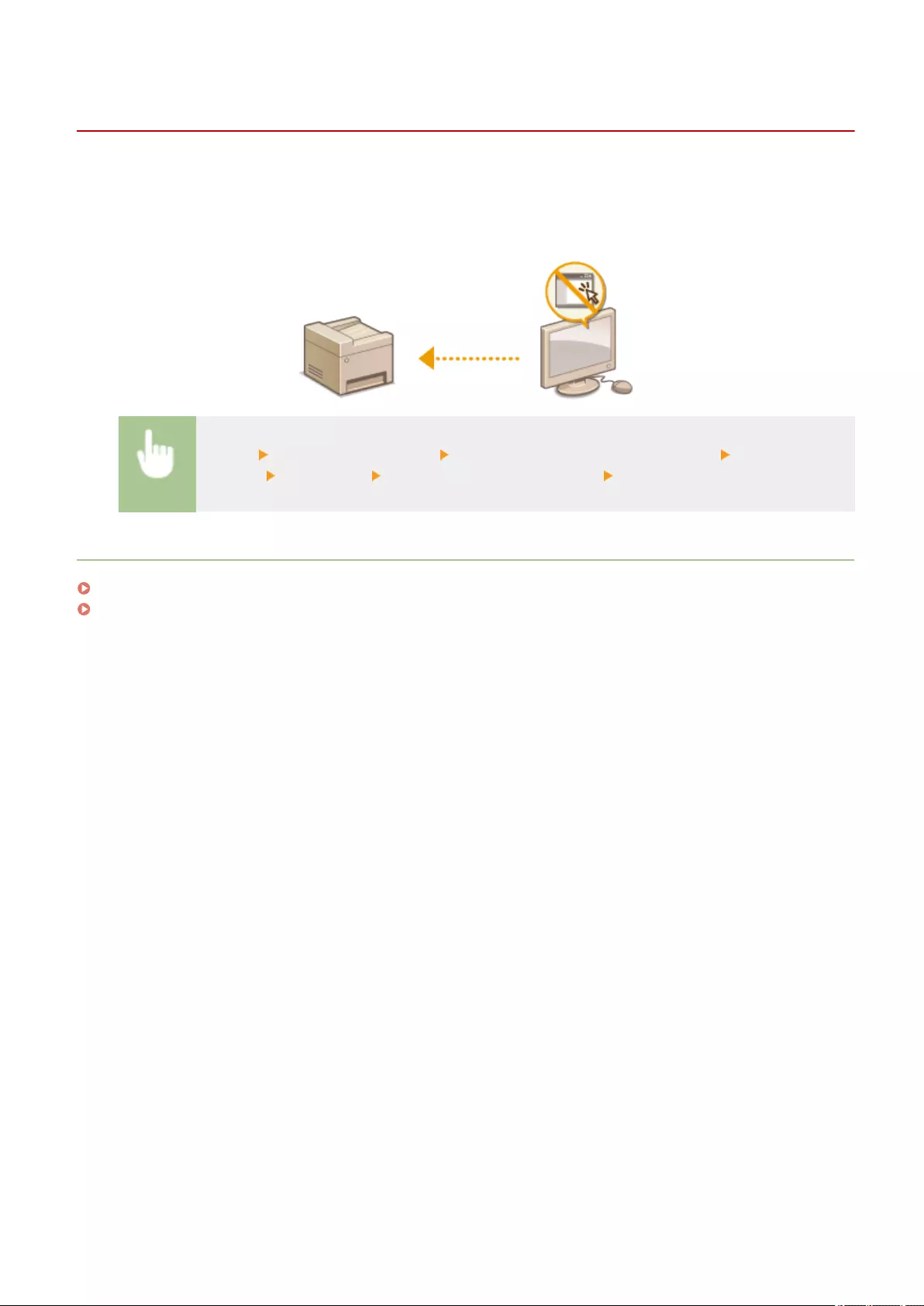
Disabling Remote UI
2579-07W
The Remote UI is useful because the machine settings can be specied by using a Web browser on a computer. To use
the Remote UI, the machine must be connected to a computer over the network. If the machine is connected to a
computer via USB, or if you do not need to use the Remote UI, you might want to disable the Remote UI to reduce the
risk of having your machine controlled remotely over the network by malicious third parties.
<Menu> <Management Settings> <Remote UI Settings/Update Firmware> <Remote UI
Settings> <Remote UI> Select <Off> in <Use Remote UI> Restart the machine
LINKS
Managing the Machine from a Computer (Remote UI)(P. 407)
Disabling HTTP Communication(P. 403)
Managing the Machine
404

Increasing the Security of Documents
2579-07X
The machine is equipped with security functions designed to prevent documents from being leaked or tampered with.
Device Signature
The digital signature is added to scanned documents using a key and certicate mechanism in order to prove to
the recipient that the document has been created on the machine. The recipient can verify "the device that
created the document" and "whether the document has been tampered with." Before adding a device
signature, you need to generate a key and certicate (device certicate) that is used for the device signature
using the machine. Generating a Device Signature Key(P. 406)
Managing the Machine
405

Generating a Device Signature Key
2579-07Y
You can generate a key and certicate for the device signature that show a document was scanned on the machine.
The certicate is appended when an document is scanned and converted into a PDF le.
●Only one key and certicate for the device signature can be generated. It cannot be deleted.
●Key and certicate for the device signature are valid for ve years. Renew them when required.
●For more information about the basic operations to be performed when setting the machine from the
Remote UI, see Setting Up Menu Options from Remote UI(P. 416) .
1Start the Remote UI and log in to System Manager Mode. Starting Remote
UI(P. 408)
2click [Settings/Registration] on the Portal page. Remote UI Screen(P. 409)
3Select [Device Management] [Key and Certicate Settings].
4Click [Generate Key].
5Select the [Device Signature] check box, and click [OK].
➠A key and certicate for the device signature is generated.
Renewing the Device Signature Key and the Key and Certicate
1Click [Update] at the right of the key and certicate for the device signature.
2Click [OK].
Managing the Machine
406

Managing the Machine from a Computer (Remote UI)
2579-080
Using a Web browser to operate the machine remotely, you can check the documents waiting to be printed or the
status of the machine. You can also make various settings. You can do this without leaving your desk, making system
management easier. For more information about the system requirements for the Remote UI, see Other
Specications(P. 724) .
Functions of the Remote UI
Checking the Status and Logs(P. 411)
Setting Up Menu Options from Remote UI(P. 416)
Registering Destinations from Remote UI(P. 419)
Importing/Exporting the Setting Data(P. 423)
Basics of the Remote UI
Starting Remote UI(P. 408)
Managing the Machine
407

Starting Remote UI
2579-081
To operate remotely, you need to input the IP address of the machine into a Web browser and start the Remote UI.
Check the IP address set to the machine in advance ( Viewing Network Settings(P. 41) ). If you have any questions,
ask your Network Administrator.
1Start the Web browser.
2Enter "http://<the IP address of the machine>/" in the address eld, and press the
[ENTER] key.
●If you want to use an IPv6 address, enclose the IPv6 address with brackets (example: http://
[fe80::2e9e:fcff:fe4e:dbce]/).
If a security alert is displayed
●A security alert may be displayed when the Remote UI communication is encrypted ( Conguring the
Key and Certicate for TLS(P. 370) ). When certicate settings or TLS settings have no errors, continue
browsing the Web site.
3Log in to the Remote UI.
When the Department ID Management is disabled
Select [System Manager Mode] or [General User Mode], and enter a value in [Remote UI Access PIN] as
necessary.
[System Manager Mode]
You can perform all the Remote UI operations and settings. Enter the appropriate ID in [System Manager ID]
and PIN in [System Manager PIN]. Setting the System Manager ID and PIN(P. 344)
[General User Mode]
You can check the status of documents or the machine, and you can also change some of the settings. When
you want to check if a specic document of yours is in the print queue or cancel the printing of a document
of yours in the print queue, enter the user name of the document in [User Name]. The user name is
automatically set to print documents based on information such as your computer name or computer login
name.
[Remote UI Access PIN]
Managing the Machine
408

If [Remote UI Access PIN] is set, enter the PIN. Setting a Remote UI PIN(P. 352)
When the Department ID Management is enabled
Enter the appropriate ID in [Department ID] and PIN in [PIN]. Setting the Department ID
Management(P. 346)
4Click [Log In].
➠The Portal page (main page) will be displayed. Remote UI Screen(P. 409)
Remote UI Screen
When you log in to the Remote UI, the following Portal page appears. This section describes the items displayed on
the Portal page and the basic operations.
[Device Basic Information]
Displays the current status of the machine and error information. If an error has occurred, the link to the
Error Information page will be displayed.
Managing the Machine
409

[Consumables Information]
Displays paper information and the amount of ink remaining.
[Support Link]
Displays the support link specied in [Support Link] under [License/Other].
Refresh Icon
Refreshes the currently displayed page.
[Language]
Selects the display language used for the Remote UI screens.
[Log Out]
Logs off from the Remote UI. The Login page will be displayed.
[Mail to System Manager]
Displays a window for creating an e-mail to the system manager specied in [System Manager Information]
under [User Management].
[Status Monitor/Cancel]
Displays the [Status Monitor/Cancel] page. For any of the waiting documents, you can check the status/
history or cancel the processing.
[Settings/Registration]
Displays [Settings/Registration] page. When you have logged in to System Manager Mode, you can change
the settings items and save/load the registered data. Setting Up Menu Options from Remote UI(P. 416)
[Address Book]
Displays the coded dial numbers and the Favorites list registered in the Address Book. You can also register
or edit the Address Book when you have logged in to System Manager Mode. Registering Destinations
from Remote UI(P. 419)
Managing the Machine
410

Checking the Status and Logs
2579-082
Checking Current Status of Print Documents(P. 411)
Checking History of Documents(P. 412)
Checking Error Information(P. 412)
Checking Consumables(P. 413)
Checking Device Specications(P. 413)
Checking System Manager Information(P. 413)
Checking Print Head Status(P. 414)
Checking Print Total Counter(P. 415)
●A le name of a document may not be displayed in full. The printed application name may be added to the
le name.
Checking Current Status of Print Documents
The list of the documents currently printing or waiting to be printed is displayed.
Log in to the Remote UI ( Starting Remote UI(P. 408) ) [Status Monitor/Cancel] [Job Status]
●You can delete a document job by clicking [Cancel].
●Regardless of the Department ID Management setting, all the print documents currently printing and
waiting to be printed will be listed.
●If you entered your user name when you logged on in General User Mode, your user name will only
be displayed on the documents that you printed.
●Click [Job Number] on the paused documents and secure documents to display detailed information.
You can check the user name and the page count of the printed document.
Managing the Machine
411

Checking History of Documents
The history of print, copy, sending faxes/e-mails (TX), or receiving faxes (RX) is displayed.
Log in to the Remote UI ( Starting Remote UI(P. 408) ) [Status Monitor/Cancel] [Job Log]
Checking Error Information
When an error occurs, this page will be displayed by clicking the message displayed under [Error Information] on the
Portal page (main page). Remote UI Screen(P. 409)
Log in to the Remote UI ( Starting Remote UI(P. 408) ) [Status Monitor/Cancel] [Error
Information]
Managing the Machine
412
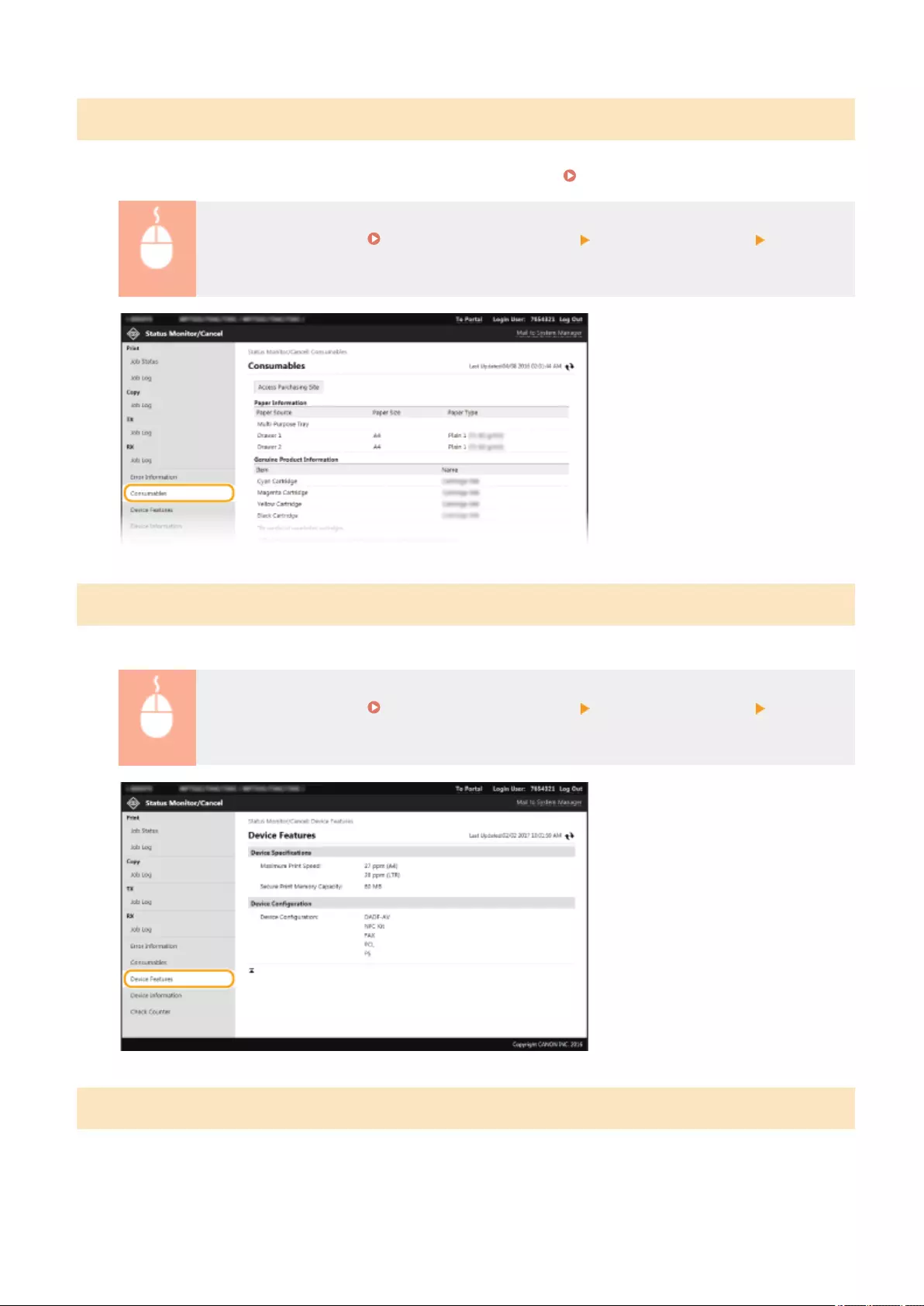
Checking Consumables
Paper size and paper type for the paper source, ink tank model number, etc. are displayed. You can also click [Check
Consumables Details] in the Portal page (main page) to display this page ( Remote UI Screen(P. 409) ).
Log in to the Remote UI ( Starting Remote UI(P. 408) ) [Status Monitor/Cancel]
[Consumables]
Checking Device Specications
The maximum print speed and machine features are displayed.
Log in to the Remote UI ( Starting Remote UI(P. 408) ) [Status Monitor/Cancel] [Device
Features]
Checking System Manager Information
Information about the machine and the system manager is displayed. The device name and other system manager
information displayed here correspond to the settings in [System Manager Information] on the [User Management]
page or in [Device Information Settings] on the [Device Management] page.
Managing the Machine
413
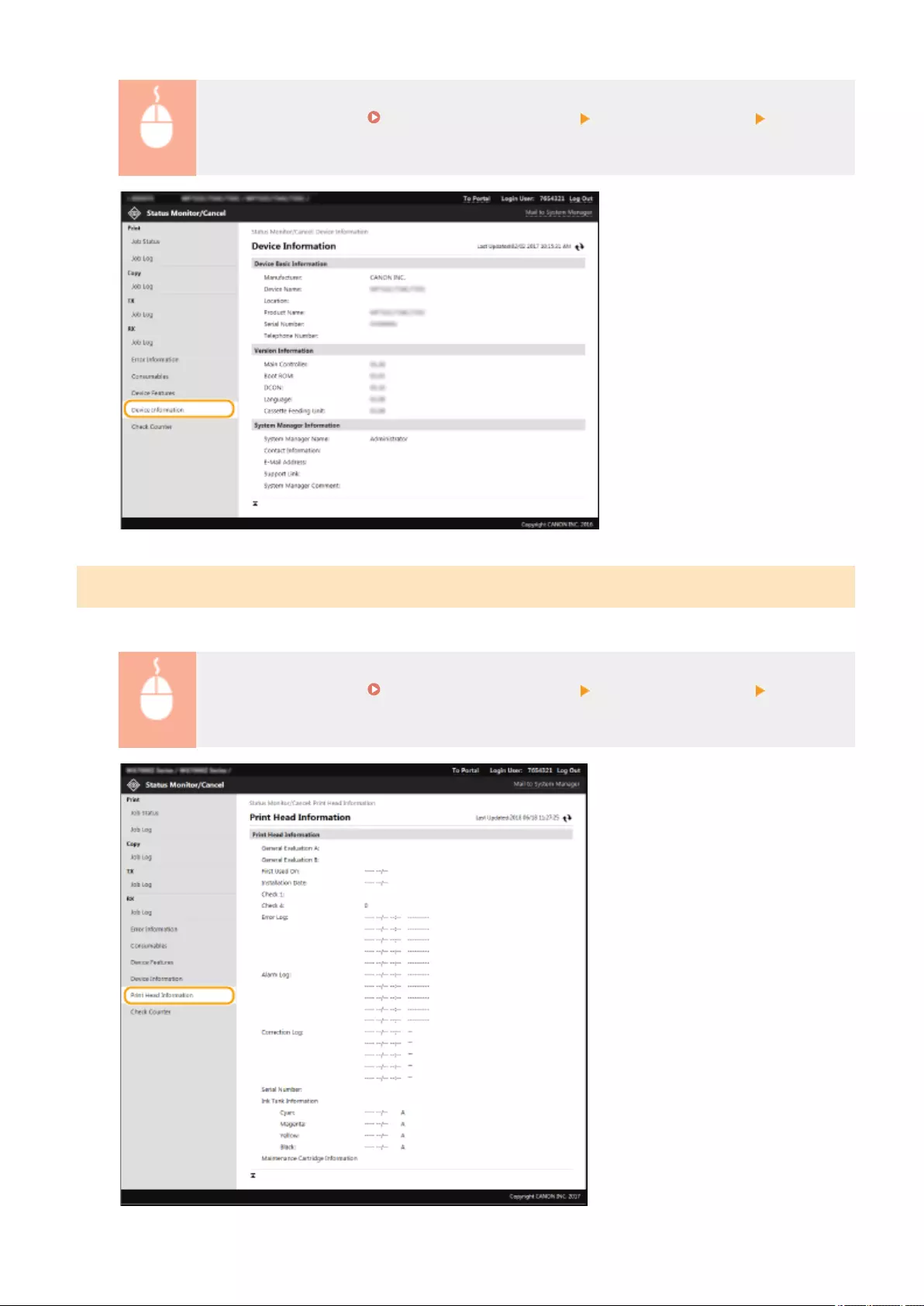
Log in to the Remote UI ( Starting Remote UI(P. 408) ) [Status Monitor/Cancel] [Device
Information]
Checking Print Head Status
You can check the usage of the print head and other logs.
Log in to the Remote UI ( Starting Remote UI(P. 408) ) [Status Monitor/Cancel] [Print Head
Information]
Managing the Machine
414

Setting Up Menu Options from Remote UI
2579-083
You can change the various machine settings by using the Remote UI. Most of the settings can be set also on the
machine, but some settings can only be set using the Remote UI. This section describes the basic ow of changing the
settings of the machine using the Remote UI.
●Some settings can only be changed when you have logged in to System Manager Mode.
●Some settings may require operations that differ from the procedure described here.
1Start the Remote UI. Starting Remote UI(P. 408)
2Click [Settings/Registration] on the Portal page. Remote UI Screen(P. 409)
3Click the setting you want to congure in the menu on the left side of the screen.
4Click the link to display the desired page as necessary.
Managing the Machine
416

5Click [Edit].
6Specify the required settings.
7Click [OK].
Managing the Machine
417

8Restart the machine as necessary.
●Turn OFF the machine, wait for at least 10 seconds, and turn it back ON.
●For information about whether you need to restart the machine, view the message on the edit screen.
Managing the Machine
418

Registering Destinations from Remote UI
2579-084
You can use the computer to register destinations in the Address Book of the machine and edit information of
registered destinations. Specify the shared folder or FTP server destination here.
●You can change the settings only when you have logged in to System Manager Mode.
1Start the Remote UI. Starting Remote UI(P. 408)
2Click [Address Book] on the Portal page. Remote UI Screen(P. 409)
If the enter PIN page is displayed
●The Address Book is protected by a PIN. Enter the [PIN] and click [OK].
3Click [Coded Dial].
●You can also register destinations in Favorites. In this case, click [Favorites] instead of [Coded Dial].
Favorites(P. 181)
4Click the text link under [Number], [Type], or [Name] for an item named "Not
Registered."
●You can edit a registered item by clicking the corresponding text link under [Number], [Type] or [Name].
●You can delete a registered destination by clicking the corresponding [Delete] button.
●If you delete a destination from the Address Book, it is also deleted from the favorite settings.
Registering Frequently Used Settings(P. 173)
5Select [Destination Type to Register] and click [OK].
●To register the shared folder or FTP server destination, select [File].
Managing the Machine
419
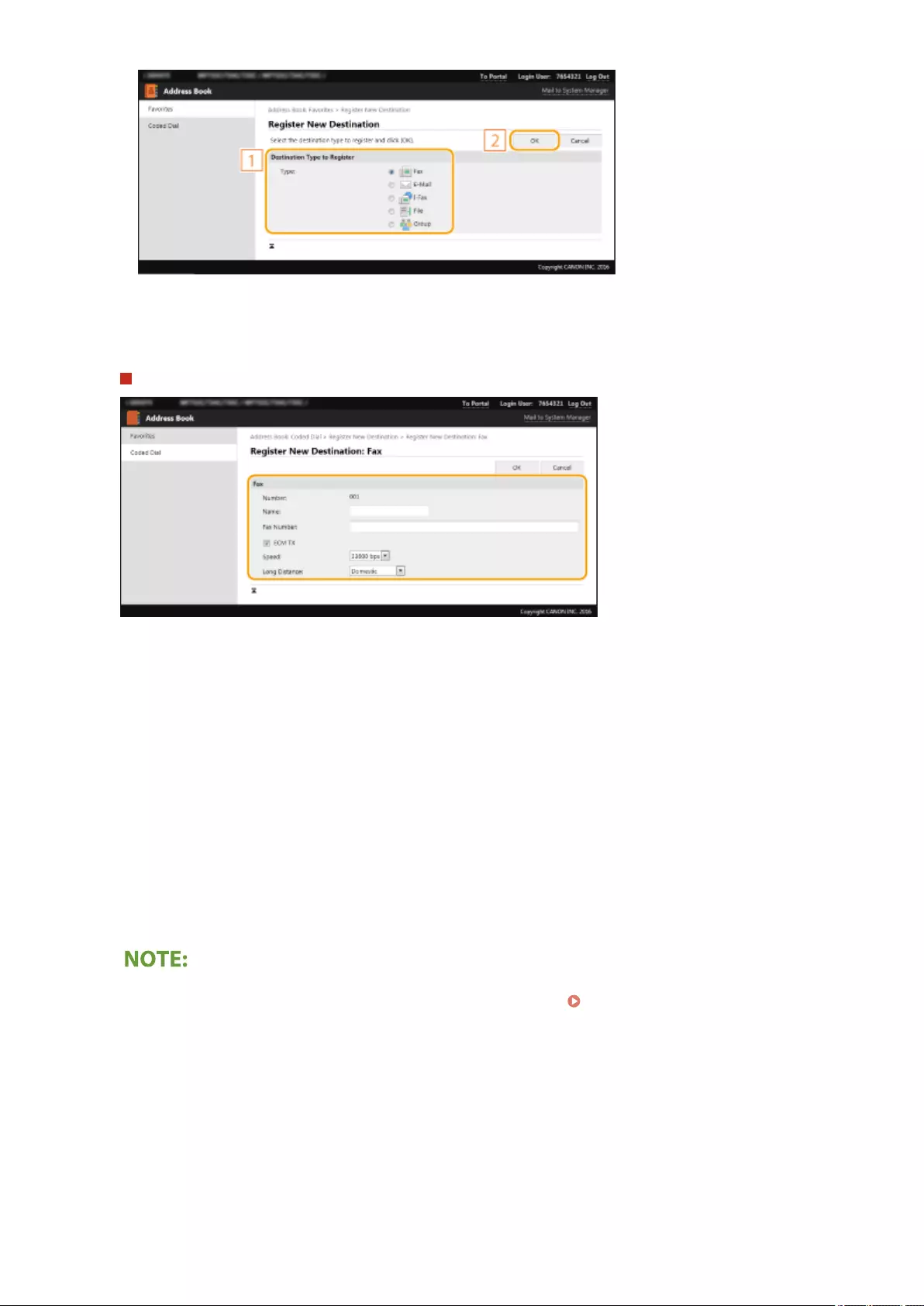
6Specify the destination.
To register the fax destination
[Name]
Enter the name of the destination.
[Fax Number]
Enter the fax number of the destination.
[ECM TX]
Select the check box to make the following possible: if an error occurs in an image that is being sent, the error is
checked and corrected to prevent an improper image from being sent.
[Speed]
If it takes time for transmissions to start, such as when there is a poor telephone connection, you can adjust the
transmission start speed downward.
[Long Distance]
Specify [International (1)] to [International (3)] according to the transmission conditions when registering
overseas fax numbers.
●You can also specify [ECM TX] and [Speed] from <Fax Settings> ( <Send>(P. 484) ) on the operation panel.
However, settings made from <Address Book> are enabled for the detailed settings of destinations
registered in the Address Book.
Managing the Machine
420

To register the e-mail or I-Fax destination
[Name]
Enter the name of the destination.
[E-Mail Address]/[I-Fax Address]
Enter the e-mail address of the destination.
To register the shared folder or FTP server destination
[Name]
Enter the name for the destination.
[Protocol]
Select the protocol for the destination.
[Windows (SMB)] Select this when registering a shared folder as a destination.
[FTP] Select this when registering an FTP server as a destination.
[Host Name]
●For a shared folder
Enter the computer name or IP address. You can include a path to the shared folder with the computer
name or IP address (e.g. "\\swan\share" or "\\192.168.2.100\share").
●For an FTP server
Enter the IP address of the FTP server (e.g. "192.168.2.100").
Using a DNS server
●You can also enter the host name (or FQDN) instead of the computer name or IP address (e.g. for a shared
folder: "\\swan.organization.company.com\share").
Managing the Machine
421

[Folder Path]
Enter the location of the folder to which the data will be sent.
●For a shared folder
Use "\" as a separator. Specify the level that follows the path specied in [Host Name].
●For an FTP server
Use "/" as a separator. The path is an absolute path when a "/" is placed at its top, otherwise a relative path
with respective to the current directory of the user who has logged in.
[User Name]
Enter the user name set for the shared folder or FTP server.
[Set Password]
To set a password for the shared folder or FTP server, select the check box and enter a [Password].
Ensure that the same display language is selected on both the computer and the
Remote UI.
●[Host Name] and [Folder Path] may not be displayed correctly or may not be referenceable.
7Click [OK].
LINKS
Remote UI Screen(P. 409)
Importing/Exporting the Setting Data(P. 423)
Address Book List(P. 623)
Managing the Machine
422
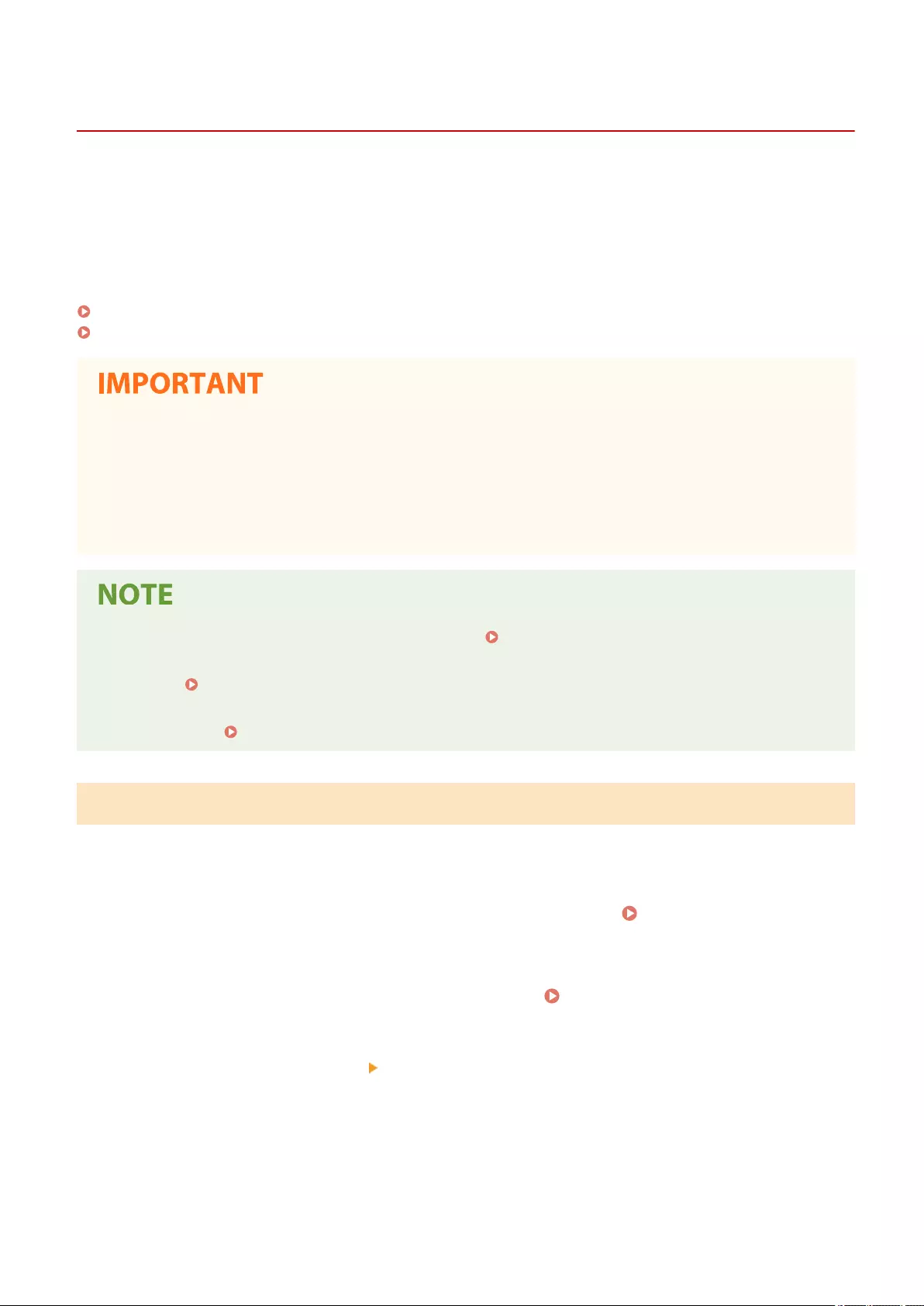
Importing/Exporting the Setting Data
2579-085
Address Book and machine settings data can be saved on your computer (export). Data that is saved on your
computer can also be registered in the machine (import). You can easily copy the destinations in the Address Book
to multiple machines.* To use these features, it is required that you have logged in to System Manager Mode.
*Depending on the model, you cannot import the Address Book data that exported from the machine. If using the same
model, you can import/export machine settings data.
Exporting the Setting Data(P. 423)
Importing the Setting Data(P. 424)
Do not turn OFF the machine until the import or export process is complete
●It may take a few minutes to complete the process. If the machine is turned OFF during the process, it may
result in damage to data or the machine.
Do not operate the machine during the import or export process
●Before importing/exporting, check that no operation such as printing documents is currently proceeding.
●For the settings that cannot be imported/exported, see Setting Menu List(P. 431) .
●You can also import/export settings data via a USB memory device by using the operation panel of the
machine. <Import/Export>(P. 503)
●For more information about the basic operations to be performed when setting the machine from the
Remote UI, see Setting Up Menu Options from Remote UI(P. 416) .
Exporting the Setting Data
You can export Address Book and machine settings data, and save them on a computer. It is recommended that you
regularly back up important settings.
1Start the Remote UI and log in to System Manager Mode. Starting Remote
UI(P. 408)
2Click [Settings/Registration] on the Portal page. Remote UI Screen(P. 409)
3Select [Data Management] [Export].
4Select the settings to export, and specify the encryption password.
Managing the Machine
423
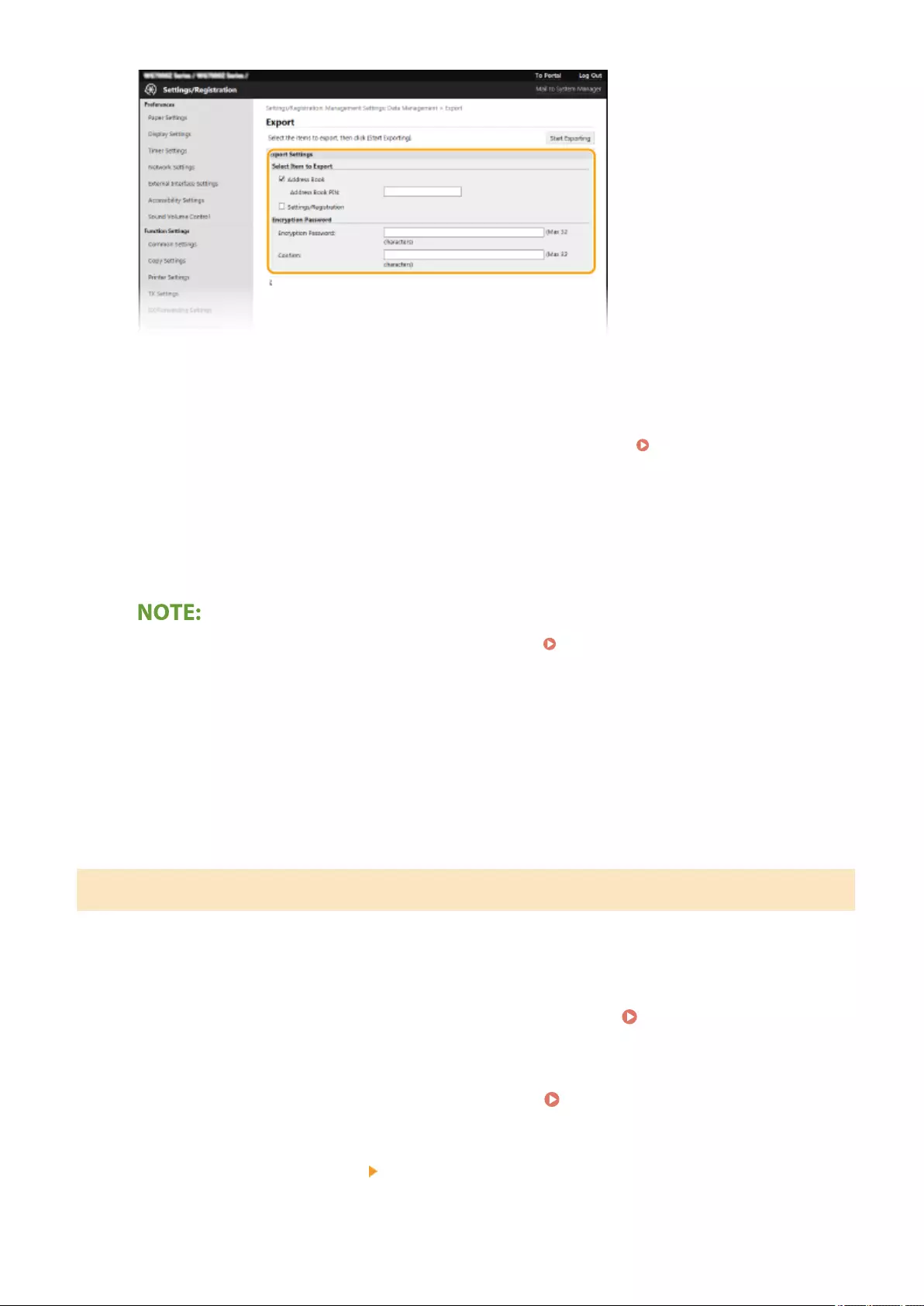
[Address Book]
Select the check box to export Address Book data.
[Address Book PIN]
If the Address Book is code-protected, enter the code for the Address Book. Restricting Use of the
Address Book(P. 395)
[Settings/Registration]
Select the check box to export machine settings data.
[Encryption Password]
Enter a password to encrypt the export data using alphanumeric characters. Enter the same password in
[Conrm]. To export the data, you must set an encryption password.
●The password is required when exported data is imported. Importing the Setting Data(P. 424)
5Click [Start Exporting].
6Follow the on-screen instructions to specify the location where to save the exported
data.
➠The setting data will be saved.
Importing the Setting Data
Load (import) data that was exported from the machine. You can also import machine settings data from another
machine to your machine if the models are the same. Furthermore, when applying the security policy to the machine,
follow the procedure described below to specify the security policy le.
1Start the Remote UI and log in to System Manager Mode. Starting Remote
UI(P. 408)
2Click [Settings/Registration] on the Portal page. Remote UI Screen(P. 409)
3Select [Data Management] [Import].
Managing the Machine
424
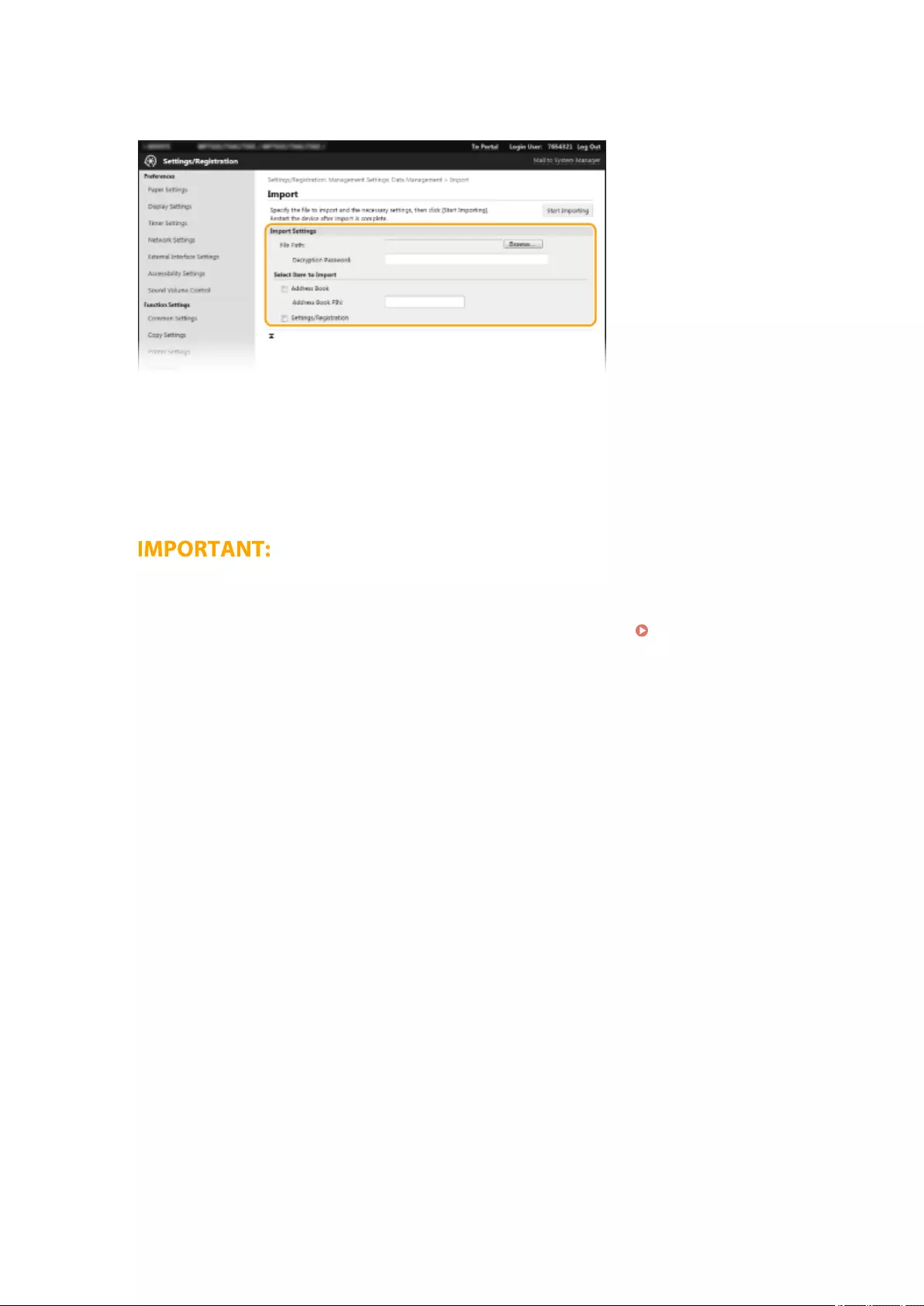
4Specify the le, enter the password, and select the settings to import.
[File Path]
Click [Browse] and select the le.
[Decryption Password]
Enter the password set when the settings were exported.
[Address Book]
Select the check box to import Address Book data.
●Importing Address Book data will overwrite the Address Book entries currently registered on the machine.
[Address Book PIN]
If the Address Book is code protected, enter the code for the Address Book. Restricting Use of the
Address Book(P. 395)
[Settings/Registration]
Select the check box to import machine settings data.
5Click [Start Importing].
6Click [OK].
➠The selected settings data is loaded into the machine.
7Click [OK].
➠If the [Settings/Registration] check box is selected in step 4, the machine automatically restarts.
Managing the Machine
425

Updating the Firmware
2579-086
For the rmware, select the method of update depending on the installation condition of the machine. There are two
methods of update: the one is to access the latest rmware version on the Internet from the machine and perform the
update if the version currently installed in the machine is not the latest, and the other is to access the latest rmware
version on the Internet from a computer and perform the update from the computer if the version currently installed
in the machine is not the latest. In an environment where connection to the Internet cannot be established via a
wireless LAN, establish connection via a wired LAN or USB and perform the update from the computer.
Installation Condition of the Machine How to Install the Update
Wireless LAN connection Updating via the Internet(P. 426)
Wired LAN connection Updating via the Internet(P. 426)
Updating from a Computer(P. 427)
USB connection Updating from a Computer(P. 427)
●If you are in an IPv6 environment, you cannot perform rmware update. Use USB to re-establish connection,
and perform the update from the computer.
Checking the rmware version
●You can check the rmware version from the operation panel of the machine. After completion of the
rmware update operation, make sure that the update was performed correctly. Checking the Firmware
Version(P. 427)
Updating via the Internet
You can access the Canon server from the machine to update the rmware to the latest version.
1Select <Update Firmware> in the Home screen. Home Screen(P. 120)
➠A check for existence of the latest rmware is performed.
●If the <This is the latest rmware version.> message is displayed, there is no need to update the
rmware.
2When a license screen appears, select <Accept>.
3Select <OK>.
➠When the rmware update is complete, the machine restarts automatically.
Managing the Machine
426

●Do not turn OFF the machine while the restart is in progress.
Updating from a Computer
When you have downloaded the latest rmware version from the Canon website, use "User Support Tool" utility
software to update the rmware from a computer. For how to perform rmware update from a computer, see the
"User Support Tool Operation Guide" included with the rmware.
To Put the Machine into a Firmware Update Waiting State
<Menu> <Management Settings> <Remote UI Settings/Update Firmware> <Update
Firmware> <Via PC> <Yes>
Checking the Firmware Version
1Select <Menu> in the Home screen. Home Screen(P. 120)
2Select <Management Settings>.
●If the login screen appears, enter the correct ID and PIN. Logging in to the Machine(P. 131)
3Select <Remote UI Settings/Update Firmware> <Update Firmware>.
4Select <Version Information>.
➠The current rmware version is displayed.
Managing the Machine
427
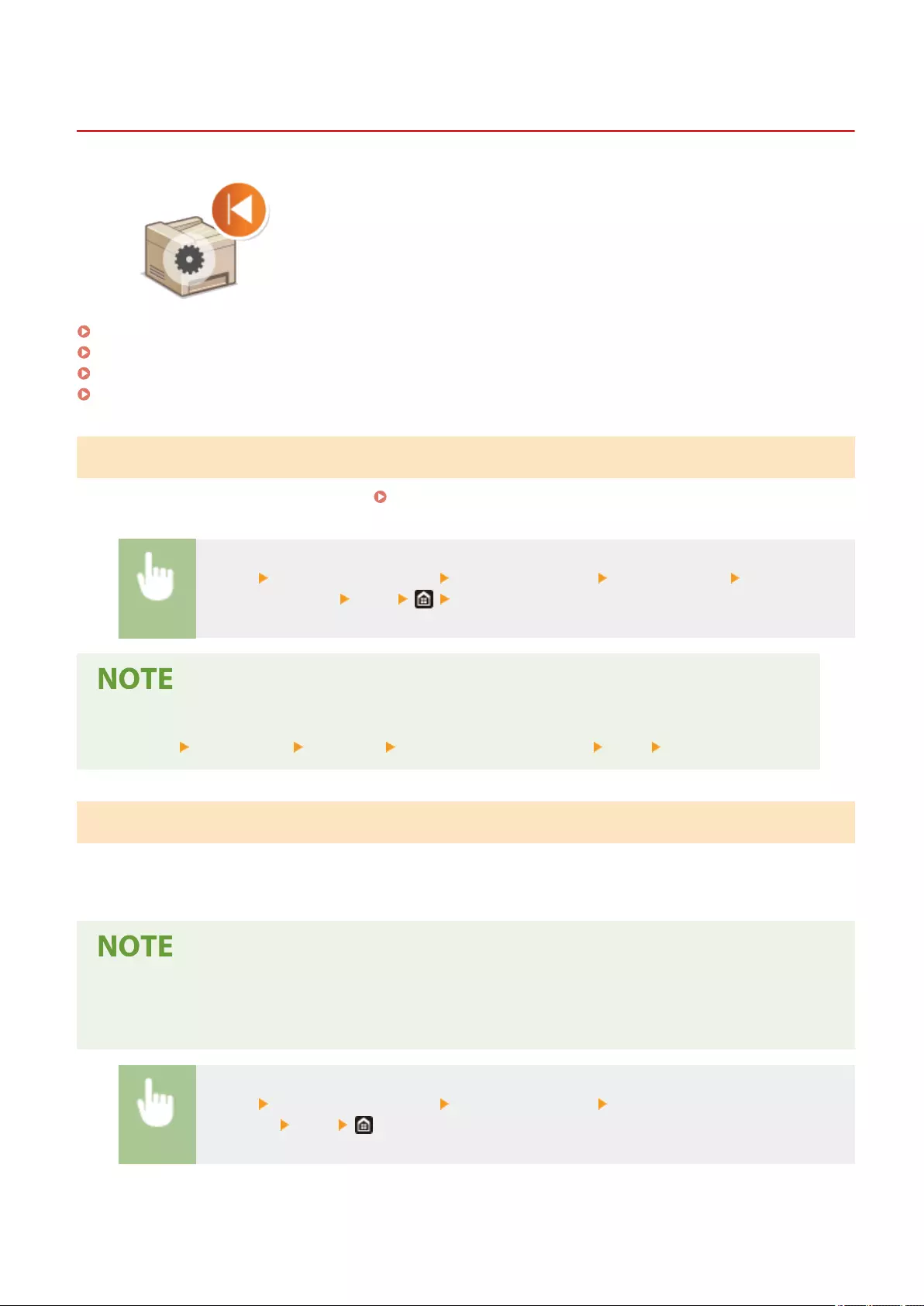
Initializing Settings
2579-087
You can restore the following settings:
Initializing Menu(P. 428)
Initializing Key and Certicate(P. 428)
Initializing Address Book(P. 429)
Initializing All Data/Settings(P. 429)
Initializing Menu
You can restore the settings of the machine ( Setting Menu List(P. 431) ). Depending on the settings selected, you
may need to restart the machine after initialization.
<Menu> <Management Settings> <Data Management> <Initialize Menu> Select the item
you want to initialize <Yes> Restart the machine if necessary
●You can restore the settings only for <Network> in <Preferences>.
<Menu> <Preferences> <Network> <Initialize Network Settings> <Yes> Restart the machine
Initializing Key and Certicate
You can restore the settings of the key and certicate and the CA certicate. Note that all the keys and certicates and
CA certicates that you registered in the machine (except the preinstalled keys and CA certicates) will be deleted after
initializing.
●After initializing, functions that require a key and certicate such as TLS encrypted communication and IKE
of IPSec communication are not available. To use these functions, congure the settings for the key and
certicate and activate the functions again.
<Menu> <Management Settings> <Data Management> <Initialize Key and
Certicate> <Yes>
Managing the Machine
428

Initializing Address Book
You can restore the settings of the Address Book. Note that all the information registered in the Address Book will be
deleted after initializing.
<Menu> <Management Settings> <Data Management> <Initialize Address
Book> <Yes>
Initializing All Data/Settings
This enables restoration of all data and machine settings, including logs, to the factory default values. This prevents
sensitive data from being leaked when replacing or disposing of the machine. When the initialization process nishes,
the machine automatically restarts.
●Before initializing, make sure that there are no documents being processed or waiting to be processed.
These documents will be deleted when initialization is performed.
●To use the machine after initializing it, you need to congure all settings from the beginning.
<Menu> <Management Settings> <Initialize All Data/Settings> <Yes> <Yes>
LINKS
Conguring the Key and Certicate for TLS(P. 370)
Registering Destinations(P. 181)
Registering Destinations from Remote UI(P. 419)
Managing the Machine
429

Setting Menu List
Setting Menu List ........................................................................................................................................... 431
<Preferences> .................................................................................................................................................... 432
<Display Settings> ........................................................................................................................................ 433
<English Keyboard Layout> .......................................................................................................................... 435
<Timer/Energy Settings> .............................................................................................................................. 436
<Network> .................................................................................................................................................... 440
<External Interface> ..................................................................................................................................... 448
<Accessibility> .............................................................................................................................................. 449
<Adjustment/Maintenance> ............................................................................................................................. 450
<Adjust Image Quality> ................................................................................................................................ 451
<Maintenance> ............................................................................................................................................. 454
<Function Settings> .......................................................................................................................................... 456
<Common> ................................................................................................................................................... 457
<Copy> ......................................................................................................................................................... 461
<Printer> ...................................................................................................................................................... 462
<Send> ......................................................................................................................................................... 484
<Receive/Forward> ....................................................................................................................................... 490
<Store/Access Files> ..................................................................................................................................... 494
<Secure Print> .............................................................................................................................................. 496
<Set Destination> .............................................................................................................................................. 497
<Management Settings> ................................................................................................................................... 498
<User Management> .................................................................................................................................... 499
<Device Management> ................................................................................................................................. 500
<Remote UI Settings/Update Firmware> ...................................................................................................... 502
<Data Management> .................................................................................................................................... 503
<Security Settings> ....................................................................................................................................... 505
Setting Menu List
430

Setting Menu List
2579-0FU
You can customize the machine based on your environment and needs by conguring settings described in this
chapter. To start conguration, select <Menu> on the Home screen ( Home Screen(P. 120) ). This section describes
what each item in the setting menu can congure.
<Preferences>(P. 432) This section describes the display and network settings.
<Adjustment/Maintenance>(P. 450) This section describes how to adjust print image quality and the cleaning functions of the
machine.
<Function Settings>(P. 456) This section describes the settings for the individual functions.
<Set Destination>(P. 497) This section describes the Address Book settings.
<Management Settings>(P. 498) This section describes the user and hardware information management, security
settings, etc.
●You can print the setting menu in list form to check the current settings: Printing Lists of
Settings(P. 623)
Setting Menu List
431
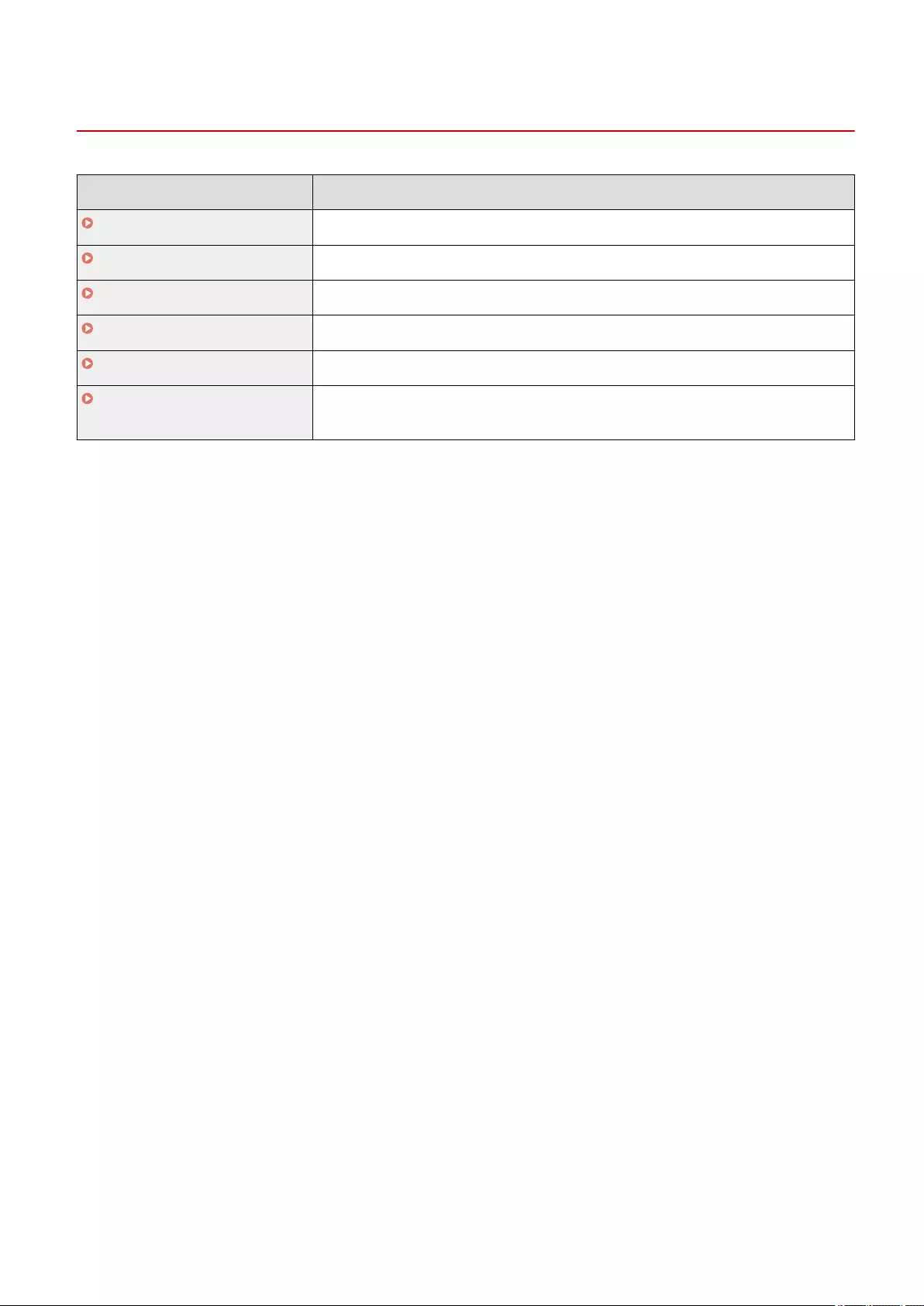
<Preferences>
2579-089
Item Description
<Display Settings>(P. 433) This section describes the settings related to viewing of the display.
<English Keyboard Layout>(P. 435) This section describes the USB keyboard settings.
<Timer/Energy Settings>(P. 436) This section describes the timer settings and energy settings.
<Network>(P. 440) This section describes the network settings.
<External Interface>(P. 448) This section describes the USB settings and other relevant settings.
<Accessibility>(P. 449) This section describes settings for improving accessibility, such as inverting the screen
colors and setting the message display time.
Setting Menu List
432
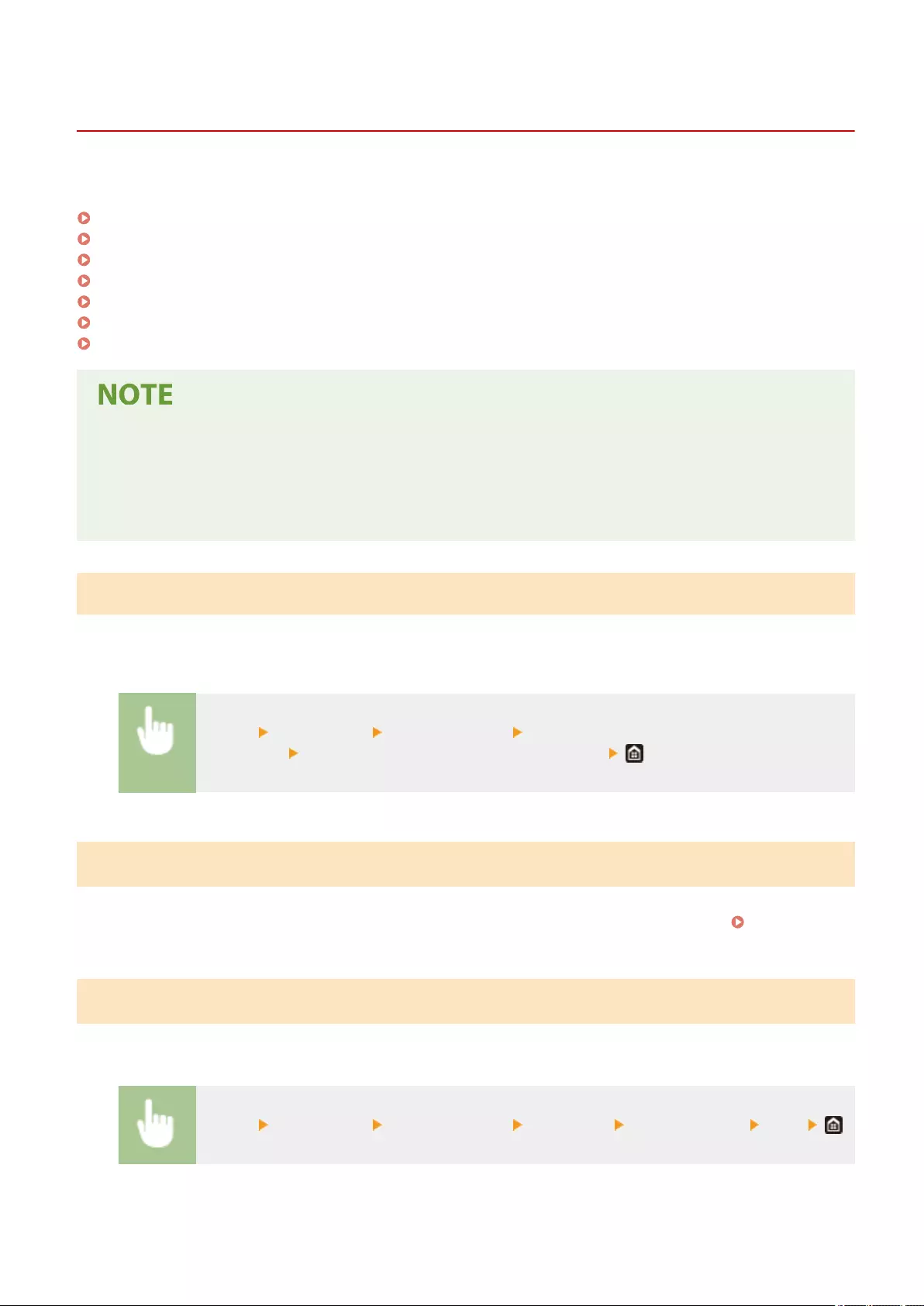
<Display Settings>
2579-08A
All the settings related to viewing of the display are listed with descriptions.
<Default Screen After Startup/Restoration>(P. 433)
<Home Screen Button Display Settings>(P. 433)
<Language>(P. 433)
<Remote UI Language>(P. 434)
<Notify to Clean Orig. Scan Area>(P. 434)
<Millimeter/Inch Entry Switch>(P. 434)
<Gram/Pound Switch>(P. 434)
Asterisks (*)
●Settings marked with "*1" cannot be imported or exported.
●Settings marked with "*2" may be unavailable or vary or have different defaults depending on your country
or region.
<Default Screen After Startup/Restoration>
By default, the Home screen is displayed immediately after the machine is turned ON or when the Auto Reset function
is performed. Specify the setting to change the default screen and display the main screen of a different function.
<Menu> <Preferences> <Display Settings> <Default Screen After Startup/
Restoration> Select a function to display the desired screen
<Home Screen Button Display Settings> *1
Congure the settings for the buttons displayed in the Home screen. You can select the settings that will be displayed
as shortcut buttons, rearrange the order in which the buttons appear, and insert or remove spaces. Customizing
the Home Screen(P. 170)
<Language> *2
Select the display language used for the display, reports, and lists.
<Menu> <Preferences> <Display Settings> <Language> Select a language <Yes>
Setting Menu List
433

<Remote UI Language> *2
Select the display language used for the Remote UI screens.
<Menu> <Preferences> <Display Settings> <Remote UI Language> Select a
language
<Notify to Clean Orig. Scan Area>
Specify whether to display a message when stains are detected in the document feed scanning area.
<Menu> <Preferences> <Display Settings> <Notify to Clean Orig. Scan Area> Select <Off>
or <On>
<Millimeter/Inch Entry Switch> *2
Select the unit of measurement.
<Menu> <Preferences> <Display Settings> <Millimeter/Inch Entry Switch> Select
<Millimeter> or <Inch>
<Gram/Pound Switch> *2
Select the unit of measurement for the basis weight. This setting is available when <Select Country/Region> is set to
<United States (US)>.
<Menu> <Preferences> <Display Settings> <Gram/Pound Switch> Select <Gram> or
<Pound>
Setting Menu List
434

<English Keyboard Layout>
2579-08C
Specify the layout of an USB keyboard if connected to the machine. The factory default settings differ depending on
the country or region where the machine was purchased.
<Menu> <Preferences> <English Keyboard Layout> Select <USA Layout> or <UK Layout>
Setting Menu List
435
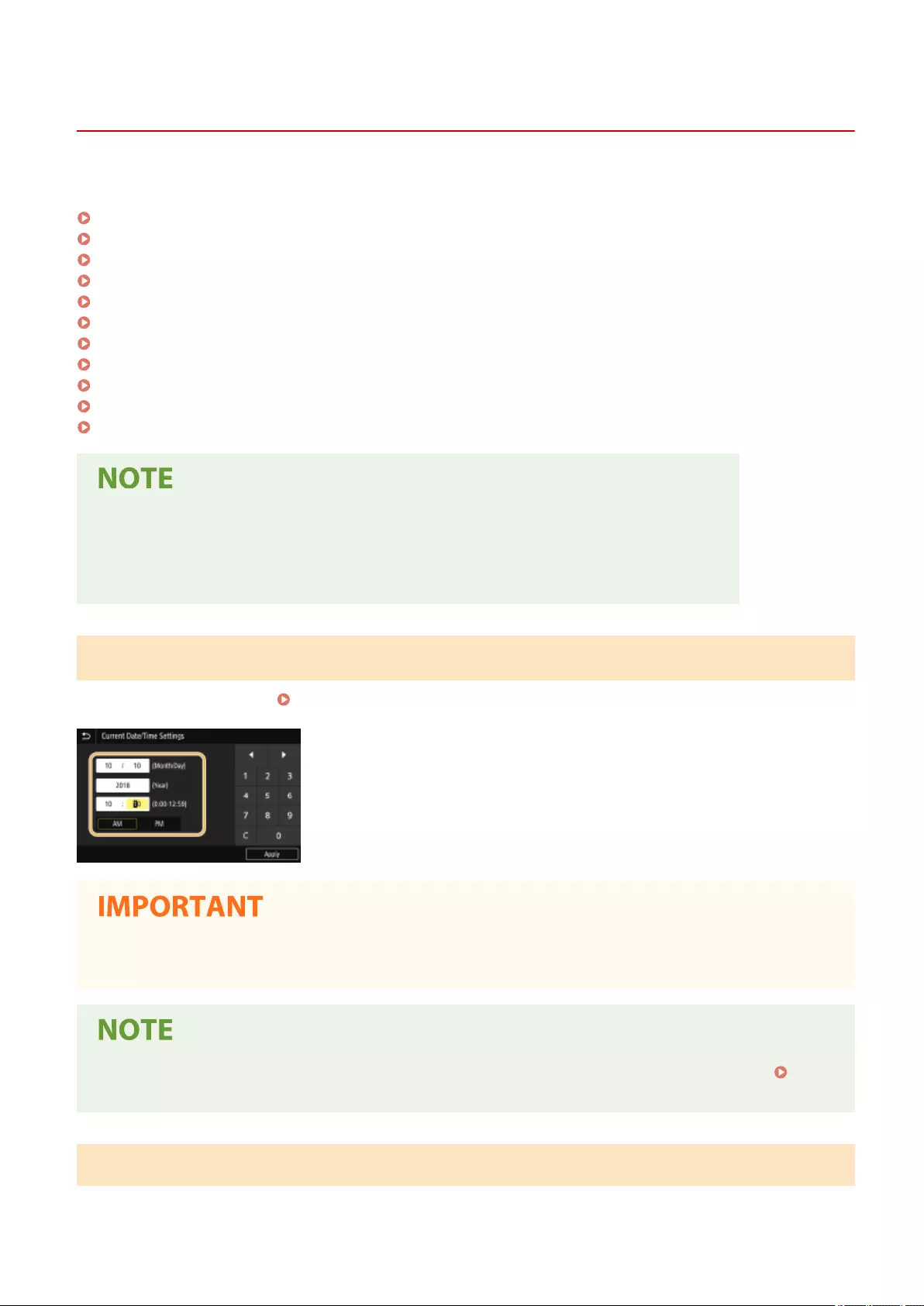
<Timer/Energy Settings>
2579-08E
All the settings related to the timer and energy are listed with descriptions.
<Current Date/Time Settings>(P. 436)
<Date/Time Settings>(P. 436)
<Date Format>(P. 437)
<Time Format>(P. 437)
<Auto Reset Time>(P. 437)
<Function After Auto Reset>(P. 438)
<Auto Shutdown Time>(P. 438)
<Auto Sleep Time>(P. 439)
<Auto Sleep Daily Timer>(P. 439)
<Sleep Mode Exit Time Settings>(P. 439)
<Ink Quality Maintenance>(P. 439)
Asterisks (*)
●Settings marked with "*1" cannot be imported or exported.
●Settings marked with "*2" may be unavailable or vary depending on your country or region.
<Current Date/Time Settings> *1
Set the current date and time. Setting the Date/Time(P. 15)
●Set <Time Zone> before setting the current date and time. If the <Time Zone> setting is changed, the current
date and time are also changed accordingly.
●The current date and time cannot be changed for 1 hour after daylight saving time goes into effect.
<Daylight Saving Time Settings>(P. 437)
<Date/Time Settings>
Specify the date and time standard of the region in which the machine is to be installed.
Setting Menu List
436
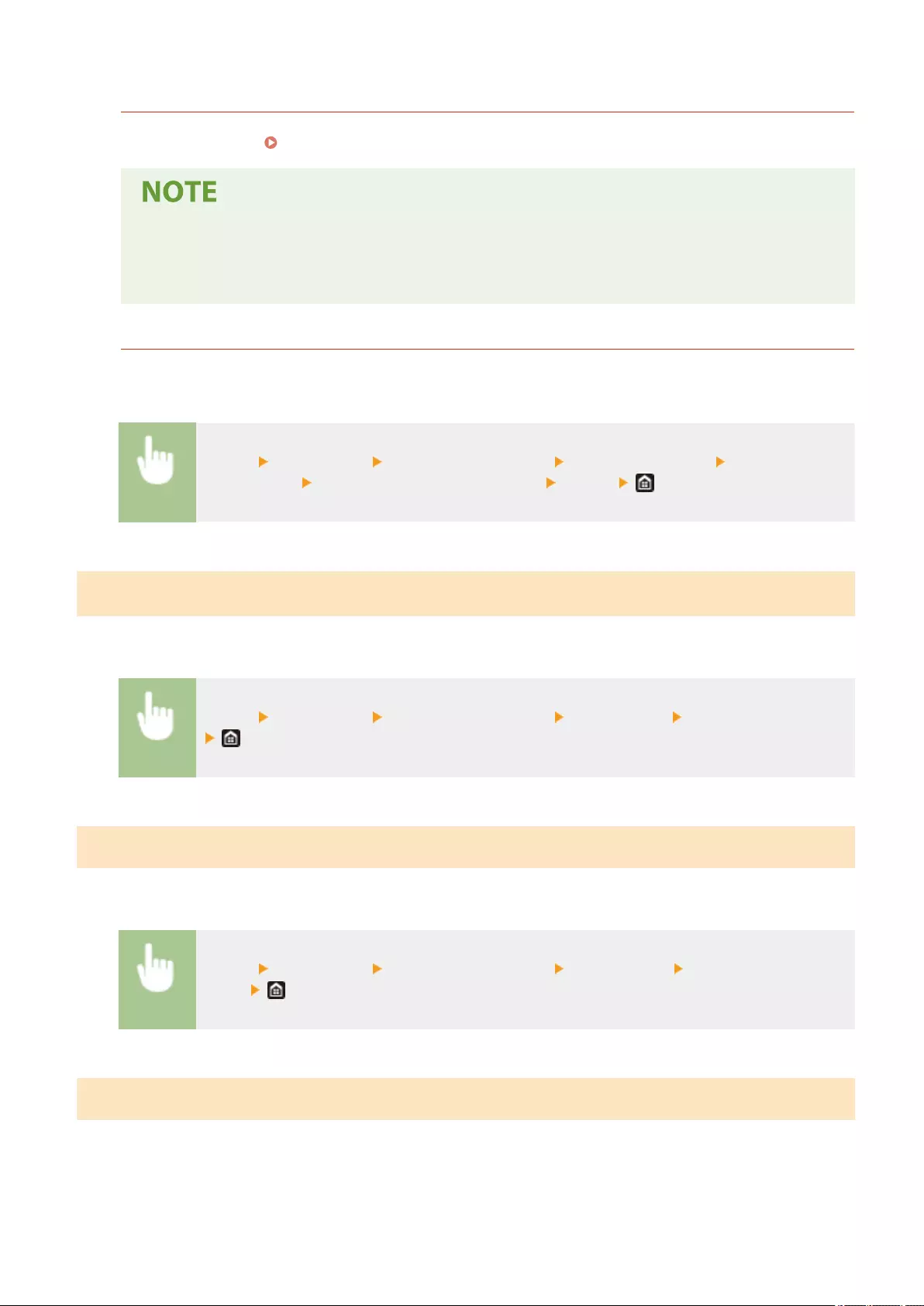
<Time Zone> *2
Select the time zone. If the time zone setting is changed, the values set in <Current Date/Time Settings> are also
changed accordingly. Setting the Date/Time(P. 15)
UTC
●Coordinated Universal Time (UTC) is the primary time standard by which the world regulates clocks
and time. The correct UTC time zone setting is required for Internet communications.
<Daylight Saving Time Settings>
Enable or disable daylight saving time. If daylight saving time is enabled, specify the dates from which and to
which daylight saving time is in effect.
<Menu> <Preferences> <Timer/Energy Settings> <Date/Time Settings> <Daylight Saving
Time Settings> Select <On>, and specify the dates <Apply>
<Date Format> *2
Select the date format (order of year, month, and day).
<Menu> <Preferences> <Timer/Energy Settings> <Date Format> Select the date format
<Time Format>
Select the 12- or 24-hour clock display setting.
<Menu> <Preferences> <Timer/Energy Settings> <Time Format> Select the display
setting
<Auto Reset Time>
If a key is not pressed for a specied period of time, the screen and the settings are initialized to display the
default screen (Auto Reset). Specify the interval at which the Auto Reset is performed. The Auto Reset is not
performed in the following cases:
●The setting menu is displayed.
Setting Menu List
437
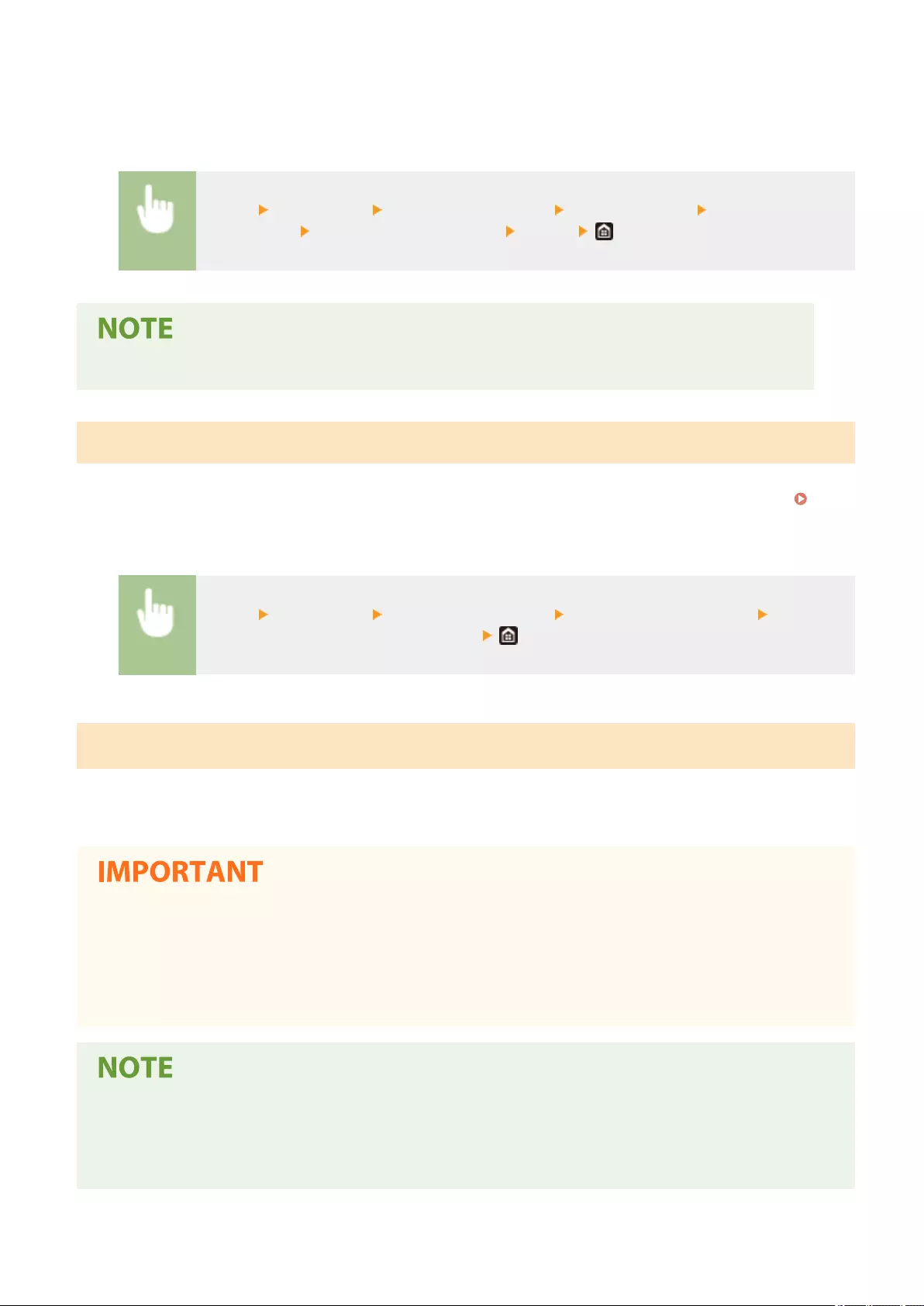
●The machine is processing data, such as when printing documents or sending or receiving faxes.
●An error message is displayed and the Error indicator is blinking (However, Auto Reset is performed when the
error does not prevent the user from continuing to use a function.)
<Menu> <Preferences> <Timer/Energy Settings> <Auto Reset Time> Select <On> in <Set
This Function> Enter the time in <Set Time> <Apply>
●The screen displayed after the Auto Reset is performed can be selected in <Function After Auto Reset>.
<Function After Auto Reset>
Select whether to return the display to the default screen after the Auto Reset is performed. If <Default Function> is
selected, the main screen of the function selected in <Default Screen After Startup/Restoration> is displayed (
<Default Screen After Startup/Restoration>(P. 433) ). If <Selected Function> is selected, the display returns to the
main screen of the function that was selected.
<Menu> <Preferences> <Timer/Energy Settings> <Function After Auto Reset> Select
<Default Function> or <Selected Function>
<Auto Shutdown Time> *2
Set a timer to automatically shut down the machine after the specied period of idle time has elapsed since the
machine entered the sleep mode. This setting is available when a telephone line cable is not connected to the
machine or when the machine is not communicating with the computer via USB cable or LAN Cable.
Before setting <Auto Shutdown Time>
●When the <Auto Shutdown Time> setting is enabled, the machine may automatically shut down even if you
are operating the machine from the Remote UI. A malfunction may occur, particularly if the machine shuts
down while data is being imported. When you import data using the Remote UI, set <Auto Shutdown Time>
to <Off> in advance.
●If any setting of the [Timer Settings] is changed from the Remote UI while the machine is in the sleep mode,
the timer for the <Auto Shutdown Time> setting is reset to the beginning. The machine automatically shuts
down after the specied period of idle time has elapsed since the timer was reset.
●Specifying an auto shutdown time shorter than the default setting (4 hours) may shorten the life of the ink.
Setting Menu List
438
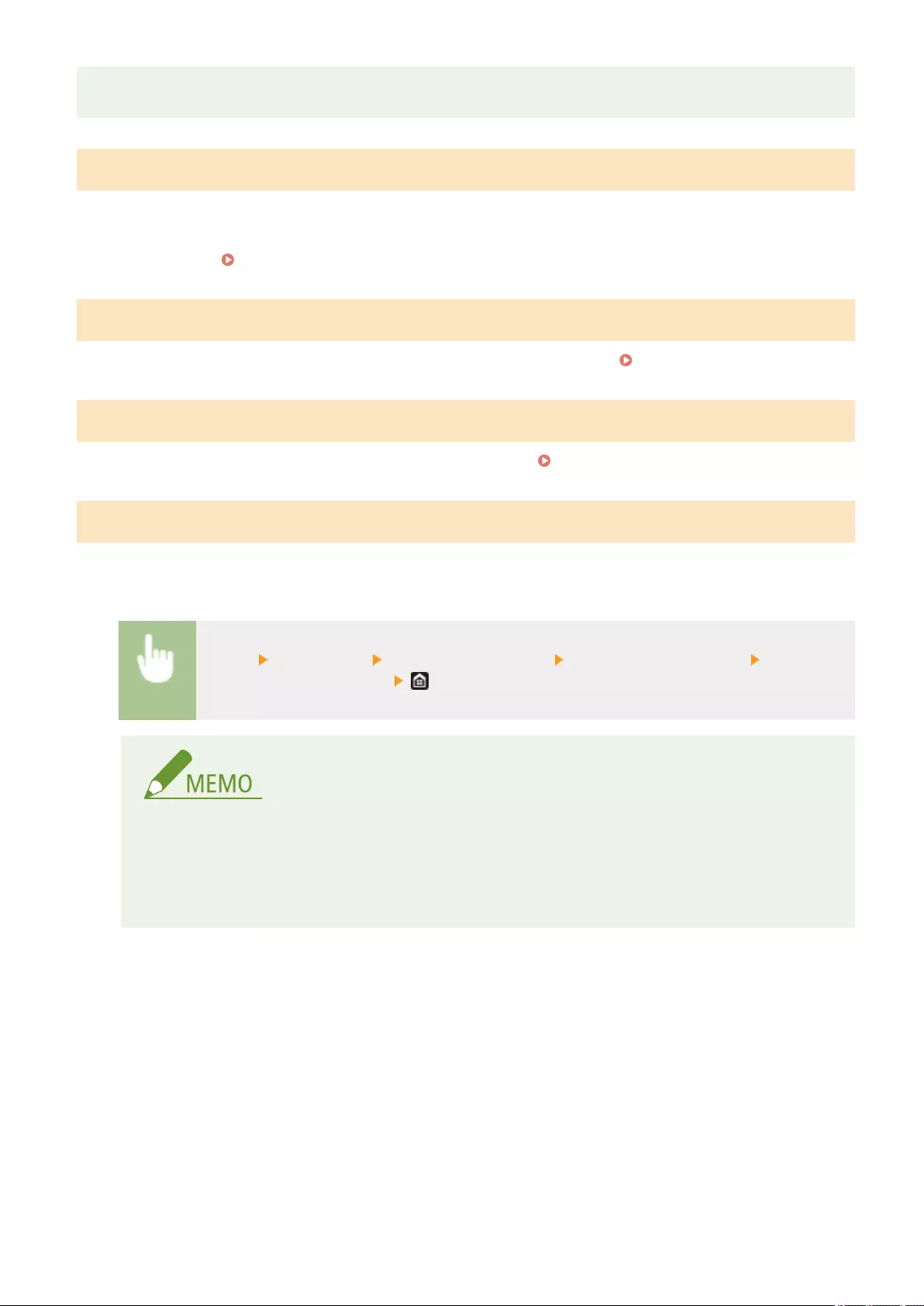
●After the power is turned OFF by Auto Shutdown, the machine may perform maintenance for several
minutes the next time it is turned ON. Printing waits until maintenance has completed.
<Auto Sleep Time>
If the machine has not been operated or has had no data to process for a specied period of time, the machine enters
sleep mode to save energy consumption (Auto Sleep). Specify the period of time after which auto sleep is performed.
Auto Sleep is not performed when the setting menu is displayed. We recommend using the factory default settings to
save the most power. Entering Sleep Mode(P. 179)
<Auto Sleep Daily Timer>
You can specify the time when the machine is automatically set to the sleep mode. Entering Sleep Mode(P. 179)
<Sleep Mode Exit Time Settings>
Specify the time when the machine is recovered from the sleep mode. Entering Sleep Mode(P. 179)
<Ink Quality Maintenance>
Specify a scheduled maintenance time. If the scheduled maintenance time is set to off, printing is more likely to be
interrupted due to maintenance. It is recommended to use the default setting.
<Menu> <Preferences> <Timer/Energy Settings> <Ink Quality Maintenance> Select <On>,
and specify the time <Apply>
●During ink quality maintenance, a little time is required before printing can begin. In a workplace, set
a time ahead of when work starts to allow printing without waiting.
●If the main power is off when ink quality maintenance or other maintenance is scheduled, the
machine performs maintenance the next time the power is turned on.
Setting Menu List
439
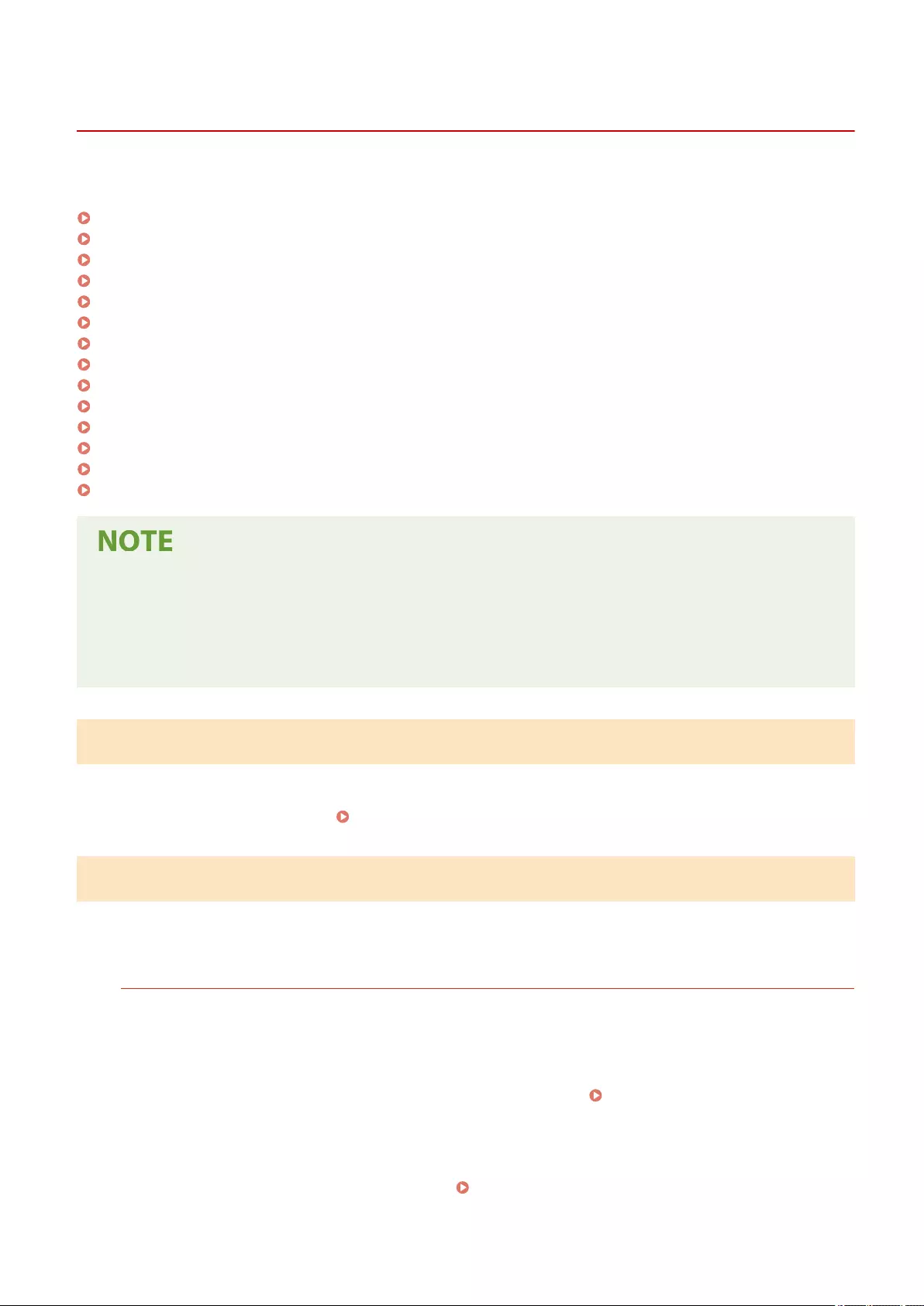
<Network>
2579-08F
All the settings related to the network are listed with descriptions.
<Select LAN>(P. 440)
<Wireless LAN Settings>(P. 440)
<Direct Connection Settings>(P. 441)
<TCP/IP Settings>(P. 442)
<SNMP Settings>(P. 443)
<Use Dedicated Port>(P. 444)
<Dedicated Port Auth. Method>(P. 445)
<Wait Time for Conn. at Startup>(P. 445)
<Ethernet Driver Settings>(P. 445)
<Use IEEE 802.1X>(P. 445)
<Firewall Settings>(P. 446)
<Device Settings Management>(P. 446)
<RMT-SW>(P. 446)
<Initialize Network Settings>(P. 447)
Asterisks (*)
●Settings marked with "*1" may not be displayed depending on the model you are using, options, or other
setting items.
●Settings marked with "*2" cannot be imported or exported.
<Select LAN> *1
When switching the machine from Wireless LAN to Wired LAN, you need to specify the setting. Conversely, when
switching the machine from Wired LAN to Wireless LAN, you do not need to specify this setting (You can switch using
the following <Wireless LAN Settings>). Selecting Wired LAN or Wireless LAN(P. 19)
<Wireless LAN Settings> *1
Specify settings for connecting the machine to a wireless LAN. You can also view the current settings or specify the
setting for saving power consumption.
<SSID Settings>
Select to congure a wireless connection by specifying information including an SSID or a network key by
inputting manually from the operation panel.
<Select Access Point>
Wireless LAN routers that can access the machine are automatically located, so you can select from the list.
You must manually enter a network key, such as a WEP key or a PSK. Setting Up Connection by Selecting
a Wireless Router(P. 27)
<Enter Manually>
Select to congure a wireless connection by manually entering an SSID. By using this method, you can specify
authentication and encryption settings in detail. Setting Up Connection by Specifying Detailed
Settings(P. 30)
Setting Menu List
440

<WPS Push Button Mode>
Select to automatically congure a wireless connection by using the button on a WPS wireless router. Setting
Up Connection Using WPS Push Button Mode(P. 23)
<WPS PIN Code Mode>
Select to congure a wireless connection by entering a PIN code for a WPS wireless router. Setting Up
Connection Using WPS PIN Code Mode(P. 25)
<Power Save Mode>
Select whether or not the machine enters Power Save Mode based on signals emitted from the wireless router.
<Menu> <Preferences> <Network> <Wireless LAN Settings> Read the displayed
message <OK> <Power Save Mode> Select <Off> or <On>
<Connection Information> *1
Select to view the current wireless LAN settings. Viewing Network Settings(P. 41)
<Direct Connection Settings>
Set whether to connect directly. By enabling this function, connecting directly with the machine is possible even in an
environment without an access point or wireless LAN router. Connecting Directly (Access Point Mode)(P. 332)
<Use Direct Connection>
Set whether to connect directly.
<Direct Connection Termination>
Specify the time to automatically disconnect after Direct Connection is established.
<Menu> <Preferences> <Network> <Use Direct Connection> <Direct Connection
Termination> Select <On> in <Automatically Terminate Session> and enter the time <Apply>
<Apply>
<Access Point Mode Settings>
Congure the SSID/network key arbitrarily. If you want to connect multiple mobile devices to the machine at the
same time, you need to congure both SSID and network key arbitrarily.
<Menu> <Preferences> <Network> <Direct Connection Settings> <Access Point Mode
Settings> Select <On> for each item and select <SSID>/<Network Key> Enter the SSID/network
key <Apply> <Apply> <Apply>
Setting Menu List
441

<TCP/IP Settings>
Specify settings for using the machine in a TCP/IP network, such as IP address settings.
<IPv4 Settings>
Specify settings for using the machine in an IPv4 network.
<IP Address Settings>
Congure the IP address, which is used for identifying devices, such as computers and printers, on a TCP/IP
network. You can also check settings that are congured. Setting IPv4 Address(P. 35)
<DHCP Option Settings>
If DHCP is enabled, use these settings to select whether to use the DHCP optional functions to acquire the
DNS server address or the domain name. Conguring DNS(P. 59)
<PING Command>
Select to check that the machine is connected to a computer over a network. Testing the Network
Connection(P. 36)
<IPv6 Settings>
Specify settings for using the machine in an IPv6 network. Setting IPv6 Addresses(P. 38)
<Use IPv6>
Specify settings for using the machine in an IPv6 network.
<Check IPv6 Settings>
You can check the link-local address that is automatically acquired.
<Stateless Address Settings>
Enable or disable stateless addresses. You can also check settings that are congured.
<DHCPv6 Settings>
Enable or disable the stateful address that is acquired via DHCPv6. You can also check settings that are
congured.
<DHCP Option Settings>
If DHCP is enabled, use these settings to select whether to use the DHCP optional functions to acquire the
DNS server address or the domain name. Conguring DNS(P. 59)
<DNS Settings>
Specify settings for Domain Name System (DNS), which provides a host name for IP address resolutions.
Conguring DNS(P. 59)
<IPv4 DNS Server Address Settings>
Specify the IP address of the DNS server in the IPv4 environment.
<DNS Host/Domain Name Settings>
Specify the host name of the machine to be registered in the DNS server as well as the name of the domain
to which the machine belongs for each of IPv4 and IPv6.
<DNS Dynamic Update Settings>
Select whether to dynamically update the DNS records whenever the machine's IP address is changed for
each of IPv4 and IPv6.
<mDNS Settings>
Specify settings for using DNS functions without DNS servers for each of IPv4 and IPv6.
Setting Menu List
442
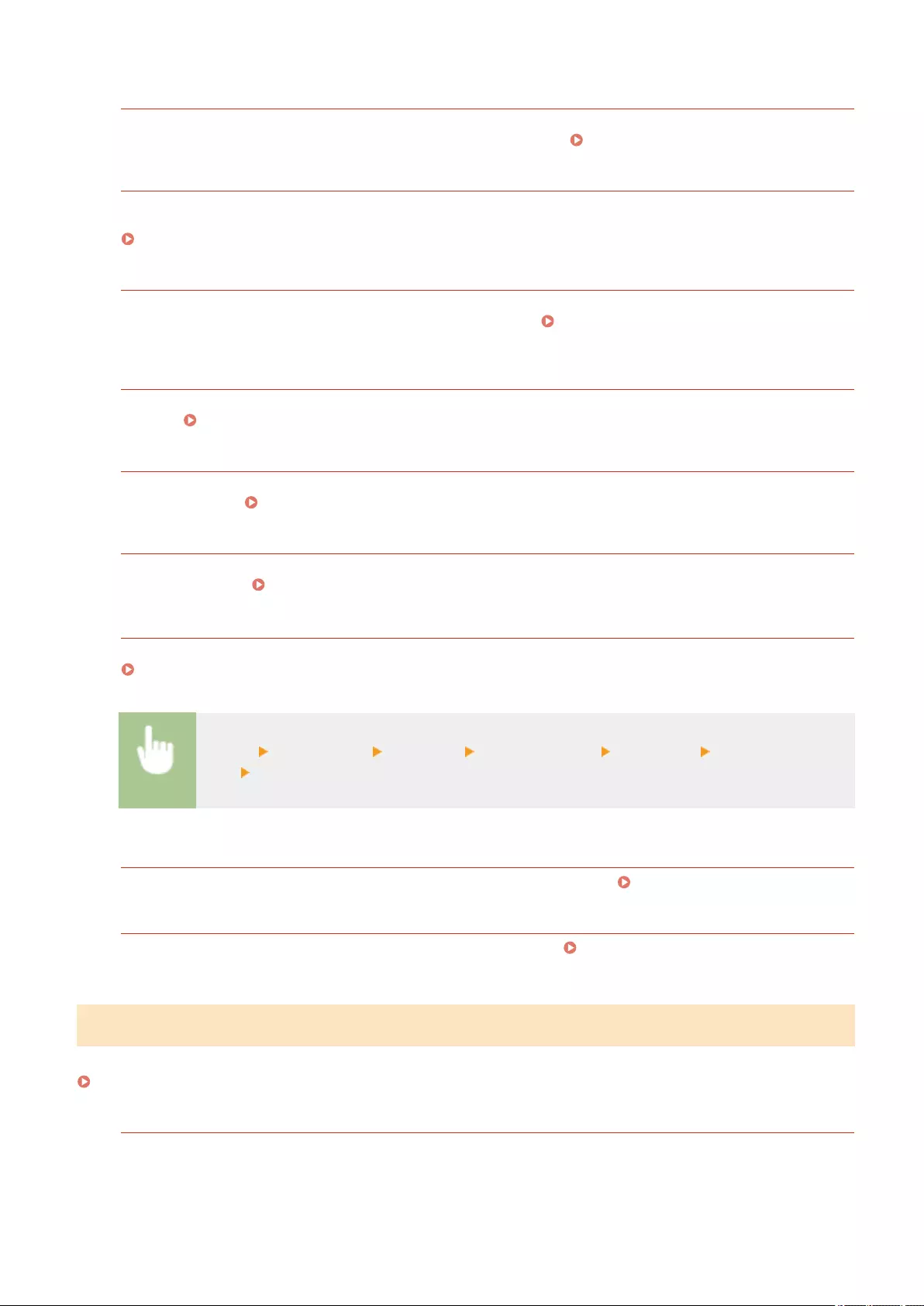
<WINS Settings>
Specify settings for Windows Internet Name Service (WINS), which provides a NetBIOS name for IP address
resolutions in a mixed network environment of NetBIOS and TCP/IP. Conguring WINS(P. 65)
<LPD Settings>
Enable or disable LPD, a printing protocol that can be used on any hardware platform or operating system. You
can also set the reception timeout period after which printing is canceled if print data reception is interrupted.
Conguring Printing Protocols and WSD Functions(P. 44)
<RAW Settings>
Enable or disable RAW, a Windows specic printing protocol. You can also set the reception timeout period after
which printing is canceled if print data reception is interrupted. Conguring Printing Protocols and WSD
Functions(P. 44)
<WSD Settings>
Enable or disable automatic browsing and acquiring information for the printer or scanner by using the WSD
protocol. Conguring Printing Protocols and WSD Functions(P. 44)
<Use FTP PASV Mode>
Specify whether to use PASV mode for FTP. If you are connecting to an FTP server through a rewall, you must
select PASV mode. Conguring FTP PASV Mode(P. 76)
<Use HTTP>
Enable or disable HTTP, which is required for communications with a computer, such as when using the Remote
UI or WSD printing. Disabling HTTP Communication(P. 403)
<Use IPSec> *1
Select whether to perform encrypted communication by establishing a virtual private network (VPN) via IPSec.
Conguring IPSec Settings(P. 381)
<Menu> <Preferences> <Network> <TCP/IP Settings> <Use IPSec> Select <Off> or
<On> Restart the machine
<Port Number Settings>
Change port numbers for protocols according to the network environment. Changing Port Numbers(P. 367)
<MTU Size>
Select the maximum size of packets the machine sends or receives. Changing the Maximum Transmission
Unit(P. 57)
<SNMP Settings>
Specify the settings for monitoring and controlling the machine from a computer running SNMP-compatible software.
Monitoring and Controlling the Machine with SNMP(P. 72)
<SNMPv1 Settings>
Enable or disable SNMPv1. When enabling SNMPv1, specify a community name and access privileges to
Management Information Base (MIB) objects.
Setting Menu List
443

<Menu> <Preferences> <Network> <SNMP Settings> Select <Off> or <On> in <SNMPv1
Settings> <Apply> Restart the machine
<SNMPv3 Settings>
Enable or disable SNMPv3. Use the Remote UI to specify detailed settings that are applied when SNMPv3 is
enabled.
<Menu> <Preferences> <Network> <SNMP Settings> Select <Off> or <On> in <SNMPv3
Settings> <Apply> Restart the machine
<Acquire Printer Mngt. Info. from Host>
Enable or disable the monitoring of printer management information from a networked computer running
SNMP-compatible software.
<Menu> <Preferences> <Network> <SNMP Settings> Select <Off> or <On> in <Acquire
Printer Mngt. Info. from Host> <Apply> Restart the machine
<Format Host Rsrcs. MIB to RFC2790>
Specify whether to conform to the advanced specications (RFC2790) of the protocol when monitoring the
machine status from the SNMP-compatible software.
<Menu> <Preferences> <Network> <SNMP Settings> Select <Off> or <On> in <Format
Host Rsrcs. MIB to RFC2790> <Apply> Restart the machine
<Use Dedicated Port>
Enable or disable the dedicated port. The dedicated port is used when printing, faxing, or scanning uses WG Scan
Utility and when browsing or specifying the machine settings over the network.
<Menu> <Preferences> <Network> <Use Dedicated Port> Select <Off> or <On> Restart
the machine
Setting Menu List
444
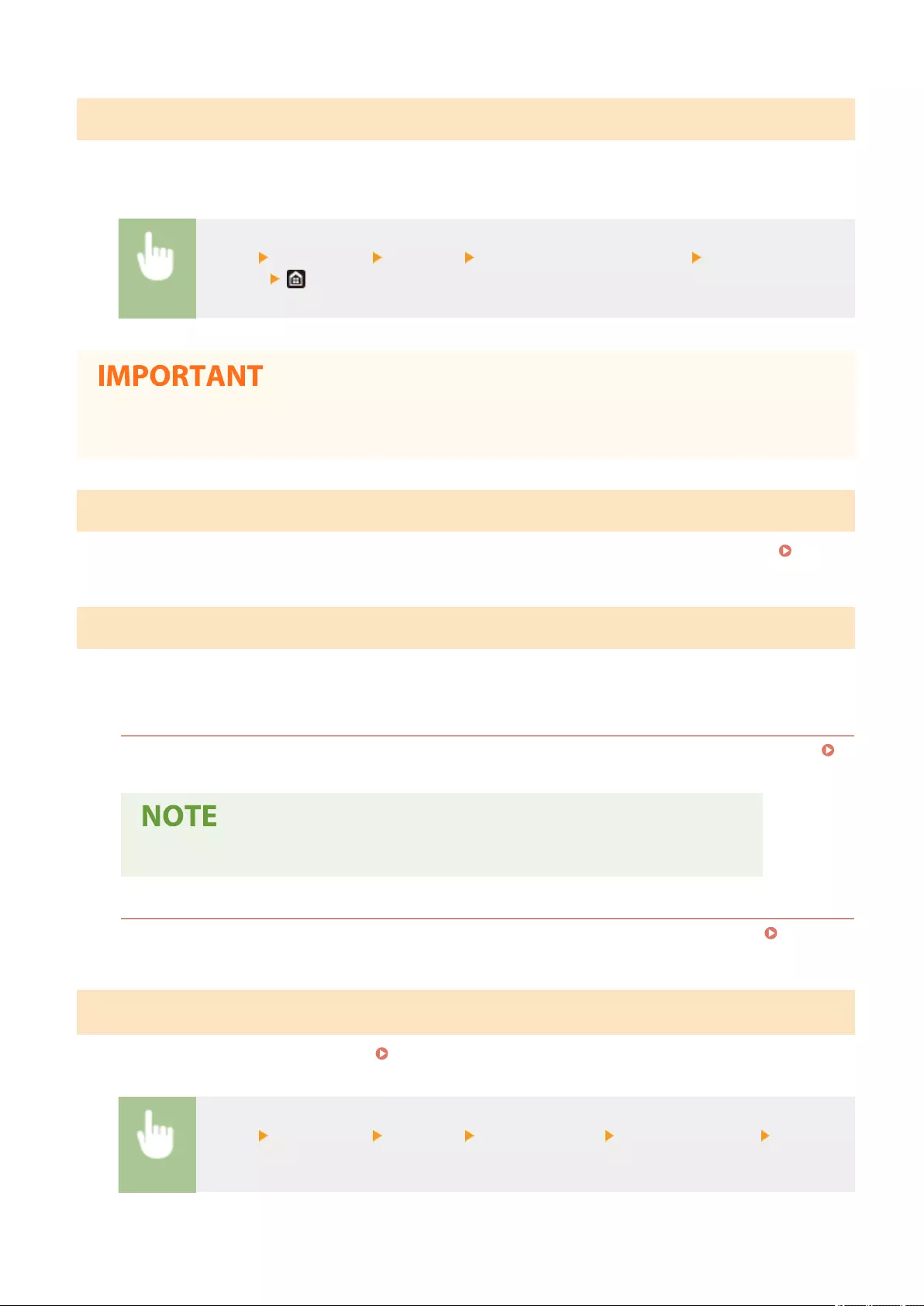
<Dedicated Port Auth. Method>
Specify whether to limit the authentication method specically to the secure one when using the dedicated port. If
<Mode 2> is selected, the authentication method is limited specically to the secure one.
<Menu> <Preferences> <Network> <Dedicated Port Auth. Method> Select <Mode 1> or
<Mode 2>
●If <Mode 2> is selected, you cannot establish a connection from the device management software or driver
in some cases.
<Wait Time for Conn. at Startup>
Specify a wait time for connecting to a network. Select the setting depending on the network environment. Setting a
Wait Time for Connecting to a Network(P. 58)
<Ethernet Driver Settings>
Select the Ethernet type (10BASE-T/100BASE-TX/1000BASE-T) and the communication mode of Ethernet (half-duplex/
full-duplex). You can also view the MAC address for wired LAN.
<Auto Detect>
Select whether to automatically detect or manually select the communication mode and the Ethernet type.
Conguring Ethernet Settings(P. 55)
●When <Communication Mode> is set to <Half Duplex>, you cannot select <1000BASE-T>.
<MAC Address>
Check the MAC address of the machine, which is a number unique to each communication device. Viewing
the MAC Address for Wired LAN(P. 41)
<Use IEEE 802.1X> *1*2
Enable or disable IEEE 802.1X authentication. Conguring IEEE 802.1X Authentication Settings(P. 388)
<Menu> <Preferences> <Network> <Use IEEE 802.1X> Select <Off> or <On> Restart the
machine
Setting Menu List
445
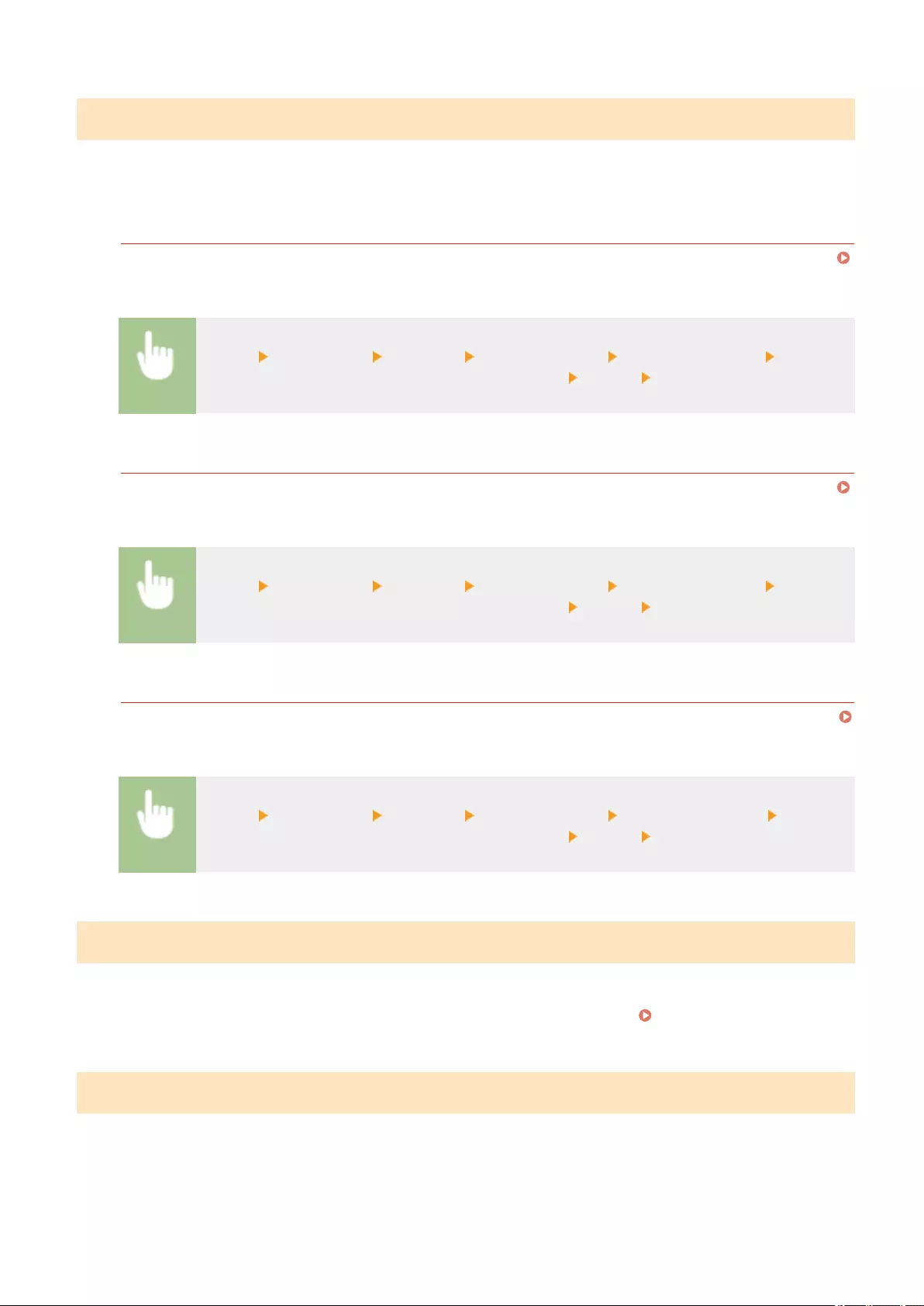
<Firewall Settings>
Without proper security, unauthorized third parties can access computers and other communication devices that are
connected to a network. To prevent this unauthorized access, specify the settings for packet lter, a feature that
restricts communication to devices with specied IP addresses or MAC addresses.
<IPv4 Address Filter>
Enable or disable settings for ltering packets sent to or received from devices with specied IPv4 addresses.
Specifying IP Addresses for Firewall Settings(P. 361)
<Menu> <Preferences> <Network> <Firewall Settings> <IPv4 Address Filter> Select
<Off> or <On> in <Outbound Filter> or <Inbound Filter> <Apply> Restart the machine
<IPv6 Address Filter>
Enable or disable settings for ltering packets sent to or received from devices with specied IPv6 addresses.
Specifying IP Addresses for Firewall Settings(P. 361)
<Menu> <Preferences> <Network> <Firewall Settings> <IPv6 Address Filter> Select
<Off> or <On> in <Outbound Filter> or <Inbound Filter> <Apply> Restart the machine
<MAC Address Filter>
Enable or disable settings for ltering packets sent to or received from devices with specied MAC addresses.
Specifying MAC Addresses for Firewall Settings(P. 364)
<Menu> <Preferences> <Network> <Firewall Settings> <MAC Address Filter> Select
<Off> or <On> in <Outbound Filter> or <Inbound Filter> <Apply> Restart the machine
<Device Settings Management>
Specify whether to use imageWARE Enterprise Management Console (iW Management Console) plug-ins to manage
machine data such as settings and Address Book destinations. For detailed information on imageWARE Enterprise
Management Console (iW Management Console), contact your nearest Canon dealer. Conguring Settings for
Communication between the Machine and Plug-ins(P. 79)
<RMT-SW>
Leave this switch set to <Off>. When the service representative remotely performs device maintenance, you may be
asked to set the switch to <On>.
Setting Menu List
446

<External Interface>
2579-08H
All the settings related to the USB are listed with descriptions.
<USB Settings>
Specify whether to enable or disable use of the USB port or a USB memory device.
<Use as USB Device>
Enable or disable the USB port that is used for connecting the machine to a computer. Restricting the USB
Connection with a Computer(P. 401)
<Use USB Storage Device>
Specify whether to use a USB memory device.
<Menu> <Preferences> <External Interface> <USB Settings> Select <Off> or <On> in <Use
USB Storage Device> <Apply> Restart the machine
Setting Menu List
448

<Accessibility>
2579-08J
All the settings related to accessibility, such as inverting the screen colors and message display time, are listed with
descriptions.
<Invert Screen Colors>(P. 449)
<Brightness>(P. 449)
<Message Display Time>(P. 449)
<Invert Screen Colors>
Select <On> to invert the display colors. Select <On> if the display is hard to view even after the brightness was
adjusted in <Brightness>.
<Menu> <Preferences> <Accessibility> <Invert Screen Colors> Select <Off> or <On>
<Brightness>
Adjust the brightness of the display to suit the installation location of the machine.
<Menu> <Preferences> <Accessibility> <Brightness> Adjust the brightness <Apply>
<Message Display Time>
Specify the interval in seconds at which two different messages are alternately displayed.
<Menu> <Preferences> <Accessibility> <Message Display Time> Enter a number for the
interval <Apply>
Setting Menu List
449
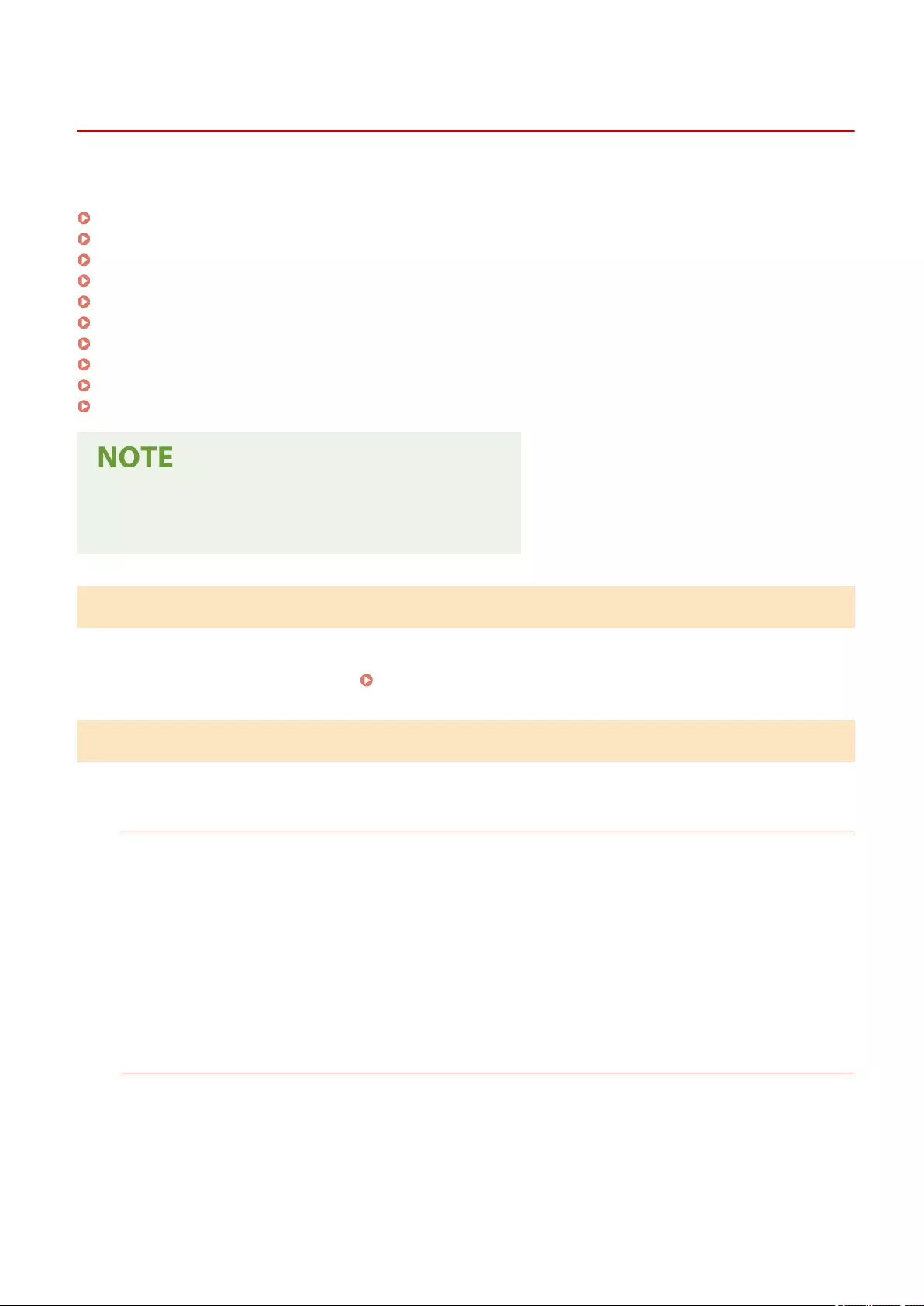
<Adjust Image Quality>
2579-08L
All the settings related to image quality adjustment are listed with descriptions.
<Black Text Processing for Color>(P. 451)
<Color Correction>(P. 451)
<Abrasion Prevention>(P. 452)
<Print Head Alignment>(P. 452)
<Density/Drying Time Adjustment>(P. 452)
<Paper Curl Adjustment After Printing>(P. 452)
<Margin Adjustment>(P. 453)
<Paper Curl Prevention On Output>(P. 453)
<Adjusting Maintenance Interval>(P. 453)
<White Streak Correction>(P. 453)
Asterisks (*)
●Settings marked with "*" cannot be imported or exported.
<Black Text Processing for Color>
Select whether the color of black or blackish text in color documents should be reproduced as true black or as a color
more or less close to that of the original. For each option, you can adjust the degree of effect. You can set values for
the feeder and the platen glass separately. Adjusting Values for Text Color Reproducibility(P. 593)
<Color Correction>
Makes adjustment to maintain or improve as well as ensure stable quality during printing.
<Auto (Pattern Scan)>
Scan sheets the machine prints out to allow the machine to automatically correct colors.
<All Paper Types>
Use plain paper to perform correction.
<Single Paper Type>
Print out and scan adjustment images to correct colors. You can select the paper type to use for adjustment.
<Restore Initial Settings>
Return (initialize) the correction value for color correction to its default.
<Manual (Visual Check)>
Visually check an output test page to determine an adjustment value for density.
Setting Menu List
451
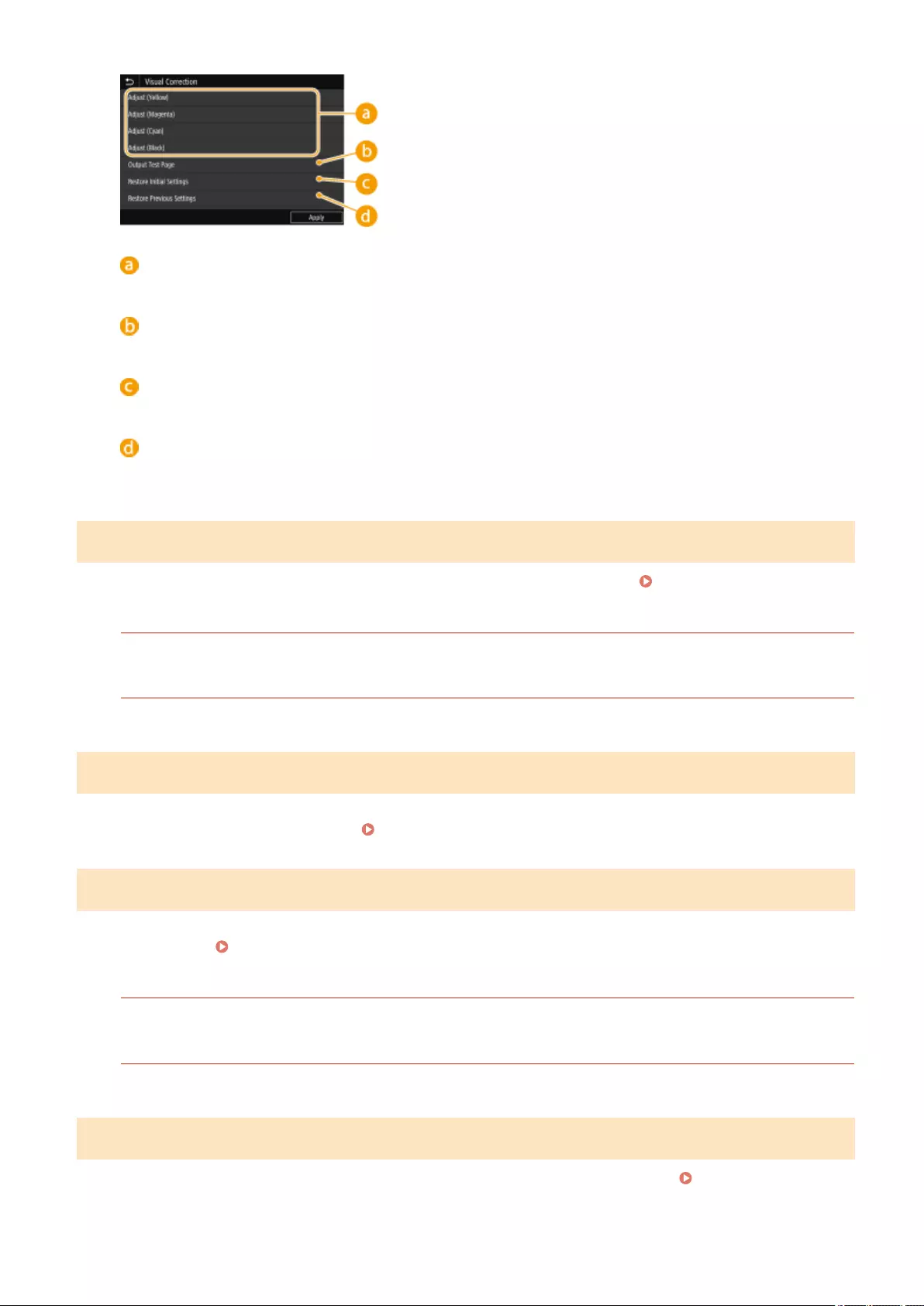
<Adjust (Yellow)>/<Adjust (Magenta)>/<Adjust (Cyan)>/<Adjust (Black)>
Select colors to adjust, and adjust the density values.
<Output Test Page>
Output a test page to check visually.
<Restore Initial Settings>
Return the adjustment value of each color to its initial value.
<Restore Previous Settings>
Return the adjustment value of each color to its previous value.
<Abrasion Prevention>
Correct paper abrasion by widening the space between the print head and the paper. Preventing Abrasion(P. 604)
<1-sided>
Set whether to correct abrasion during 1-sided printing.
<2-sided>
Set whether to correct abrasion during 2-sided printing.
<Print Head Alignment>
Adjust the position of the print head if printed vertical lines are distorted or colors are mismatched. Any of A4, A3,
11x17, or LTR size plain paper can be used. Aligning the Print Head(P. 605)
<Density/Drying Time Adjustment>
If ink from already output sheets smudges paper, setting the print density or wait time until ink dries after printing can
correct the problem. Adjusting the Density and Ink Drying Time(P. 608)
<Adjust for All Paper Sources>
Adjust all feed slots at the same time.
<Adjust by Paper Source>
Adjust feed slots individually.
<Paper Curl Adjustment After Printing>
If curling in output paper causes paper in the output tray to be untidy, adjust paper curling. Adjusting Paper
Curling after Printing(P. 610)
Setting Menu List
452
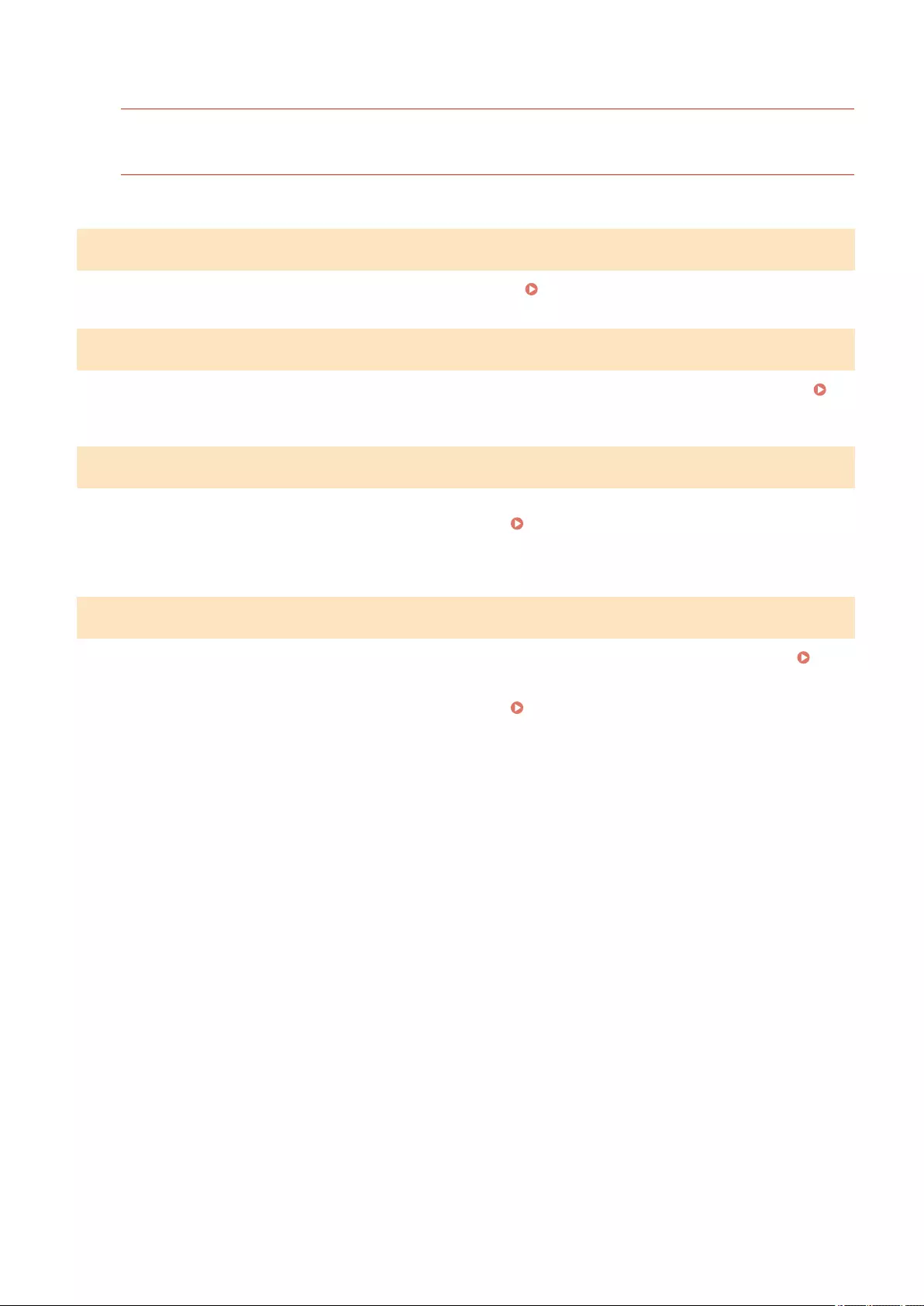
<Adjust for All Paper Sources>
Adjust all feed slots at the same time.
<Adjust by Paper Source>
Adjust feed slots individually.
<Margin Adjustment>
Adjust the amount of margin during printing for each paper source. Adjusting Margins(P. 612)
<Paper Curl Prevention On Output>
Correct stacking in the output tray if paper arches or rolls back and causes paper in the output tray to be untidy.
Correcting Arching of Paper when Output(P. 615)
<Adjusting Maintenance Interval>
If white streaks appear again a while after being corrected with print head cleaning, adjust the maintenance interval.
Perform print head cleaning rst if it has not yet been performed. Cleaning the Print Head(P. 526)
Try in the order "1" then "2". Maintenance is performed more frequently with "2" than "1". You can select "0" to restore
the default setting.
<White Streak Correction>
If white streaks are not corrected even after performing print head cleaning, perform white streak correction.
Correcting White Streaks(P. 616)
If white streaks appear again a while after being corrected with print head cleaning, adjust the maintenance interval.
Perform print head cleaning rst if it has not yet been performed. Cleaning the Print Head(P. 526)
Setting Menu List
453

<Maintenance>
2579-08R
The cleaning functions are listed with descriptions.
<Nozzle Check Pattern>(P. 454)
<Print Head Cleaning>(P. 454)
<Paper Transport Unit Cleaning>(P. 454)
<Sensor Cleaning>(P. 454)
<Feeder Auto Cleaning>(P. 454)
<Original Scanning Area Cleaning>(P. 454)
<Ink Tank Replacement>(P. 455)
<Maintenance Cartridge Replacement>(P. 455)
<Print Head Replacement>(P. 455)
<Print Head Diagnostics>(P. 455)
<Previous Diagnostics Results>(P. 455)
<ADF Maintenance Kit Installation>(P. 455)
<Initialize After Replacing Parts>(P. 455)
<Preparation for Transporting>(P. 455)
<Preparation for Disposal>(P. 455)
<Nozzle Check Pattern>
Print out a nozzle check pattern or color alignment check pattern to check printing. Select the paper type and perform
correction (A4, A3, 11x17, LTR).
Checking the Condition of the Nozzles(P. 590)
<Print Head Cleaning>
Perform head cleaning to keep the print head in good condition. Cleaning the Print Head(P. 526)
<Paper Transport Unit Cleaning>
Clean ink from the paper path area. Cleaning the Paper Path(P. 519)
<Sensor Cleaning>
Clean ink from the sensor area. Cleaning the Sensor Area(P. 523)
<Feeder Auto Cleaning>
Clean the feeder rollers if originals become dirty after being fed through the feeder. Cleaning the Feeder(P. 514)
<Original Scanning Area Cleaning>
Clean the feeder roller area. Cleaning the Feeder(P. 514)
Setting Menu List
454
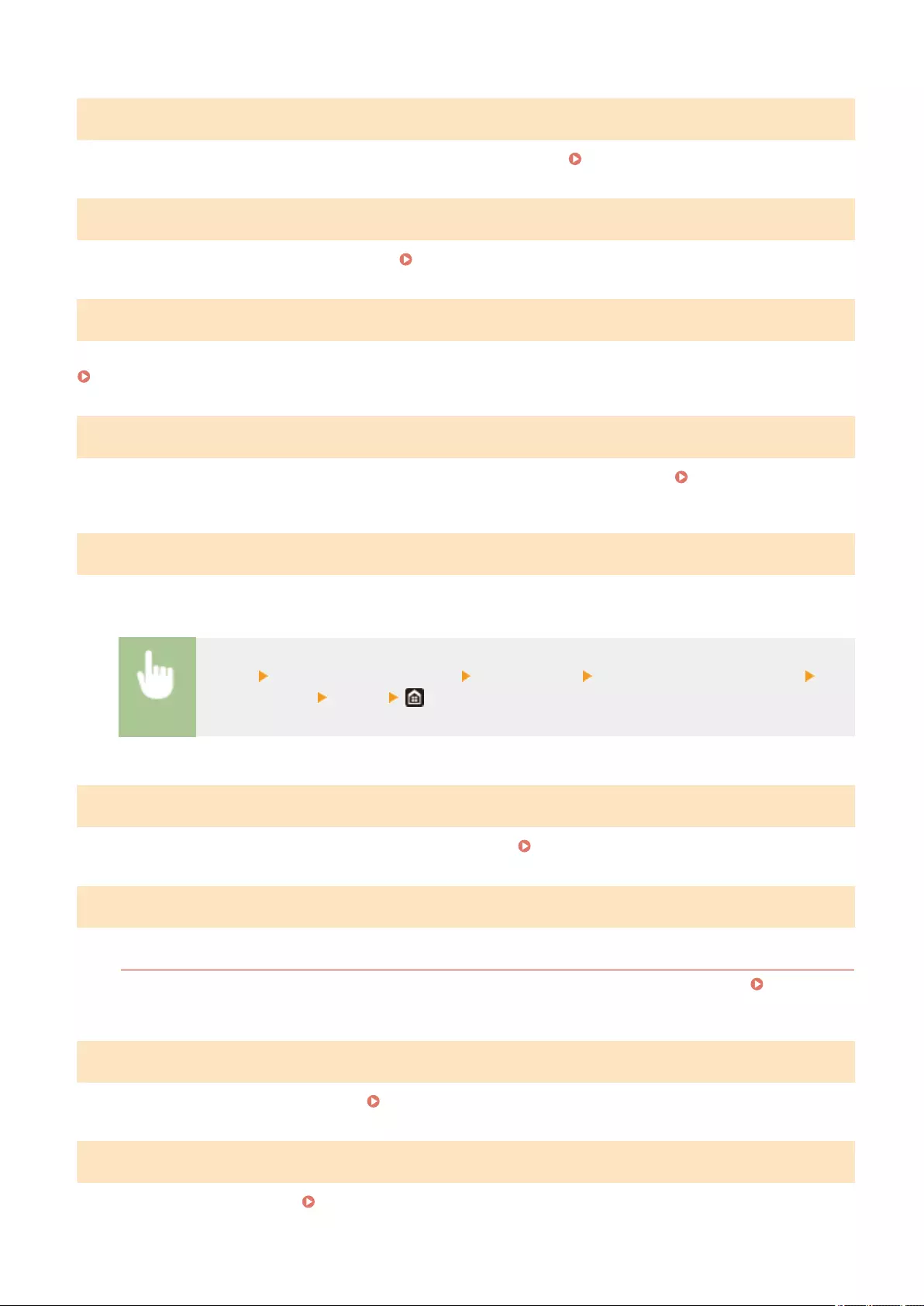
<Ink Tank Replacement>
Replace ink tanks when ink has run out and an error message is displayed. Replacing the Ink Tanks(P. 528)
<Maintenance Cartridge Replacement>
Replace the maintenance cartridge once it is full. Replacing the Maintenance Cartridge(P. 532)
<Print Head Replacement>
Replace the print head if print quality does not improve even after head cleaning or if an error message is displayed.
Replacing the Print Head(P. 536)
<Print Head Diagnostics>
Follow steps to perform a diagnosis, and correct any problem with cleaning or other utility. Diagnosing the Print
Head(P. 584)
<Previous Diagnostics Results>
You can check results from the previous diagnosis.
<Menu> <Adjustment/Maintenance> <Maintenance> <Previous Diagnostics Results>
Check the results <Close>
<ADF Maintenance Kit Installation>
Replace the document feed roller and document separation roller. Replacing the ADF Maintenance Kit(P. 545)
<Initialize After Replacing Parts>
<ADF Maintenance Kit>
Initialize the machine after replacing the document feed roller and document separation roller. Replacing
the ADF Maintenance Kit(P. 545)
<Preparation for Transporting>
Prepare the machine for being transported. Transporting the Machine(P. 551)
<Preparation for Disposal>
Prepare the machine for disposal. Disposing of the Machine(P. 576)
Setting Menu List
455
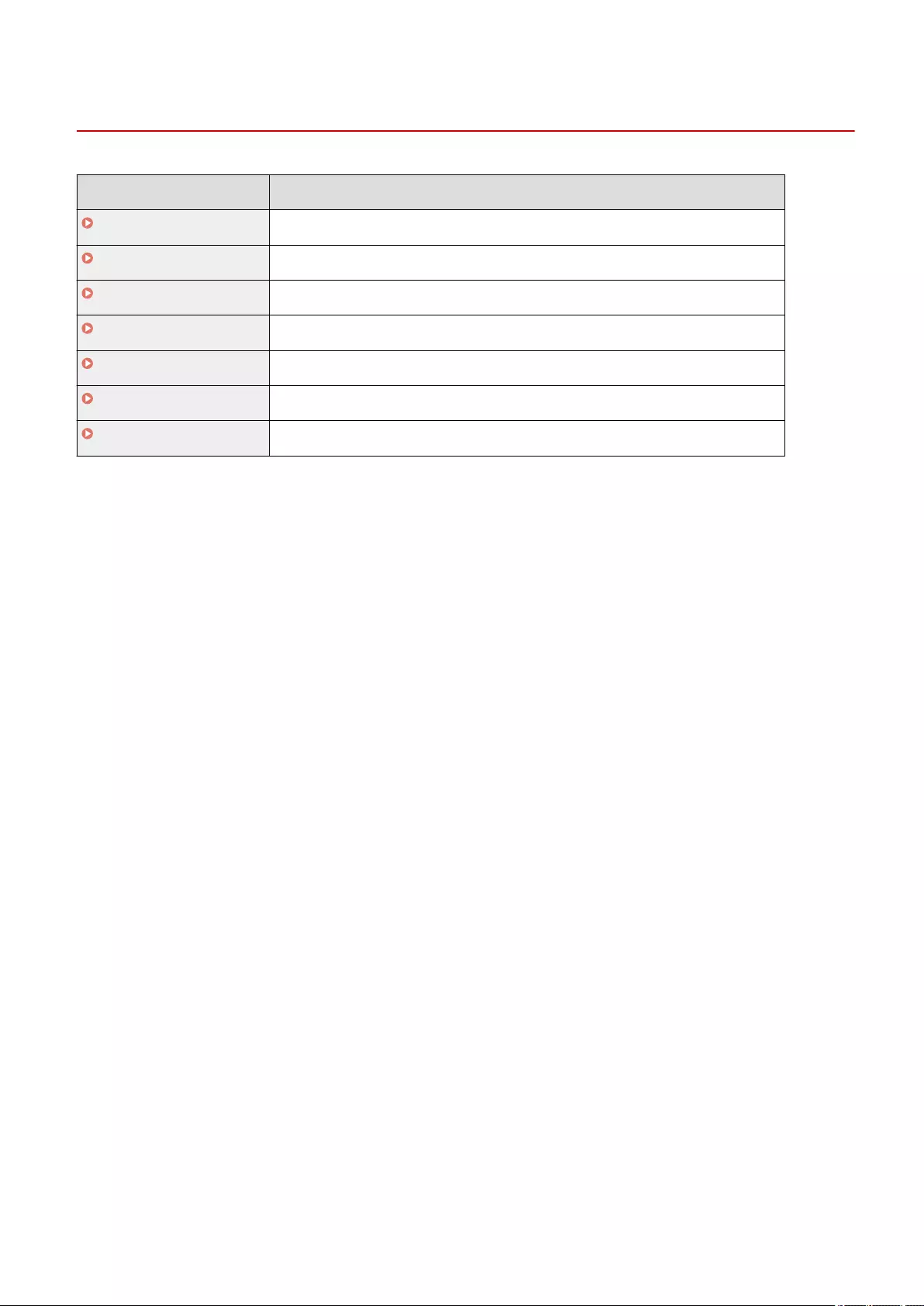
<Function Settings>
2579-08S
Item Description
<Common>(P. 457) This section describes settings common to each function.
<Copy>(P. 461) This section describes how to specify the copy settings.
<Printer>(P. 462) This section describes how to specify printer settings.
<Send>(P. 484) This section describes how to specify settings for sending faxes and scanned originals.
<Receive/Forward>(P. 490) This section describes how to specify settings for receiving faxes and e-mails.
<Store/Access Files>(P. 494) This section describes the settings for scanning originals and printing stored les.
<Secure Print>(P. 496) This section describes the settings for the Secure Print.
Setting Menu List
456
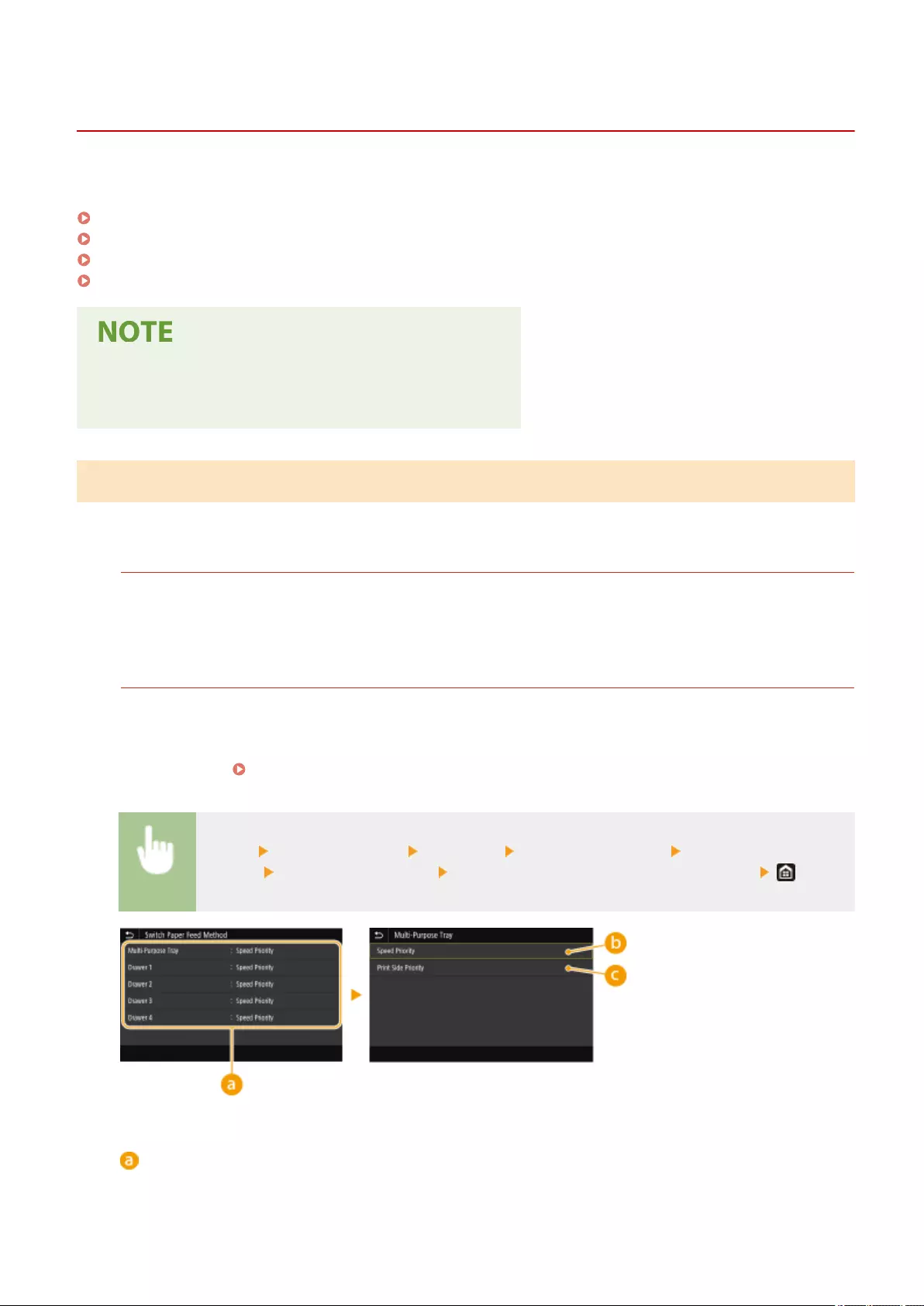
<Common>
2579-0FW
All the items related to settings common to each function are listed with descriptions.
<Paper Feed Settings>(P. 457)
<Scan Settings>(P. 458)
<Generate File>(P. 459)
<Fax Setup Guide>(P. 460)
Asterisks (*)
●Settings marked with "*" cannot be imported or exported.
<Paper Feed Settings>
Congure paper feed settings.
<Paper Source Auto Selection>
Enable or disable the automatic drawer selection feature for the paper sources. If automatic drawer selection is
set to <On> when printing documents, the machine automatically selects a paper source that is loaded with the
appropriate paper size. Also, when the paper runs out, this setting enables continuous printing by switching
from one paper source to another that is loaded with the same paper size.
<Switch Paper Feed Method>
Specify this setting when you print a document on paper with logos. In general use, to print on paper with
logos, you need to change how the paper loaded in the paper source is facing depending on whether you are
performing 1- or 2-sided printing. However, if you change the setting to <Print Side Priority>, you can just load
the paper with the logo side facing down for 1-sided printing in the same way as for 2-sided printing. For more
information, see Loading Preprinted Paper(P. 149) .
<Menu> <Function Settings> <Common> <Paper Feed Settings> <Switch Paper Feed
Method> Select the paper source Select <Speed Priority> or <Print Side Priority>
Paper Sources
Select the paper source that you want to change the setting for.
Setting Menu List
457
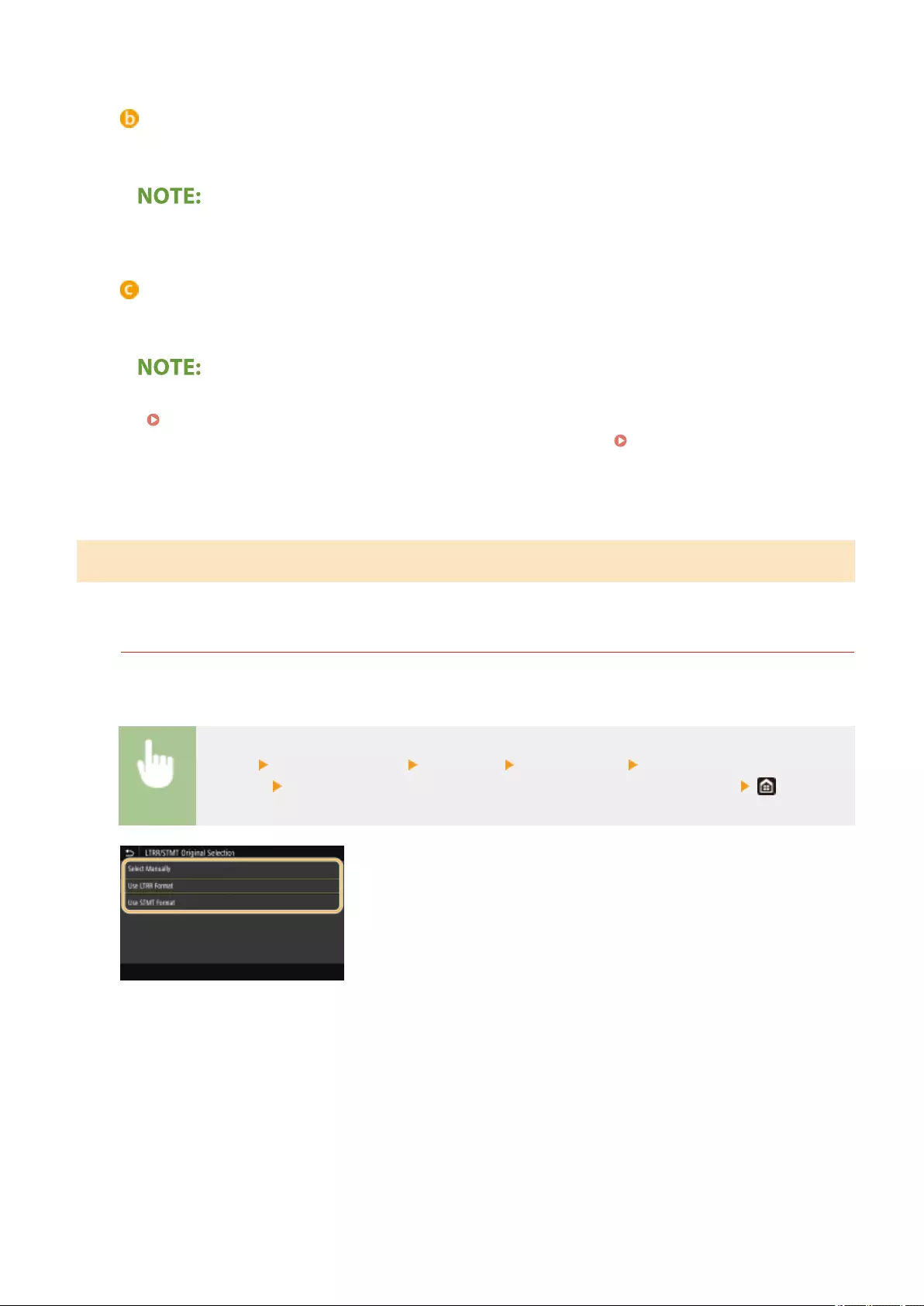
<Speed Priority>
When using paper that has been preprinted with a logo, you need to change how it is facing when you
perform 1-sided and 2-sided printing.
●We recommend selecting <Speed Priority> if you do not need to consider which side to print on.
<Print Side Priority>
To print on a specic side of paper, you do not need to ip over paper in the paper source whether 1- or 2-
sided printing is selected.
●If <Print Side Priority> is set for a paper source that is loaded with paper you cannot use for 2-sided printing
( Available Paper(P. 726) ), <Speed Priority> is applied to the paper source instead. In this case, you need
to load the paper in the same way as when <Speed Priority> is selected ( Loading Preprinted
Paper(P. 149) ).
●1-sided printing speed may be slower when <Print Side Priority> is selected.
<Scan Settings>
Congure scan settings.
<LTRR/STMT Original Selection>
You can forcibly designate the way the machine handles LTRR and STMT originals that are placed on the platen
glass.
<Menu> <Function Settings> <Common> <Scan Settings> <LTRR/STMT Original
Selection> Select <Select Manually>, <Use LTRR Format> or <Use STMT Format>
<Select Manually>
When you set LTRR or STMT originals on the platen glass, the screen for specifying the size of the original
appears while reading.
<Use LTRR Format>
When you set LTRR or STMT originals on the platen glass, the original is read with LTRR size while reading.
<Use STMT Format>
When you set LTRR or STMT originals on the platen glass, the original is read with STMT size while reading.
Setting Menu List
458
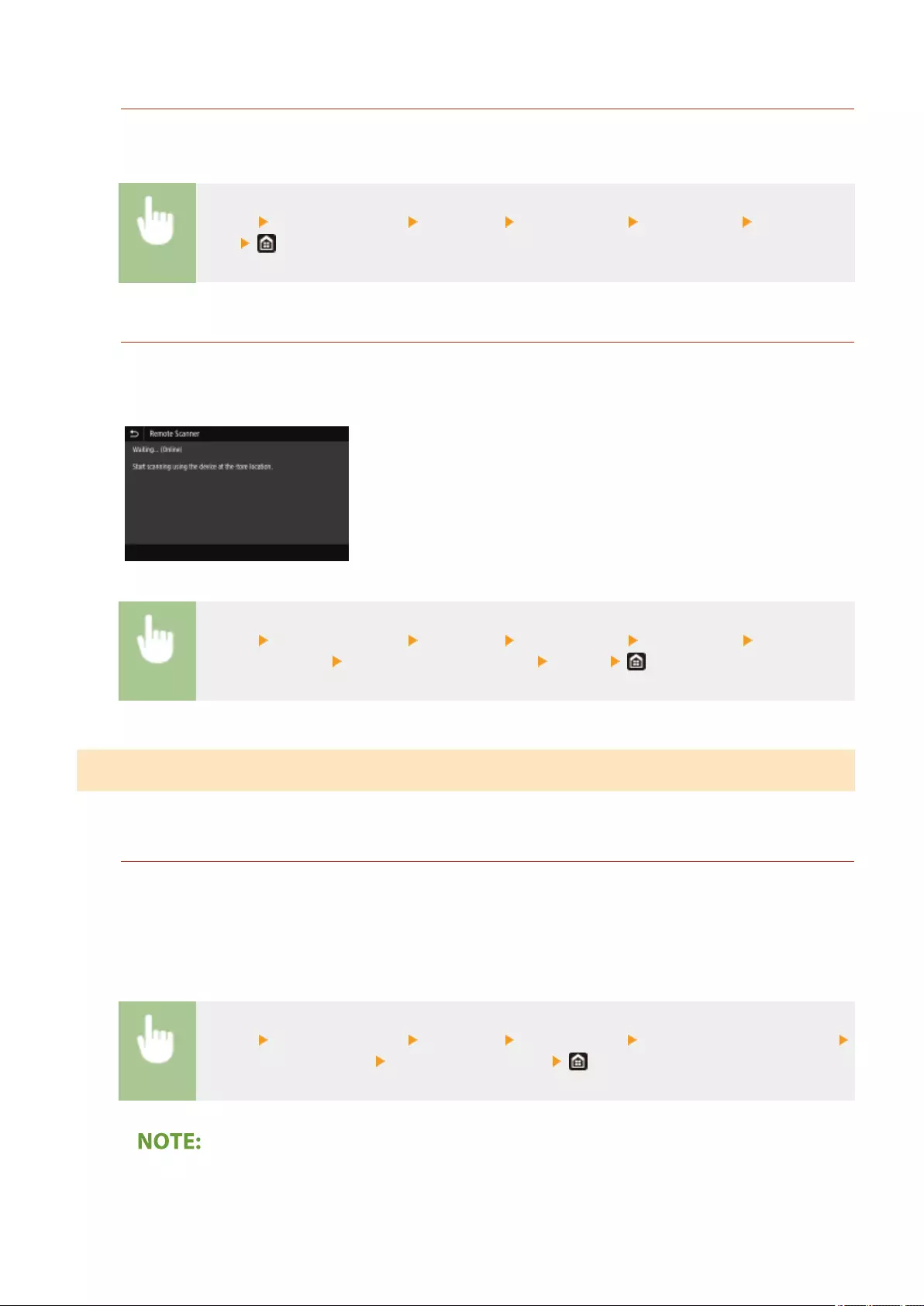
<Auto Online>
When scanning from the computer, use this to specify whether to automatically go online for remote scanning
(scan standby mode) without using the operation panel.
<Menu> <Function Settings> <Common> <Scan Settings> <Auto Online> Select <Off> or
<On>
<Auto Oine>
If scan is not performed within a specied period of time after the screen below is displayed (the machine is
set online for scanning), the machine automatically becomes oine. Specify the time period at which the
machine becomes oine.
<Menu> <Function Settings> <Common> <Scan Settings> <Auto Oine> Select <On> in
<Set This Function> Enter the time in <Set Time> <Apply>
<Generate File>
Congure le generation settings.
<Output File Image Settings>
Specify settings for the gamma value for converting scanned originals into les.
<YCbCr TX Gamma Value>
Select the gamma value used when converting scanned color originals into the specied le format. You can
specify the same gamma value as that of the monitor which is to be used for viewing the converted les. The
les are displayed with brightness that is true to the original documents.
<Menu> <Function Settings> <Common> <Generate File> <Output File Image Settings>
<YCbCr TX Gamma Value> Select the gamma value
●For the gamma value of a monitor display, see the instruction manual included with the display.
Setting Menu List
459

<OCR (Text Searchable) Settings>
To run OCR (Optical Character Recognition) on a text original to create a "searchable PDF," specify whether the
machine determines the original's text direction and detects the original direction.
<Menu> <Function Settings> <Common> <Generate File> <OCR (Text Searchable)
Settings> Select <Off> or <On> in <Smart Scan> <Apply>
<Fax Setup Guide> *
Select to display on-screen instructions for specifying settings, including the fax number and the RX mode.
Conguring Initial Settings for Fax Functions(P. 82)
Setting Menu List
460
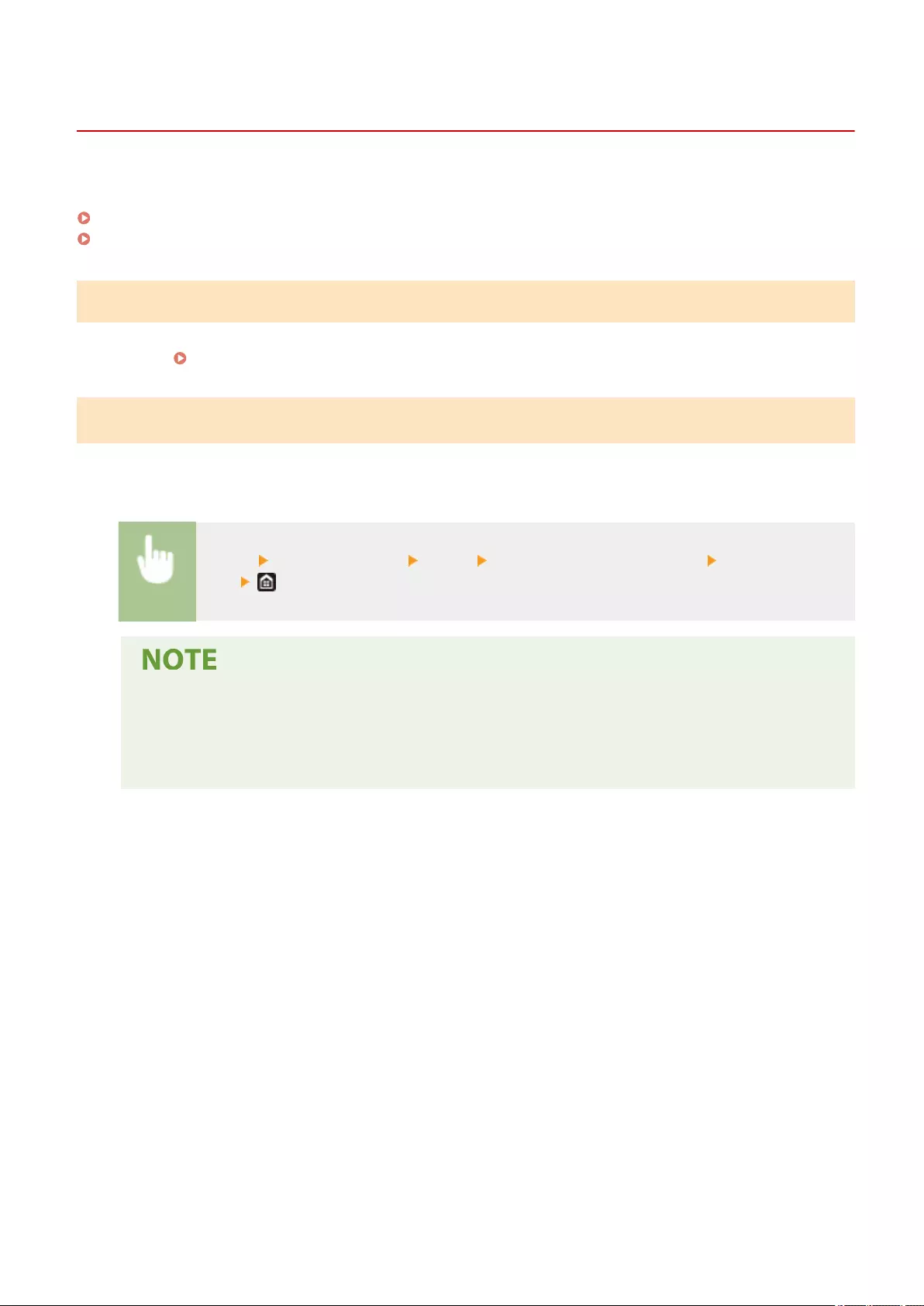
<Copy>
2579-0FX
All the settings about the copy are listed with short descriptions.
<Change Default Settings (Copy)> (P. 461)
<Auto Recog. Orig. Orientation>(P. 461)
<Change Default Settings (Copy)>
You can change the factory default settings about copy. The selected settings are used as the default settings of the
copy function. Changing the Default Settings for Functions(P. 175)
<Auto Recog. Orig. Orientation>
If you set this setting to <On>, nishing mode is switched between <Collate (Page Order)> and <Offset> automatically.
This prevents you from forgetting to collate the output when making multiple copies.
<Menu> <Function Settings> <Copy> <Auto Recog. Orig. Orientation> Select <Off> or
<On>
●If you are enlarging A4 or A5 originals onto A3 copy paper, Auto Orientation is not performed even if
it is set to <On>.
●Only the images of standard size originals up to A4 size can be rotated when the copy ratio is set to
100 %.
Setting Menu List
461
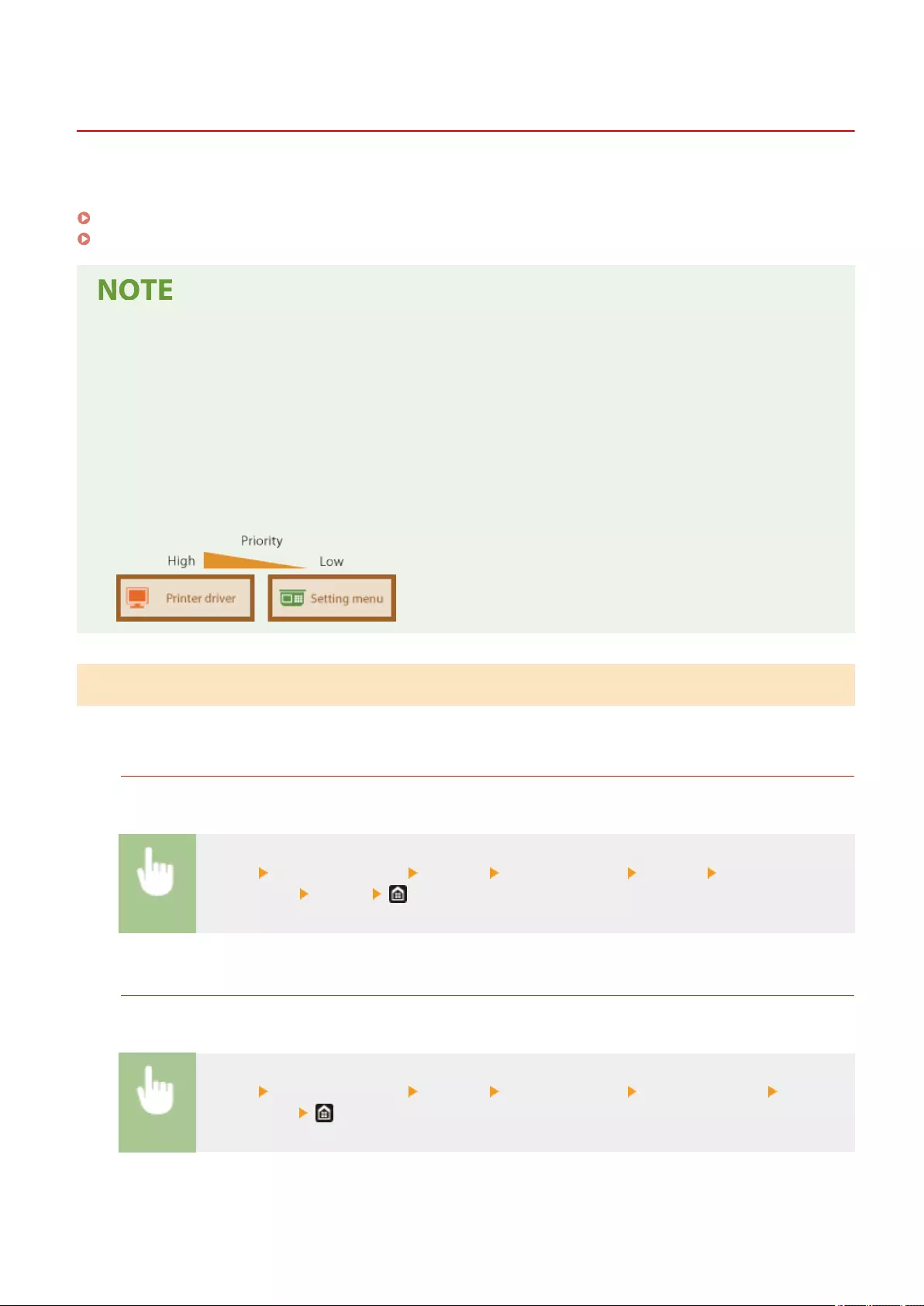
<Printer>
2579-08X
All the settings related to the printer are listed with descriptions.
<Printer Settings>(P. 462)
<PDL Selection (Plug and Play)>(P. 483)
Asterisks (*)
●Settings marked with "*1" may be unavailable or vary depending on your country or region.
●Settings marked with "*2" cannot be imported or exported.
Priority of settings
●If a print setting is specied both from the printer driver and the operation panel of the machine, the
specication from the printer driver overrides that from the operation panel. The specication from the
operation panel becomes effective in some specic cases, such as when performing PS/PCL printing and
printing from UNIX or other operating system that does not support printer drivers.
<Printer Settings>
Congure settings about printing and printer operations.
<Copies>
Set the number of copies to print.
<Menu> <Function Settings> <Printer> <Printer Settings> <Copies> Set the number of
copies to print <Apply>
<2-Sided Printing>
Select whether to make 2-sided printouts.
<Menu> <Function Settings> <Printer> <Printer Settings> <2-Sided Printing> Select
<Off> or <On>
Setting Menu List
462

<Default Paper>
Use this item to specify the paper size and type. Available Paper(P. 726)
<Menu> <Function Settings> <Printer> <Printer Settings> <Default Paper> Select the
paper size Select the paper type
<Paper Size Override>
Select whether to switch between printing on A4 and LTR, or on A3 and 11x17 size paper if one of these paper
sizes is loaded but the other is not. When you select <On>, and the paper you specied is not loaded in the
machine, it will print your document on the other size paper.
<Menu> <Function Settings> <Printer> <Printer Settings> <Paper Size Override> Select
<Off> or <On>
●You can specify print settings, such as the number of copies or 1-sided/2-sided printing, from an
application or the printer driver. However, the <Paper Size Override> setting can only be specied on
the machine.
<Print Quality>
You can change settings related to print quality.
<Ink Saving>
You can save ink consumption. Select <On> when you want to check the layout or other appearance
characteristics before proceeding to nal printing of a large job.
<Menu> <Function Settings> <Printer> <Printer Settings> <Print Quality> <Ink
Saving> Select <Off> or <On>
<Resolution>
Specify the resolution to be used for print data processing.
<Menu> <Function Settings> <Printer> <Printer Settings> <Print
Quality> <Resolution> Select <1200 dpi>, <600 dpi> or <300 dpi>
<Super Smooth>
Creates smooth contours in text. More of an effect is gained the lower the resolution mode is. Disabled when
resolution is set to <1200 dpi>.
Setting Menu List
463

<Menu> <Function Settings> <Printer> <Printer Settings> <Print Quality> <Super
Smooth> Select <Off> or <On>
<Sharpen Text>
Prints white text and lines on a black background clearly.
Applied only when the [Page Layout] setting in the printer driver is [1 on 1].
<Menu> <Function Settings> <Printer> <Printer Settings> <Print Quality> <Sharpen
Text> Select <Off> or <On>
<Increase Line Density>
Makes pale-colored thin lines and text easier to see. Set this when gray lines are interrupted.
<Menu> <Function Settings> <Printer> <Printer Settings> <Print Quality> <Increase
Line Density> Select <Off> or <On>
<Line Control>
Specify the processing method used to reproduce lines.
<Menu> <Function Settings> <Printer> <Printer Settings> <Print Quality> <Line
Control> Select <Resolution Priority> or <Gradation Priority>
<Resolution Priority>
Draws lines with the same resolution as for text.
<Gradation Priority>
Draws lines while maintaining color and gradation.
<Width Adjustment>
Congure a setting to print text or ne lines in bold.
Setting Menu List
464
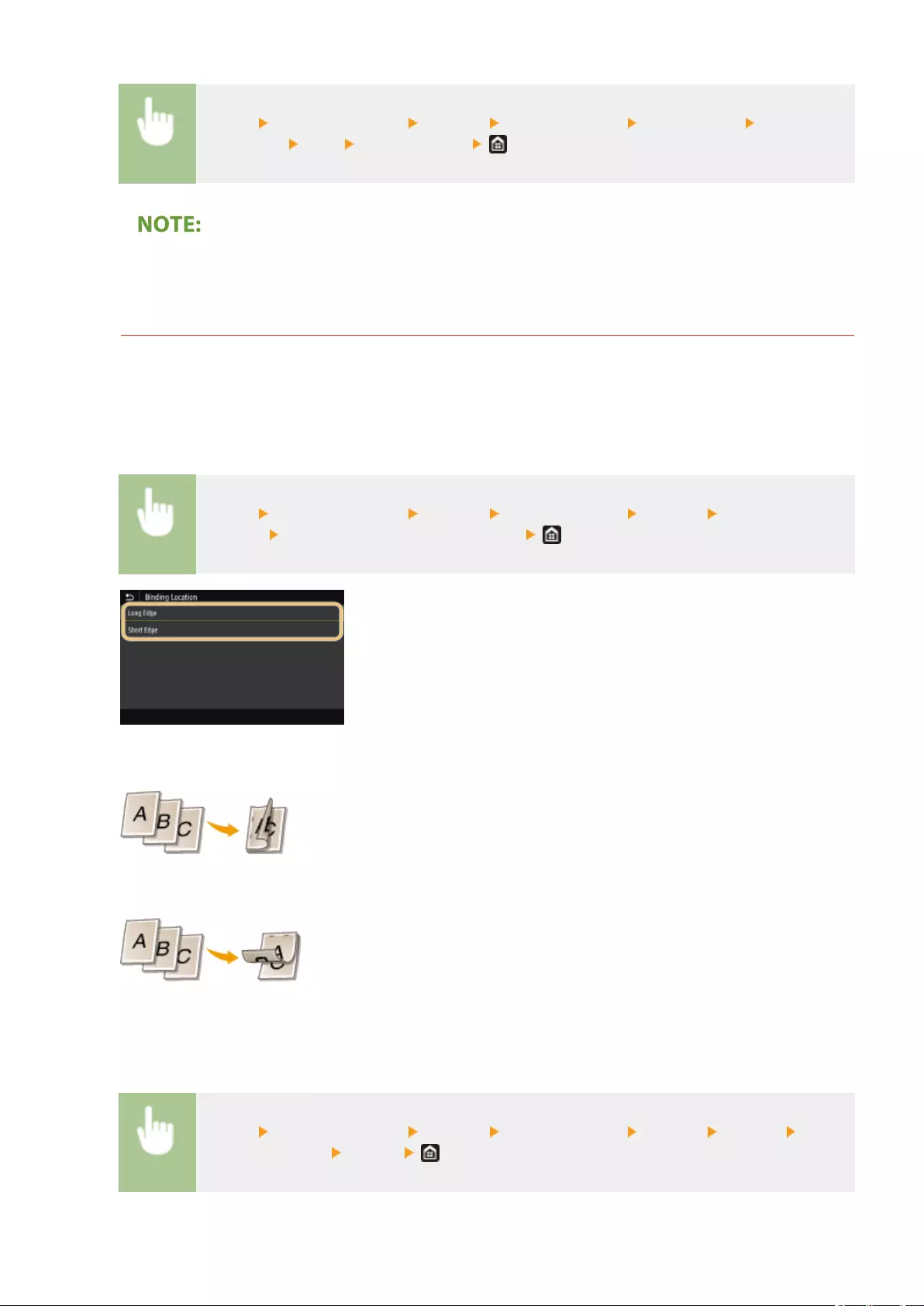
<Menu> <Function Settings> <Printer> <Printer Settings> <Print Quality> <Width
Adjustment> <On> Select the target
●If you set to <On>, the printing speed may be slower or image quality may be affected.
●Even if you set to <On>, bold printing may not be possible depending on the printing application.
<Layout>
Specify the page layout settings such as binding position and margin values.
<Binding Location>
If you are binding the printouts with a binding tool such as a stapler, use this item to specify whether to bind
on the long or short edge. Specify the setting of this item in combination with <Gutter>, which species the
binding margin to apply to the binding position.
<Menu> <Function Settings> <Printer> <Printer Settings> <Layout> <Binding
Location> Select <Long Edge> or <Short Edge>
<Long Edge>
Specify this to bind on the long edge of paper.
<Short Edge>
Specify this to bind on the short edge of paper.
<Gutter>
Shift the print position to adjust the binding margin to apply to the binding edge specied by <Binding
Location>. The value "0.00" exerts no effect on the binding margin.
<Menu> <Function Settings> <Printer> <Printer Settings> <Layout> <Gutter> Specify
the binding margin <Apply>
Setting Menu List
465
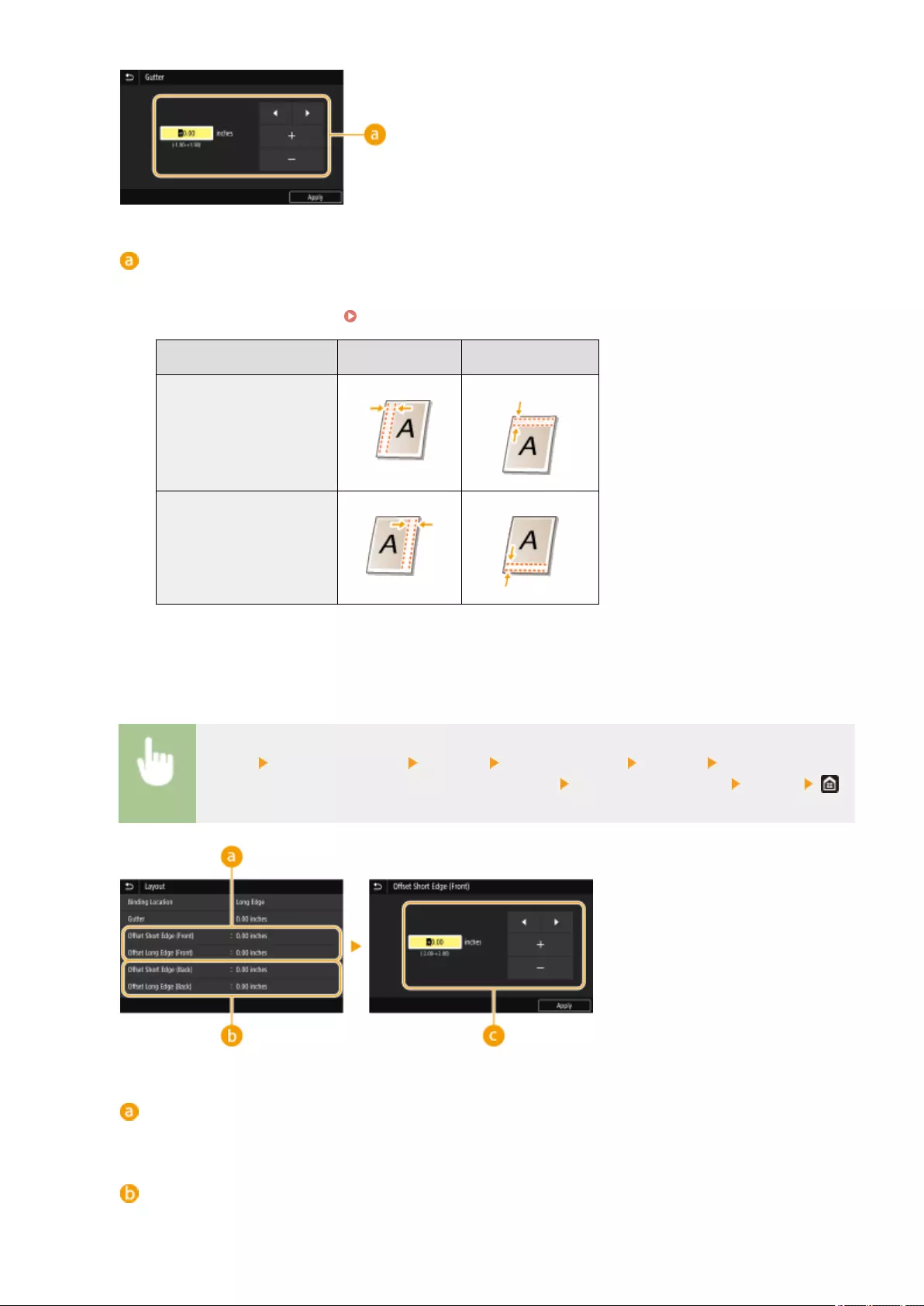
Entering the setting value
Specify the print position shift direction and shift width. Whether the setting value is a "+" or "-" value
determines the binding edge along which to adjust the binding margin. The margin width can be adjusted in
0.01 inch (0.5 mm) increments. Basic Operation(P. 126)
Setting Value Long Edge Short Edge
A value with a "+" sign Left edge of paper Top edge of paper
A value with a "-" sign Right edge of paper Bottom edge of paper
<Offset Short Edge/Offset Long Edge>
Irrespective of the paper source, you can shift the print position in units of "0.01 inches (0.5 mm)" for all print
jobs.
<Menu> <Function Settings> <Printer> <Printer Settings> <Layout> Select the
combination of adjustment direction and printing side Specify the offset value <Apply>
<Offset Short Edge (Front)>/<Offset Long Edge (Front)>
Shifts the print position on the side of paper facing up.
<Offset Short Edge (Back)>/<Offset Long Edge (Back)>
Shifts the print position on the side of paper facing down.
Setting Menu List
466
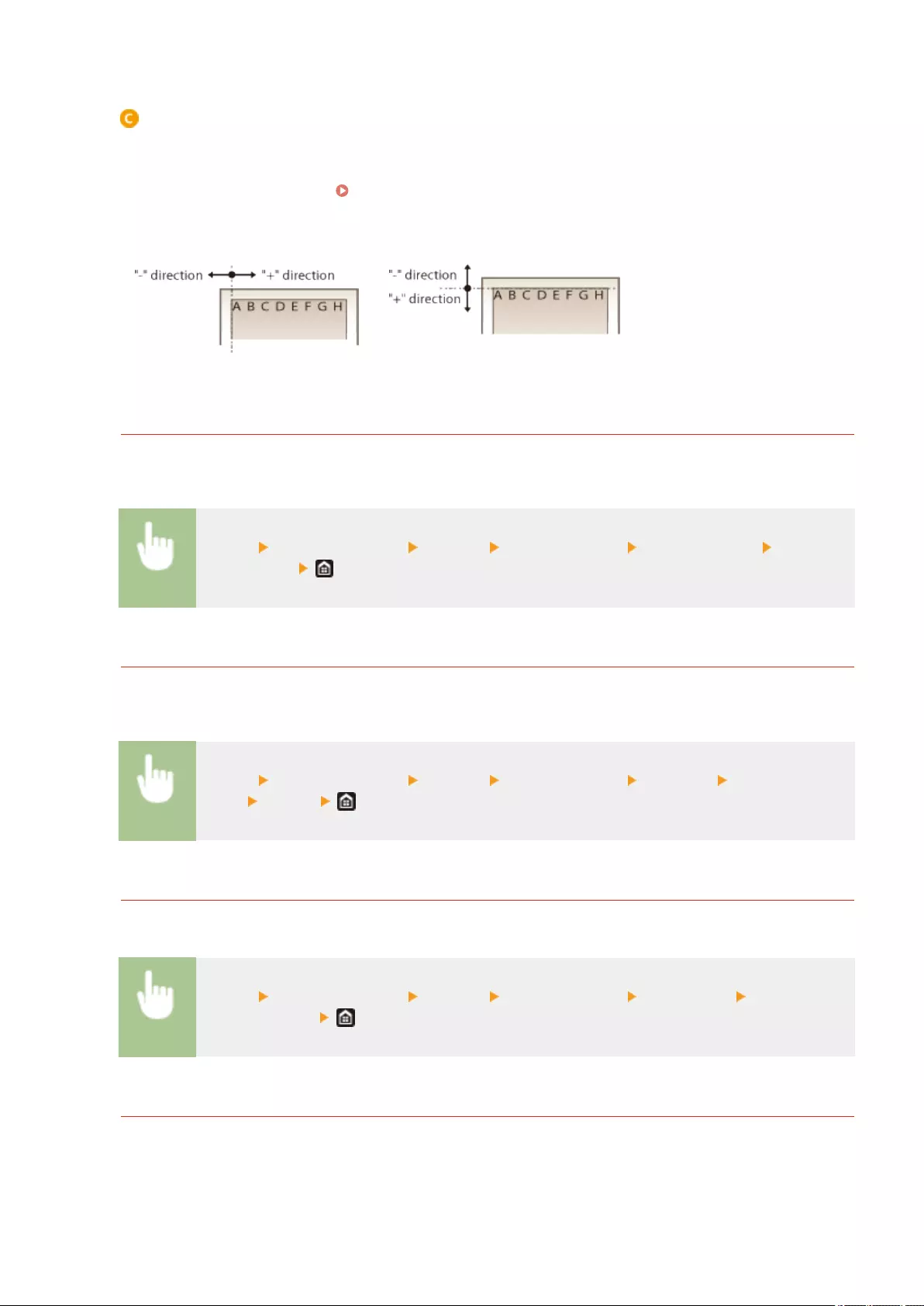
Entering the setting value
For <Offset Short Edge (Front)>/<Offset Short Edge (Back)>, specify a value with a "+" sign to shift the print
position in the left-to-right direction. For <Offset Long Edge (Front)>/<Offset Long Edge (Back)>, specify a
value with a "+" sign to shift the print position in the up-to-down direction. To shift in the reverse direction,
specify a value with a "-" sign. Basic Operation(P. 126)
<Offset Short Edge (Front)>
<Offset Short Edge (Back)>
<Offset Long Edge (Front)>
<Offset Long Edge (Back)>
<Auto Skip Error>
Printing stops if a certain error occurs in the process. However, if you set this item to <On>, the certain error will
be skipped and printing can continue. Normally, set this item to <Off>.
<Menu> <Function Settings> <Printer> <Printer Settings> <Auto Skip Error> Select
<Off> or <On>
<Timeout>
Set the time period after which the current print job is automatically canceled in the case of a print data
reception interruption.
<Menu> <Function Settings> <Printer> <Printer Settings> <Timeout> Set the time
period <Apply>
<Personality>
Specify the mode in which the machine should operate when the format of document data is unknown.
<Menu> <Function Settings> <Printer> <Printer Settings> <Personality> Select the
Personality mode
<Color Mode>
Select whether to print data in color or black and white.
Setting Menu List
467
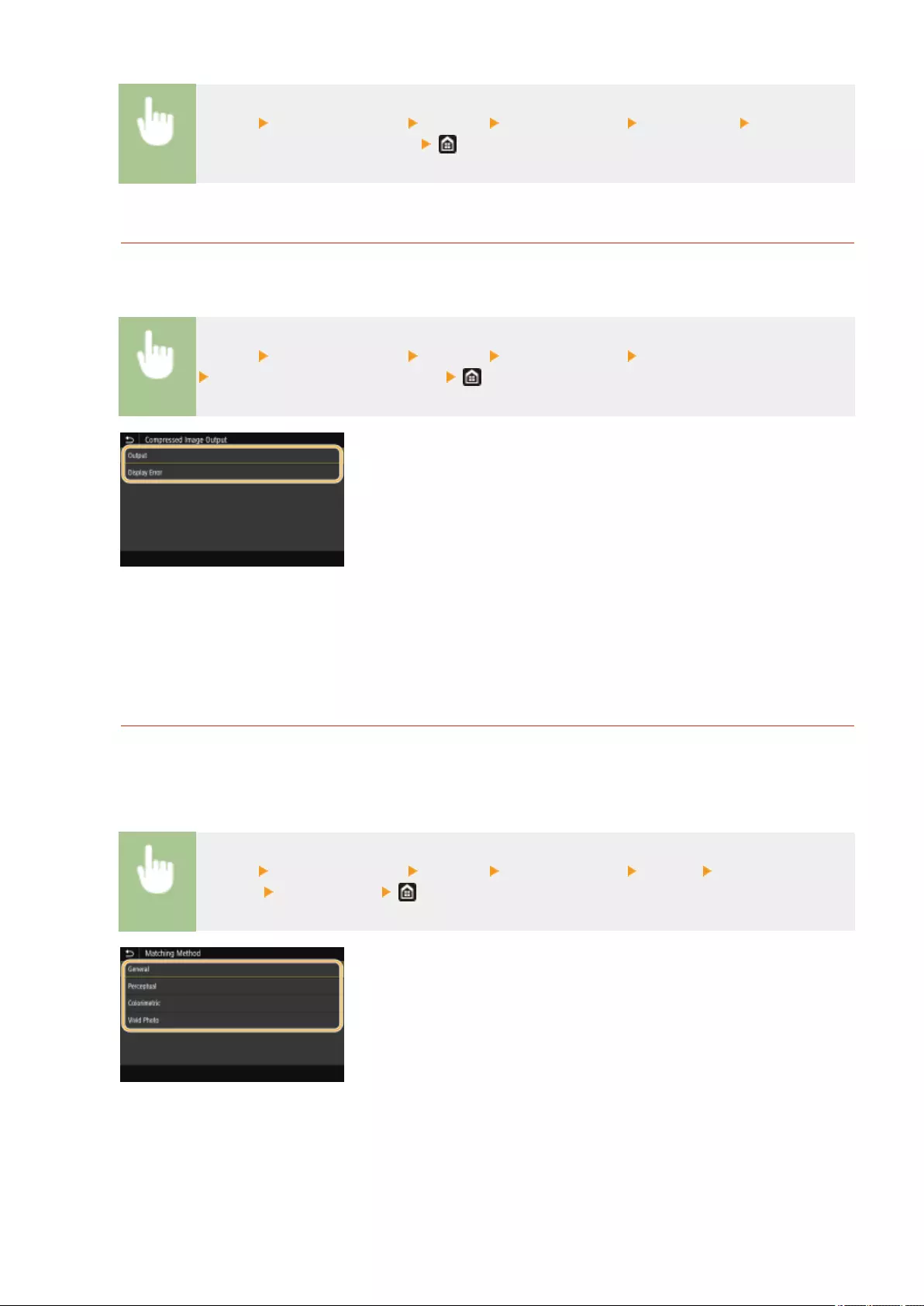
<Menu> <Function Settings> <Printer> <Printer Settings> <Color Mode> Select <Auto
(Color/B&W)> or <Black & White>
<Compressed Image Output>
Specify the operation that is to be performed when the image quality has degraded due to insucient memory
during printing.
<Menu> <Function Settings> <Printer> <Printer Settings> <Compressed Image Output>
Select <Output> or <Display Error>
<Output>
Continues printing regardless of how much the image quality has degraded.
<Display Error>
If the image quality has degraded signicantly, an error message is displayed, and printing is stopped.
<UFR II>
You can change the settings that become effective when printing from the UFR II printer driver.
<Matching Method>
Specify the processing method used to correct the color.
<Menu> <Function Settings> <Printer> <Printer Settings> <UFR II> <Matching
Method> Select the item
<General>
Performs processing so that the color tone is suitable for printing general papers such as photos or documents.
<Perceptual>
Performs processing so that the color tone is suitable for printing bitmap images. When this item is selected, an
image is printed in the colors closest to those displayed on the monitor.
Setting Menu List
468
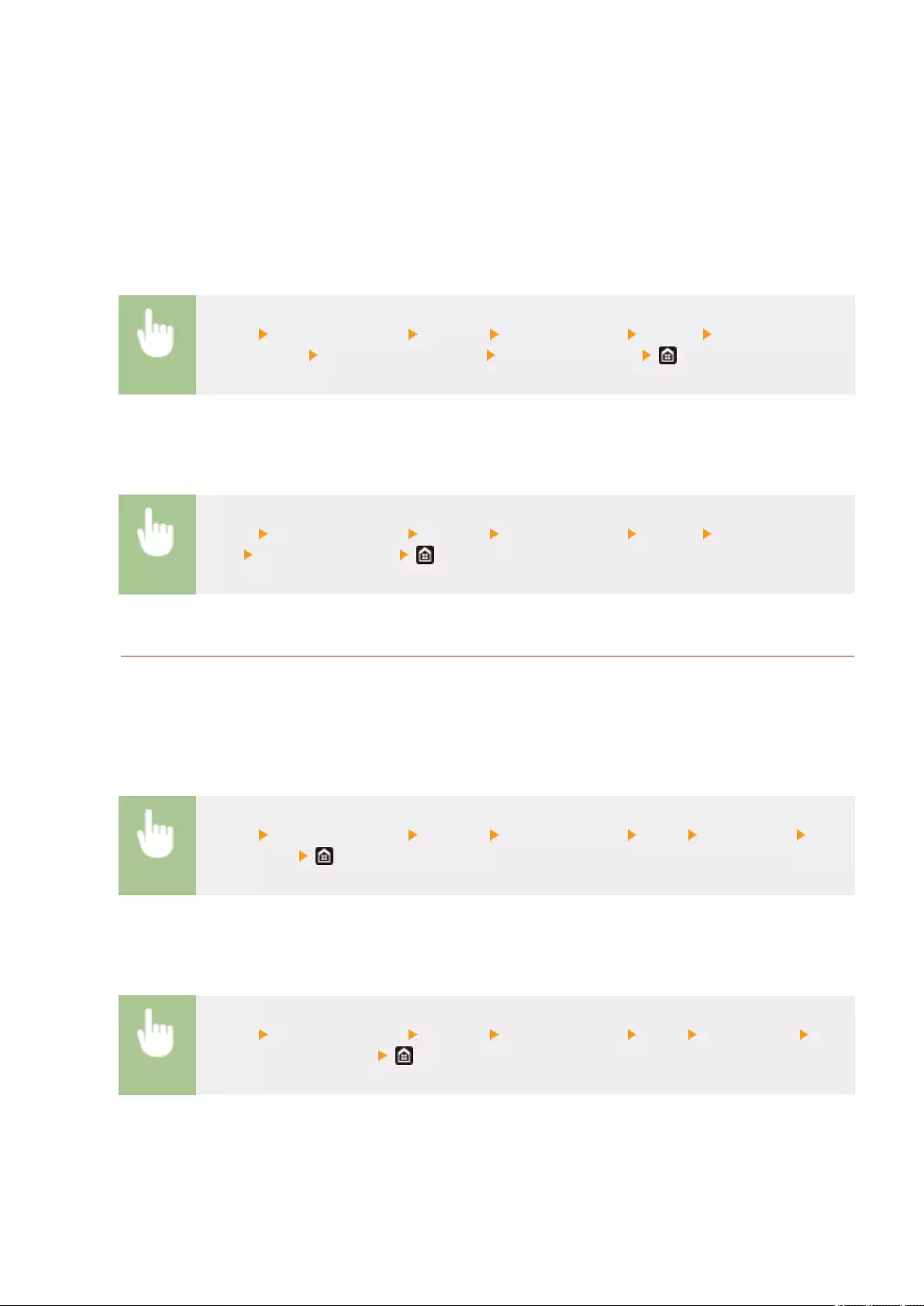
<Colorimetric>
Minimizes a color variance that occurs when RGB data is converted to CMYK data.
<Vivid Photo>
Performs processing so that the color tone is deeper and more vivid than <General>.
<Gray Compensation>
Congures a setting so that black or gray data of which color information is "R = G = B" is printed using only
the BK (black) ink. If <Off> is selected, data is printed using the ink of four colors: CMYK. This option can be
specied for each image type in any one document.
<Menu> <Function Settings> <Printer> <Printer Settings> <UFR II> <Gray
Compensation> Select the type of image Select <Off> or <On>
<Paper Save>
Specify whether to disable a blank page in print data from being output.
<Menu> <Function Settings> <Printer> <Printer Settings> <UFR II> <Paper
Save> Select <Off> or <On>
<PCL>
Specify the PCL printing settings such as page layout and print quality.
<Paper Save>
Select whether to save paper by not outputting blank pages in documents. By selecting <On>, the machine
will not output blank pages. To output all your document data when printing, including any blank pages that
you have inserted in your document, select <Off>.
<Menu> <Function Settings> <Printer> <Printer Settings> <PCL> <Paper Save> Select
<Off> or <On>
<Orientation>
Select <Portrait> (vertical orientation) or <Landscape> (horizontal orientation) for the page orientation.
<Menu> <Function Settings> <Printer> <Printer Settings> <PCL> <Orientation> Select
<Portrait> or <Landscape>
<Font Number>
Specify the font to use by selecting a corresponding font ID number. You can print the PCL font list with font
samples from the operation panel.
Setting Menu List
469
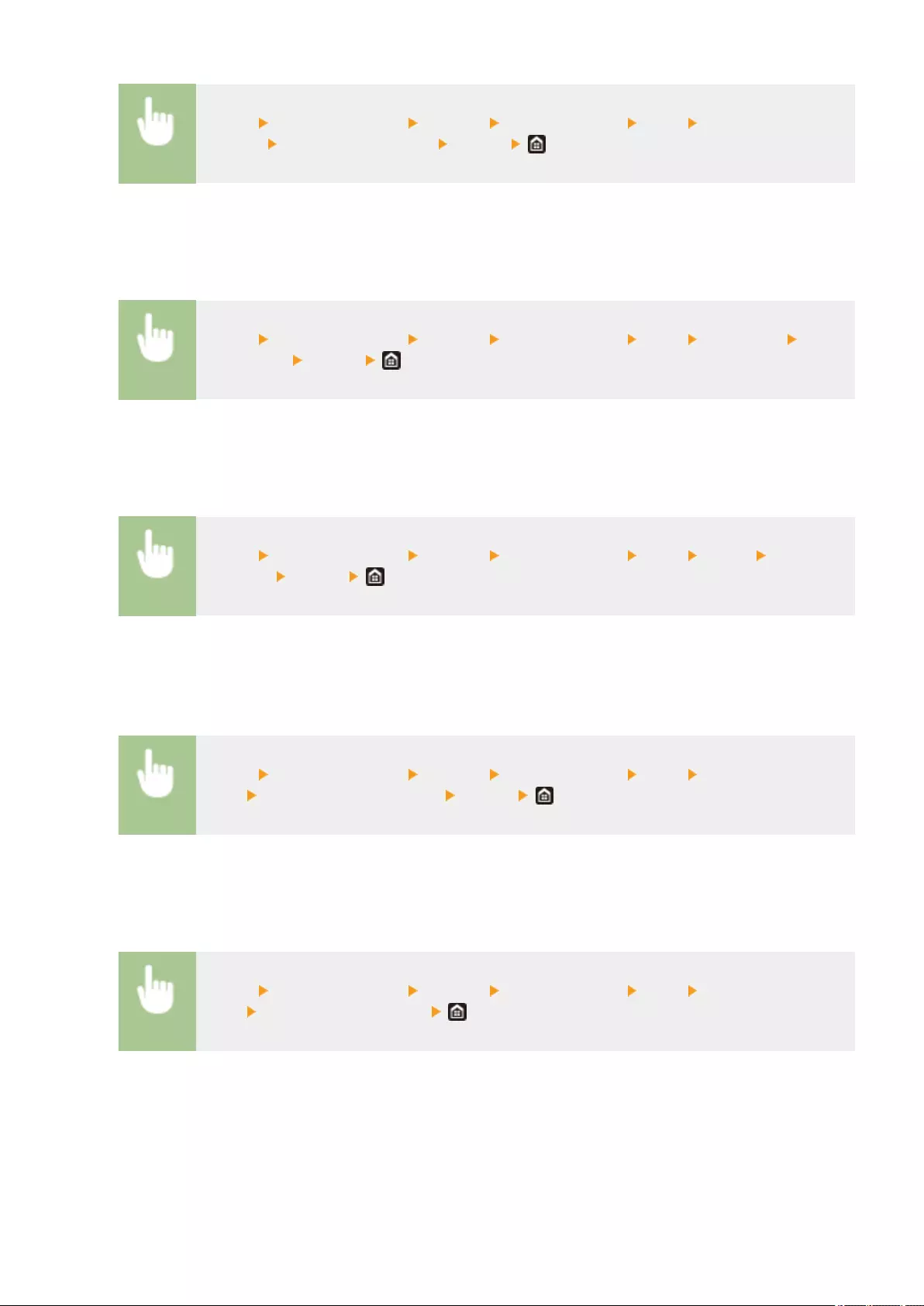
<Menu> <Function Settings> <Printer> <Printer Settings> <PCL> <Font
Number> Select the font number <Apply>
<Point Size>
Set the font size in points, adjustable in 0.25 increments. You can specify this setting only when a
proportionally-spaced scalable font is selected in <Font Number>.
<Menu> <Function Settings> <Printer> <Printer Settings> <PCL> <Point Size> Specify
the point size <Apply>
<Pitch>
Set the font pitch, or cpi (characters per inch), adjustable in 0.01 increments. You can specify this setting only
when a xed-pitch scalable font or a bitmap font is selected in <Font Number>.
<Menu> <Function Settings> <Printer> <Printer Settings> <PCL> <Pitch> Specify the
pitch value <Apply>
<Form Lines> *1
Set the number of lines printed on one page from 5 to 128. This setting is automatically changed according
to the settings specied in <Default Paper> and <Orientation>.
<Menu> <Function Settings> <Printer> <Printer Settings> <PCL> <Form
Lines> Specify the number of lines <Apply>
<Character Code>
Select the character code that is most suited for the computer you send print data from. The specied setting
is ignored when the character code is controlled by the font specied in <Font Number>.
<Menu> <Function Settings> <Printer> <Printer Settings> <PCL> <Character
Code> Select the character code
<Custom Paper>
Select whether to set a custom paper size. Select <On> to set the dimensions of the paper in <X dimension>
and <Y dimension>.
Setting Menu List
470
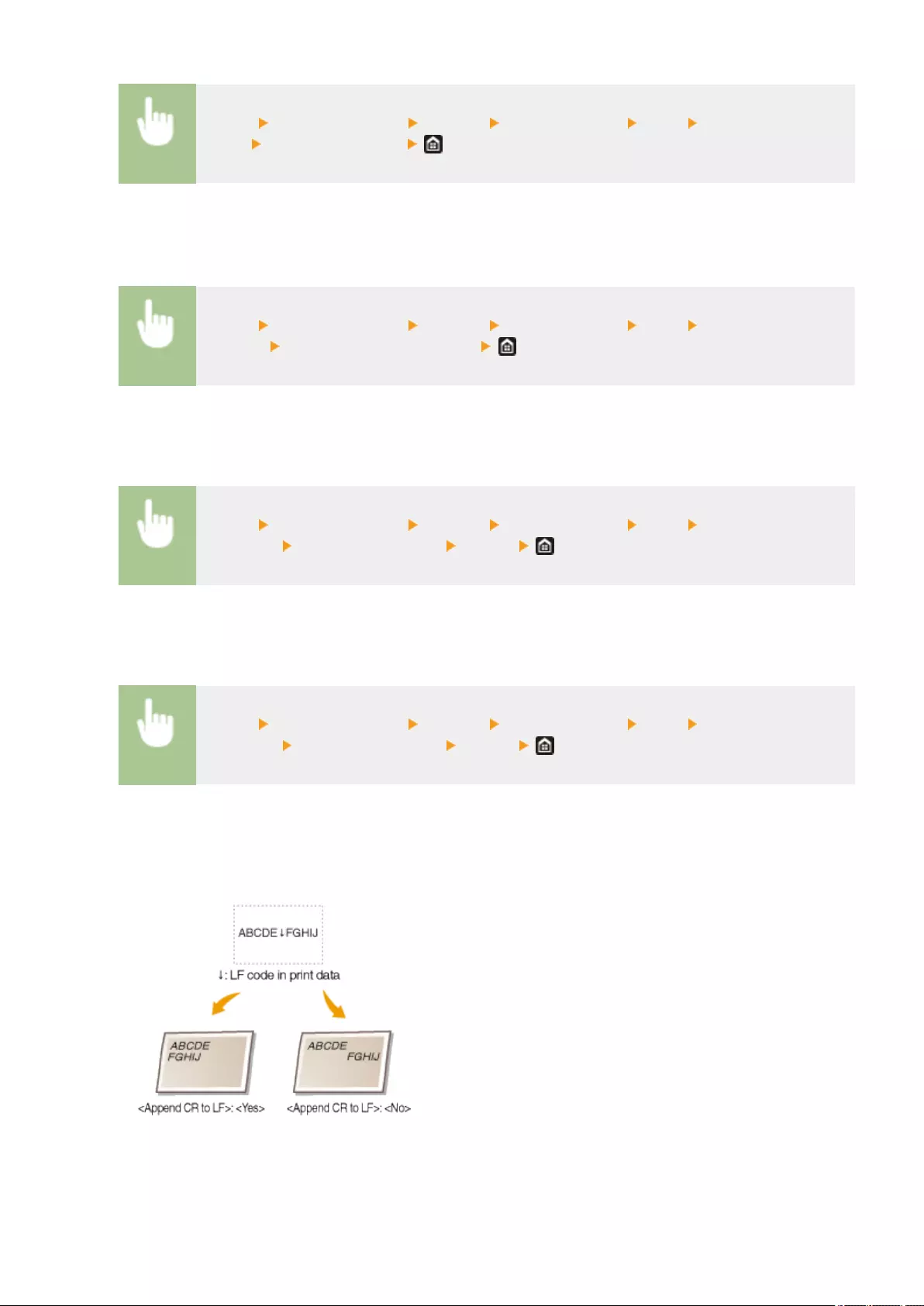
<Menu> <Function Settings> <Printer> <Printer Settings> <PCL> <Custom
Paper> Select <Off> or <On>
<Unit of Measure> *1
Select the unit of measurement to use to set a custom paper size.
<Menu> <Function Settings> <Printer> <Printer Settings> <PCL> <Unit of
Measure> Select <Millimeter> or <Inch>
<X dimension>
Specify the horizontal dimension (short edge) of the custom paper.
<Menu> <Function Settings> <Printer> <Printer Settings> <PCL> <X
dimension> Specify the dimension <Apply>
<Y dimension>
Specify the vertical dimension (long edge) of the custom paper.
<Menu> <Function Settings> <Printer> <Printer Settings> <PCL> <Y
dimension> Specify the dimension <Apply>
<Append CR to LF>
Select whether to append a carriage return (CR) when the machine receives a line feed code (LF). If <Yes> is
selected, the print position moves to the beginning of the next line when the machine receives an LF code. If
<No> is selected, the print position moves to the next line, just under the received LF code.
Setting Menu List
471
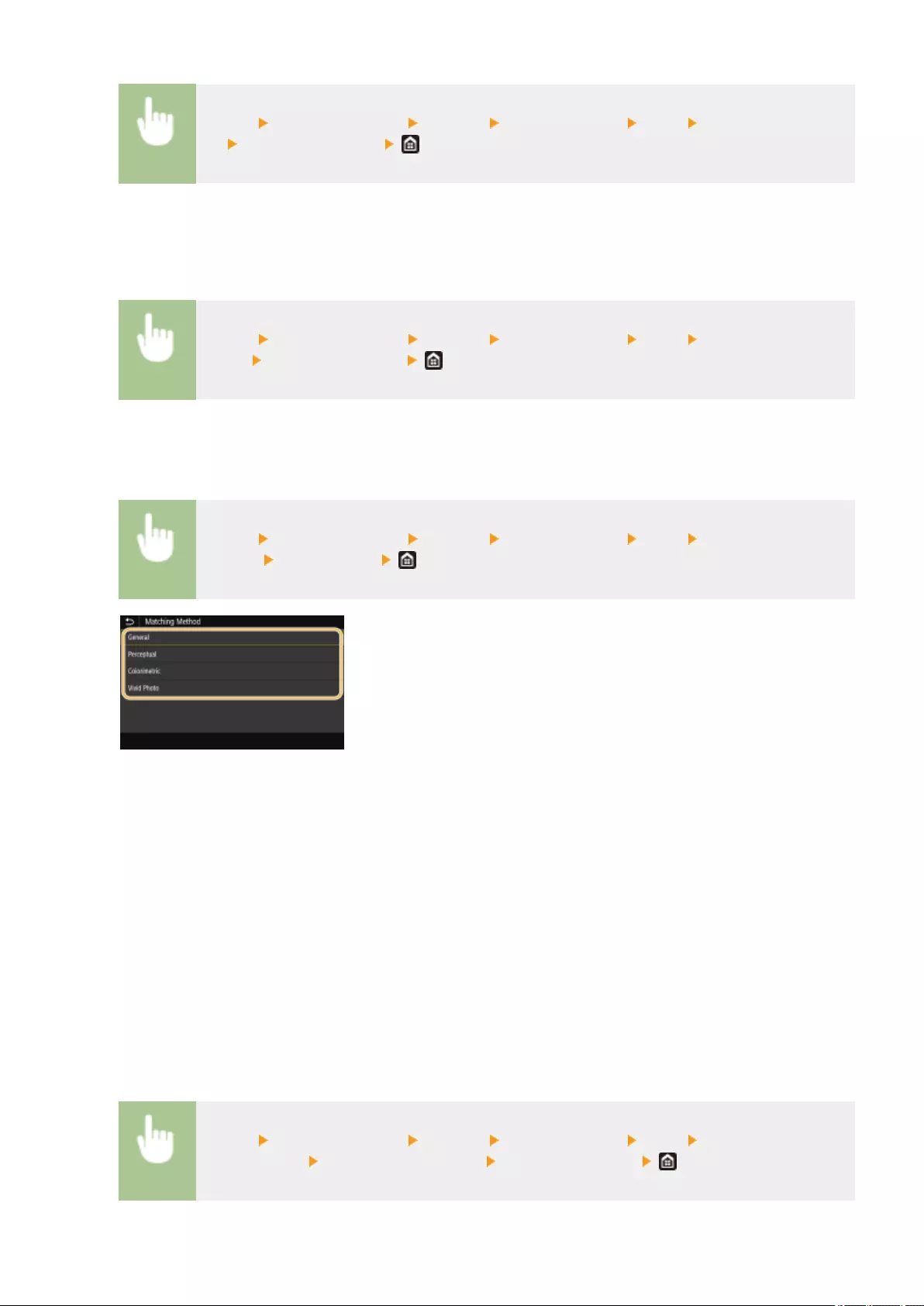
<Menu> <Function Settings> <Printer> <Printer Settings> <PCL> <Append CR to
LF> Select <Yes> or <No>
<Enlarge A4 Print Width>
Select whether to expand the width of the printable area of A4 size paper in portrait orientation to that of
Letter size.
<Menu> <Function Settings> <Printer> <Printer Settings> <PCL> <Enlarge A4 Print
Width> Select <Off> or <On>
<Matching Method>
Specify the processing method used to correct the color.
<Menu> <Function Settings> <Printer> <Printer Settings> <PCL> <Matching
Method> Select the item
<General>
Performs processing so that the color tone is suitable for printing general papers such as photos or documents.
<Perceptual>
Performs processing so that the color tone is suitable for printing bitmap images. When this item is selected, an
image is printed in the colors closest to those displayed on the monitor.
<Colorimetric>
Minimizes a color variance that occurs when RGB data is converted to CMYK data.
<Vivid Photo>
Performs processing so that the color tone is deeper and more vivid than <General>.
<Gray Compensation>
Congures a setting so that black or gray data of which color information is "R = G = B" is printed using only
the BK (black) ink. If <Off> is selected, data is printed using the ink of four colors: CMYK. This option can be
specied for each image type in any one document.
<Menu> <Function Settings> <Printer> <Printer Settings> <PCL> <Gray
Compensation> Select the type of image Select <Off> or <On>
Setting Menu List
472
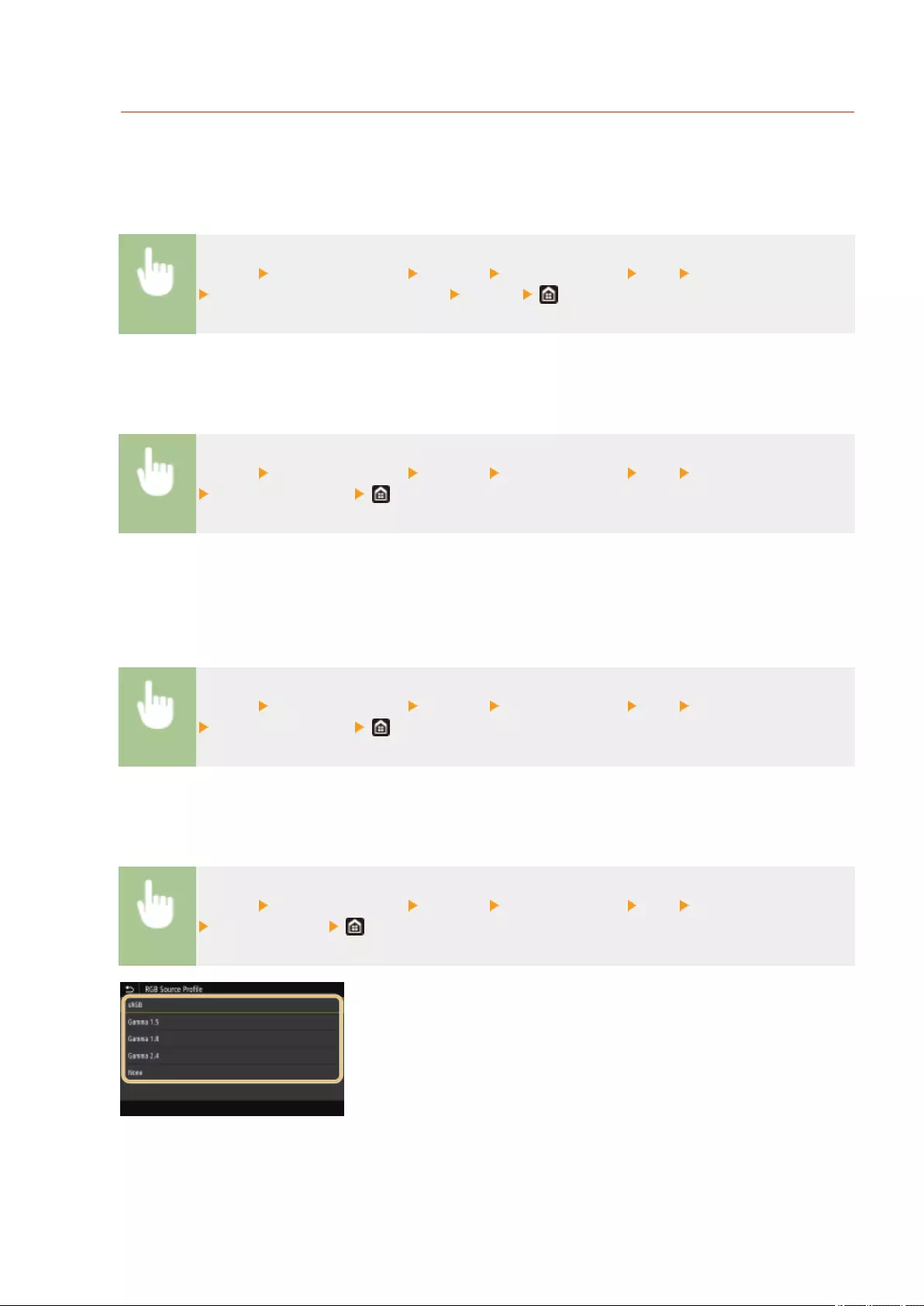
<PS>
Specify the PS printing settings such as page layout and print quality.
<Job Timeout>
This setting enables you to specify the amount of time before a job times out. If a job has not nished within
the set time limit, the job automatically cancels.
<Menu> <Function Settings> <Printer> <Printer Settings> <PS> <Job Timeout>
Specify the seconds for job timeout <Apply>
<Print PS Errors>
This setting determines whether an error page is printed when an error is encountered.
<Menu> <Function Settings> <Printer> <Printer Settings> <PS> <Print PS Errors>
Select <Off> or <On>
<Pure Black Text>
Congures a setting so that black text of which color information is "R = G = B = 0%," "C = M = Y = 100%," or "C
= M = Y = 0%/K = 100%" is printed using only the BK (black) ink. When <Off> is selected, text is printed based
on the <Output Prole> setting.
<Menu> <Function Settings> <Printer> <Printer Settings> <PS> <Pure Black Text>
Select <Off> or <On>
<RGB Source Prole>
Select the prole for RGB data according to the monitor you are using.
<Menu> <Function Settings> <Printer> <Printer Settings> <PS> <RGB Source Prole>
Select the prole
<sRGB>
Sets the image quality to the industry standard for general Windows computer monitors. If the monitor
supports sRGB, data can be printed in the color tones closest to the displayed colors.
<Gamma 1.5> to <Gamma 2.4>
Setting Menu List
473
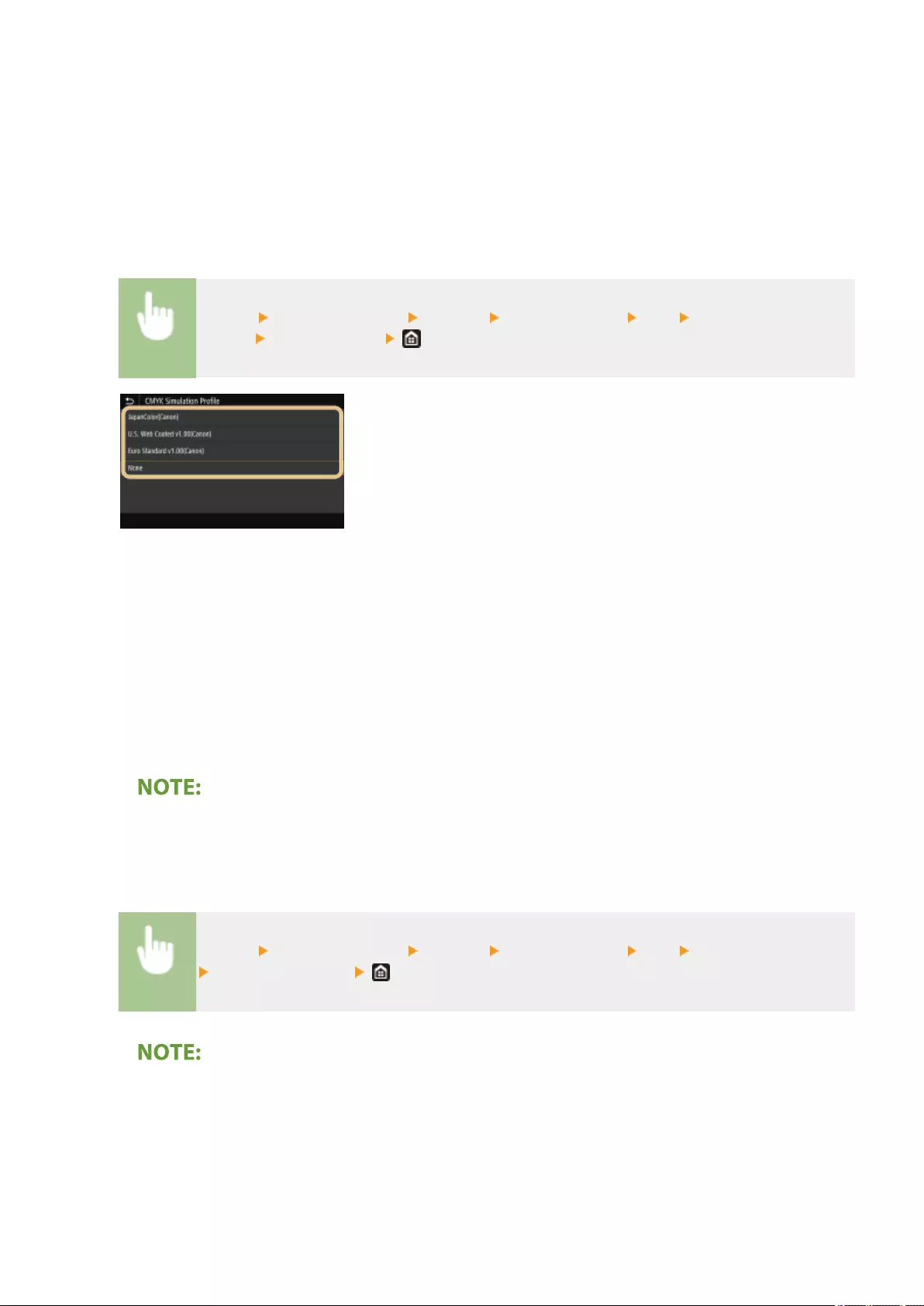
Adjusts the brightness of the print result to prevent the image quality of the brightest and darkest parts from
being degraded. The greater the gamma value is, the darker the printed text or image becomes.
<None>
Carries out color separation from RGB data to CMYK data without applying an RGB source prole.
<CMYK Simulation Prole>
Select a simulation target to print the CMYK data. The machine converts CMYK data into a device dependent
CMYK color model based on the simulation.
<Menu> <Function Settings> <Printer> <Printer Settings> <PS> <CMYK Simulation
Prole> Select the prole
<JapanColor(Canon)>
Set a JapanColor prole. Data is printed in the color tones closest to those of the Japanese printing standard.
<U.S. Web Coated v1.00(Canon)>
Set a U.S. Web Coated prole. Data is printed in the color tones closest to those of the U.S. printing standard.
<Euro Standard v1.00(Canon)>
Set a Euro Standard prole. Data is printed in the color tones closest to those of the European printing
standard.
<None>
Prints CMYK data by using a device-dependent CMYK color model without applying the CMYK simulation prole.
●When <None> is selected, the dark color gradation may become uneven depending on data.
<Use Grayscale Prole>
Specify whether to convert gray data to CMYK data using the grayscale prole of the machine.
<Menu> <Function Settings> <Printer> <Printer Settings> <PS> <Use Grayscale Prole>
Select <Off> or <On>
●Even if <On> is selected, data is printed using only the BK (black) ink depending on the setting of <Output
Prole> or <Pure Black Text>.
<Output Prole>
Select the appropriate prole for the print data. This option can be specied for each image type in any one
document.
Setting Menu List
474
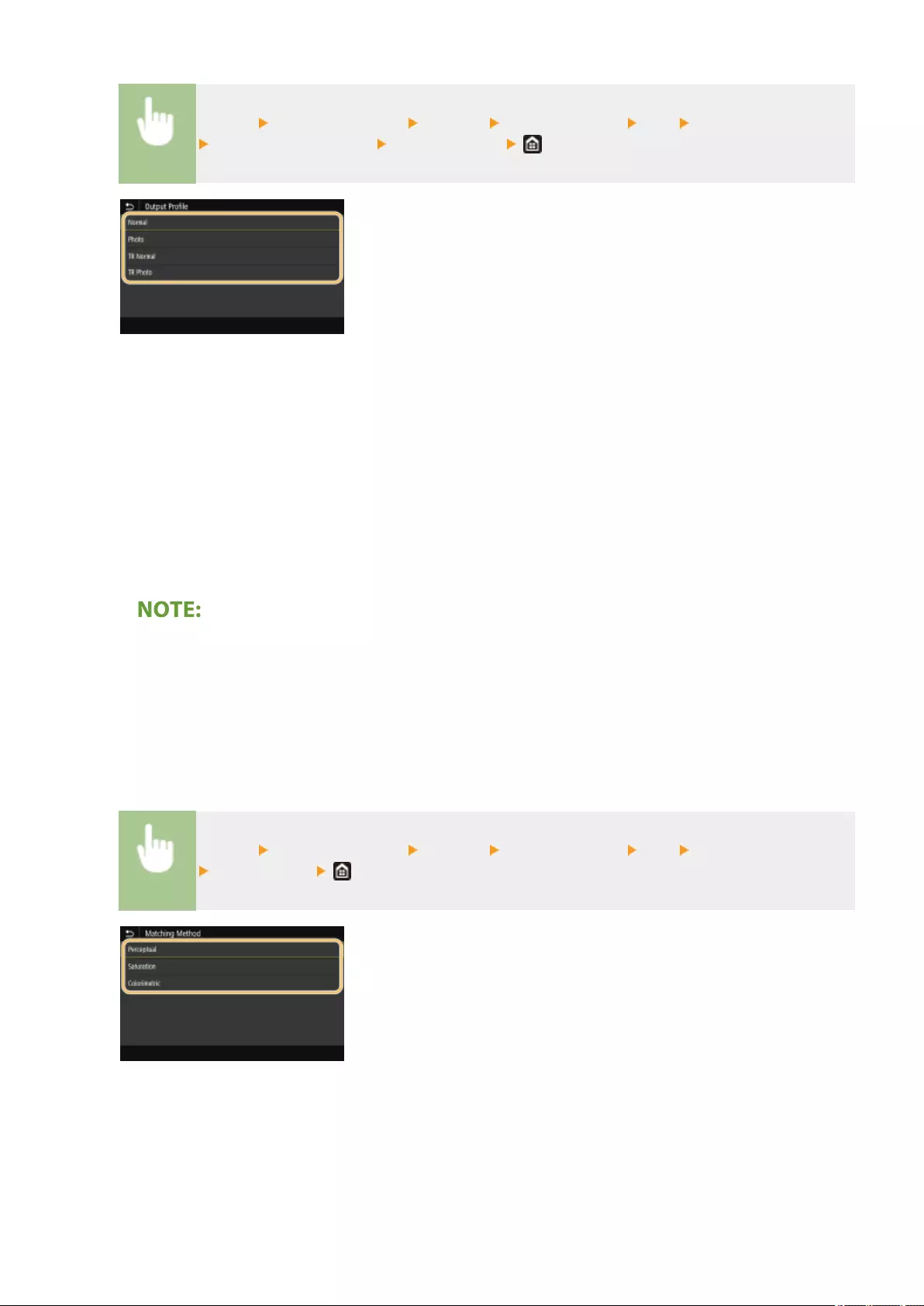
<Menu> <Function Settings> <Printer> <Printer Settings> <PS> <Output Prole>
Select the type of image Select the prole
<Normal>
Prints data by adjusting it to the color tones closest to those displayed on the monitor.
<Photo>
Prints data by adjusting it to photo-like color tones.
<TR Normal>
Prints data by adjusting it to the color tones closest to those displayed on the monitor and using only the BK
(black) ink to reproduce black and gray elements.
<TR Photo>
Prints data by adjusting it to photo-like color tones and using only the BK (black) ink to reproduce black and
gray elements.
The setting of this item is unavailable when one of the following settings is selected.
●<RGB Source Prole> is set to <None>
●<CMYK Simulation Prole> is set to <None>
●<Use Grayscale Prole> is set to <Off>
<Matching Method>
Select the element to be prioritized when carrying out color matching in <RGB Source Prole>.
<Menu> <Function Settings> <Printer> <Printer Settings> <PS> <Matching Method>
Select the item
<Perceptual>
Provides the color tone that is suitable for printing photos or bit map images.
<Saturation>
Provides the color tone that is suitable for printing artworks, graphs, and other images used for presentation
materials.
<Colorimetric>
Setting Menu List
475
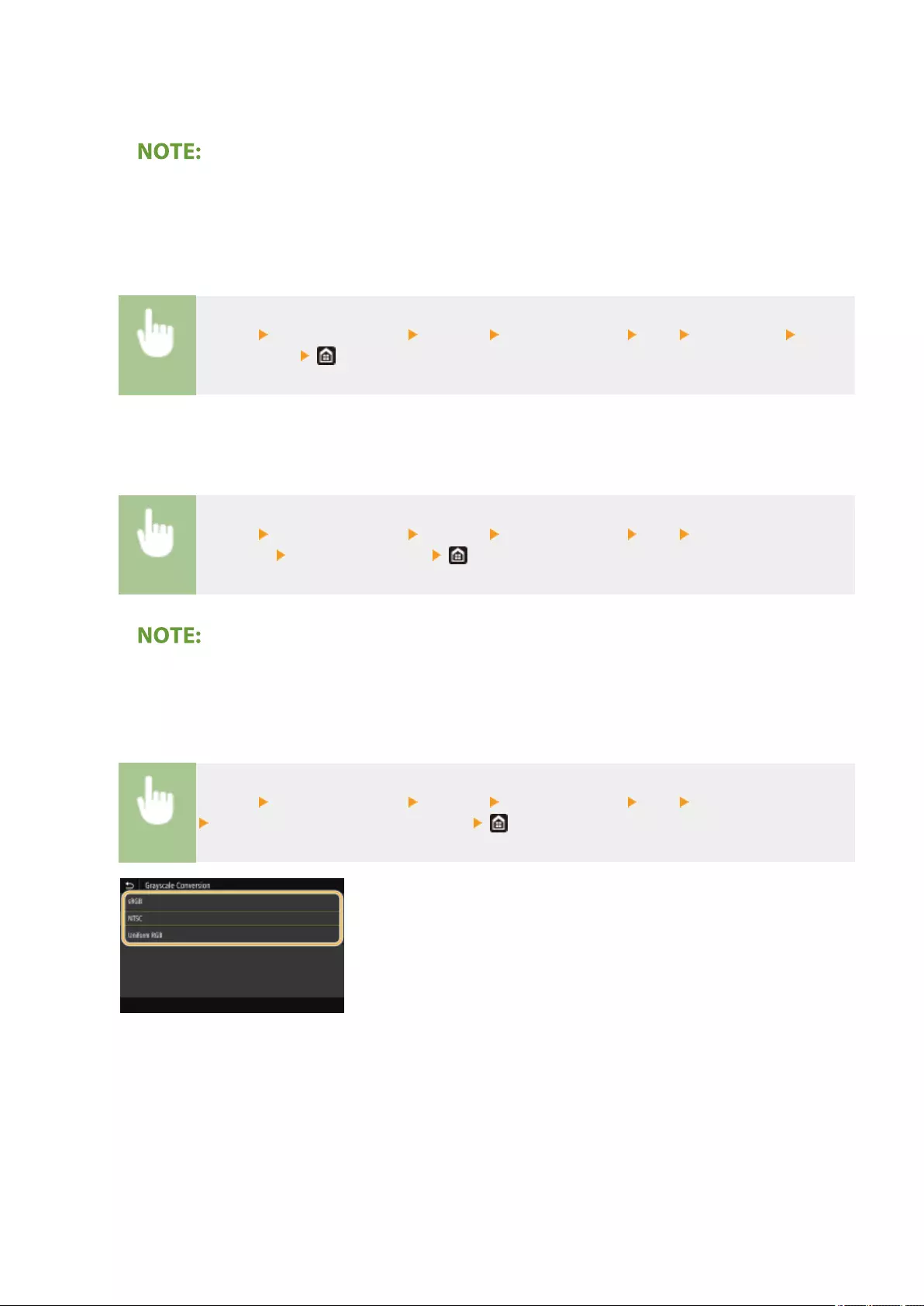
Set this option when you want to reproduce the RGB color value in the color reproduction range of the machine
as accurately as possible.
●The setting of this item is unavailable when <RGB Source Prole> is set to <None>.
<Brightness>
Adjust the brightness of the entire image in increments of 5%. The lower the setting value is, the brighter the
image or text becomes. The greater the setting value is, the darker the image or text becomes.
<Menu> <Function Settings> <Printer> <Printer Settings> <PS> <Brightness> Adjust
the brightness
<Composite Overprint>
Specify whether to overprint CMYK data, with overprint specied, as composite output.
<Menu> <Function Settings> <Printer> <Printer Settings> <PS> <Composite
Overprint> Select <Off> or <On>
●Overprinting using special colors is not permitted.
<Grayscale Conversion>
Specify the way of printing color data in black and white.
<Menu> <Function Settings> <Printer> <Printer Settings> <PS> <Grayscale Conversion>
Select the type of grayscale conversion
<sRGB>
Prints in black and white with emphasis on color differences so that a smooth gradation is achieved.
<NTSC>
Prints in black and white so that the resulting image looks like a black and white television picture (of the NTSC
system).
<Uniform RGB>
Prints in black and white so that R, G, and B are uniformly converted to the same gray level by using only
brightness as the reference.
Setting Menu List
476
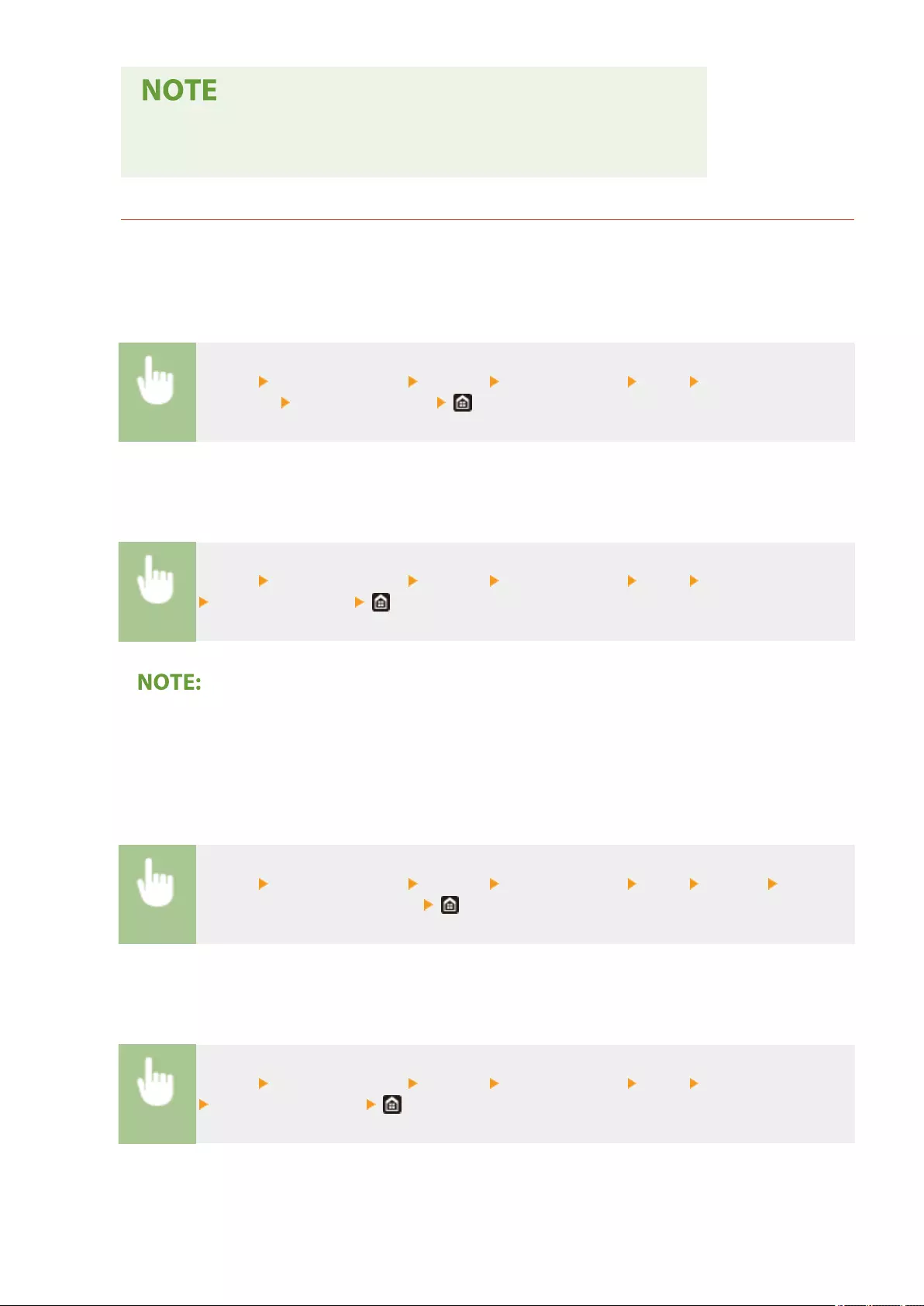
●This section describes the settings to convert the color data into grayscale data.
●This setting is invalid for black-and-white data.
<PDF>
You can change settings for PDF les.
<Enlarge/Reduce to Fit Paper Size>
Specify whether to enlarge or reduce the original according to the print range of paper. Note that size
enlargement/reduction will not affect the aspect ratio of the original.
<Menu> <Function Settings> <Printer> <Printer Settings> <PDF> <Enlarge/Reduce to Fit
Paper Size> Select <Off> or <On>
<Enlarge Print Area>
Specify whether to extend the print range to the paper size.
<Menu> <Function Settings> <Printer> <Printer Settings> <PDF> <Enlarge Print Area>
Select <Off> or <On>
●If you specify <On>, it may occur that edge-adjacent portions of page are not printed or that printouts
come out partially smudged depending on the original.
<N on 1>
Specify whether to shrink multiple pages and print them on one page in such arrangement that the rst
page is positioned at top left. For example, to print 4 pages onto a single sheet, select <4 on 1>.
<Menu> <Function Settings> <Printer> <Printer Settings> <PDF> <N on 1> Select the
number of pages to be combined
<Print Comments>
Specify whether to print comments. If you specify <Auto>, comments in PDF les will be printed.
<Menu> <Function Settings> <Printer> <Printer Settings> <PDF> <Print Comments>
Select <Off> or <Auto>
Setting Menu List
477
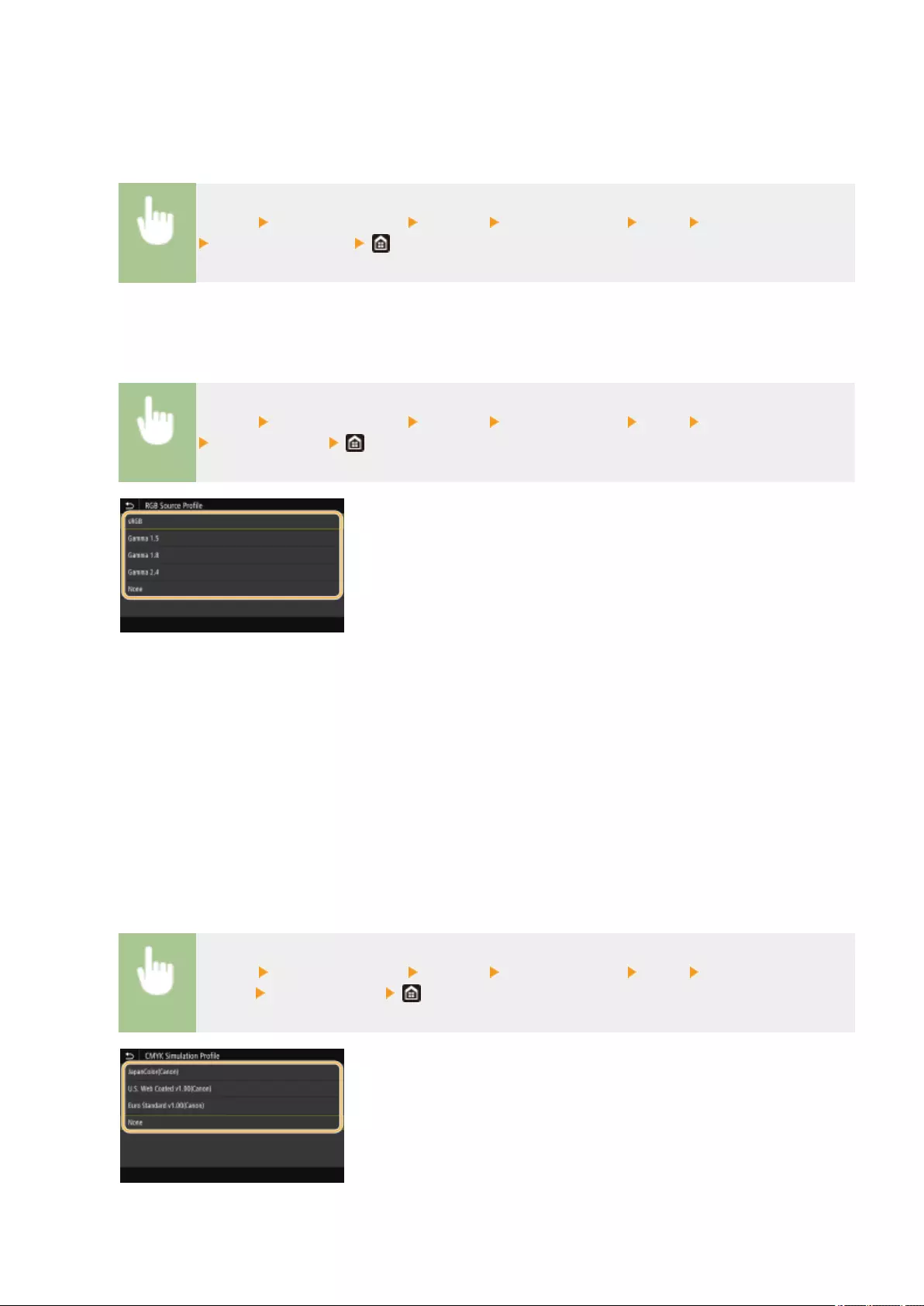
<Pure Black Text>
Congures a setting so that black text of which color information is "R = G = B = 0%," "C = M = Y = 100%," or "C
= M = Y = 0%/K = 100%" is printed using only the BK (black) ink. When <Off> is selected, text is printed based
on the <Output Prole> setting.
<Menu> <Function Settings> <Printer> <Printer Settings> <PDF> <Pure Black Text>
Select <Off> or <On>
<RGB Source Prole>
Select the prole for RGB data according to the monitor you are using.
<Menu> <Function Settings> <Printer> <Printer Settings> <PDF> <RGB Source Prole>
Select the prole
<sRGB>
Sets the image quality to the industry standard for general Windows computer monitors. If the monitor
supports sRGB, data can be printed in the color tones closest to the displayed colors.
<Gamma 1.5> to <Gamma 2.4>
Adjusts the brightness of the print result to prevent the image quality of the brightest and darkest parts from
being degraded. The greater the gamma value is, the darker the printed text or image becomes.
<None>
Carries out color separation from RGB data to CMYK data without applying an RGB source prole.
<CMYK Simulation Prole>
Select a simulation target to print the CMYK data. The machine converts CMYK data into a device dependent
CMYK color model based on the simulation.
<Menu> <Function Settings> <Printer> <Printer Settings> <PDF> <CMYK Simulation
Prole> Select the prole
<JapanColor(Canon)>
Setting Menu List
478
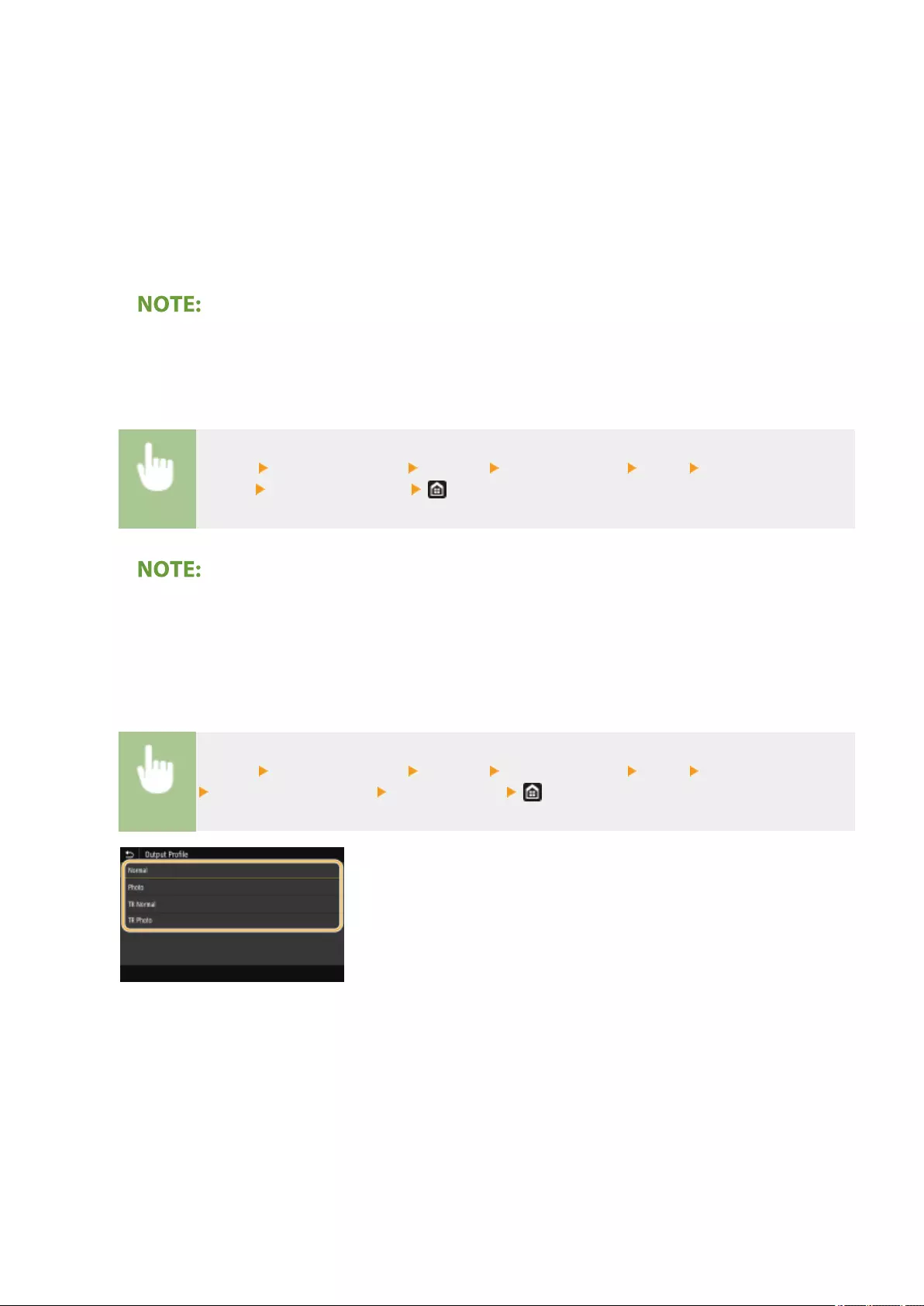
Set a JapanColor prole. Data is printed in the color tones closest to those of the Japanese printing standard.
<U.S. Web Coated v1.00(Canon)>
Set a U.S. Web Coated prole. Data is printed in the color tones closest to those of the U.S. printing standard.
<Euro Standard v1.00(Canon)>
Set a Euro Standard prole. Data is printed in the color tones closest to those of the European printing
standard.
<None>
Prints CMYK data by using a device-dependent CMYK color model without applying the CMYK simulation prole.
●When <None> is selected, the dark color gradation may become uneven depending on data.
<Use Grayscale Prole>
Specify whether to convert gray data to CMYK data using the grayscale prole of the machine.
<Menu> <Function Settings> <Printer> <Printer Settings> <PDF> <Use Grayscale
Prole> Select <Off> or <On>
●Even if <On> is selected, data is printed using only the BK (black) ink depending on the setting of <Output
Prole> or <Pure Black Text>.
<Output Prole>
Select the appropriate prole for the print data. This option can be specied for each image type in any one
document.
<Menu> <Function Settings> <Printer> <Printer Settings> <PDF> <Output Prole>
Select the type of image Select the prole
<Normal>
Prints data by adjusting it to the color tones closest to those displayed on the monitor.
<Photo>
Prints data by adjusting it to photo-like color tones.
<TR Normal>
Prints data by adjusting it to the color tones closest to those displayed on the monitor and using only the BK
(black) ink to reproduce black and gray elements.
<TR Photo>
Prints data by adjusting it to photo-like color tones and using only the BK (black) ink to reproduce black and
gray elements.
Setting Menu List
479

The setting of this item is unavailable when one of the following settings is selected.
●<RGB Source Prole> is set to <None>
●<CMYK Simulation Prole> is set to <None>
●<Use Grayscale Prole> is set to <Off>
<Matching Method>
Select the element to be prioritized when carrying out color matching in <RGB Source Prole>.
<Menu> <Function Settings> <Printer> <Printer Settings> <PDF> <Matching Method>
Select the item
<Perceptual>
Provides the color tone that is suitable for printing photos or bit map images.
<Saturation>
Provides the color tone that is suitable for printing artworks, graphs, and other images used for presentation
materials.
<Colorimetric>
Set this option when you want to reproduce the RGB color value in the color reproduction range of the machine
as accurately as possible.
●The setting of this item is unavailable when <RGB Source Prole> is set to <None>.
<Brightness>
Adjust the brightness of the entire image in increments of 5%. The lower the setting value is, the brighter the
image or text becomes. The greater the setting value is, the darker the image or text becomes.
<Menu> <Function Settings> <Printer> <Printer Settings> <PDF> <Brightness> Adjust
the brightness
<Composite Overprint>
Specify whether to overprint CMYK data, with overprint specied, as composite output.
<Menu> <Function Settings> <Printer> <Printer Settings> <PDF> <Composite
Overprint> Select <Off> or <On>
Setting Menu List
480
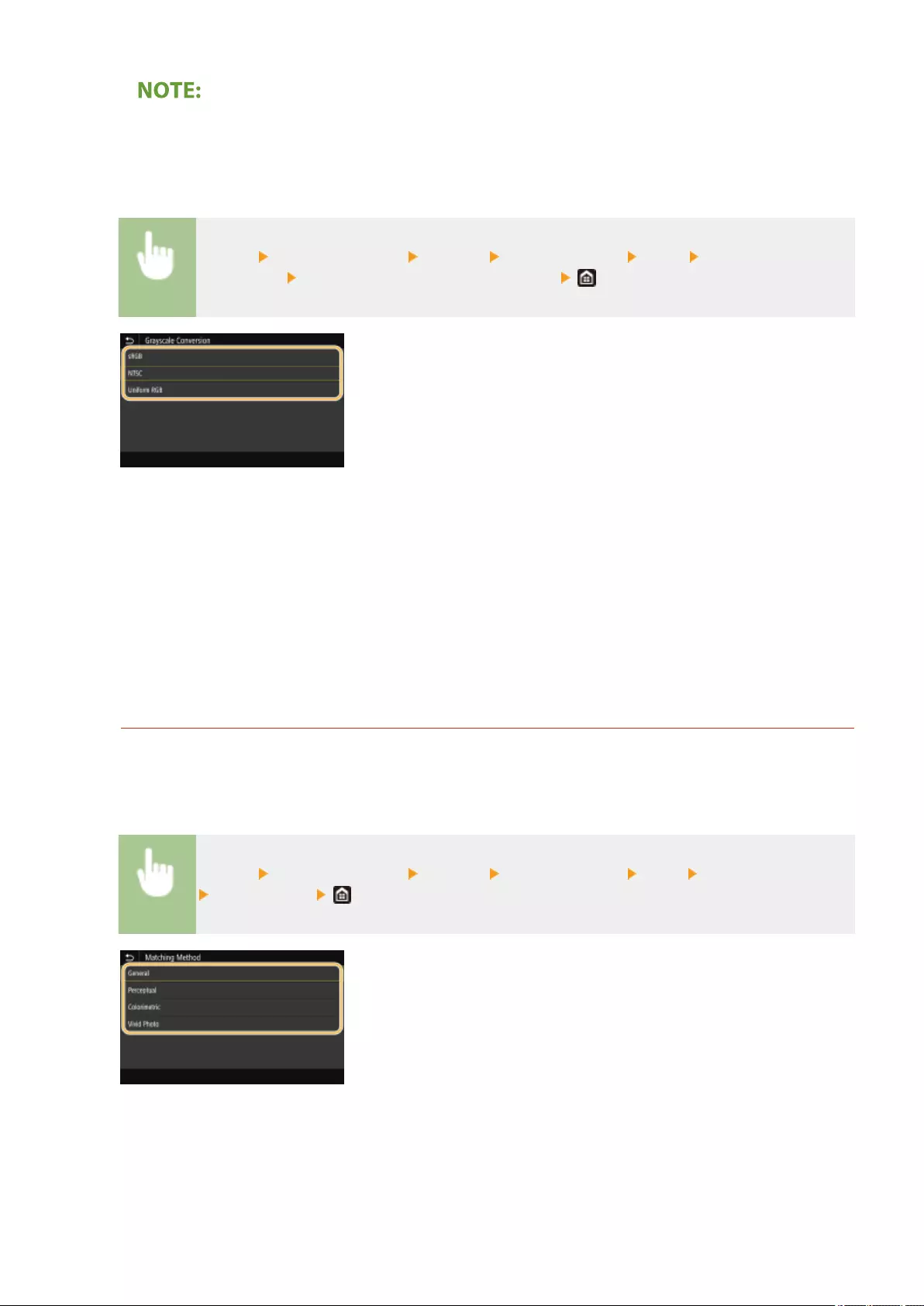
●Overprinting using special colors is not permitted.
<Grayscale Conversion>
Specify the way of printing color data in black and white.
<Menu> <Function Settings> <Printer> <Printer Settings> <PDF> <Grayscale
Conversion> Select the type of grayscale conversion
<sRGB>
Prints in black and white with emphasis on color differences so that a smooth gradation is achieved.
<NTSC>
Prints in black and white so that the resulting image looks like a black and white television picture (of the NTSC
system).
<Uniform RGB>
Prints in black and white so that R, G, and B are uniformly converted to the same gray level by using only
brightness as the reference.
<XPS>
You can change settings for XPS les.
<Matching Method>
Specify the processing method used to correct the color.
<Menu> <Function Settings> <Printer> <Printer Settings> <XPS> <Matching Method>
Select the item
<General>
Performs processing so that the color tone is suitable for printing general papers such as photos or documents.
<Perceptual>
Performs processing so that the color tone is suitable for printing bitmap images. When this item is selected, an
image is printed in the colors closest to those displayed on the monitor.
Setting Menu List
481
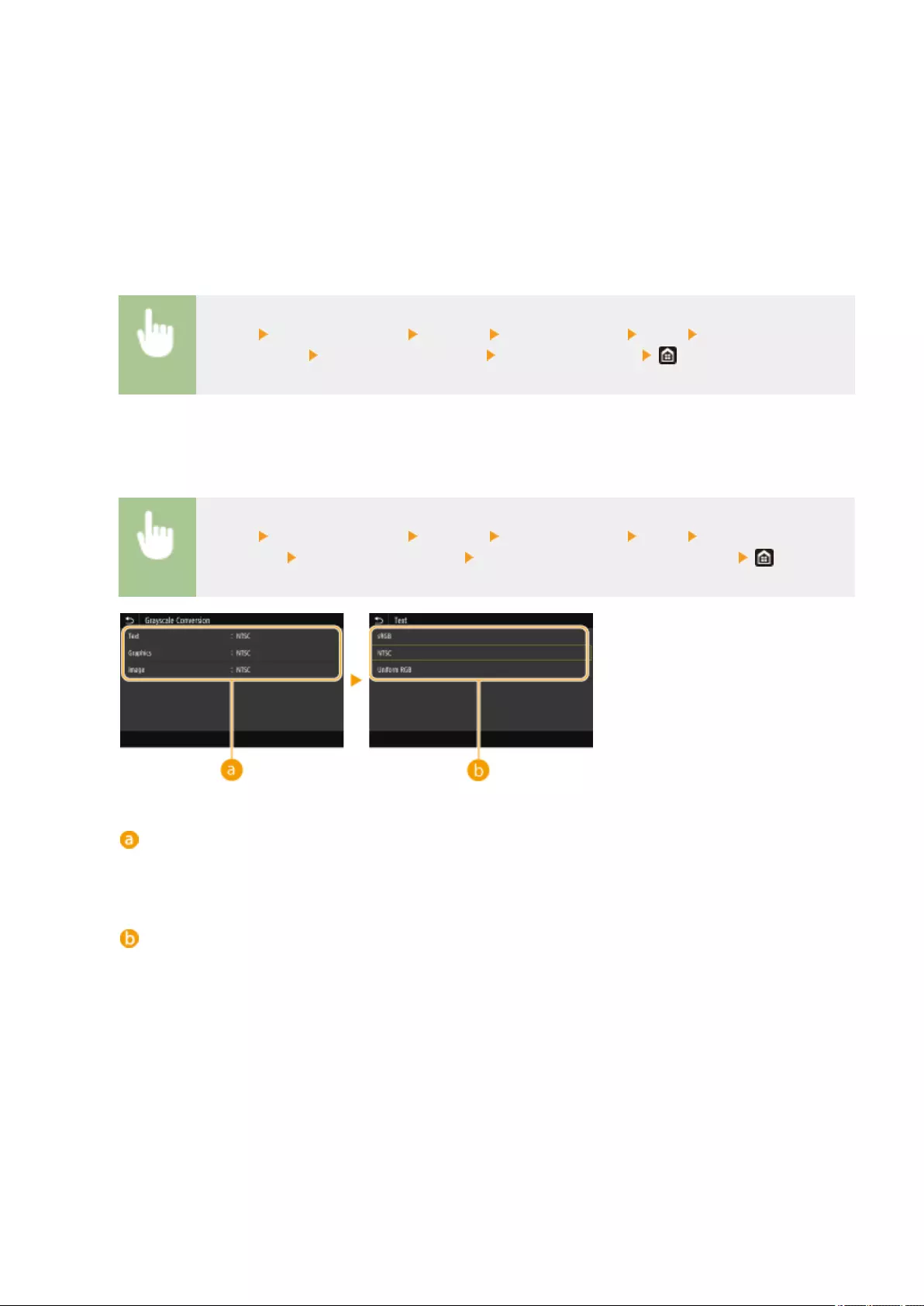
<Colorimetric>
Minimizes a color variance that occurs when RGB data is converted to CMYK data.
<Vivid Photo>
Performs processing so that the color tone is deeper and more vivid than <General>.
<Gray Compensation>
Congures a setting so that black or gray data of which color information is "R = G = B" is printed using only
the BK (black) ink. If <Off> is selected, data is printed using the ink of four colors: CMYK. This option can be
specied for each image type in any one document.
<Menu> <Function Settings> <Printer> <Printer Settings> <XPS> <Gray
Compensation> Select the type of image Select <Off> or <On>
<Grayscale Conversion>
Specify the way of printing color data in black and white.
<Menu> <Function Settings> <Printer> <Printer Settings> <XPS> <Grayscale
Conversion> Select the type of image Select the type of grayscale conversion
Type of image
Select the object for which to change the setting. <Text> represents letters and characters, <Graphics>
represents lines and gures, and <Image> represents photos and images.
Type of grayscale conversion
<sRGB>
Prints in black and white with emphasis on color differences so that a smooth gradation is achieved.
<NTSC>
Prints in black and white so that the resulting image looks like a black and white television picture (of the
NTSC system).
<Uniform RGB>
Prints in black and white so that R, G, and B are uniformly converted to the same gray level by using only
brightness as the reference.
<Paper Save>
Specify whether to disable a blank page in print data from being output.
Setting Menu List
482
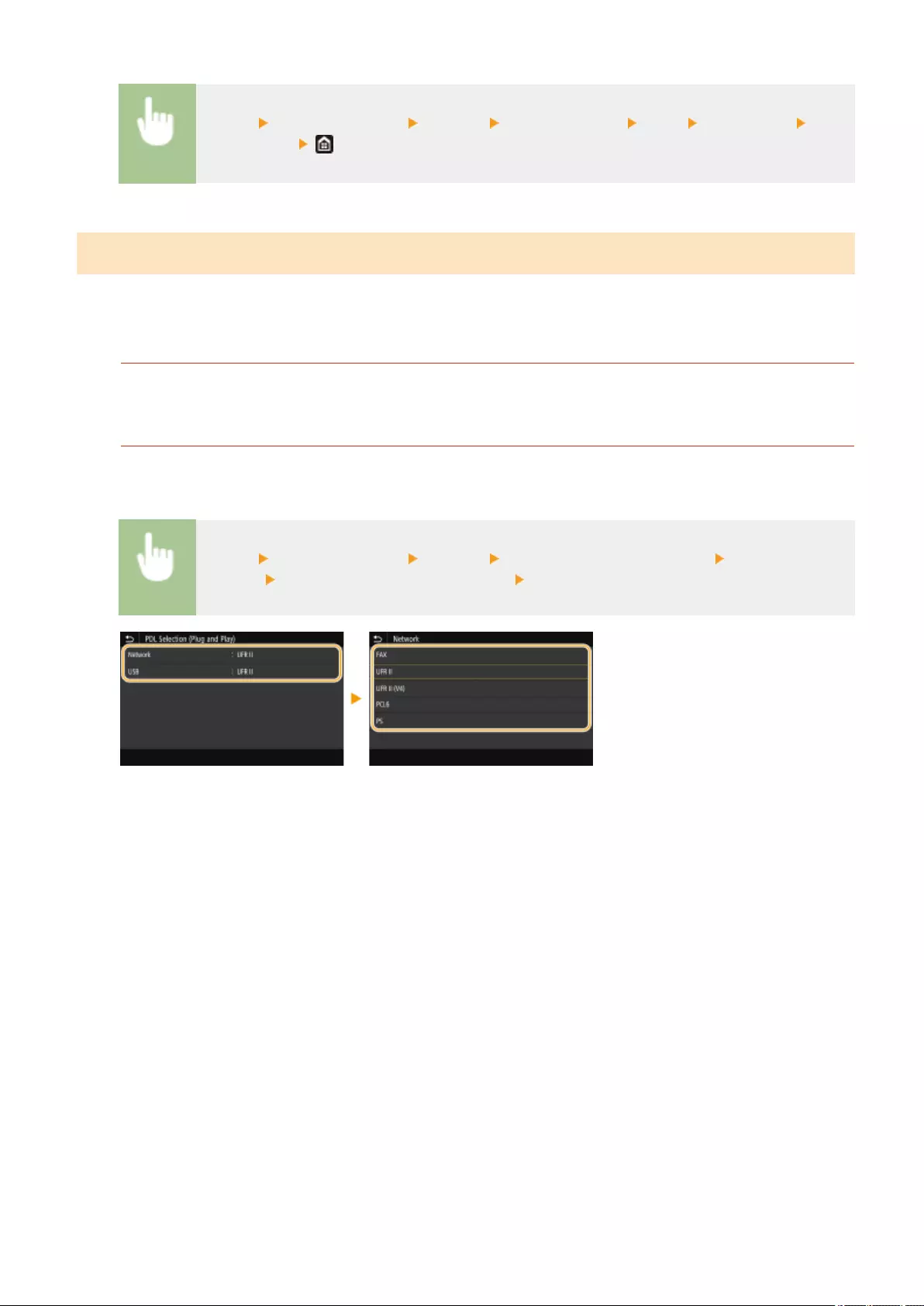
<Menu> <Function Settings> <Printer> <Printer Settings> <XPS> <Paper Save> Select
<Off> or <On>
<PDL Selection (Plug and Play)>
Select a page description language so that the machine is detected as a printer that is compatible with that language
when it is connected to a computer by using Plug and Play.
<Network> *2
Select a page description language so that the machine is detected as a printer that is compatible with that
language when it is detected over the network.
<USB>
Select a page description language so that the machine is detected as a printer that is compatible with that
language when it is connected to a computer via USB.
<Menu> <Function Settings> <Printer> <PDL Selection (Plug and Play)> Select <Network>
or <USB> Select a page description language Restart the machine
<FAX>
Detects and connects the machine as a fax device.
<UFR II>
Detects and connects the machine as a UFR II printer.
<UFR II (V4)>
Detects and connects the machine as a UFR II printer that is compatible with XML Paper Specication (XPS).
<PCL6>
Detects and connects the machine as a PCL6 printer.
<PCL6 (V4)>
Detects and connects the machine as a UFR II printer that is compatible with XML Paper Specication (XPS).
<PS>
Detects and connects the machine as a PS printer.
Setting Menu List
483
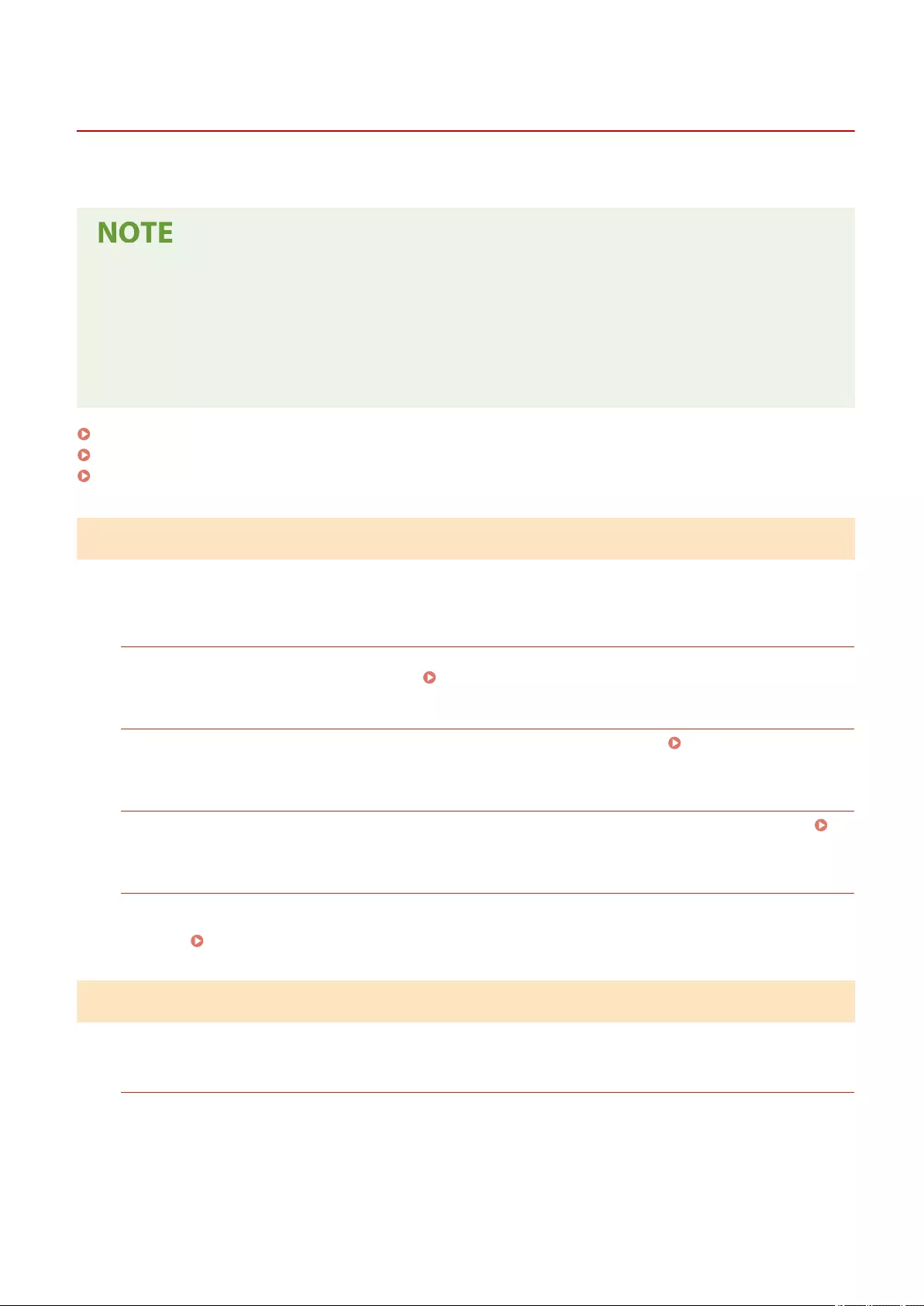
<Send>
2579-0FY
All the settings related to sending faxes or scanned originals are listed with descriptions.
Asterisks (*)
●Settings marked with "*1" may not be displayed depending on the model you are using, options, or other
setting items.
●Settings marked with "*2" may be unavailable or vary depending on your country or region.
●Settings marked with "*3" cannot be imported or exported.
<Common Settings>(P. 484)
<Scan and Send Settings>(P. 484)
<Fax Settings>(P. 485)
<Common Settings>
Specify the conrmation method used to restrict destinations at the time of sending faxes, e-mails, or I-Faxes or to
prevent transmission errors.
<Restrict New Destinations>
Select whether to limit the fax numbers and e-mail/I-Fax addresses that can be specied as destinations to
those already registered in the Address Book. Restricting New Destinations that Can Be Specied(P. 396)
<Restrict Resending from Log>
Select whether to prevent a destination from being selected from the sent job logs. Disabling Use of
Previously Used Destinations(P. 396)
<Conrm When Coded Dial TX>
Select whether to display the details of an entered coded dial number when it is selected as a destination.
Displaying Destinations in Address Book(P. 396)
<Conrm Dest. Before Sending>
Specify whether to display the destination conrmation screen when sending faxes, e-mails, or I-Faxes. If <Only
for Sequential Broadcast> is selected, the conrmation screen is displayed only when multiple destinations are
specied. Checking Destinations when Sending Data(P. 397)
<Scan and Send Settings>
You can change and register the settings for sending e-mails or I-Faxes documents.
<Register Unit Name>
Register the sender name for e-mails and I-Faxes. The registered name is displayed in e-mails, along with the e-
mail address. If the sender name is not registered, only the e-mail address is displayed.
Setting Menu List
484

<Menu> <Function Settings> <Send> <Scan and Send Settings> <Register Unit
Name> Enter the sender name <Apply>
<E-Mail Settings>
Change the default settings used for scanning originals to send as e-mails.
<Change Default Settings (E-Mail)>
Specify settings used for scanning originals to send as e-mails. The selected settings are used as the default
settings when scanning originals. Changing the Default Settings for Functions(P. 175)
<I-Fax Settings>
Specify the basic settings for using the machine as a I-Fax device.
<Change Default Settings (I-Fax)>
You can change the default settings used for sending I-Fax. The selected settings are used as the default
settings when scanning originals. Changing the Default Settings for Functions(P. 175)
<TX Terminal ID>
Information such as the date and time of transmission and the e-mail address of the machine (sender
information) can be added as a header in transmitted documents. This information tells the recipient when
the I-Fax was sent and who sent it. Depending on your country or region, the operation may differ.
<Menu> <Function Settings> <Send> <Scan and Send Settings> <I-Fax Settings> <TX
Terminal ID> Select <On> in <Add TX Terminal ID> <Print Position> Select <Inside Image
Area> or <Outside Image Area> <Apply>
<File Settings>
Change the default settings used when originals are saved to a shared folder or FTP server.
<Change Default Settings (File)>
You can change the default settings used when originals are saved to a shared folder or FTP server. The
selected settings are used as the default settings when scanning. Changing the Default Settings for
Functions(P. 175)
<Fax Settings> *1
Specify the basic settings for using the machine as a fax device.
<Change Default Settings (Fax)>
Specify settings used for sending faxes. The selected settings are used as the default settings when scanning
originals. Changing the Default Settings for Functions(P. 175)
<Off-Hook Alarm>
Select whether the machine makes an alert sound when the handset of a telephone connected to the machine
is not properly set on the cradle. You can also adjust the volume of the alert sound.
Setting Menu List
485
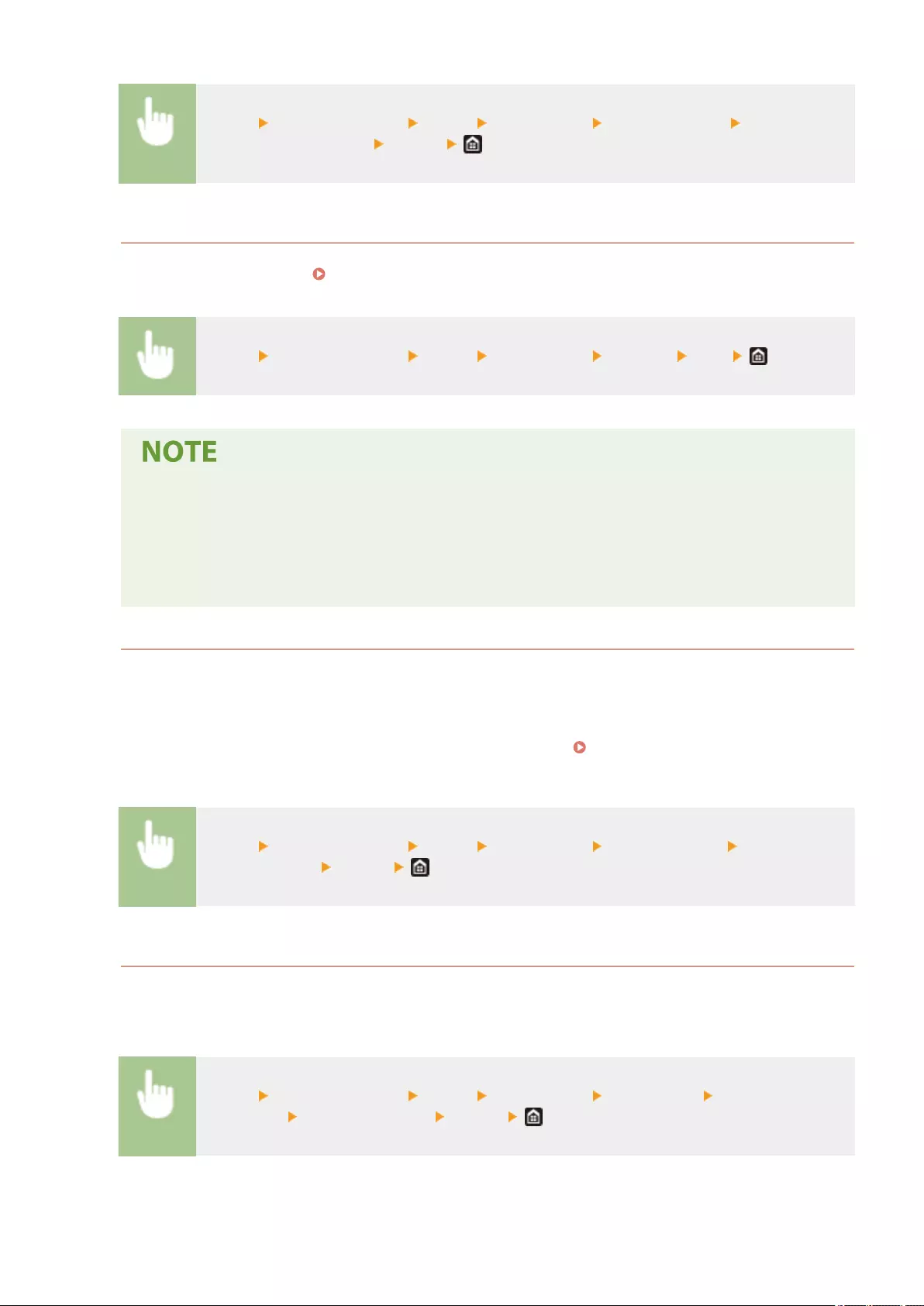
<Menu> <Function Settings> <Send> <Fax Settings> <Off-Hook Alarm> Select the
volume of the alert sound <Apply>
<ECM TX>
Enable or disable error correction mode (ECM). ECM checks for fax data errors and corrects them. To reduce
errors on received faxes, see <ECM RX>(P. 491) .
<Menu> <Function Settings> <Send> <Fax Settings> <ECM TX> <On>
●ECM must be enabled on both the machine and the other fax device because error checks are
performed on both the sending and receiving devices.
●Even when ECM is enabled, errors may occur due to telephone line conditions.
●It may take a longer time than usual to process data when ECM is enabled because the error checks
and corrections are performed while the data is transmitted.
<Set Pause Time>
For example, when you make calls by dialing "0 - (pause) - (telephone number)," 0 is dialed rst and then a few
seconds later, the telephone number. When sending faxes overseas, you need to specify destinations by dialing
"(international access code) - (country code) - (area code) - (fax number)" but consecutive numbers that are
input without pauses may not be recognized correctly. In this case, try adding a pause after the international
access code or the fax number. If the code or the number is still not recognized correctly, change the duration
of the pause. For instructions on how to enter a pause, see step 4 on Basic Operations for Sending
Faxes(P. 220) .
<Menu> <Function Settings> <Send> <Fax Settings> <Set Pause Time> Specify the
duration of pause <Apply>
<Auto Redial>
Specify settings for Auto Redial, a function that automatically redials the fax number after several minutes if the
rst attempt fails because the line is busy. You can specify how many times the machine redials and the interval
between redials.
<Menu> <Function Settings> <Send> <Fax Settings> <Auto Redial> Select <On> in <Use
Auto Redial> Specify the settings <Apply>
Setting Menu List
486
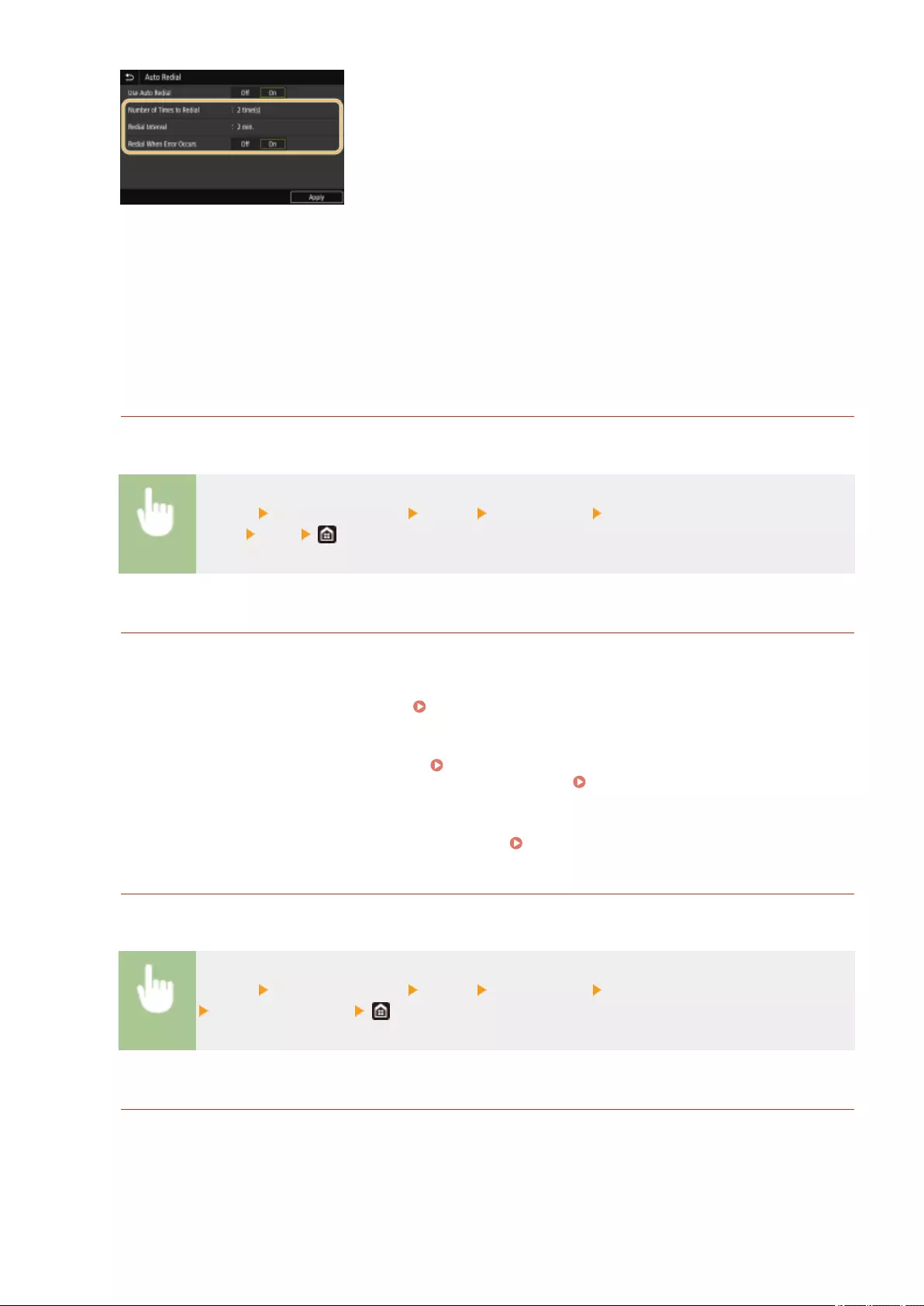
<Number of Times to Redial>
Species how many times the machine redials. Enter a number, and select <Apply>.
<Redial Interval>
Species the interval between redials. Enter a number for the interval, and select <Apply>.
<Redial When Error Occurs>
When set to <On>, species to redial when a transmission error occurs.
<Check Dial Tone Before Send> *2
Select whether to check the dial tone before a fax number is dialed.
<Menu> <Function Settings> <Send> <Fax Settings> <Check Dial Tone Before
Send> <On>
<Set Line>
Specify a fax number, unit name, and line type.
<Register Unit Telephone Number>
Register the fax number for the machine. Registering the Fax Number and Unit Name(P. 84)
<Register Unit Name>
Register the name of a company or person ( Registering the Fax Number and Unit Name(P. 84) ). The
registered name is sent as sender information to the destination ( <TX Terminal ID>(P. 489) ).
<Select Line Type>
Select the telephone line type used for fax transmission. Connecting the Telephone Line(P. 86)
<Rotate Img to Send(Long Edge)>
Select whether to rotate the original that is set sideways by 90 degrees and send automatically.
<Menu> <Function Settings> <Send> <Fax Settings> <Rotate Img to Send(Long Edge)>
Select <Off> or <On>
<TX Start Speed>
If it takes time to start sending originals, such as when there is a poor connection, you can adjust the
transmission start speed downward incrementally.
Setting Menu List
487
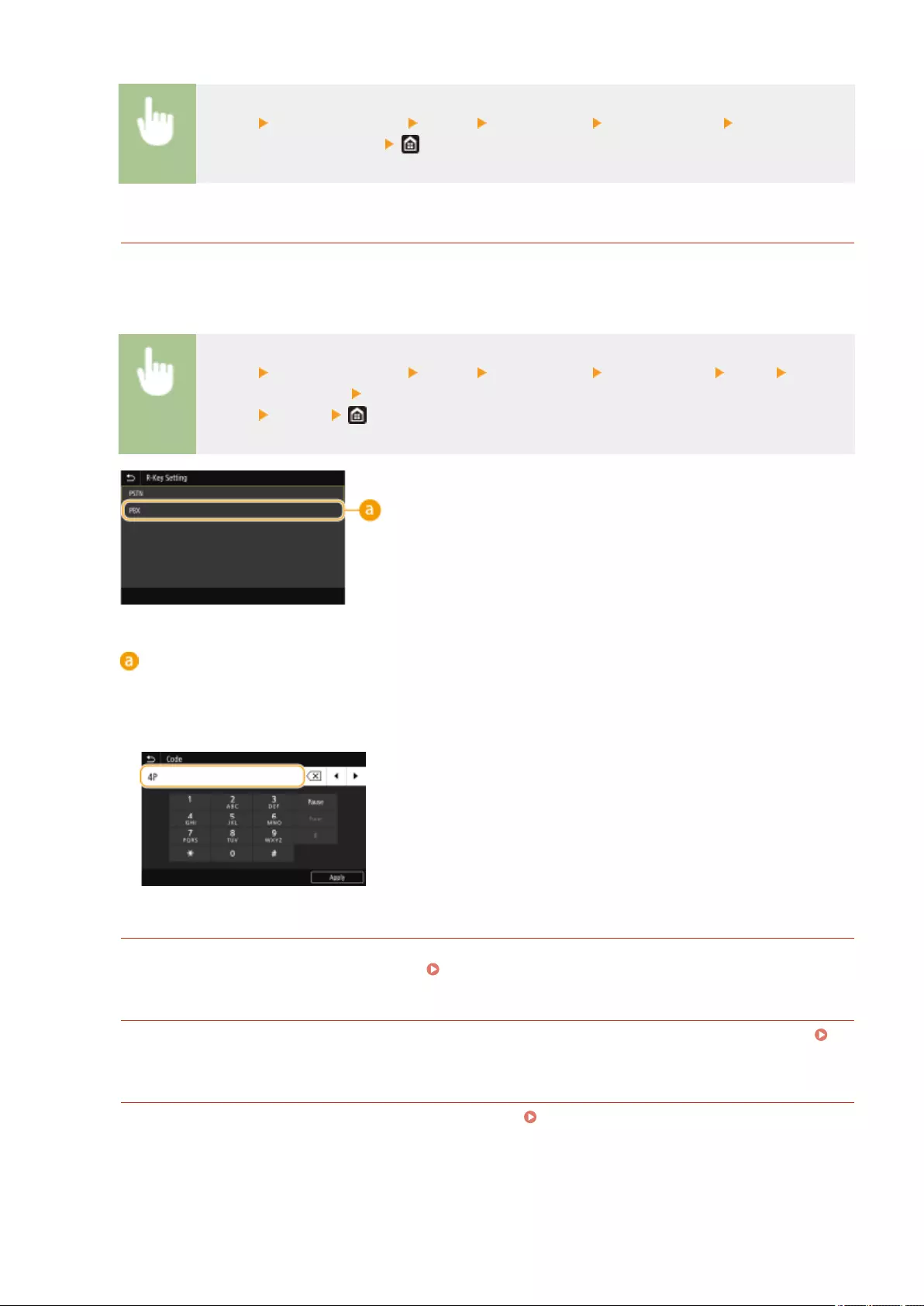
<Menu> <Function Settings> <Send> <Fax Settings> <TX Start Speed> Select a
communication start speed
<R-Key Setting>
If your machine is connected through a PBX (Private Branch Exchange), it is necessary to set the access method.
If you set it to <PBX>, the <R> key will be displayed on the Fax Basic Features screen. If you assign an outside
line access number to the <R> key, you can easily access the outside line.
<Menu> <Function Settings> <Send> <Fax Settings> <R-Key Setting> <PBX> Select
<Prex> or <Hooking> Enter an outside line access number if you select
<Prex> <Apply>
<PBX>
Select <PBX> when you want the machine to be connected through a PBX (Private Branch Exchange). Set the
function of the <R> key displayed on the Fax Basic Features screen to <Prex> or <Hooking>. If you select
<Prex>, register the prex code on the next screen. Enter the prex code using the numeric keys, select
<Pause>, and then select <Apply>. If you do not insert a pause, the prex code is not registered.
<Archive TX Document> *3
In addition to the destination specied when the fax is sent, you can specify whether faxed documents are also
sent to a preset storage address for archiving. Saving a Copy of a Sent Original(P. 239)
<Conrm Entered Fax Number>
Select whether to display the details of an entered coded dial number when it is selected as a destination.
Conrming the Entered Fax Number(P. 398)
<Allow Fax Driver TX>
Enable or disable PC faxing (sending faxes from a computer). Restricting Fax Sending from a
Computer(P. 398)
Setting Menu List
488

<Restrict Sequential Broadcast>
Select whether to prohibit sequential broadcasting, a feature that sends faxes to multiple destinations in
succession. Restricting Sequential Broadcasts(P. 398)
<TX Terminal ID>
Specify settings for adding the sender information, including the fax number and the name of the machine, to
the fax header. The recipient can check who sent the fax by looking at the added information.
<Menu> <Function Settings> <Send> <Fax Settings> <TX Terminal ID> Select <On>in
<Add TX Terminal ID> Specify the settings <Apply>
<Print Position>
Species the position to print the terminal ID information in the sent fax. Select <Inside Image Area> to print
the information inside the image area, or <Outside Image Area> to print the information outside the image
area.
<Mark Number As>
Adds the "Fax" or "Tel" mark in front of the fax number registered for the machine ( Registering the Fax
Number and Unit Name(P. 84) ). Select <Tel> to indicate that the notied number is a telephone number.
Setting Menu List
489
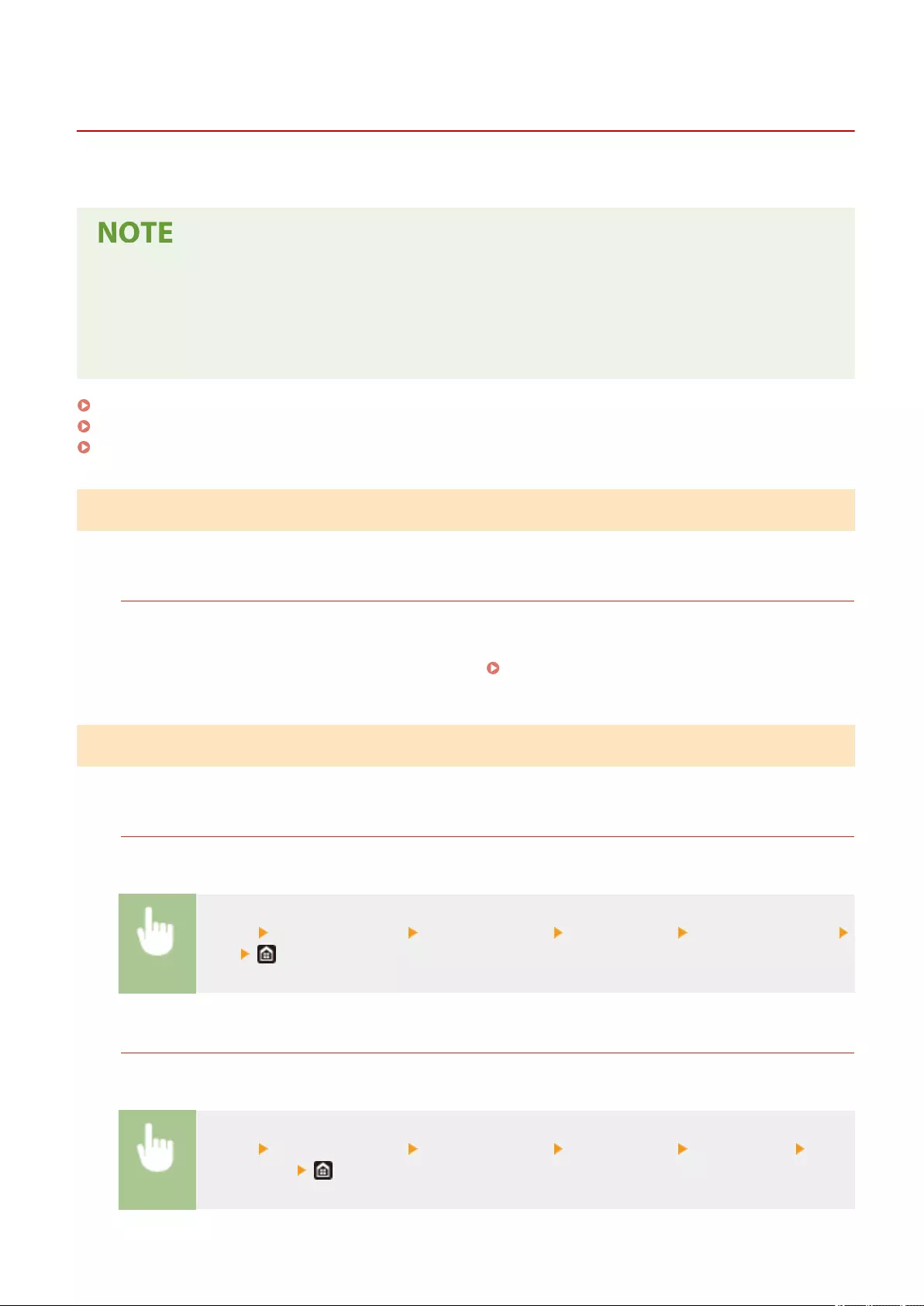
<Receive/Forward>
2579-0H0
All the settings related to receiving of faxes and e-mails are listed with descriptions.
Asterisks (*)
●Settings marked with "*1" may not be displayed depending on the model you are using, options, or other
setting items.
●Settings marked with "*2" cannot be imported or exported.
<Common Settings>(P. 490)
<I-Fax Settings>(P. 490)
<Fax Settings>(P. 491)
<Common Settings>
Congure settings for receiving faxes in memory.
<Set Fax/I-Fax Inbox>
<Fax Memory Lock Settings>
Select whether to store received faxes without immediately printing them. Stored fax documents can be
printed at any time by changing the setting to <Off>. Saving Received Documents into the Machine
(Memory Reception)(P. 241)
<I-Fax Settings>
Congure settings to print received I-Fax documents.
<Print on Both Sides>
Specify settings for printing received document on both sides of paper.
<Menu> <Function Settings> <Receive/Forward> <I-Fax Settings> <Print on Both Sides>
<On>
<RX Print Size>
Specify the paper size to be used for printing.
<Menu> <Function Settings> <Receive/Forward> <I-Fax Settings> <RX Print Size> Select
the paper size
Setting Menu List
490

<Fax Settings> *1
Congure settings for receiving and forwarding faxes.
<Print on Both Sides>
Prints received document on both sides of paper.
<Menu> <Function Settings> <Receive/Forward> <Fax Settings> <Print on Both
Sides> <On>
<Select Drawer>
You can set how the machine prints documents when there is no paper matching the size of the received
document.
<Menu> <Function Settings> <Receive/Forward> <Fax Settings> <Select
Drawer> Specify the setting item <Apply>
<ECM RX>
Enable or disable error correction mode (ECM). ECM checks for fax data errors and corrects them. To reduce
errors on sent faxes, see <ECM TX>(P. 486) .
<Menu> <Function Settings> <Receive/Forward> <Fax Settings> <ECM RX> <On>
●ECM must be enabled on both the machine and the other fax device because error check is
performed on both the sending and receiving devices.
●Even when ECM is enabled, errors may occur due to telephone line conditions.
●It may take a longer time than usual to process data when ECM is enabled because the error check
and corrections are performed while the data is transmitted.
<Incoming Ring>
Specify settings for sounding a ring to notify you of incoming faxes. This feature is only available when <Auto>
or <Fax/Tel (Auto Switch)> is selected for the receive mode. Specify how many times the incoming call rings
when the machine receives a fax call. You can also disable the settings to prevent the incoming call from
ringing.
Setting Menu List
491

<Menu> <Function Settings> <Receive/Forward> <Fax Settings> <Incoming Ring> Select
<On> in <Use Incoming Ring> Enter the desired number in <Number of Rings> <Apply>
●When <On> is specied, you need to connect your telephone to the machine beforehand.
●When <Off> is specied, the machine does not enter sleep mode.
<Remote RX>
Specify settings for receiving a fax by operating a telephone that is connected to the machine (Remote
Reception). When a fax is sent to the machine, you can receive it just by picking up the handset of the telephone
and entering a specic ID number by using the telephone. This feature can save you the trouble of going all the
way to the machine. For instructions on how to use Remote Reception, see Using a Telephone to Receive
Faxes (Remote Reception)(P. 232) .
<Menu> <Function Settings> <Receive/Forward> <Fax Settings> <Remote RX> Select
<On> in <Use Remote RX> Enter the ID number in <Remote RX ID> <Apply>
<Switch to Auto RX>
Specify settings for automatically receiving a fax after the machine has rung for a specied time period. This
feature is only available when <Manual> is selected for the receive mode. By using this feature, faxes can be
received even when no one is available to pick up the handset.
<Menu> <Function Settings> <Receive/Forward> <Fax Settings> <Switch to Auto
RX> Select <On> in <Use Switch to Auto RX> Enter the desired number of seconds in <Ring
Time Until Auto RX> <Apply>
<RX Start Speed>
If it takes time to start receiving documents, such as when there is a poor connection, you can adjust the
transmission start speed downward incrementally.
<Menu> <Function Settings> <Receive/Forward> <Fax Settings> <RX Start Speed> Select
a communication start speed
<Use Reduce RX Size>
Specify settings for reducing the image size of a received document. You can select an automatic reduction ratio
that reduces the received document to size of the loaded paper. You can also select a ratio from a list.
Setting Menu List
492
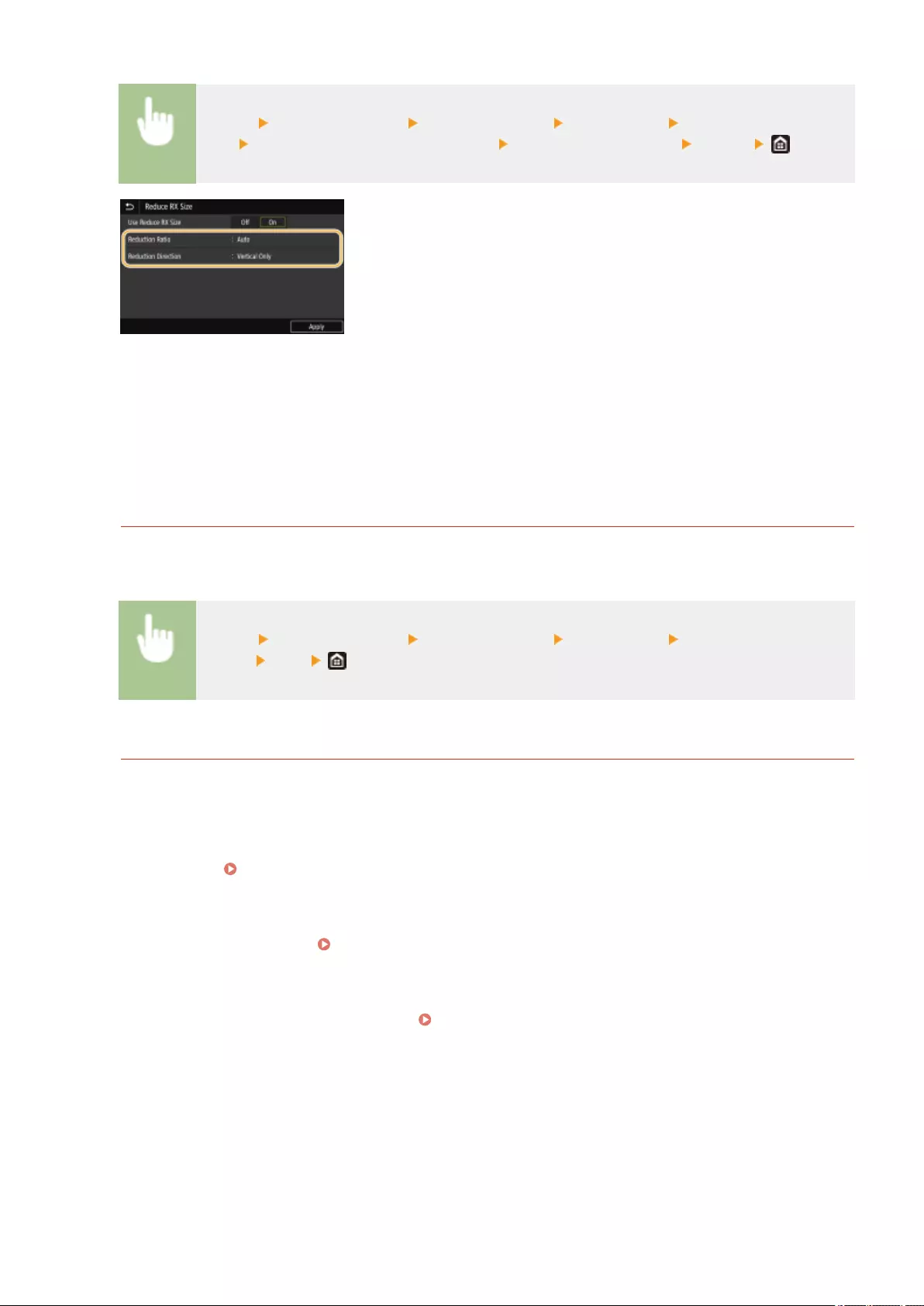
<Menu> <Function Settings> <Receive/Forward> <Fax Settings> <Use Reduce RX
Size> Select <On> in <Use Reduce RX Size> Specify each setting item <Apply>
<Reduction Ratio>
<Auto> reduces the image by a ratio that is based on the size of the loaded paper. <97%>, <95%>, <90%>, or
<75%> reduce the image by the corresponding ratio.
<Reduction Direction>
Select <Vertical/Horizontal> to reduce the image both vertically and horizontally. Select <Vertical Only> to
reduce only vertically.
<Print RX Page Footer>
Select whether to print information, including date and time of reception and page numbers, on the bottom of
received faxes.
<Menu> <Function Settings> <Receive/Forward> <Fax Settings> <Print RX Page
Footer> <On>
<Forwarding Settings>
Specify settings for forwarding faxes.
<Forwarding Function> *2
Select whether to forward all the received fax documents to a specied destination. In addition to a fax
number, you can also specify an e-mail address or a shared folder in a computer, etc. as the forwarding
destination. Forwarding the Received Documents Automatically(P. 243)
<Print Images>
Select whether to print forwarded fax documents. You can set the machine to print forwarded documents
only when an error occurs. Printing Documents to be Forwarded(P. 243)
<Store Images in Memory>
Select whether to store fax documents in memory when they are not successfully forwarded. You can resend
or print the documents later as necessary. Printing/Resending/Deleting Documents that Failed to be
Forwarded(P. 243)
Setting Menu List
493

<Store/Access Files>
2579-0H1
All the settings related to saving the scanned document to a USB memory device or printing stored les are listed with
descriptions.
<Common Settings>(P. 494)
<Memory Media Settings>(P. 495)
<Common Settings>
Congure the default settings for le saving and memory media print.
<Scan and Store Settings>
Congure settings for saving the scanned document to a USB memory device or le.
<USB Memory Settings>
You can change and register the settings used when data is saved to a USB memory device.
<Change Default Settings (USB Memory)>
Specify settings used for saving scanned originals to a USB memory device. The selected settings are used
as the default settings when scanning originals. Changing the Default Settings for Functions(P. 175)
<Access Stored Files Settings>
You can change the settings to print les in a USB memory device and the method for displaying them.
<Change Default Settings (Memory Media Print)>
You can change the default settings associated with memory media print. The settings congured here are
used as the default settings of the memory media print function. Changing the Default Settings for
Functions(P. 175)
<Default Display Settings>
Select Preview/Details as the method for displaying les in a USB memory device.
<Menu> <Function Settings> <Store/Access Files> <Common Settings> <Access Stored
Files Settings> <Default Display Settings> Select the method for displaying
<Preview>
Displays a preview image.
<Details>
Displays le names and dates in list form.
<File Sort Default Settings>
Select whether to display les in a USB memory device in ascending or descending order of le name or date.
Setting Menu List
494
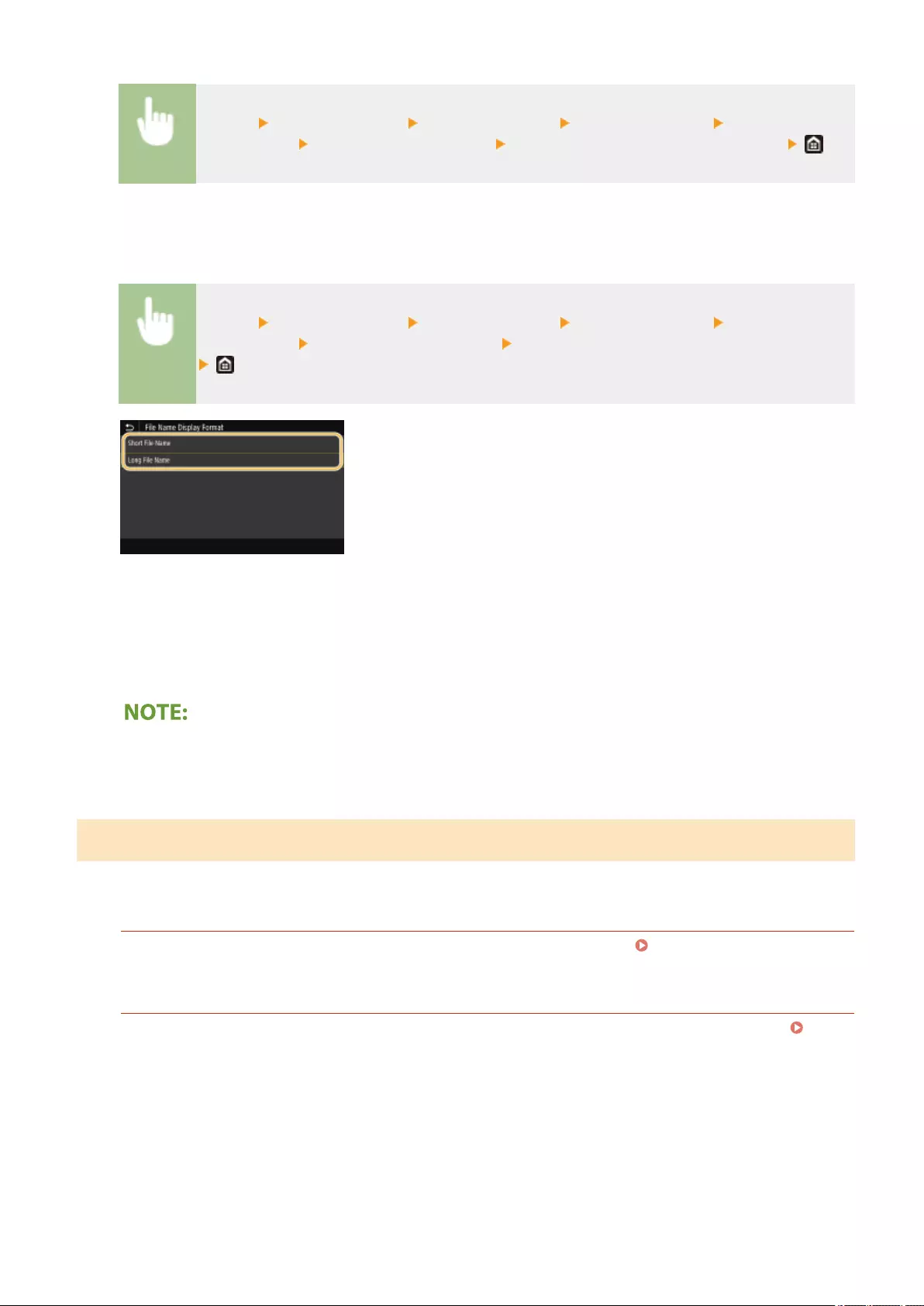
<Menu> <Function Settings> <Store/Access Files> <Common Settings> <Access Stored
Files Settings> <File Sort Default Settings> Select the order of les that are displayed
<File Name Display Format>
Select whether to display short or long text for le names that are stored in a USB memory device.
<Menu> <Function Settings> <Store/Access Files> <Common Settings> <Access Stored
Files Settings> <File Name Display Format> Select <Short File Name> or <Long File Name>
<Short File Name>
Shortens a le name to as few as eight characters. To distinguish les that have similar names, numbers such as
"~1" or "~2" are added at the end of the le names.
<Long File Name>
Displays a le name up to 20 characters.
●The number of characters described above does not include the characters in le extensions, such as ".jpg."
<Memory Media Settings>
Specify whether to enable or disable the functions of a USB memory device.
<Use Scan Function>
Select whether to permit storing scanned originals into a USB memory device. Restricting the Scan to USB
Function(P. 401)
<Use Print Function>
Select whether to permit printing data from a USB memory device when it is attached to the machine.
Restricting the USB Print Function(P. 401)
Setting Menu List
495
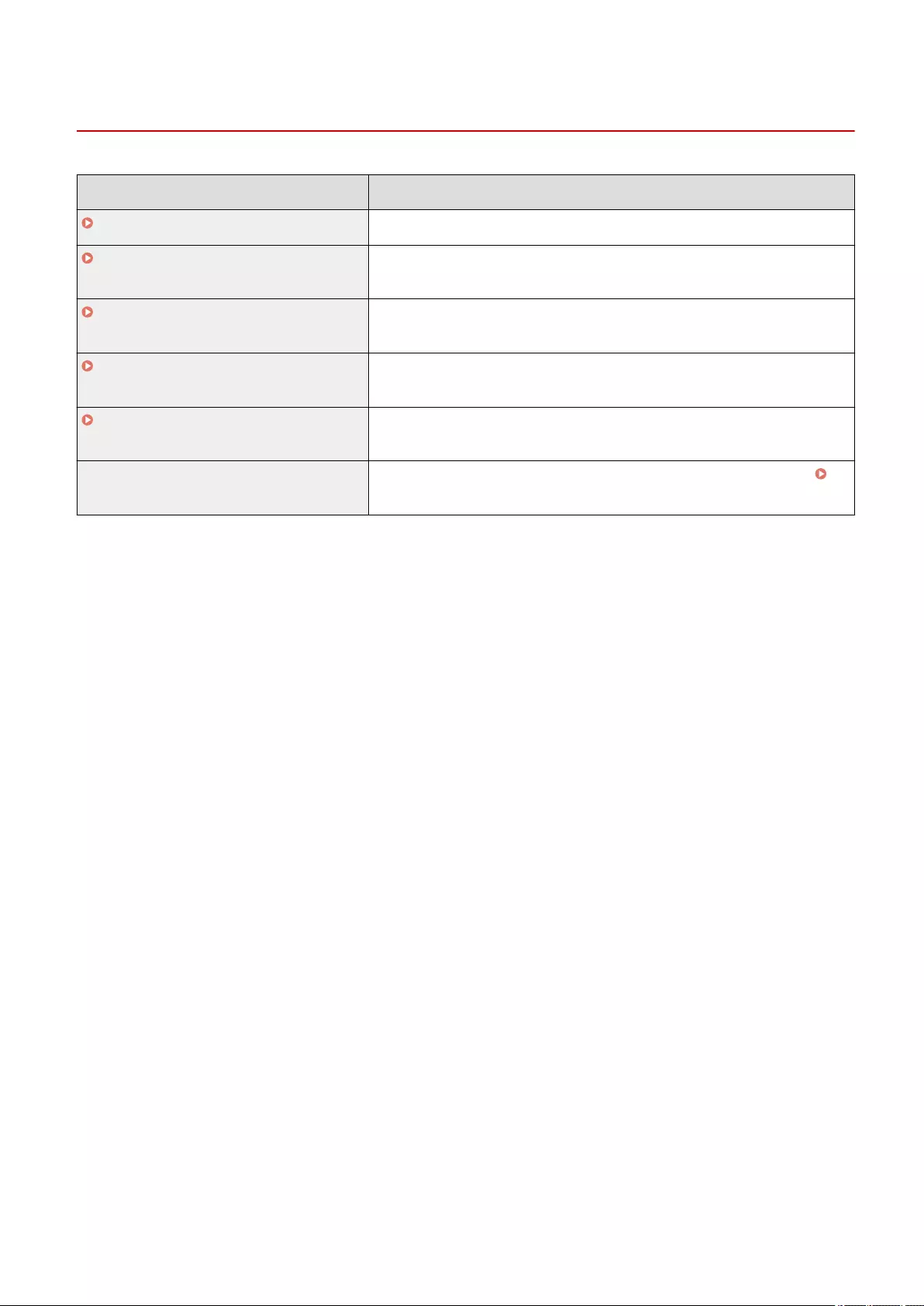
<Management Settings>
2579-0H2
Item Description
<User Management>(P. 499) You can congure the settings for managing users of the machine.
<Device Management>(P. 500) You can manage information about the hardware and operations, as well as
various data required when using the machine functions.
<Remote UI Settings/Update
Firmware>(P. 502)
You can congure the settings related to the remote UI and the software
available for the machine.
<Data Management>(P. 503) You can congure settings to utilize the machine settings or data, or format the
data.
<Security Settings>(P. 505) You can congure the settings related to the user authentication function,
password, and encryption.
<Initialize All Data/Settings> Restores all data including logs and setting values to their default settings.
Initializing All Data/Settings(P. 429)
Setting Menu List
498

<User Management>
2579-095
All the settings related to user management of the machine are listed with descriptions.
<System Manager Information Settings>(P. 499)
<Department ID Management>(P. 499)
<System Manager Information Settings>
Specify the ID or PIN exclusively for Administrators who have access privileges to <Network> and <Management
Settings>. ID is <System Manager ID> and PIN is <System Manager PIN>. You can also register the name of an
Administrator. Setting the System Manager ID and PIN(P. 344)
<System Manager ID and PIN>
Enter a number for the System Manager ID and PIN.
<System Manager Name>
Enter alphanumeric characters for the name of an Administrator.
<Department ID Management>
Select whether to use the Department ID Management, a feature that uses IDs as user accounts to specify access
privileges and maintain information on how the machine is used. Setting the Department ID
Management(P. 346)
<Menu> <Management Settings> <User Management> <Department ID
Management> Select <Off> or <On>
Setting Menu List
499
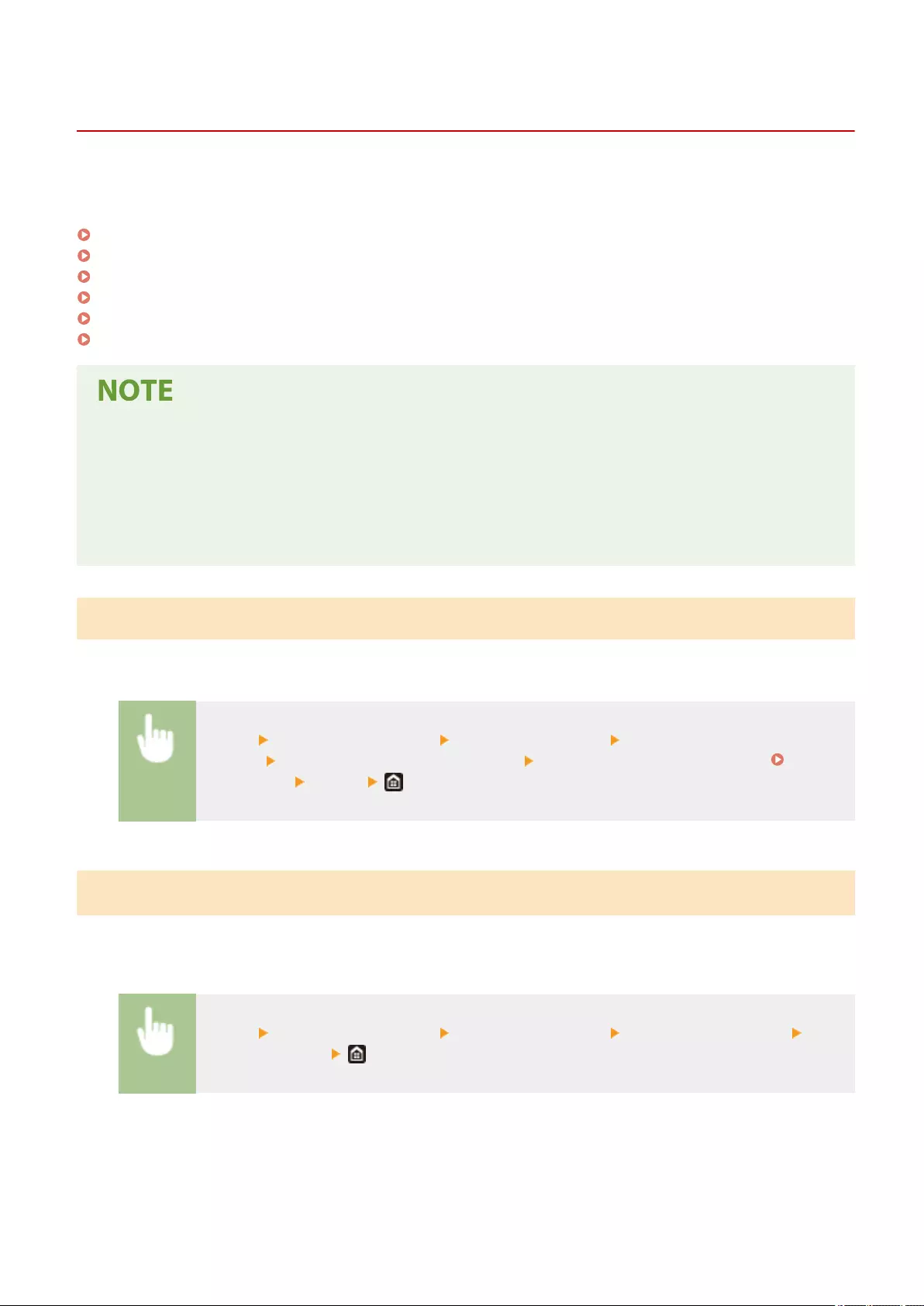
<Device Management>
2579-096
All the settings related to management of information for the hardware and operations, as well as about management
of data required when using the machine functions are listed with descriptions.
<Device Information Settings>(P. 500)
<Select Country/Region>(P. 500)
<Display Job Log>(P. 501)
<Use NFC>(P. 501)
<Scan w/ Canon PRINT Business>(P. 501)
<Quiet Mode>(P. 501)
Asterisks (*)
●Settings marked with "*1" cannot be imported or exported.
●Settings marked with "*2" may be unavailable or vary depending on your country or region.
●Settings marked with "*3" may not be displayed depending on the model you are using, options, or other
setting items
<Device Information Settings>
Enter alphanumeric characters for the name and the installation location to identify the machine.
<Menu> <Management Settings> <Device Management> <Device Information
Settings> Select <Device Name> or <Location> Enter the device name or location ( Entering
Text(P. 129) ) <Apply>
<Select Country/Region> *1 *2
Specify the country or region where the machine is used. The default setting may vary depending on the setting
selected at initial power-on.
<Menu> <Management Settings> <Device Management> <Select Country/Region> Select
a country or region
Setting Menu List
500
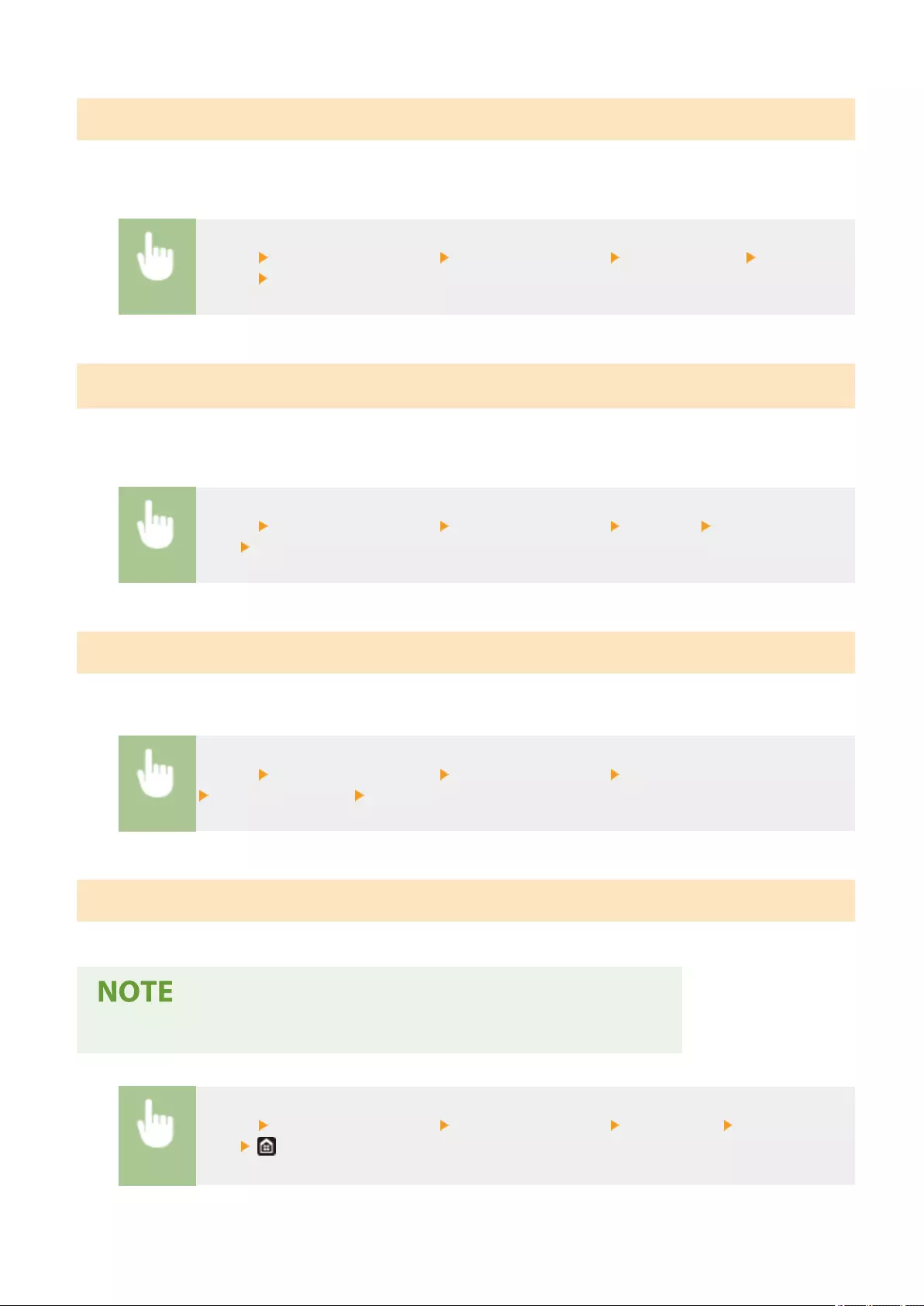
<Display Job Log>
Select whether to display the copying, printing, faxing, and scanning logs on the display of the machine and in the
Communication Management Report.
<Menu> <Management Settings> <Device Management> <Display Job Log> Select <Off>
or <On> Restart the machine
<Use NFC> *3
Select whether to allow printing by touching an NFC-capable mobile device to the NFC mark on the machine's
operation panel.
<Menu> <Management Settings> <Device Management> <Use NFC> Select <Off> or
<On> Restart the machine
<Scan w/ Canon PRINT Business>
Select whether to allow scanning from a mobile device using the Canon Print Business application.
<Menu> <Management Settings> <Device Management> <Scan w/ Canon PRINT Business>
Select <Off> or <On> Restart the machine
<Quiet Mode>
You can have the machine run more quietly when operation noise would be obtrusive.
When set to <On>, print speed and density may change depending on the paper type.
<Menu> <Management Settings> <Device Management> <Quiet Mode> Select <Off> or
<On>
Setting Menu List
501

<Remote UI Settings/Update Firmware>
2579-097
All the settings related to the software available for the machine as well as about Register License are listed with
descriptions.
<Remote UI Settings>(P. 502)
<Update Firmware>(P. 502)
Asterisks (*)
●Settings marked with "*" cannot be imported or exported.
<Remote UI Settings> *
Congure settings for using the Remote UI. Using the Remote UI allows you to congure machine settings from a Web
browser.
<Remote UI>
Select whether to use the Remote UI ( Disabling Remote UI(P. 404) ). When using Remote UI, you can also
specify whether to use the TLS encrypted communication ( Conguring the Key and Certicate for
TLS(P. 370) ).
<Menu> <Management Settings> <Remote UI Settings/Update Firmware> <Remote UI
Settings> <Remote UI> Select <On> in <Use Remote UI> Select <Off> or <On> in <Use TLS>
<Apply> Restart the machine
<Restrict Access>
Specify so that entry of a PIN is required for access to the Remote UI. Set a PIN of up to 7 digits. All users use a
common PIN. Setting a Remote UI PIN(P. 352)
<Menu> <Management Settings> <Remote UI Settings/Update Firmware> <Remote UI
Settings> <Restrict Access> <On> Enter the PIN <Apply> Enter the PIN (Conrm)
<Apply>
<Update Firmware> *
Select how to install the rmware update according to the environment of the machine. Updating the
Firmware(P. 426)
Setting Menu List
502
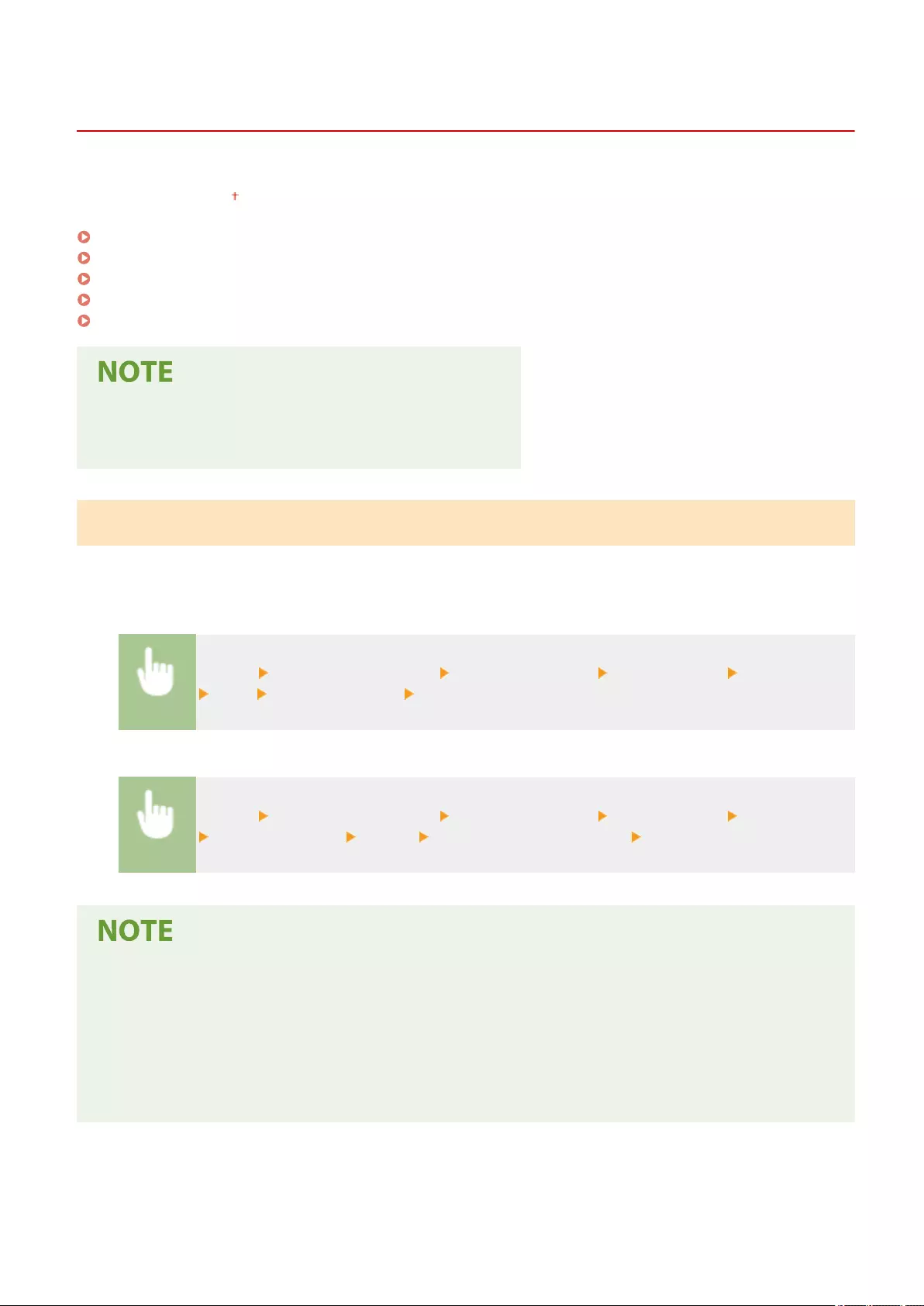
<Data Management>
2579-098
The settings for utilizing the machine settings and for initializing data are listed with descriptions. Default settings are
marked with a dagger ( ).
<Import/Export>(P. 503)
<Initialize Key and Certicate>(P. 504)
<Initialize Address Book>(P. 504)
<Initialize Menu>(P. 504)
<Device Info Sending Setting>(P. 504)
Asterisks (*)
●Settings marked with "*" cannot be imported or exported.
<Import/Export> *
You can use a USB memory device to import and export data in the Address Book and various settings of the machine.
Import
<Menu> <Management Settings> <Data Management> <Import/Export> <Import>
<Yes> Enter the password <Apply>
Export
<Menu> <Management Settings> <Data Management> <Import/Export> <Export>
Enter the password <Apply> Enter the password (Conrm) <Apply>
If the <Address Book PIN> screen appears
●If a PIN has been set for the Address Book, the <Address Book PIN> screen appears during importing/
exporting. Enter the Address Book PIN and select <Apply>. Select <Skip> to cancel Address Book data
importing/exporting.
When import is executed
●The machine automatically restarts after the import process has nished.
Setting Menu List
503

<Initialize Key and Certicate> *
Select to restore [Key and Certicate Settings] and [CA Certicate Settings] to the factory defaults. Initializing Key
and Certicate(P. 428)
<Initialize Address Book> *
Select to restore the Address Book settings to the factory defaults. Initializing Address Book(P. 429)
<Initialize Menu> *
Select to restore the settings listed below to the factory defaults. You can restore all the settings listed below at once,
or you can restore individual settings separately. Initializing Menu(P. 428)
<Device Info Sending Setting>
Selects whether you will send the printer usage information to Canon server.
<Menu> <Management Settings> <Data Management> <Device Info Sending Setting>
<Next> <Accept> or <Do Not Accept>
Setting Menu List
504
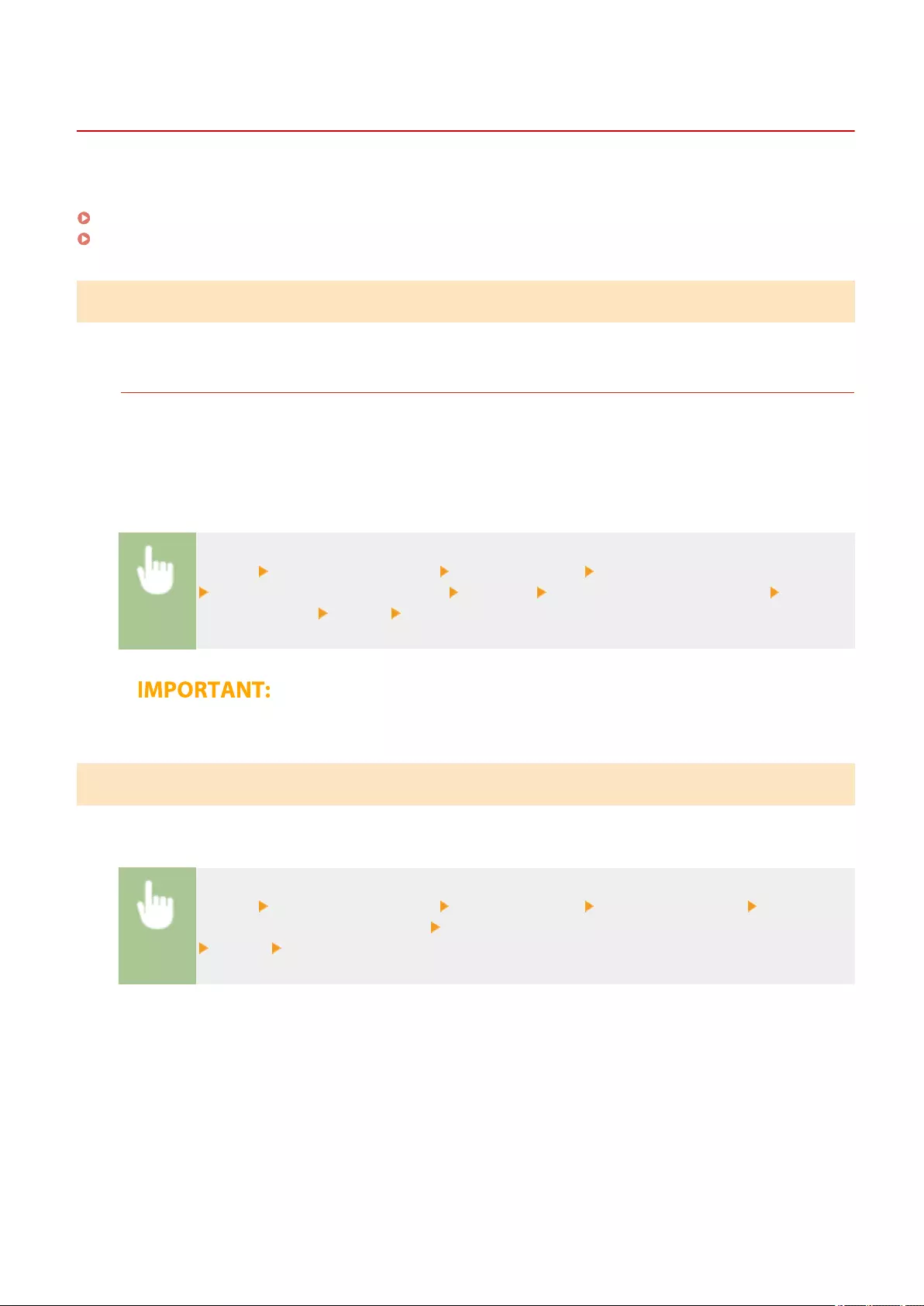
<Security Settings>
2579-099
All the settings related to the authentication function and encryption are listed with descriptions.
<Authentication/Password Settings>(P. 505)
<Encryption Settings>(P. 505)
<Authentication/Password Settings>
You can reinforce the security of the authentication function.
<Authentication Function Settings>
Congure the security functions for user authentication.
<Lockout>
When a user has failed user authentication, specify whether to disable the user from temporarily logging in
to the machine (lockout). When <On> is selected, specify how many consecutive times failures are permitted
before lockout is activated and also the time required before a user can log in again after lockout.
<Menu> <Management Settings> <Security Settings> <Authentication/Password Settings>
<Authentication Function Settings> <Lockout> Select <On> in <Enable Lockout> Specify
each setting item <Apply> Restart the machine
●This option is not applied to login using the department ID.
<Encryption Settings>
Congure a setting for disabling a weak encryption or the key and certication using a weak encryption.
<Menu> <Management Settings> <Security Settings> <Encryption Settings> Select <On>
in <Prohibit Use of Weak Encrypt.> Select <Off> or <On> in <Prohibit Weak Encryp. Key/Cert.>
<Apply> Restart the machine
Setting Menu List
505

Maintenance
Maintenance ..................................................................................................................................................... 508
Regular Cleaning ............................................................................................................................................... 510
Cleaning the Exterior .................................................................................................................................... 511
Cleaning the Platen Glass ............................................................................................................................. 512
Cleaning the Feeder ..................................................................................................................................... 514
Cleaning the Interior .................................................................................................................................... 518
Cleaning the Paper Path ........................................................................................................................ 519
Cleaning the Sensor Area ....................................................................................................................... 523
Cleaning the Print Head ......................................................................................................................... 526
Replacing the Ink Tanks .................................................................................................................................... 528
Replacing the Maintenance Cartridge ............................................................................................................. 532
Replacing the Print Head .................................................................................................................................. 536
Replacing the ADF Maintenance Kit ................................................................................................................. 545
Checking Remaining Amounts and Usage of Consumables ........................................................................... 549
Transporting the Machine ................................................................................................................................ 551
When Transporting the Machine on Casters Keeping It Level with the Ground ............................................ 553
When Machine May Tilt during Transport (No Long-Period Storage of 6 Months or More after Transport) .. 555
When Machine May Tilt during Transport (Long-Period Storage of 6 Months or More after Transport) ....... 564
Reinstalling the machine .................................................................................................................................. 573
Disposing of the Machine ................................................................................................................................. 576
Adjusting Image Quality ................................................................................................................................... 582
Diagnosing the Print Head ........................................................................................................................... 584
Checking the Condition of the Nozzles ......................................................................................................... 590
Adjusting Values for Text Color Reproducibility ............................................................................................ 593
Correcting Colors ......................................................................................................................................... 595
Correcting Colors in All Paper Types ...................................................................................................... 596
Correcting Colors for Each Paper Type .................................................................................................. 599
Manual (Visual Check) ............................................................................................................................ 602
Preventing Abrasion ..................................................................................................................................... 604
Aligning the Print Head ................................................................................................................................ 605
Adjusting the Density and Ink Drying Time .................................................................................................. 608
Adjusting Paper Curling after Printing .......................................................................................................... 610
Adjusting Margins ........................................................................................................................................ 612
Correcting Arching of Paper when Output ................................................................................................... 615
Maintenance
506

Correcting White Streaks .............................................................................................................................. 616
Viewing the Counter Value ............................................................................................................................... 619
Printing Reports and Lists ................................................................................................................................ 621
Consumables ..................................................................................................................................................... 625
Maintenance
507
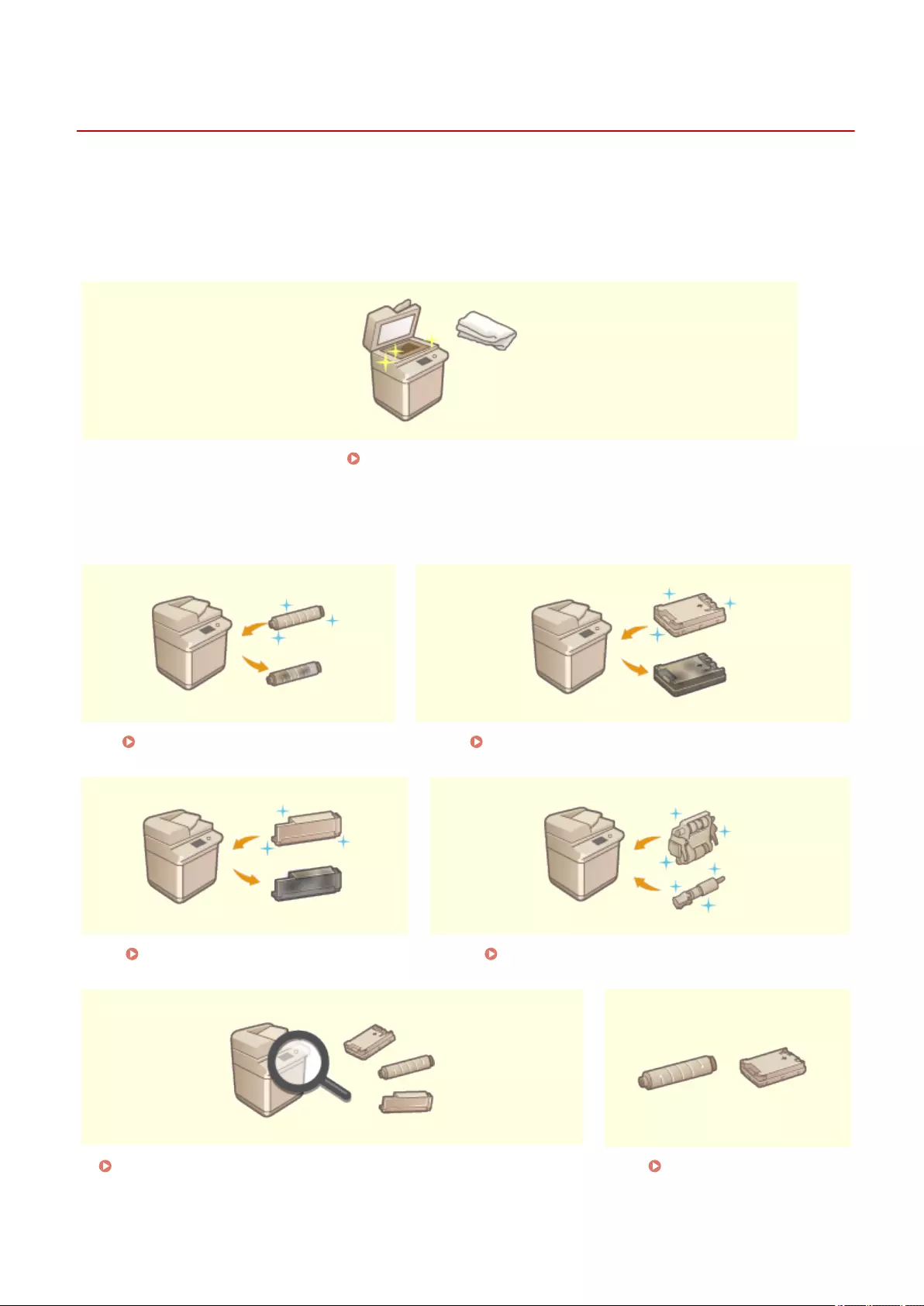
Maintenance
2579-09A
This chapter describes upkeep of the machine, including how to clean the machine and adjustment of print quality.
◼Basic Cleaning
Regular Cleaning(P. 510)
◼Replacing Consumables/Replacement Parts
Replacing the Ink Tanks(P. 528) Replacing the Maintenance Cartridge(P. 532)
Replacing the Print Head(P. 536) Replacing the ADF Maintenance Kit(P. 545)
Checking Remaining Amounts and Usage of Consumables(P. 549) Consumables(P. 625)
Maintenance
508

Regular Cleaning
2579-0H3
Regularly clean the machine to prevent deterioration in printing quality and to ensure that you use it safely and easily.
Exterior Cleaning the Exterior(P. 511)
Platen glass and underside of feeder Cleaning the Platen Glass(P. 512)
Feeder Cleaning the Feeder(P. 514)
Interior Cleaning the Interior(P. 518)
Maintenance
510

Cleaning the Exterior
2579-09E
Periodically wipe the surface of the machine to keep it clean.
1Turn OFF the machine, and unplug the power cord from the AC power outlet.
Turning OFF the Machine(P. 115)
●Turning the printer OFF erases any queued print data. Data such as documents received and held in memory,
documents waiting to be sent, and reports that are automatically printed after being sent or received are not
deleted.
2Wipe the surface of the machine.
●Wipe with a soft and dry cloth.
●If this does not remove dirt, use a soft, well-wrung-out cloth dampened with water or a mild detergent
diluted with water. Wait for moisture to dry completely before proceeding to the next step.
3Insert the power plug into the power outlet, and turn ON the machine. Turning
ON the Machine(P. 114)
Maintenance
511
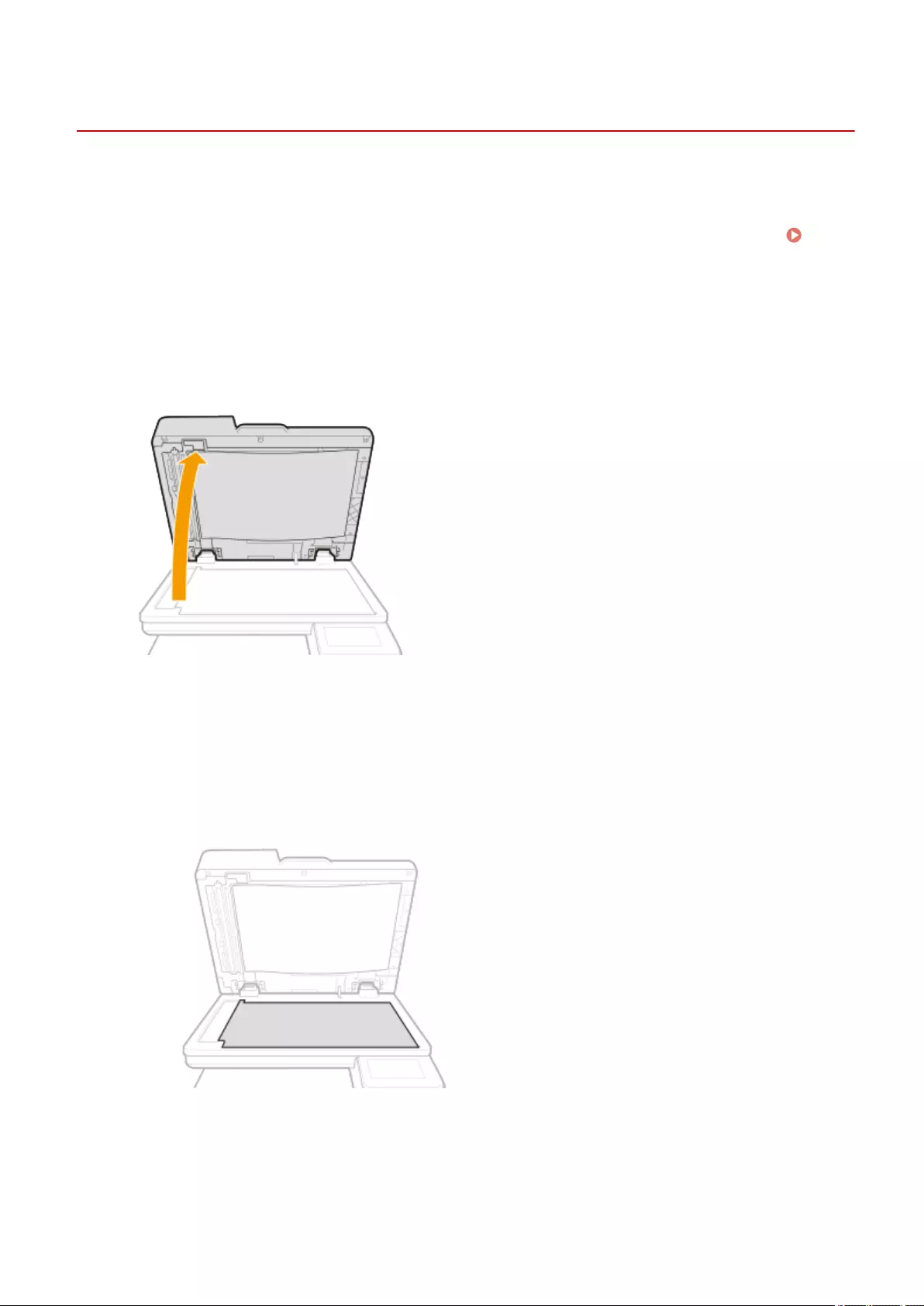
Cleaning the Platen Glass
2579-0H4
If the platen glass is dirty, originals may not be scanned clearly, or the size of the original may not be detected clearly.
1Turn OFF the machine, and unplug the power cord from the AC power outlet.
Turning OFF the Machine(P. 115)
●Turning the printer OFF erases any queued print data. Data such as documents received and held in
memory, documents waiting to be sent, and reports that are automatically printed after being sent or
received are not deleted.
2Open the feeder.
3Wipe the reverse side of the feeder and the platen glass.
1Wipe the platen glass.
●Wipe the platen glass with the included cleaning cloth. If you cannot remove the dirt, wet a
soft cloth with water and wring it out well, then wipe the area with it. Afterwards, wipe the
area with a soft and dry cloth.
2Wipe the reverse side of the feeder.
●Clean the areas with a cloth dampened with water. Then, wipe the area with a soft, dry cloth.
Maintenance
512
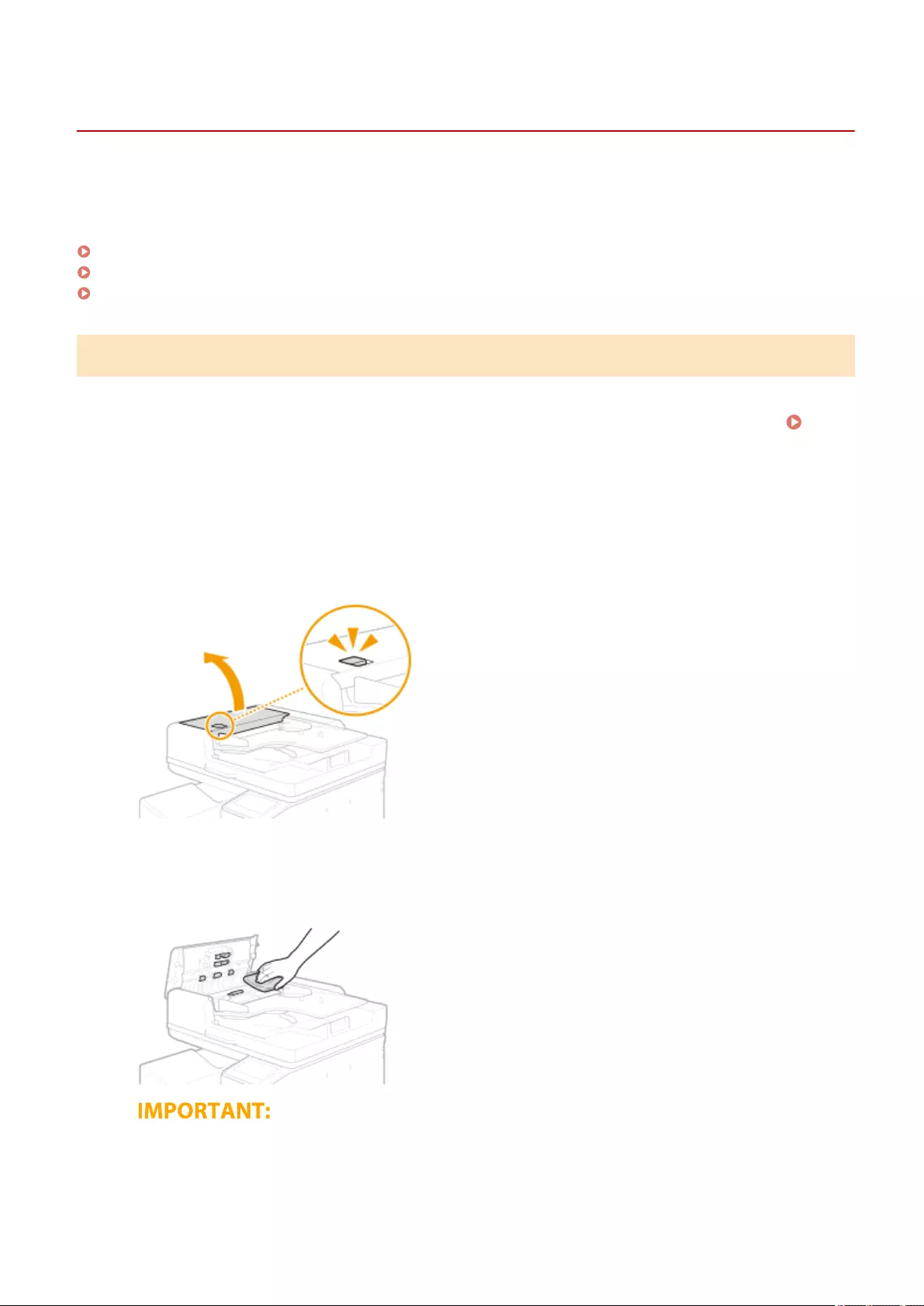
Cleaning the Feeder
2579-09H
Graphite powder or dust on the rollers inside the feeder or on the document feed scanning area may cause smudges
to appear on printouts. If this occurs or if a paper jam occurs frequently, clean the feeder. If the problem persists after
cleaning the feeder, perform automatic feeder cleaning.
Cleaning the Paper Feed Rollers(P. 514)
Cleaning the Feeder(P. 515)
Automatic Feeder Cleaning(P. 517)
Cleaning the Paper Feed Rollers
1Turn OFF the machine, and unplug the power cord from the AC power outlet.
Turning OFF the Machine(P. 115)
●Turning the printer OFF erases any queued print data. Data such as documents received and held in memory,
documents waiting to be sent, and reports that are automatically printed after being sent or received are not
deleted.
2Pull the lever, and open the feeder cover.
3Wipe the rollers in the feeder cover.
●Wipe the rollers with a cloth that has been moistened with water and wrung out. Then wipe with a dry cloth.
●Spin the rollers while cleaning them.
●If the rollers and surrounding areas are very dirty, clean them out. To clean, wet a cloth with water and
wring it out well, then wipe the areas with it. Afterwards, wipe the area with a soft and dry cloth.
Maintenance
514
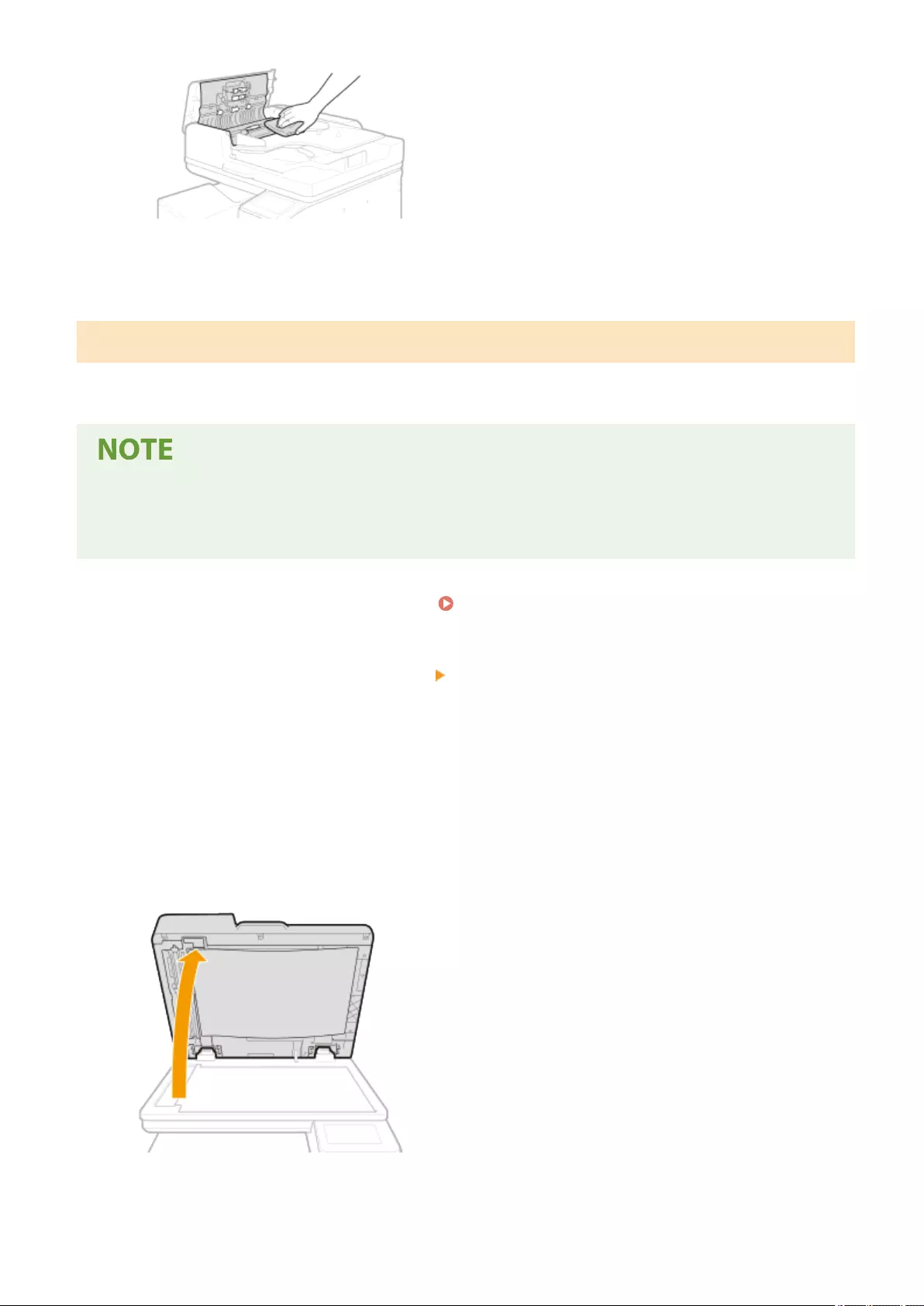
4Close the feeder cover.
Cleaning the Feeder
A simple replacement procedure is displayed on the screen when cleaning the feeder. You can view it together with
the following procedure.
●Be sure to wipe with the included glass cleaning sheet.
●If you cannot remove the dirt, wet a cloth with water and wring it out well, then wipe the area with it.
Afterwards, wipe the area with a soft and dry cloth, and let moisture dry completely.
1Select <Menu> in the Home screen. Home Screen(P. 120)
2Select <Adjustment/Maintenance> <Maintenance>.
3Select <Original Scanning Area Cleaning>.
4Remove the included glass cleaning sheet.
5Open the feeder.
6Wipe the document feed scanning area (long strip of glass) of the platen glass.
Maintenance
515
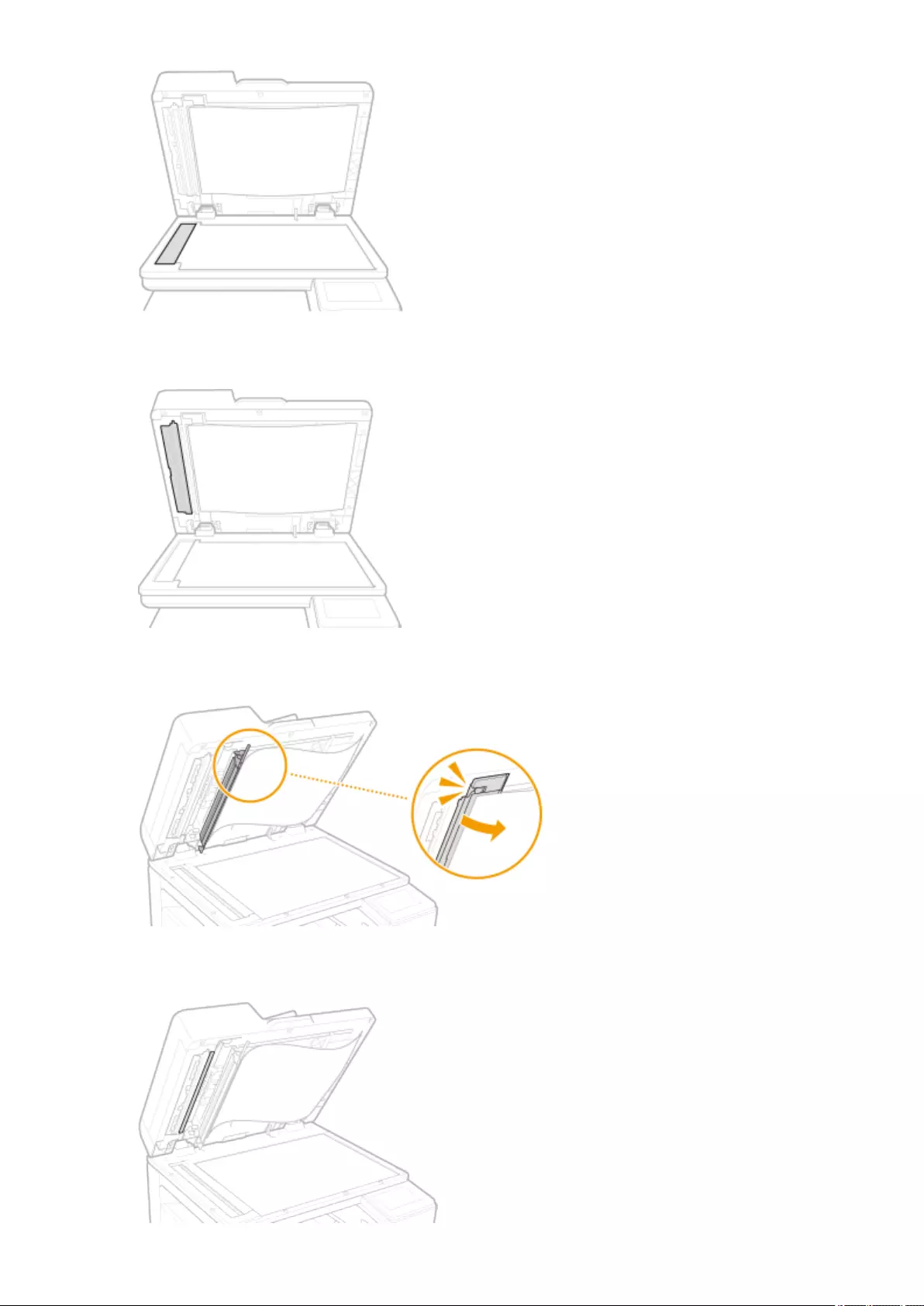
7Wipe the document feed scanning area (long strip of glass) of the feeder.
8Open the document scan cover.
9Wipe the document feed scanning area (long strip of glass).
Maintenance
516
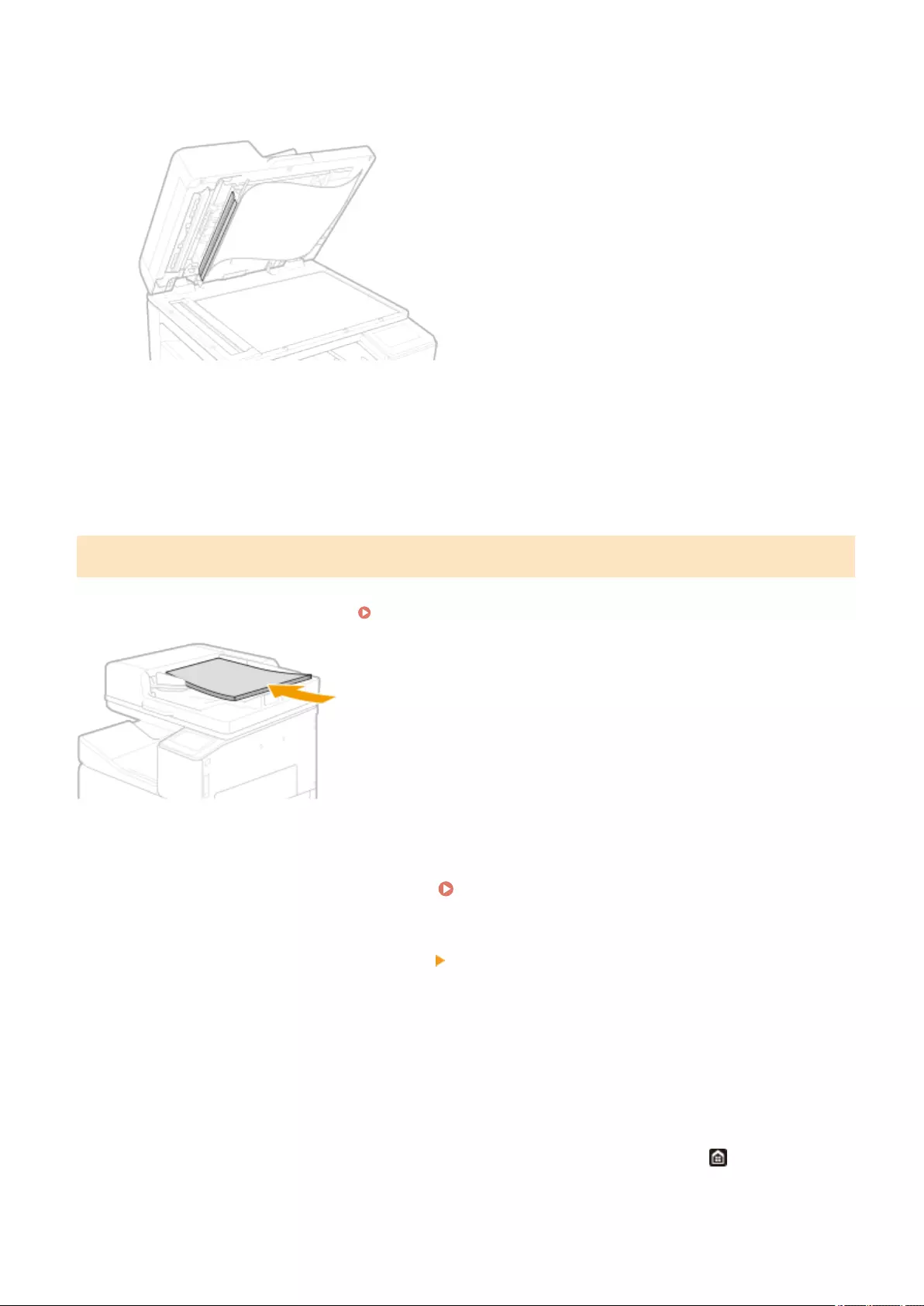
10 Wipe the area opposite the document feed scanning area (long strip of glass).
11 Close the document scan cover.
12 Gently close the feeder.
Automatic Feeder Cleaning
Automatic feeder cleaning uses paper loaded in the feeder. Set 10 sheets of plain A4 or US Letter size paper in the
feeder before starting automatic cleaning. Placing Originals(P. 133)
1Select <Menu> in the Home screen. Home Screen(P. 120)
2Select <Adjustment/Maintenance> <Maintenance>.
3Select <Feeder Auto Cleaning>.
4Check that the size and type of paper displayed on the screen is loaded in the
machine, and select <Start>.
➠Cleaning starts. When a message appears notifying that cleaning is complete, press to return to the
Home screen.
Maintenance
517

Cleaning the Interior
2579-0H5
Clean the interior of the machine if streaks appear in printouts, portions of images are not printed evenly, or if an
error message is still displayed even after clearing out jammed paper from inside the machine.
Cleaning the Paper Path(P. 519)
Cleaning the Sensor Area(P. 523)
Cleaning the Print Head(P. 526)
Maintenance
518
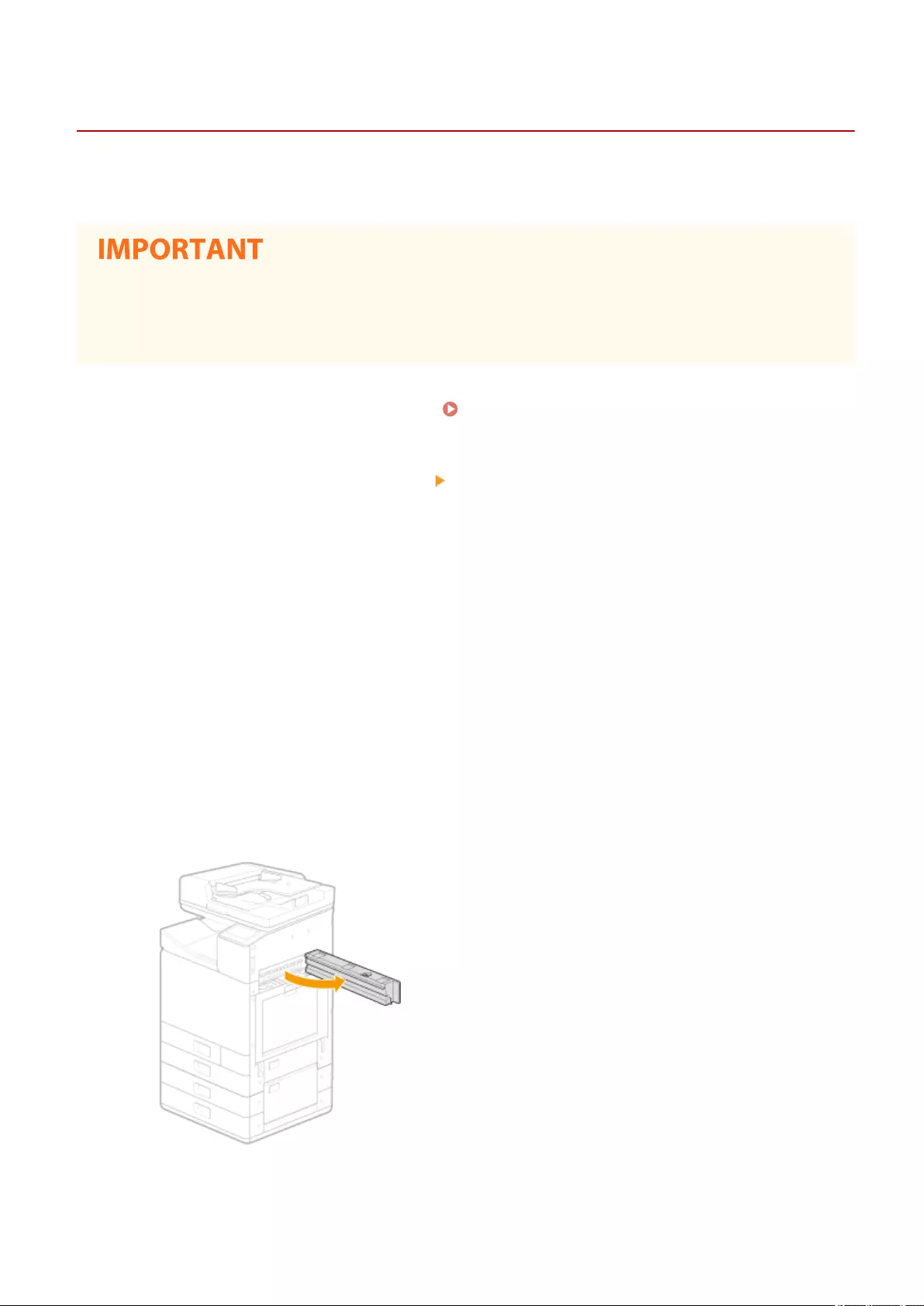
Cleaning the Paper Path
2579-0H8
A simple cleaning procedure is displayed on the screen when cleaning the paper path. You can view it together with
the following procedure.
●To protect the internal mechanisms, be sure to follow the procedure below when cleaning.
●Do not wipe areas where star wheels are present.
●Do not touch star wheels.
1Select <Menu> in the Home screen. Home Screen(P. 120)
2Select <Adjustment/Maintenance> <Maintenance>.
3Select <Paper Transport Unit Cleaning>.
4Check the precaution, and select <Next>.
5Select <Unlock>.
➠The right cover of the machine unlocks.
6Open the transport unit cover.
1Open transport unit cover 1.
2Open transport unit cover 2.
Maintenance
519
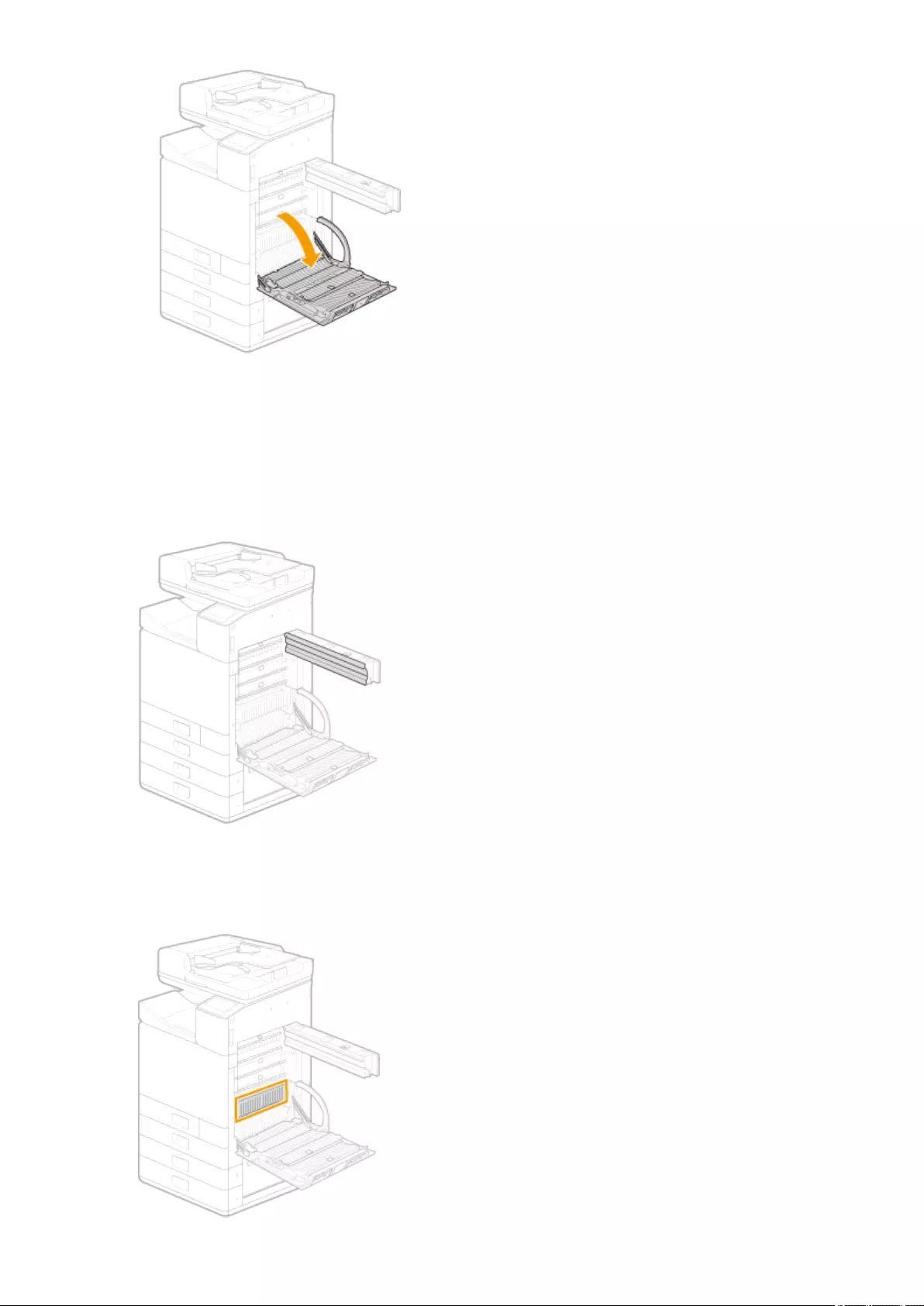
7Wipe the inside of transport unit cover 1.
●Wet a cloth with water and wring it out well, then wipe the areas with it. Afterwards, wipe the area with a soft
and dry cloth.
●Wipe up and down.
●Gently support the outside of the transport unit cover while wiping it.
8Wipe the interior of the machine.
●Wipe up and down.
Maintenance
520
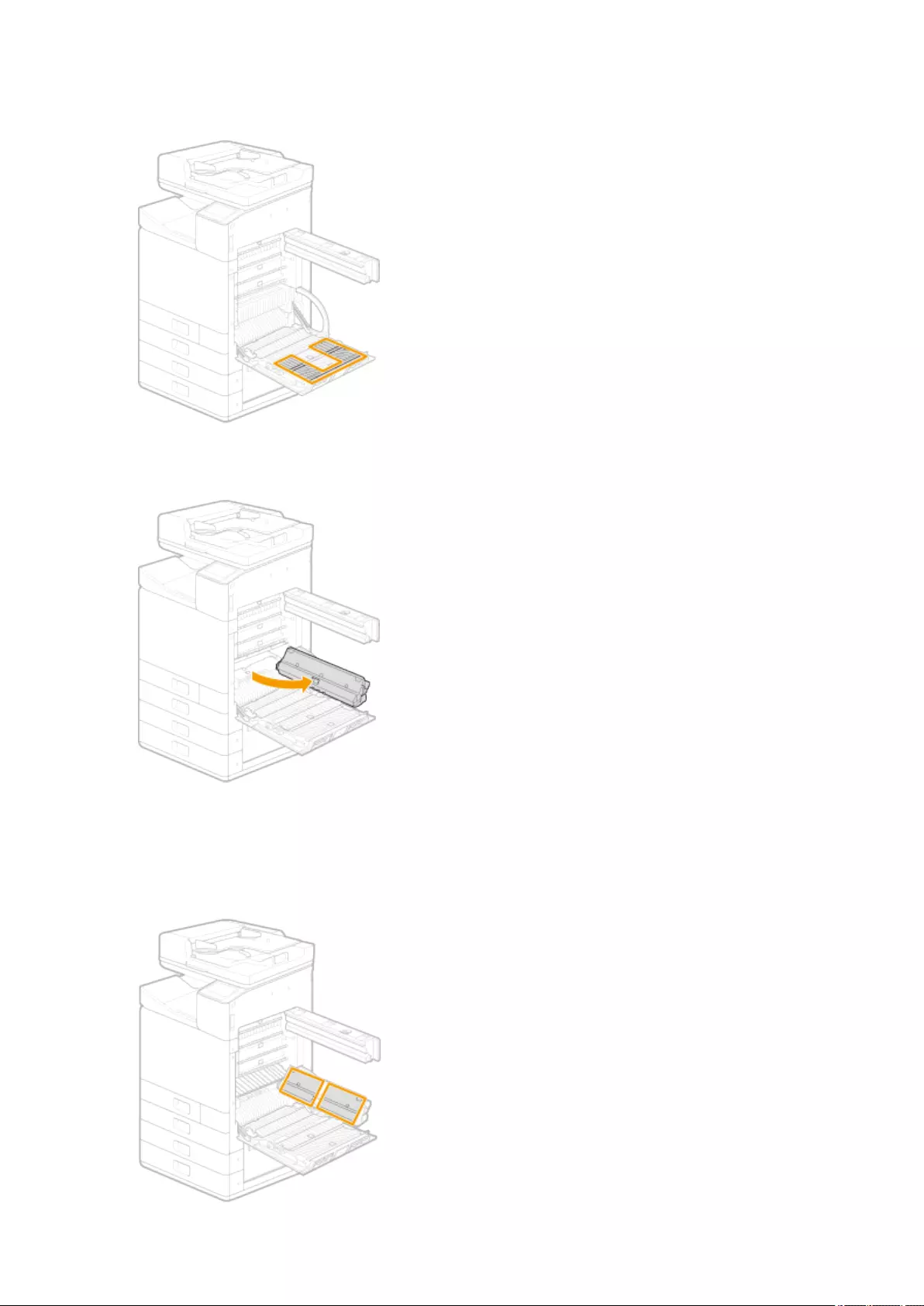
9Wipe the inside of transport unit cover 2.
10 Open the transport guide.
11 Wipe the transport guide.
●Wipe up and down.
●Gently support the outside of the transport guide while wiping it.
Maintenance
521

12 Lower the platen.
13 Wipe the platen.
●Since paper dust collects on the platen easily, wipe towards you starting from the side away from you,
making sure paper dust does not enter the machine.
●Wipe 2 to 3 times along the rib line to remove white paper dust and ink smudges.
●Be careful not to scratch the rollers at the back of the platen.
14 Close the transport guide.
●Closing the transport guide causes the platen to rise.
15 Close transport unit cover 1.
16 Close transport unit cover 2.
Maintenance
522
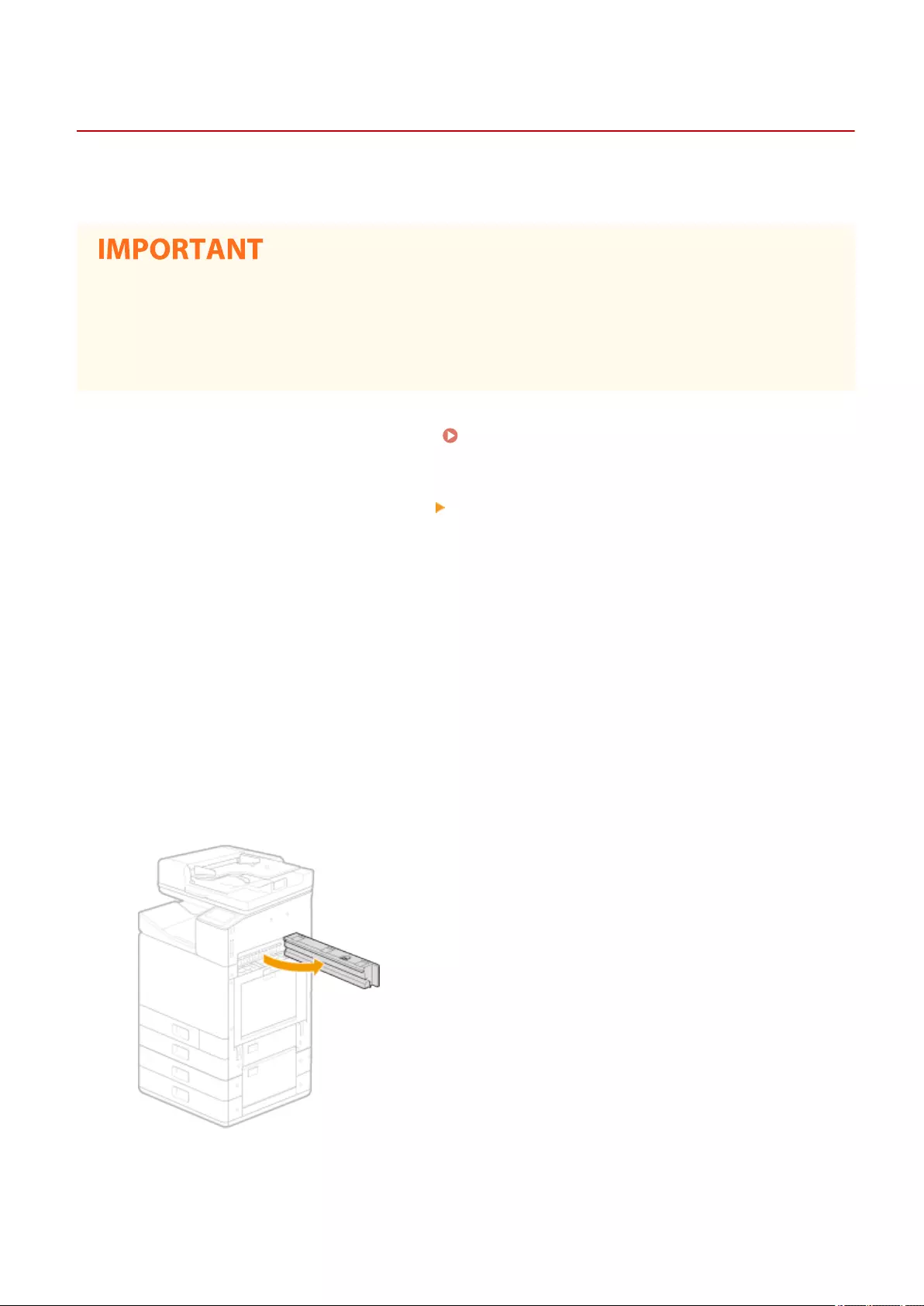
Cleaning the Sensor Area
2579-0H9
A simple cleaning procedure is displayed on the screen when cleaning the sensor area. You can view it together with
the following procedure.
●To protect the internal mechanisms, be sure to follow the procedure below when cleaning.
●Do not wipe areas where star wheels are present.
●Do not touch star wheels.
●Use the special cleaning brush to clean the sensor area.
1Select <Menu> in the Home screen. Home Screen(P. 120)
2Select <Adjustment/Maintenance> <Maintenance>.
3Select <Sensor Cleaning>.
4Check the precaution, and select <Next>.
5Select <Unlock>.
➠The right cover of the machine unlocks.
6Open transport unit cover 1.
7Open transport unit cover 2.
Maintenance
523
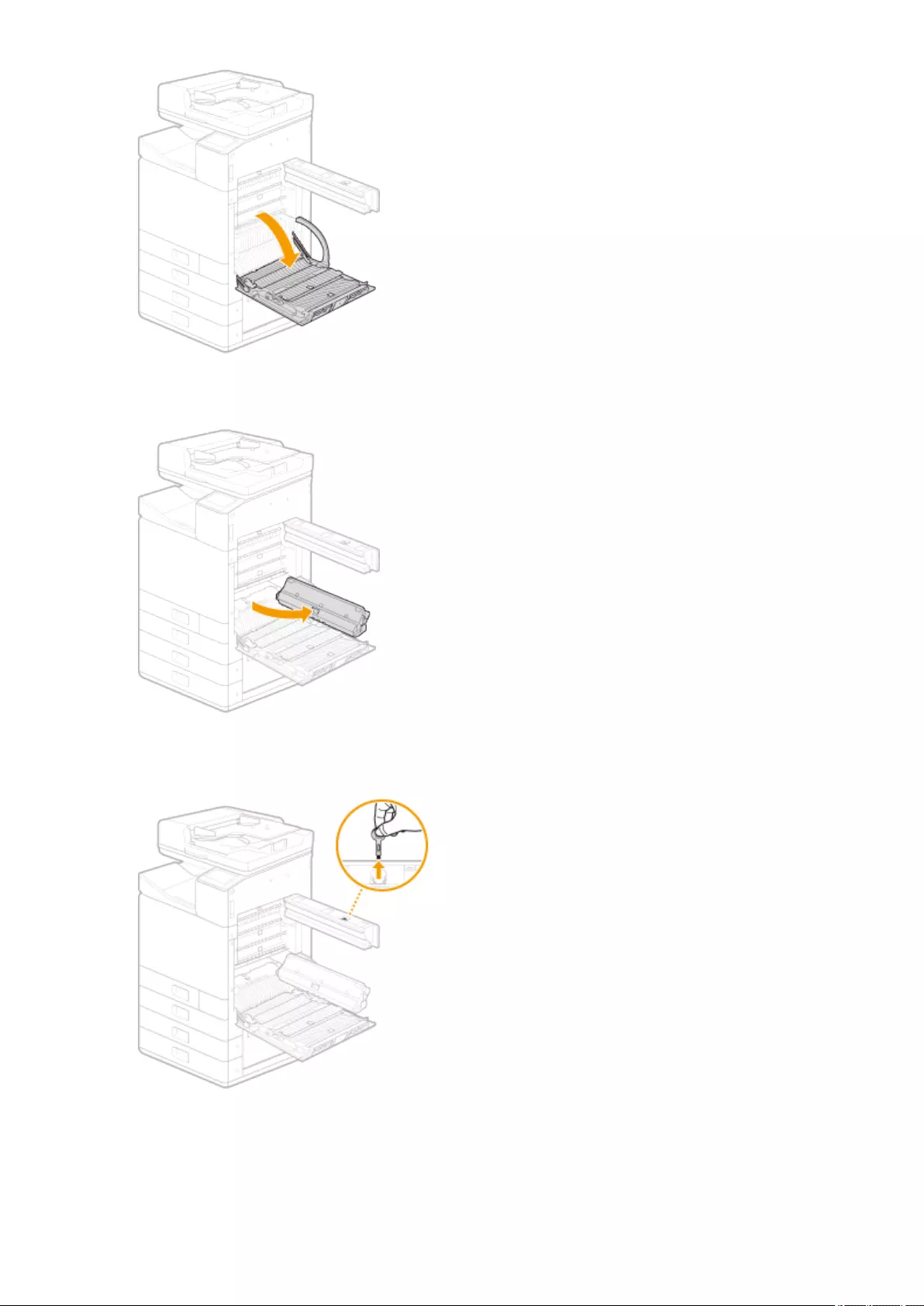
8Open the transport guide.
9Remove the cleaning brush.
10 Wipe the sensor area (6 locations).
●Clean using the cleaning brush.
●After cleaning, replace the cleaning brush.
Maintenance
524
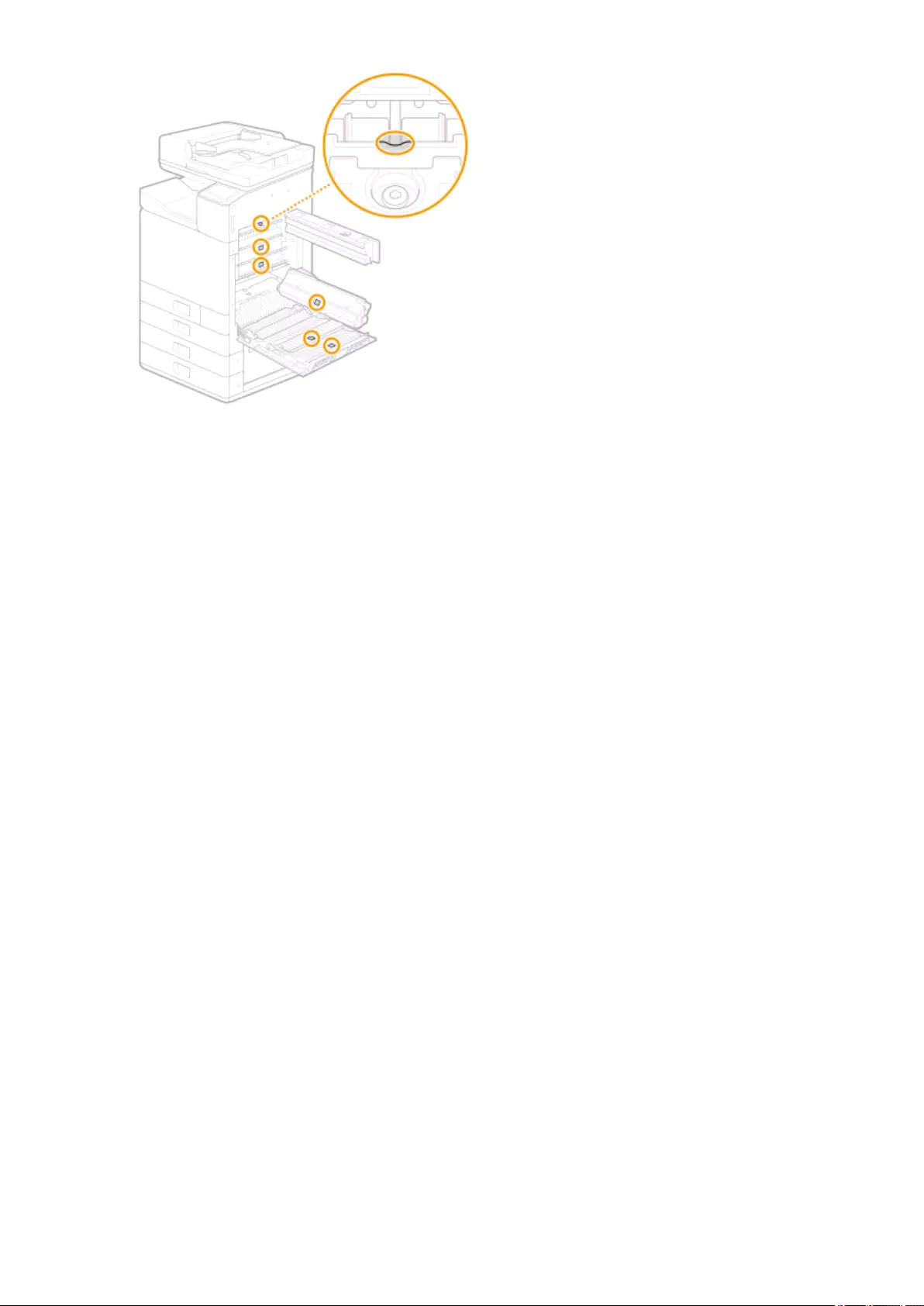
11 Close the transport guide.
12 Close transport unit cover 1.
13 Close transport unit cover 2.
Maintenance
525

Cleaning the Print Head
2579-0H6
Cleaning the print head clears clogged nozzles and keeps the print head in good condition.
●Cleaning consumes ink and maintenance cartridge space. Check remaining amounts beforehand; you
should prepare new ink tanks/maintenance cartridge if remaining amounts are low. Checking
Remaining Amounts and Usage of Consumables(P. 549)
1Select <Menu> in the Home screen. Home Screen(P. 120)
2Select <Adjustment/Maintenance> <Maintenance>.
3Select <Print Head Cleaning>.
4Select <Start>.
●Print head cleaning begins. Cleaning takes about 2 minutes.
5Select <Yes>.
➠A nozzle check pattern is printed.
6Check the nozzle check pattern, and select <A> or <B>.
Maintenance
526

●If you selected <A>, proceed to step 8.
●If you selected <B>, proceed to step 7.
7Check content displayed on the screen, and select <Yes>.
●Print head cleaning begins. Cleaning takes from 6 to 25 minutes.
●Repeat steps 5 to 7 following the on-screen instructions until the nozzle check pattern approximates <A>.
8Select <Close>.
●Press to return to the Menu screen.
Maintenance
527
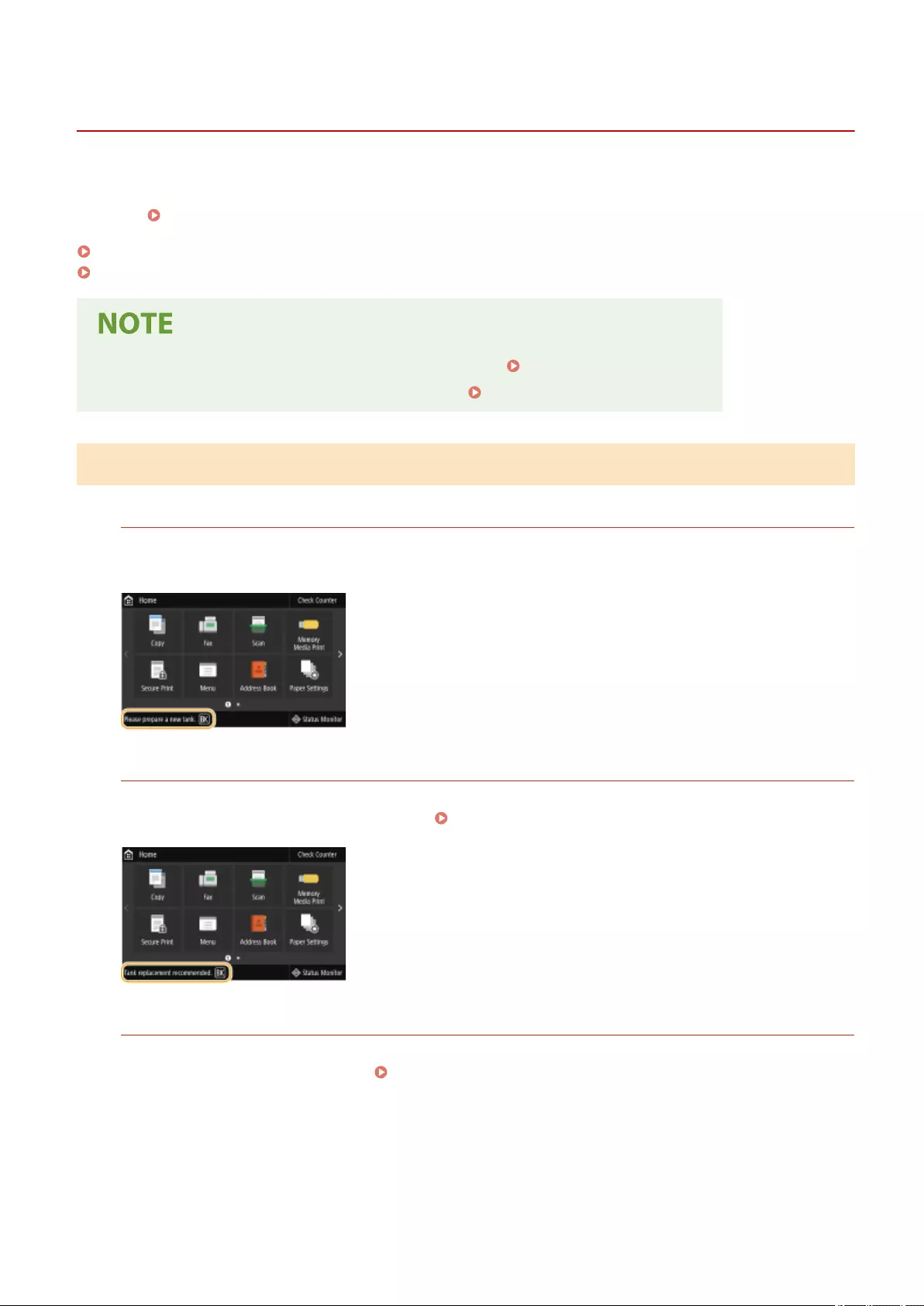
Replacing the Ink Tanks
2579-09L
When ink starts running low or has run out, a message is displayed prompting you to prepare a new ink tank or
perform ink tank replacement. Prepare a new ink tank or perform ink tank replacement according to the displayed
message ( Checking Remaining Amounts and Usage of Consumables(P. 549) ).
When a Message Appear(P. 528)
Procedure for Replacing the Ink Tanks(P. 529)
●For information on the product numbers for ink tanks, see Consumables(P. 625) .
●You can check the current amount of ink remaining. Checking the Ink Level(P. 549)
When a Message Appear
<Please prepare a new tank.>
This message noties you that ink is low. While you do not need to replace the ink tank now, make sure that you
have a new ink tank for replacement at any time.
<Tank replacement recommended.>
Ink in the ink tanks has run out. Some ink remains in the machine, but printing is about to stop. Replacement is
recommended before starting a large print job. Procedure for Replacing the Ink Tanks(P. 529)
<Ink Tank Replacement>
The ink in the ink tanks and the machine has run out, and printing cannot be performed. Follow the instructions
on the screen to replace the ink tanks. Procedure for Replacing the Ink Tanks(P. 529)
Maintenance
528
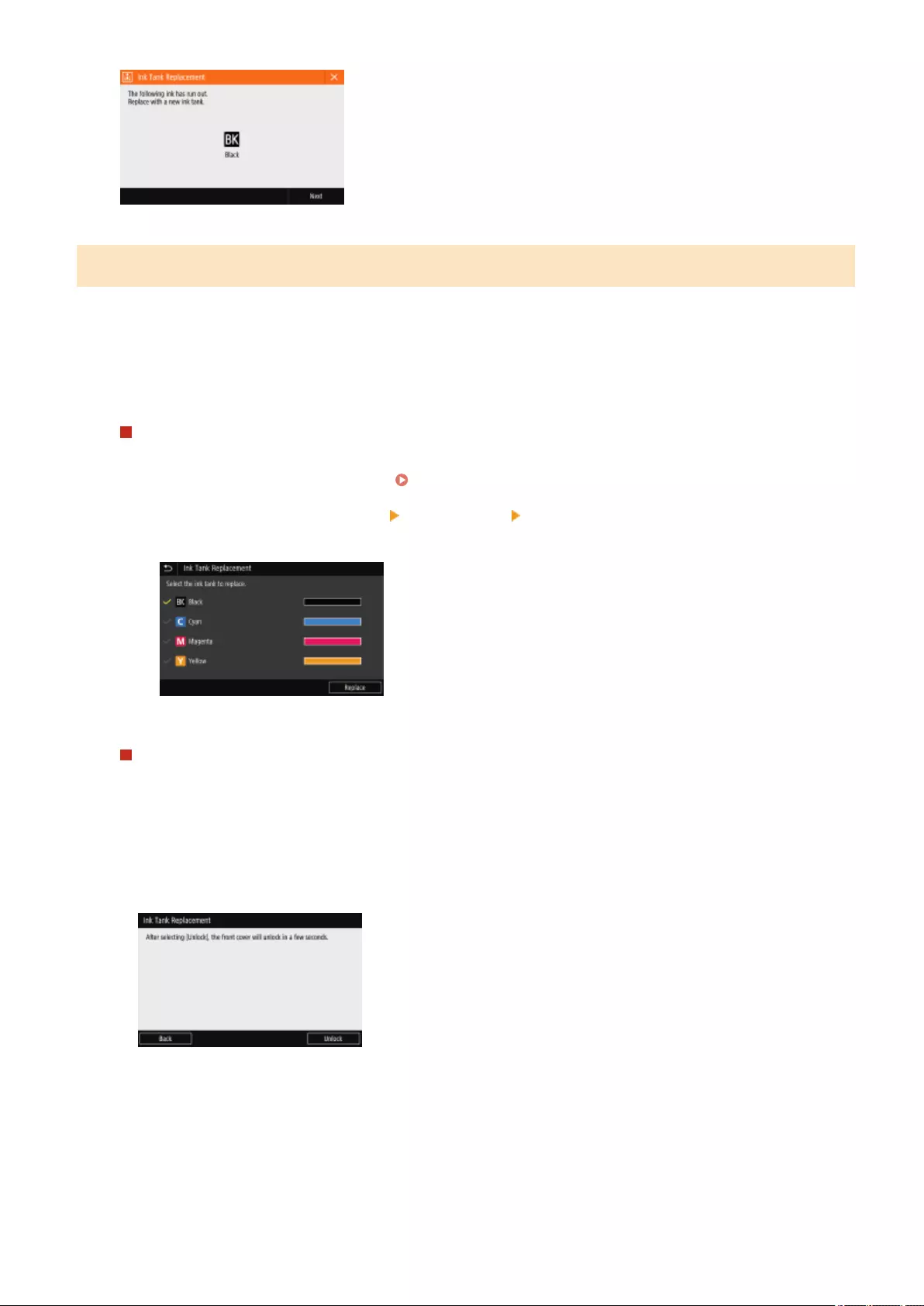
Procedure for Replacing the Ink Tanks
When you replace the ink tank, simple instructions on the replacement procedure are displayed on the screen. See the
on-screen instructions as well as the following procedure.
1Check the message.
If <Tank replacement recommended.> is displayed
1Select <Menu> in the Home screen. Home Screen(P. 120)
2Select <Adjustment/Maintenance> <Maintenance> <Ink Tank Replacement>.
3Select the ink color to replace, and select <Replace>.
If <Ink Tank Replacement> is displayed
1Select <Next>.
2Select <Unlock>.
3When <Open Front Cover> is displayed, open the front cover.
Maintenance
529
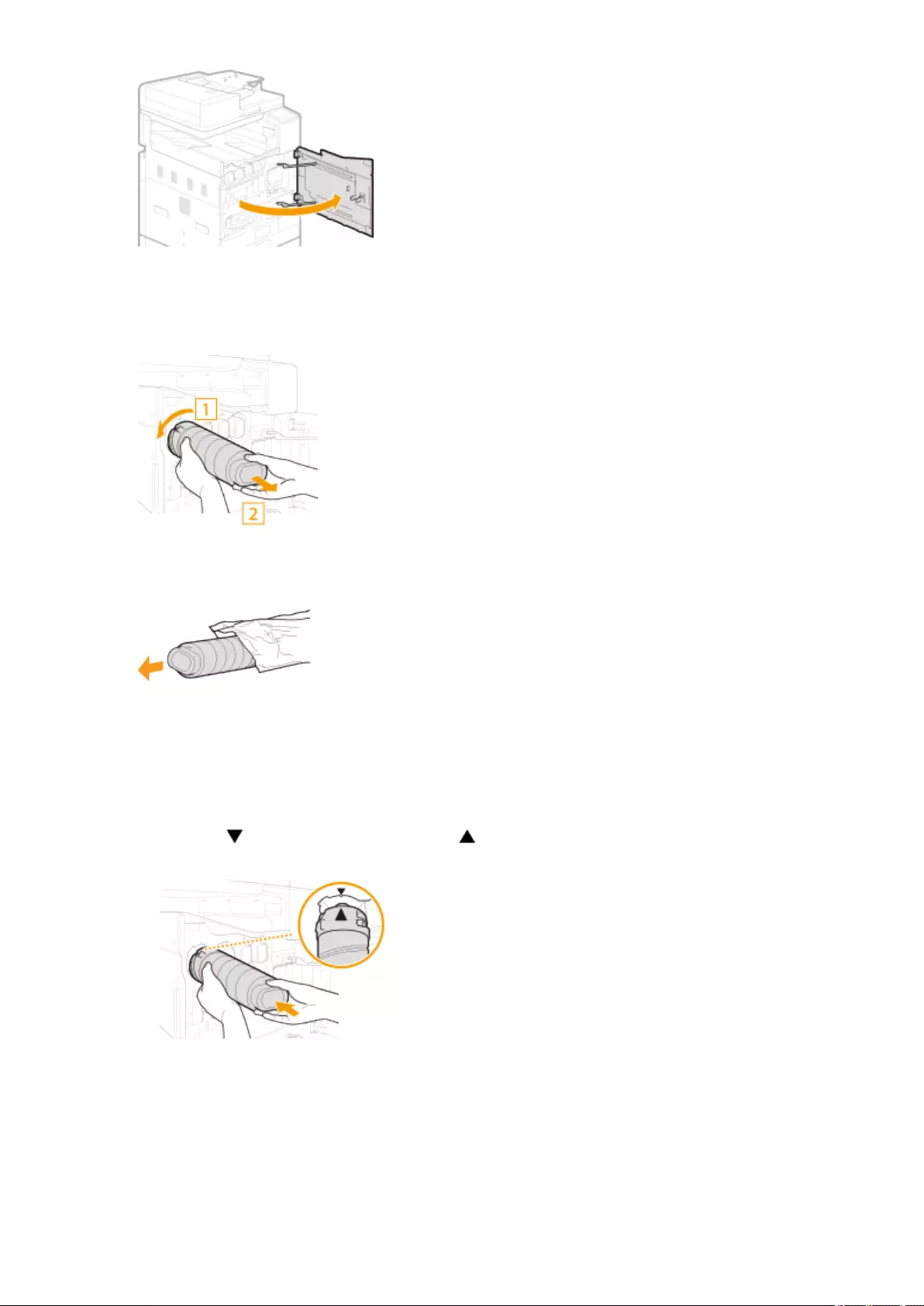
4Pull out the ink tank.
●Turn counterclockwise, then pull straight out.
5Remove the new ink tank.
6Install the new ink tank.
●Before installing the ink tank, conrm that the color of the ink tank and the color indicated on the slot of the
main unit are the same.
1Align the mark on the main unit and the mark on the ink tank, and push the ink tank in until it
stops.
2Turn clockwise until the ink tank clicks.
Maintenance
530
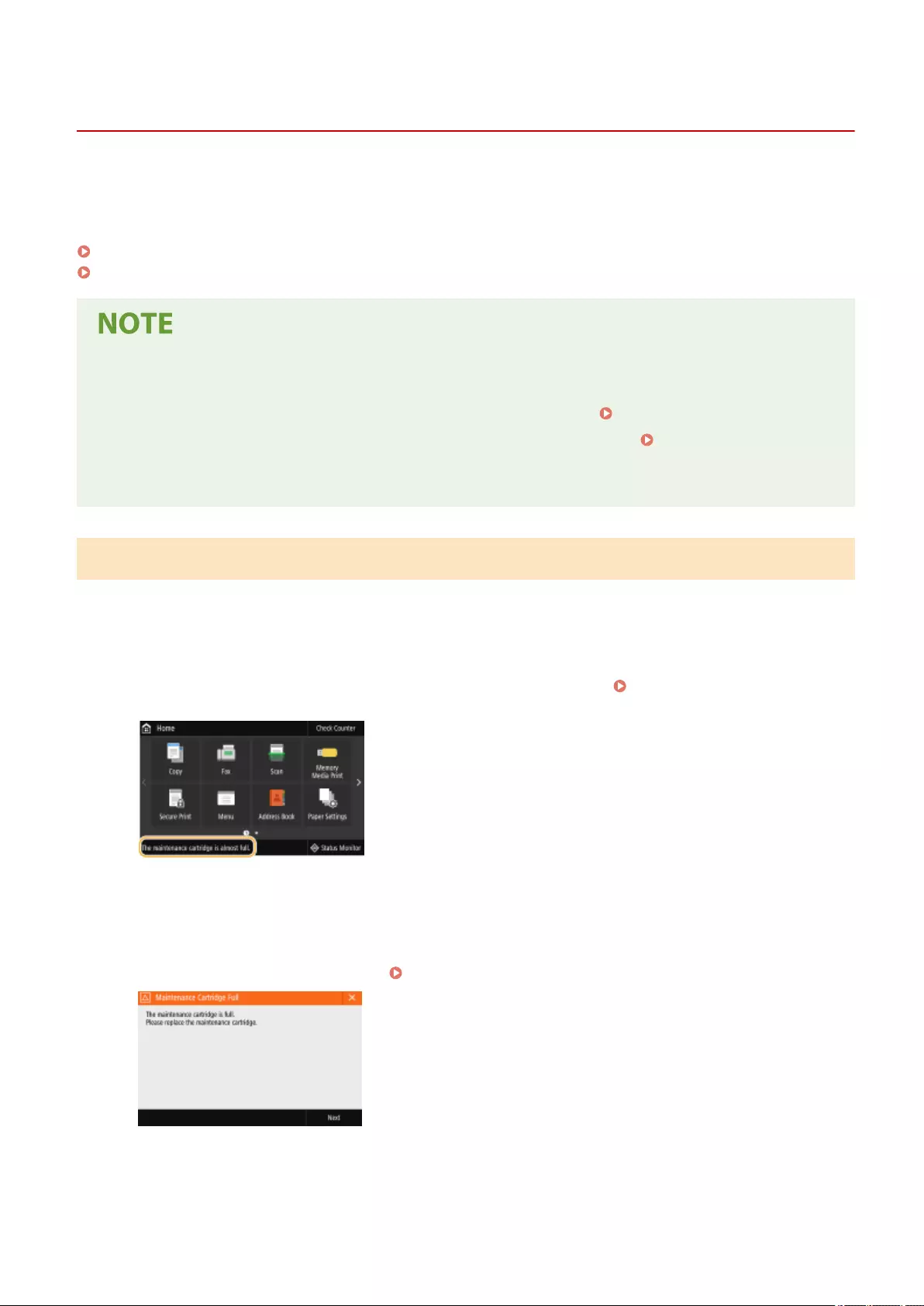
Replacing the Maintenance Cartridge
2579-0HA
When the maintenance cartridge is almost full or completely full, a message is displayed prompting you to prepare a
new maintenance cartridge or perform maintenance cartridge replacement. Prepare a new maintenance cartridge or
perform maintenance cartridge replacement according to the displayed message.
When a Message Appear(P. 532)
Procedure for Replacing the Maintenance Cartridge(P. 533)
●The maintenance cartridge is a container for absorbing ink used during maintenance tasks such as print
head cleaning.
●For information on the model number of the maintenance cartridge, see Consumables(P. 625) .
●You can check the current amount of space used in the maintenance cartridge. Checking the Space Used
in the Maintenance Cartridge(P. 549)
●Replacement may be necessary even when the maintenance cartridge is not full (error, etc.).
When a Message Appear
◼<The maintenance cartridge is almost full.>
The maintenance cartridge is almost full. You can continue printing for a while, but you should have a new
one available so that you can make replacement as soon as it is needed. Procedure for Replacing the
Maintenance Cartridge(P. 533)
◼<Maintenance Cartridge Full>
The maintenance cartridge is full, so printing is not possible any longer. Follow the instructions on the screen
to replace the maintenance cartridge. Procedure for Replacing the Maintenance Cartridge(P. 533)
Maintenance
532
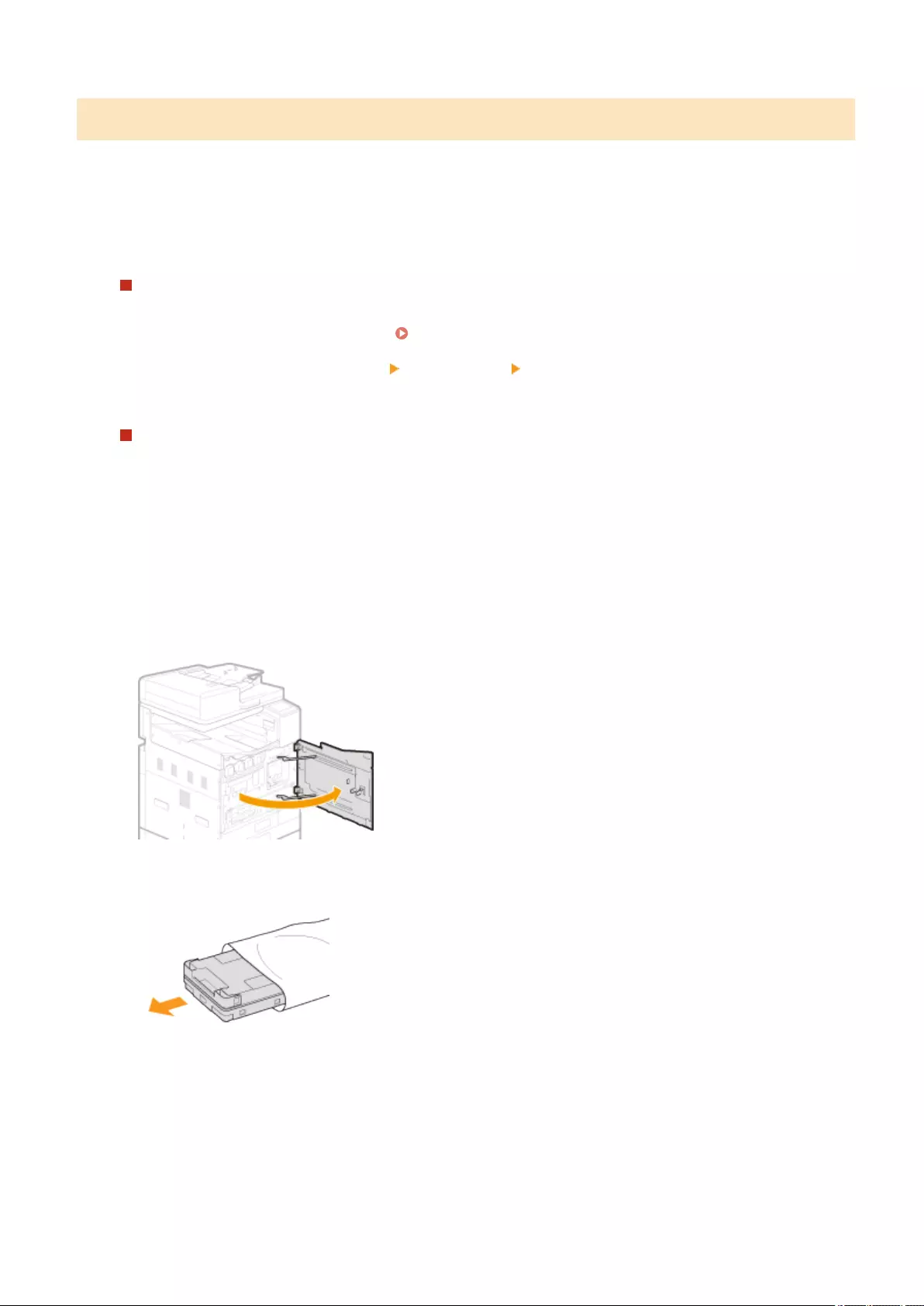
Procedure for Replacing the Maintenance Cartridge
When you replace the maintenance cartridge, simple instructions on the replacement procedure are displayed on the
screen. See the on-screen instructions as well as the following procedure.
1Check the message.
If <The maintenance cartridge is almost full.> is displayed
1Select <Menu> in the Home screen. Home Screen(P. 120)
2Select <Adjustment/Maintenance> <Maintenance> <Maintenance Cartridge Replacement>.
If <Maintenance Cartridge Full> is displayed
1Select <Next>.
2Select <Unlock>.
3When <Open Front Cover> is displayed, open the front cover.
4Remove a new maintenance cartridge.
5Pull out the maintenance cartridge.
●After pulling out the maintenance cartridge half way until it stops, hold it at the left and right with both
hands and lift it lightly to pull out.
Maintenance
533
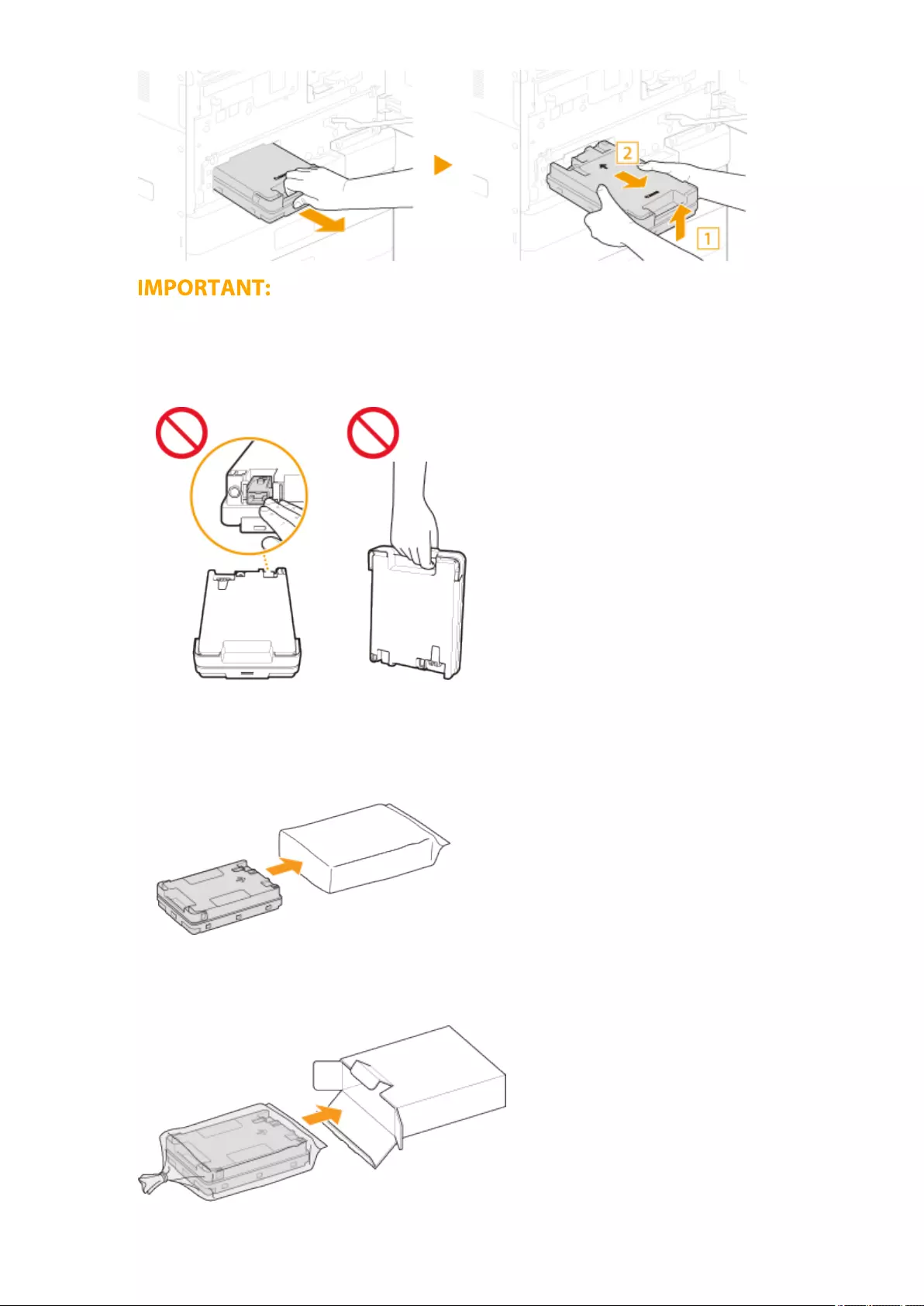
●Do not touch the maintenance cartridge slot.
●A used maintenance cartridge is heavy. Be sure to hold it rmly and held level when pulling it out. The
maintenance cartridge contains ink, and dropping it or leaving it tilted may cause ink to leak and become
spilled around.
6Hold the used maintenance cartridge level as you place it in the supplied storage
bag.
●Close the opening of the storage bag completely so that the ink does not spill out.
7Place the used maintenance cartridge in the box that the new maintenance cartridge
was in.
Maintenance
534
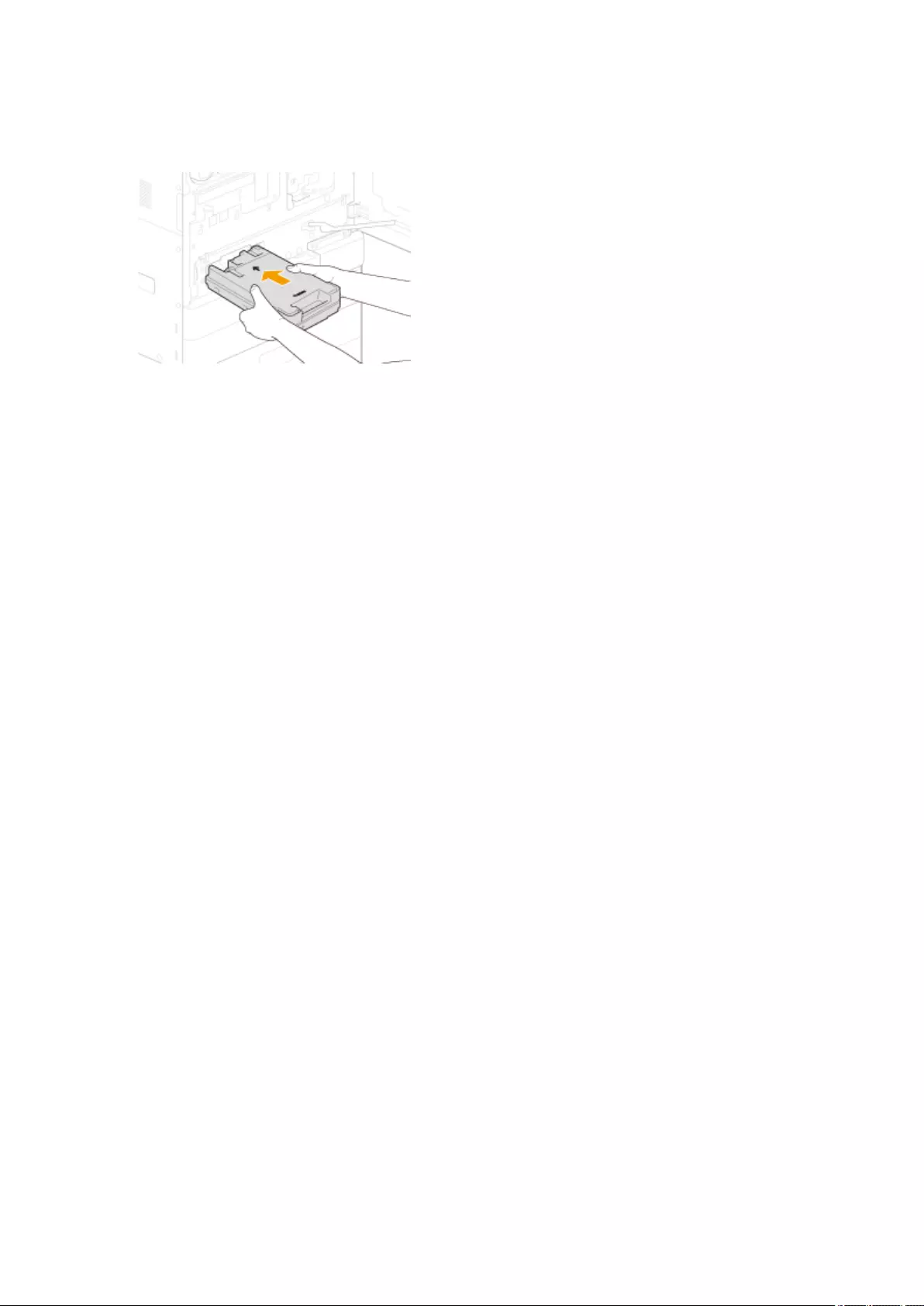
8Install the new maintenance cartridge.
●Push the maintenance cartridge rmly all the way in until it clicks, with the Canon logo facing you.
9Close the front cover.
●Replacement of the maintenance cartridge is completed once the message <Processing> no longer appears.
Maintenance
535

Replacing the Print Head
2579-0HC
Replace the print head if a message is displayed indicating that it needs to be replaced. You can also check the
approximate number of ink tanks and maintenance cartridges required when replacing the print head on the display
( Checking Remaining Amounts and Usage of Consumables(P. 549) ).
When a Message Appear(P. 536)
Procedure for Replacing the Print Head(P. 536)
●It may be necessary to replace the ink tanks and maintenance cartridge when replacing the print head.
Follow the instructions on the screen to replace the ink tanks and maintenance cartridge.
●Replacing the print head takes from 1.5 to 2 hours.
●Do not turn off the machine after having started replacing the print head. If the machine is turned off after
starting replacement, additional ink tanks or maintenance cartridges may be required.
When a Message Appear
The print head is causing inability to print. Check the message, then exit the screen. Procedure for Replacing
the Print Head(P. 536)
●You can also continue replacement from the message. Press <Next> and proceed to step 6. However, since
the number of consumables required is unknown, prepare one ink tank for each color and a maintenance
cartridge.
Procedure for Replacing the Print Head
When you replace the print head, you can also operate from the screen. See the on-screen instructions as well as the
following procedure.
●If there is not sucient ink remaining, prepare a new ink tank.
●If the maintenance cartridge is almost full, prepare a new maintenance cartridge.
1Check the required number of ink tank and maintenance cartridge replacements.
You can check information on the required number of ink tank and maintenance cartridge replacements at
<Replacement Rank> in <Print Head Information>.
1Select <Status Monitor>.
Maintenance
536
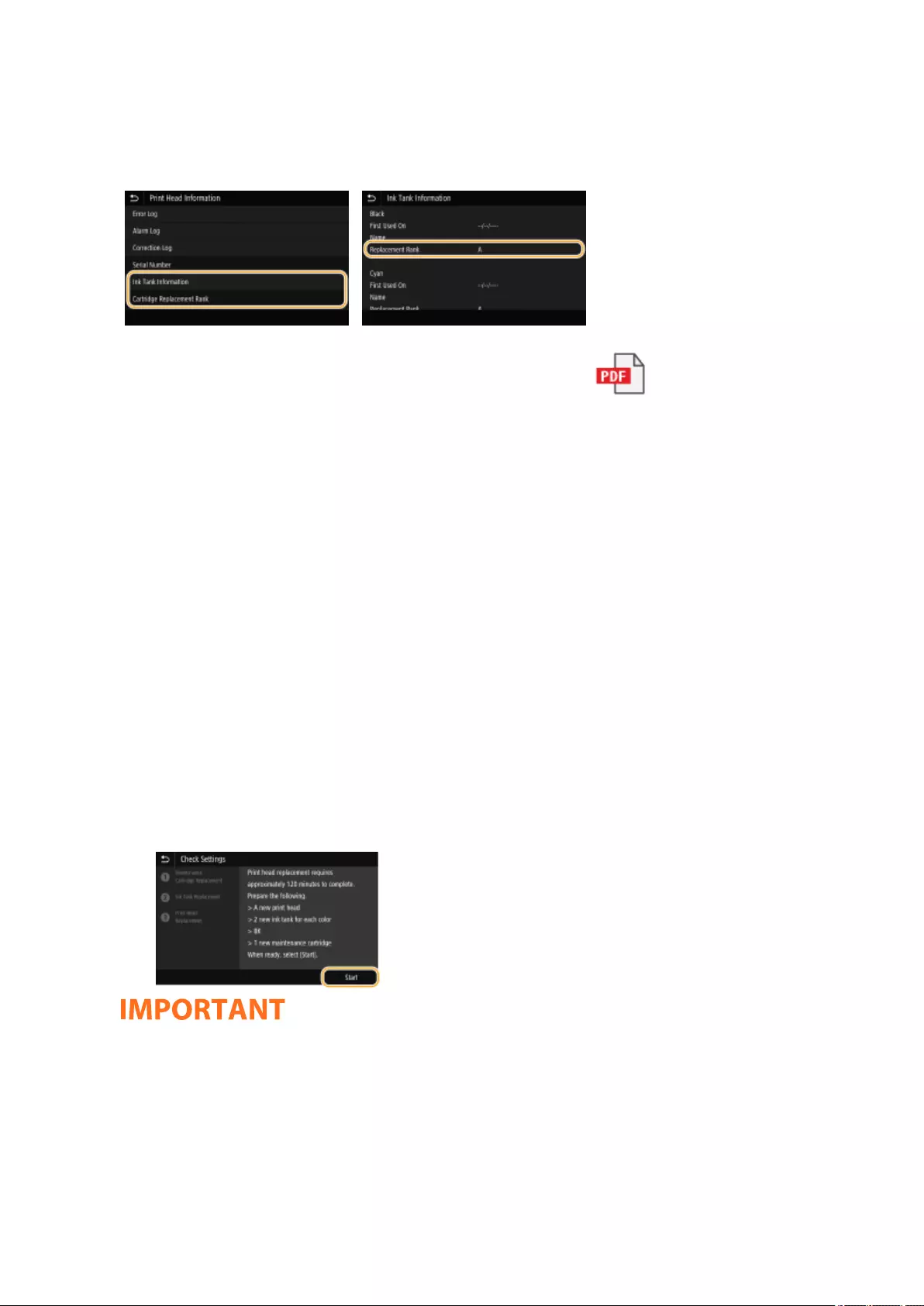
2Select <Device Information>.
3Select <Print Head Information>.
4Select <Ink Tank Information>.
●The required number is different for each replacement rank. Refer to for replacement rank and
required number of replacements.
2Prepare the required number of replacements for ink tanks and a maintenance
cartridge.
●If you cannot check <Print Head Information>, prepare one ink tank for each color and a maintenance
cartridge.
3Begin replacement of the print head.
●Begin print head replacement from the menu.
1Select <Menu>.
2Select <Adjustment/Maintenance>.
3Select <Maintenance>.
4Select <Print Head Replacement>.
5Select <Start>.
●Once you have begun replacement of the print head, it cannot be halted. If no replacements are ready, do
not start print head replacement.
●The machine begins checking the amounts remaining in the maintenance cartridge and ink tanks, and
steps for replacing them according to each of the remaining amounts are displayed.
●The required number of consumables may be displayed. This is the maximum number required when
replacing the print head. Prepare the number of consumables you checked at step 1.
Maintenance
537
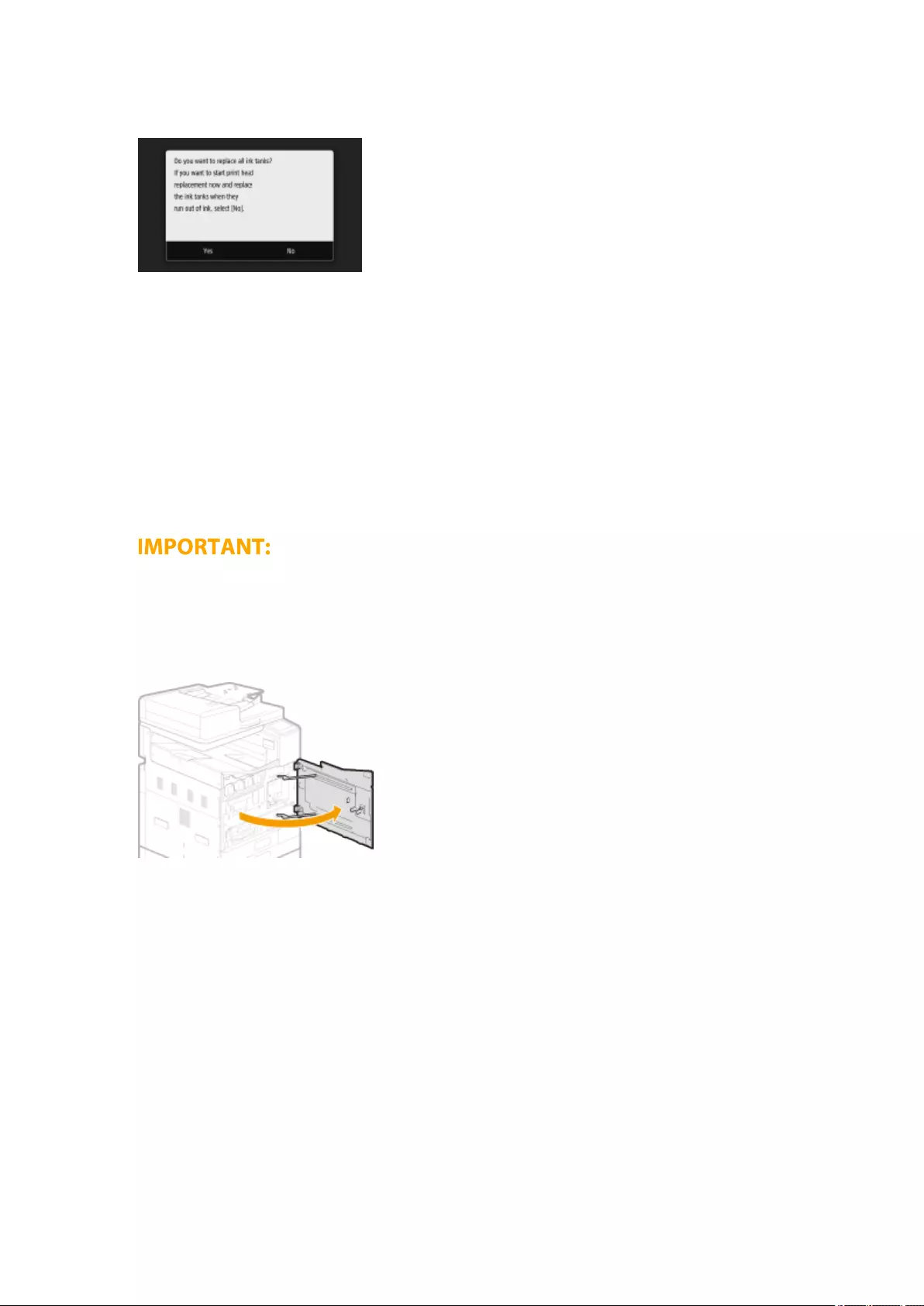
4Select the time for replacing the ink tanks.
●When replacing of the ink tanks is required, a screen for selecting when to replace them appears.
●To replace necessary ink tanks together in advance, press <Yes>. Since all the ink tanks will be replaced at
the same time, less time is taken for replacement.
●To replace necessary ink tanks when they run out of ink, press <No>. Since replacement will be once each
ink tank is depleted, no ink is wasted.
5Select <Unlock>.
Before opening the front cover on the main unit, the machine readies the print head for replacement. If
replacement of ink tanks or the maintenance cartridge is required during this time, instructions are displayed
for replacing them.
●After selecting <Unlock>, the machine begins preparing for print head replacement. While the machine is
preparing, the front cover cannot be opened. Wait about 20 minutes for the cover to unlock.
6When <Open Front Cover> is displayed, open the front cover.
Before opening the front cover on the main unit, the machine readies the print head for replacement. If
replacement of ink tanks or the maintenance cartridge is required during this time, instructions are displayed
for replacing them.
7Open the print head compartment cover.
Maintenance
538

8Pull the print head out.
1Disconnect the print head connector from the print head, and remove the print head connector from the
cable guide.
2Fasten the print head connector to the cable hook.
3Open the storage bag for placing the used print head in.
Maintenance
539
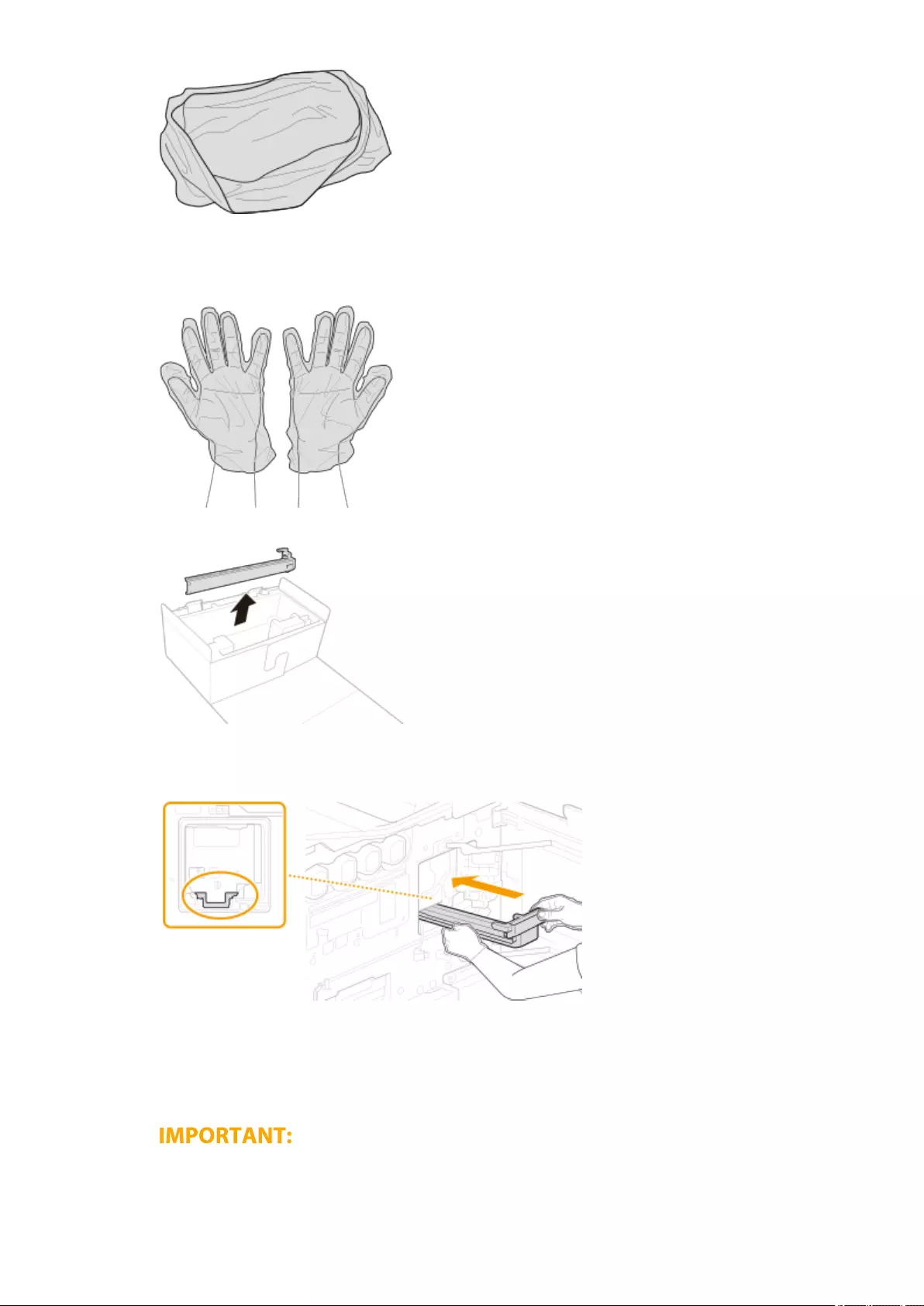
4Put on the gloves to keep your hands from getting dirty.
●Your hands may become dirty removing the used print head. Wear the gloves supplied with the new
print head.
5Remove the print head disposal cap.
6Push on the print head disposal cap bundled with the new print head all the way.
➠The print head disposal cap is attached to the print head.
7After pulling the print head disposal cap half way, hold the print head from beneath with both hands, and
pull it out.
●The print head will be pulled out together. If only the print head disposal cap is pulled out, insert it all
the way again rmly until it stops.
●A used print head is heavy. Be sure to hold it rmly with both hands when removing it from the
machine. If dropped, the impact may cause ink to splatter.
Maintenance
540
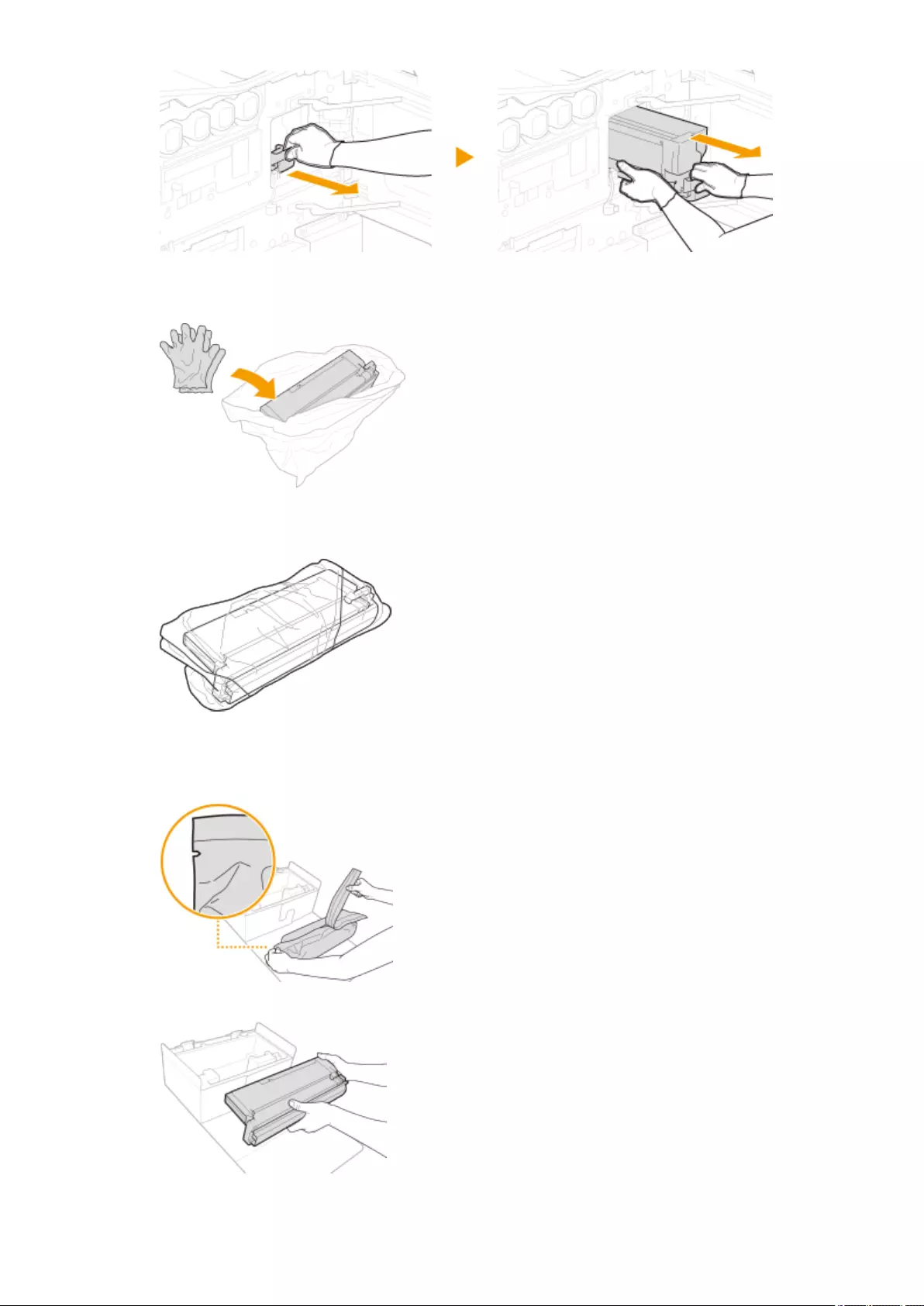
8After placing the used print head in the storage bag, remove the gloves and place them in the bag.
●The used print head may be soiled with ink. Avoid touching it after removing the gloves.
9Wrap the unused portion of the bag around the print head.
●Close the bag completely to prevent ink from spilling out.
10 Remove the new print head from its box, and open the aluminum foil bag at the notch.
●The print head may be damaged by dropping it. When removing the print head from its box, remove
on the oor or other low place.
11 Hold the print head with both hands and remove it from the aluminum foil bag.
●The new print head comes with a print head protector. The protector is required when installing the
print head; do not remove.
Maintenance
541
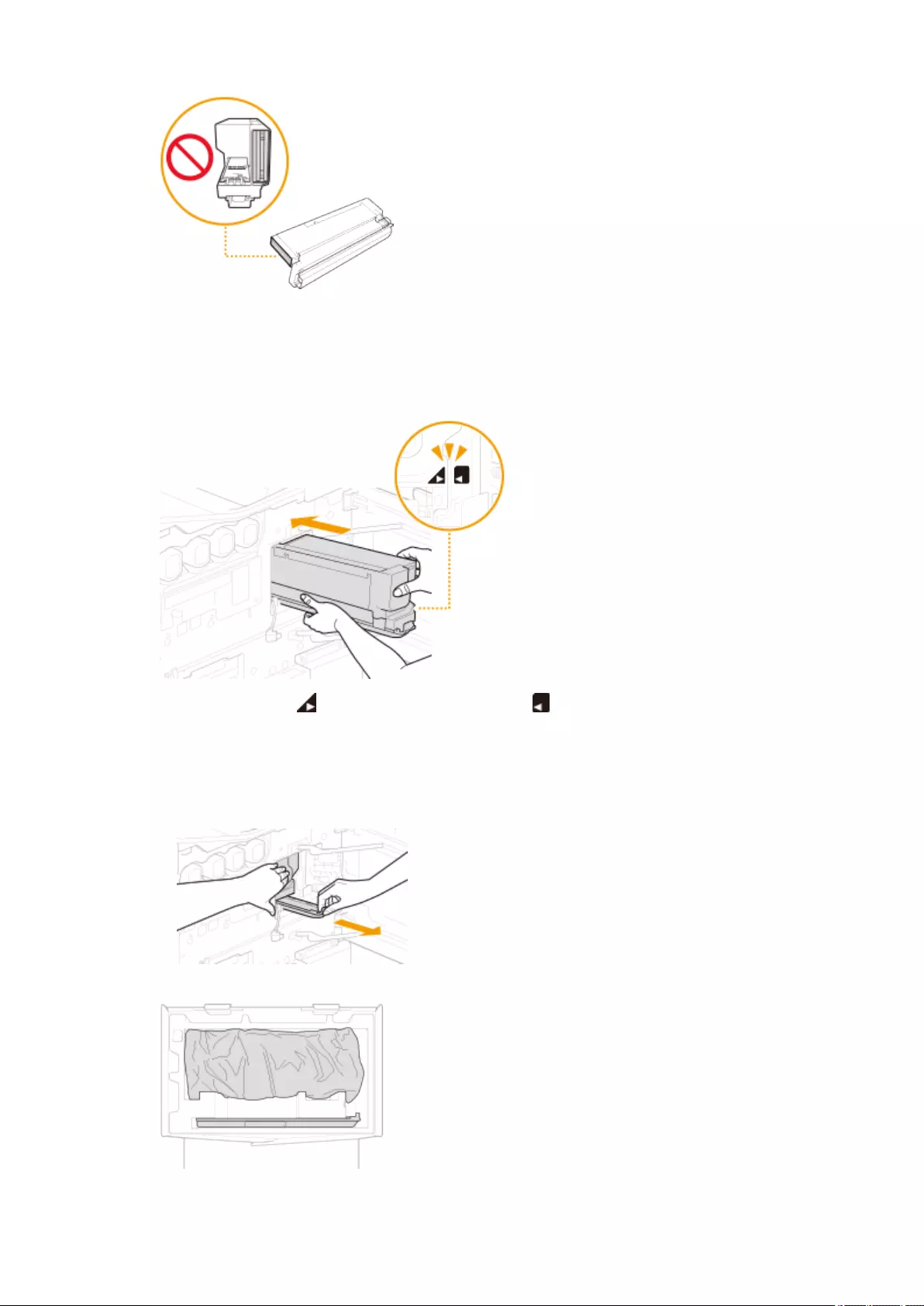
●Never touch the print head slot. Doing so may cause the print head to malfunction.
9Install the print head.
1Press the new print head in all the way.
●Press in until the mark on the print head and the mark on the machine are aligned.
●Press the print head in all the way to install. The print head protector will have moved out toward you.
2Pull off the print head protector.
●Pull out the print head protector while holding the print head in place. Not holding the print head in
place may allow it to be pulled out together.
3Place the used print head and print head protector in the box and cover them with packing material.
4Remove the print head connector from the cable hook.
Maintenance
542
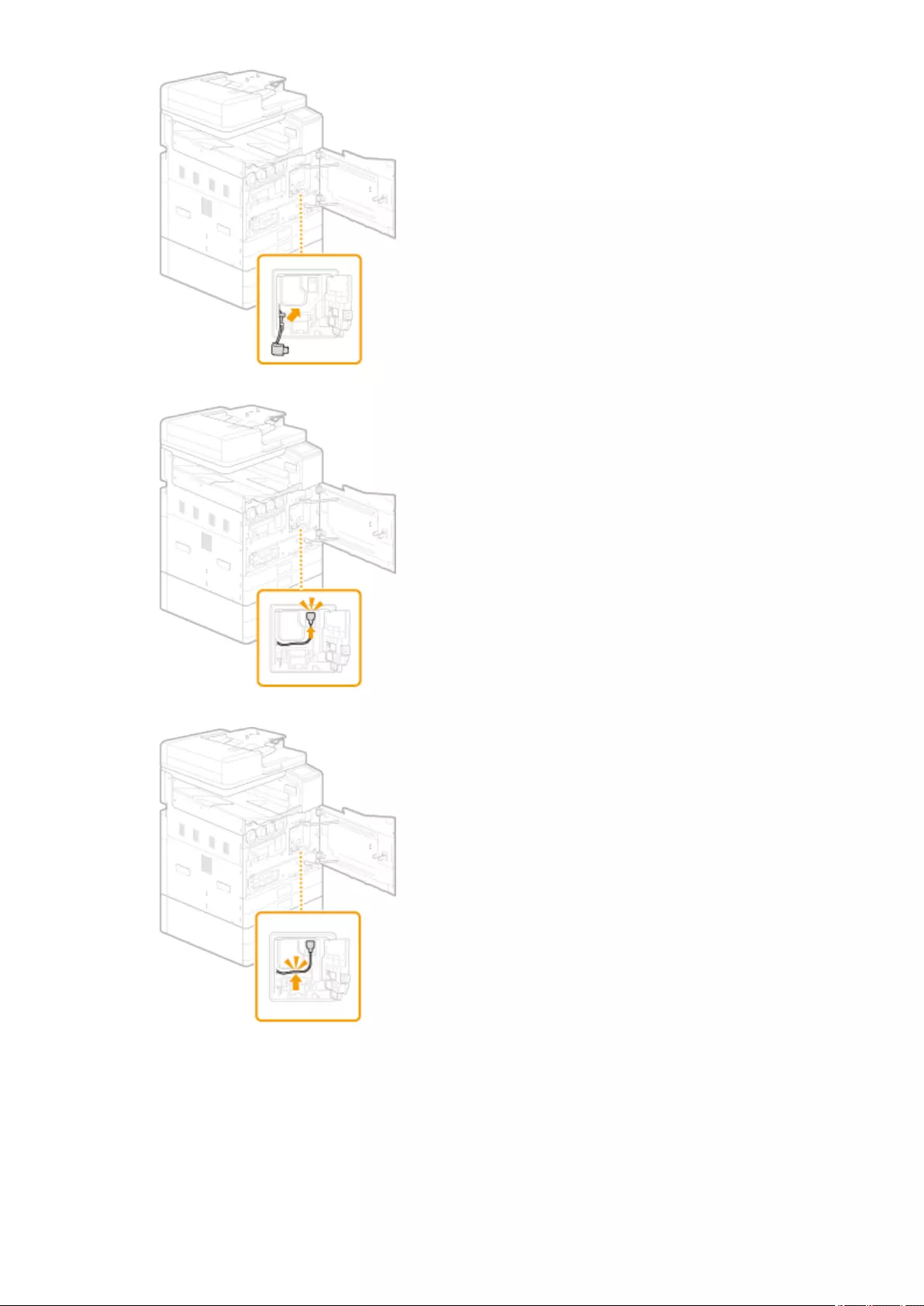
5Connect the print head connector to the new print head.
6Press the print head connector into the cable guide.
10 Close the print head compartment cover.
Maintenance
543

11 Close the front cover. Filling takes from 40 to 70 minutes. Do not turn the machine
off while ink is lling.
●Ink begins lling.
●If replacement of ink tanks or the maintenance cartridge is required while ink is lling, instructions are
displayed for replacing them.
●Replacement is completed once the message <Finished.> appears.
Maintenance
544
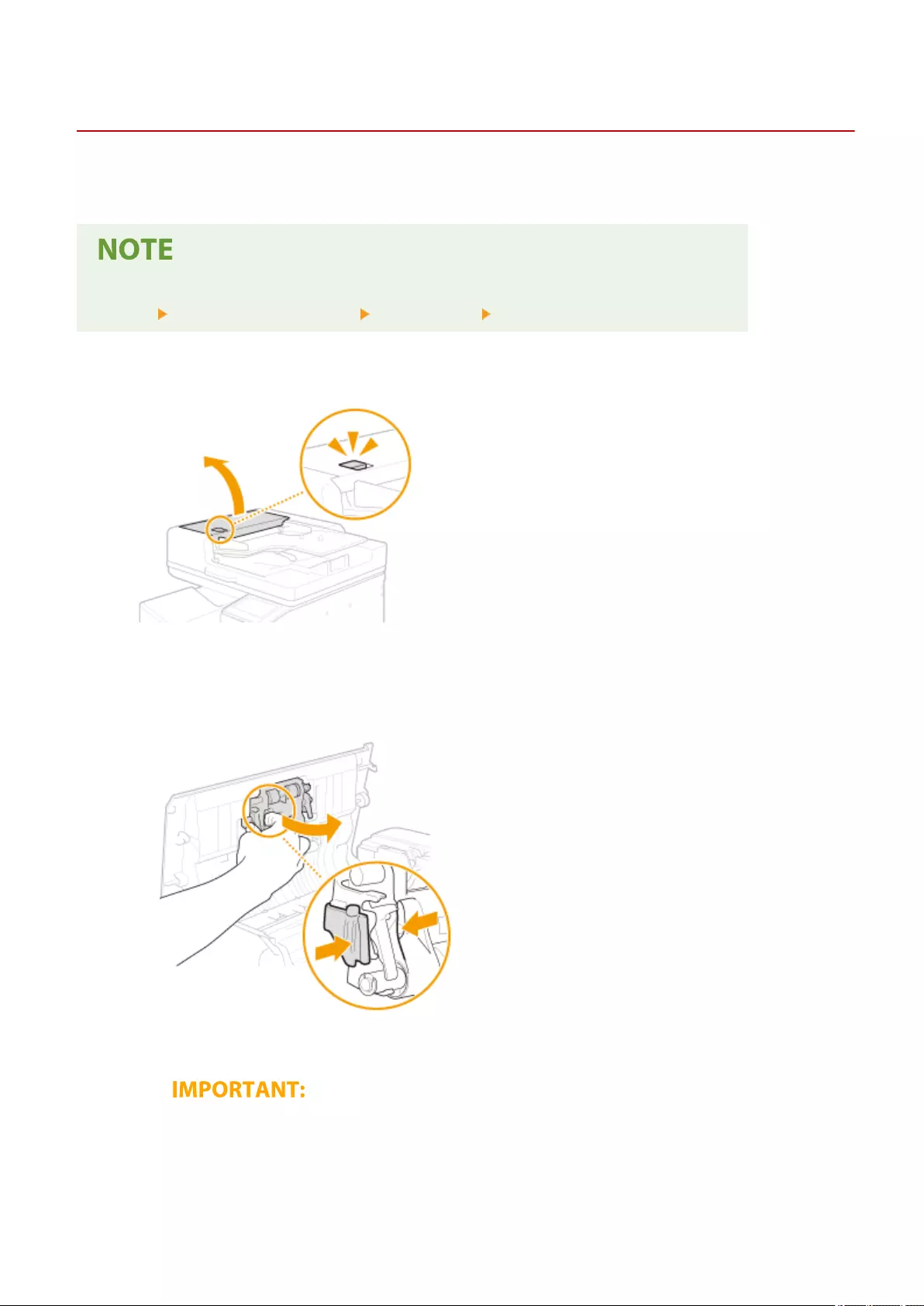
Replacing the ADF Maintenance Kit
2579-0J8
Replace the document feed roller and the document separation roller. A simple replacement procedure is displayed on
the screen when replacing the rollers. You can view it together with the following procedure.
You can check simple instructions on the replacement procedure in the following way.
<Menu> <Adjustment/Maintenance> <Maintenance> <ADF Maintenance Kit Installation>
1Pull the lever, and open the feeder cover.
2Replace the document feed roller.
1Remove the document feed roller.
2Remove the new document feed roller from its box.
●Do not touch the roller area.
Maintenance
545
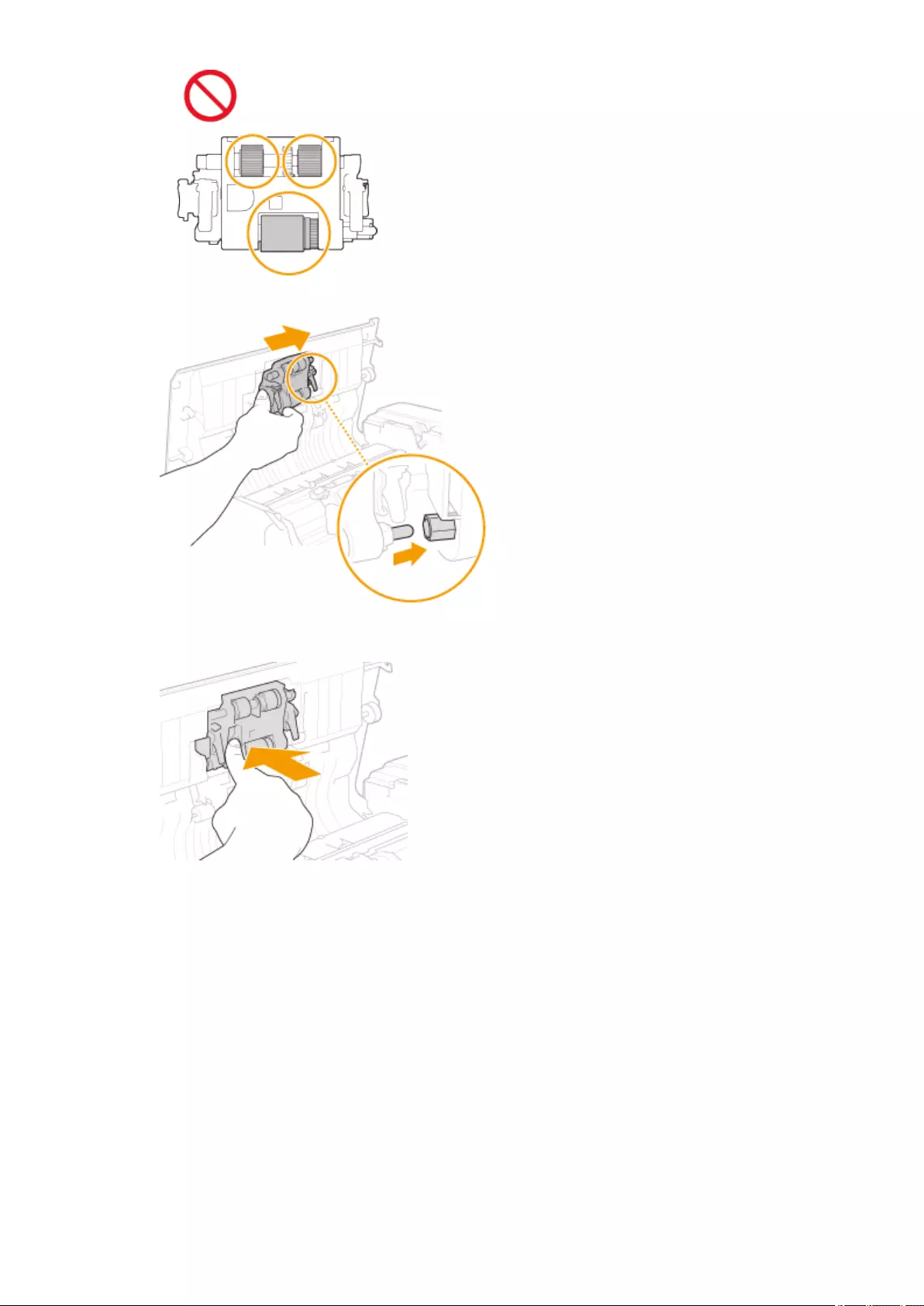
3Install the document feed roller.
4Press the document feed roller in.
3Replace the document separation roller.
1Remove the document separation roller.
Maintenance
546
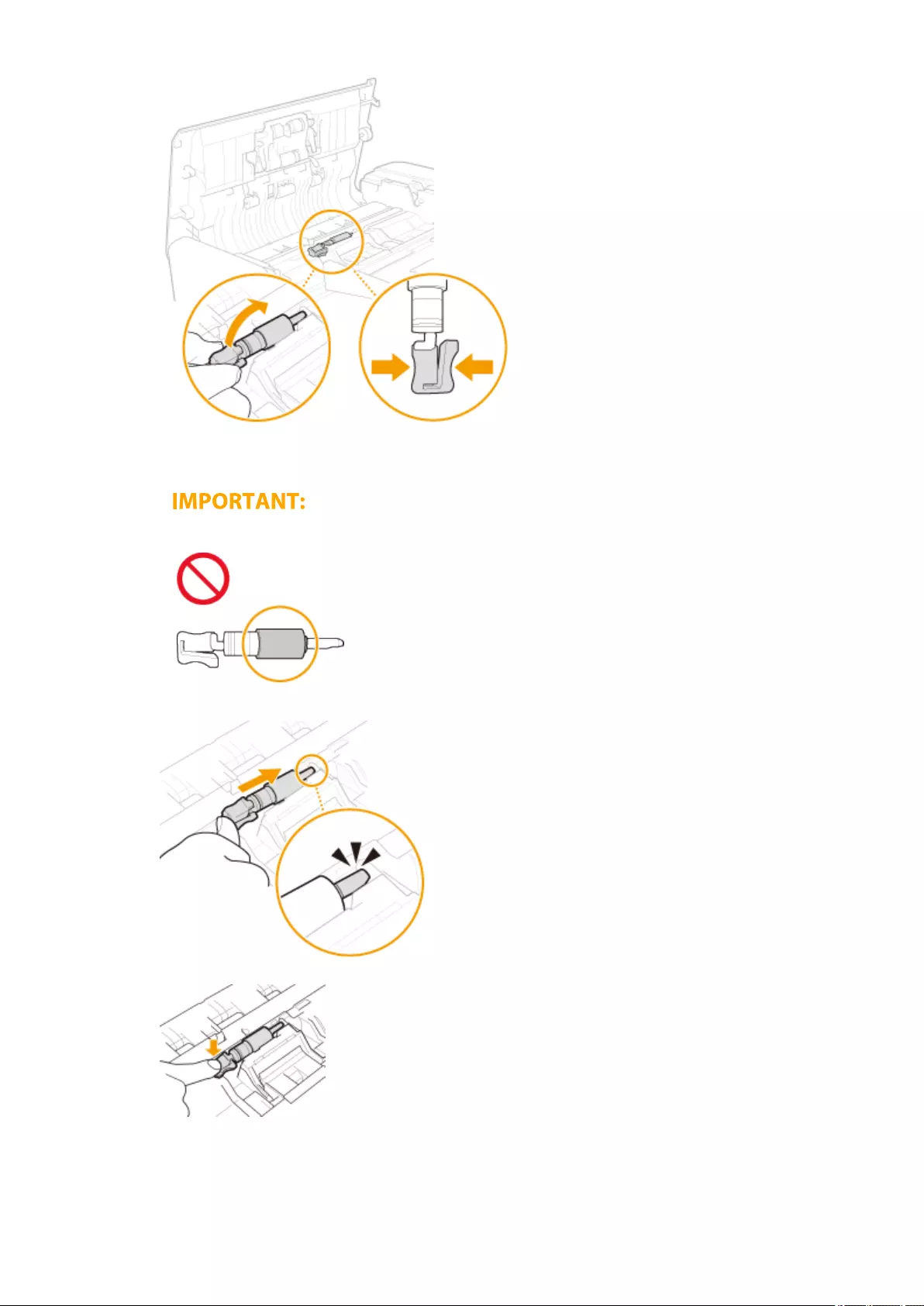
2Remove the new document separation roller from its box.
●Do not touch the roller area.
3Install the document separation roller.
4Close the feeder cover.
Maintenance
547
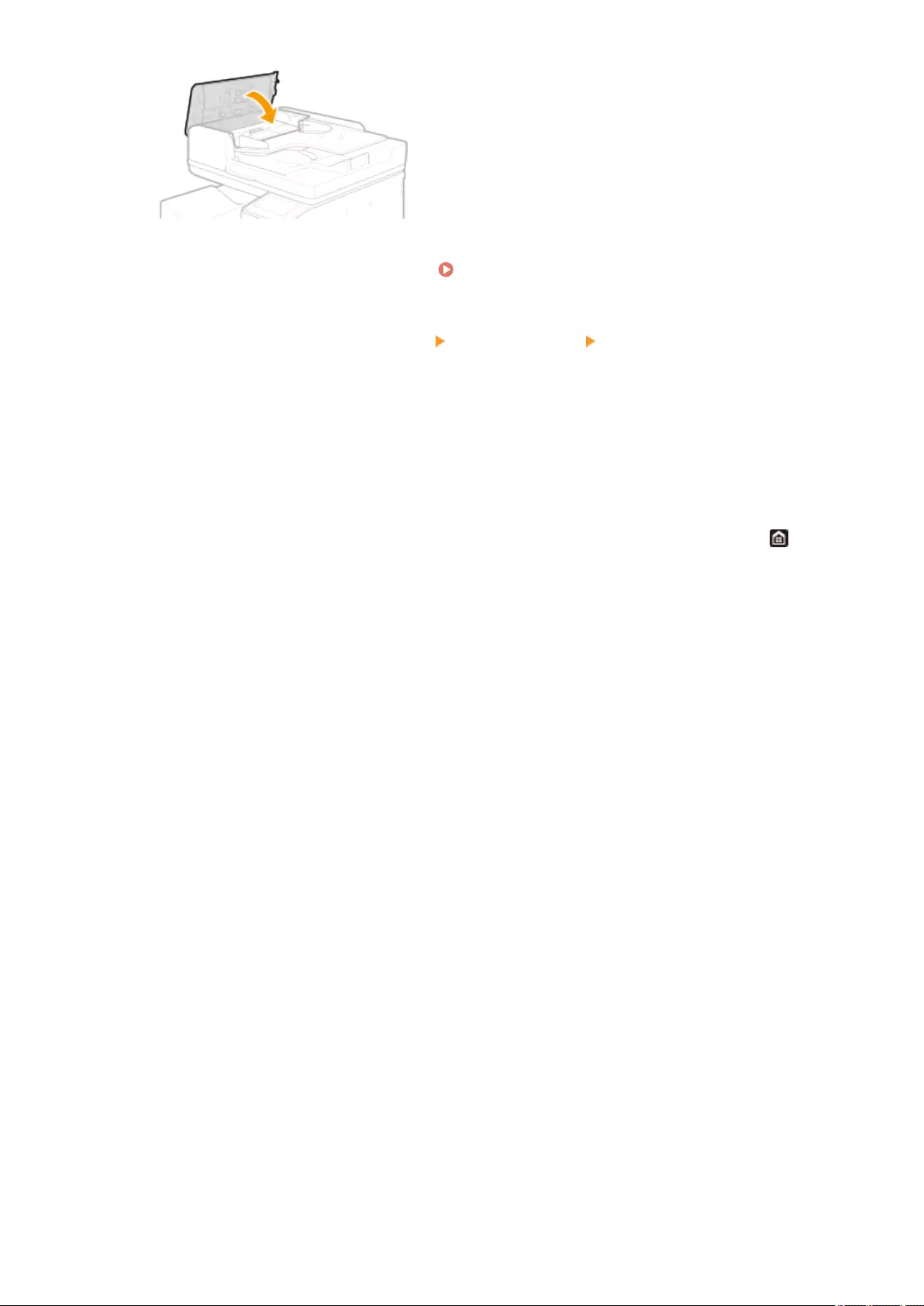
4Select <Menu> in the Home screen. Home Screen(P. 120)
5Select <Adjustment/Maintenance> <Maintenance> <Initialize After Replacing
Parts>.
6Select <ADF Maintenance Kit>.
7Select <Yes>.
➠Initialization begins. When a message appears indicating that initialization is complete, press to return
to the Home screen.
Maintenance
548
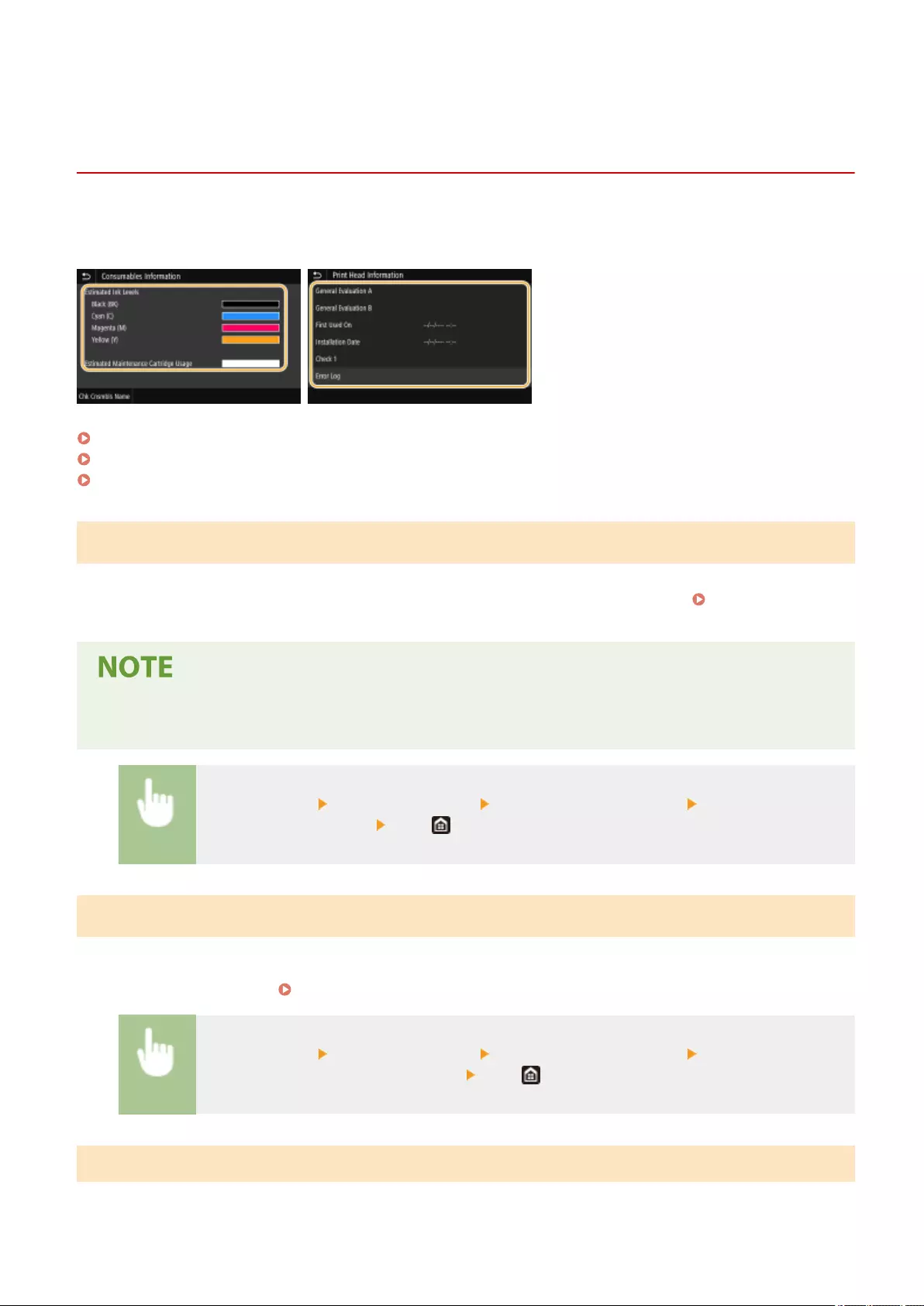
Checking Remaining Amounts and Usage of
Consumables
2579-0J5
You can check estimated remaining amount of ink, estimated space used in the maintenance cartridge, and print head
usage with the procedure below.
Checking the Ink Level(P. 549)
Checking the Space Used in the Maintenance Cartridge(P. 549)
Checking Print Head Usage(P. 549)
Checking the Ink Level
It is recommended that you check the ink level before performing a large job to determine whether you need to
prepare new ink tanks. You can also check the remaining amounts of ink from the Remote UI. Remote UI
Screen(P. 409)
●If ink runs out during printing, printing stops temporarily. Follow the instructions on the screen to replace
ink tanks, and printing resumes.
<Status Monitor> <Device Information> <Consumables Information> Check the amount
remaining in the ink tanks Press
Checking the Space Used in the Maintenance Cartridge
It is recommended that you check the space used in the maintenance cartridge before performing a large job to
determine whether or not to prepare a new maintenance cartridge. You can also check the usage of the maintenance
cartridge from the Remote UI. Remote UI Screen(P. 409)
<Status Monitor> <Device Information> <Consumables Information> Check the space
remaining in the maintenance cartridge Press
Checking Print Head Usage
Maintenance
549

You can check usage of the print head. You can also check the replacement rank for the ink tanks and maintenance
cartridge. You can also check usage of the print head from the Remote UI. Remote UI Screen(P. 409)
<Status Monitor> <Device Information> <Print Head Information> Check the usage of the
print head Press
LINKS
Replacing the Ink Tanks(P. 528)
Replacing the Maintenance Cartridge(P. 532)
Replacing the Print Head(P. 536)
Consumables(P. 625)
Maintenance
550
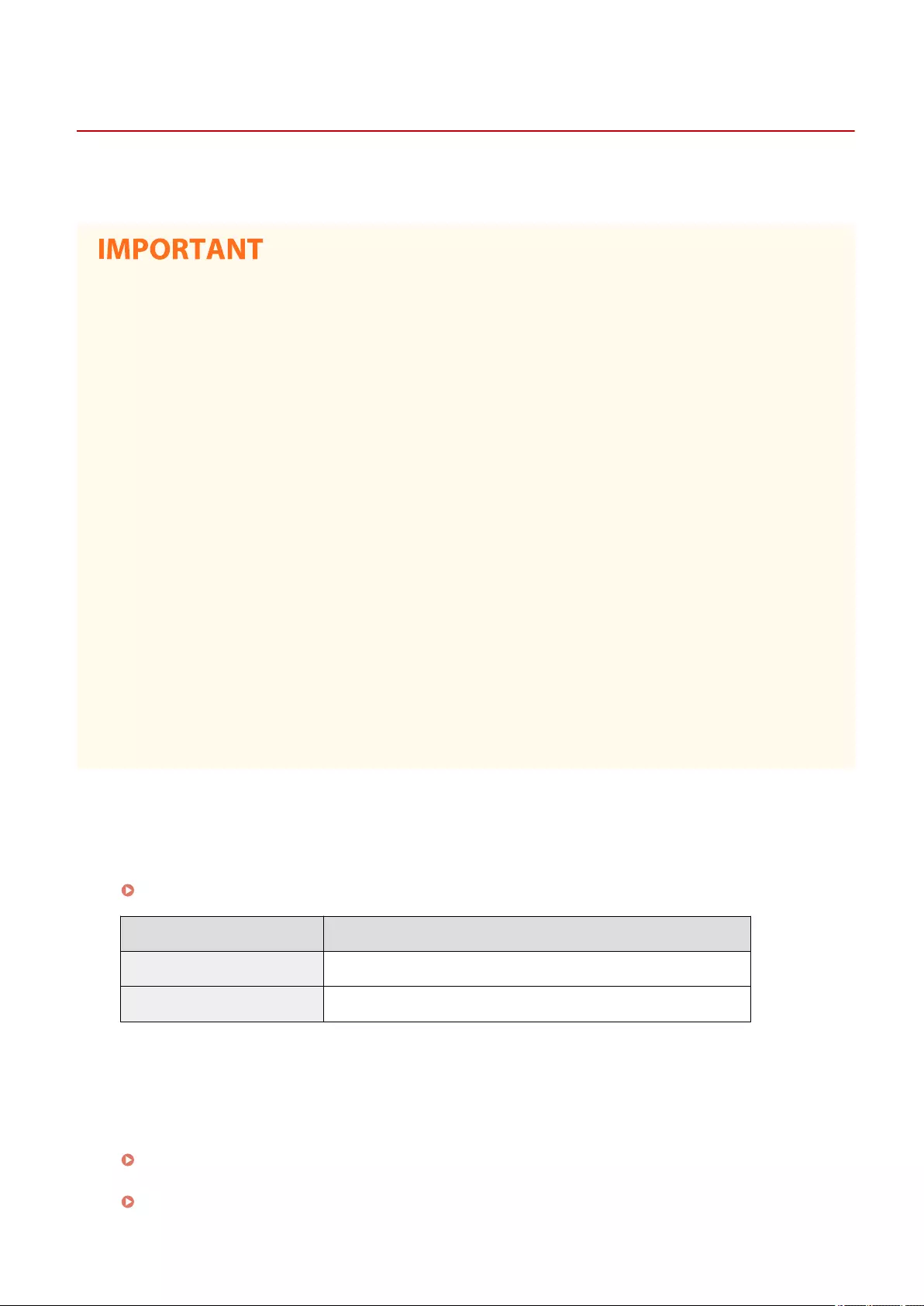
Transporting the Machine
2579-09S
The machine is heavy. To prevent injury or other accident as well as protect the internal mechanisms, be sure to follow
the procedure below when transporting the machine.
Precautions regarding the machine before lending, requesting repair, or
transferal
●If you tilt the printer or turn it on its side or upside down, ink may leak.
For this reason, when transporting the printer, to prevent the ink leakage, the ink in the printer and a certain
amount of ink in the ink tanks need to be ejected into the maintenance cartridge.
If the maintenance cartridge does not have the remaining capacity enough for ejected ink, you need to
replace it with a new one.
Replacement of the ink tanks and maintenance cartridge may be necessary at any time while the machine is
processing before being transported.
Prepare a plastic bag to put used consumables in beforehand.
If replacement of the maintenance cartridge is not possible, printer transport preparation cannot be
executed.
We recommend you to prepare maintenance cartridges before executing printer transport preparation.
However, the maintenance cartridge removed for printer transport preparation may still have the remaining
capacity for printing.
In such cases, the removed maintenance cartridge can be reinstalled for use.
Taping the side covers and other parts is also required before transporting the machine. Have tape ready
beforehand.
When you rst use the printer after executing printer transport preparation, a certain amount of ink is
consumed to set up the printer for printing. This also uses the maintenance cartridge.
●If an error occurs indicating the amount of ink is unknown, the <Preparation for Transporting> menu cannot
be run.
◼When you are able to move the machine on casters keeping it level with the ground
If an optional cassette feeding unit is installed, you can move the machine on casters in the following instances.
When Transporting the Machine on Casters Keeping It Level with the Ground(P. 553)
Instances of moving the machine Examples
Indoors on the same oor On casters (angle of tilt: no more than 5 degrees)
Indoors to a different oor On casters and using an elevator (angle of tilt: no more than 5 degrees)
◼If you might need to tilt the machine during transport
When you tilt the machine or use a vehicle to transport it, perform <Preparation for Transporting> from the
menu rst.
When Machine May Tilt during Transport (No Long-Period Storage of 6 Months or More after Transport)
(P. 555)
When Machine May Tilt during Transport (Long-Period Storage of 6 Months or More after Transport)
(P. 564)
Maintenance
551
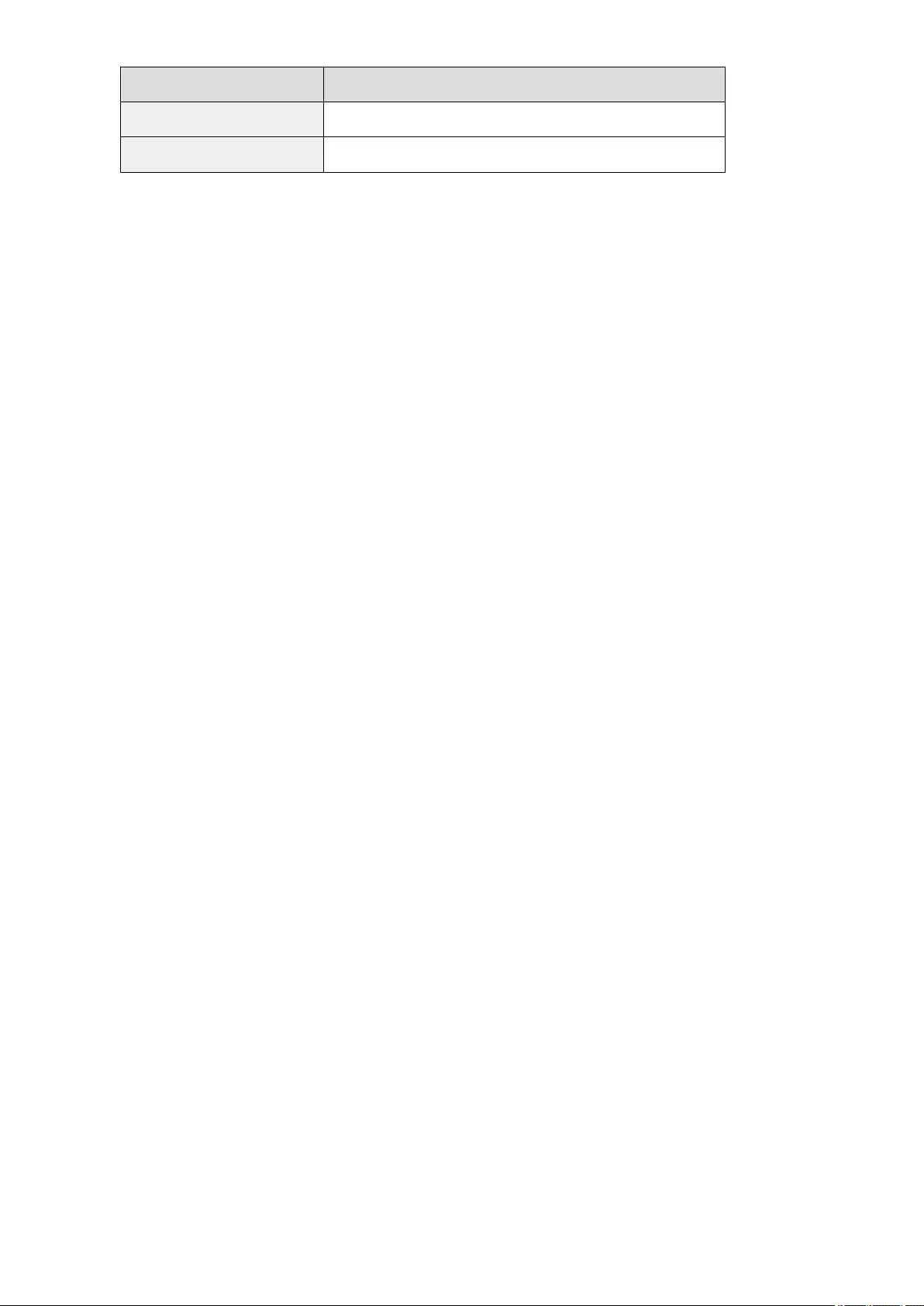
Instances of moving the machine Examples
Indoors to a different oor Tilted, and using stairs, etc. (angle of tilt: no more than 40 degrees)
To outdoor Transport by vehicle (angle of tilt: no more than 40 degrees)
When a cassette feeding unitis not installed, move the machine using the same method as when it is tilted.
Maintenance
552
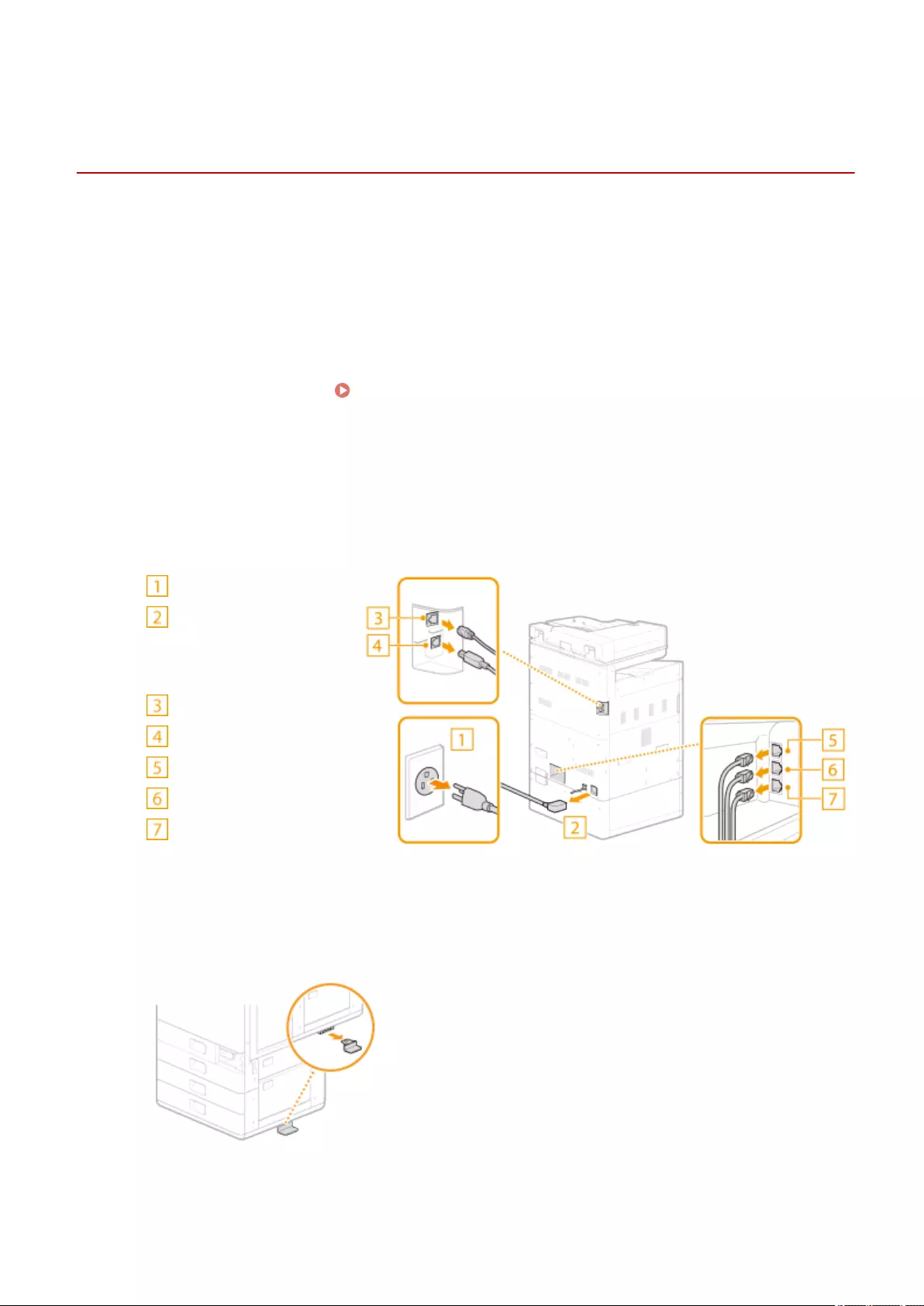
When Transporting the Machine on Casters Keeping It
Level with the Ground
2579-0JE
When transporting the machine on casters keeping it level with the ground, use the casters on an optional cassette
feeding unit.
1Remove any paper.
●Remove all paper from the paper drawers and the multi-purpose tray.
2Turn OFF the machine. Turning OFF the Machine(P. 115)
3Disconnect the cables and cord from the machine in numerical order as in the
illustration below.
●The shape of the power plug (*1) depends on your country or region.
●Whether the cables with "*2" are connected depends on your environment.
Power plug*1
Power cord
Unfasten the power cord
clamp and remove the
power cord.
LAN cable*2
USB cable*2
Handset*2
External telephone*2
Telephone cable*2
4Remove the stabilizer from the right side of the cassette feeding unit.
●The braces are required after transporting the machine. Do not dispose and store safely.
5Turn and raise the support on the bottom of the cassette feeding unit in the
direction shown.
Maintenance
553

6Move the machine.
Once the machine has been transported and you are preparing to use it again, install the machine in the
reverse steps to above.
Maintenance
554
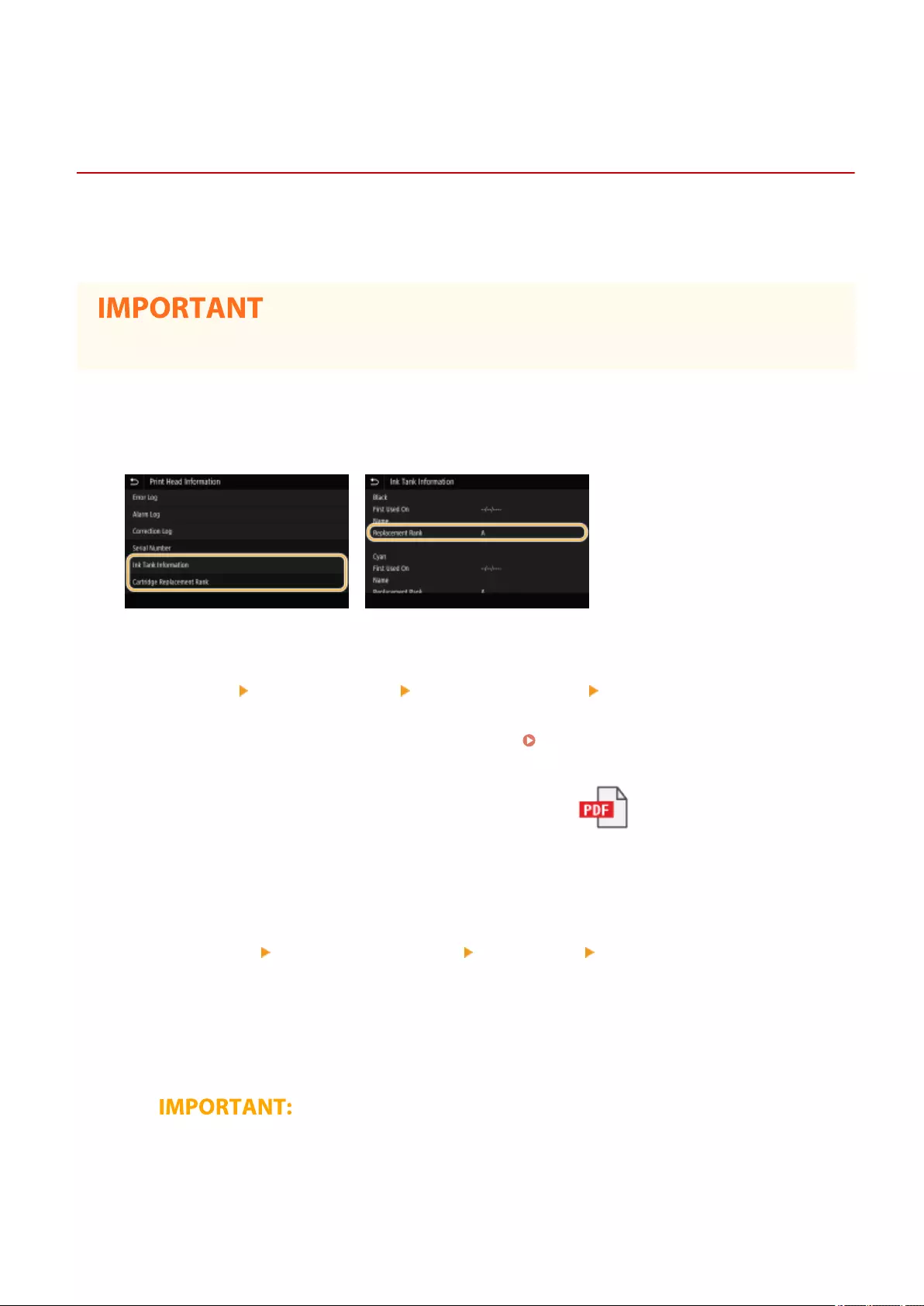
When Machine May Tilt during Transport (No Long-
Period Storage of 6 Months or More after Transport)
2579-0JF
The method for transporting the machine differs with whether the machine will be used within 6 months after
transport or stored for more than 6 months without use after the machine has been transported. If the machine will
be used within 6 months, operate the machine as follows before transport.
●Be careful that the tilt angle while being transported is no more than 40 degrees.
1Check and prepare the required number of ink tank and maintenance cartridge
replacements.
You can check information on the required number of ink tank and maintenance cartridge replacements at
<Replacement Rank> in <Print Head Information>.
<Status Monitor> <Device Information> <Print Head Information> <Ink Tank Information>
After reinstalling the machine after transport, consumables are required according to their replacement rank.
Print out a report of the print head information you checked. Printing Reports on the Usage Condition of
the Machine(P. 624)
The required number is different for each replacement rank. Refer to for replacement rank and
required number of replacements.
2Check for a print head locking rod.
1Select <Menu> <Adjustment/Maintenance> <Maintenance> <Maintenance Cartridge
Replacement> in the Home screen.
2Select <Unlock>, and when the screen changes, open the front cover.
3Check that the print head locking rod is present.
4Close the front cover.
●If the print head locking rod is not present, contact your dealer or the service center and again obtain
a print head locking rod. Transporting the machine without a print head locking rod will result in
malfunction.
Maintenance
555
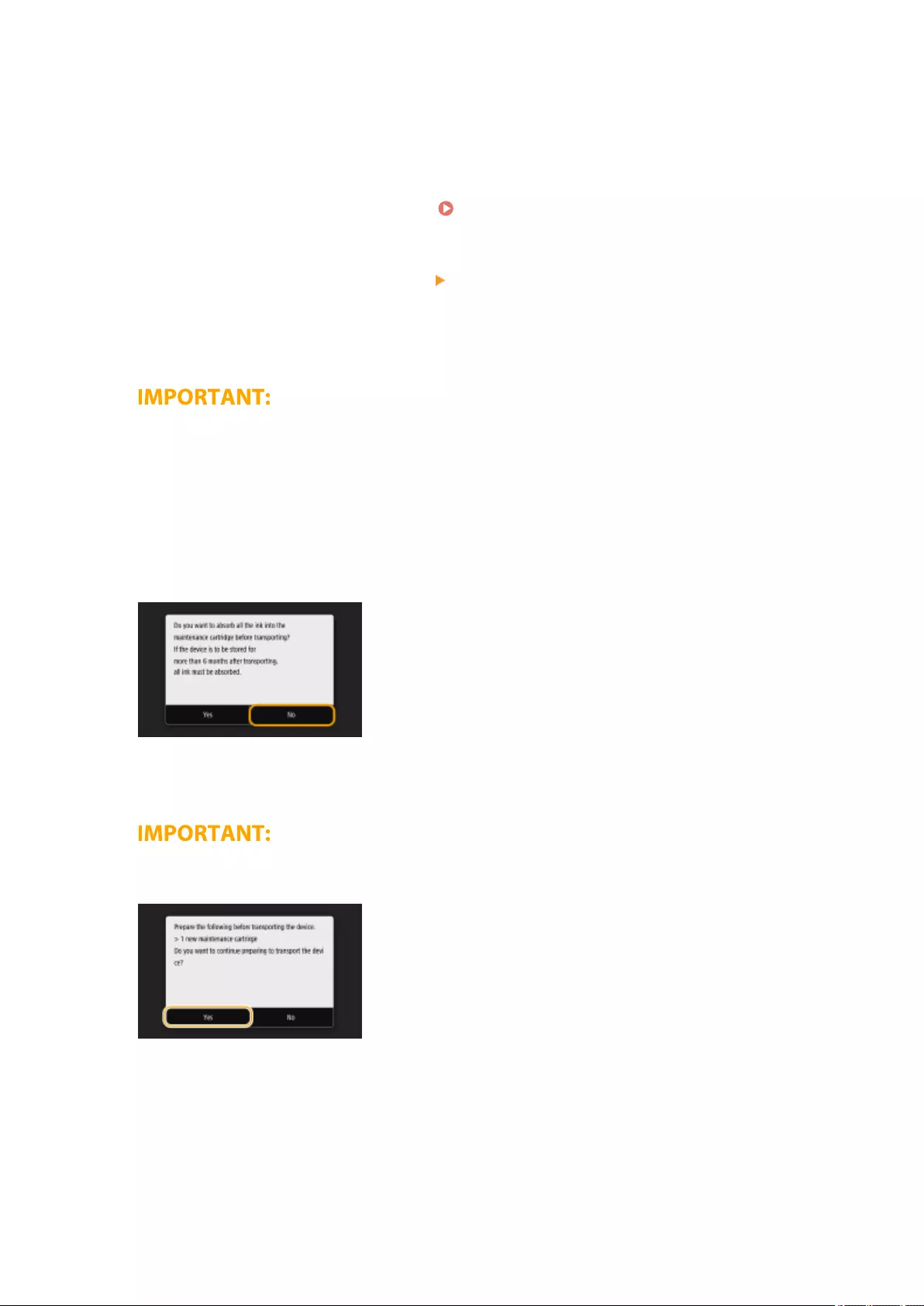
3Remove any paper.
●Remove all paper from the paper drawers and multi-purpose tray.
4Select <Menu> in the Home screen. Home Screen(P. 120)
5Select <Adjustment/Maintenance> <Maintenance>.
6Select <Preparation for Transporting>.
●If an error occurs indicating the amount of ink is unknown, the <Preparation for Transporting> menu
cannot be run.
7Enter <System Manager ID> and <PIN>, and select <Log In>.
8Check the message, and select <No>.
9Check the message, and select <Yes>.
●Once you have begun preparation to transport the machine, it cannot be halted. If no consumables
replacements are ready, do not start preparation.
10 When the screen for checking presence of a print head locking rod appears, select
<No>.
●The machine begins preparation for transport. Preparation takes 15 to 20 minutes.
11 In the screen for selecting to initialize settings, select <Yes> or <No>.
Maintenance
556

●By selecting <Yes>, restores all data including logs and setting values to their default settings at time of
purchase. Select this at times such as when the user of the machine changes.
12 Select <Unlock>.
13 When <Open Front Cover> is displayed, open the front cover.
14 Remove the maintenance cartridge. Replacing the Maintenance Cartridge(P. 532)
●Place the maintenance cartridge in a plastic bag, and close rmly to prevent ink from spilling out.
15 Remove the handhold cover.
16 Close the front cover.
17 Select <Unlock>.
18 When <Open Front Cover> is displayed, open the front cover
19 Attach the print head locking rod.
●Remove the print head locking rod stowed in the machine ( Interior(P. 108) ), and insert it in the slot.
Maintenance
557
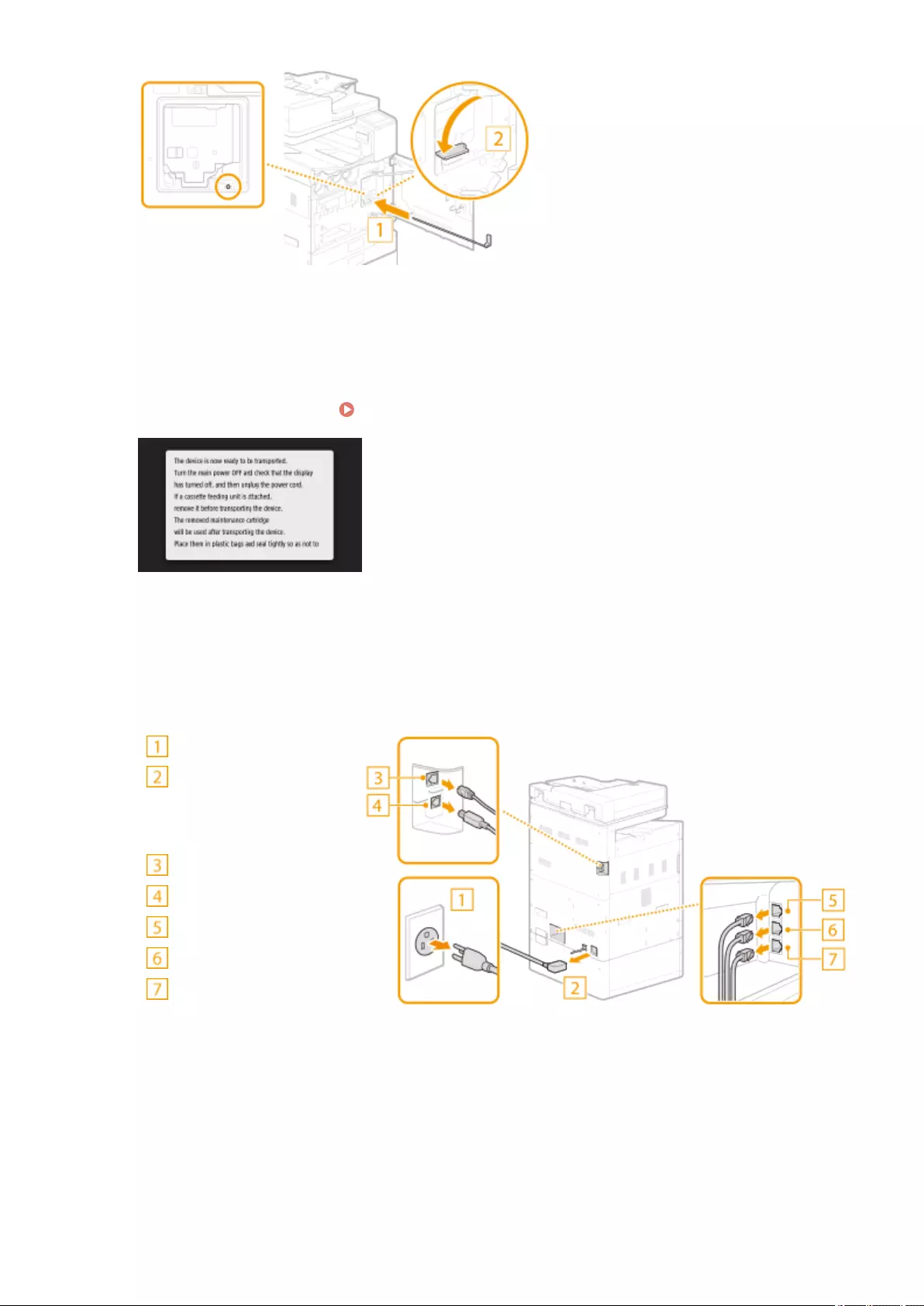
●After pushing it all the way, lower the lever to the left.
20 Close the front cover.
21 Turn OFF the machine. Turning OFF the Machine(P. 115)
22 Disconnect the cables and cord from the machine in numerical order as in the
illustration below.
●The shape of the power plug (*1) depends on your country or region.
●Whether the cables with "*2" are connected depends on your environment.
Power plug*1
Power cord
Unfasten the power cord
clamp and remove the
power cord.
LAN cable*2
USB cable*2
Handset*2
External telephone*2
Telephone cable*2
23 Remove the book holder.
Maintenance
558
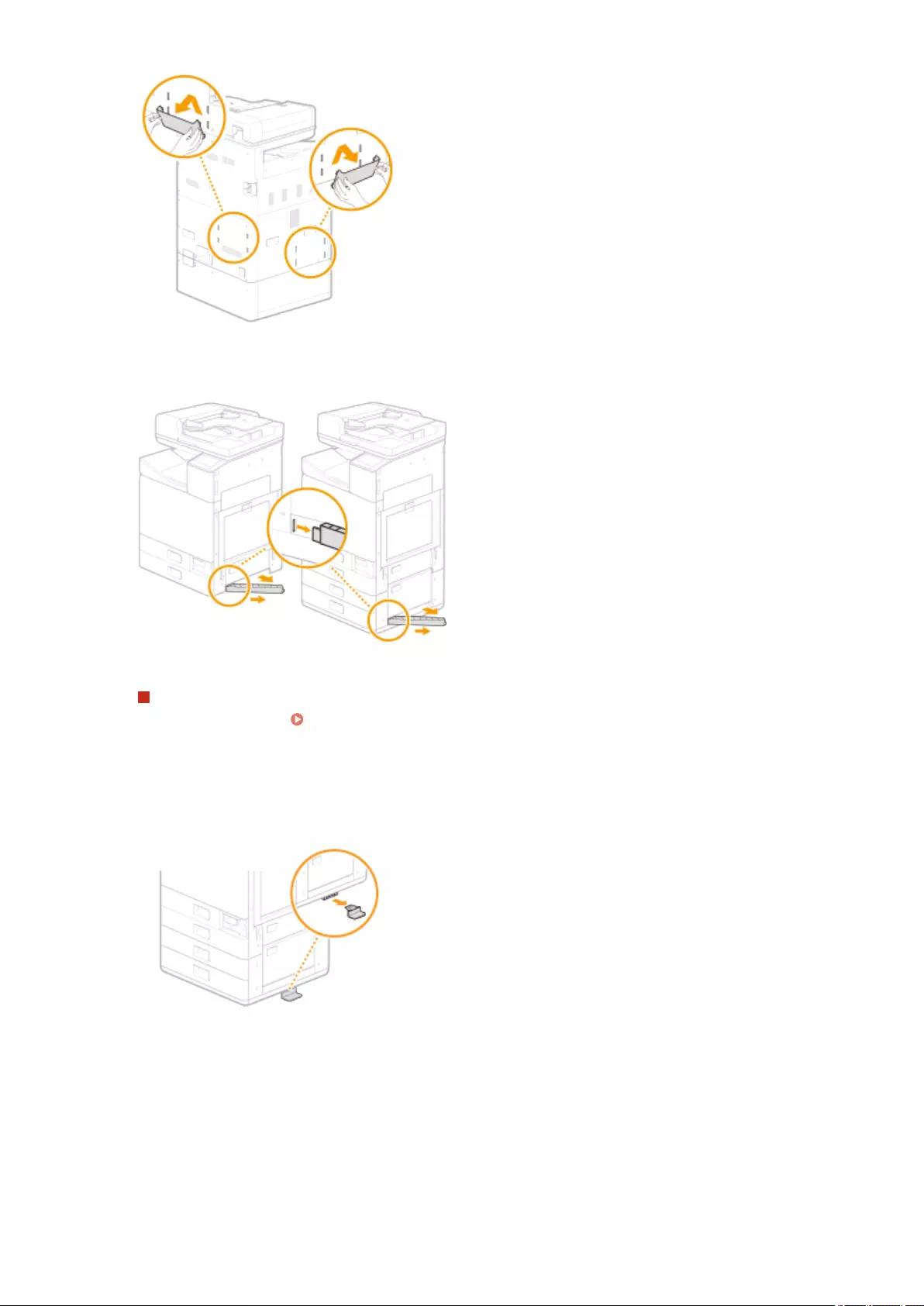
24 Remove the paper drawer cover.
If an optional cassette feeding unit is installed.
The machine is heavy ( Other Specications(P. 724) ). Using the handholds, be sure to lift with 4 people.
1Remove the stabilizer from the right side of the cassette feeding unit.
●The stabilizer will also be required after transporting the machine. Do not discard and store in a safe
place.
2Pull out paper drawer 3 slightly.
Maintenance
559
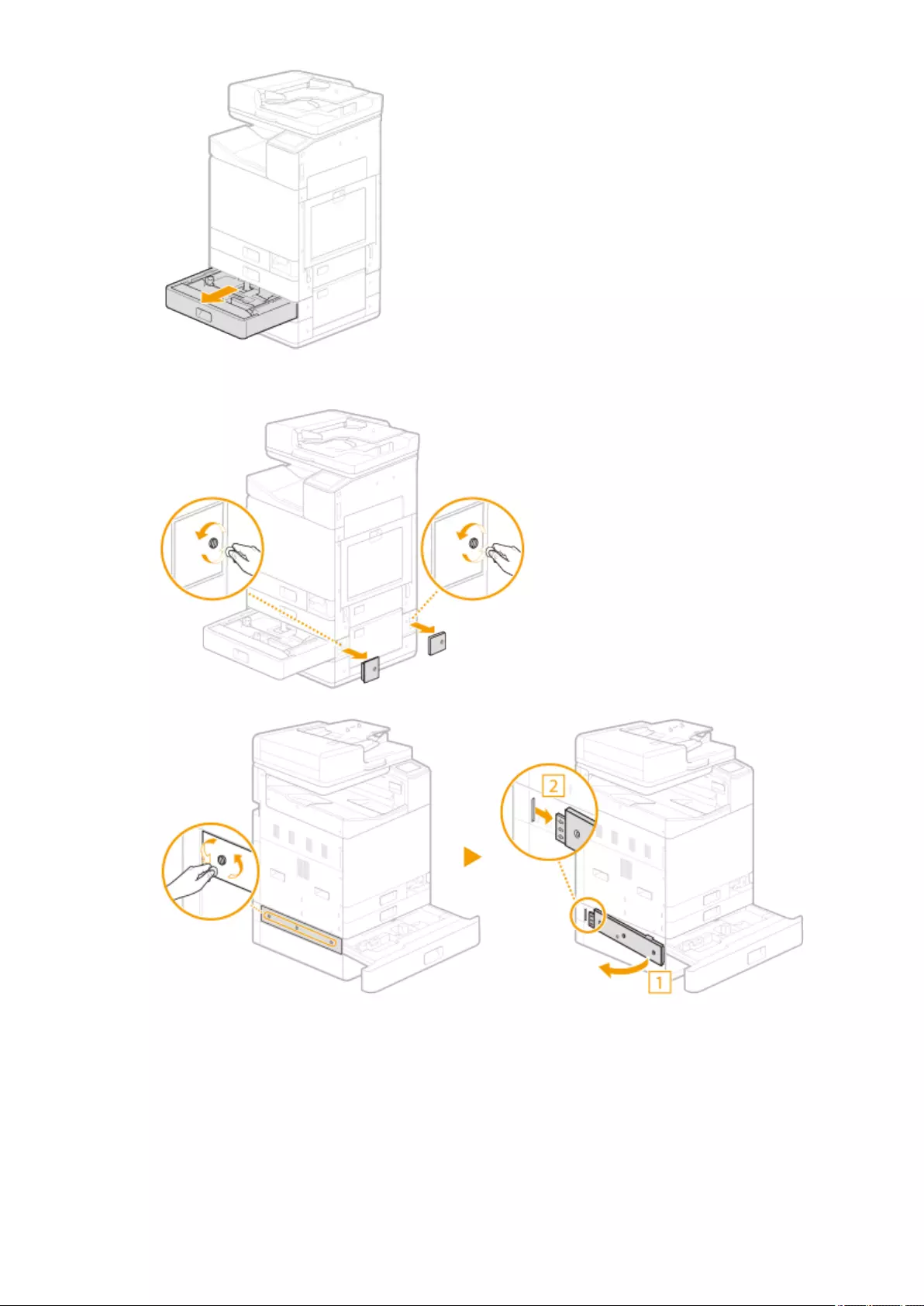
3Turn the screws fastening the machine and the cassette feeding unit and remove the pedestal cover.
Front of main unit
Left of main unit
4Close paper drawer 3.
5Remove the connector cover from the main unit and cassette feeding unit, and remove the cassette
feeding unit connector.
Maintenance
560
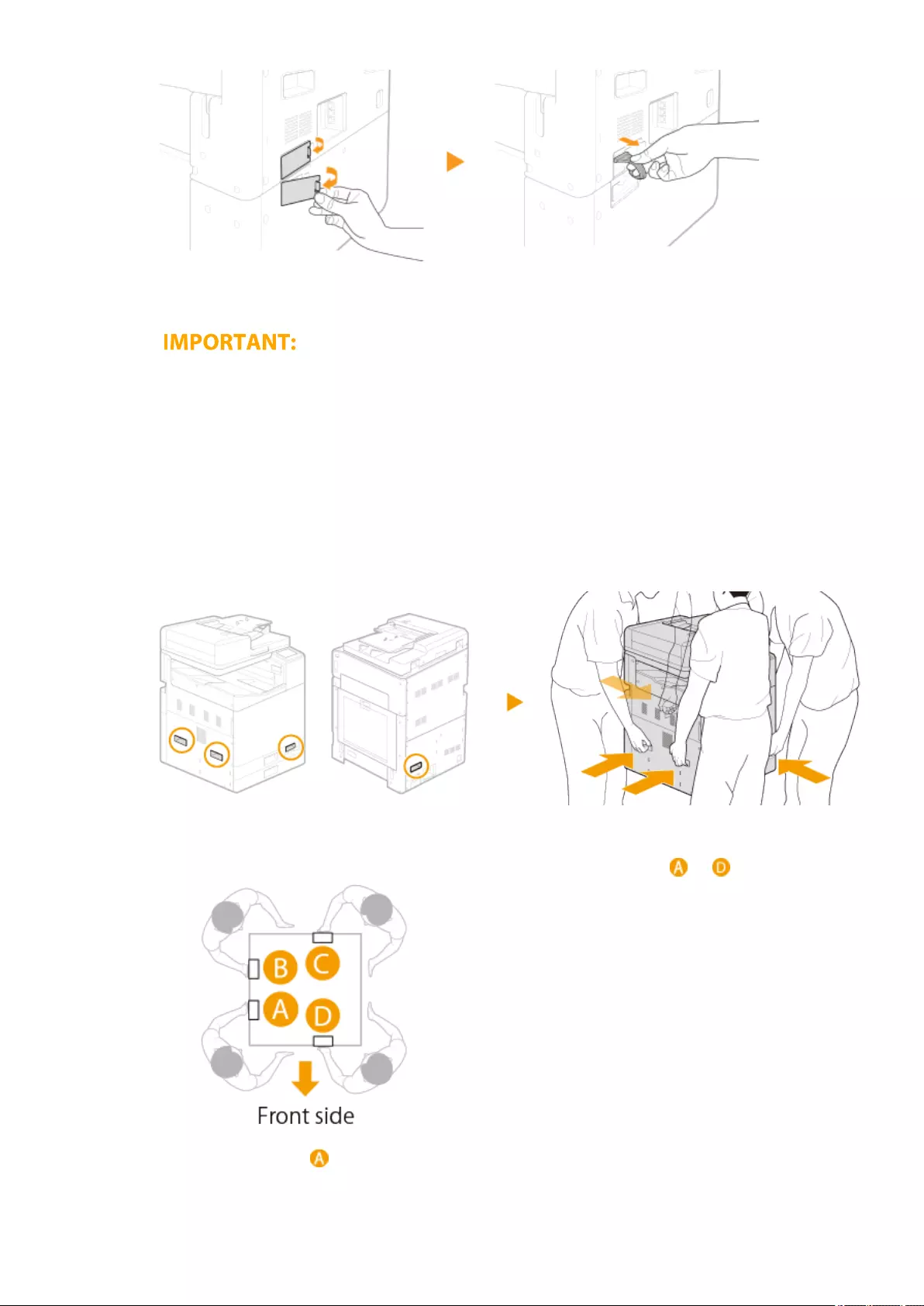
6Use the handholds to remove the main unit.
When transporting the machine
●To transport the machine, be sure to lift with four people holding the machine by the handholds at
four locations, being careful not to injure backs, etc. See below for handhold locations and how to
grip.
●Never hold the machine by the feeder, paper cassettes, etc. The machine could be dropped and cause
injury.
●Do not hold the machine by its bottom. Also, be careful not to get ngers caught when placing the
machine.
●Handhold locations
●How to grip
●Stand at the corners of the machine, and grasp with each of handholds to .
●Grasp handhold with left hand, and support with right hand
Maintenance
561
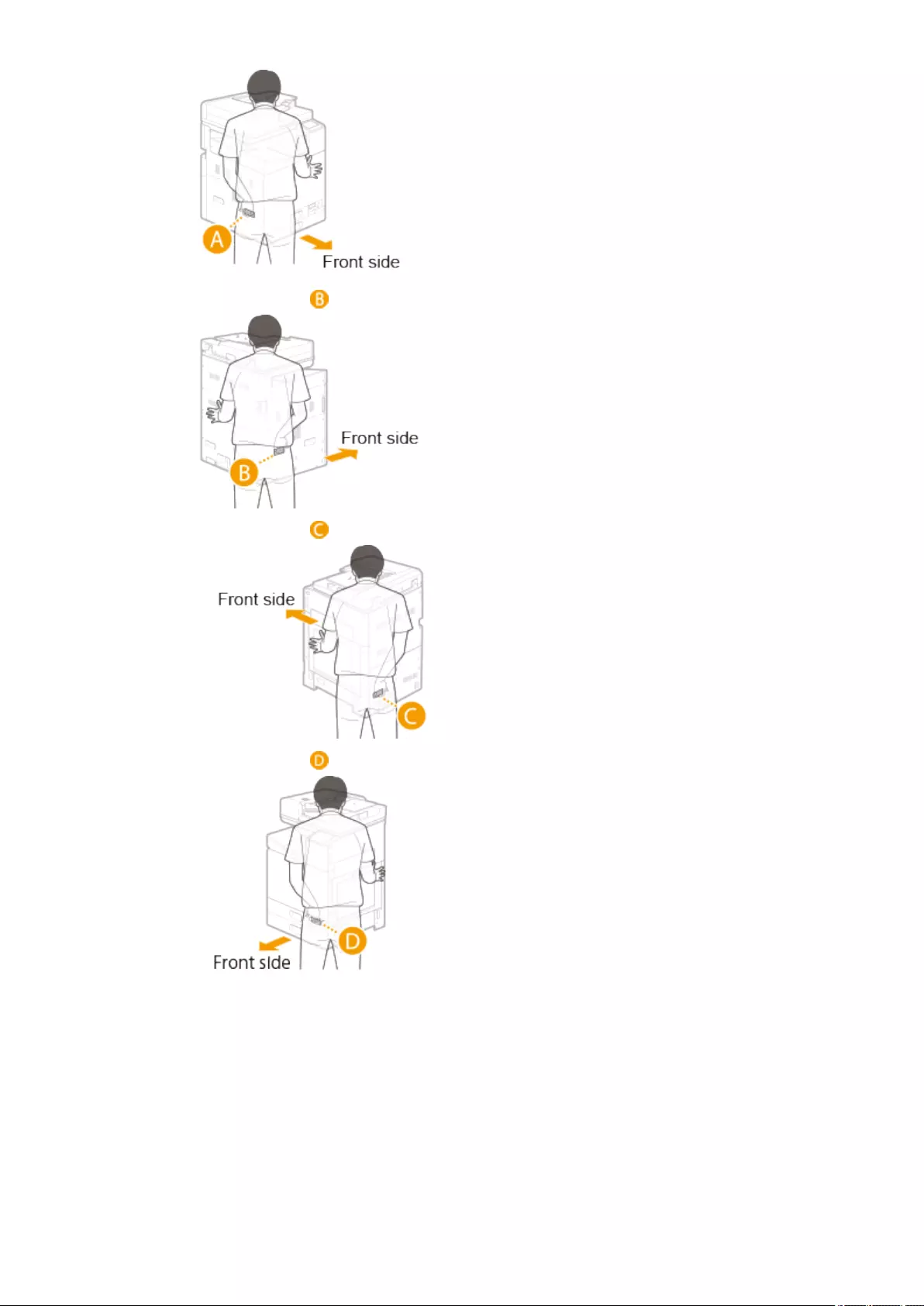
●Grasp handhold with right hand, and support with left hand
●Grasp handhold with right hand, and support with left hand
●Grasp handhold with left hand, and support with right hand
25 Bundle the machine.
●Tape the 3 locations on the right side of the machine in an "H" shape as shown below.
Maintenance
562
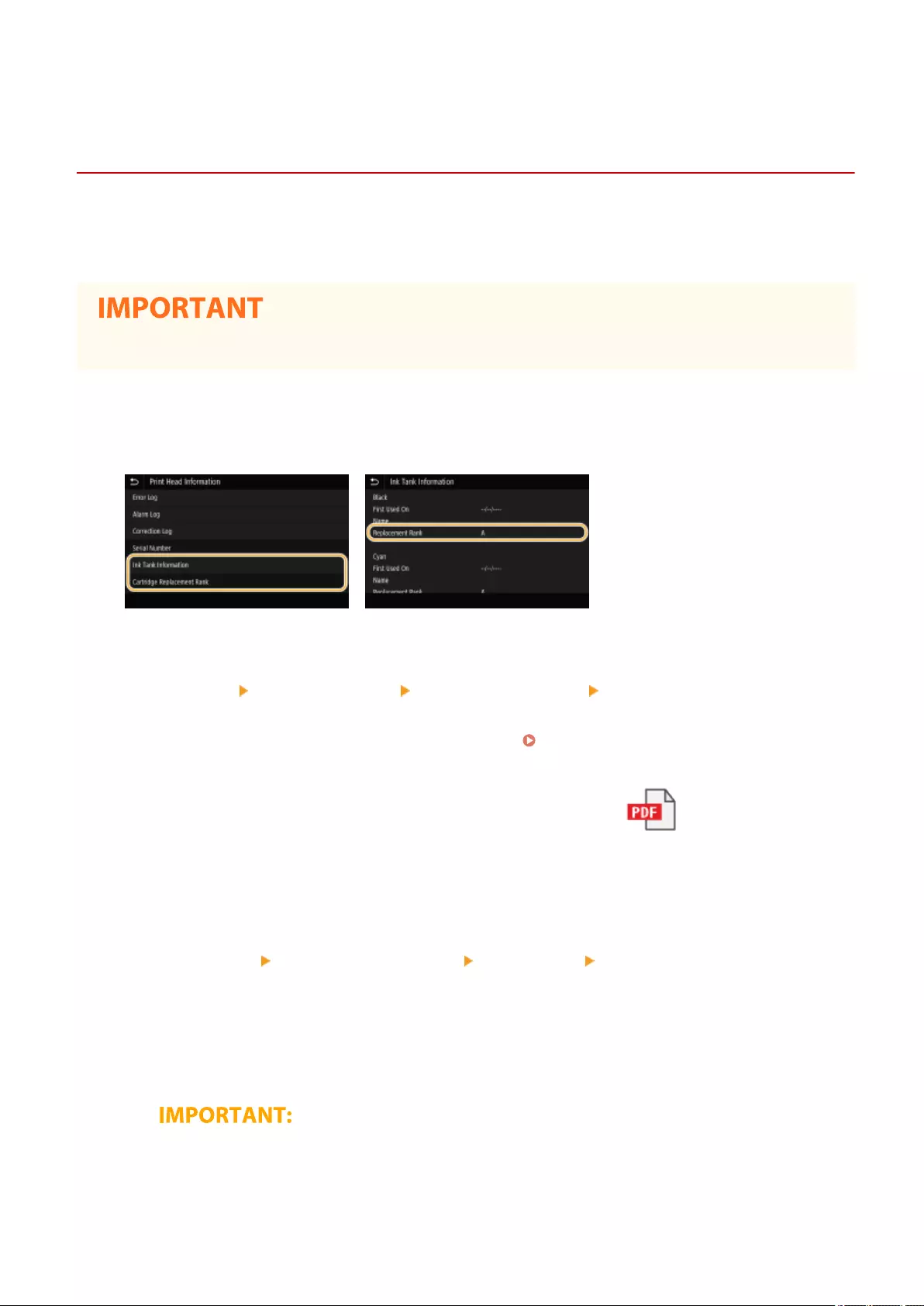
When Machine May Tilt during Transport (Long-Period
Storage of 6 Months or More after Transport)
2579-0JH
The method for transporting the machine differs with whether the machine will be used within 6 months after
transport or stored for more than 6 months without use after the machine has been transported. If the machine will
be stored for more than 6 months, operate the machine as follows before transport.
●Be careful that the tilt angle while being transported is no more than 40 degrees.
1Check and prepare the required number of ink tank and maintenance cartridge
replacements.
You can check information on the required number of ink tank and maintenance cartridge replacements at
<Replacement Rank> in <Print Head Information>.
<Status Monitor> <Device Information> <Print Head Information> <Ink Tank Information>
After reinstalling the machine after transport, consumables are required according to their replacement rank.
Print out a report of the print head information you checked. Printing Reports on the Usage Condition of
the Machine(P. 624)
●The required number is different for each replacement rank. Refer to for replacement rank and
required number of replacements.
2Check for a print head locking rod.
1Select <Menu> <Adjustment/Maintenance> <Maintenance> <Maintenance Cartridge
Replacement> in the Home screen.
2Select <Unlock>, and when the screen changes, open the front cover.
3Check that the print head locking rod is present.
4Close the front cover.
●If the print head locking rod is not present, contact your dealer or the service center and again obtain
a print head locking rod. Transporting the machine without a print head locking rod will result in
malfunction.
Maintenance
564

3Remove any paper.
●Remove all paper from the paper drawers and multi-purpose tray.
4Select <Menu> in the Home screen. Home Screen(P. 120)
5Select <Adjustment/Maintenance> <Maintenance>.
6Select <Preparation for Transporting>.
●If an error occurs indicating the amount of ink is unknown, the <Preparation for Transporting> menu
cannot be run.
7Enter <System Manager ID> and <PIN>, and select <Log In>.
8Check the message, and select <Yes>.
9Check the message, and select <Yes>.
●Once you have begun preparation to transport the machine, it cannot be halted. If no consumables
replacements are ready, do not start preparation.
10 Remove the ink tanks.
1Select <Unlock>.
The front cover unlocks.
2Open the front cover.
Maintenance
565
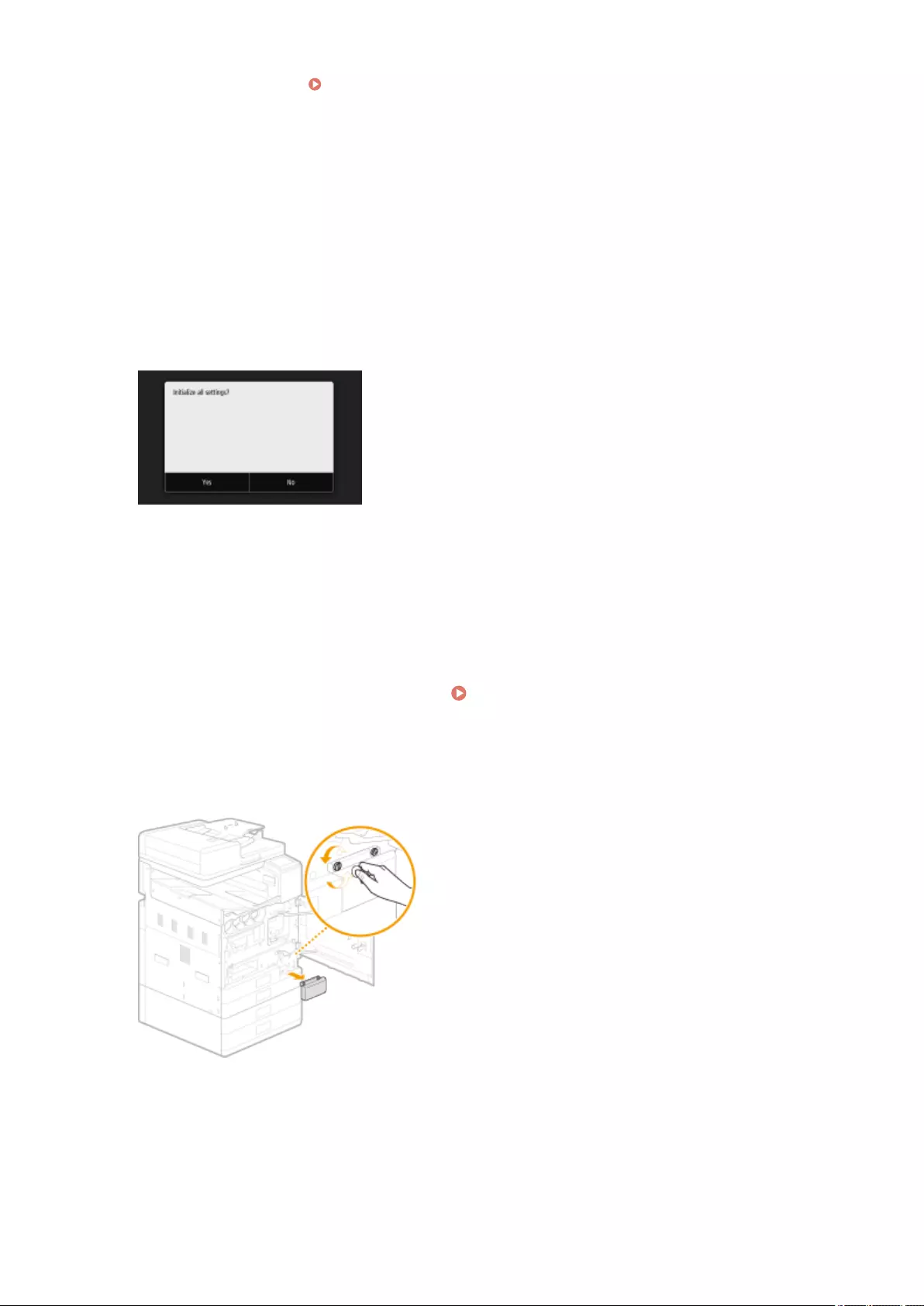
3Remove the ink tanks. Replacing the Ink Tanks(P. 528)
4Close the front cover.
11 When the screen for checking presence of a print head locking rod appears, select
<No>.
●The machine begins draining ink. Draining may take up to 50 minutes.
12 In the screen for selecting to initialize settings, select <Yes> or <No>.
●By selecting <Yes>, restores all data including logs and setting values to their default settings at time of
purchase. Select this at times such as when the user of the machine changes.
13 Select <Unlock>.
14 When <Open Front Cover> is displayed, open the front cover.
15 Remove the maintenance cartridge. Replacing the Maintenance Cartridge(P. 532)
●Place the maintenance cartridge in a plastic bag, and close rmly to prevent ink from spilling out.
16 Remove the handhold cover.
17 Close the front cover.
18 Select <Unlock>.
Maintenance
566
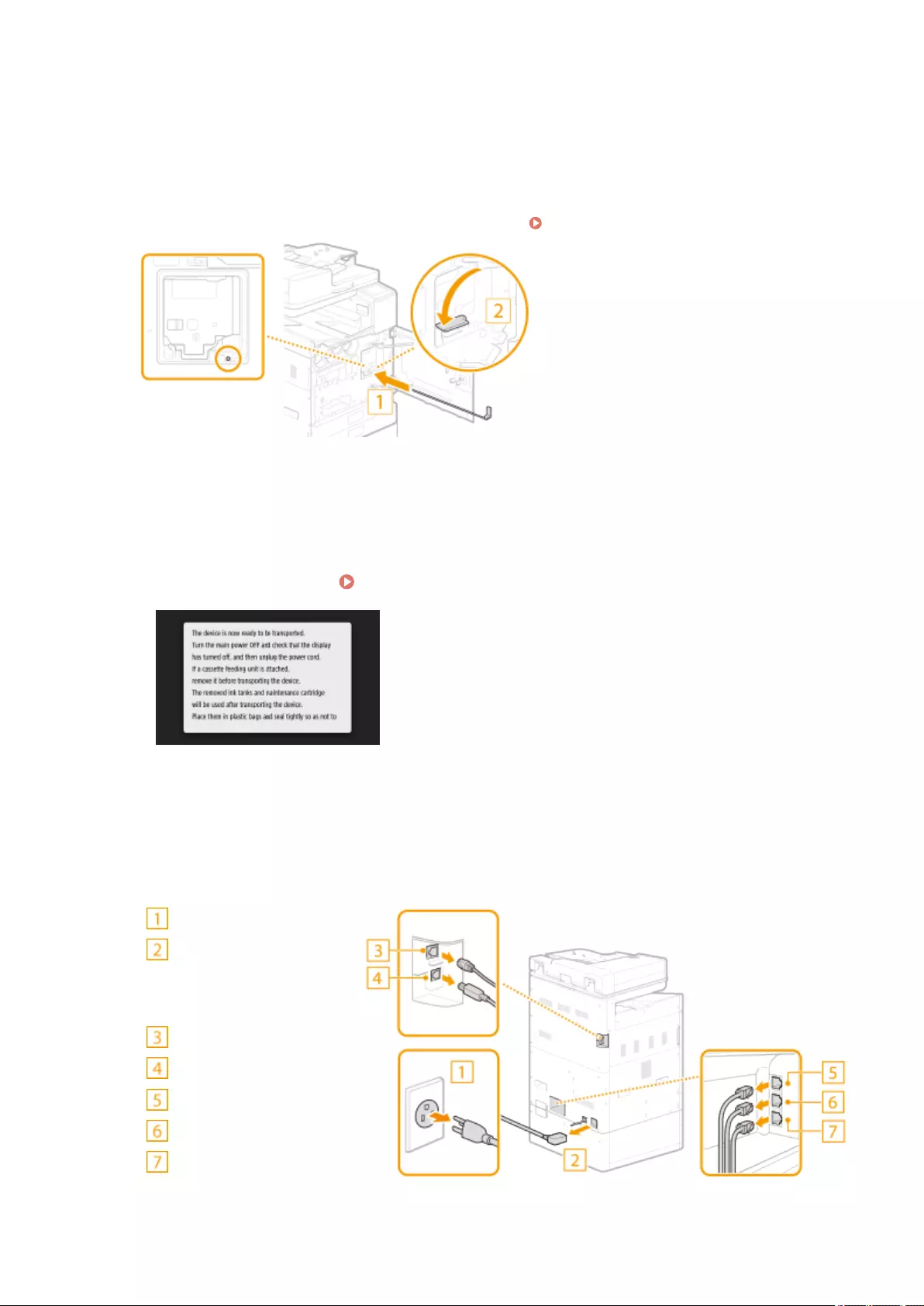
19 When <Open Front Cover> is displayed, open the front cover.
20 Attach the print head locking rod.
●Remove the print head locking rod stowed in the machine ( Interior(P. 108) ), and insert it in the slot.
●After pushing it all the way, lower the lever to the left.
21 Close the front cover.
22 Turn OFF the machine. Turning OFF the Machine(P. 115)
23 Disconnect the cables and cord from the machine in numerical order as in the
illustration below.
●The shape of the power plug (*1) depends on your country or region.
●Whether the cables with "*2" are connected depends on your environment.
Power plug*1
Power cord
Unfasten the power cord
clamp and remove the
power cord.
LAN cable*2
USB cable*2
Handset*2
External telephone*2
Telephone cable*2
Maintenance
567
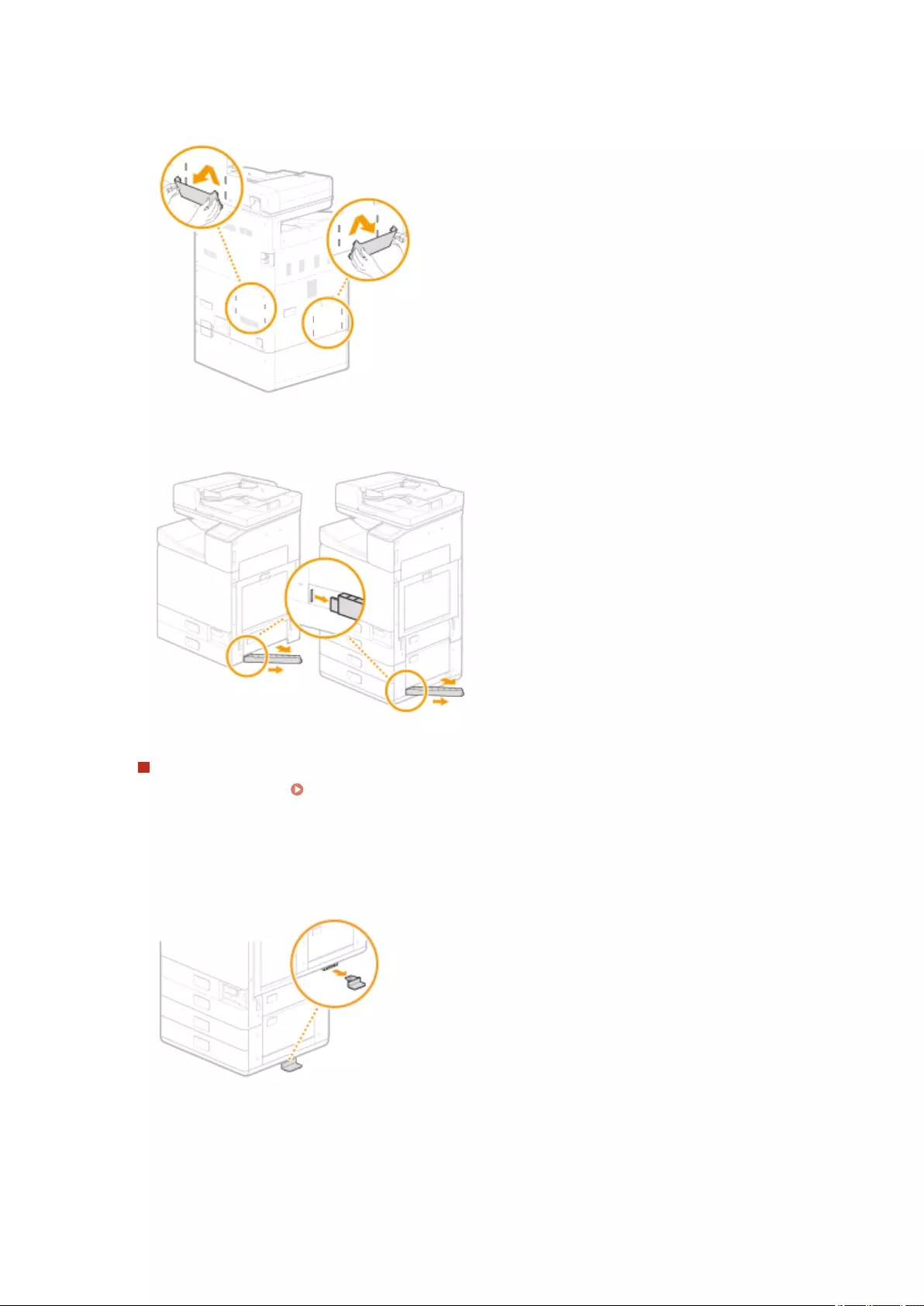
24 Remove the book holder.
25 Remove the paper drawer cover.
If an optional cassette feeding unit is installed.
The machine is heavy ( Other Specications(P. 724) ). Using the handholds, be sure to lift with 4 people.
1Remove the stabilizer from the right side of the cassette feeding unit.
●The stabilizer will also be required after transporting the machine. Do not discard and store in a safe
place.
2Pull out paper drawer 3 slightly.
Maintenance
568
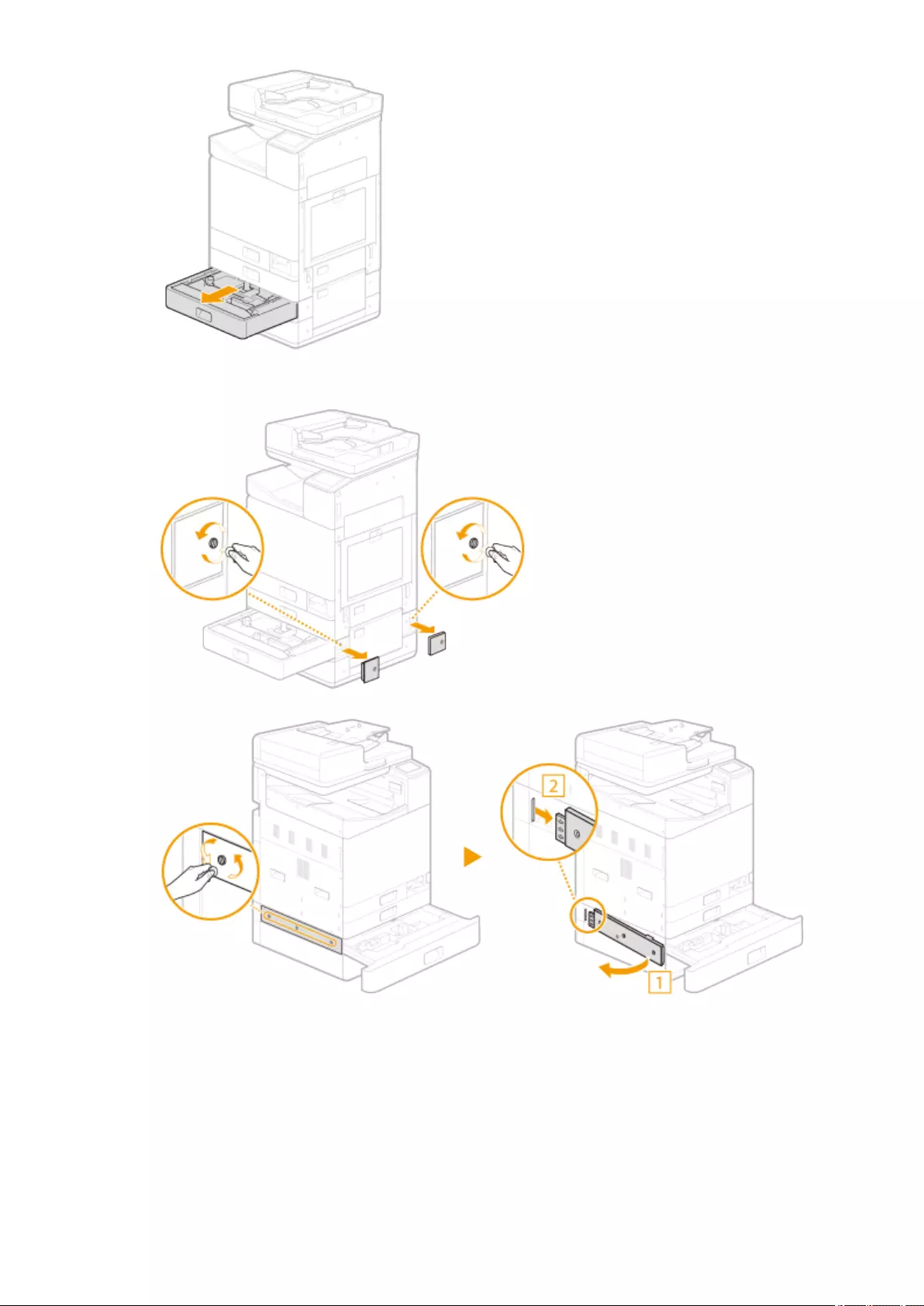
3Turn the screws fastening the machine and the cassette feeding unit and remove the pedestal cover.
Front of main unit
Left of main unit
4Close paper drawer 3.
5Remove the connector cover from the main unit and cassette feeding unit, and remove the cassette
feeding unit connector.
Maintenance
569
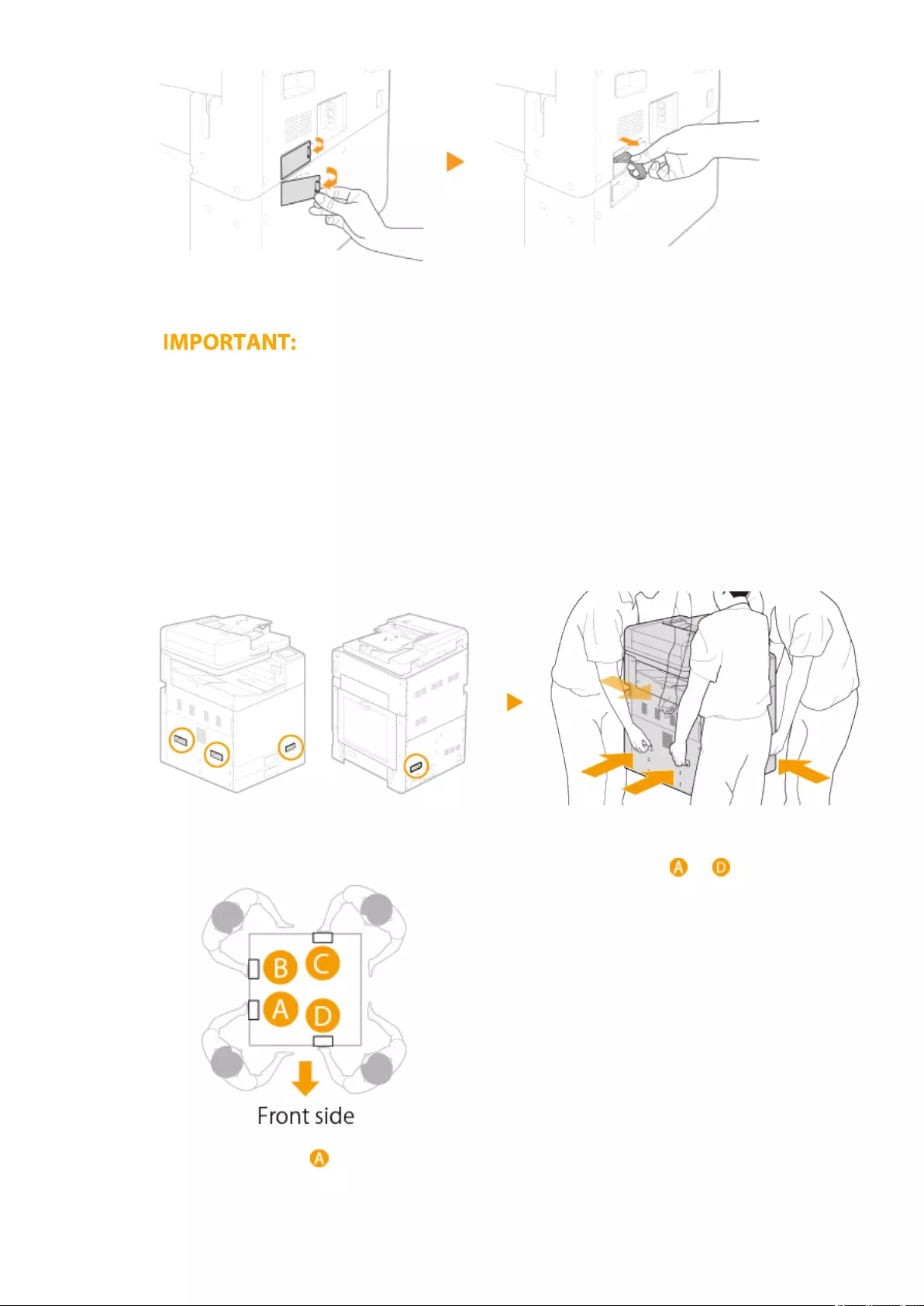
6Use the handholds to remove the main unit.
When transporting the machine
●To transport the machine, be sure to lift with four people holding the machine by the handholds at
four locations, being careful not to injure backs, etc. See below for handhold locations and how to
grip.
●Never hold the machine by the feeder, paper cassettes, etc. The machine could be dropped and cause
injury.
●Do not hold the machine by its bottom. Also, be careful not to get ngers caught when placing the
machine.
●Handhold locations
●How to grip
●Stand at the corners of the machine, and grasp with each of handholds to .
●Grasp handhold with left hand, and support with right hand
Maintenance
570
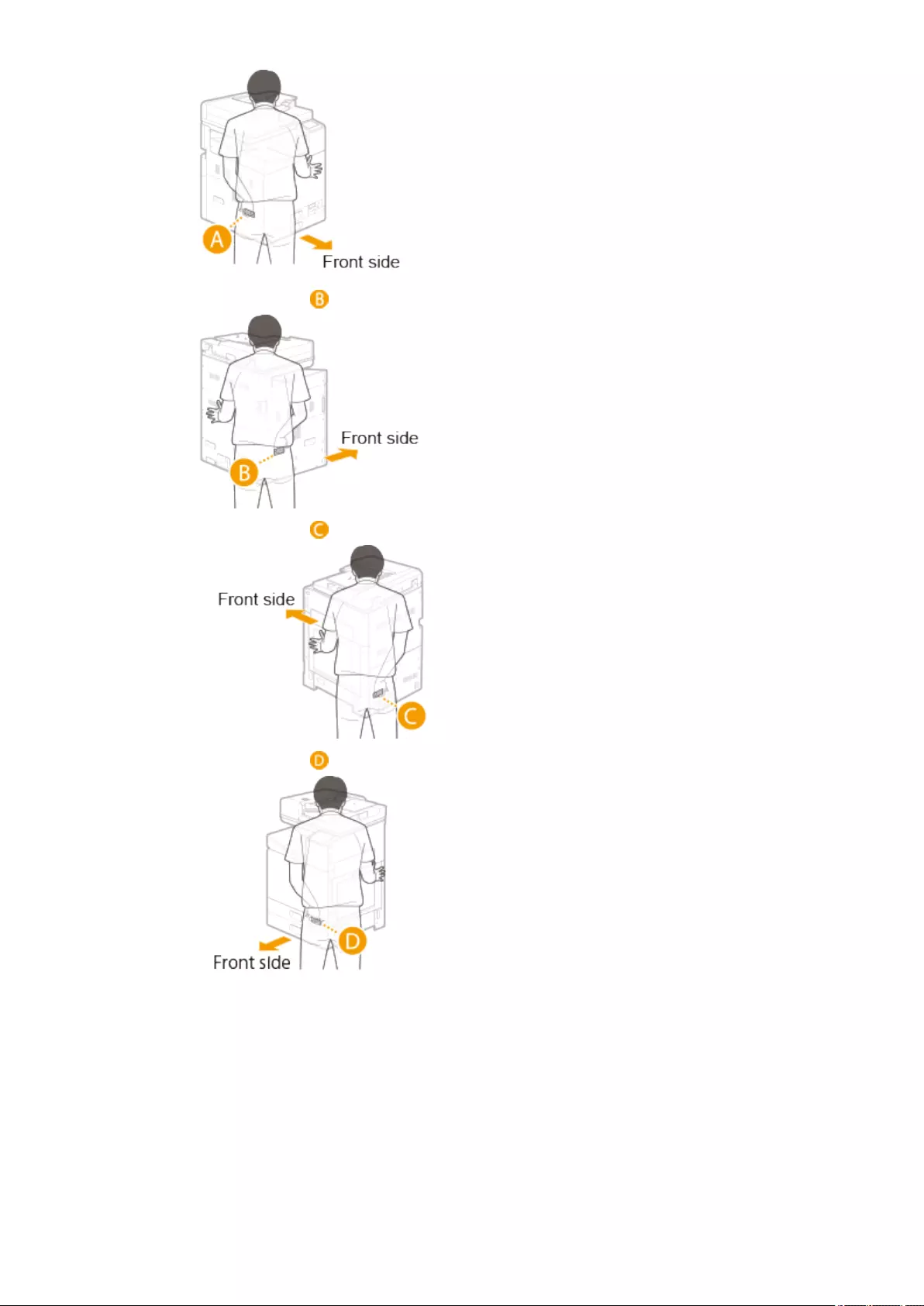
●Grasp handhold with right hand, and support with left hand
●Grasp handhold with right hand, and support with left hand
●Grasp handhold with left hand, and support with right hand
26 Bundle the machine.
●Tape the 3 locations on the right side of the machine in an "H" shape as shown below.
Maintenance
571
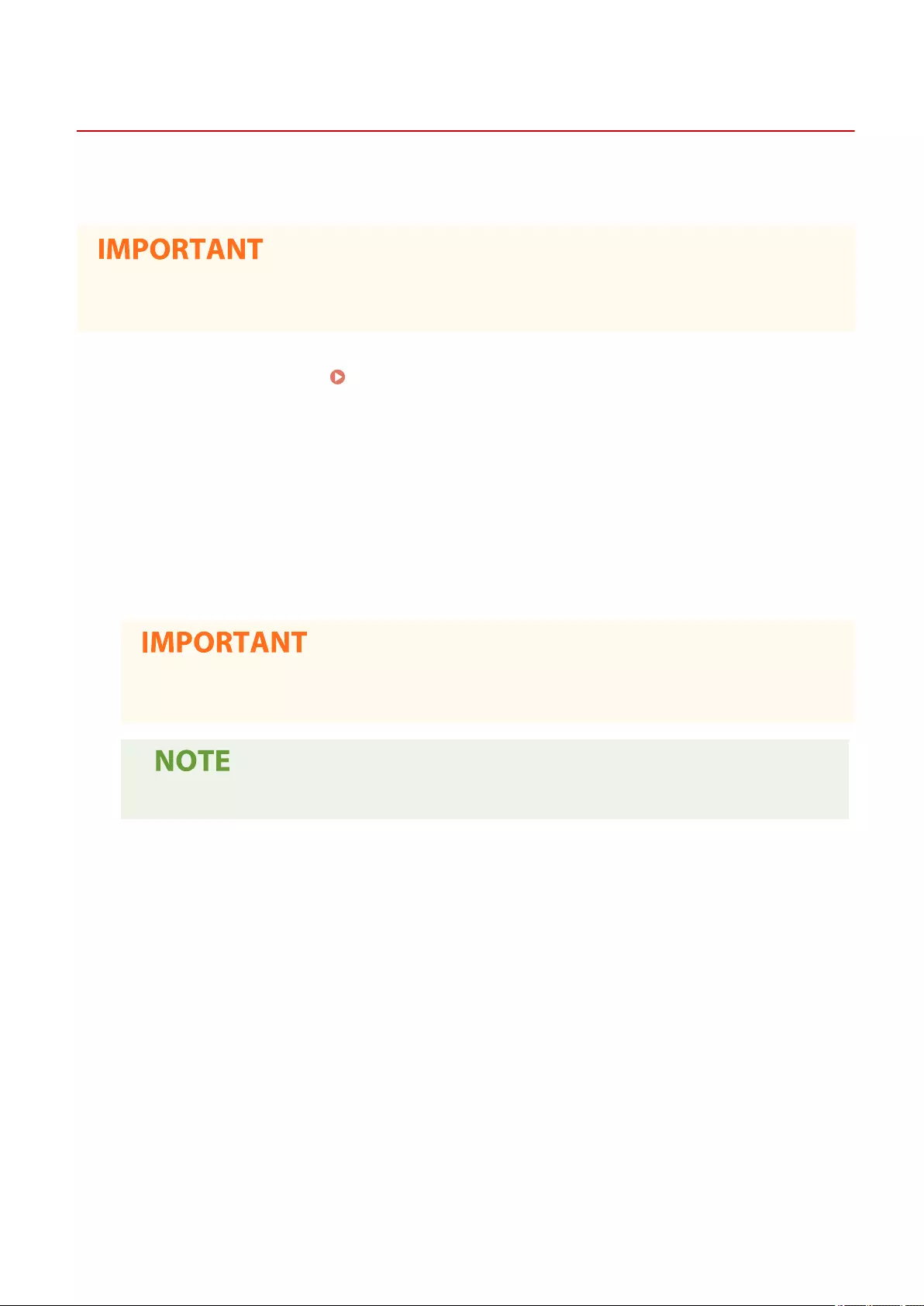
Reinstalling the machine
2579-0J9
After moving the machine to where it will be installed, install and congure the machine referring to "Getting Started".
Next perform the following steps to prepare the machine for use.
●Consumables are required in the numbers according to their replacement rank you checked before
transporting the main unit. See the report you printed out before transport.
1Turn ON the machine. Turning ON the Machine(P. 114)
➠A reinstall menu is displayed.
2Select <Reinstalling the Printer>
3Check content displayed on the screen, and select <Yes>.
➠The machine begins processing.
●Once you have begun reinstallion, it cannot be halted. If no consumables replacements are ready, do
not start reinstallation.
●If settings were initialized before transporting, congure a few additional settings such as the time.
4Remove the print head locking rod and attach the handhold cover.
1Select <Unlock>.
2When <Open Front Cover> is displayed, open the front cover.
3Pull out the print head locking rod.
●Stow the print head locking rod.
Maintenance
573
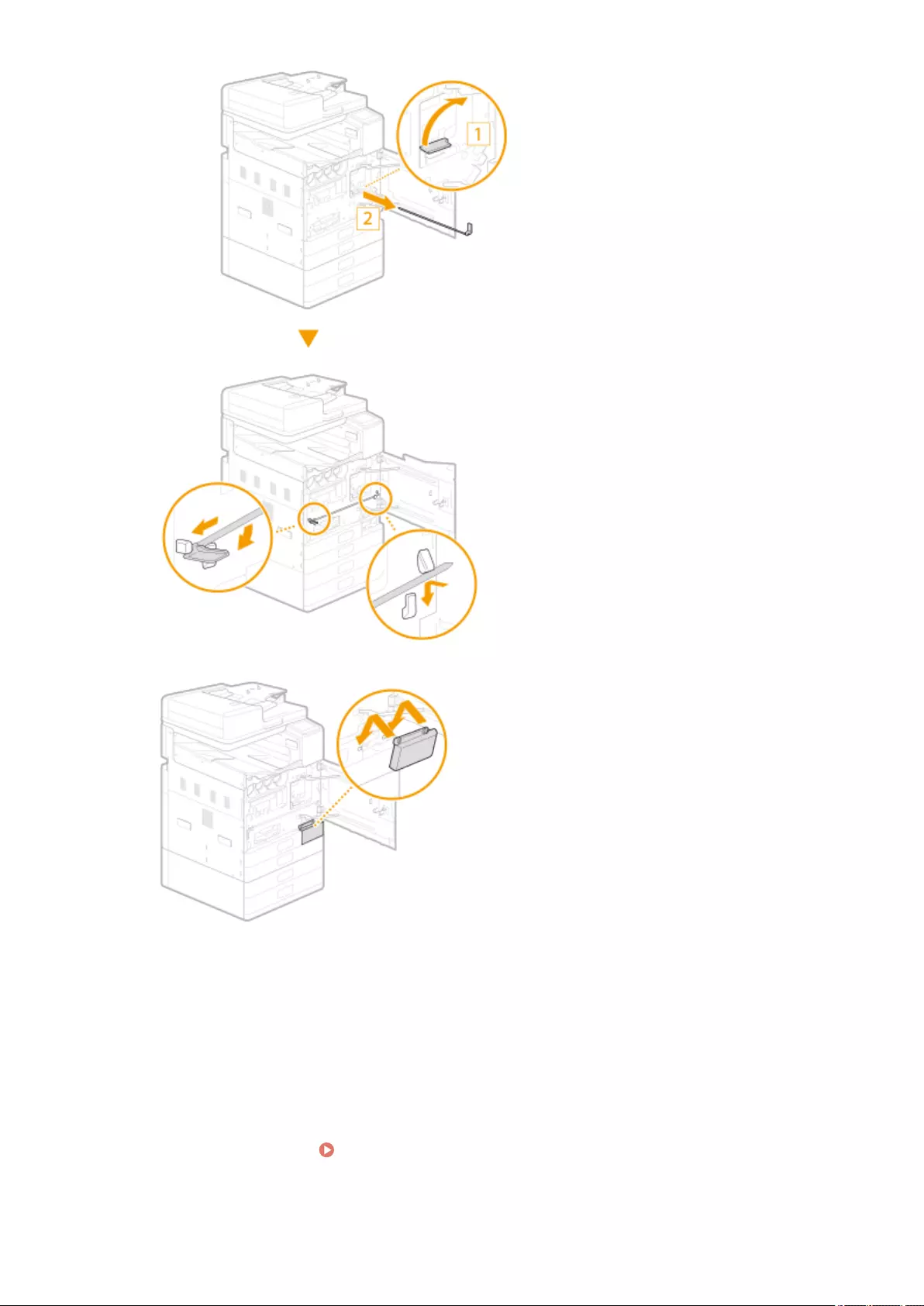
4Attach the handhold cover.
5Close the front cover.
5Select <Unlock>.
6When <Open Front Cover> is displayed, open the front cover.
7Install the ink tanks. Replacing the Ink Tanks(P. 528)
●If ink tanks were removed before transporting the machine, ink tanks need to be installed when
reinstalling the machine.
Maintenance
574

8Install the maintenance cartridge. Replacing the Maintenance Cartridge(P. 532)
9Close the front cover.
➠Once the Home screen returns after the message <Processing... Do not turn OFF the device.>,
reinstallation of the machine is complete.
●Closing the front cover allows ink to ll. Filling takes the same time as when the machine was rst
installed (40 to 70 minutes).
●If consumables become low while ink is lling, consumables must be replaced.
Maintenance
575
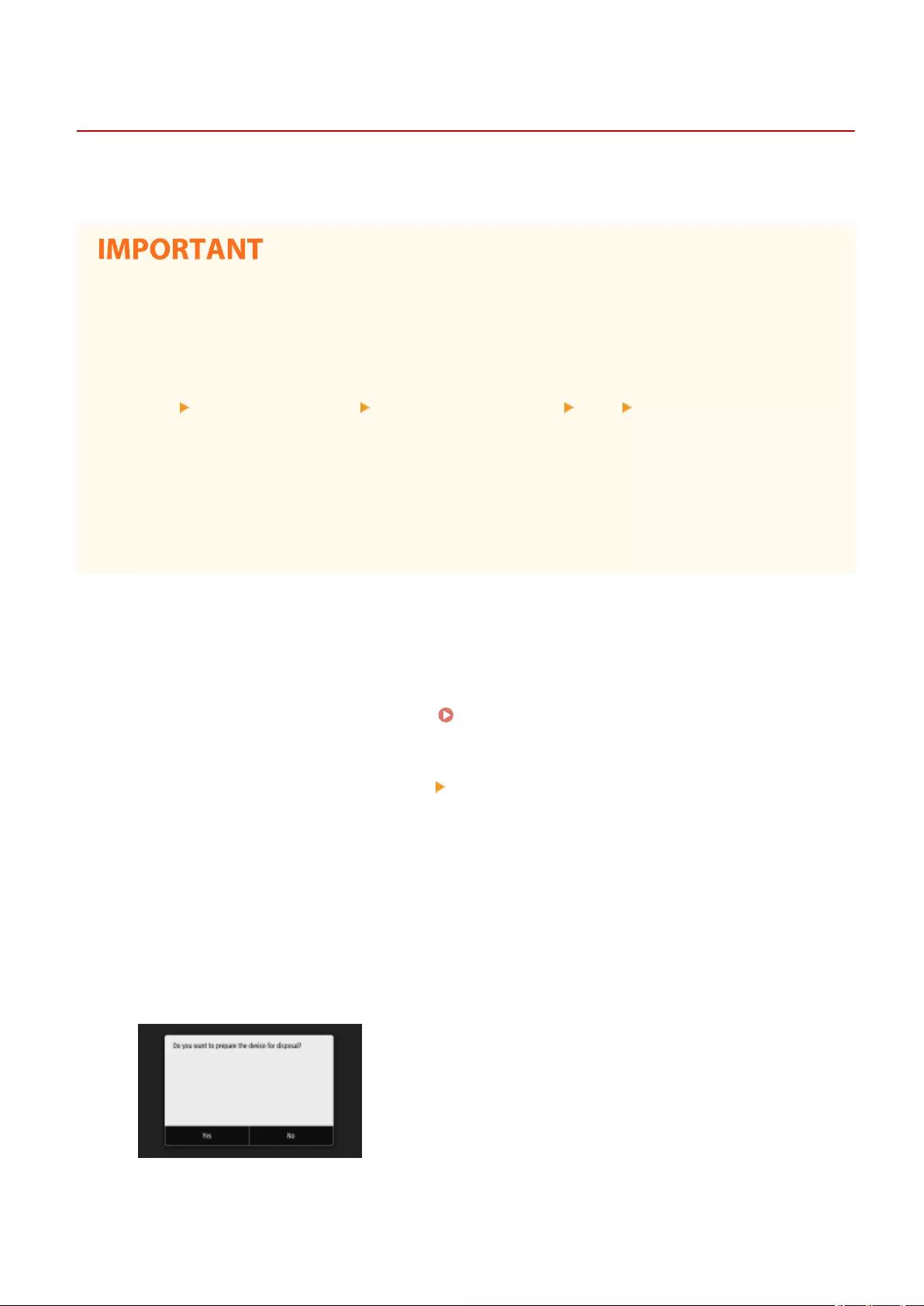
Disposing of the Machine
2579-0HE
The machine is heavy. To prevent injury or other accident, be sure to follow the procedure below when disposing of
the machine.
Precautions regarding the machine before disposal
●Registered personal information and set security information (passwords, etc.) might be remaining in the
machine.
Observe the following to prevent leakage of information before the machine is temporarily removed from
site (lending, repair, etc.), transferred, or disposed of.
<Menu> <Management Settings> <Initialize All Data/Settings> <Yes> <Yes>
●Once disposal processing is run on the machine, the machine can no longer be used.
●Dispose of the machine according to local laws and regulations. Tilting the machine or laying it on its side
without disposing of it properly may cause ink in the machine to leak.
●Prepare a plastic bag to put used consumables in beforehand.
●If an error occurs indicating the amount of ink is unknown, the <Preparation for Disposal> menu cannot be
run.
1Remove any paper.
●Remove all paper from the paper drawers and multi-purpose tray.
2Select <Menu> in the Home screen. Home Screen(P. 120)
3Select <Adjustment/Maintenance> <Maintenance>.
4Select <Preparation for Disposal>.
5Enter <System Manager ID> and <PIN>, and select <Log In>.
6Select <Yes>.
7Check the message, and select <Yes>.
Maintenance
576
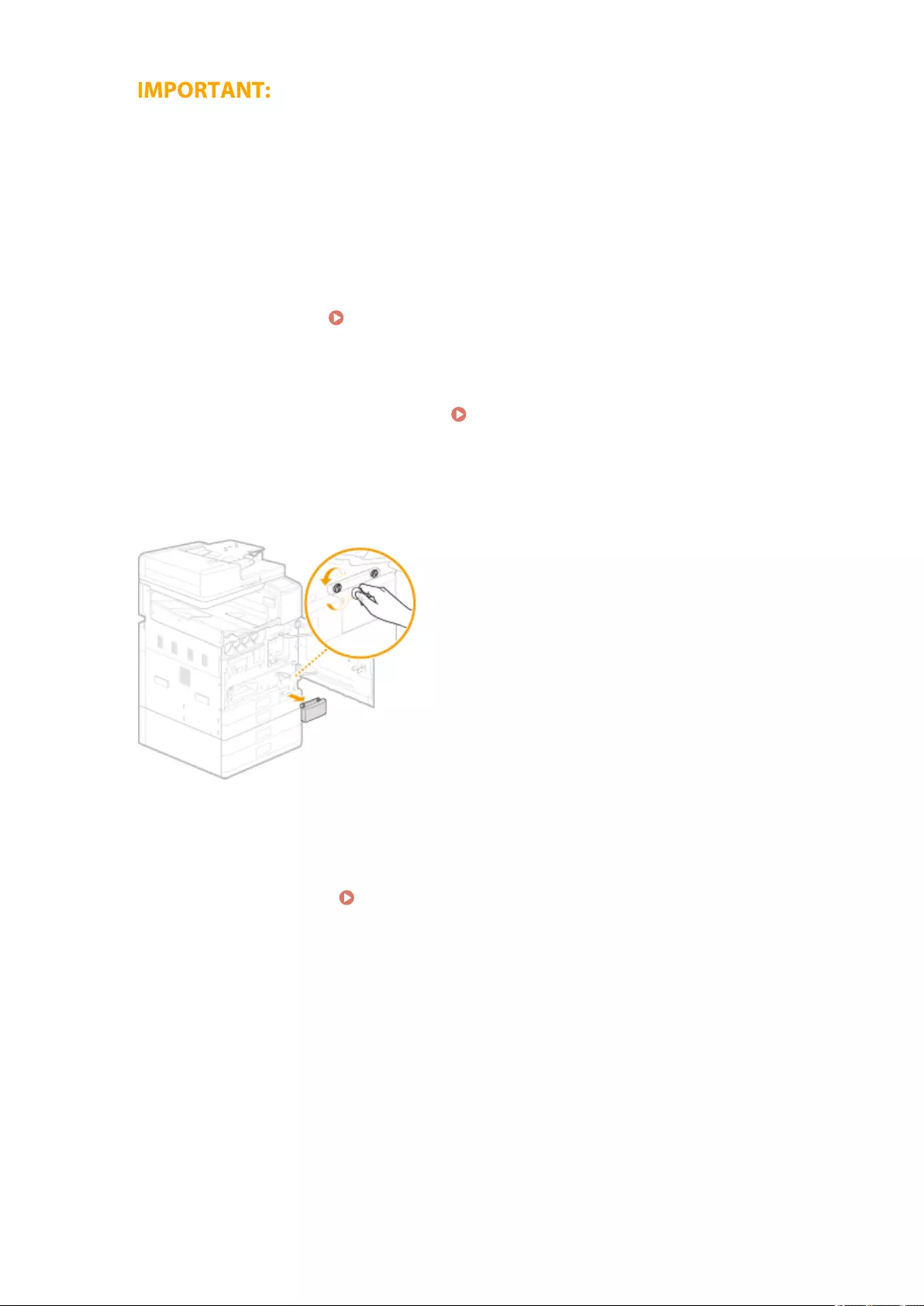
●Do not turn the machine OFF while the message is displayed.
8Select <Unlock>.
9When <Open Front Cover> is displayed, open the front cover.
10 Remove the ink tank. Replacing the Ink Tanks(P. 528)
●Place the ink tanks in a plastic bag, and close rmly to prevent ink from spilling out.
11 Remove the maintenance cartridge. Replacing the Maintenance Cartridge(P. 532)
●Place the maintenance cartridge in a plastic bag, and close rmly to prevent ink from spilling out.
12 Remove the handhold cover.
13 Close the front cover.
14 Turn OFF the machine. Turning OFF the Machine(P. 115)
15 Disconnect the cables and cord from the machine in numerical order as in the
illustration below.
●The shape of the power plug (*1) depends on your country or region.
●Whether the cables with "*2" are connected depends on your environment.
Maintenance
577
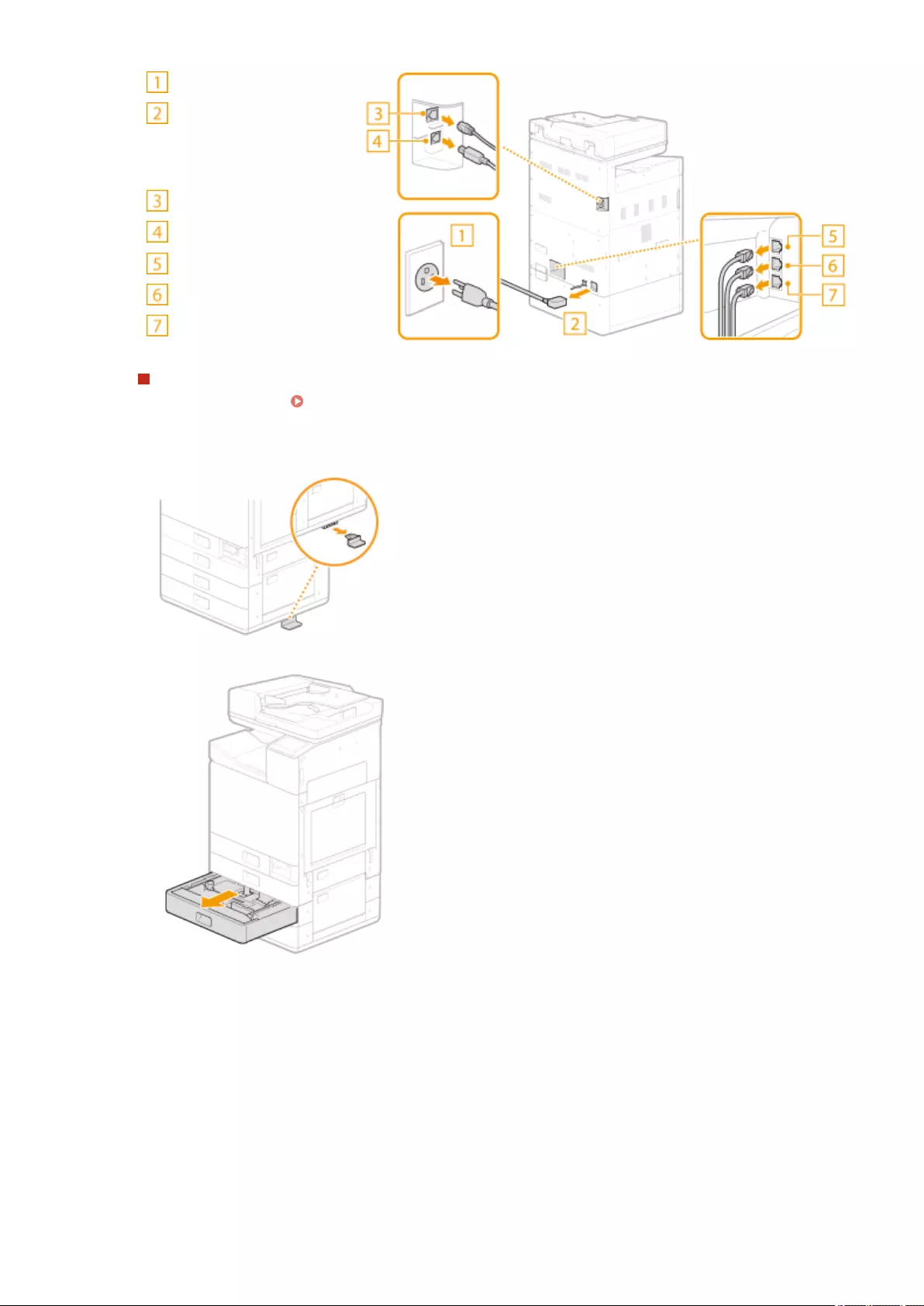
Power plug*1
Power cord
Unfasten the power cord
clamp and remove the
power cord.
LAN cable*2
USB cable*2
Handset*2
External telephone*2
Telephone cable*2
If an optional cassette feeding unit is installed.
The machine is heavy ( Other Specications(P. 724) ). Using the handholds, be sure to lift with 4 people.
1Remove the stabilizer from the right side of the cassette feeding unit.
2Pull out paper drawer 3 slightly.
3Turn the screws fastening the machine and the cassette feeding unit and remove the pedestal cover.
Front of main unit
Maintenance
578
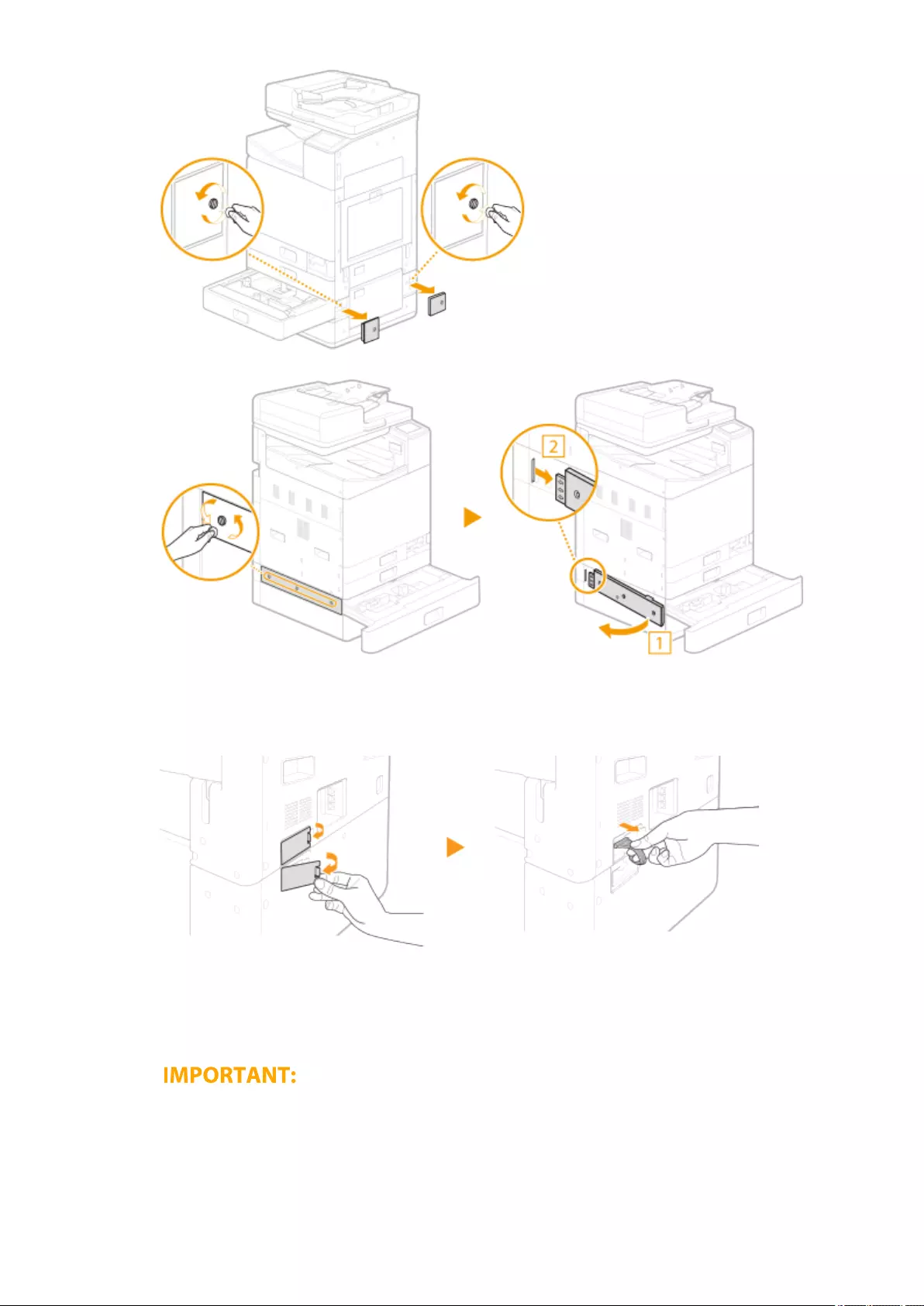
Left of main unit
4Close paper drawer 3.
5Remove the connector cover from the main unit and cassette feeding unit, and remove the cassette
feeding unit connector.
●After removing the cassette feeding unit connector, reattach the connector cover on the main unit and
cassette feeding unit.
6Use the handholds to remove the main unit.
When transporting the machine
●To transport the machine, be sure to lift with four people holding the machine by the handholds at
four locations, being careful not to injure backs, etc. See below for handhold locations and how to
grip.
●Never hold the machine by the feeder, paper cassettes, etc. The machine could be dropped and cause
injury.
Maintenance
579

●Do not hold the machine by its bottom.
●Handhold locations
●How to grip
●Stand at the corners of the machine, and grasp with each of handholds to .
●Grasp handhold with left hand, and support with right hand
●Grasp handhold with right hand, and support with left hand
●Grasp handhold with right hand, and support with left hand
Maintenance
580
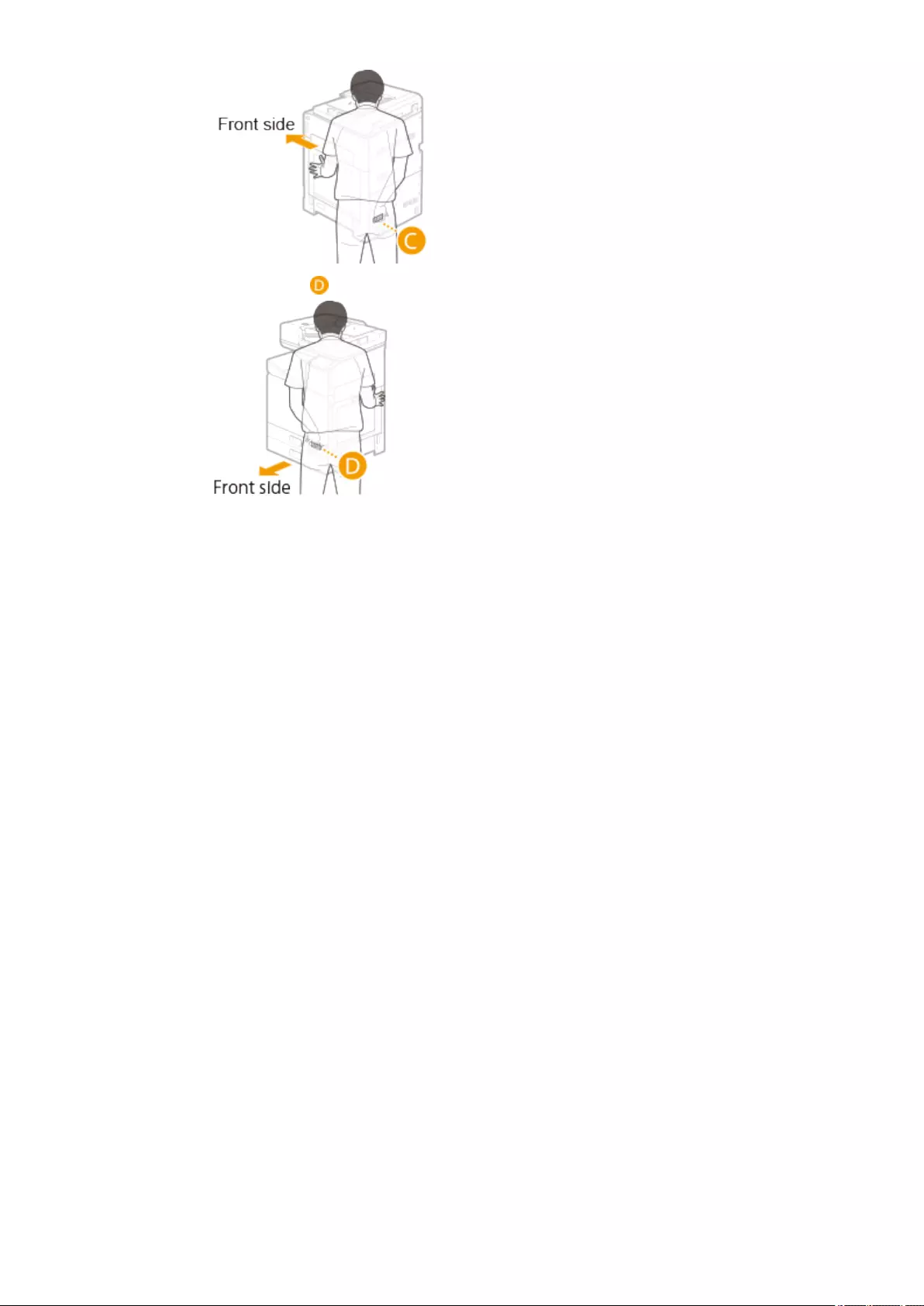
●Grasp handhold with left hand, and support with right hand
Maintenance
581

Adjusting Image Quality
2579-09U
If the print results or scanned images are not satisfactory such as low image quality, poor reproducibility, or print color
mismatch, try the adjustments below.
Making a diagnosis(P. 582)
Adjusting(P. 582)
Making a diagnosis
◼Print head diagnosis
Diagnose the print head, colors, and color mismatch and correct any problem. Diagnosing the Print Head(P. 584)
Adjusting
◼Nozzle check pattern
Check the condition of the print head nozzles if printouts are faded or streaks in a different color appear. Checking
the Condition of the Nozzles(P. 590)
◼Black Text Processing Adjustment for Color
You can make an adjustment such that black or nearly black text is reproduced in a color closely matching with the
original that was scanned in color. Adjusting Values for Text Color Reproducibility(P. 593)
◼Color Correction
Adjust unevenness in density in printouts so density is even. Correcting Colors(P. 595)
◼Abrasion Prevention
Ink smudges on printouts may indicate the print head is rubbing against the paper. If printouts are smudged, try
abrasion prevention. Preventing Abrasion(P. 604)
◼Print Head Alignment
Adjust the position of the print head if colors are not aligned in printouts, etc. Aligning the Print Head(P. 605)
◼Density/Drying Time Adjustment
Adjust print density and drying time if the backsides of output sheets get ink on them from next output sheets.
Adjusting the Density and Ink Drying Time(P. 608)
◼Paper Curl Adjustment After Printing
Maintenance
582

If curling in output paper causes paper in the output tray to be untidy, adjust paper curling. Adjusting Paper
Curling after Printing(P. 610)
◼Margin Adjustment
Adjust margins if printing is off center or if printing goes outside the print area. Adjusting Margins(P. 612)
◼Correcting Stacking in the Output Tray
Correct stacking in the output tray if paper arches or rolls back and causes paper in the output tray to be untidy.
Correcting Arching of Paper when Output(P. 615)
Maintenance
583
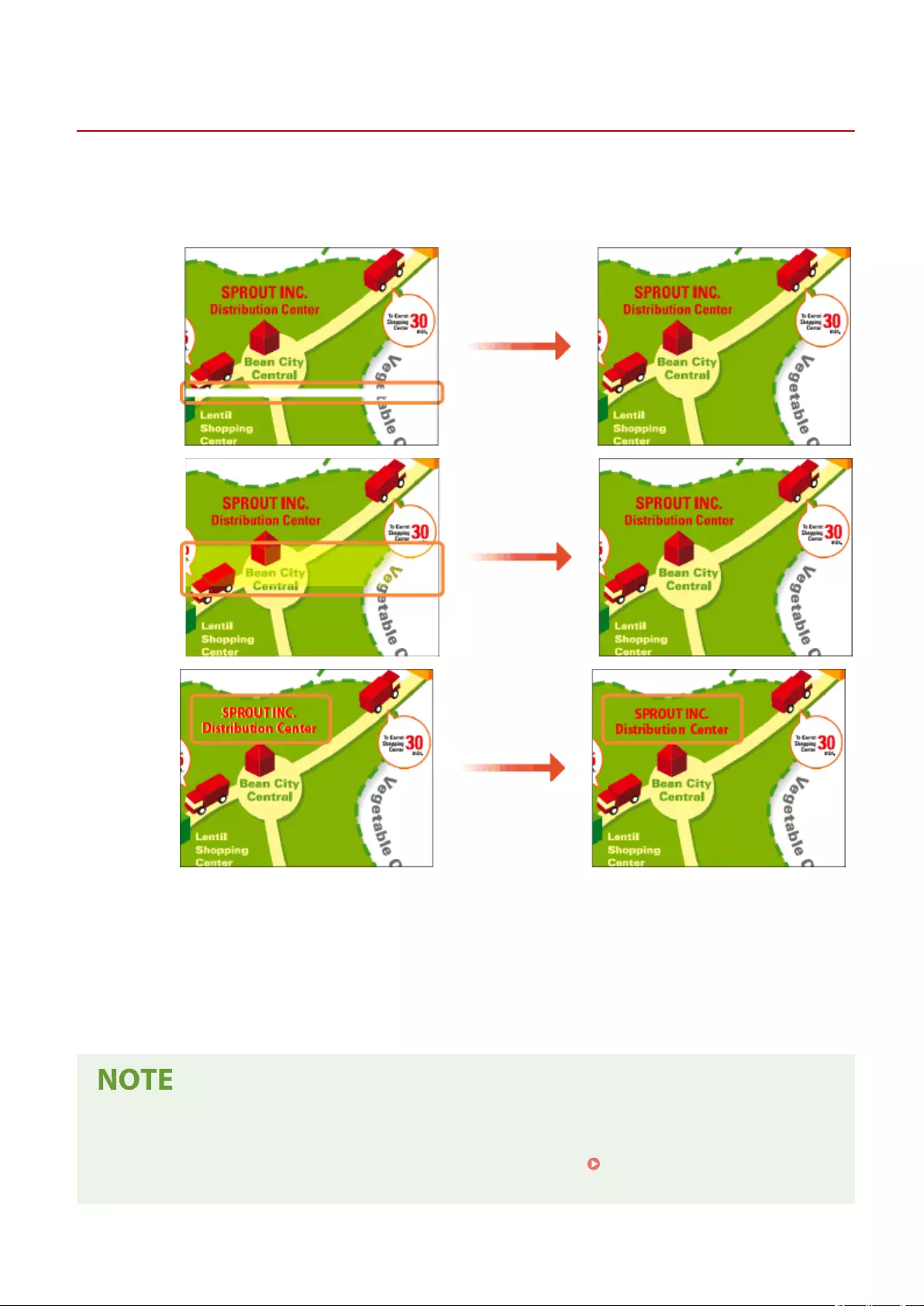
Diagnosing the Print Head
2579-0HH
Diagnose the print head, colors, and color mismatch, and correct any problem. Diagnosis might take about 40
minutes.
Prepare the following items.
Head
diagnosis
Color
diagnosis
Color
mismatch
diagnosis
Plain paper (recycled can be used)
●Size: any of A3, 11x17, LTR, or A4
A3 or 11x17 is recommended.
●Sheets: 5
All 5 sheets may not be required.
●Paper clean and white on both front and back
●Image diagnosis and adjustment use ink. A portion of this ink is also taken up by the maintenance cartridge.
Check the amounts remaining in the ink tanks and maintenance cartridge beforehand. If the amounts
remaining are low, it is recommended that you prepare replacements. Checking Remaining Amounts
and Usage of Consumables(P. 549)
Maintenance
584
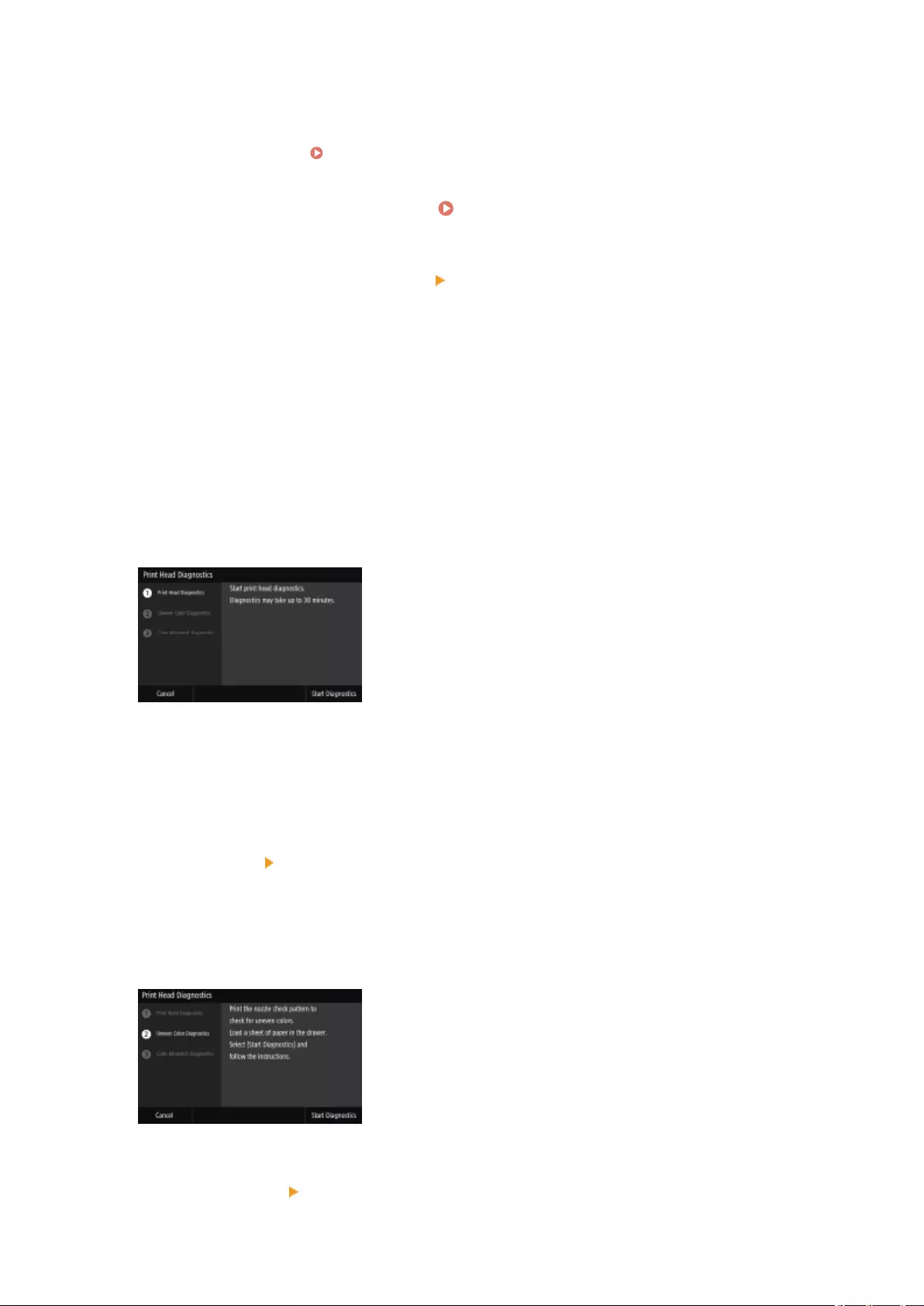
1Load paper in a paper drawer or the multi-purpose tray.
●Make paper settings also. Loading Paper(P. 137)
2Select <Menu> in the Home screen. Home Screen(P. 120)
3Select <Adjustment/Maintenance> <Maintenance>.
4Select <Print Head Diagnostics>.
5Check content displayed on the screen, and select <Start Diagnostics>.
➠Diagnosis proceeds through "(print head diagnostics) - (uneven color diagnostics) - (color mismatch
diagnostics)".
6Begin print head diagnosis.
1Check content displayed on the screen, and select <Start Diagnostics>.
➠Print head diagnosis begins.
2If a message is displayed prompting cleaning, select <Yes>.
➠Once cleaning completes, diagnosis proceeds to colors.
●Select <No> <Yes> to complete print head diagnosis, color diagnosis, and color mismatch diagnosis
and then display diagnosis results.
7Begin color diagnosis.
1Check content displayed on the screen, and select <Start Diagnostics>.
●Select <Cancel> <Yes> to complete diagnosis and display diagnosis results.
2Check the paper that can be used on the screen.
Maintenance
585
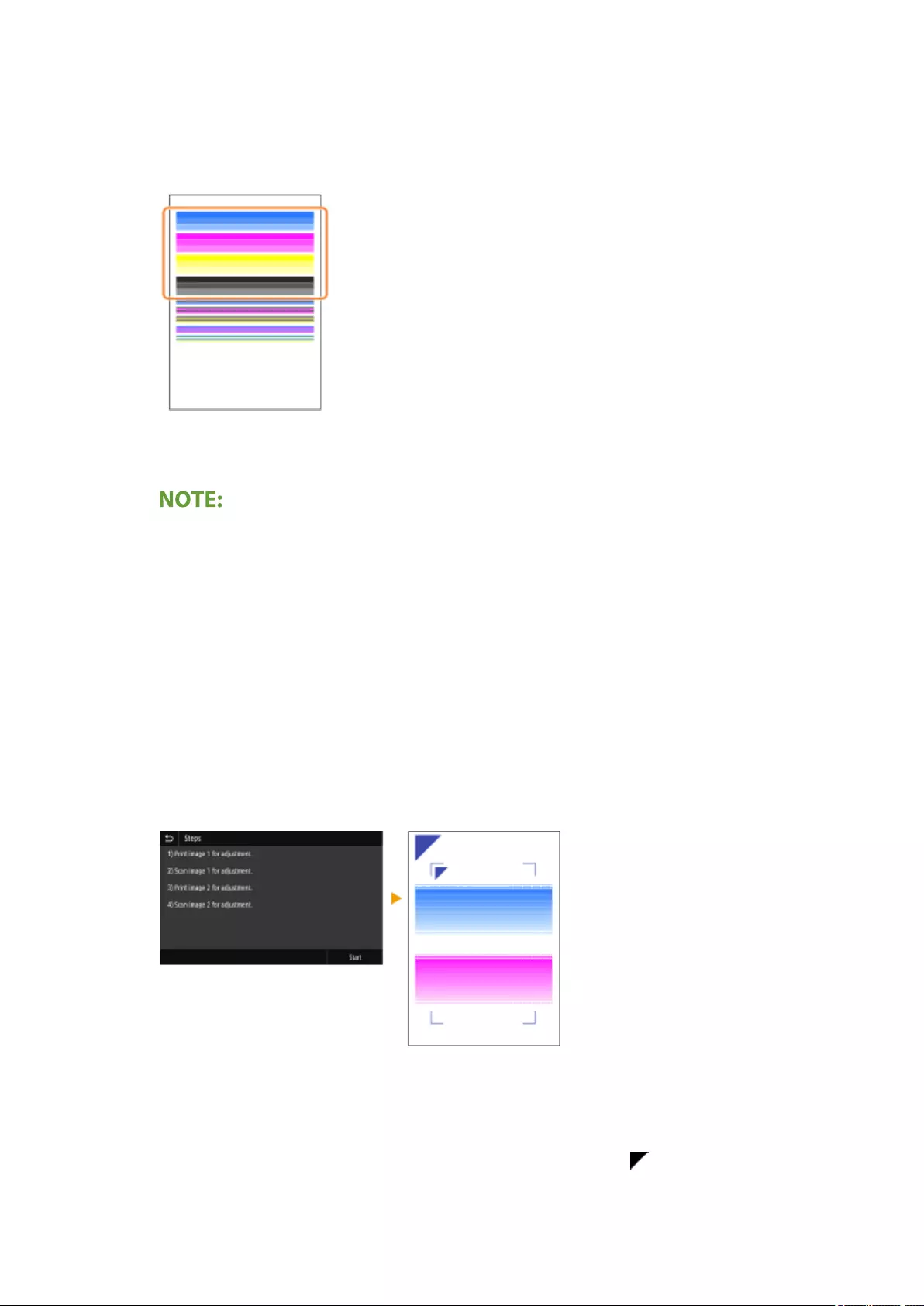
3Check that 5 sheets of paper that can be used are loaded, and then select <Next>.
4Select <Start>.
➠A nozzle check pattern is printed.
5Check the check pattern, and select <A> or <B>.
●If you selected <A>, proceed to step 6.
●If you selected <B>, proceed to step 7.
●The check pattern is also used in the following color mismatch diagnostic; do not discard.
6Select <Close>.
➠Color diagnosis completes, and diagnosis proceeds to color mismatch.
7Check content displayed on the screen, and select <Yes>.
➠Color correction begins.
●Select <No> to proceed to color mismatch diagnosis without correcting colors.
8Check the paper that can be used on the screen.
9Check that 4 sheets (2 or more) of paper that can be used are loaded, and then select <Next>.
10 Conrm the procedure, and select <Start>.
➠The rst adjustment image is printed.
●Wait about 2 minutes.
11 Open the feeder after the screen displayed during printing disappears.
12 Place the rst adjustment image on the platen glass.
●Place the adjustment image with the print side facing down and the mark in the upper left corner
of the machine.
Maintenance
586
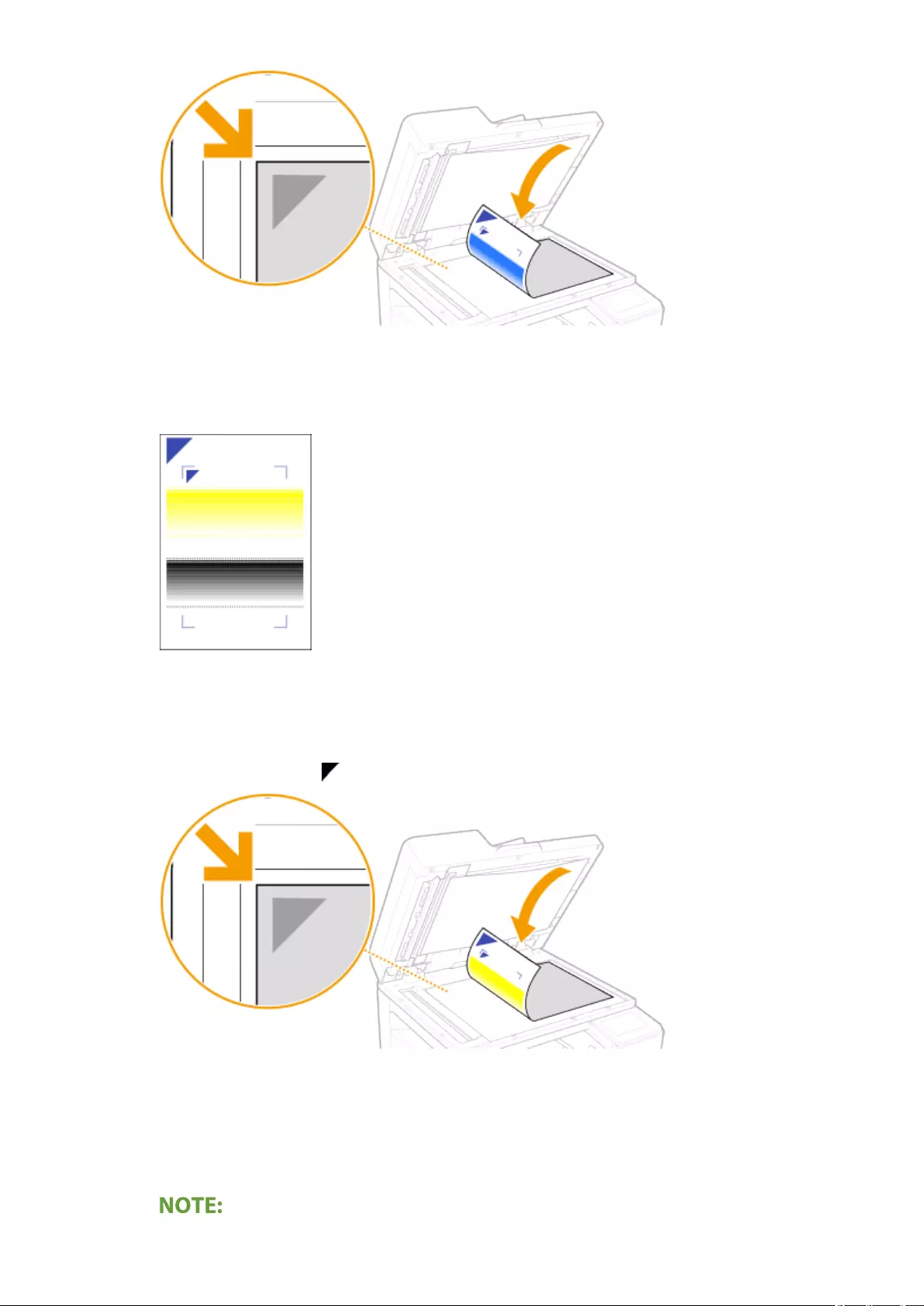
13 Gently close the feeder.
14 Select <Start Scanning>.
➠The placed adjustment image is scanned, and then the second adjustment image is printed.
●Wait about 2 minutes.
15 Open the feeder, remove the rst adjustment image, and then place the second adjustment image on the
platen glass with the print side face down.
●In the same way as for the rst adjustment image, place the adjustment image with the print side
facing down and the mark in the upper left corner of the machine.
16 Gently close the feeder.
17 Select <Start Scanning>.
➠The placed adjustment image is scanned, and color correction starts.
18 Open the feeder and remove the second adjustment image.
Maintenance
587

●If a third adjustment image has been printed, repeat the procedure from step 15.
19 Close the feeder gently.
➠Color unevenness diagnosis completes, and diagnosis proceeds to color mismatch.
8Begin color mismatch diagnosis.
1Check content displayed on the screen, and select <Start Diagnostics>.
●Select <Cancel> <Yes> to complete diagnosis and display diagnosis results.
2Check the nozzle check pattern printed for diagnosing color unevenness, and select <A> or <B>.
●If you selected <A>, proceed to step 3.
●If you selected <B>, proceed to step 4.
3Select <Close>.
➠Color mismatch diagnosis completes, and diagnosis results are displayed.
4Check content displayed on the screen, and select <Yes>.
●Select <No> to complete color mismatch diagnosis without correcting color mismatch and display
diagnosis results.
5Check that the size and type of paper displayed on the screen is loaded in the machine, and select
<Next>.
6Conrm the procedure, and select <Start>.
➠An adjustment image is printed.
Maintenance
588
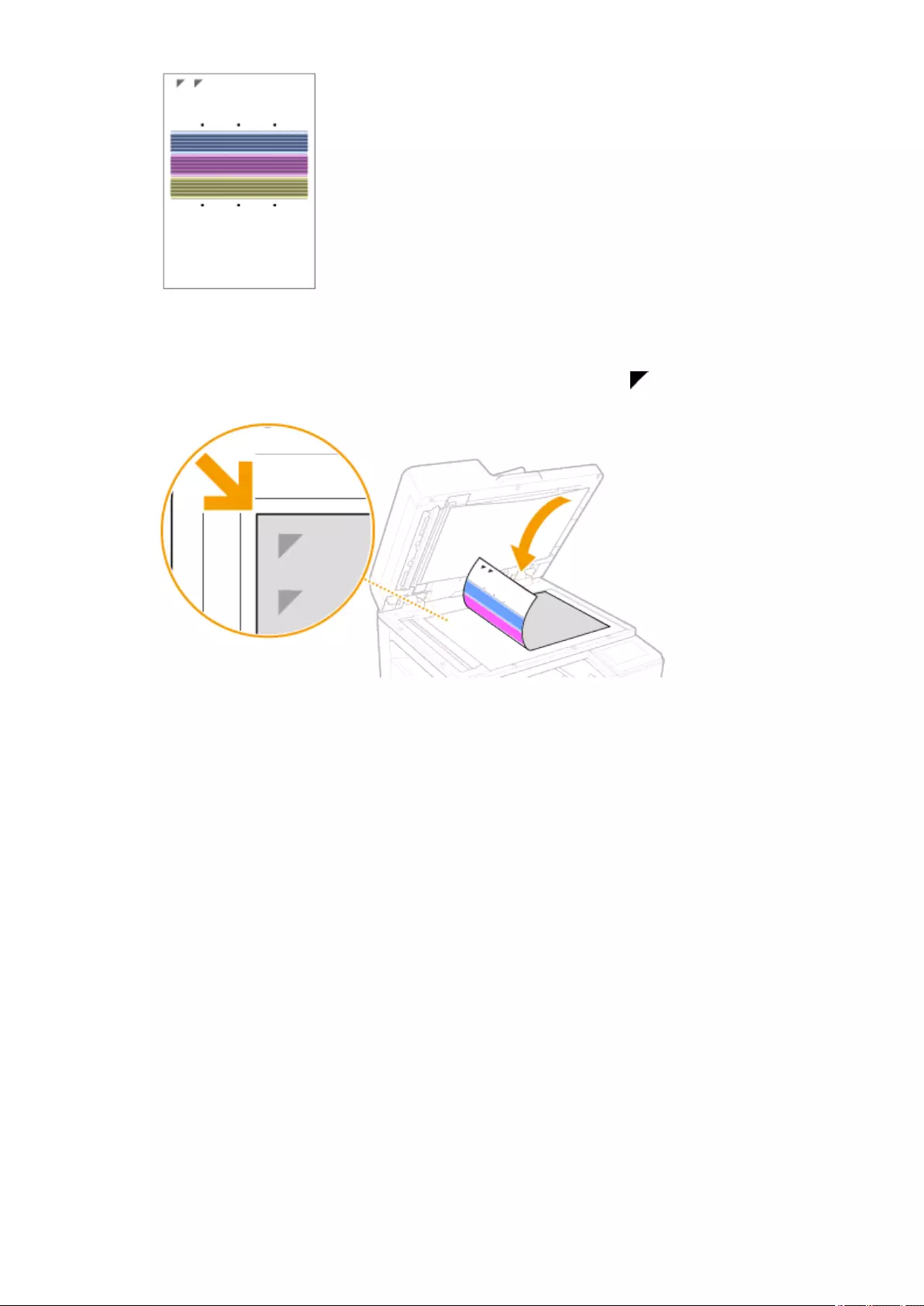
7Open the feeder after the screen displayed during printing disappears.
8Place the adjustment image on the platen glass.
●Place the adjustment image with the print side facing down and the mark in the upper left corner
of the machine.
9Gently close the feeder.
10 Select <Start Scanning>.
➠The placed adjustment image is scanned, and color mismatch correction starts.
11 Open the feeder and remove the adjustment image.
12 Gently close the feeder.
9Check the diagnosis results and select <Close>.
10 Select <Close>.
Maintenance
589

Checking the Condition of the Nozzles
2579-0HF
Print out a nozzle check pattern to check clogging in the print head and color mismatch.
Prepare the following paper.
●For nozzle check pattern:
Paper to check streaks and unevenness with (any of thin paper, plain paper, thick paper, recycled paper, matte
photo paper)
Size: any of A3, 11x17, LTR, or A4
Sheets: 5 or more
●For adjustment of print head position:
Plain paper (recycled paper can be used)
Size: any of A3, 11x17, LTR, or A4
Sheets: 1
●A3 or 11x17 is recommended.
1Load the paper "for nozzle check pattern" and "for adjustment of print head
position" each separately in paper drawers or the multi-purpose tray.
●Make paper settings. Loading Paper(P. 137)
2Select <Menu> in the Home screen. Home Screen(P. 120)
3Select <Adjustment/Maintenance> <Maintenance>.
4Select <Nozzle Check Pattern>.
5Select the paper type.
6Check that the size and type of paper displayed on the screen is loaded in the
machine, and select <OK>.
7Select <Start>.
➠A nozzle check pattern is printed out.
8Check for color unevenness.
●Check the printed nozzle check pattern, and select <A> or <B>.
Maintenance
590
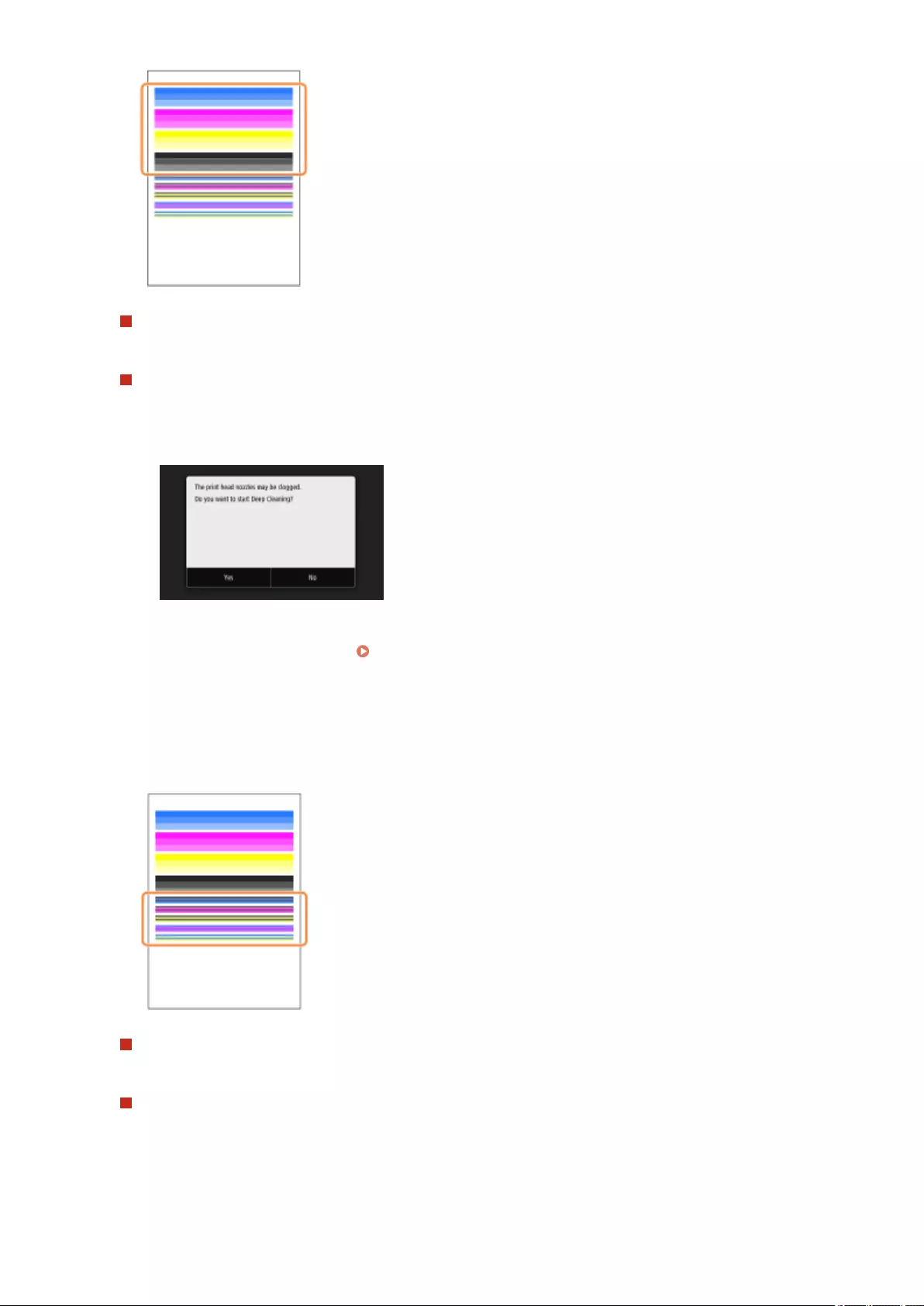
If you selected <A>
Select <Close>.
If you selected <B>
Print head nozzles may be clogged. Perform print head cleaning.
1Check content displayed on the screen, and select <Yes>.
●Select <No> to not perform print head cleaning. Print head cleaning can be performed later.
2Perform print head cleaning. Cleaning the Print Head(P. 526)
9Check color mismatch.
●Check the printed nozzle check pattern, and select <A> or <B>.
If you selected <A>
Select <Close>.
If you selected <B>
Align the print head and correct color mismatch.
1Check content displayed on the screen, and select <Yes>.
●Select <No> to not perform color mismatch correction. Color mismatch correction can be performed
later.
Maintenance
591
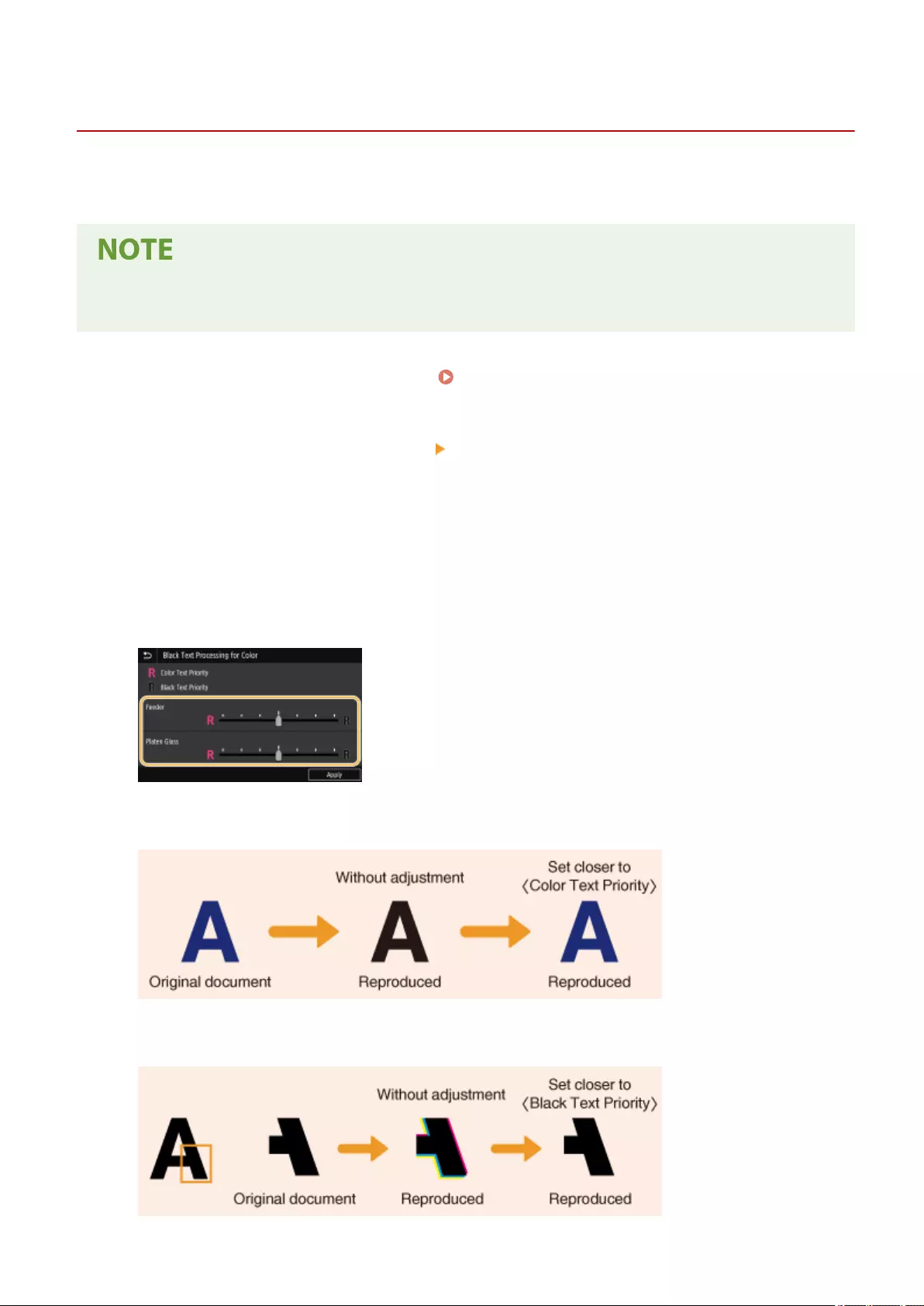
Adjusting Values for Text Color Reproducibility
2579-09Y
You can make an adjustment such that black or nearly black text is reproduced in a color closely matching with the
original that was scanned in color.
●This function will apply when color copying is performed with <Original Type> in copy settings set to <Text/
Photo/Map>/<Text>.
1Select <Menu> in the Home screen. Home Screen(P. 120)
2Select <Adjustment/Maintenance> <Adjust Image Quality>.
3Select <Black Text Processing for Color>.
4Adjust the value.
●This adjustment value can be set independently in the feeder and platen glass.
<Color Text Priority>
Reproduces black or nearly black text in a color closely matching with the original.
<Black Text Priority>
Reproduces black text with enhanced clarity.
Maintenance
593

5Select <Apply>.
Maintenance
594
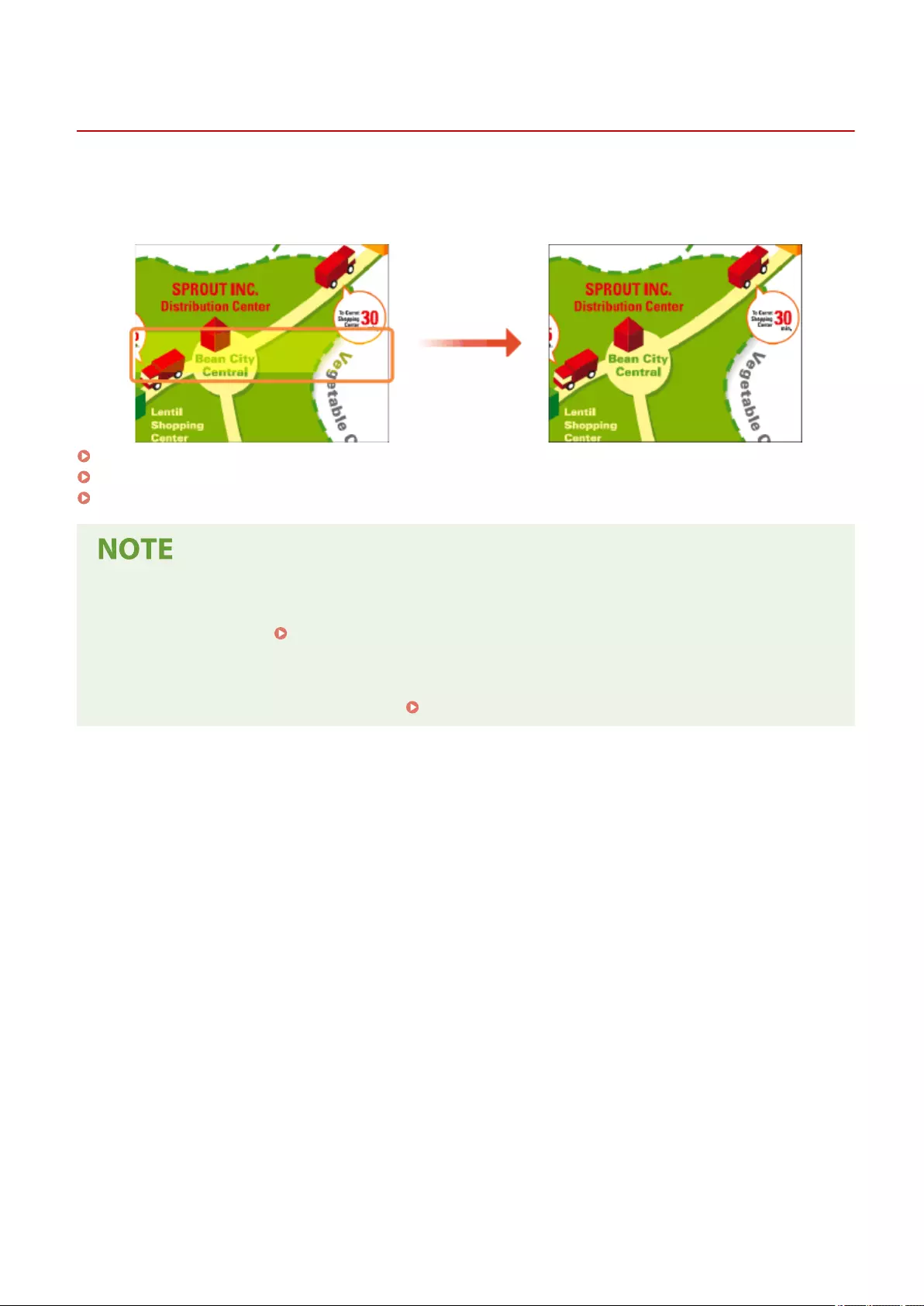
Correcting Colors
2579-09W
If density appears uneven in printouts, adjust so that it is even with the following procedure. Choose from "Single
Paper Type" for automatic correction of only a given paper type, "All Paper Types" for automatic correction of all paper
types, and "Manual (Visual Check)" for adjusting using a manual correction value after checking printing visually.
Correcting Colors in All Paper Types(P. 596)
Correcting Colors for Each Paper Type(P. 599)
Manual (Visual Check)(P. 602)
●Adjustments may not be performed effectively if there is not sucient ink remaining. Check the amounts
remaining in the ink tanks. If the amounts remaining in the ink tanks are low, it is recommended that you
prepare new ink tanks. Checking Remaining Amounts and Usage of Consumables(P. 549)
●Color unevenness correction may cause the print density to be lighter.
●Before performing color unevenness correction, it is recommended to print out a nozzle check pattern and
check that no miscolored lines are present. Checking the Condition of the Nozzles(P. 590)
Maintenance
595
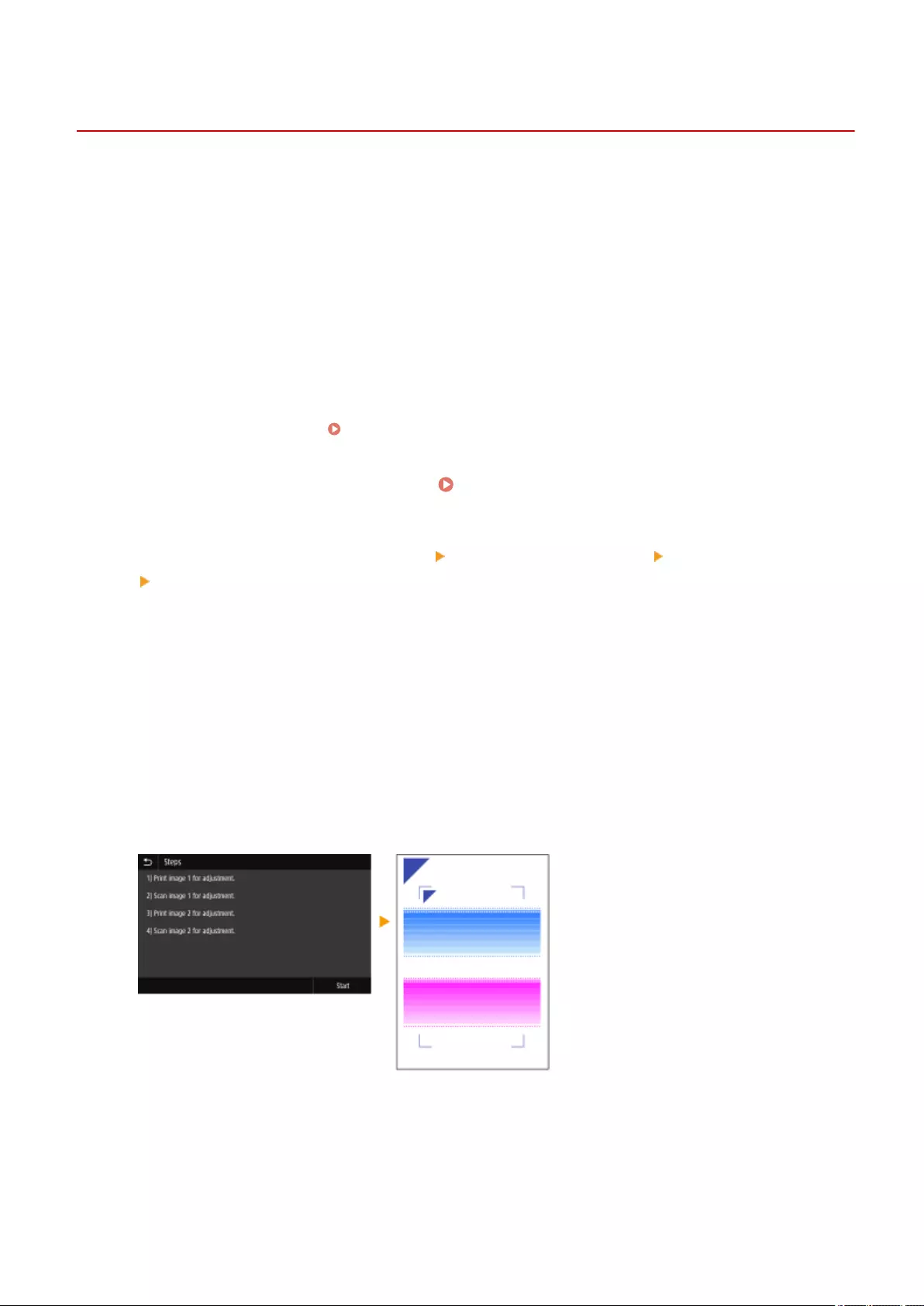
Correcting Colors in All Paper Types
2579-0JK
Perform color correction automatically for all paper types. All correction data for color correction done with "Single
Paper Type" is changed.
Correction involves repeating printing out and then scanning an adjustment image 2 times.
Prepare the following paper.
Plain paper (recycled paper can be used)
●Size: any of A3, 11x17, LTR, or A4
A3 or 11x17 is recommended.
●Sheets: 2
1Load paper in a paper drawer or the multi-purpose tray.
●Make paper settings also. Loading Paper(P. 137)
2Select <Menu> in the Home screen. Home Screen(P. 120)
3Select <Adjustment/Maintenance> <Adjust Image Quality> <Color Correction>
<Auto (Pattern Scan)>.
4Select <All Paper Types>.
5Check that the size and type of paper displayed on the screen is loaded in the
machine, and select <Next>.
6Conrm the procedure, and select <Start>.
➠The rst adjustment image is printed.
7When the screen <Processing... Do not turn OFF the device.> is displayed, wait about
2 minutes before going to the next operation.
Maintenance
596

8When the screen <Place the 1st alignment pattern as shown and scan it.>, open the
feeder.
9Place the rst adjustment image on the platen glass.
●Place the adjustment image with the print side facing down and the mark in the upper left corner of the
machine.
10 Gently close the feeder.
11 Select <Start Scanning>.
➠The placed adjustment image is scanned, and then the second adjustment image is printed.
12 When the screen <Processing... Do not turn OFF the device.> is displayed, wait about
2 minutes before going to the next operation.
13 When the screen <Place the 2nd alignment pattern as shown and scan it.>, open the
feeder, remove the rst adjustment image, and then place the second adjustment
image on the platen glass.
●In the same way as for the rst adjustment image, place the adjustment image with the print side facing
down and the mark in the upper left corner of the machine.
Maintenance
597
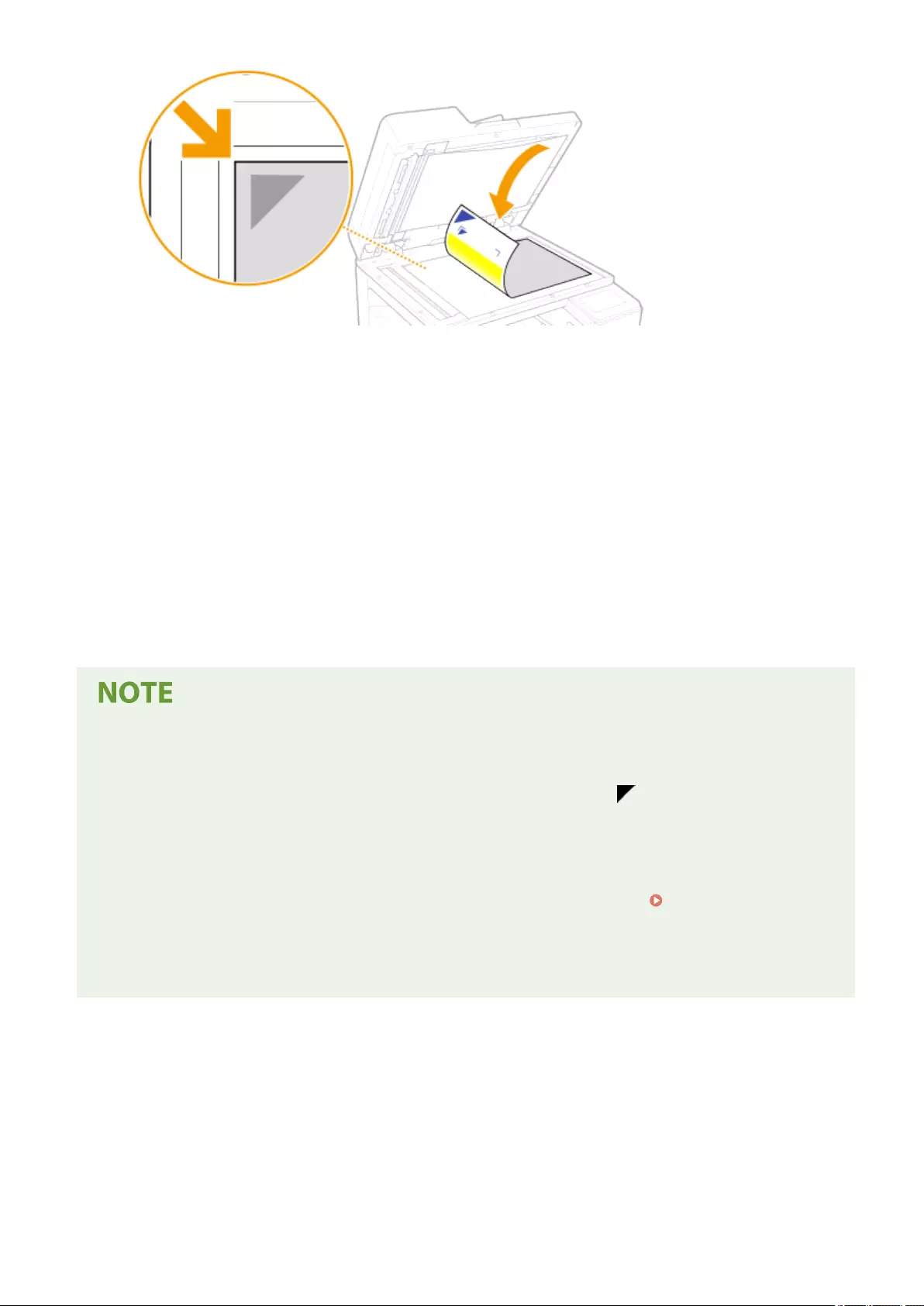
14 Gently close the feeder.
15 Select <Start Scanning>.
➠The placed adjustment image is scanned and adjustment starts.
16 When a message appears notifying that adjustment is complete, open the feeder,
and remove the second adjustment image.
17 Gently close the feeder.
If the <Could not perform correction.> message is displayed
●Did you load the paper displayed in step 5 into the paper source?
●Did you place the adjustment image with the print side face down, with the mark in the upper left corner
of the machine?
●Is the printout soiled?
If this does not correct color unevenness
●Print out a nozzle check pattern and check that no miscolored lines are present ( Checking the Condition
of the Nozzles(P. 590) ). Next perform correction for all paper types again.
To return corrected values to initial values
●In the <Auto (Pattern Scan)> screen, select <Restore Initial Settings>.
Maintenance
598
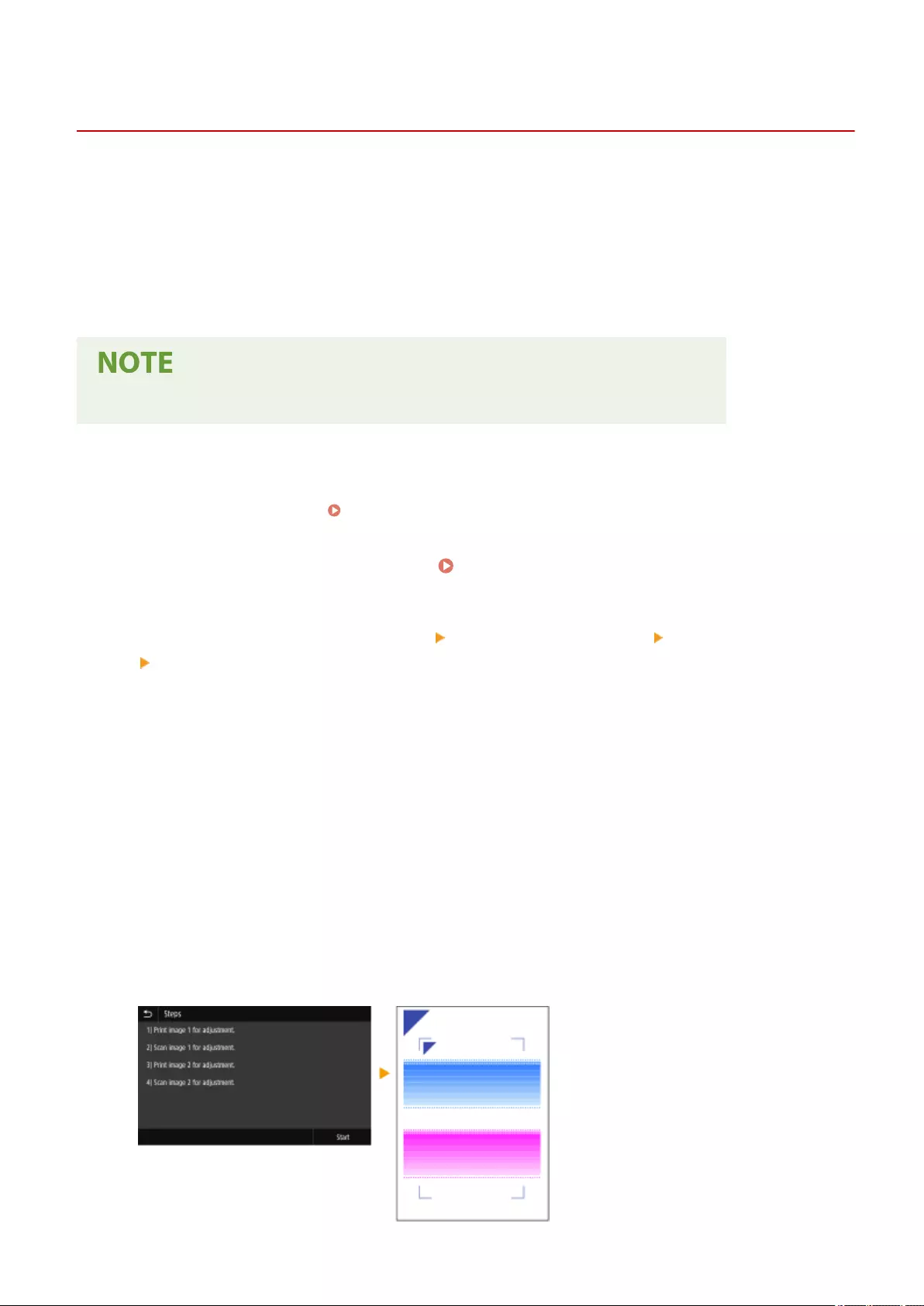
Correcting Colors for Each Paper Type
2579-0JJ
Perform optimum color correction for each paper type.
Prepare the following paper.
Paper to correct colors with using this correction (any of thin paper, plain paper, thick paper, recycled paper, matte
photo paper)
A3 or 11x17 is recommended.
●Size: any of A3, 11x17, LTR, or A4
●Sheets: 2
●Correction for single paper types is not available while scanning or printing is performed.
1Load paper in a paper drawer or the multi-purpose tray.
●Make paper settings also. Loading Paper(P. 137)
2Select <Menu> in the Home screen. Home Screen(P. 120)
3Select <Adjustment/Maintenance> <Adjust Image Quality> <Color Correction>
<Auto (Pattern Scan)>.
4Select <Single Paper Type>.
5Select the paper type.
6Check that the size and type of paper displayed on the screen is loaded in the
machine, and select <OK>.
7Conrm the procedure, and select <Start>.
➠The rst adjustment image is printed.
Maintenance
599
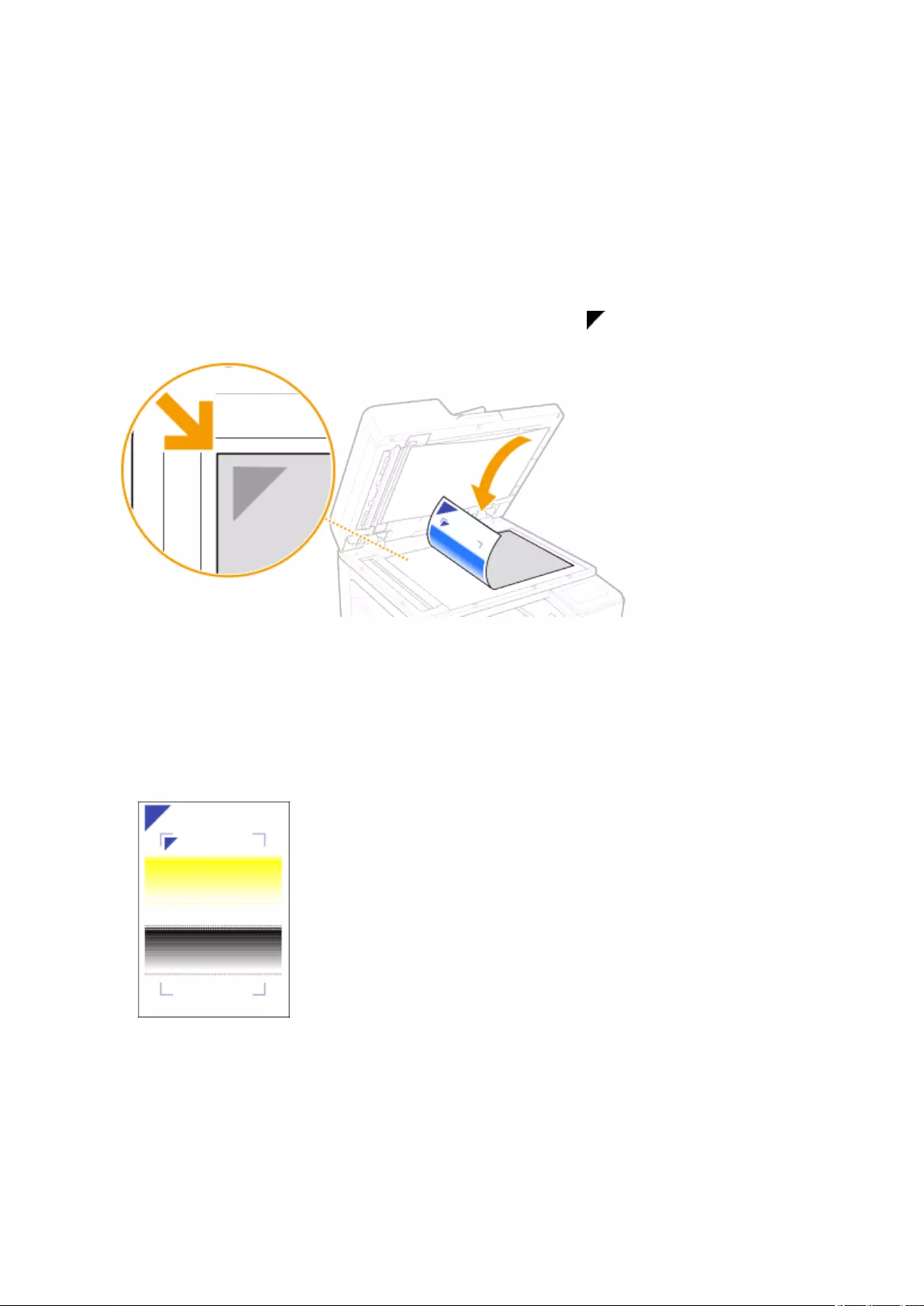
8When the screen <Processing... Do not turn OFF the device.> is displayed, wait about
2 minutes before going to the next operation.
9When the screen <Place the 1st alignment pattern as shown and scan it.>, open the
feeder.
10 Place the rst adjustment image on the platen glass.
●Place the adjustment image with the print side facing down and the mark in the upper left corner of the
machine.
11 Gently close the feeder.
12 Select <Start Scanning>.
➠The placed adjustment image is scanned, and then the second adjustment image is printed.
13 When the screen <Processing... Do not turn OFF the device.> is displayed, wait about
2 minutes before going to the next operation.
14 When the screen <Place the 2nd alignment pattern as shown and scan it.>, open the
feeder, remove the rst adjustment image, and then place the second adjustment
image on the platen glass.
Maintenance
600
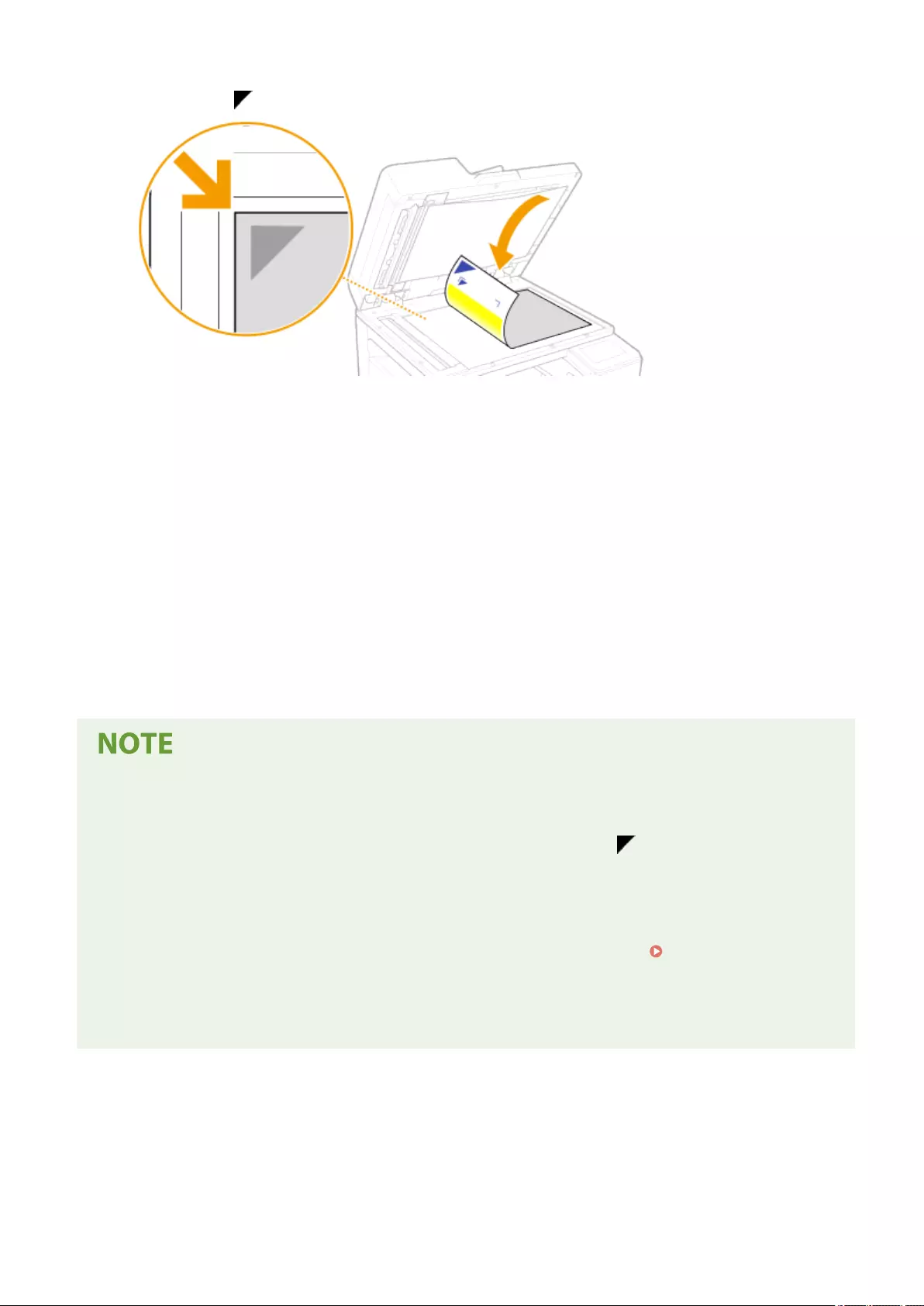
●In the same way as for the rst adjustment image, place the adjustment image with the print side facing
down and the mark in the upper left corner of the machine.
15 Gently close the feeder.
16 Select <Start Scanning>.
➠The placed adjustment image is scanned and adjustment starts.
17 When a message appears notifying that adjustment is complete, open the feeder,
and remove the second adjustment image.
18 Gently close the feeder.
If the <Could not perform correction.> message is displayed
●Did you load the paper displayed in step 5 into the paper source?
●Did you place the adjustment image with the print side face down, with the mark in the upper left corner
of the machine?
●Is the printout soiled?
If this does not correct color unevenness
●Print out a nozzle check pattern and check that no miscolored lines are present ( Checking the Condition
of the Nozzles(P. 590) ). Next perform correction for all paper types again.
To return corrected values to initial values
●In the <Auto (Pattern Scan)> screen, select <Restore Initial Settings>.
Maintenance
601
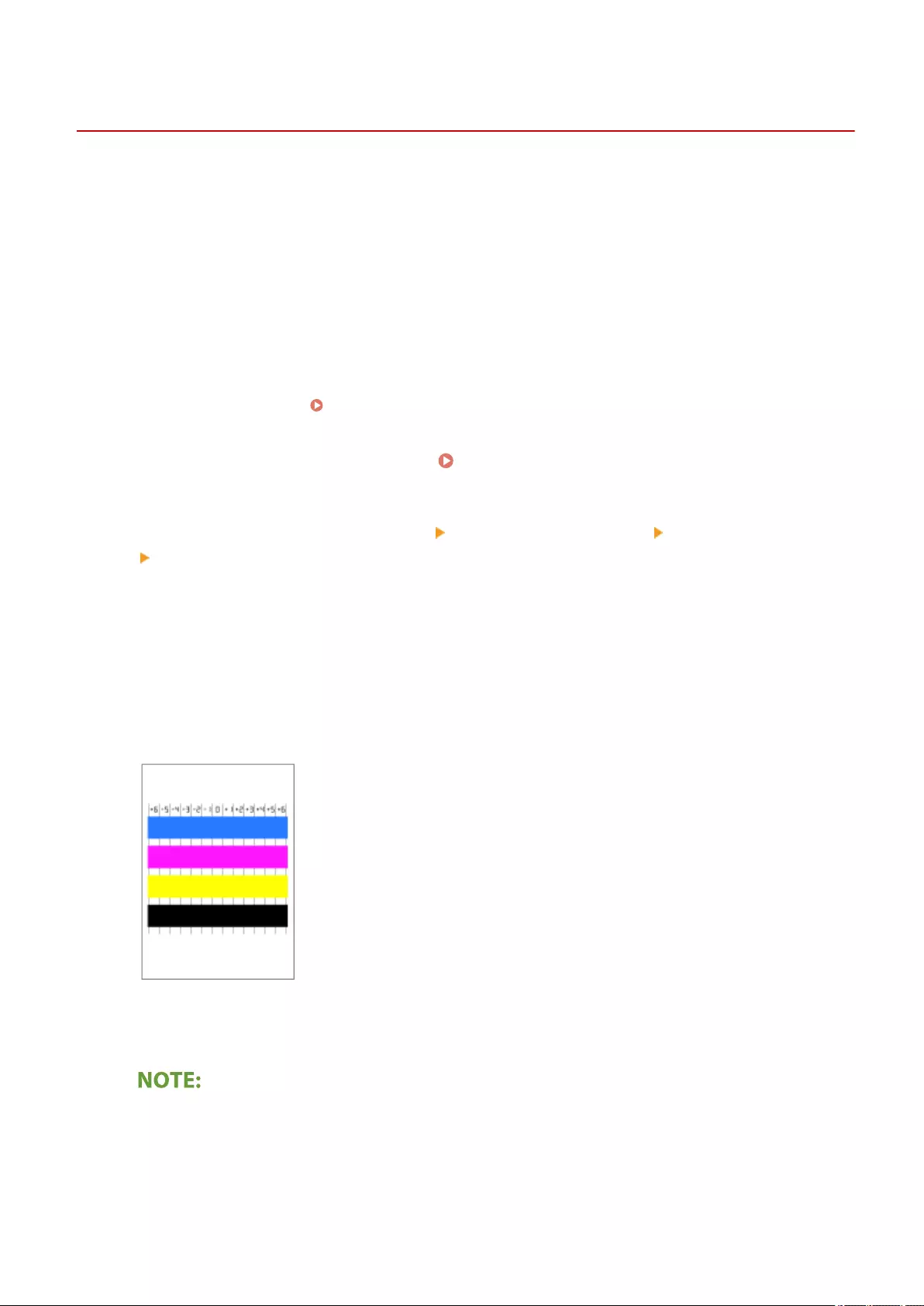
Manual (Visual Check)
2579-0JL
Visually check an output test page to determine an adjustment values for each color (CMYK).
Prepare the following paper.
●Plain paper (recycled paper can be used)
●Size: any of 320x450 mm, 305x457 mm, A3, 11x17, LTR, or A4
320x450 mm, 305x457 mm, A3, or 11x17 is recommended.
●Sheets: 2
1Load paper in a paper drawer or the multi-purpose tray.
●Make paper settings also. Loading Paper(P. 137)
2Select <Menu> in the Home screen. Home Screen(P. 120)
3Select <Adjustment/Maintenance> <Adjust Image Quality> <Color Correction>
<Manual (Visual Check)>.
4Select <Output Test Page>.
5Check that the size and type of paper displayed on the screen is loaded in the
machine, and select <Start>.
➠A test page is printed.
6Visually check the test page to check for unevenness in color.
Range for marks
●The marks for each color are printed out in blocks in a range starting from -6 to +6 through -4 to +4,
depending on the paper size used for the test page.
7Select colors to ne-tune.
Maintenance
602
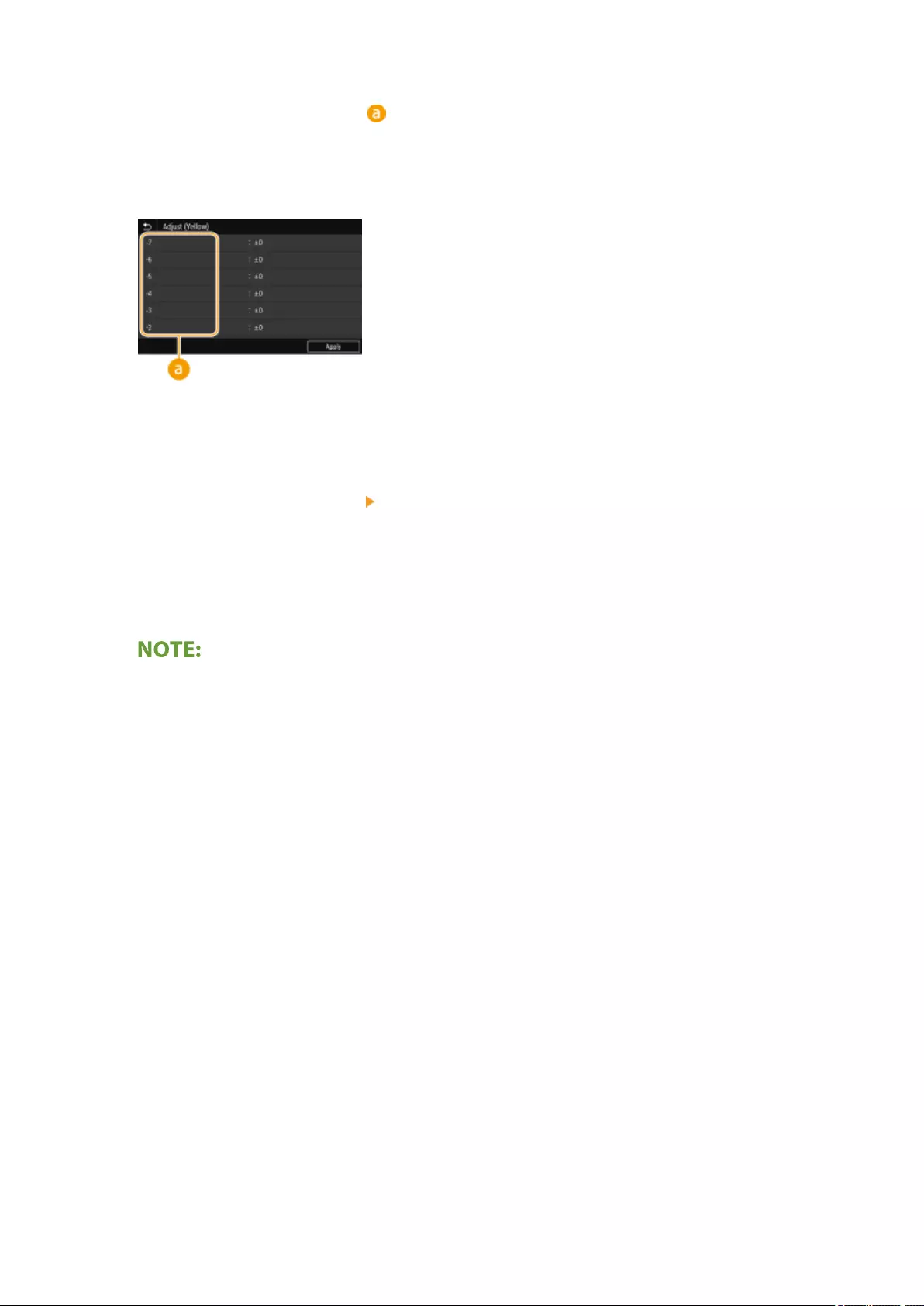
8Select the range to adjust ( ), enter a value, and select <Apply>.
●Enter values from -127 to +127 for all blocks for each color according to the results determined visually in
step 5.
●Enter plus values for denser colors, and minus values for less dense colors.
9Select <Apply>.
10 Select <Output Test Page> <Start>.
➠A test page with density corrected is printed.
11 If there is no problem with the test page, press <Apply>.
Returning a corrected value to the initial value
●Select <Restore Initial Settings> in the <Visual Correction> screen.
Returning to a previous correction value
●Select <Restore Previous Settings> in the <Visual Correction> screen.
Maintenance
603
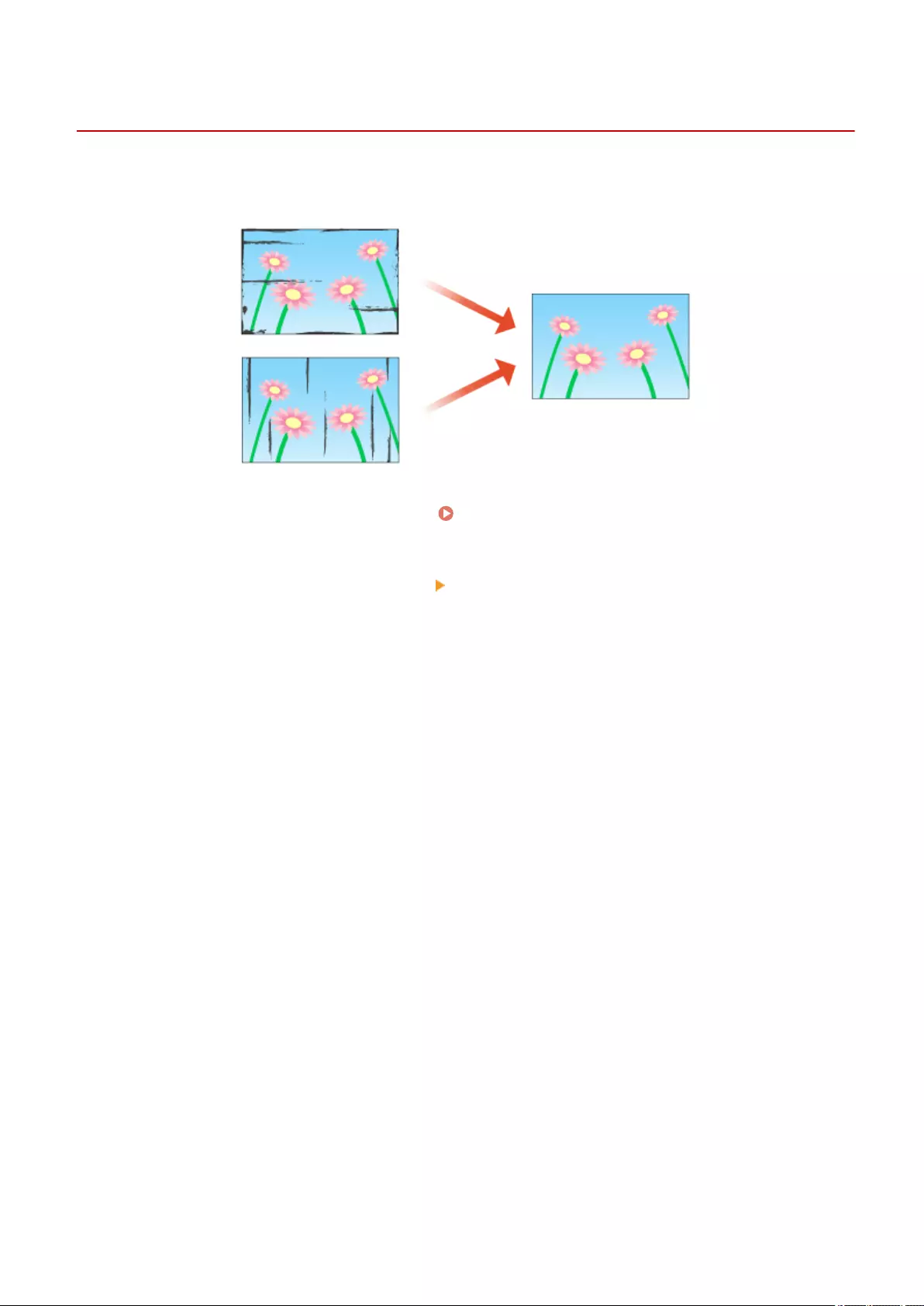
Preventing Abrasion
2579-09X
Perform <Abrasion Prevention> if the print sides of paper are smudged with ink. This may widen the space between
the paper and print head and alleviate the problem. This can be set individually for 1-sided and 2-sided printing.
1Select <Menu> in the Home screen. Home Screen(P. 120)
2Select <Adjustment/Maintenance> <Adjust Image Quality>.
3Select <Abrasion Prevention>.
4Select <1-sided> or <2-sided>.
5Select <ON> or <OFF>.
Maintenance
604
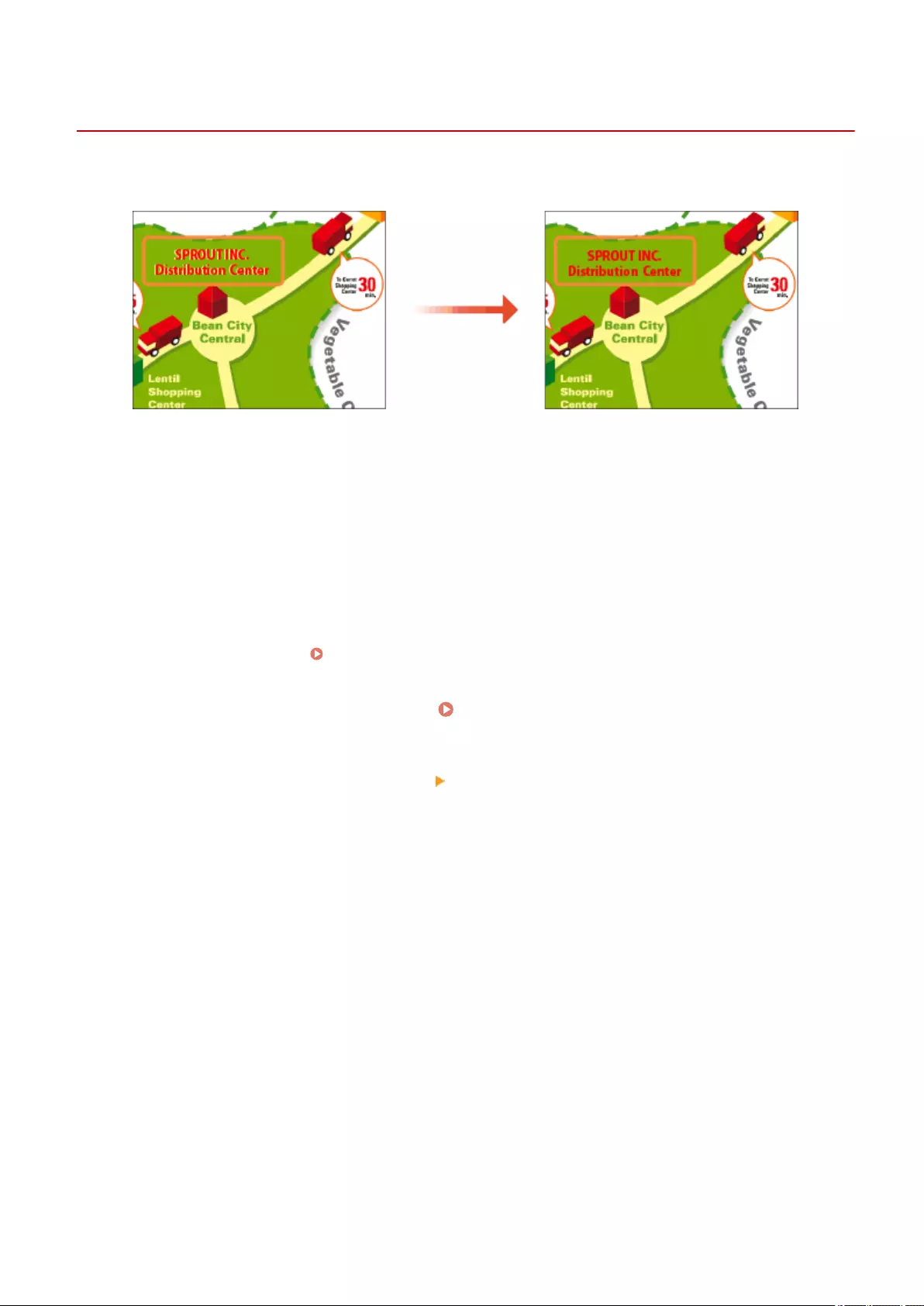
Aligning the Print Head
2579-0HJ
Adjust the position of the print head if colors are not aligned in printouts, etc.
Prepare the following paper.
●Plain paper (recycled paper can be used)
●Size: any of A3, 11x17, LTR, or A4
A3 or 11x17 is recommended.
●Sheets: 1
●Paper clean and white on both front and back
1Load paper in a paper drawer or the multi-purpose tray.
●Make paper settings also. Loading Paper(P. 137)
2Select <Menu> in the Home screen. Home Screen(P. 120)
3Select <Adjustment/Maintenance> <Adjust Image Quality>.
4Select <Print Head Alignment>.
5Check that the size and type of paper displayed on the screen is loaded in the
machine, and select <Next>.
6Conrm the procedure, and select <Start>.
➠An adjustment image is printed.
Maintenance
605
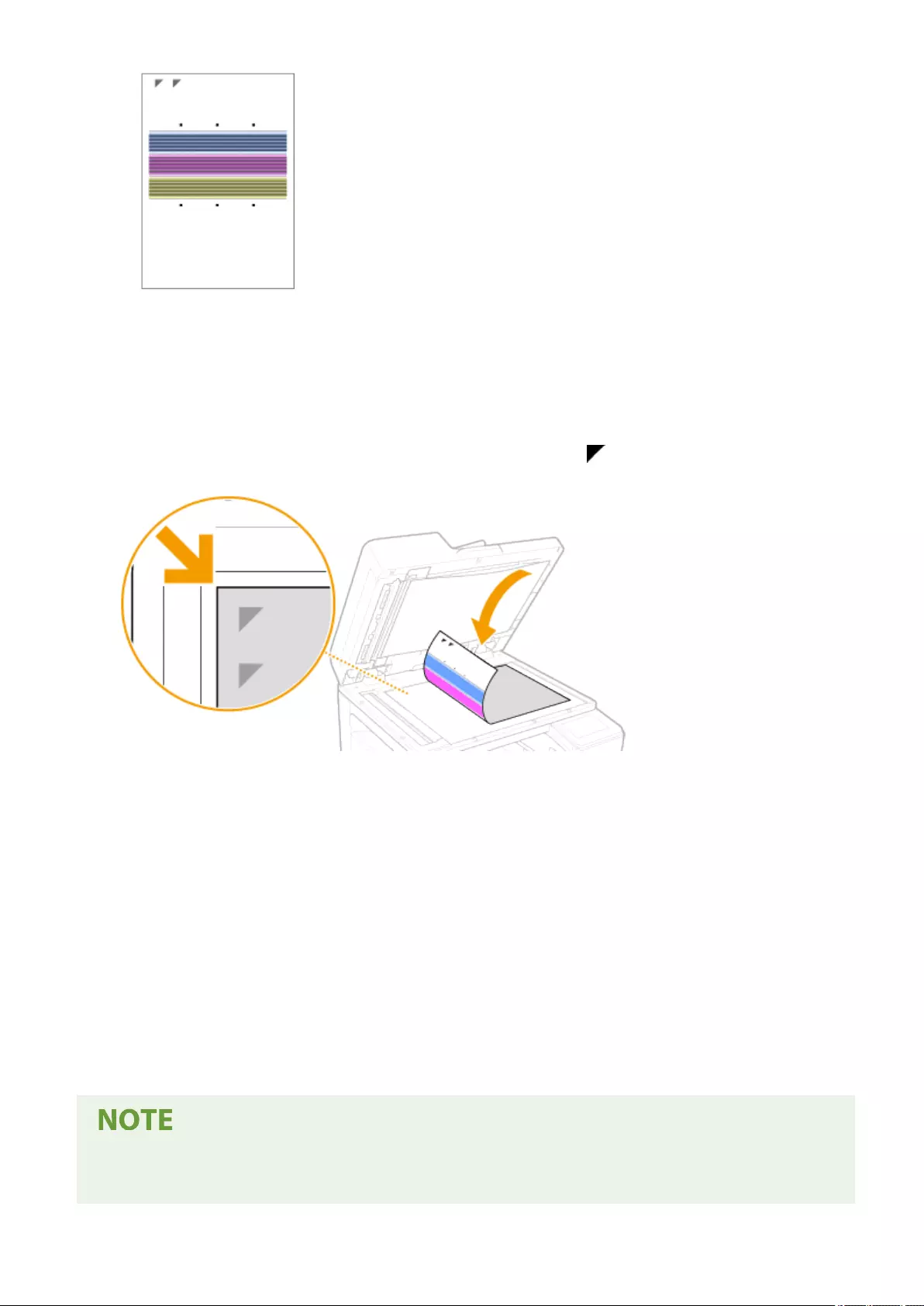
7Open the feeder after the screen displayed during printing disappears.
8Place the adjustment image on the platen glass.
●Place the adjustment image with the print side facing down and the mark in the upper left corner of the
machine.
9Gently close the feeder.
10 Select <Start Scanning>.
➠The placed adjustment image is scanned, and positioning is adjusted for the print head nozzles.
11 When a message appears notifying that adjustment is complete, open the feeder,
and remove the adjustment image.
12 Gently close the feeder.
If <Could not perform correction.> is displayed
●Is the paper displayed in step 5 loaded in the paper source?
Maintenance
606

●Is the adjustment image placed on the platen glass with the print side facing down and the mark in the
upper left corner of the machine?
Maintenance
607
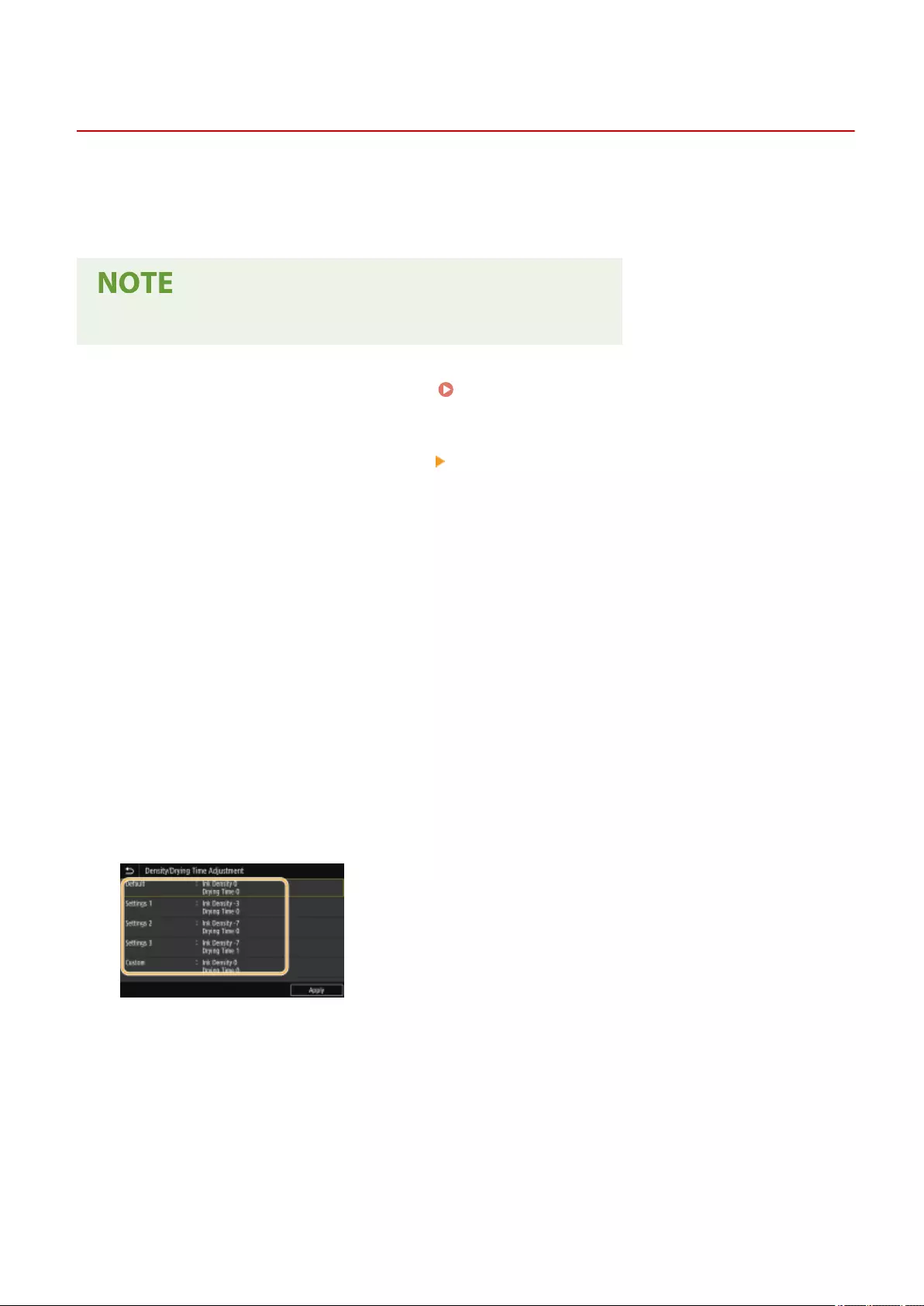
Adjusting the Density and Ink Drying Time
2579-0HK
If ink from already output sheets smudges paper, setting the print density or wait time until ink dries after printing can
correct the problem.
Also, if paper jams during 2-sided printing with weak paper such as short grain paper, setting the print density or wait
time until ink dries after printing can correct the problem.
●Changing the setting from <Default> may cause print speed to be slower.
1Select <Menu> in the Home screen. Home Screen(P. 120)
2Select <Adjustment/Maintenance> <Adjust Image Quality>.
3Select <Density/Drying Time Adjustment>.
4Select <Adjust for All Paper Sources> or <Adjust by Paper Source>.
●To specify settings for all paper sources at the same time, select <Adjust for All Paper Sources>, and proceed
to step 6.
●To specify settings for the multi-purpose tray and paper drawers individually, select <Adjust by Paper
Source>, and proceed to step 5.
5Select the paper source to set.
6Select the setting value.
Correcting soiling on the print side
●Cycle through and try the settings <Settings 1>, <Settings 2>, and <Settings 3>.
●If the issue remains even after trying settings <Settings 1>, <Settings 2>, and <Settings 3>, set each of
density and drying time with <Custom>.
Correcting jamming of paper
●Set print density to 0 and drying time to 10 with <Custom>.
●If the issue remains, set print density to -10 and drying time to 10 with <Custom>.
<Default>
Return to initial settings.
Maintenance
608

<Settings 1> / <Settings 2> / <Settings 3>
These are preset settings. You can select a preset to change settings easily.
<Custom>
You can set any density and drying time.
1Select <Custom>.
2Enter setting values for <Density> and <Drying Time>, and select <Apply>.
7Select <Apply>.
Maintenance
609
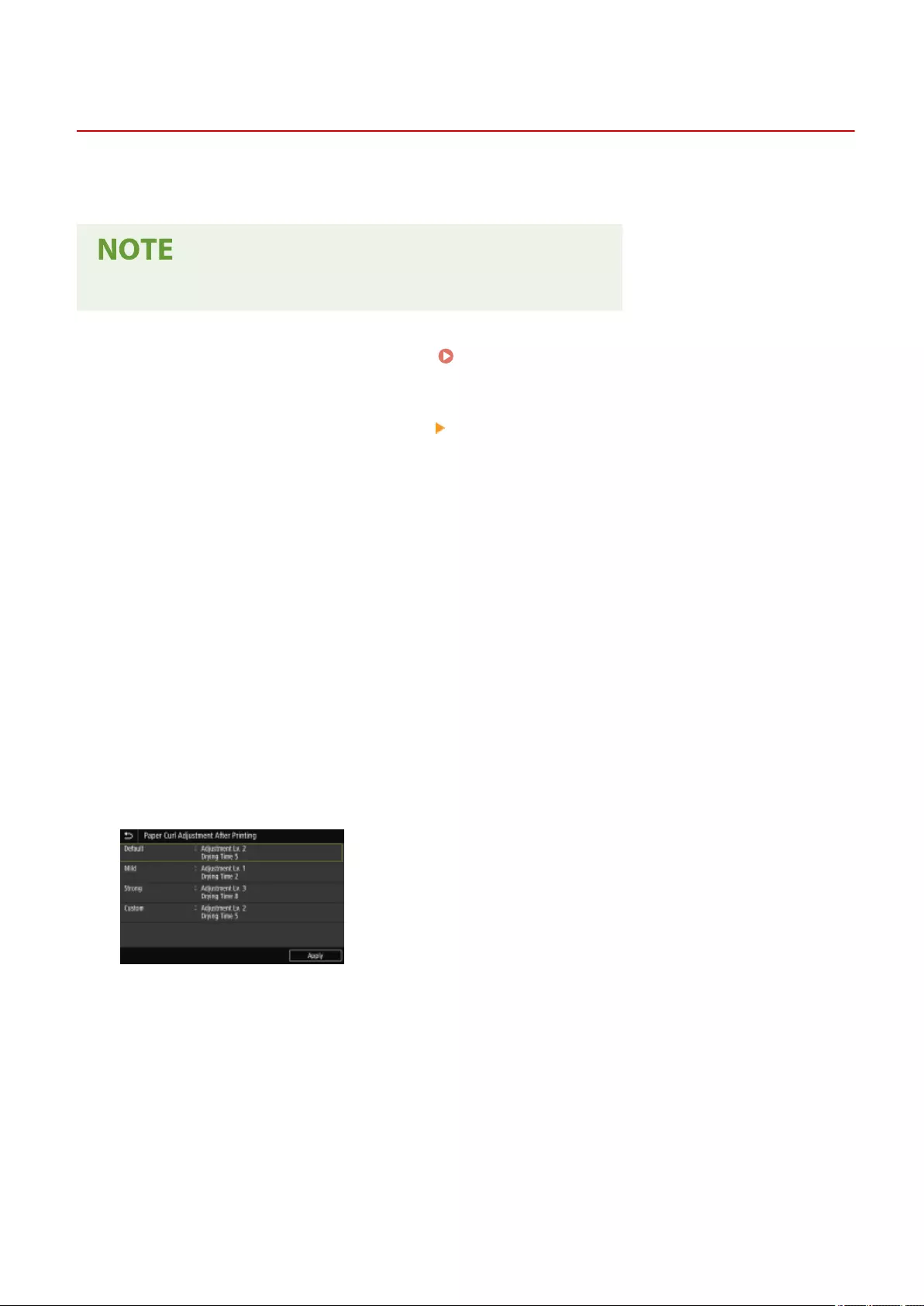
Adjusting Paper Curling after Printing
2579-0HL
Set the level of adjustment for output paper that curls and drying time. Set larger values for adjustment level and
drying time if paper in the output tray is untidy due to paper curling.
●Changing the setting from <Default> may cause print speed to be slower.
1Select <Menu> in the Home screen. Home Screen(P. 120)
2Select <Adjustment/Maintenance> <Adjust Image Quality>.
3Select <Paper Curl Adjustment After Printing>.
4Select <Adjust for All Paper Sources> or <Adjust by Paper Source>.
●To specify settings for all paper sources at the same time, select <Adjust for All Paper Sources>, and proceed
to step 6.
●To specify settings for the multi-purpose tray and paper drawers individually, select <Adjust by Paper
Source>, and proceed to step 5.
5Select the paper source to set.
6Select the setting value.
<Default>
Return to initial settings.
<Mild>
Set this to correct paper curling.
<Strong>
Set this if paper curling causes paper in the output tray to be untidy.
<Custom>
If the issue remains even after trying settings <Mild> and <Strong>, set each of the adjustment level and
drying time.
Maintenance
610

1Select <Custom>.
2Enter setting values for <Adjustment Level> and <Drying Time>, and select <Apply>.
7Select <Apply>.
Maintenance
611
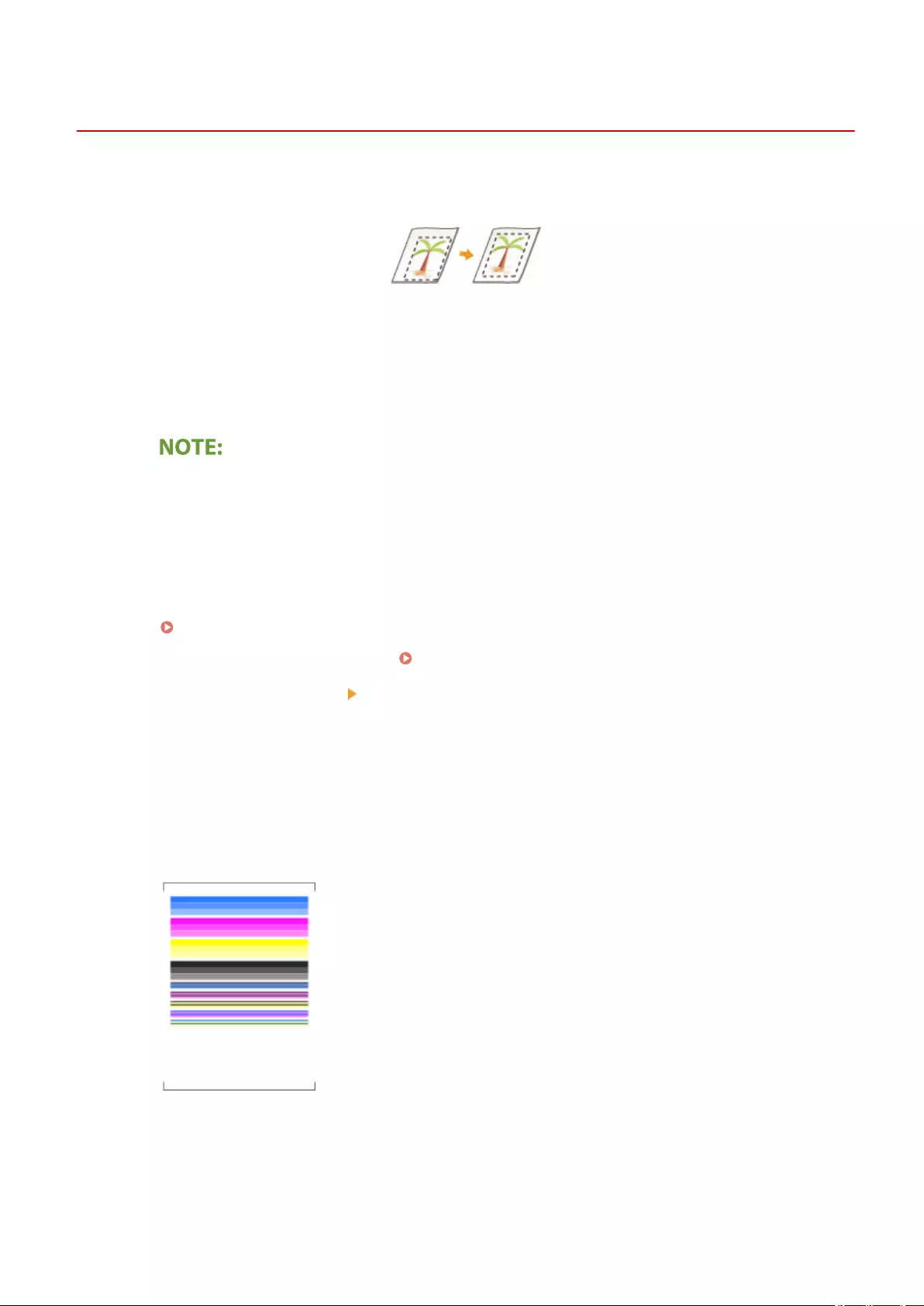
Adjusting Margins
2579-0A0
If a document is printed off center or out of the print area, adjust the margins. You can adjust the margins for each
paper source. Specify adjustment in increments of 0.01 inches (0.1 mm).
1Print a pattern (nozzle check pattern) to adjust margins.
1Either pull out the drawer of the paper source slightly that you will not adjust margins for, or load paper
only in the paper source that you will adjust for.
●It is recommended to adjustment with the paper that will be used.
●Align the edges of the paper on a at surface before loading.
●Align the paper guides with the left and right edges and the back edge of the paper using the paper
size indicator as a guide.
●Do not squeeze the paper too tightly with the paper guides. Doing so may prevent paper from feeding
well.
Basic Paper Loading Method(P. 139)
2In the Home screen, select <Menu>. Home Screen(P. 120)
3<Adjustment/Maintenance> <Maintenance>.
4Select <Nozzle Check Pattern>.
5Select the paper type.
6Check that the paper displayed on the screen is loaded, and select <OK>.
7Select <Start>.
➠The check pattern is printed.
8On the next screen, select <A>, and then <Close>.
2Check the margin adjustment values to adjust margins.
●Check the direction and distance to adjust.
Maintenance
612
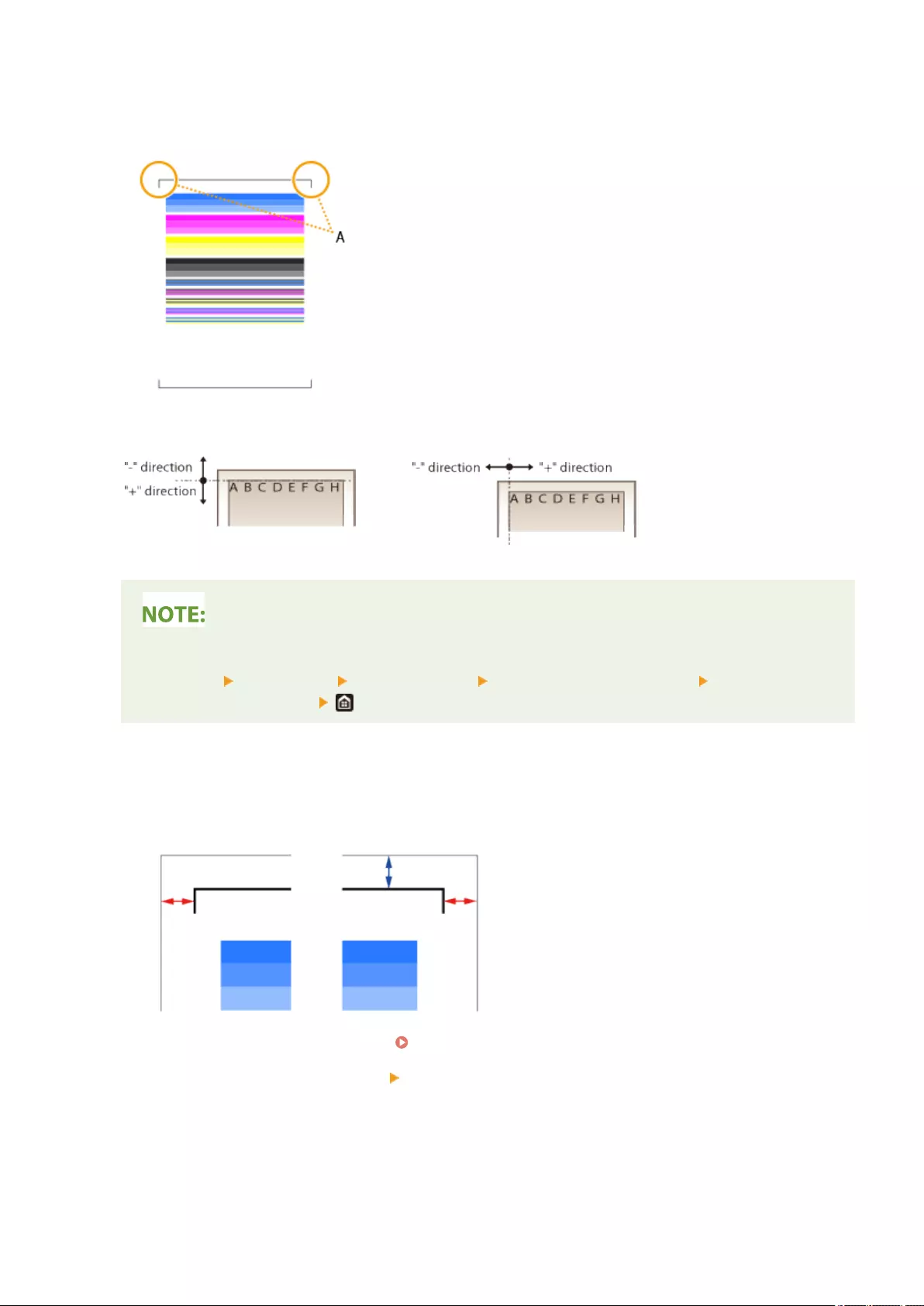
To adjust the margins, specify the direction using "+" and "-" and the distance using "mm". For <Top Margin>,
specify a value with "+" to shift the print position in the up-to-down direction. For <Left Margin>, specify a
value with "+" to shift the print position in the left-to-right direction. To shift in the reverse direction, specify a
value with "-".
A:Leading edge of the printed pattern
<Top Margin> <Left Margin>
●To specify "inch" instead of "mm", perform the following settings.
<Menu> <Preferences> <Display Settings> <Millimeter/Inch Entry Switch> Select
<Millimeter> or <Inch>
1Check the adjustment values so that the black frame of the check pattern located near the leading edge
of the print pattern is printed as follows.
Check the adjustment value to make the left and right margins (the length of the red arrow) the same.
Check the adjustment value so that the leading edge margin (the length of the blue arrow) is about
0.16 inches (4 mm).
2Select <Menu> in the Home screen. Home Screen(P. 120)
3Select <Adjustment/Maintenance> <Adjust Image Quality>.
4Select <Margin Adjustment>.
5Select the paper source.
Maintenance
613
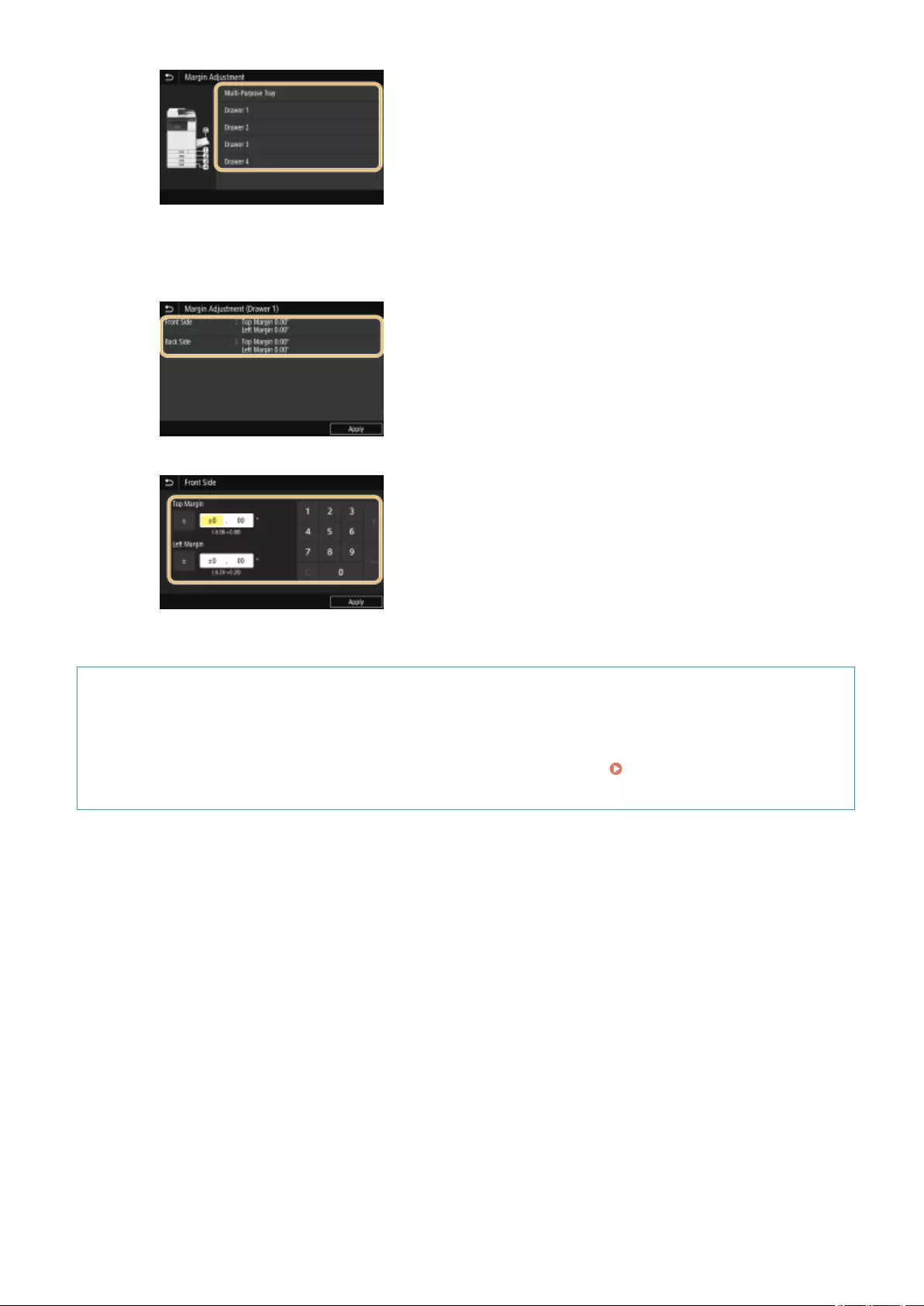
6Select the printing side to adjust.
●If performing 1-sided printing, select <Front Side>.
●If performing 2-sided printing, select <Front Side> and <Back Side>.
7Specify adjustment values, and select <Apply>.
8Select <Apply>.
Adjusting the Print Position for All Print Jobs
●You can use <Function Settings> in the setting menu of the operation panel to adjust the print position for
all print jobs, irrespective of the paper source. The print position can be adjusted in 0.01 inch (0.5 mm)
increments between -2.00 inches (-50.0 mm) and +2.00 inches (+50.0 mm). <Offset Short Edge/Offset
Long Edge>(P. 466)
3To check whether the margin adjustment was performed correctly, print a nozzle
check pattern again.
●Perform step 1 to check that the black border of the check pattern is printed equally on the left and right
sides and that the leading edge margin is about 0.16 inches (4 mm).
Maintenance
614
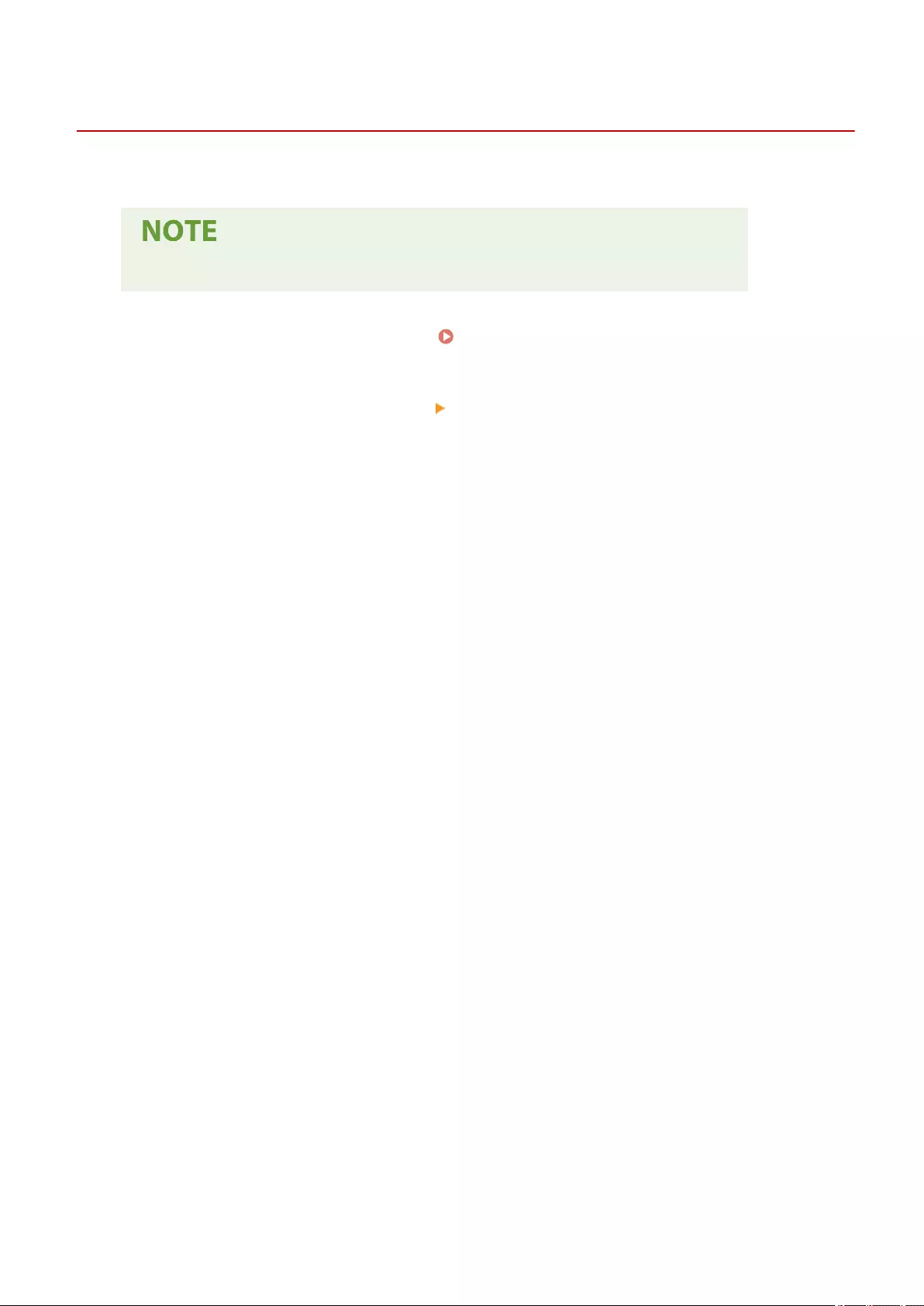
Correcting Arching of Paper when Output
2579-0JA
Perform <Paper Curl Prevention On Output> if output paper arches or rolls back. This can be set for each paper tray.
●When set to <On>, print speed and density may change depending on the paper type.
1Select <Menu> in the Home screen. Home Screen(P. 120)
2Select <Adjustment/Maintenance> <Adjust Image Quality>.
3Select <Paper Curl Prevention On Output>.
4Select the paper source to set.
5Select <On> or <Off>.
Maintenance
615
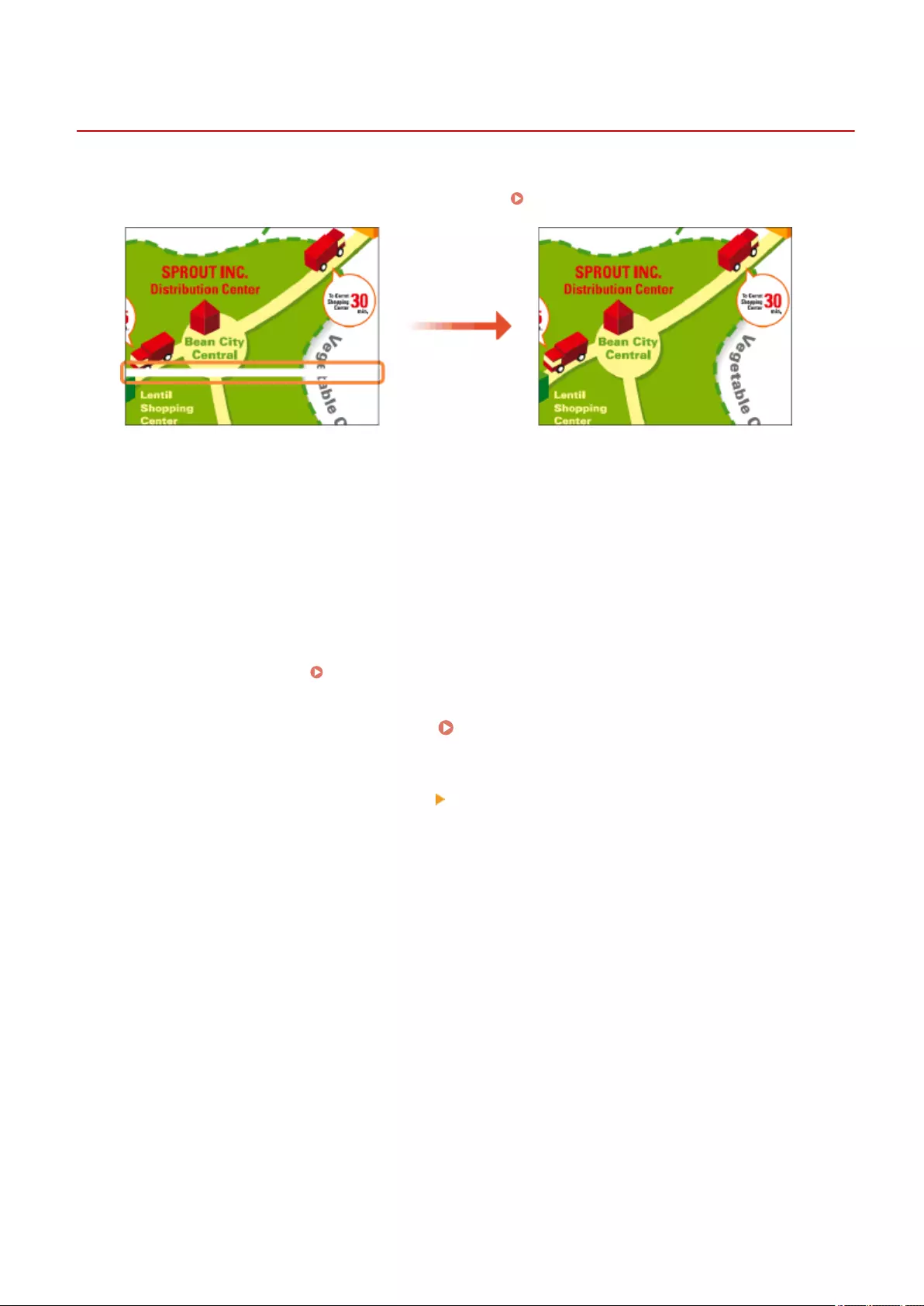
Correcting White Streaks
2579-0K5
Perform this correction if white streaks are not corrected even after performing print head cleaning.
Perform print head cleaning rst if it has not yet been performed. Cleaning the Print Head(P. 526)
Prepare the following paper.
●Plain paper (recycled paper can be used)
●Size: any of A3, 11x17, LTR, or A4
A3 or 11x17 is recommended.
●Sheets: 1
●Paper clean and white on both front and back
1Load paper in a paper drawer or the multi-purpose tray.
●Make paper settings also. Loading Paper(P. 137)
2Select <Menu> in the Home screen. Home Screen(P. 120)
3Select <Adjustment/Maintenance> <Adjust Image Quality>.
4Select <White Streak Correction>.
5Check that the size and type of paper displayed on the screen is loaded in the
machine, and select <Next>.
6Conrm the procedure, and select <Start>.
➠An adjustment image is printed.
Maintenance
616

7Open the feeder after the screen displayed during printing disappears.
8Place the adjustment image on the platen glass.
●Place the adjustment image with the print side facing down and the mark in the upper left corner of the
machine.
9Gently close the feeder.
10 Select <Start Scanning>.
➠The placed adjustment image is scanned, and white streaks are corrected.
11 When a message appears notifying that adjustment is complete, open the feeder,
and remove the adjustment image.
12 Gently close the feeder.
If <Could not perform correction.> is displayed
●Is the paper displayed in step 5 loaded in the paper source?
Maintenance
617

●Is the adjustment image placed on the platen glass with the print side facing down and the mark in the
upper left corner of the machine?
Maintenance
618
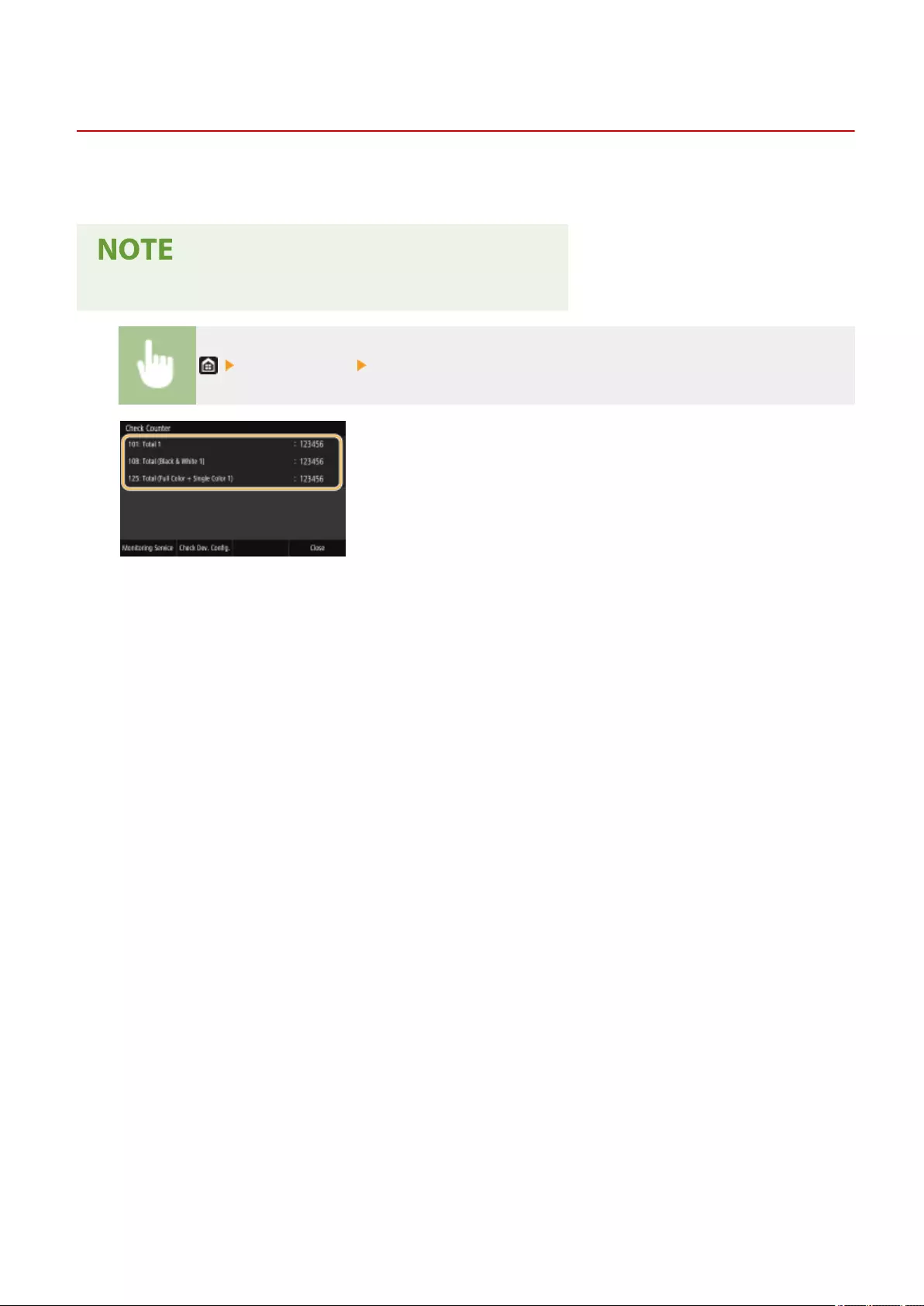
Viewing the Counter Value
2579-0A1
You can check separate totals for the number of pages used for color printouts and black and white printouts. These
totals include faxes, reports, and lists, in addition to copies and printouts of data from computers.
●Displayed items may differ depending on your country or region.
<Check Counter> Check the number of pages printed
<101: Total 1>
Displays the total number of pages copied and printed.
<108: Total (Black & White 1)>
Displays the total number of pages copied and printed in black and white.
<112: Total (Black & White/Large)>
Displays the total number of pages copied and printed in black and white.
<113: Total (Black & White/Small)>
Displays the total number of pages copied and printed in black and white (B4 or smaller sizes).
<114: Total 1 (2-Sided)>
Displays the total number of pages copied and printed with 2-sided.
<122: Total (Full Color + Single Color/Large)>
Displays the total number of pages copied and printed in color.
<123: Total (Full Color + Single Color/Small)>
Displays the total number of pages copied and printed in color (B4 or smaller sizes).
<229: Copy (Full Color + Single Color/Large)>
Displays the total number of pages for color copying.
<230: Copy (Full Color + Single Color/Small)>
Displays the total number of pages for color copying (B4 or smaller sizes).
<301: Print (Total 1)>
Displays the total number of pages print.
<321: Print (Full Color + Single Color/Large)>
Displays the total number of pages for color printing.
<322: Print (Full Color + Single Color/Small)>
Displays the total number of pages for color printing (B4 or smaller sizes).
<401: Copy + Print (Full Color/Large)>
Displays the total number of pages copied and printed in color.
Maintenance
619

<402: Copy + Print (Full Color/Small)>
Displays the total number of pages copied and printed in color (B4 or smaller sizes).
<501: Scan (Total 1)>
Displays the total number of pages scanned.
Maintenance
620
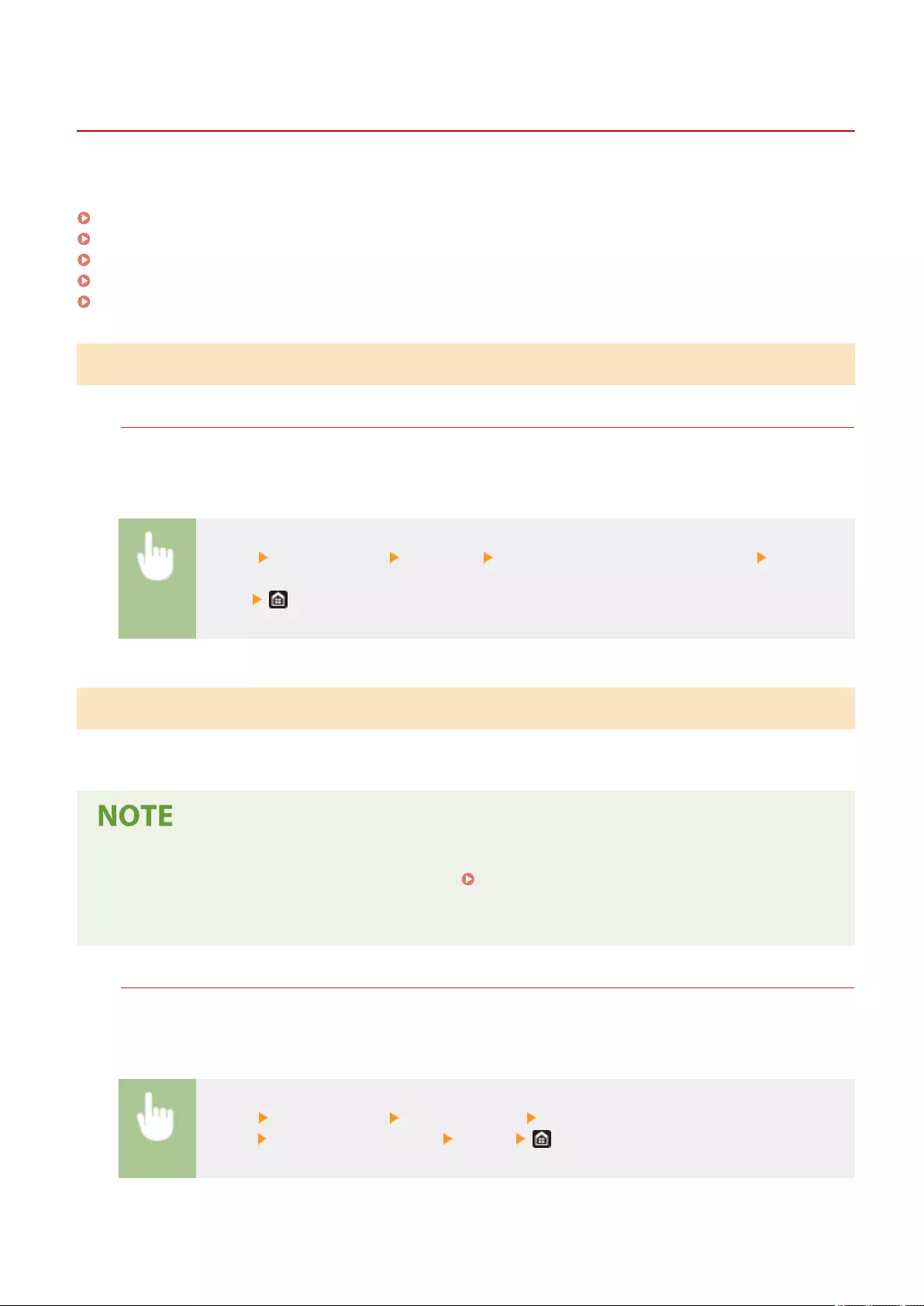
Printing Reports and Lists
2579-0HR
You can print reports and lists to check information such as the conditions of each department and machine settings.
Printing Use Condition Reports by Department(P. 621)
Setting Reports on the Communication Results(P. 621)
Printing Lists of Settings(P. 623)
Printing Reports on Print Head Usage(P. 624)
Printing Reports on the Usage Condition of the Machine(P. 624)
Printing Use Condition Reports by Department
Department ID Management Report
When Department ID Management is enabled, you can check the total volume of printouts for each
<Department ID> by printing a Department ID Management Report. By checking the printout totals, you can
better manage your paper and ink tank supplies.
<Menu> <Output Report> <Print List> <Department ID Management Report> Check that
the size and type of paper displayed on the screen is loaded in the machine, and select
<Start>
Setting Reports on the Communication Results
You can print reports on the results of sending/receiving by e-mail, fax, and I-Fax, or saving to shared folders and FTP
servers. Some reports can be printed automatically while others are only printed when an error occurs.
●If "Result" in a printed list contains "NG," you can check details of the error from a three-digit number
prexed with "#" displayed in the next to the result. Countermeasures for Each Error Code(P. 677)
●Reports printed for e-mail/I-Fax indicate the transmission result between the machine and the mail server,
not between the machine and the destination address.
Communication Management Report
You can check the fax and e-mail logs of sent and received documents by printing a Communication
Management Report. The report can be printed automatically after every 40 transmissions, or you can print it
manually.
<Menu> <Output Report> <Report Settings> <Communication Management
Report> Congure report settings <Apply>
Maintenance
621
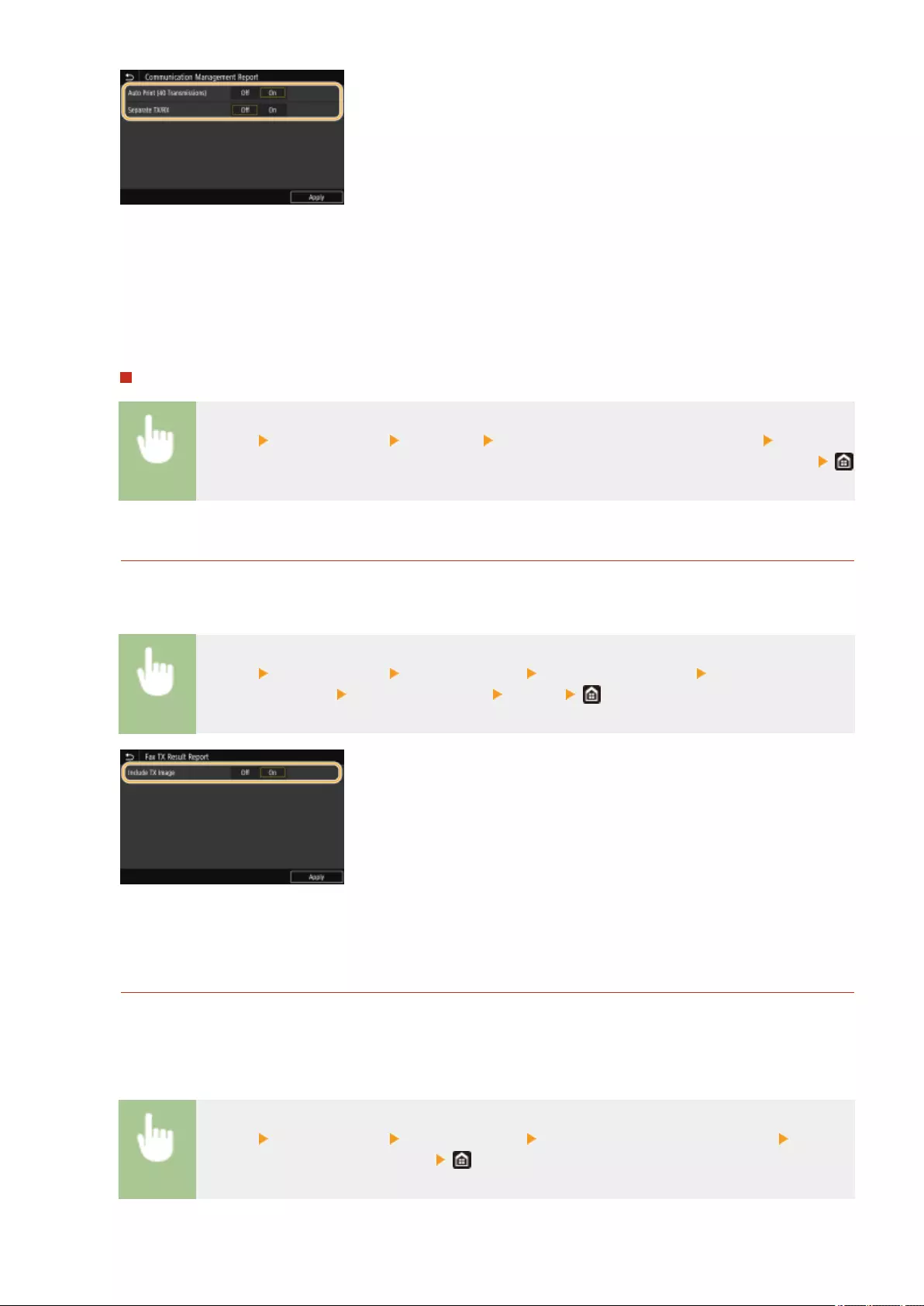
<Auto Print (40 Transmissions)>
Select <On> to print the report automatically after every 40 transmissions, or <Off> if you do not want to print
the report automatically.
<Separate TX/RX>
Select <On> to print sent and received reports separately, or <Off> to print both reports on one sheet.
Print the report manually
<Menu> <Output Report> <Print List> <Communication Management Report> Check that
the size and type of paper displayed on the screen is loaded in the machine and select <Start>
Fax TX Result Report
You can check the communication result of sending faxes with a TX Result Report. The report can be printed
either every time a transmission is completed or only when a sending error occurs.
<Menu> <Output Report> <Report Settings> <Fax TX Result Report> Select <On> or <Only
When Error Occurs> Select <Off> or <On> <Apply>
<Include TX Image>
When you select <On>, a part of a sent document can be included in the TX Result Report.
E-Mail/I-Fax/File TX Result Report
You can check the communication results of sending e-mails or I-Faxes and saving documents to the shared
folder or FTP server with a TX Result Report. The report can be printed automatically each time a
communication is completed. If necessary, you can congure a setting so that the report is printed only when a
sending error occurs.
<Menu> <Output Report> <Report Settings> <E-Mail/I-Fax/File TX Result Report> Select
<On> or <Only When Error Occurs>
Maintenance
622
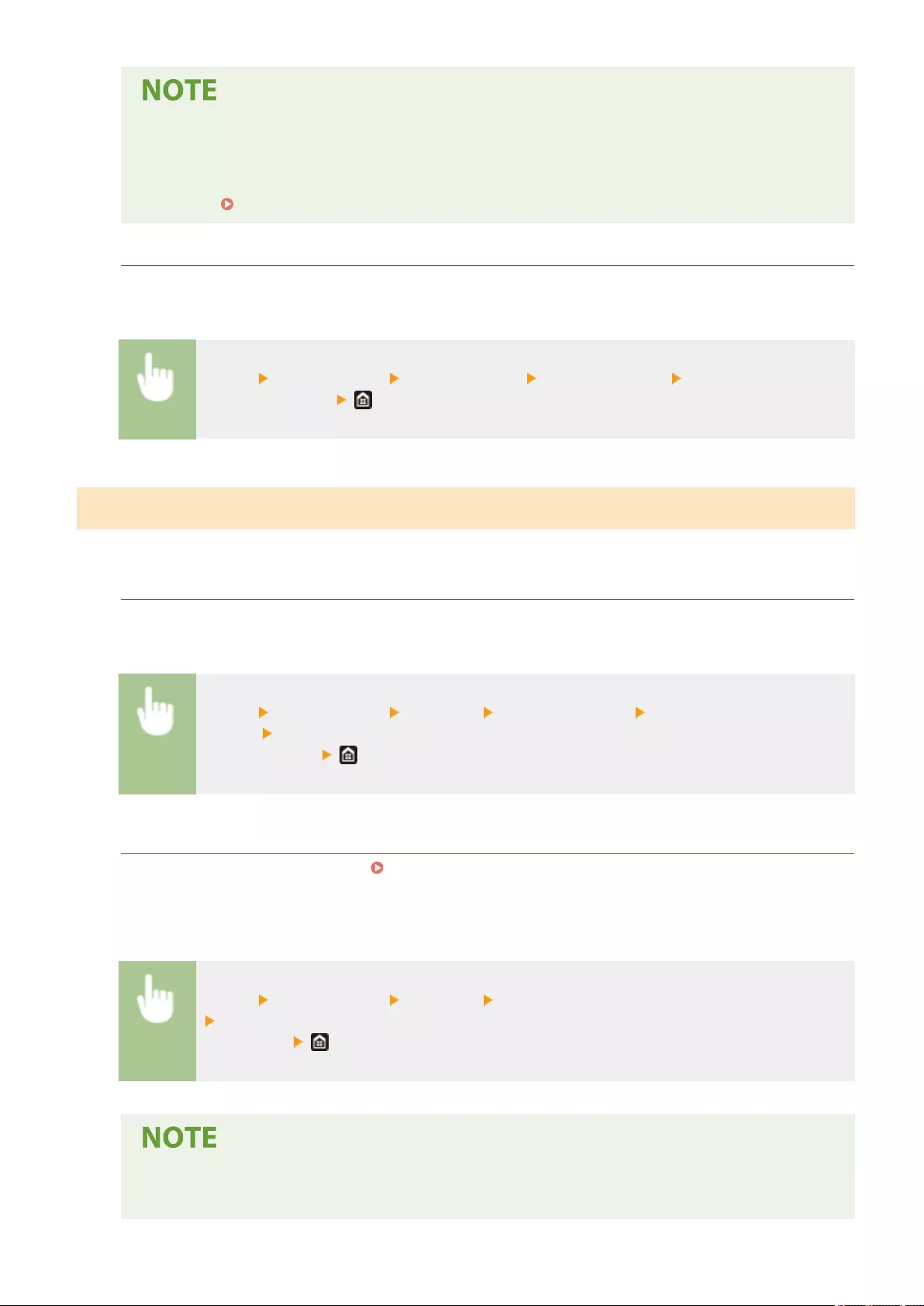
Communication result
●If an error occurs during transmission by e-mail/I-Fax or saving to a shared folder/FTP server, the
report does not show the error code. To check the error code, print a Communication Management
Report. Communication Management Report(P. 621)
RX Result Report
You can check the logs of received fax and I-Fax documents by printing an RX Result Report. The report can be
printed either every time a transmission is completed or only when a receiving error occurs.
<Menu> <Output Report> <Report Settings> <RX Result Report> Select <On> or <Only
When Error Occurs>
Printing Lists of Settings
You can print information and settings registered in the machine as a list.
Address Book List
You can check the list of destinations registered in the Address Book as <Coded Dial>, <Favorites>, and <Group>
by printing an Address Book List.
<Menu> <Output Report> <Print List> <Address Book List> Select the setting you want to
print out Check that the size and type of paper displayed on the screen is loaded in the machine,
and select <Start>
User Data List/System Manager Data List
You can check the list of the settings ( Setting Menu List(P. 431) ) as well as the content that has been
registered in the machine by printing a User Data List or a System Manager Data List. Both lists include the
rmware version, the paper size and type registered in the machine, and the print settings of TX Result Report,
Communication Management Report, and RX Result Report.
<Menu> <Output Report> <Print List> <User Data List> or <System Manager Data List>
Check that the size and type of paper displayed on the screen is loaded in the machine, and
select <Start>
●The User Data List does not include certain settings such as Network Settings and Management
Settings. To check all the settings items print the System Manager Data List.
Maintenance
623
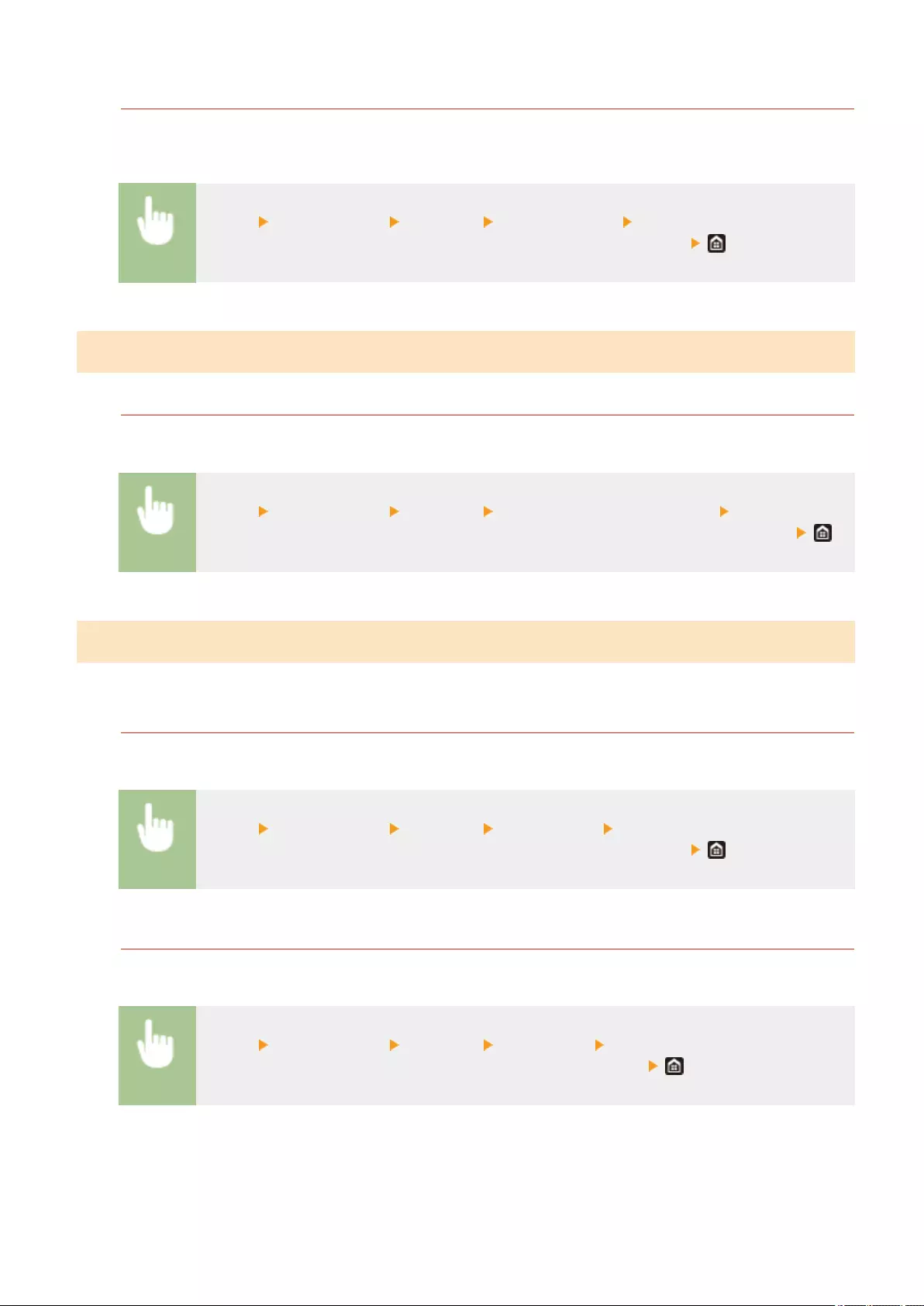
IPSec Policy List
You can check the list of policy names and the IPSec settings registered in the machine by printing an IPSec
Policy List.
<Menu> <Output Report> <Print List> <IPSec Policy List> Check that the size and type of
paper displayed on the screen is loaded in the machine, and select <Start>
Printing Reports on Print Head Usage
Print Head Information Report
You can print a report showing the condition of the print head and its usage.
<Menu> <Output Report> <Print List> <Print Head Information Report> Check that the
size and type of paper displayed on the screen is loaded in the machine, and select <Start>
Printing Reports on the Usage Condition of the Machine
You can print the list of fonts available in PCL or PS mode.
PCL Font List
You can check the list of fonts available in PCL mode.
<Menu> <Output Report> <Print List> <PCL Font List> Check that the size and type of
paper displayed on the screen is loaded in the machine, and select <Start>
PS Font List
You can check the list of fonts available in PS mode.
<Menu> <Output Report> <Print List> <PS Font List> Check that the size and type of paper
displayed on the screen is loaded in the machine, and select <Start>
Maintenance
624

Consumables
2579-0A3
●To handle and store consumables, observe precautions in "Getting Started" provided for this product.
●Depending on the installation environment, printing paper size, or original type, you may need to replace
consumables before the end of the estimated lifetime.
●Specifying an auto shutdown time shorter than the default setting (4 hours) may shorten the life of the ink
tanks.
◼Ink Tanks
Replacement Ink Tanks
For optimum print quality, using Canon genuine ink tanks is recommended. Check the model number for the
ink tanks in Getting Started.
You can also check the model number for the installed ink tanks with the procedure below.
<Status Monitor> <Device Information> <Consumables Information> <Check
Consumables Name> Check the product numbers
Precautions Regarding Ink Tanks
●Modifying or disassembling ink tanks such as by opening a hole may allow ink to leak and cause the
printer to malfunction. It is not recommended that you modify or disassemble ink tanks.
●Use of non-genuine ink such as by relling ink can deteriorate print quality and cause the print head
to malfunction. While not a safety hazard, instances of overheating/smoke generation* from the print
head area have been reported that are likely due to ink components not in genuine products. It is
recommended that you use genuine Canon ink.*
●Servicing required due to use of non-genuine ink tanks or non-genuine ink is provided at cost even if
within the maintenance contract period or the warranty period.*
●Repair of products having used non-genuine ink tanks or non-genuine ink may be subject to special
charges for additional special inspection, regardless of any maintenance contract or of free/at-cost
repairs.*
●Replace ink tanks quickly once required, and do not leave the machine without ink tanks installed.
Maintenance
625
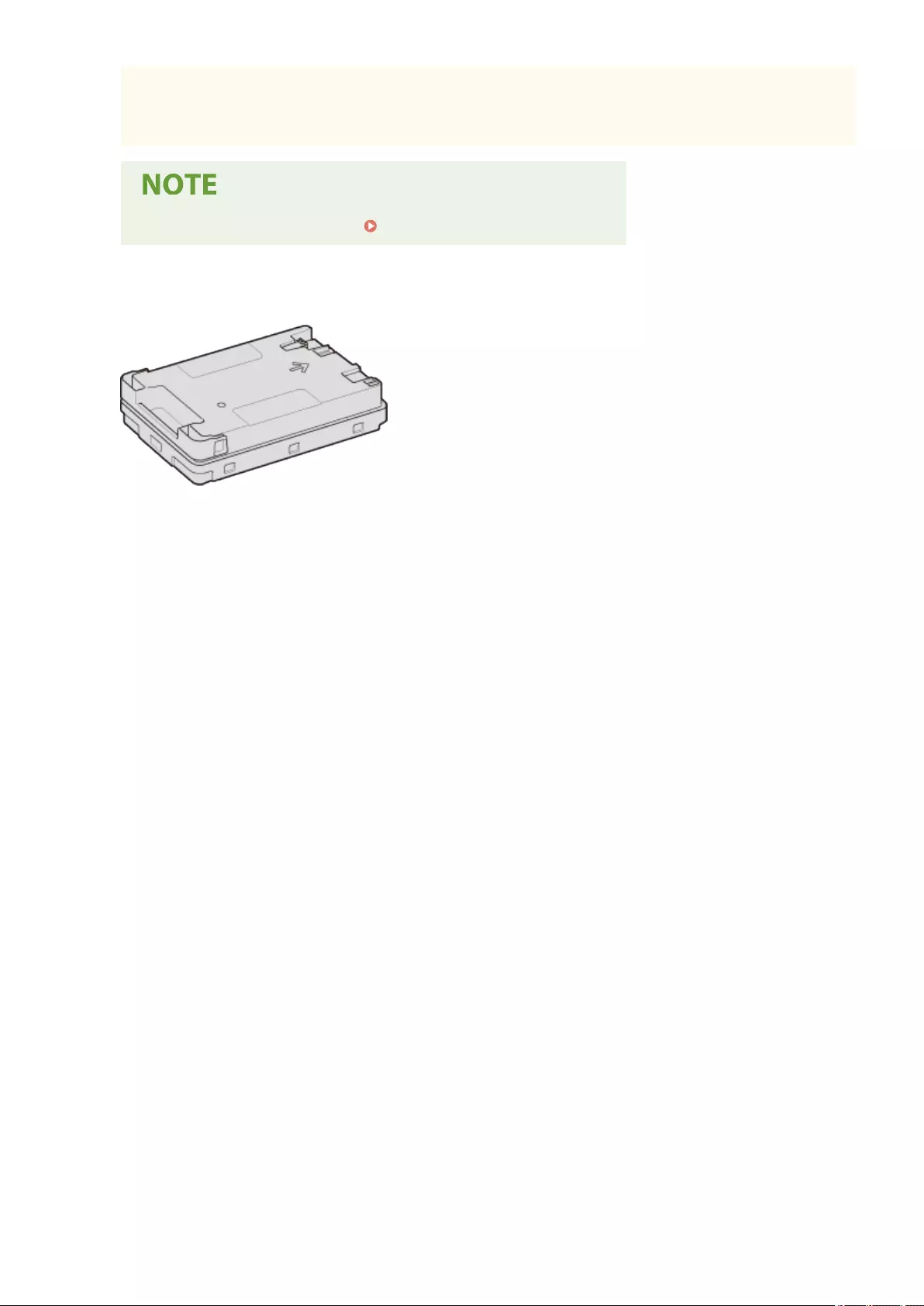
●Install new ink tanks when replacing. Installing ink tanks with ink consumed can cause nozzles to
become clogged. The machine also cannot display correct times for replacing ink tanks.
* The above instances have not been reported for all non-genuine ink.
●When replacing ink tanks, see Replacing the Ink Tanks(P. 528) .
◼Maintenance Cartridge
●Maintenance Cartridge MC50
Maintenance
626

Frequently Asked Questions
Frequently Asked Questions ................................................................................................................... 628
Common Problems ............................................................................................................................................ 630
Installation/Settings Problems ..................................................................................................................... 631
Copying/Printing Problems .......................................................................................................................... 635
Faxing/Telephone Problems ......................................................................................................................... 638
When You Cannot Print Properly ...................................................................................................................... 640
Printing Results Are Not Satisfactory ............................................................................................................ 641
Paper Creases or Curls ................................................................................................................................. 651
Paper Is Fed Incorrectly ................................................................................................................................ 653
A Message or a Number Starting with "#" (an Error Code) Is Displayed ........................................................ 655
Countermeasures for Each Message ............................................................................................................ 656
Countermeasures for Each Error Code ......................................................................................................... 677
Clearing Paper Jams .......................................................................................................................................... 686
Paper Jams in the Feeder .............................................................................................................................. 688
Paper Jams in the Main Unit ......................................................................................................................... 691
Paper Jams in a Paper Source ....................................................................................................................... 695
When a Problem Cannot Be Solved .................................................................................................................. 699
Frequently Asked Questions
627
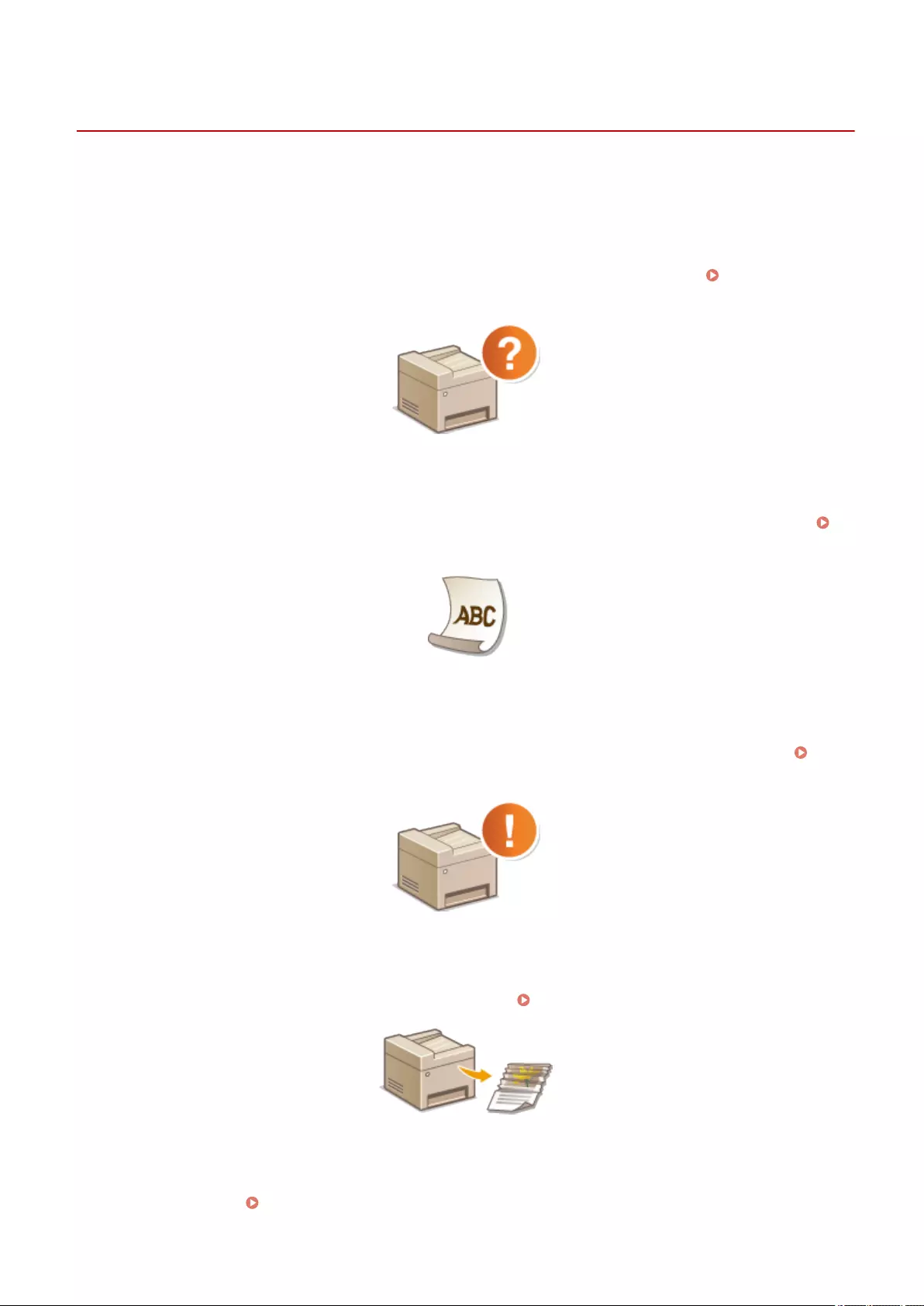
Frequently Asked Questions
2579-0A4
When a problem occurs, check this chapter to nd out solutions before contacting Canon.
◼Check First
This section describes how to take action when you suspect that the machine is malfunctioning. Common
Problems(P. 630)
◼When You Cannot Print Properly
This section describes how to take action when printing results are not satisfactory or the paper creases or curls.
When You Cannot Print Properly(P. 640)
◼A Message or a Number Starting with "#" (an Error Code) is Displayed
This section describes how to take action when a message or error code (three digits) appears on the display. A
Message or a Number Starting with "#" (an Error Code) Is Displayed(P. 655)
◼Clearing Paper Jams
This section describes how to take action when a paper is jammed. Clearing Paper Jams(P. 686)
◼When a Problem Cannot Be Solved
If a problem persists, see When a Problem Cannot Be Solved(P. 699) to nd out where to contact.
Frequently Asked Questions
628

Frequently Asked Questions
629
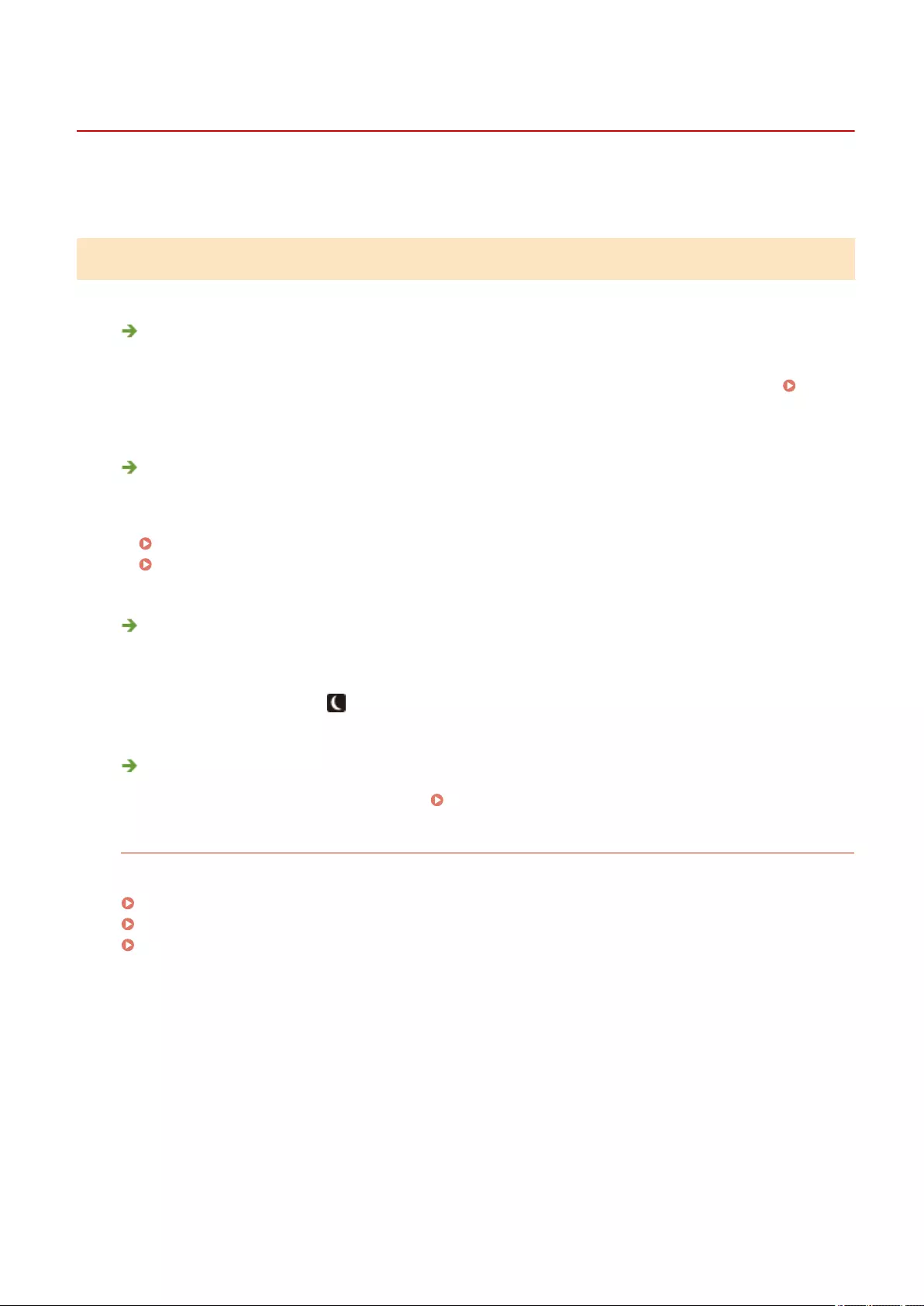
Common Problems
2579-0HS
When a problem occurs, check this chapter to nd out solutions before contacting Canon. If the problems persist,
contact your local authorized Canon dealer or the Canon help line.
Check the Following
Is the machine turned ON? Is the power cord connected?
●If the machine is turned ON but does not respond, turn it OFF, check whether the power cord is connected
correctly, and turn it back ON. For information on connecting the power cord, see Getting Started.
Manuals and Their Contents(P. 733)
Are the phone cord, LAN cable and USB cable connected correctly?
●Check whether these cables are connected correctly. Use care not to mistake the phone cord's port for the
other cables' ports.
Connecting the Telephone Line(P. 86)
Parts and Their Functions(P. 102)
Is sleep mode activated?
●If you leave the machine unattended for a specic period of time, it enters sleep mode for power
conservation, not allowing you to operate it.
To cancel sleep mode, press .
Is any message displayed on the screen?
●If a problem occurs, a message is displayed. Countermeasures for Each Message(P. 656)
If a problem persists even after checking
Click the link that corresponds to the problem.
Installation/Settings Problems(P. 631)
Copying/Printing Problems(P. 635)
Faxing/Telephone Problems(P. 638)
Frequently Asked Questions
630
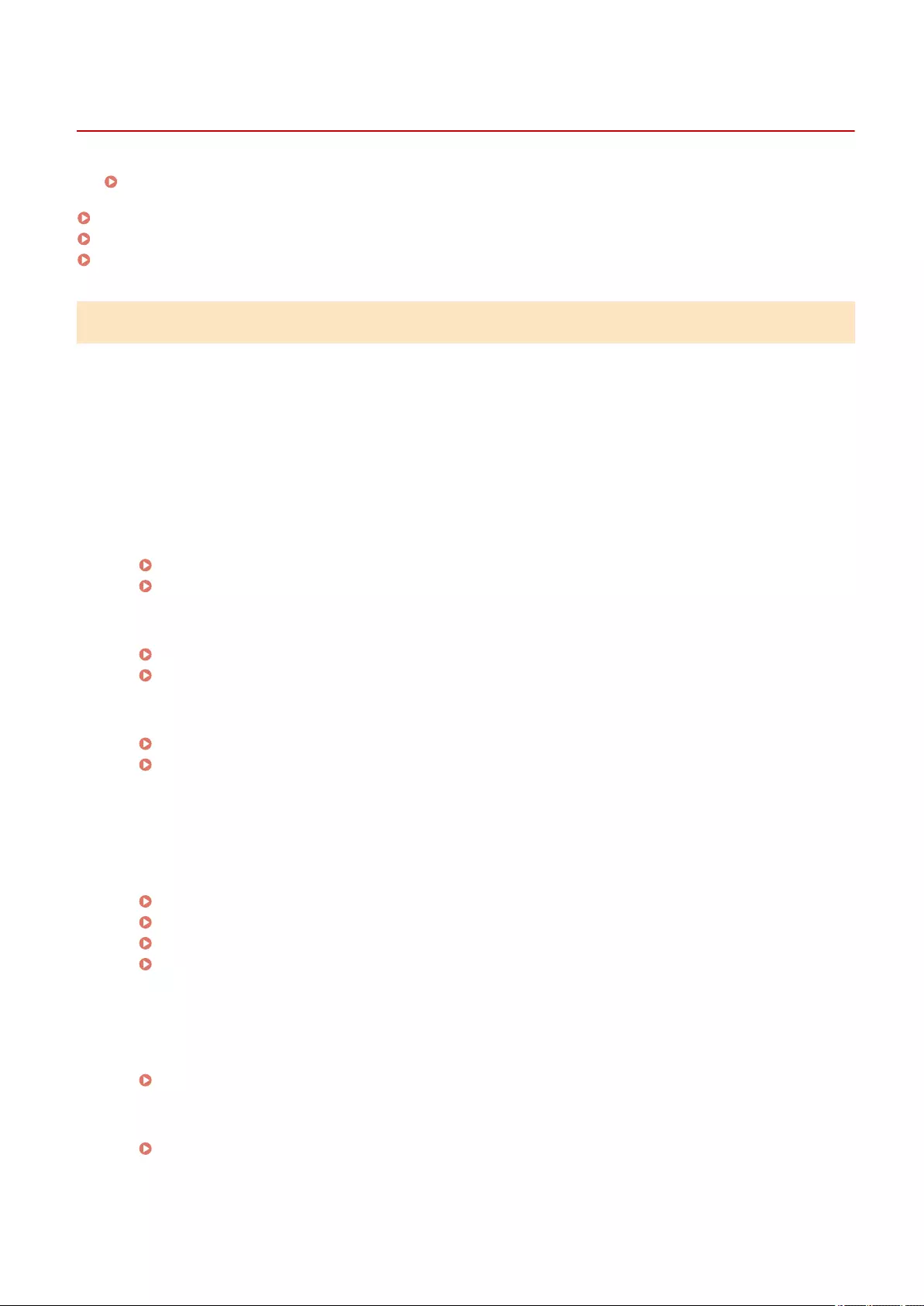
Installation/Settings Problems
2579-0A6
See Common Problems(P. 630) also.
Problems with the Wireless/Wired LAN Connection(P. 631)
Problem with the USB Connection(P. 634)
Problem with the Print Server(P. 634)
Problems with the Wireless/Wired LAN Connection
The wireless LAN and wired LAN cannot be connected at the same time.
●The wireless LAN and wired LAN cannot be connected at the same time. The following can be used at the
same time: a USB cable and a wireless LAN, or a USB cable and a wired LAN.
Remote UI is not displayed.
●Are <Use HTTP> and <Use Remote UI> set to <On>?
Disabling HTTP Communication(P. 403)
Disabling Remote UI(P. 404)
●If the machine is connected to a wireless LAN, check that the Wi-Fi icon is displayed in the Home screen and
that the IP address is set correctly, and then start the Remote UI again.
Home Screen(P. 120)
Viewing Network Settings(P. 41)
●If the machine is connected to a wired LAN, check that the cable is connected rmly and the IP address is set
correctly, and then start the Remote UI again.
Connecting to a Wired LAN(P. 20)
Viewing Network Settings(P. 41)
●Are you using a proxy server? If so, add the machine's IP address to the [Exceptions] list (addresses that do
not use the proxy server) in the Web browser's proxy settings dialog.
●Is communication not limited by the rewall on your computer? If IP addresses are or an MAC address is
incorrectly entered, the Remote UI cannot be displayed. In that case, you need to use the operation panel to
set <IPv4 Address Filter>, <IPv6 Address Filter>, or <MAC Address Filter> to <Off>.
Restricting Communication by Using Firewalls(P. 360)
<IPv4 Address Filter> (P. 446)
<IPv6 Address Filter> (P. 446)
<MAC Address Filter> (P. 446)
A connection to a network cannot be established.
●The IP address may not be set correctly. Set the IP address again.
Setting IP Addresses(P. 34)
●When you connect the machine to a computer via wireless LAN, check whether the machine is properly
installed and ready to connect to the network.
When the Machine Cannot Connect to the Wireless LAN(P. 632)
Frequently Asked Questions
631

You are unsure of the set IP address. Viewing Network Settings(P. 41)
The connection method cannot be switched between a wired LAN and a
wireless LAN.
●Did you select a wired LAN or a wireless LAN on the operation panel on the machine as well? This selection is
required to have the machine switch to your selection.
Selecting Wired LAN or Wireless LAN(P. 19)
You are unsure of SSID and network key for wireless LAN router you want to
connect to.
●Refer to the wireless LAN router itself, its box, or instruction manual, or inquire with the manufacturer.
Checking the SSID and Network Key(P. 33)
The SSID of the wireless router to be connected is not displayed in the access
point list.
●Check whether the SSID for the wireless LAN router you copied down from the router or instruction manual
is wrong.
Checking the SSID and Network Key(P. 33)
●If the SSID of the wireless router is hidden (using a stealth mode*), set the SSID to be visible on the wireless
router.
* A mode that disables the SSID auto-detection of other devices.
●Check whether the machine is properly installed and ready to connect to the network.
When the Machine Cannot Connect to the Wireless LAN(P. 632)
The machine dials up to an unintended connection destination (if a dialup
router is connected to a network).
●If a dialup router does not need to pass broadcast packets, set the dialup router so that the broadcast
packets will not pass. If the dialup router needs to pass broadcast packets, check whether the settings are
correct.
●If a DNS server is located in an external network, set the IP address to be connected, not the host name, even
if connecting to the devices that are on the network that is connected to the machine.
●If a DNS server is located on a network that is connected to the machine and the information about the
devices that are connected to an external network is registered to the DNS server, check whether the settings
are correct.
When the Machine Cannot Connect to the Wireless LAN
Check the status of your computer.
●Have the settings of the computer and the wireless router been completed?
●Are the cables of the wireless router (including the power cord and LAN cable)
correctly plugged in?
●Is the wireless router turned on?
Frequently Asked Questions
632
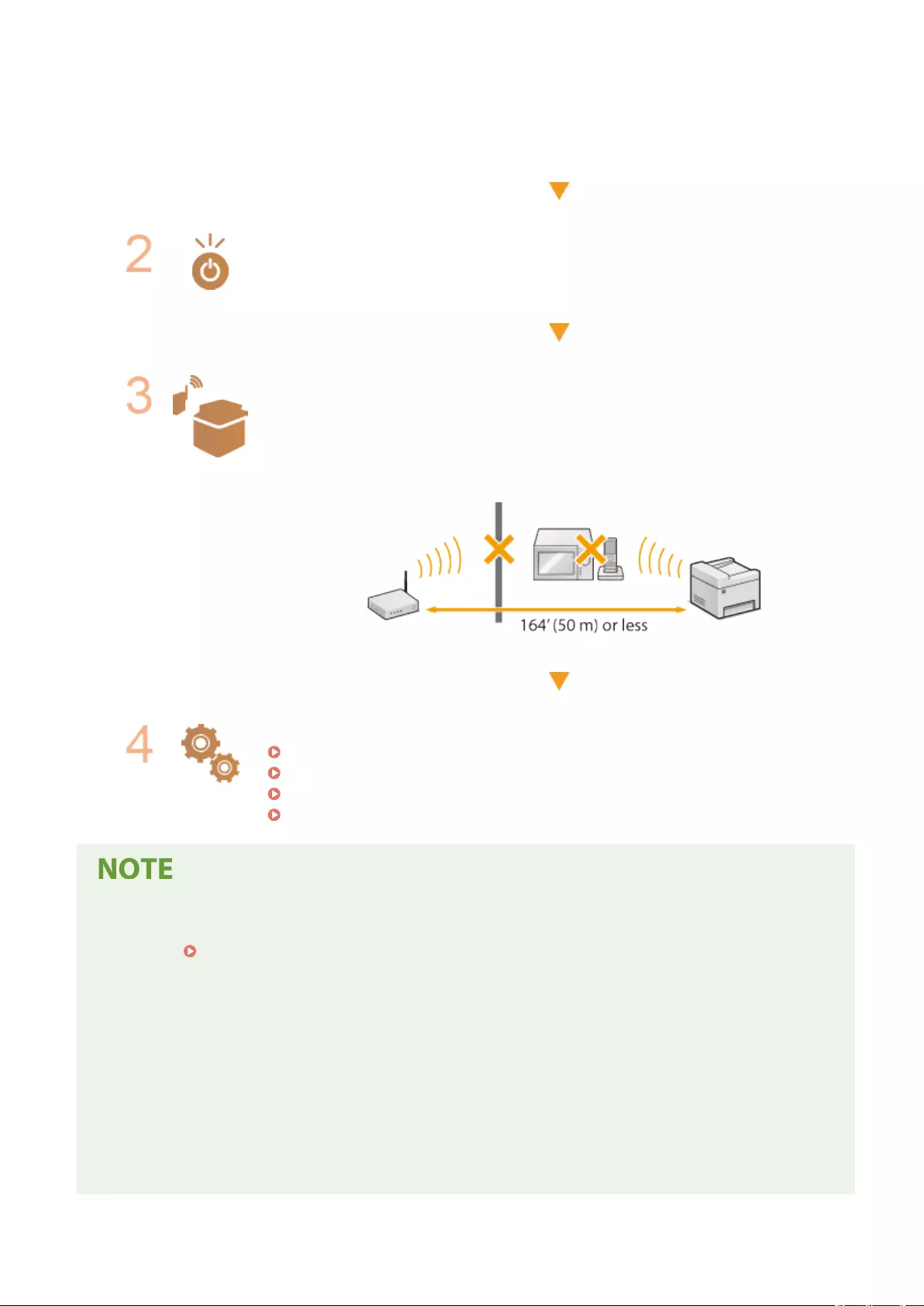
If the problem persists even after checking the above:
●Turn off the devices, and then turn them on again.
●Wait for a while, and try again to connect to the network.
Check whether the machine is turned ON.
●If the machine is turned ON, turn it OFF, and then turn it back ON.
Check the installation site of the machine and the wireless router.
●Is the machine too far from the wireless router?
●Are there any obstacles such as walls between the machine and the wireless router?
●Are there any appliances such as microwave ovens or digital cordless phones that
emit radio waves near the machine?
Perform one of the following settings again.
Setting Up Connection Using WPS Push Button Mode(P. 23)
Setting Up Connection Using WPS PIN Code Mode(P. 25)
Setting Up Connection by Selecting a Wireless Router(P. 27)
Setting Up Connection by Specifying Detailed Settings(P. 30)
When you need to manually set up the connection
If the wireless router is set as described below, manually enter all the required information for the wireless LAN
connection ( Setting Up Connection by Specifying Detailed Settings(P. 30) ).
●ANY connection refusal* is activated.
●The WEP key that was automatically generated (hexadecimal) is selected.
●The stealth mode is activated.
* A function in which the wireless router refuses the connection if the SSID on the device to be connected is set to "ANY"
or is blank.
When you need to change the settings of the wireless router
If the wireless router is set as described below, change the settings of the router.
●The MAC address packet ltering is set.
Frequently Asked Questions
633

●When only IEEE 802.11n is used for the wireless communication, WEP is selected or the WPA/WPA2
encryption method is set to TKIP.
Problem with the USB Connection
Cannot communicate.
●Change the USB cable. If you are using a long USB cable, replace it with a short one.
●If you are using a USB hub, connect the machine directly to your computer using a USB cable.
Problem with the Print Server
You cannot nd the print server to connect to.
●Are the print server and computer connected correctly?
●Is the print server running?
●Do you have user rights to connect to the print server? If you are not sure, contact the server administrator.
●Is [Network discovery] enabled?
Enabling [Network discovery](P. 739)
You cannot connect to a shared printer.
●On the network, does the machine appear among the printers of the print server? If it is not displayed,
contact the network or server administrator.
Displaying Shared Printers in the Print Server(P. 740)
Frequently Asked Questions
634

Copying/Printing Problems
2579-0A7
See Common Problems(P. 630) also.
Printing/copy results are not satisfactory. Paper creases or curls. When You
Cannot Print Properly(P. 640)
You cannot print.
●Can you print a Windows test page? If you can print a Windows test page, there is no problem with the
machine or the printer driver. Check the print settings of your application.
Printing a Test Page in Windows(P. 741)
If you cannot print a test page, check the following according to your environment.
Wireless LAN connection
●Check the connection status (signal strength) of the wireless LAN.
Viewing Network Settings(P. 41)
●If the connection is poor, try the following.
- Change the channel of your wireless LAN router. If you have more than one router, set the channels to
be at least ve channels apart.
- If you can change the radio output power of your wireless LAN router, raise the output power.
●If your computer is connected to a wireless LAN, are the computer and this machine using the same
wireless LAN router SSID? If they are different, reset the wireless LAN connection settings of this machine.
Viewing Network Settings(P. 41)
Checking the SSID to Which Your Computer is Connected(P. 746)
Connecting to a Wireless LAN(P. 21)
When you reset wireless LAN connection settings
●As the wireless LAN router, select the one with the SSID to which the computer is connected.
●Have you selected the correct port? If there is no port to use, create a port.
Checking the Printer Port(P. 744)
Conguring Printer Ports(P. 47)
●Is communication not limited by the rewall on your computer? If IP addresses are incorrectly entered,
you will be not able to access the machine. In that case, you need to use the operation panel to set <IPv4
Address Filter> or <IPv6 Address Filter> to <Off>.
Restricting Communication by Using Firewalls(P. 360)
<IPv4 Address Filter> (P. 446)
<IPv6 Address Filter> (P. 446)
●Disable security software and other resident software.
●Reinstall the printer driver.
Installing Drivers(P. 81)
Frequently Asked Questions
635

●Can you print from other computers on the network? If you also cannot print from other computers,
contact your dealer or the service center.
Wired LAN connection
●Have you selected the correct port? If there is no port to use, create a port.
Checking the Printer Port(P. 744)
Conguring Printer Ports(P. 47)
●Is communication not limited by the rewall on your computer? If IP addresses are or an MAC address is
incorrectly entered, you will be not able to access the machine. In that case, you need to use the operation
panel to set <IPv4 Address Filter>, <IPv6 Address Filter>, or <MAC Address Filter> to <Off>.
Restricting Communication by Using Firewalls(P. 360)
<IPv4 Address Filter> (P. 446)
<IPv6 Address Filter> (P. 446)
<MAC Address Filter> (P. 446)
●Disable security software and other resident software.
●Reinstall the printer driver.
Installing Drivers(P. 81)
●Can you print from other computers on the network? If you also cannot print from other computers,
contact your dealer or the service center.
USB connection
●Have you selected the correct port? If there is no port to use or you are not sure, reinstall the printer
driver. When you reinstall the printer driver, the correct port is created automatically.
Checking the Printer Port(P. 744)
Installing Drivers(P. 81)
●Is bidirectional communication enabled? Enable bidirectional communication, and restart the computer.
Checking Bidirectional Communication(P. 745)
●Disable security software and other resident software.
●Connect to another USB port on the computer.
●Can you print from a USB connection to another computer? If you also cannot print from other computers,
contact your dealer or the service center.
Via print server
●Can you print from the print server? If you can print from the print server, check the connection between
the print server and your computer.
Problem with the Print Server(P. 634)
●Disable security software and other resident software.
●Reinstall the printer driver.
Installing Drivers(P. 81)
●Can you print from other computers via the print server? If you also cannot print from other computers,
contact your local authorized Canon dealer or the Canon help line.
●Has an error occurred? Check the job log.
Checking the Copying Status and Log(P. 201)
Checking the Printing Status and Log(P. 265)
●Can you copy? If you can copy, then there is no problem with the machine. If you cannot copy, try printing
out a nozzle check pattern.
Checking the Condition of the Nozzles(P. 590)
Frequently Asked Questions
636

Printing seems to be slow. *
●Disabling Secure Print is recommended if you are not using it.
Changing the Valid Time Period for Secured Documents(P. 271)
●Print speed may be slower depending on the image being printed. Changes to the "Density/Drying Time
Adjustment" and "Paper Curl Adjustment After Printing" settings may also change the print speed.
* When the free space in memory is running low, the processing speed of the machine becomes slow, just as a computer
does. There is nothing abnormal.
●Printing is slower when resolution is set to "1200 dpi".
●Print speed may differ depending on the paper source. It is recommended that you use the top paper source
when using high-speed printing.
●If the paper type setting is heavy 6, labels, postcard, envelope, or photo paper (matte), print speed is slower
than with plain paper.
●If printing with a custom size larger than 19 inches (larger than 482.7 mm) using the multi-purpose tray, print
speed is slower.
●Print speed may be slower depending on the environment of use (temperature/humidity).
●During continuous printing, printing may pause or be slower.
It takes a long time before printing starts.
●It may take time for the machine to recover after clearing an error (paper jam, etc.). Wait for the machine to
recover.
●It may take time if the machine initiates maintenance during printing. Wait for the machine to complete
maintenance. It is also recommended not to turn off the machine while it is processing. If the machine is
forced to turn off while it is operating (unplugging, etc.), it will take longer for the machine to recover the
next time it is turned on.
●It may take time for printing to start soon after turning the machine on. Wait for the machine to start
printing.
●It may take time if printing resolution is set to "1200 dpi". Returning the machine to its default settings might
resolve the problem.
Frequently Asked Questions
637

Faxing/Telephone Problems
2579-0A8
See Common Problems(P. 630) also.
Sending Problems(P. 638)
Receiving Problems(P. 639)
Sending Problems
A fax cannot be sent.
●Is an external phone line busy? Wait until the line becomes free.
●Has an error occurred? Print and check a Communication Management Report.
Communication Management Report(P. 621)
●Is a telephone line set correctly?
Connecting the Telephone Line(P. 86)
●When sending the fax overseas, insert pauses in the fax number.
Basic Operations for Sending Faxes(P. 220)
A fax cannot be sent with a destination in the history specied.
●Did you turn OFF the machine? If so, the stored history was deleted.
●Did you set <Restrict New Destinations> to <On>? If so, the history before you set was deleted.
●Did you set <Restrict Resending from Log> to <On>? If so, the destinations in the history cannot be specied.
A fax cannot be sent on an optical ber line.
●The machine is compliant with use on analog lines. When using an optical ber line or IP phone line, the
machine may not work correctly depending on the connection environment or connected devices. In such a
case, contact the provider of the optical ber line or IP phone.
The results of a sent fax are not satisfactory.
●Clean the platen glass or feeder. If cleaning does not improve the results, the recipient's fax machine may be
a cause.
Cleaning the Platen Glass(P. 512)
Cleaning the Feeder(P. 514)
Frequently Asked Questions
638

Receiving Problems
The results of received fax are not satisfactory. Paper creases or curls. When
You Cannot Print Properly(P. 640)
Telephone and fax cannot be switched automatically.
●Check that the receive mode is set to <Fax/Tel (Auto Switch)>, <Answering Machine>, <DRPD>, or <Net
Switch>.
Selecting the Receive Mode(P. 85)
●Free space in memory may be running low. Print or delete data in memory.
Checking/Forwarding/Deleting Documents in Memory(P. 242)
Printing Documents in Memory(P. 241)
A fax cannot be received automatically.
●Check that the receive mode is set to <Fax/Tel (Auto Switch)>, <Auto>, <Answering Machine>, <DRPD>, or
<Net Switch>.
Selecting the Receive Mode(P. 85)
●Free space in memory may be running low. Print or delete data in memory.
Checking/Forwarding/Deleting Documents in Memory(P. 242)
Printing Documents in Memory(P. 241)
A fax cannot be received on an optical ber line.
●The machine is compliant with use on analog lines. When using an optical ber line or IP phone line, the
machine may not work correctly depending on the connection environment or connected devices. In such a
case, contact the provider of the optical ber line or IP phone.
Frequently Asked Questions
639

When You Cannot Print Properly
2579-0A9
If printing results are not satisfactory, or paper creases or curls, try the following solutions. If the problems persist,
contact your dealer or the service center.
Printing Results Are Not Satisfactory(P. 641)
Paper Creases or Curls(P. 651)
Paper Is Fed Incorrectly(P. 653)
Frequently Asked Questions
640
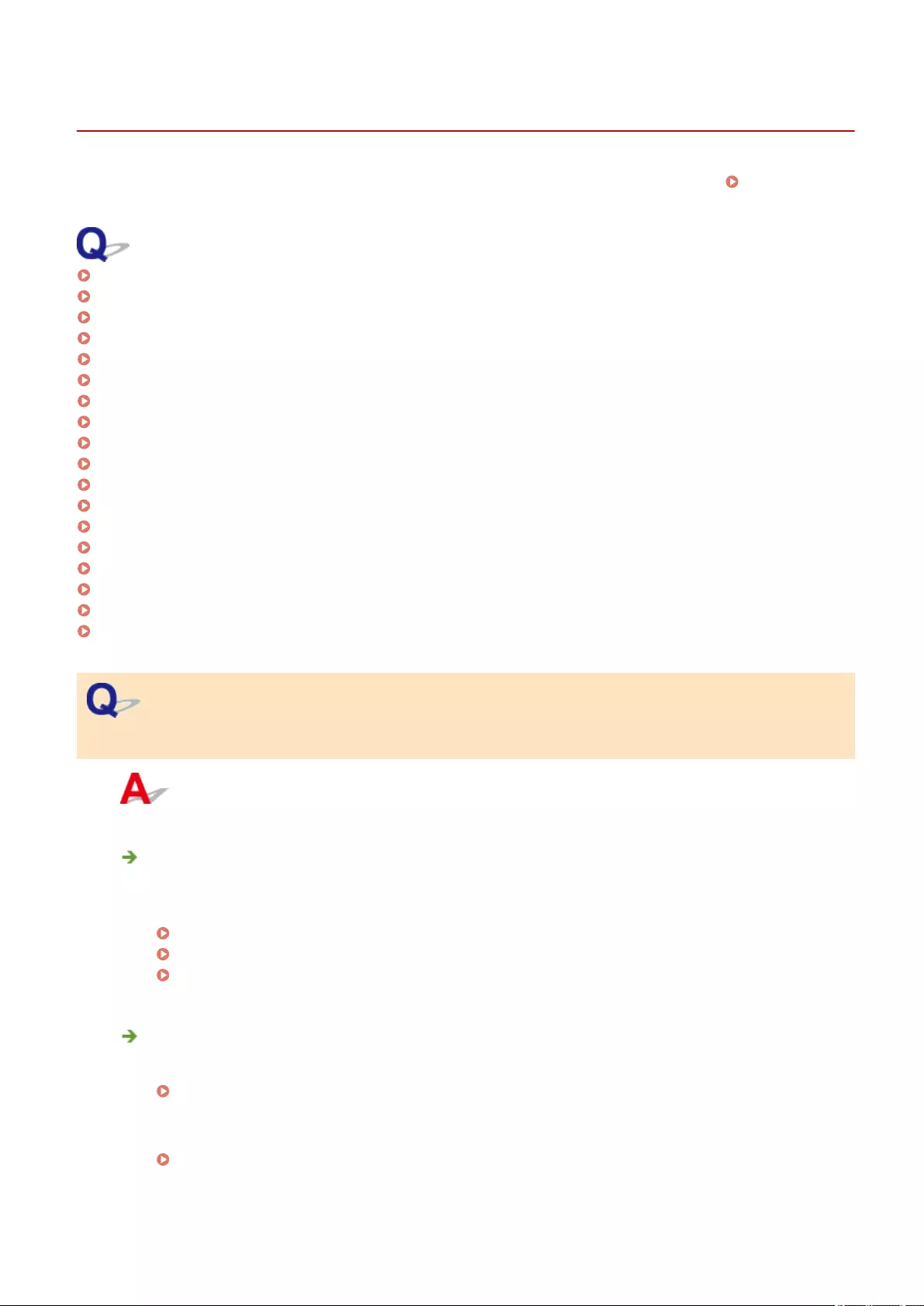
Printing Results Are Not Satisfactory
2579-0AA
Dirt inside the machine may affect printing results. Perform care and cleaning to the machine rst. Regular
Cleaning(P. 510)
Printouts Are Faded/Colors Turn Out Differently/White Streaks (Lines) Appear(P. 641)
Color Unevenness or Colored Streaks(P. 642)
Colors Are Mismatched(P. 642)
Copies Are Not Printed Well(P. 643)
Cannot Copy Black or Near-Black Text when Color Copying(P. 643)
Smudge Marks Appear on the Edge of Printouts(P. 644)
Smudge Marks Appear on the Side to Print On(P. 644)
Smudge Marks Appear on Originals(P. 645)
Smudge Marks Appear on the Back Side of Paper(P. 646)
The Back Side of a Printout Is Smudged by Ink from the Next Printout(P. 646)
Images Bleed Through(P. 646)
A Portion of the Page Does Not Print(P. 647)
Pages Do Not Print on the Intended Side/in the Intended Direction(P. 647)
Pages Do Not Print at the Intended Size(P. 648)
Orientations of Back and Front Do Not Match for 2-Sided Printing(P. 648)
Lines Are Missing or Do Not Print(P. 648)
Printouts Turn Out Black and White(P. 649)
Images are Printed Tilted or Are Outside the Printable Area(P. 650)
Printouts Are Faded/Colors Turn Out Differently/White Streaks (Lines) Appear
Did you check the paper and print quality?
●Check that settings in the machine's operation panel or in the printer driver match the paper size, type,
and print quality that you want to use.
Specifying Paper Size and Type(P. 152)
Printing(P. 260)
Drivers(P. 758)
Did you check for clogging in the print head?
●Print out a nozzle check pattern, and then perform print head cleaning, etc. as necessary.
Cleaning the Print Head(P. 526)
●If white streaks appear again a while after being corrected with print head cleaning, adjust the
maintenance interval.
<Adjusting Maintenance Interval>(P. 453)
●If white streaks are not corrected even after performing print head cleaning, perform white streak
correction.
Frequently Asked Questions
641
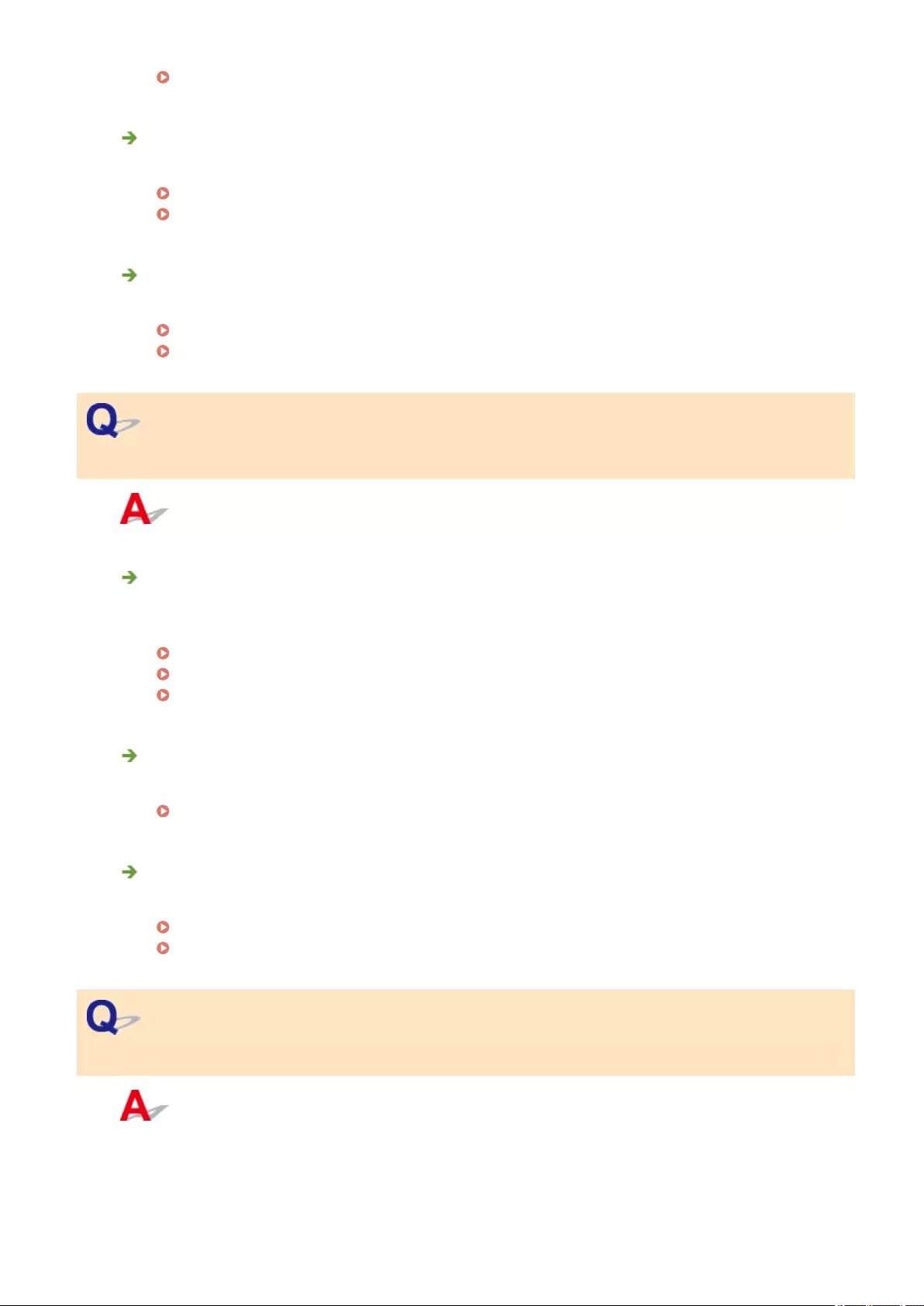
<White Streak Correction>(P. 453)
Did you perform color correction (All Paper Types)?
●Perform color correction (All Paper Types).
Correcting Colors(P. 595)
Correcting Colors in All Paper Types(P. 596)
Did you perform color correction (Single Paper Type)?
●If the steps above do not resolve the problem, perform color correction (Single Paper Type).
Correcting Colors(P. 595)
Correcting Colors for Each Paper Type(P. 599)
Color Unevenness or Colored Streaks
Did you check the paper and print quality?
●Check that settings in the machine's operation panel or in the printer driver match the paper size, type,
and print quality that you want to use.
Specifying Paper Size and Type(P. 152)
Printing(P. 260)
Drivers(P. 758)
Did you perform a print head diagnosis?
●Perform a print head diagnosis.
Diagnosing the Print Head(P. 584)
Did you perform color correction (Single Paper Type)?
●If the steps above do not resolve the problem, perform color correction (Single Paper Type).
Correcting Colors(P. 595)
Correcting Colors for Each Paper Type(P. 599)
Colors Are Mismatched
Frequently Asked Questions
642
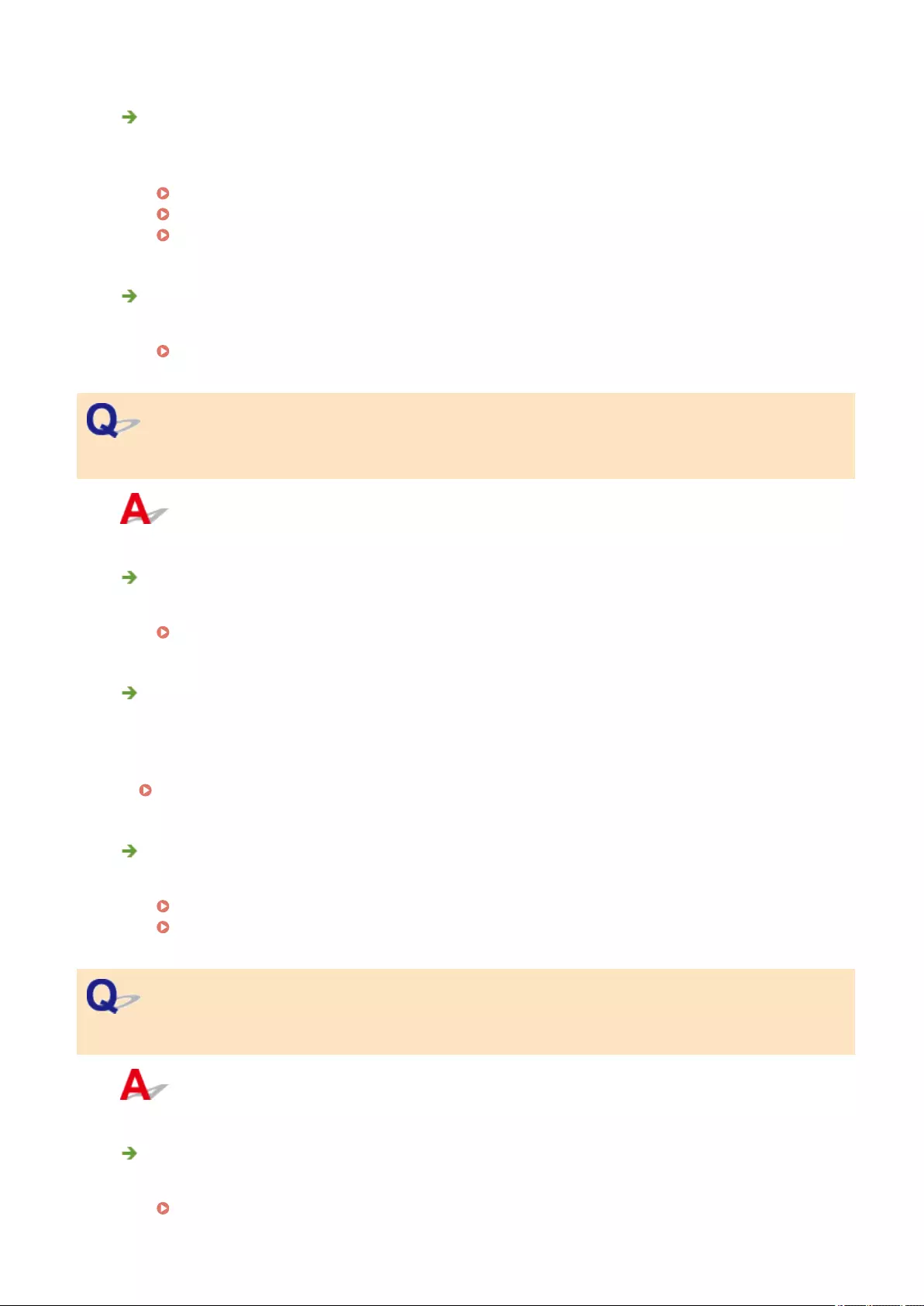
Did you check the paper and print quality?
●Check that settings in the machine's operation panel or in the printer driver match the paper size, type,
and print quality that you want to use.
Specifying Paper Size and Type(P. 152)
Printing(P. 260)
Drivers(P. 758)
Did you perform print head position adjustment?
●Adjust the position of the print head to correct color mismatching, etc.
Aligning the Print Head(P. 605)
Copies Are Not Printed Well
Is the original placed properly on the platen glass?
●Place the original with the side to be scanned face down.
Placing Originals(P. 133)
Are you copying an original that was printed out on the machine?
●If copying an original that was printed out on the machine, printing may not turn out well depending on the
original photo or document.
Print directly from the machine, or directly from a PC where printing from a PC is possible.
Printing(P. 260)
Is the document feed scanning area dirty?
●Clean the document feed scanning area.
Cleaning the Platen Glass(P. 512)
Cleaning the Feeder(P. 514)
Cannot Copy Black or Near-Black Text when Color Copying
Did you perform text color adjustment for color copies?
●Perform text color adjustment if you cannot copy black or near-black text as intended when color copying.
Adjusting Values for Text Color Reproducibility(P. 593)
Frequently Asked Questions
643
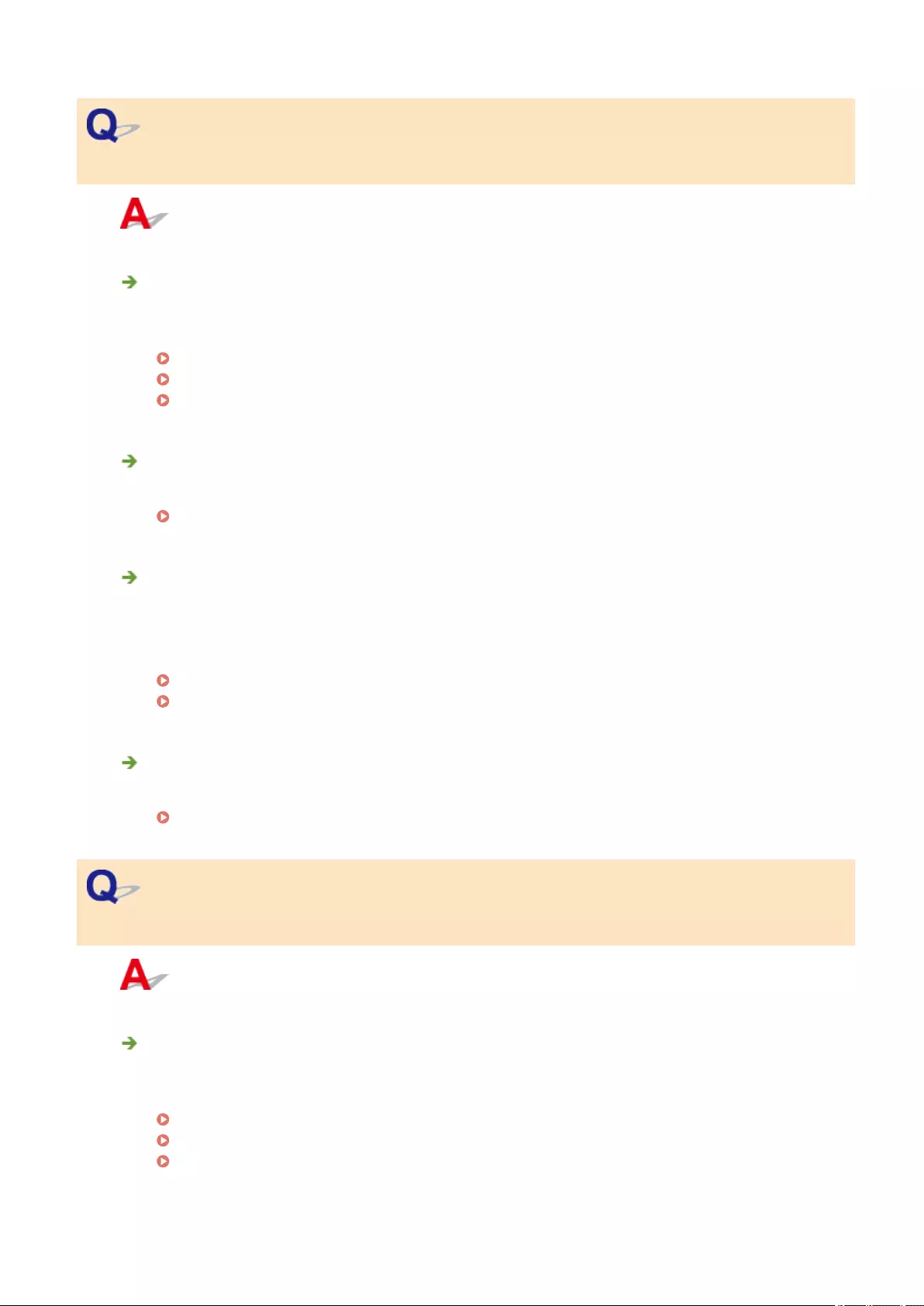
Smudge Marks Appear on the Edge of Printouts
Are you using appropriate paper?
●Check the supported paper types and replace with an appropriate type. Also, set the paper size and type
correctly.
Available Paper(P. 726)
Loading Paper(P. 137)
Specifying Paper Size and Type(P. 152)
Is the paper creased or curled?
●Replace with appropriate paper that is not creased or curled.
Loading Paper(P. 137)
Are you using thick paper outside the machine's specications or paper that
curls or wrinkles easily when absorbing ink?
●Check the supported paper types and replace with an appropriate type. Also, set the paper size and type
correctly.
Available Paper(P. 726)
Loading Paper(P. 137)
Is the paper path dirty?
●Clean the paper path.
Cleaning the Paper Path(P. 519)
Smudge Marks Appear on the Side to Print On
Did you check the paper and print quality?
●Check that settings in the machine's operation panel or in the printer driver match the paper size, type,
and print quality that you want to use.
Specifying Paper Size and Type(P. 152)
Printing(P. 260)
Drivers(P. 758)
Frequently Asked Questions
644
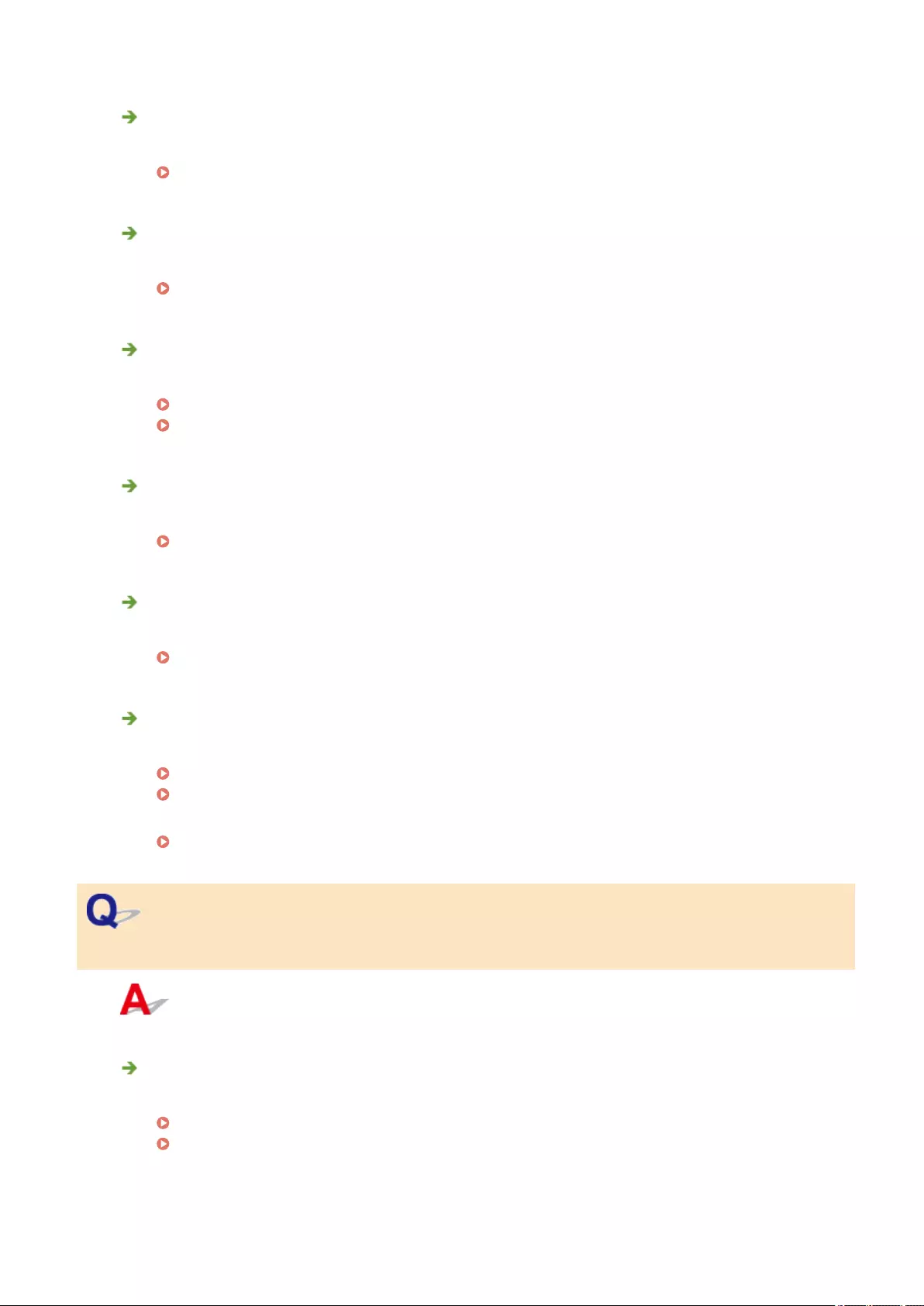
Is the paper creased or curled?
●Replace with appropriate paper that is not creased or curled.
Loading Paper(P. 137)
Is the paper rubbing?
●Widen the gap between the paper and print head.
Preventing Abrasion(P. 604)
Is the document feed scanning area dirty?
●Clean the document feed scanning area.
Cleaning the Platen Glass(P. 512)
Cleaning the Feeder(P. 514)
Is the interior of the machine dirty?
●Clean the interior of the machine.
Cleaning the Interior(P. 518)
Is an appropriate wait time for ink to dry set?
●Try setting a longer wait time for ink to dry.
Adjusting the Density and Ink Drying Time(P. 608)
Are you using paper that is hard to dry?
●Check usable paper, and replace with appropriate paper.
Available Paper(P. 726)
Loading Paper(P. 137)
●Try printing at a lower density.
<Density/Drying Time Adjustment>(P. 452)
Smudge Marks Appear on Originals
Is the document feed scanning area dirty?
●Clean the document feed scanning area.
Cleaning the Platen Glass(P. 512)
Cleaning the Feeder(P. 514)
Frequently Asked Questions
645
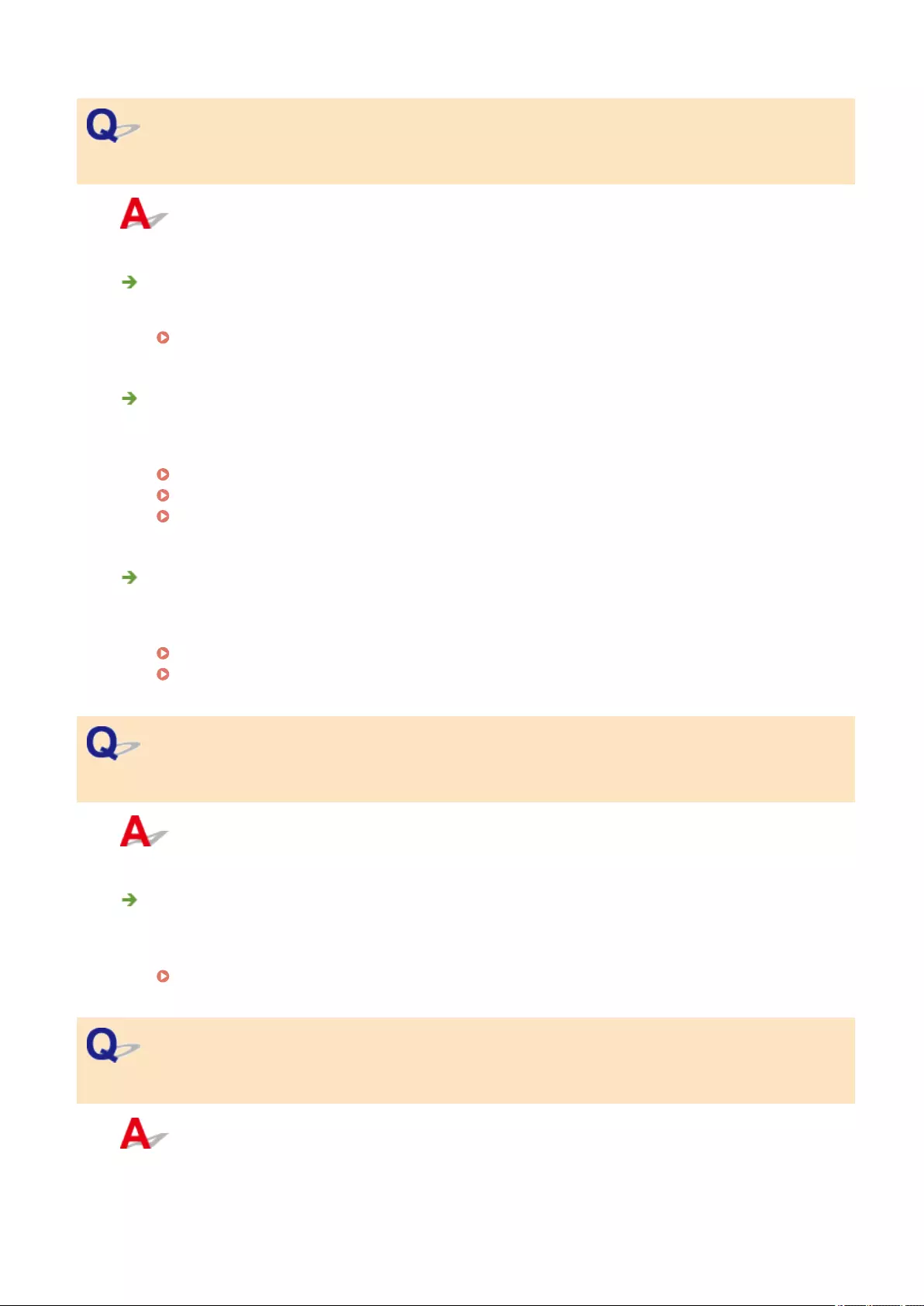
Smudge Marks Appear on the Back Side of Paper
Have you loaded paper that is smaller than the size of the print data?
●Check to make sure that the paper size matches the size of the print data.
Specifying Paper Size and Type(P. 152)
Did you check the paper and print quality?
●Check that settings in the machine's operation panel or in the printer driver match the paper size, type,
and print quality that you want to use.
Specifying Paper Size and Type(P. 152)
Printing(P. 260)
Drivers(P. 758)
Did you print with a smaller-size paper immediately before?
●Ink sometimes gets on the paper path or sensor areas when printing small-size paper. Clean the paper
path and sensor areas.
Cleaning the Paper Path(P. 519)
Cleaning the Sensor Area(P. 523)
The Back Side of a Printout Is Smudged by Ink from the Next Printout
Did you adjust the density or ink drying time?
●If the back side of a printout is smudged by ink from the next printout, adjusting the print density and
drying time may correct the problem.
Adjusting the Density and Ink Drying Time(P. 608)
Images Bleed Through
Frequently Asked Questions
646
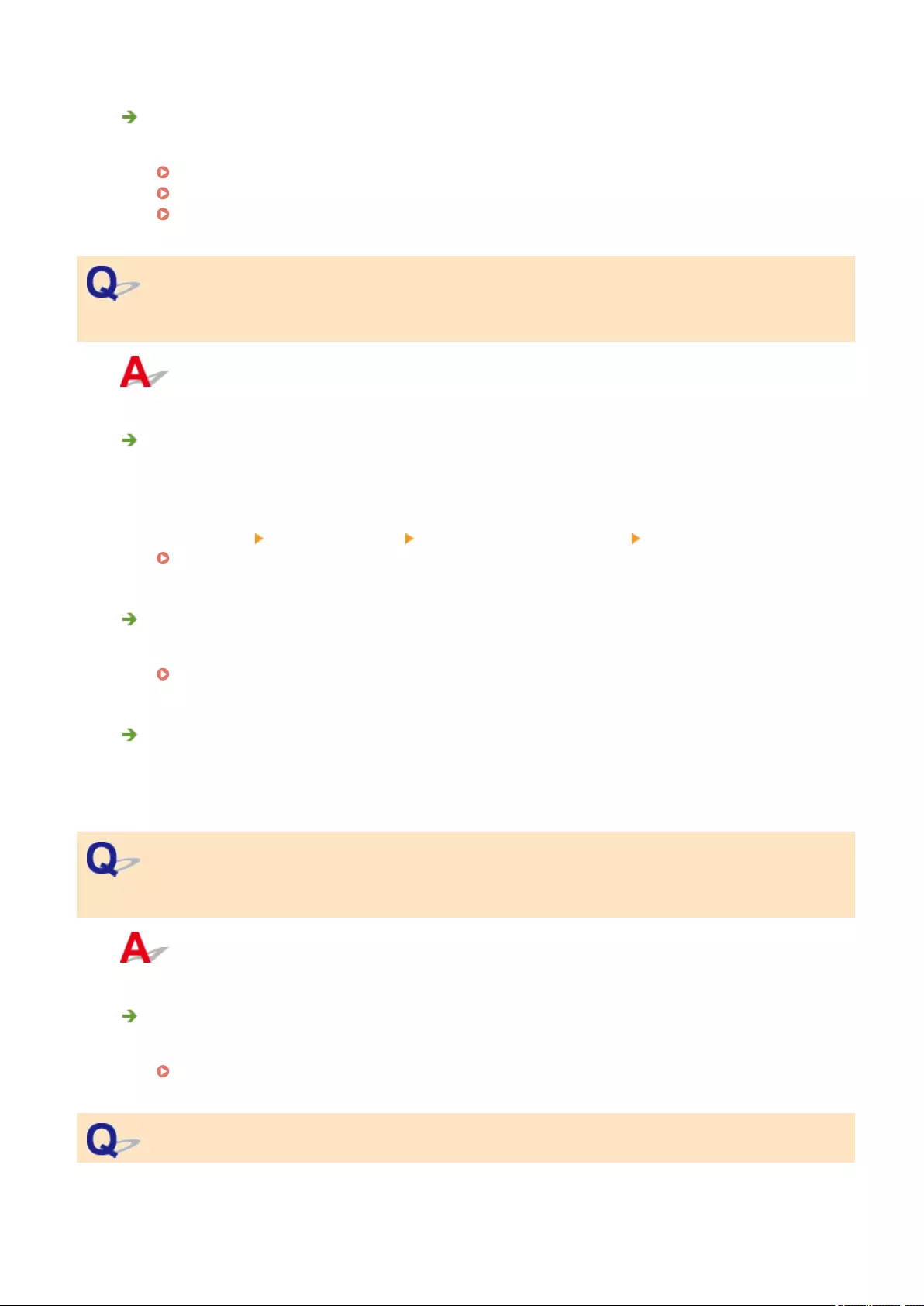
Is the background density appropriate?
●If originals bleed through, adjust the background density for printing to turn out well.
Basic Copy Operations(P. 194)
Basic Operations for Sending Faxes(P. 220)
Adjusting Density(P. 307)
A Portion of the Page Does Not Print
Do you print data without margins?
●This can occur if printing without margins is set in the printer driver. The area that is printable with this
machine the area excluding 0.16 inches (4 mm) all around the paper (for envelopes, 0.39 inches (10 mm) at
top and bottom).Make sure there are margins around the document to be printed.
[Finishing] tab [Advanced Settings] [Expand Print Region and Print] [Off]
Drivers(P. 758)
Do the paper guides align with the edges of the paper?
●If the paper guides are too loose or too tight, part of a document may not be printed.
Loading Paper(P. 137)
Did you check the paper size?
●Check whether settings in the machine's operation panel or in the printer driver match the paper size you
want to use.
Pages Do Not Print on the Intended Side/in the Intended Direction
Is the paper loaded in the opposite way?
●Check the direction and back/front of the loaded paper. If loaded in the opposite way, reload the paper.
Loading Paper(P. 137)
Frequently Asked Questions
647

Pages Do Not Print at the Intended Size
Are the original size and loaded paper size different?
●Replace the loaded paper with paper of the size you want to print.
●Match [Output Size] in the printer driver with the paper size to be printed.
Drivers(P. 758)
Orientations of Back and Front Do Not Match for 2-Sided Printing
Is the 2-sided print setting correct?
●Check print settings with the following procedure.
1 In the print settings screen for the application, select the direction of the original.
2 In the driver's [Basic Settings] screen, set [Orientation] to the same direction as in step 1.
3 While checking the print image, set [Page Layout: <Value>] [Page Order] [1-sided/2-sided/Booklet
Printing] [Binding Location: <Value>].
Drivers(P. 758)
Lines Are Missing or Do Not Print
Frequently Asked Questions
648
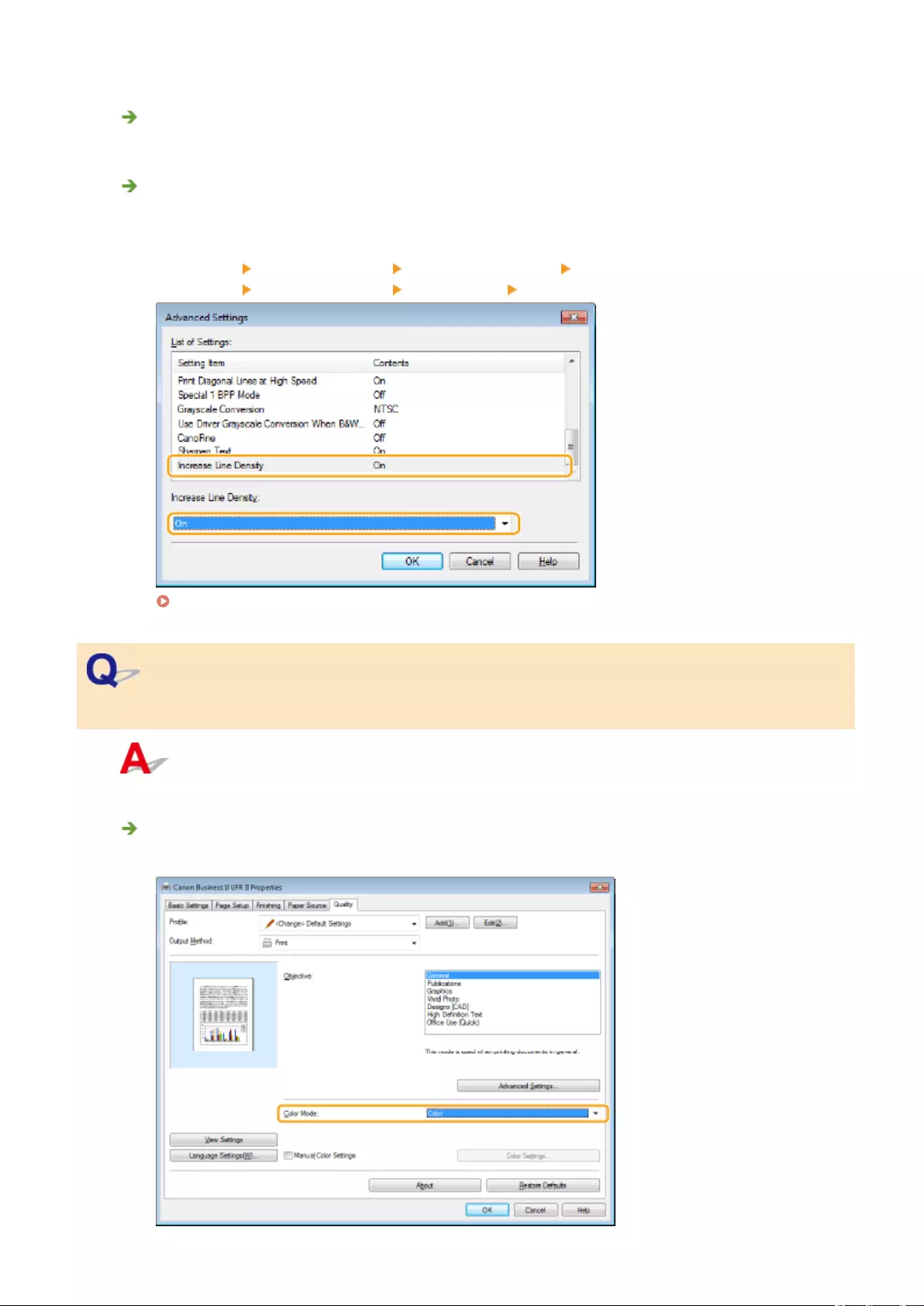
Did you specify Page Layout: N on 1?
Did you set a gutter width with [Gutter: <Value>]?
●Thin lines may not print. Try setting thicker lines.
●Try changing the following settings in the printer driver.
[Quality] tab [Advanced Settings] [Increase Line Density] [On]
[Quality] tab [Advanced Settings] [Sharpen Text] [Off]
Drivers(P. 758)
Printouts Turn Out Black and White
Is [Color Mode] set to [Black and White] in a Windows printer driver?
●Set [Color Mode] to [Color] in the printer driver.
Frequently Asked Questions
649
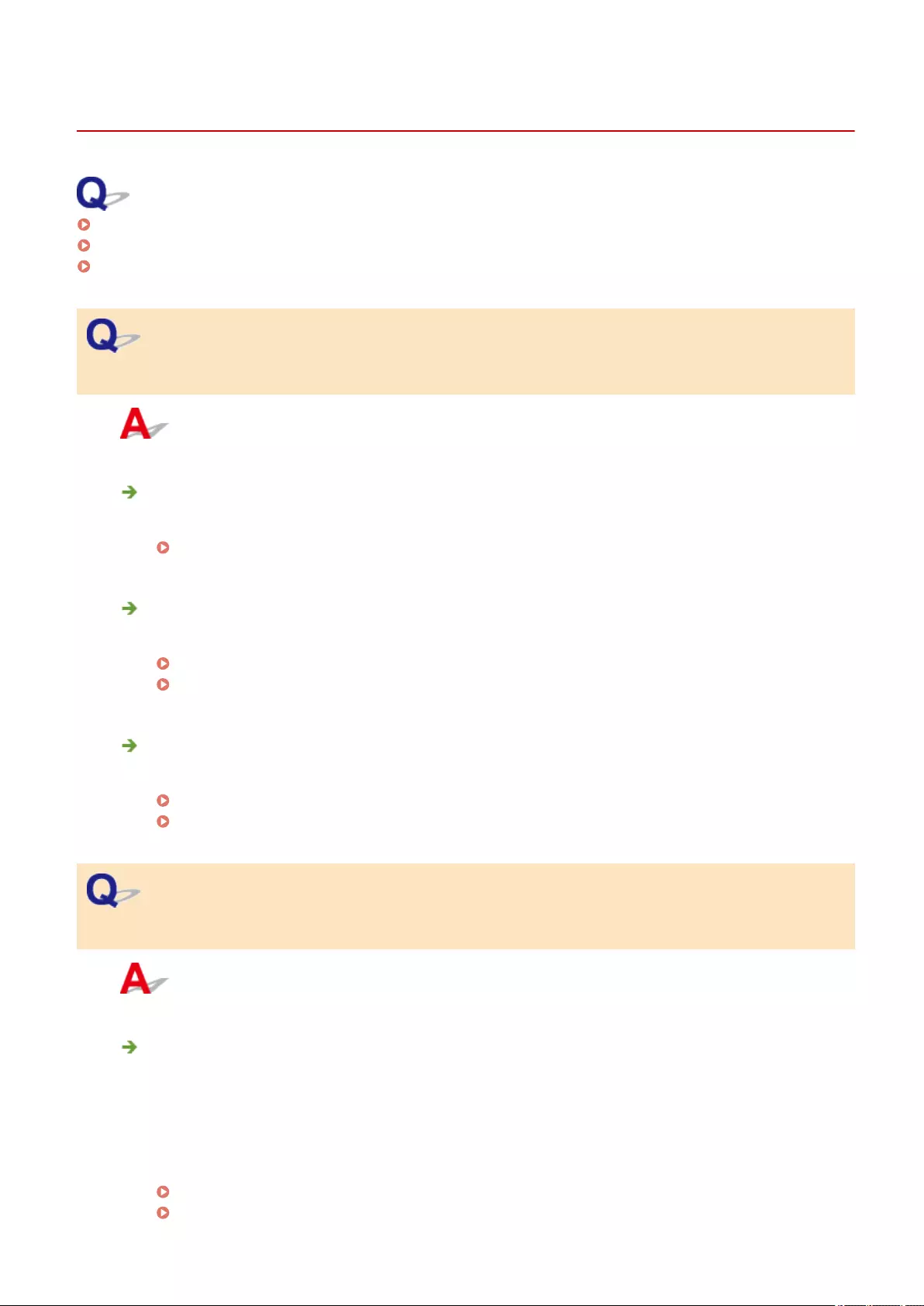
Paper Creases or Curls
2579-0AC
Paper Creases or Curls(P. 651)
Paper Curls(P. 651)
Ink Blurs(P. 652)
Paper Creases or Curls
Is paper loaded correctly?
●If paper is not loaded below the load limit line or is loaded obliquely, it may crease.
Loading Paper(P. 137)
Are you using paper that has absorbed moisture?
●Replace with appropriate paper.
Available Paper(P. 726)
Loading Paper(P. 137)
Are you using appropriate paper?
●Check usable paper, and replace with appropriate paper.
Available Paper(P. 726)
Loading Paper(P. 137)
Paper Curls
Are you using appropriate paper?
●Check the supported paper types and replace with an appropriate type. Also, set the paper size and type
correctly.
●Reload the paper by changing the side to print on (front side/back side). In rare cases the symptom may
become worse depending on the paper. If this occurs, change the side to print on back to the previous
side.
Available Paper(P. 726)
Loading Paper(P. 137)
Frequently Asked Questions
651
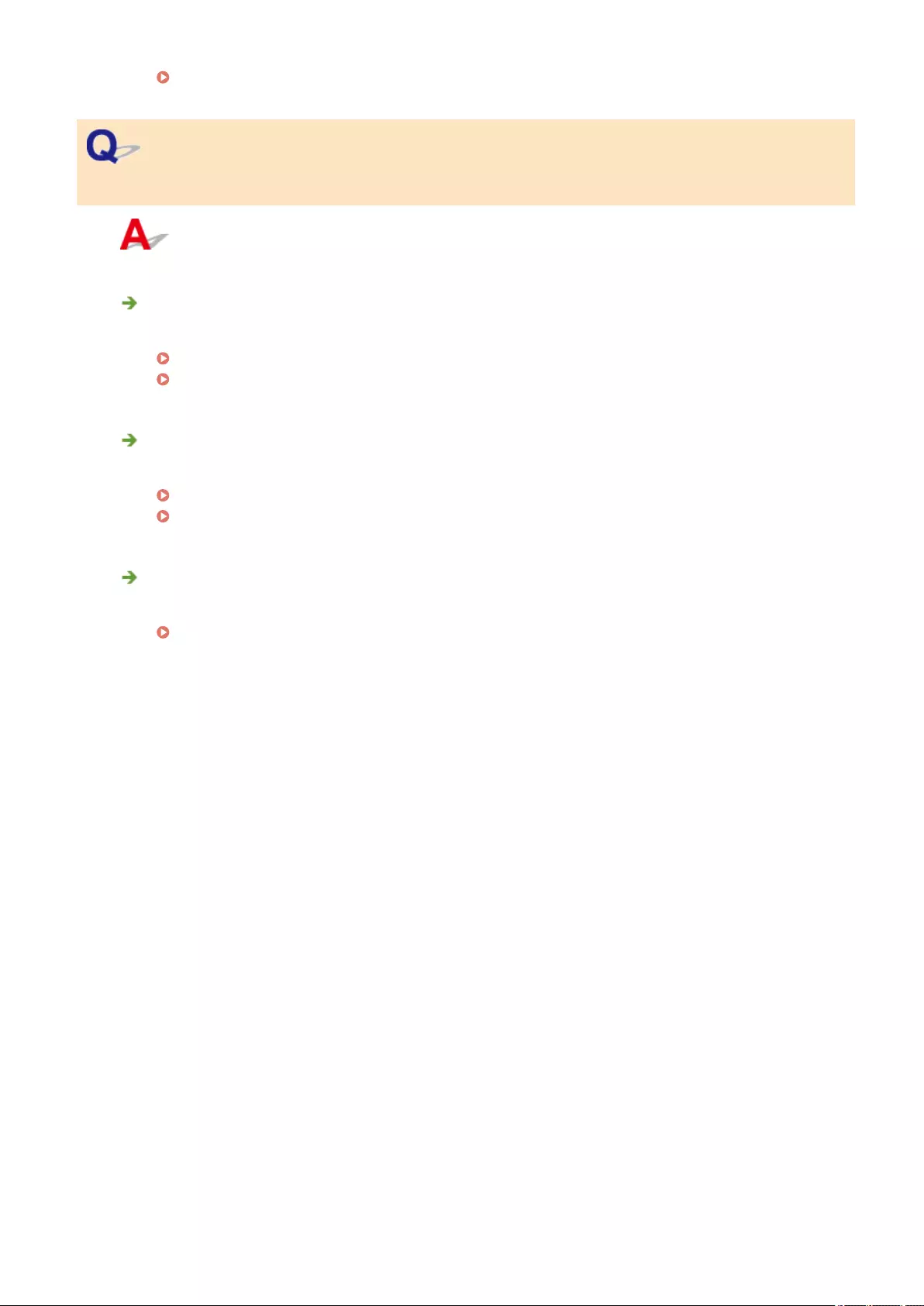
Specifying Paper Size and Type(P. 152)
Ink Blurs
Did you check the paper and print quality?
●If a high print density is set, lower the density setting and try printing again.
Adjusting the Density and Ink Drying Time(P. 608)
Specifying Paper Size and Type(P. 152)
If printing photos, are you using photo paper?
●Replace with appropriate paper.
Selecting the Type of Original for Copying(P. 204)
Specifying Paper Size and Type(P. 152)
Are you using paper that has absorbed moisture?
●Replace with appropriate paper.
Loading Paper(P. 137)
Frequently Asked Questions
652

Paper Is Fed Incorrectly
2579-0AE
Printouts Are Skewed(P. 653)
Paper Is Not Fed/Two or More Sheets Are Fed Together(P. 653)
Originals Jam Frequently (Copying)(P. 653)
Printouts Are Skewed
Do the paper guides align with the edges of the paper?
●If the paper guides are too loose or too tight, the printouts are skewed.
Loading Paper(P. 137)
Paper Is Not Fed/Two or More Sheets Are Fed Together
Is paper loaded correctly?
●Fan the paper stack thoroughly so that paper is not stuck together.
●Check whether paper is loaded correctly.
Loading Paper(P. 137)
●Check whether the number of sheets of paper loaded is appropriate and whether the appropriate paper is
used.
Available Paper(P. 726)
Loading Paper(P. 137)
●Check whether mixed sizes and types of paper are loaded together.
Loading Paper(P. 137)
Originals Jam Frequently (Copying)
Frequently Asked Questions
653

A Message or a Number Starting with "#" (an Error
Code) Is Displayed
2579-0AF
When a message appears on the machine's display, or a number (error code) prexed with "#" appears, see the
following sections to check the solution.
Countermeasures for Each Message(P. 656)
Countermeasures for Each Error Code(P. 677)
Frequently Asked Questions
655

Countermeasures for Each Message
2579-0HU
If you cannot send a fax or the memory is full, or you encounter operation problems, a message appears on the
display. Find out more information about messages in the following list.
A print head error may have occurred.
A problem occurred with the print head.
●Turn the machine off then on again. If the print head does not recover after turning the machine off then
on, contact your dealer or the service center.
●If you have a print head ready, replace the print head.
Replacing the Print Head(P. 536)
An error occurred during certicate verication.
The certicate has expired, or contains incorrect information.
●Install the correct CA certicate.
Registering the Key and Certicate for Network Communication(P. 379)
●Check the certicate for validity period and domain name in the DNS settings.
An invalid paper size/type combination was detected. Drawer: XXXX Check
the position of the paper guides in the drawer and [Paper Settings] on the
Home screen.
XXXX shows paper sources (1 to 4) of the paper drawer.
The paper settings in the paper drawer differ from the paper that is loaded.
●Check the paper settings on the paper information in <Paper Settings>. If the paper settings are incorrect,
match them with the paper size and type of the paper that is loaded. Paper settings can be specied for all
the paper sizes and types set in the paper drawers in <Paper Settings>.
Specifying Paper Size and Type in the Paper Drawer(P. 153)
Black & White copying is restricted. Only Color copying is available.
Black and white copying is disabled in the Department ID Management.
●To copy in black and white, log in using a Department ID for which black and white copying is not
restricted. For the Department ID and PIN, contact your Administrator.
Setting the Department ID Management(P. 346)
Frequently Asked Questions
656

Black & White printing is restricted. Only Color printing is available.
Black and white printing is disabled in the Department ID Management.
●To print in black and white, log in using a Department ID for which black and white printing is not
restricted. Contact your Administrator for the Department ID and PIN.
Setting the Department ID Management(P. 346)
Cannot analyze the authentication server certicate.
The authentication server certicate may be invalid, or the certicate may be in a format that the
printer does not support.
●Check the authentication server certicate.
Conguring IEEE 802.1X Authentication Settings(P. 388)
Cannot change the destination type of destinations registered to a group.
A selected destination could not be edited because it was registered to Group Dial.
●To change the type of destination that is registered to Group Dial, rst delete the registered destination
from Group Dial. Next, change the destination type, and then register the destination to Group Dial again.
Cannot nd the access point.
When automatic setting with WPS was attempted, a wireless router could not be detected within a
specic period of time.
●Connect again paying attention to the time limit.
Setting Up Connection Using WPS Push Button Mode(P. 23)
Setting Up Connection Using WPS PIN Code Mode(P. 25)
An SSID or network key of a wireless router was entered manually, but the entry was incorrect.
●Check the SSID and network key, and enter the correct ones again.
Checking the SSID and Network Key(P. 33)
Setting Up Connection by Specifying Detailed Settings(P. 30)
A wireless router could not be detected due to setting problems of the network to be connected.
●Check whether the machine is properly installed and ready to connect to the network.
Installation/Settings Problems(P. 631)
●If the problem persists, check the security settings of the wireless router.
Cannot print RX data.
Received documents cannot be printed due to some specic situation.
Frequently Asked Questions
657

●Check if there has occurred one of the following situations. If messages including causes and solutions
appear on the display, check the contents.
A cover is open.
There is no paper loaded.
The paper is jammed.
An error has occurred.
Cannot receive the fax. Make sure the fax was sent correctly by the sender.
The recipient's machine did not respond within 35 seconds.
●Ask the sender to send the fax again. If you hear a beep, select <Start Receiving> to receive the fax.
Receiving Faxes(P. 229)
Cannot scan from the feeder when Book->2 Pages is set.
You are using a function that cannot be used when an original is placed in the feeder.
●Place the original on the platen glass.
Cannot send because more than one destination is specied.
Sending a fax to multiple destinations is disabled.
●To specify multiple destinations, you need to set <Restrict Sequential Broadcast> to <Off>. For more
information, contact your Administrator.
Restricting Sequential Broadcasts(P. 398)
Cannot specify group destinations when on-hook.
Group Dial was specied as a destination after selecting <Hook>.
●Once you select <Hook>, you cannot specify destinations in Group Dial. Specify destinations to send fax
documents without selecting <Hook>.
Cannot specify group destinations, or multiple destinations at the same
time.
Multiple destinations or Group Dial was specied after selecting <Hook>.
●Multiple destinations or Group Dial cannot be specied as a destination after selecting <Hook>. Specify
destinations without selecting <Hook> to send a fax.
Frequently Asked Questions
658

Cannot use these settings. Sending to the specied destination is restricted.
The machine is set up so that the user currently logged in cannot send to the addresses registered in the
selected <Favorite Settings>.
●Change the send restrictions for the logged in user.
Setting the Department ID Management(P. 346)
Cartridge EEPROM Checksum ErrorCannot recognize the maintenance
cartridge. Please replace the maintenance cartridge.
Cannot recognize the maintenance cartridge.
●Replace the maintenance cartridge.
Replacing the Maintenance Cartridge(P. 532)
Cartridge Installed on Another Device
Maintenance cartridges previously installed on other printers cannot be
installed on this device. Please install a new maintenance cartridge.
A maintenance cartridge that has been installed in another machine has been installed.
●A maintenance cartridge that has been installed in another machine cannot be installed. Install a correct
maintenance cartridge.
Replacing the Maintenance Cartridge(P. 532)
Cassette Feeding Unit Side Cover Open
The cassette feeding unit side cover is open.
●Close the side cover on the cassette feeding unit.
Front Side(P. 103)
Change the authentication password.
The password has expired.
●Set a new password.
Check the authentication settings.
The authentication method set on the machine does not match the authentication method set on the
RADIUS server.
Frequently Asked Questions
659

●Check that the same authentication method is set on this machine and the RADIUS server, and set the
correct authentication method.
Conguring IEEE 802.1X Authentication Settings(P. 388)
Color copying is restricted. Only Black & White copying is available.
Color copying is disabled in the Department ID Management.
●To copy in color, log in using a Department ID for which color copying is not restricted. Contact your
Administrator for the Department ID and PIN.
Setting the Department ID Management(P. 346)
Color printing is restricted. Only Black & White printing is available.
Color printing is disabled in the Department ID Management.
●To print in color, log in using a Department ID for which color printing is not restricted. Contact your
Administrator for the Department ID and PIN.
Setting the Department ID Management(P. 346)
Copying is restricted.
Copying is disabled in the Department ID Management.
●Log in with a Department ID for which copying is not disabled. For the Department ID and PIN, contact
your Administrator.
Setting the Department ID Management(P. 346)
Could not connect.
An error caused connection in Access Point Mode to fail.
●Wait a while, then congure the setting again. If you are still unable to connect, turn off the machine and
then restart it.
Connecting Directly (Access Point Mode)(P. 332)
Could not connect. Check the PSK settings.
The network key (PSK) of a wireless router to be connected is not set to the machine correctly.
●Check the network key (PSK) of the wireless router, and set it to the machine again.
Checking the SSID and Network Key(P. 33)
Setting Up Connection by Selecting a Wireless Router(P. 27)
Setting Up Connection by Specifying Detailed Settings(P. 30)
●If the problem persists even after checking the network key, check whether the machine is properly
installed and ready to connect to the network.
Installation/Settings Problems(P. 631)
Frequently Asked Questions
660

Could not connect using the wireless LAN. Turn the main power OFF and ON,
then congure the settings again.
A connection failed due to an error while setting wireless LAN connection.
●Restart the machine and set again.
●If the problem persists even after restarting the machine, check whether the machine is properly installed
and ready to connect to the network.
Installation/Settings Problems(P. 631)
●If the problem persists even after checking the wireless LAN connection, check the security settings of the
wireless router.
Could not connect using WPS. Wait a moment, then congure the settings
again.
When automatic setting with WPS was attempted, the connection failed due to an error.
●Wait for a while, and set again. If the problem persists, check whether the wireless router supports WPS.
If WPS is supported:
Check whether the machine is properly installed and ready to connect to the network.
Installation/Settings Problems(P. 631)
If WPS is not supported:
Set using another connecting method.
Connecting to a Wireless LAN(P. 21)
Could not connect. The maximum number of devices that can connect to the
access point has been reached.
The machine attempted to connect to a wireless LAN router to which the maximum number of devices
was already connected.
●Decrease the number of devices (clients) that are connected to the wireless LAN router. For information on
the maximum number of devices that can connect, see the instruction manual for the wireless LAN router
or contact the manufacturer.
Could not detect any connections from wireless devices.
Mobile device detection was not possible within the predetermined length of time.
●Connect again paying attention to the time limit.
Connecting Directly (Access Point Mode)(P. 332)
Frequently Asked Questions
661

Could not perform Open System authentication. Check the WEP settings.
The authentication method of the machine is set to <Open System>, but that of a wireless router is set to
"Shared Key."
●Connect again by manually changing the WEP authentication method to <Shared Key>.
Setting Up Connection by Specifying Detailed Settings(P. 30)
The MAC address of the machine is rejected because the MAC address lter is set at a wireless router.
●Set the wireless router to permit the MAC address of the machine and your computer. For more
information about how to set, see the instruction manuals for your networking devices or contact your
manufacturer. To check the MAC address of the machine, select <Menu> <Preferences>
<Network> <Wireless LAN Settings> <Connection Information>.
Viewing the MAC Address for Wired LAN(P. 41)
Could not perform Shared Key authentication. Check the WEP settings.
The network key (the WEP key) of a wireless router to be connected is not set to the machine correctly.
●Check the network key (the WEP key) of the wireless router, and set it to the machine again.
Checking the SSID and Network Key(P. 33)
Setting Up Connection by Specifying Detailed Settings(P. 30)
●Connect again by selecting a wireless router or by manually changing the WEP authentication method to
<Open System>.
Setting Up Connection by Selecting a Wireless Router(P. 27)
Setting Up Connection by Specifying Detailed Settings(P. 30)
The authentication method of the machine is set to <Shared Key>, but that of the wireless router is set to
"Open System."
●Change the WEP authentication method to "Shared Key" at the wireless router, and connect again. For
more information about how to change, see the instruction manuals for your networking devices or
contact your manufacturer.
Could not scan the alignment pattern. Check the alignment pattern, then try
again.
Could not scan the alignment pattern correctly.
●Check how to place the alignment pattern and then scan again.
Diagnosing the Print Head(P. 584)
Correcting Colors(P. 595)
Device Paper Jam
Frequently Asked Questions
662
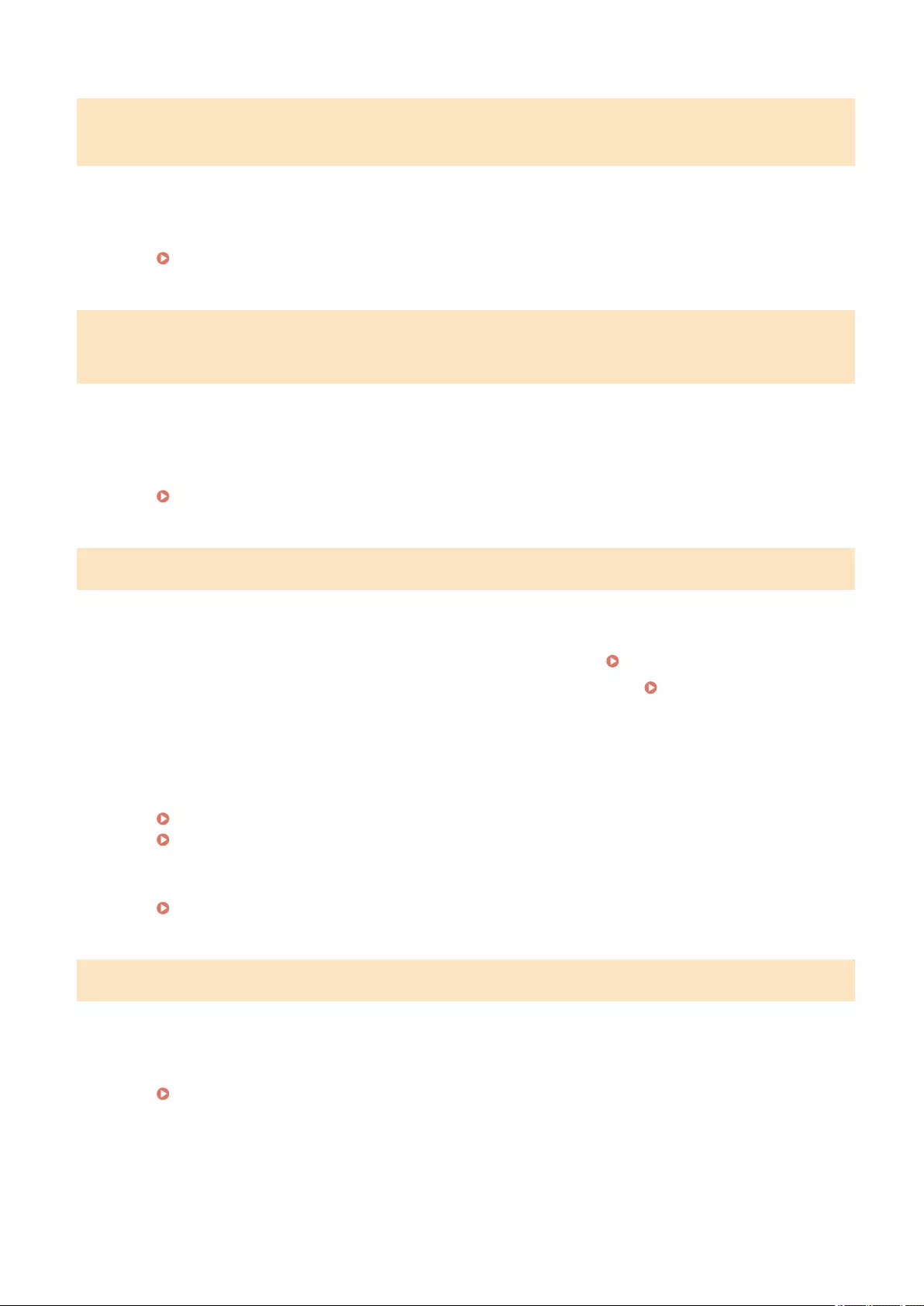
Paper is jammed in the paper transport unit. Select [Next] and follow the on-
screen instructions to remove the paper.
Paper is jammed in the paper transport unit.
●Follow instructions on the screen to remove jammed paper.
Clearing Paper Jams(P. 686)
Device Paper Jam
Paper jammed.
Paper is jammed.
●Remove originals from the document feed tray, and check whether an original is jammed in the feeder
cover or output tray.
Paper Jams in the Feeder(P. 688)
Diagnostics failed.
A problem occurred during print head diagnostics.
●Check the remaining amounts in the ink tanks, and replace if empty. Replacing the Ink Tanks(P. 528)
●Check the amount of maintenance cartridge used, and replace if full. Replacing the Maintenance
Cartridge(P. 532)
●Check that paper usable for print head diagnostics is loaded. If no paper is loaded, load paper and set the
size and type.
(Usable sizes: any of A3, 11x17, LTR, or A4; type: plain paper (recycled paper can be used); sheets: 5 or
more)
Loading Paper(P. 137)
Specifying Paper Size and Type(P. 152)
●Check that the adjustment image printed out during print head diagnostics is placed on the platen glass
correctly.
Diagnosing the Print Head(P. 584)
Direct Connection terminated.
Connection with the mobile device was interrupted.
●Establish Direct Connection again.
Connecting Directly (Access Point Mode)(P. 332)
Frequently Asked Questions
663

Drawer Side Cover Open
The side cover of the standard paper drawer is open.
●Close the side cover of the standard paper drawer.
Front Side(P. 103)
Faxing is restricted.
Faxing is disabled in the Department ID Management.
●Log in with a Department ID for which faxing is not disabled. For the Department ID and PIN, contact your
Administrator.
Setting the Department ID Management(P. 346)
Feeder Cover Open
Close the feeder cover.
The feeder cover is open.
●Close the feeder cover.
Feeder(P. 109)
Front Cover Lock Error
The front cover cannot be opened because it is locked.
An error occurred with the front cover lock.
●The front cover is usually locked. Do not try to open it.
Front Side(P. 103)
Front Cover Open
Close the cover.
The front cover is open.
●Close the front cover.
Front Side(P. 103)
Ink Level Unknown
Frequently Asked Questions
664

The ink level is unknown.
Cannot detect the level of ink correctly.
●Select <Cancel> and replace ink tanks, or select <I Agree> and disable ink level detection (will remain as a
history log). We cannot be liable in some instances for malfunction as a result of continued printing after
ink has run out or as a result of relling ink.
Replacing the Ink Tanks(P. 528)
Ink Tank Control Error
Cannot recognize one or more ink tanks. Please replace the ink tanks.
Cannot recognize one or more ink tanks.
●Replace the ink tanks.
Replacing the Ink Tanks(P. 528)
Ink Tank Installation Position ErrorCannot recognize one or more ink tanks.
Please replace the ink tanks.
Cannot recognize one or more ink tanks.
●Insert the ink tanks correctly.
Replacing the Ink Tanks(P. 528)
Ink Tank Not Installed
One or more ink tanks are not installed. Please install the necessary ink
tanks.
One or more ink tanks are not installed.
●Install the necessary ink tanks.
Replacing the Ink Tanks(P. 528)
Ink Tank Recognition Error
Cannot recognize one or more ink tanks. Please replace the ink tanks.
Cannot recognize one or more ink tanks.
●Replace with the correct ink tanks.
Replacing the Ink Tanks(P. 528)
Frequently Asked Questions
665
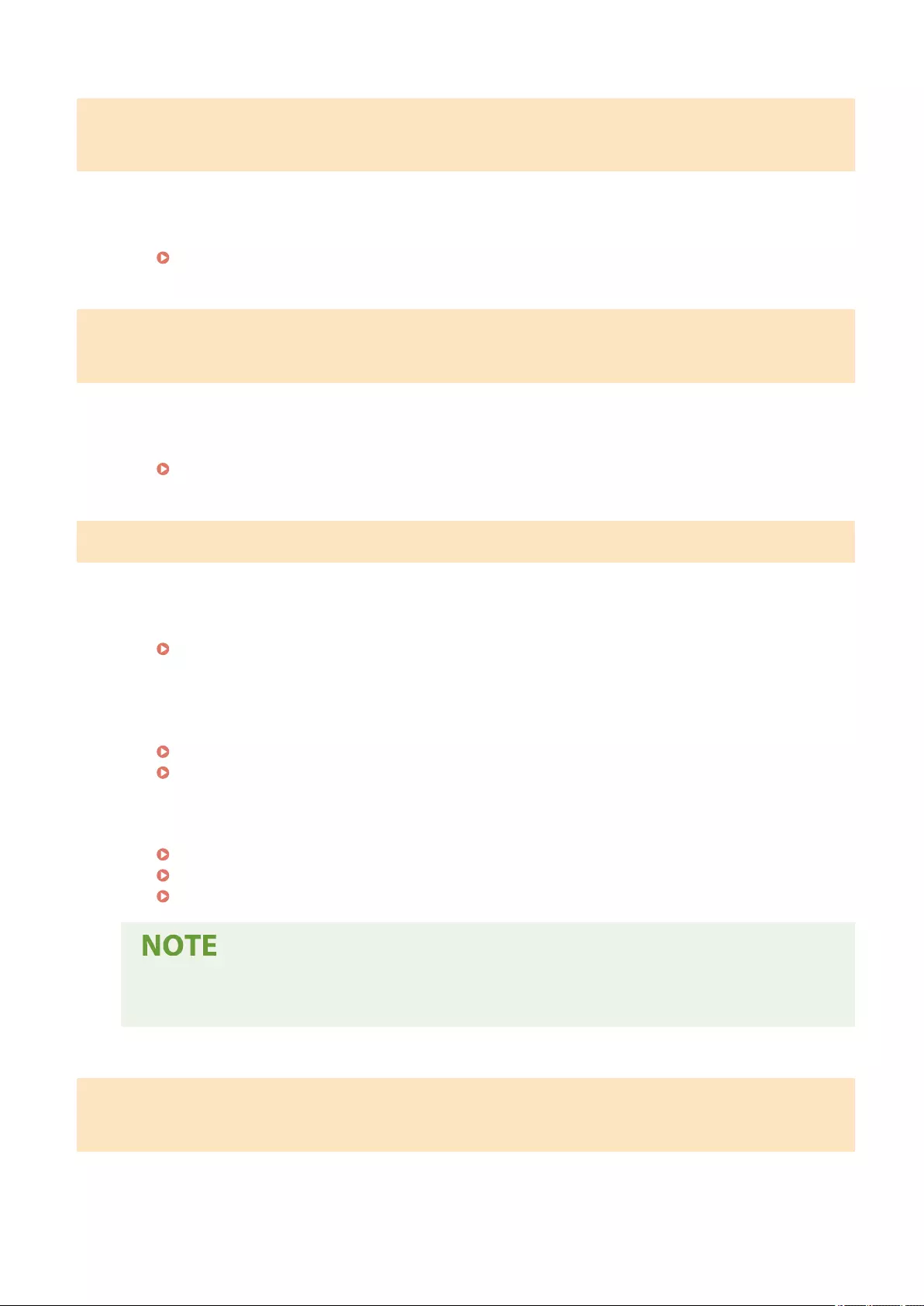
Ink Tank Replacement
Cannot recognize one or more ink tanks. Please replace the ink tanks.
Cannot recognize one or more ink tanks.
●Replace with correct ink tanks.
Replacing the Ink Tanks(P. 528)
Ink Tank Replacement
The following ink has run out. Replace with a new ink tank.
Ink has run out.
●Replace with a new ink tank.
Replacing the Ink Tanks(P. 528)
Load paper.
No paper is loaded in a paper drawer or the multi-purpose tray.
●Load paper.
Loading Paper(P. 137)
No paper is loaded for printing a report or list.
●Reports and lists can be printed on A4 or Letter-size plain paper / recycled paper / color paper. Load the
appropriate paper, and then set the paper size and type.
Loading Paper(P. 137)
Specifying Paper Size and Type(P. 152)
No paper is loaded for printing received faxes.
●Load appropriate paper for received faxes, and then set the paper size and type.
Loading Paper(P. 137)
Specifying Paper Size and Type(P. 152)
Available Paper(P. 726)
●Printing on paper other than A4 or Letter-size paper may result in portions of images not being
printed or in images being printed across several sheets.
Main Unit Memory Near End of Lifetime
The main unit's memory is near the end of its lifetime.
The machine's memory is near the end of its lifetime.
Frequently Asked Questions
666

●You can export address book entries and machine settings and save them to a computer. Backing up
important settings is recommended.
Importing/Exporting the Setting Data(P. 423)
●Printing is no longer possible once the memory reaches the end of its lifetime. Contacting your dealer or
the service center quickly is recommended.
When a Problem Cannot Be Solved(P. 699)
Maintenance Cartridge Error
A maintenance cartridge error has occurred. Please replace the maintenance
cartridge.
An error occurred with the maintenance cartridge.
●Replace the maintenance cartridge.
Replacing the Maintenance Cartridge(P. 532)
Maintenance Cartridge Full
The maintenance cartridge is full. Please replace the maintenance cartridge.
The maintenance cartridge is full.
●Replace the maintenance cartridge.
Replacing the Maintenance Cartridge(P. 532)
Maintenance Cartridge Not Installed
The maintenance cartridge is not installed. Please install a maintenance
cartridge.
A maintenance cartridge is not installed.
●Install a maintenance cartridge, and then press the Clear Error key.
Replacing the Maintenance Cartridge(P. 532)
Maintenance Necessary (101)
The machine requires maintenance.
●The machine can continue printing, but print quality may deteriorate. Contacting your dealer or the
service center quickly is recommended. ( 101 )
When a Problem Cannot Be Solved(P. 699)
Maintenance Necessary (102)
The machine requires maintenance.
Frequently Asked Questions
667

●The machine can continue printing, but print quality may deteriorate. Contacting your dealer or the
service center quickly is recommended. ( 102 )
When a Problem Cannot Be Solved(P. 699)
Memory Full (Secure Print)
Memory became full of secured documents that were not printed.
●Print the secured documents that are stored in memory.
Printing via Secure Print(P. 269)
Memory Full (Skip Error)
The memory became full of print data that could not be printed due to errors.
●Cancel printing of documents to which an error has occurred, or print the documents by selecting <Skip
Error> on the screen for checking the printing status.
Canceling Prints(P. 263)
Memory Media Print is restricted.
The function that prints les in a USB memory device is disabled.
●Set <Use Print Function> in <Memory Media Settings> to <On>.
Restricting the USB Print Function(P. 401)
Multiplexer Diode Switching Error
A problem occurred with the print head.
●Turn the machine off then on again. If the print head does not recover after turning the machine off then
on, contact your dealer or the service center.
●If you have a print head ready, replace the print head.
Replacing the Print Head(P. 536)
No reply from the destination.
A network cable may be disconnected, or there may be a problem in a switch.
●Check the status of the network cables and switches.
No response from the host.
The machine is not connected to a network correctly.
●Check the machine and network settings, and connect again.
Frequently Asked Questions
668
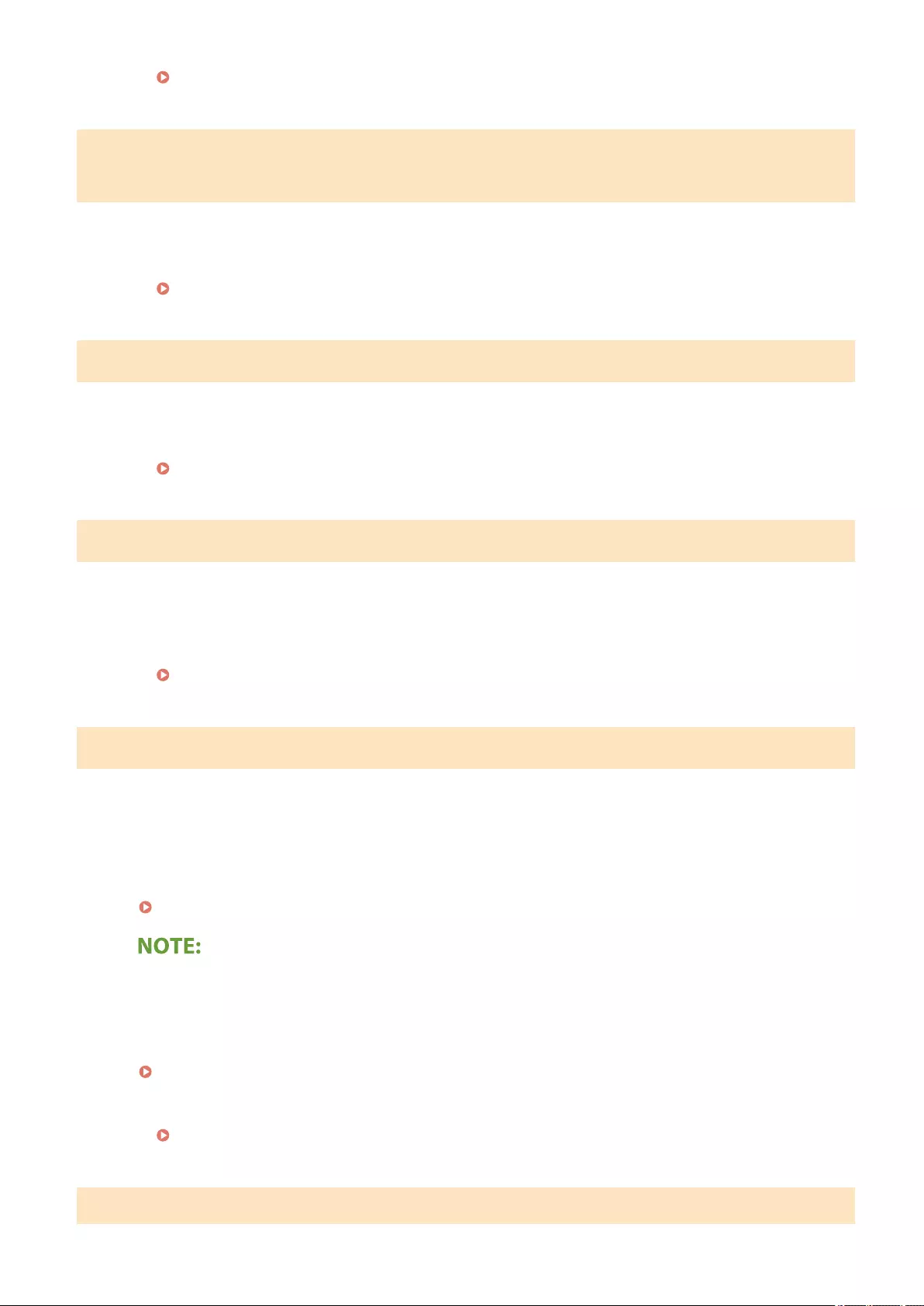
Setting Up the Network Environment(P. 17)
Output Tray Full
Remove the paper from the output tray.
The output tray is full.
●Remove printouts from the output tray.
Front Side(P. 103)
Paper jammed.
Paper jams.
●Remove the jammed paper, and print again (Printing may resume automatically).
Clearing Paper Jams(P. 686)
Paper Sensor Dirty
The sensor is dirty.
●Open the side cover, and remove any remaining paper.
●If there is no paper remaining, clean the paper sensor.
Cleaning the Sensor Area(P. 523)
Paper Settings and Loaded Size Mismatch
The paper size setting on the operation panel does not match the loaded paper size.
●Match the paper size setting specied in <Paper Settings> and the size of the paper that is actually loaded.
To use the loaded paper
Change the setting of <Paper Settings> to match the loaded paper size.
Specifying Paper Size and Type(P. 152)
●If printing from a computer, check whether the paper size setting in the printer driver matches the loaded
paper size.
To load paper without changing the settings
Load the paper with the size that is set to <Paper Settings>.
Loading Paper(P. 137)
●Check that the paper guides in the paper drawer are set in the correct position.
Loading Paper(P. 137)
Platen Cleaning
Frequently Asked Questions
669
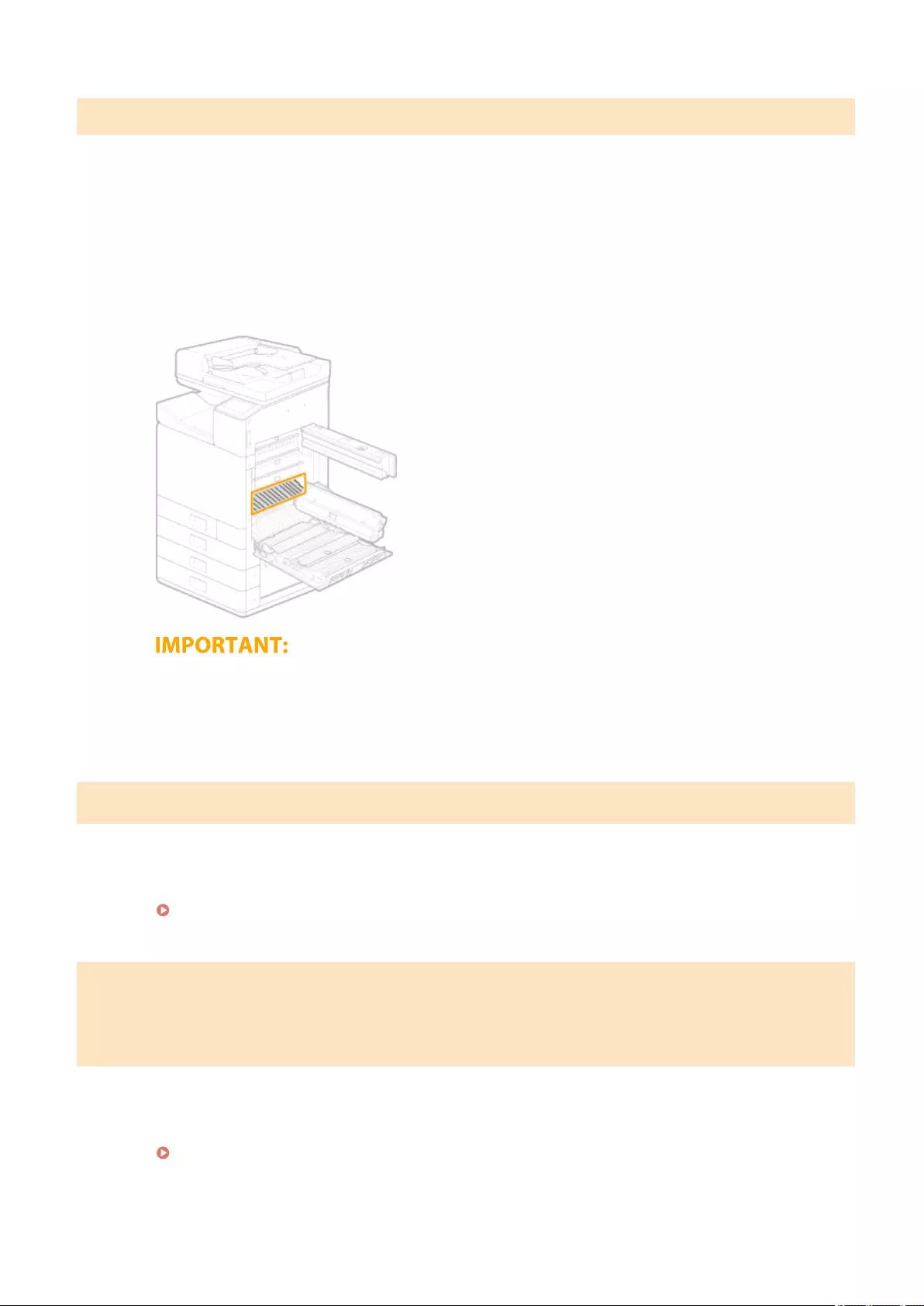
Please clean the platen.
The platen area may be dirty with paper dust and ink smudges.
●Follow the on-screen instructions and clean the platen. See below for how to clean the platen.
Cleaning the platen
●Wet a cloth with water and wring it out well, then wipe the area with it.
●Since paper dust collects on the platen easily, wipe towards you starting from the side away from you,
making sure paper dust does not enter the machine.
●Wipe 2 to 3 times along the rib line to remove white paper dust and ink smudges.
●Do not wipe areas where star wheels are present.
●Do not touch star wheels.
●Be careful not to scratch the rollers at the back of the platen.
Please remove any objects from on the output tray.
The output tray cannot operate.
●Remove any objects that are on the output tray.
Front Side(P. 103)
Print Head Compartment Cover Open Error
Close the print head compartment cover.
Close the front cover.
The print head compartment cover is open.
●Close the cover of the print head compartment.
Interior(P. 108)
Frequently Asked Questions
670

Print Head Connection Error
Cannot communicate with the print head. Check the connection.
A print head connection error is preventing communication with the print head.
●Check the print head connection.
Replacing the Print Head(P. 536)
Print Head Replacement
Please replace the print head.
A problem occurred with the print head.
●Turn the machine off then on again. If the print head does not recover after turning the machine off then
on, contact your dealer or the service center.
●If you have a print head ready, replace the print head.
Replacing the Print Head(P. 536)
Printing is restricted.
Printing is disabled in the Department ID Management.
●Log in with a Department ID for which printing is not disabled. For the Department ID and PIN, contact
your Administrator.
Setting the Department ID Management(P. 346)
Remote scanning is restricted.
Scanning that is operated by using a computer is disabled in the Department ID Management.
●Log in to the Remote UI in System Manager Mode, display the edit screen of Department ID Management,
and select the [Allow Scan Jobs with Unknown IDs] check box.
Setting the Department ID Management(P. 346)
RX Data Print Error
Cannot print RX data because of an error (cartridge end of lifetime, out of
paper, cover open, etc.). Check the cause of error.
Cannot print received faxes for some reason.
●Check if any of the following apply. Read any cause and troubleshooting information that is displayed.
A cover is open
No paper is loaded
Frequently Asked Questions
671

Paper or an original is jammed
Ink tanks or the maintenance cartridge have reached time for replacement
Something is abnormal
Scanning is restricted.
Scanning is disabled in the Department ID Management.
●Log in with a Department ID for which scanning is not disabled. For the Department ID and PIN, contact
your Administrator.
Setting the Department ID Management(P. 346)
Set the correct authentication information.
Client credentials (key and certicate, user name and password, and CA certicate) are not set correctly.
●Check the set authentication and credentials (key and certicate, user name and password, and CA
certicate).
Conguring IEEE 802.1X Authentication Settings(P. 388)
Set the information necessary for authentication.
The IEEE 802.1X authentication has not been congured correctly.
●Congure the IEEE 802.1X correctly from the Remote UI.
Conguring IEEE 802.1X Authentication Settings(P. 388)
Slide Guide Error
The registered paper size and paper guide positions do not match.
●Adjust the paper guides or load paper of the size set in <Paper Settings>.
Loading Paper in the Multi-Purpose Tray(P. 141)
Specifying and registering new destinations is restricted.
Only destinations that are registered in the Address Book can be specied to send a fax or e-mail.
●To enter a new destination with the operation panel, or add or edit it in the Address Book, you need to set
<Restrict New Destinations> to <Off>. For more information, contact your Administrator.
Restricting New Destinations that Can Be Specied(P. 396)
Frequently Asked Questions
672

The authentication server certicate has expired.
The server certicate sent from the RADIUS server has expired.
●Check the valid period of the server certicate on the RADIUS server.
Conguring IEEE 802.1X Authentication Settings(P. 388)
The authentication server certicate is incorrect.
There is no CA certicate registered in the printer that is compatible with the authentication server
certicate.
●Check that there is a CA certicate registered in the printer that is compatible with the authentication
server certicate.
Conguring IEEE 802.1X Authentication Settings(P. 388)
The computer is restricted.
Scanning that is operated on the operation panel is disabled in the Department ID Management.
●Log in to the Remote UI in System Manager Mode, display the edit screen of the corresponding
Department ID, and select the [Allow Scan Jobs with Unknown IDs] check box.
Setting the Department ID Management(P. 346)
The maintenance cartridge is almost full.
The maintenance cartridge is almost full.
●Prepare a maintenance cartridge.
Consumables(P. 625)
The memory is full.
A fax could not be sent or received, or an original could not be scanned due to insucient memory
space.
●If a sending or printing job is queued, wait until the job is completed.
●If a received document is stored to memory, print or delete it.
Saving Received Documents into the Machine (Memory Reception)(P. 241)
●If sending an original with many pages, divide it into multiple sections.
●If sending a fax, reduce the resolution to scan the original.
Basic Operations for Sending Faxes(P. 220)
●If scanning, change the le format to reduce its le size.
Basic Operations for Scanning Originals(P. 286)
A scanned original could not be stored to a USB memory device due to insucient memory space.
Frequently Asked Questions
673

●Delete unnecessary data to free space in the USB memory device, or connect a different USB memory
device.
Insert a USB Memory Device(P. 105)
The memory is full. Enter the original type settings again.
An original could not be scanned because memory became full during copying.
●Set <Original Type> to <Text/Photo/Map>, and copy.
Selecting the Type of Original for Copying(P. 204)
The memory is full. Scanning will be canceled. Do you want to print?
An original could not be scanned due to insucient memory space.
●Select whether to print the pages that were scanned or cancel the job.
●Copy the original in two or more parts.
Not all of the pages could be scanned during sorting and copying.
●Select whether to print the pages that were scanned or cancel the job.
●If this is a copy job, either copy the original in two or more parts or change the <Original Type> setting to
<Text/Photo/Map> and then copy the original.
Selecting the Type of Original for Copying(P. 204)
The number of entered characters is incorrect or invalid characters are used.
The network key (the WPA/WPA2-PSK or WEP key) of a wireless router is not entered correctly.
●Check the network key (the WPA/WPA2-PSK or WEP key) of the wireless router, and set it to the machine
again. For more information about how to check the network key, see the instruction manuals for your
networking devices or contact your manufacturer.
Checking the SSID and Network Key(P. 33)
Setting Up Connection by Selecting a Wireless Router(P. 27)
Setting Up Connection by Specifying Detailed Settings(P. 30)
The paper size/type combination is invalid.
The paper settings in the multi-purpose tray differ from the paper that is loaded.
●Check the paper settings on the paper information in <Paper Settings>. If the paper settings are incorrect,
match them with the paper size and type of the paper that is loaded. Paper settings can be specied for all
the paper sizes and types set in the multi-purpose tray in <Paper Settings>.
Specifying Paper Size and Type in the Multi-Purpose Tray(P. 156)
Frequently Asked Questions
674

The print head nozzles are clogged.
A problem occurred with the print head.
●Turn the machine off then on again. If the print head does not recover after turning the machine off then
on, contact your dealer or the service center.
●If you have a print head ready, replace the print head.
Replacing the Print Head(P. 536)
The sensor's effectiveness is decreasing.
Sensor Error
The paper sensor may be dirty.
●Cleaning the sensor is recommended.
Cleaning the Sensor Area(P. 523)
The USB memory is restricted.
The function that stores a scanned original to a USB memory device is disabled.
●Set <Use Scan Function> to <On>.
Restricting the Scan to USB Function(P. 401)
The WEP key is not set correctly. Check the WEP settings.
The network key (the WEP key) of a wireless router to be connected is not set to the machine correctly.
●Check the network key (the WEP key) of the wireless router, and set it to the machine again.
Checking the SSID and Network Key(P. 33)
Setting Up Connection by Selecting a Wireless Router(P. 27)
Setting Up Connection by Specifying Detailed Settings(P. 30)
The authentication method of the machine is set to <Shared Key>, but that of the wireless router is set to
"Open System."
●Connect again by selecting a wireless router or by manually changing the WEP authentication method to
<Open System>.
Setting Up Connection by Selecting a Wireless Router(P. 27)
Setting Up Connection by Specifying Detailed Settings(P. 30)
●Change the WEP authentication method to "Shared Key" at the wireless router, and connect again. For
more information about how to change, see the instruction manuals for your networking devices or
contact your manufacturer.
Frequently Asked Questions
675

Transport Guide Open
The transport guide is open.
●Close the transport guide.
Interior(P. 108)
Transport Unit Cover Open
Transport unit covers 1 and 2 are open.
●Close transport unit covers 1 and 2.
Interior(P. 108)
Use Remote UI to set the information necessary for authentication.
The IEEE 802.1X settings are incorrect.
●Check whether [Login Name] is set correctly.
●Check whether the [Use TLS], [Use TTLS], or [Use PEAP] check box is selected.
●If using TLS, check whether a "key and certicate" is registered.
●If using TTLS or PEAP, check whether a user name and password are set correctly.
Conguring IEEE 802.1X Authentication Settings(P. 388)
Frequently Asked Questions
676
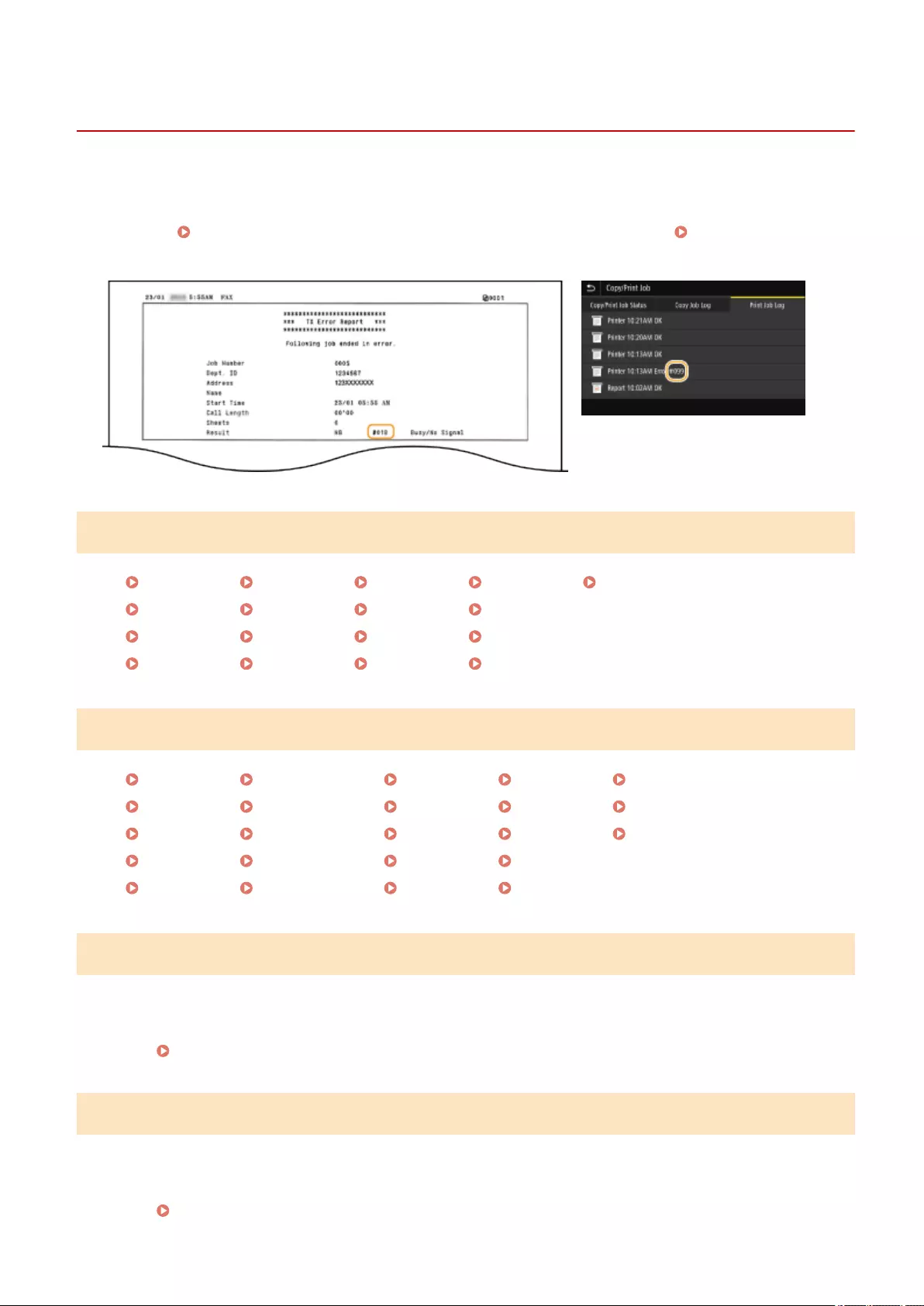
Countermeasures for Each Error Code
2579-0AJ
If an error occurs such as when printing is not successful or when you cannot send or receive a fax or scanned
original, the corresponding error code is displayed in a report or in the job log screen as a three-digit number. Check
the following to nd out causes and solutions for each error code. For how to print an error report and information in
the report, see Printing Reports and Lists(P. 621) . For details of the job log screen, see <Status Monitor>
Screen(P. 123) .
#001 to #800
#001(P. 677) #018(P. 678) #099(P. 679) #751(P. 679) #766(P. 681)
#003(P. 677) #022(P. 678) #401(P. 679) #752(P. 680)
#005(P. 678) #037(P. 678) #406(P. 679) #753(P. 680)
#012(P. 678) #054(P. 679) #701(P. 679) #755(P. 680)
#801 to #999
#801(P. 681) #810(P. 682) #822(P. 683) #844(P. 684) #862(P. 685)
#802(P. 681) #812/813(P. 682) #827(P. 683) #846(P. 684) #863(P. 685)
#804(P. 681) #818(P. 682) #829(P. 683) #852(P. 684) #995(P. 685)
#806(P. 682) #819(P. 682) #839(P. 683) #853(P. 684)
#808(P. 682) #820(P. 683) #841(P. 683) #861(P. 685)
#001
An original jams in the feeder.
●Remove the jammed original.
Paper Jams in the Feeder(P. 688)
#003
A fax could not be sent or received due to its large data size.
●When sending a fax: Reduce the resolution, and scan the original.
Basic Operations for Sending Faxes(P. 220)
Frequently Asked Questions
677

●When receiving a fax: Ask the sender to divide the original into multiple sections or reduce the resolution
before sending.
#005
A fax could not be sent because the recipient's machine did not respond within 35 seconds.
●When the recipient's machine is turned OFF or the line is busy, a fax may not be sent. Ask the recipient to
check the machine status. When sending the fax overseas, insert pauses in the fax number.
Basic Operations for Sending Faxes(P. 220)
#012
A fax could not be sent because the recipient's machine ran out of paper.
●Ask the recipient to reload the paper.
#018
A fax could not be sent since the recipient's machine did not respond because the line was busy or for
other reasons.
●When the recipient's machine is turned OFF or the line is busy, a fax may not be sent. Ask the recipient to
check the machine status. When sending the fax overseas, insert pauses in the fax number.
Basic Operations for Sending Faxes(P. 220)
#022
Sending of a fax from a computer is disabled.
●To send a fax from a computer, you need to set <Allow Fax Driver TX> to <On>. For more information,
contact your Administrator.
Restricting Fax Sending from a Computer(P. 398)
A fax could not be forwarded because the specied destination was deleted from the Address Book.
●Register the forwarding destination again. If the documents that failed to be forwarded remain in
memory, you can forward it again.
Registering Destinations(P. 181)
Printing/Resending/Deleting Documents that Failed to be Forwarded(P. 243)
#037
A fax could not be sent because the memory is full.
●If a job queued, wait until the job is completed.
●If a received document is stored to memory, print or delete it.
Saving Received Documents into the Machine (Memory Reception)(P. 241)
●If sending an original with many pages, divide it into multiple sections.
●If sending a fax, reduce the resolution to scan the original.
Basic Operations for Sending Faxes(P. 220)
Frequently Asked Questions
678

The le is too large to print.
●Optimize the le to reduce the size or divide the le into sections, and then proceed to printing again.
●Try printing from the printer driver. This may work well.
#054
A fax could not be sent because the specied destination fax number exceeded 40 digits.
●Specify the destination fax number within 40 digits.
#099
An operation that caused a job to be canceled has been performed.
●When you cancel a job, this error code is displayed, but this is not abnormal. Print, send, or receive
documents again as necessary.
#401
A scanned original could not be stored to a USB memory device due to insucient memory space.
●Delete unnecessary data to free space in the USB memory device, or connect a different USB memory
device.
Insert a USB Memory Device(P. 105)
#406
A scanned document could not be stored to a USB memory device due to an error.
●Remove the USB memory device, and connect it again.
Insert a USB Memory Device(P. 105)
●Reduce the number of originals to scan.
#701
Authentication failed because an incorrect Department ID or PIN was entered when the Department ID
Management was activated.
●Enter the correct Department ID and PIN.
Continuing operating without entering a Department ID was attempted even though unknown-ID jobs
(functions that permit operations without a Department ID and PIN) were disabled in the Department ID
Management.
●Enable unknown-ID jobs in System Manager Mode in Remote UI.
Blocking Jobs When Department ID Is Unknown(P. 350)
#751
The FTP server has not been started up or a network connection has been cut.
(Failure to connect to the destination is sometimes caused by a disconnection en route.)
Frequently Asked Questions
679

●Check the destination.
●Check the network status.
Viewing Network Settings(P. 41)
The IP address was not set correctly.
●Check <TCP/IP Settings>.
Setting IP Addresses(P. 34)
#752
E-mail sending or I-Fax sending/receiving was impossible because an incorrect SMTP/POP3 server name
was set.
●Check the SMTP/POP3 server name, and correct the setting.
Conguring E-Mail/I-Fax Communication Settings(P. 91)
E-mail sending or I-Fax sending/receiving was impossible because an incorrect domain name was set.
●Check the domain name, and correct the setting.
Conguring DNS(P. 59)
E-mail sending or I-Fax sending/receiving was impossible because the machine was not connected to a
network correctly.
●Check whether the machine is properly installed and correctly connected to the network.
Installation/Settings Problems(P. 631)
#753
Scanned data could not be sent as e-mail, not sent/received as I-Fax, or not stored in the shared
folder/FTP server because the LAN cable is disconnected.
●Check whether the LAN cable is connected correctly.
Connecting to a Wired LAN(P. 20)
#755
Scanned data could not be sent as e-mail or I-Fax nor stored in the shared folder or FTP server because
TCP/IP was not working correctly.
●Check <TCP/IP Settings>, and set correctly.
<Network>(P. 440)
An IP address is not set.
●Set the IP address correctly.
Setting IP Addresses(P. 34)
The machine cannot communicate with devices on a network immediately after the machine starts up
because the waiting time for the start of the communication is set.
●The machine cannot start communicating immediately after it is turned ON. Wait until the set time for
<Waiting Time for Connection at Startup> passes after turning ON the machine, and send again.
Setting a Wait Time for Connecting to a Network(P. 58)
Frequently Asked Questions
680

#766
The certicate has expired.
●Update the certicate or use a certicate that has not expired.
●Check that the <Current Date/Time Settings> are correct.
Setting the Date/Time(P. 15)
#801
When communicating with an SMTP server to send an e-mail/I-Fax, a timeout error occurred from the
server.
●Check whether SMTP is running on the network correctly.
●Check whether the machine is properly installed and correctly connected to the network.
Installation/Settings Problems(P. 631)
When communicating with the SMTP server, an error returned from the server.
●Check whether the SMTP server is set correctly.
A destination is not set correctly.
●Check whether the destination is set correctly.
When storing a scanned original into the shared folder, an error occurred from the folder.
●Check whether the shared folder and the computer that has the shared folder are running correctly.
The incorrect folder name or password was specied when storing to the shared folder.
●Check the destination settings.
#802
The SMTP/POP3/FTP server name is not set correctly.
●Set the SMTP/POP3/FTP server name correctly.
Conguring E-Mail/I-Fax Communication Settings(P. 91)
Registering Destinations from Remote UI(P. 419)
#804
No access privileges to access the shared folder/FTP server are granted.
●Assign the privilege for writing data to the storage folder to the sender (user name registered in the
destination). For details, contact your Network Administrator.
The incorrect folder name was specied when storing to the shared folder/FTP server.
●Check the destination settings.
Frequently Asked Questions
681

#806
When storing data to a shared folder/FTP server, an incorrect user name or password was specied.
●The same user name and password as those registered in a shared folder/FTP server must be registered in
the Address Book.
Procedure for Setting a Shared Folder as a Save Location(P. 95)
Registering Destinations from Remote UI(P. 419)
When sending an e-mail/I-Fax, an incorrect destination was specied.
●Enter the correct e-mail address, and send the message again. If the destination that was registered in the
Address Book was used, check whether the e-mail address is correct.
Registering Destinations(P. 181)
#808
An error or timeout occurred on the FTP server.
●Check the FTP server settings.
Registering Destinations from Remote UI(P. 419)
#810
An error has been returned from the POP3 server when sending an e-mail or sending/receiving I-Fax.
●Check whether the POP3 server is set correctly.
●Check whether your mail server and network are running correctly. For more information, contact your
Network Administrator.
#812/813
The login name or the password that is used on the POP3 server is not set correctly.
●Correctly enter the login name or the password that is used on the POP3 server.
#818
The received data is in a le format that the machine cannot print.
●Contact the other party and ask them to resend the data in a different le format.
#819
The received data is not supported (incorrect MIME information).
●Contact the other party and ask them to check the settings and then resend the data.
Frequently Asked Questions
682

#820
The received data is not supported (incorrect BASE64 or uuencode information).
●Contact the other party and ask them to check the settings and then resend the data.
#822
An le in a USB memory device could not be printed because the format of the le is not supported.
●Check the supported le formats and save the le again.
Insert a USB Memory Device(P. 105)
#827
The received data is not supported (includes unsupported MIME information).
●Contact the other party and ask them to check the settings and then resend the data.
#829
The received data exceeds the maximum receivable size.
●In fax reception, the machine deletes the data for page 1,000 onwards and either prints the rst 999 pages
or holds them in memory. Get the sender to resend page 1,000 onwards.
●In I-Fax reception, the machine cannot receive the e-mail if its size exceeds 24 MB. Ask the sender to
reduce the size of the e-mail down to under 24 MB and try resending.
#839
A user name and password that are used for SMTP authentication are not set correctly.
●Set the user name and password correctly.
Conguring E-Mail/I-Fax Communication Settings(P. 91)
#841
When sending an e-mail/I-Fax, an encryption algorithm that is common to the mail server is not present.
●Clear the [Use TLS for SMTP]/[Use TLS for POP] check box.
Conguring E-Mail/I-Fax Communication Settings(P. 91)
●Add the common encryption algorithm to the mail server settings.
A TLS server certicate verication error has occurred during communication with the SMTP server.
●Check that the CA certicate that signed the TLS server certicate on the SMTP server side is registered to
the machine by using the Remote UI.
●Check that the TLS server certicate on the SMTP server side is valid.
●Check that the TLS server certicate is not a self-signed one.
Frequently Asked Questions
683

#844
TLS encrypted communication to a POP3 server failed when sending an e-mail with POP before SMTP.
●Check the TLS encrypted communication settings in the POP3 server.
●Clear the [Use TLS for POP] check box. If the problem persists, clear the [Use POP Authentication Before
Sending] check box, and set the communication setting to a setting other than POP before SMTP.
Conguring E-Mail/I-Fax Communication Settings(P. 91)
When verifying an TLS server certicate to communicate to the POP3 server, a verication error
occurred.
●Check that the CA certicate that signed the TLS server certicate on the POP3 server side is registered to
the machine by using the Remote UI.
●Check that the TLS server certicate on the POP3 server side is valid.
●Check that the TLS server certicate is not a self-signed certicate.
#846
An e-mail or I-Fax could not be sent due to a POP authentication failure.
●Check the setting, and try again.
Conguring E-Mail/I-Fax Communication Settings(P. 91)
#852
The machine turns OFF for some reason.
●Check whether the power plug is inserted into an outlet rmly.
#853
A document could not be printed because its data size exceeded the machine's upper processing
capability.
●The machine may not be able to print documents with many pages. Reduce the number of pages per
printing, or print when no print job is queued or no document is being printed. If you are still unable to
print, check the document data for any defects.
Printing was canceled from the computer.
●If you cancel an operation when the print data is being sent to the machine from a computer, this error
code is displayed, but this is not abnormal. Print again as necessary.
A secured document that was left unprinted was deleted.
●If the secured document is not printed within a specic period of time (30 minutes by default), it is deleted
from memory. Send the secured document again, and print it within the period.
Printing via Secure Print(P. 269)
Printing using Secure Print was attempted when Secure Print was restricted.
●When <Secure Print> is set to <Off>, you cannot use Secure Print. Set the setting to <On> and print again.
Printing via Secure Print(P. 269)
●Print without using Secure Print.
Frequently Asked Questions
684

Basic Printing Operations(P. 261)
You tried to print a le that is either corrupted or not supported.
●Check the le and try again.
Basic Printing Operations(P. 261)
Password protected PDF les could not be printed.
●Enter the correct password for the PDF le.
Printing from a USB Memory Device (Memory Media Print)(P. 272)
Custom size settings outside the machine's printable range were congured.
●If a custom size was specied with the printer driver, paper size settings that are outside the machine's
printable range may have been set.
The settable range differs for each paper drawer and the multi-purpose tray; congure paper size settings
that are appropriate for the custom size.
Available Paper(P. 726)
#861
A document could not be printed because a printer driver that was not intended for this machine was
used.
●Print again by using the printer driver for this machine.
Basic Printing Operations(P. 261)
A document could not be printed due to a defect in its data.
●Check the document data for any defects.
#862
Could not print, as unsupported print settings are congured on the machine.
●Is the resolution set to 1200 dpi? Try changing the resolution to 600 dpi.
●Paper size settings for the custom size may be outside the printable range. Try either setting a smaller
value for the paper size setting or selecting a standard size.
●Check the print settings and print again.
Basic Printing Operations(P. 261)
#863
An error occurred when printing from a computer.
●Turn OFF the machine, wait for at least 10 seconds, and turn it back ON. After the restart is complete, try
printing again.
#995
A document waiting to be sent or received was canceled.
●Send or receive the document again as necessary.
Frequently Asked Questions
685
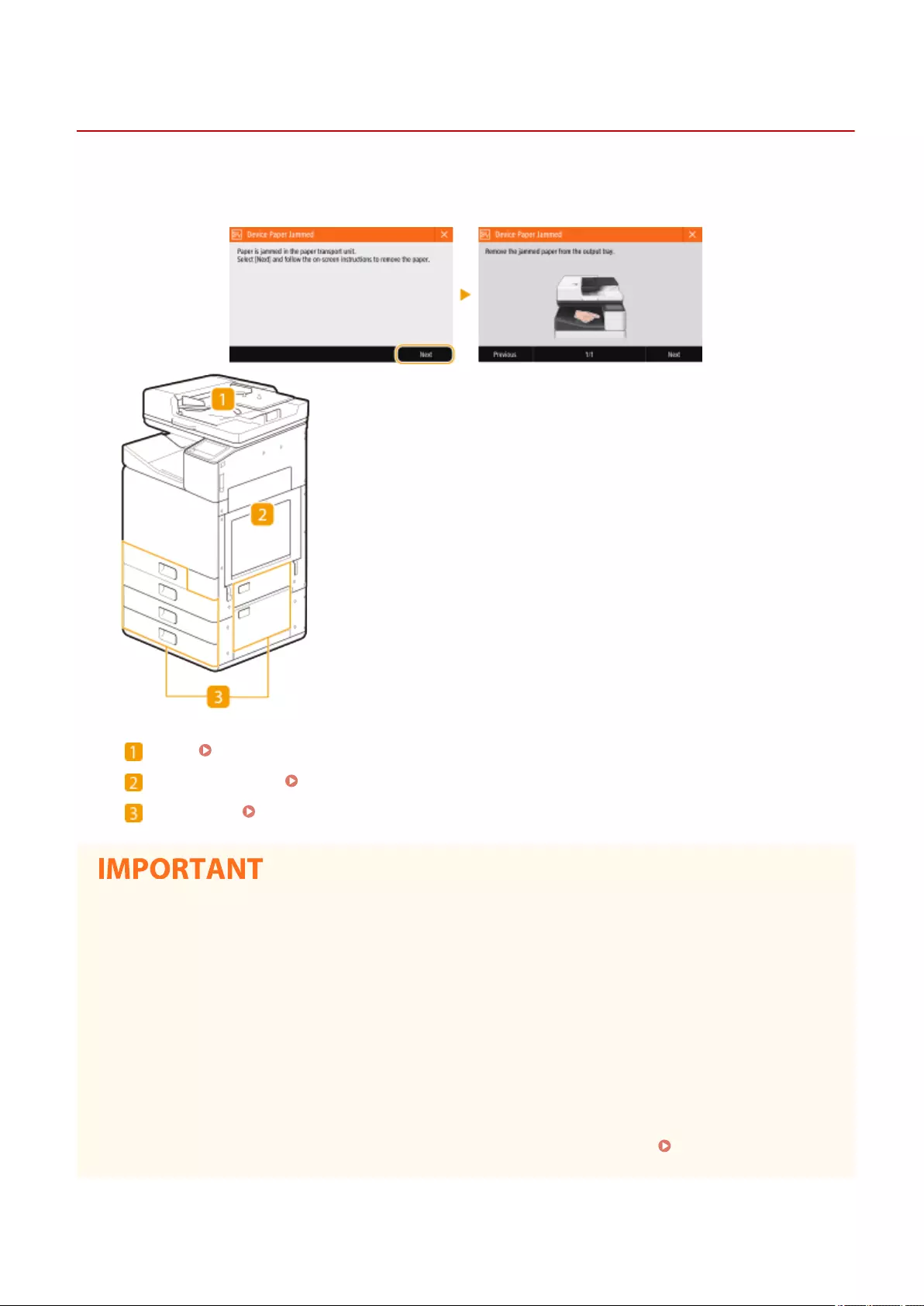
Clearing Paper Jams
2579-0AK
If a paper jams, <Paper jammed.> is displayed on the screen. Select <Next> to display simple solutions. If it is dicult
to understand the procedures on the display, see the following sections to clear jams.
Feeder Paper Jams in the Feeder(P. 688)
Inside the main unit Paper Jams in the Main Unit(P. 691)
Paper drawer Paper Jams in a Paper Source(P. 695)
When removing the jammed paper, do not turn OFF the machine
●Turning OFF the machine deletes the data that is being printed. Be especially careful when receiving fax
documents.
If paper tears
●Remove all the paper fragments to prevent them from becoming jammed.
If paper jams repeatedly
●If paper jams during 2-sided printing, using 1-sided printing may resolve the problem.
●Paper may jam if printing a high-density pattern on weak paper such as short grain paper using 2-sided
printing.
If paper jams, changing the density and ink drying time may resolve the problem. Adjusting the Density
and Ink Drying Time(P. 608)
Frequently Asked Questions
686

Do not forcibly remove the jammed paper from the machine
●Forcibly removing the paper may damage parts. If you are not able to remove the paper, contact your dealer
or the service center. When a Problem Cannot Be Solved(P. 699)
●Paper may not actually be jammed in the location you check. Even in this case, follow the instructions on the
screen to check all the locations.
●The screen indicating that there is a paper jam is repeatedly displayed until you clear the paper jam.
●If you press <Close> on the screen indicating that there is a paper jam, you may be able to continue to
perform operations and specify settings without immediately removing the paper jam.
●Do not remove paper from a location other than that displayed as a paper jam location on the screen. This
may cause paper jams in other locations or missing pages in output documents.
Frequently Asked Questions
687
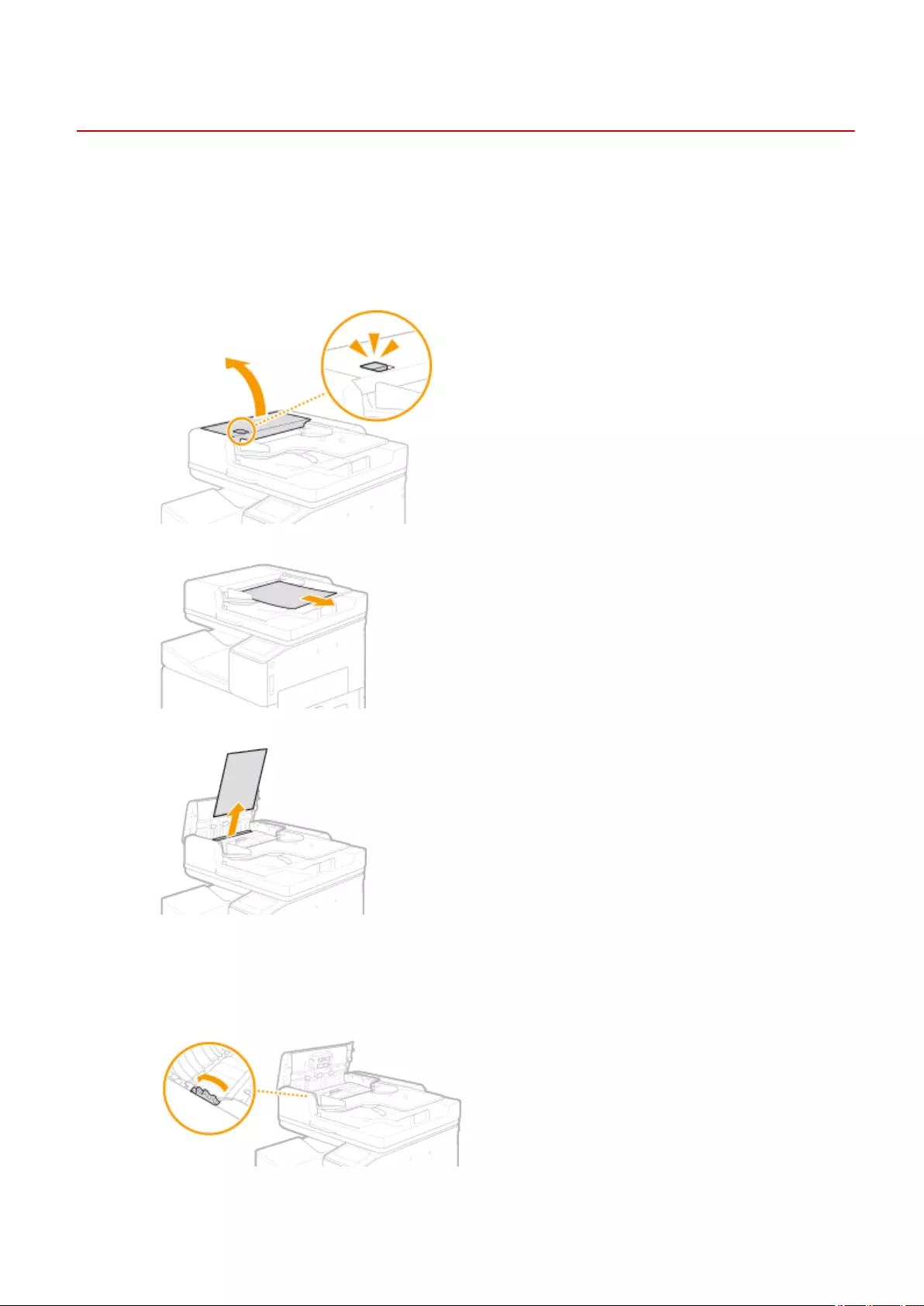
Paper Jams in the Feeder
2579-0HW
Check the paper jam location on the screen, and follow the procedure below to remove the original.
1Check whether an original is jammed in the feeder cover.
1Pull the lever to open the feeder cover.
2Remove any originals remaining in the original supply tray.
3If an original is jammed, gently pull it out in the direction of the arrow.
2Check whether an original is jammed in the original output tray.
1Turn the green feed wheel left.
2If an original is jammed, gently pull it out in the direction of the arrow.
Frequently Asked Questions
688
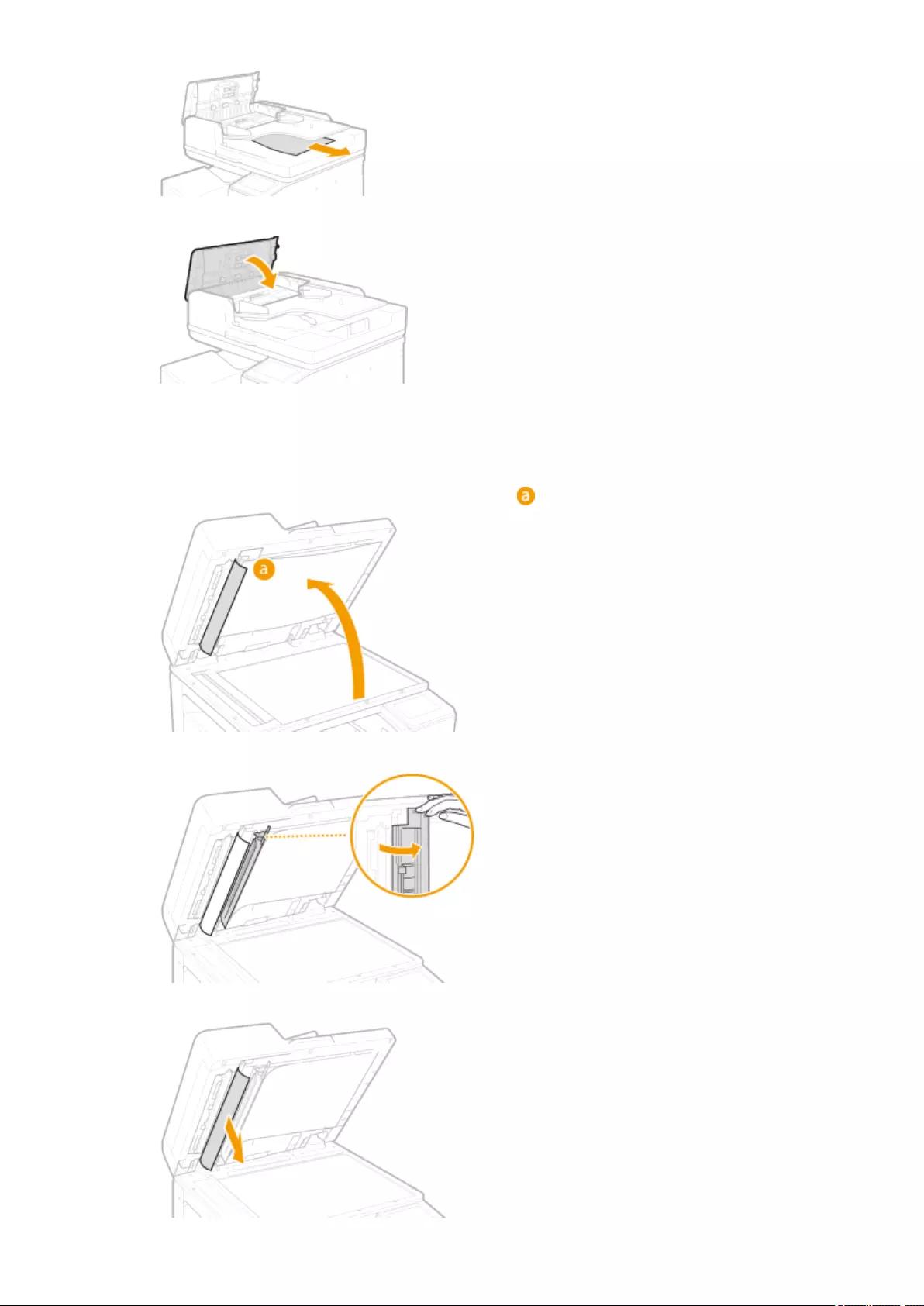
3Close the feeder cover.
3Lift up the feeder, and check whether there is a jammed original.
1Lift up the feeder, and check the position indicated by .
2Pull on the green lever to open the document scan cover.
3If an original is jammed, gently pull it out in the direction of the arrow.
Frequently Asked Questions
689

4Close the document scan cover.
4Return the feeder to its original position.
●Continue following the instructions on the screen to proceed with the interrupted operation or continue
clearing paper jams.
Frequently Asked Questions
690

Paper Jams in the Main Unit
2579-0HX
Check the paper jam location on the screen, and follow the procedure below to remove the paper.
Conrm before handling
●Before starting the operation to clear paper jams, conrm that the covers and paper drawers of the machine
and optional equipment are closed.
1Check whether paper is jammed in the output tray of the main unit.
●If paper is jammed, gently pull it out in the direction of the arrow.
2Unlock the right cover of the main unit.
3Check whether paper is jammed in the right cover of the main unit.
●Paper may be jammed at a different location than shown on the screen. Remove paper following the
instructions on the screen.
1Open transport unit cover 1.
Frequently Asked Questions
691
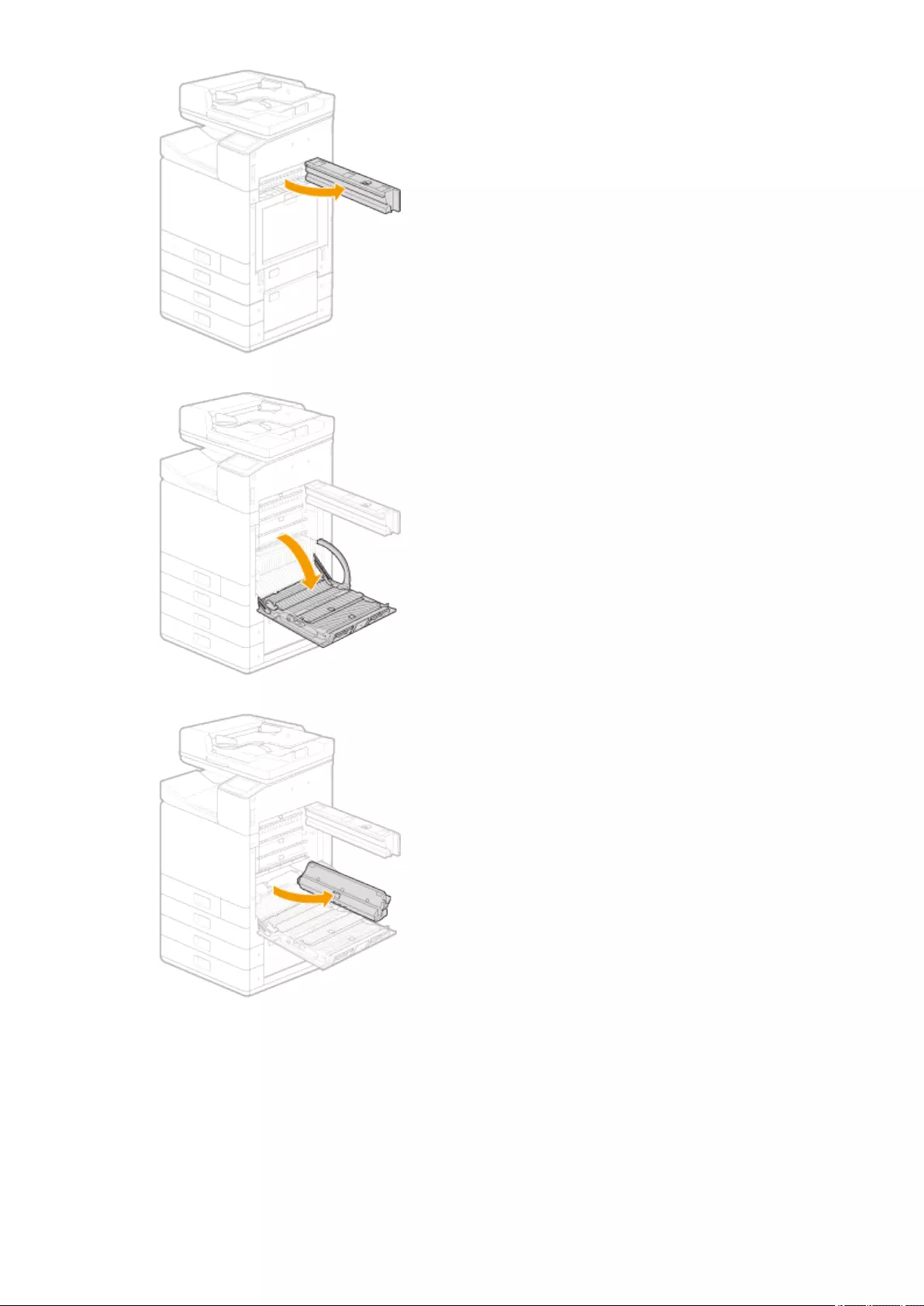
2Open transport unit cover 2.
3Open the transport guide.
4Open the platen.
Frequently Asked Questions
692
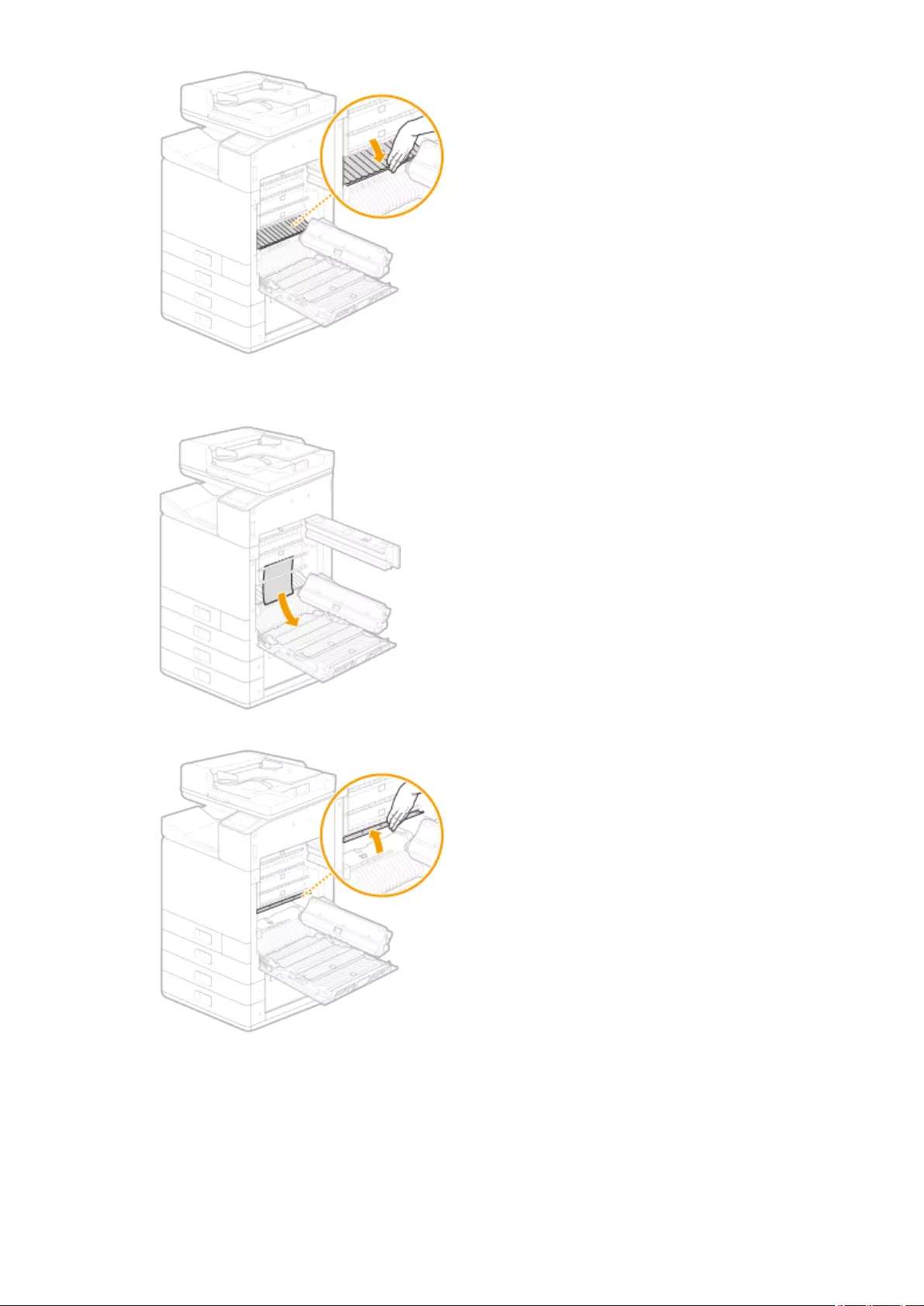
5Check whether paper is jammed.
●If paper is jammed, gently pull it out in the direction of the arrow.
6Close the platen.
7Close the transport guide.
Frequently Asked Questions
693
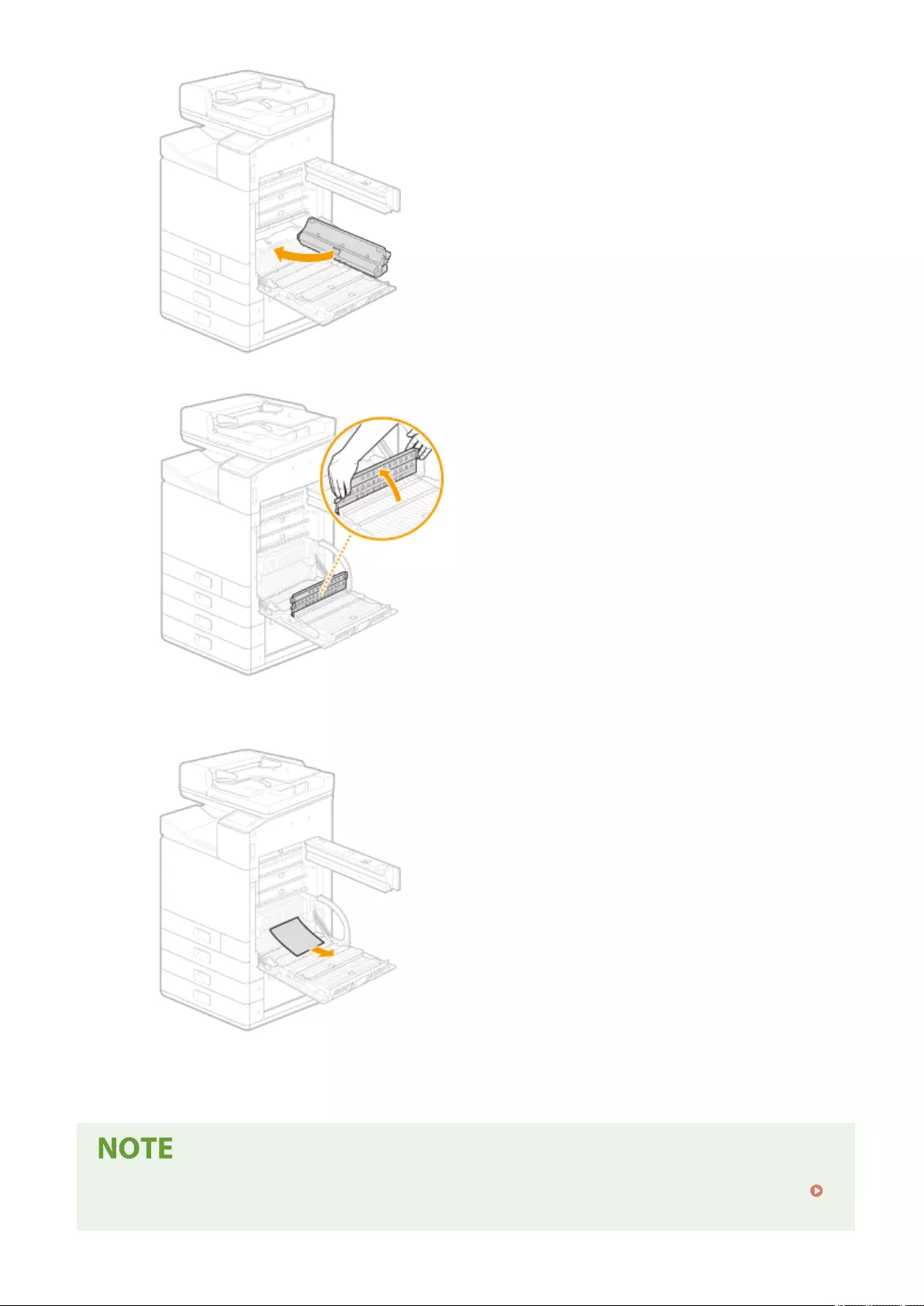
8Open the duplex guide.
9Check whether paper is jammed.
●If paper is jammed, gently pull it out in the direction of the arrow.
10 Close transport unit cover 1.
11 Close transport unit cover 2.
●If the problem persists even after removing jammed paper according to the steps, clean the sensor area.
Cleaning the Sensor Area(P. 523)
Frequently Asked Questions
694
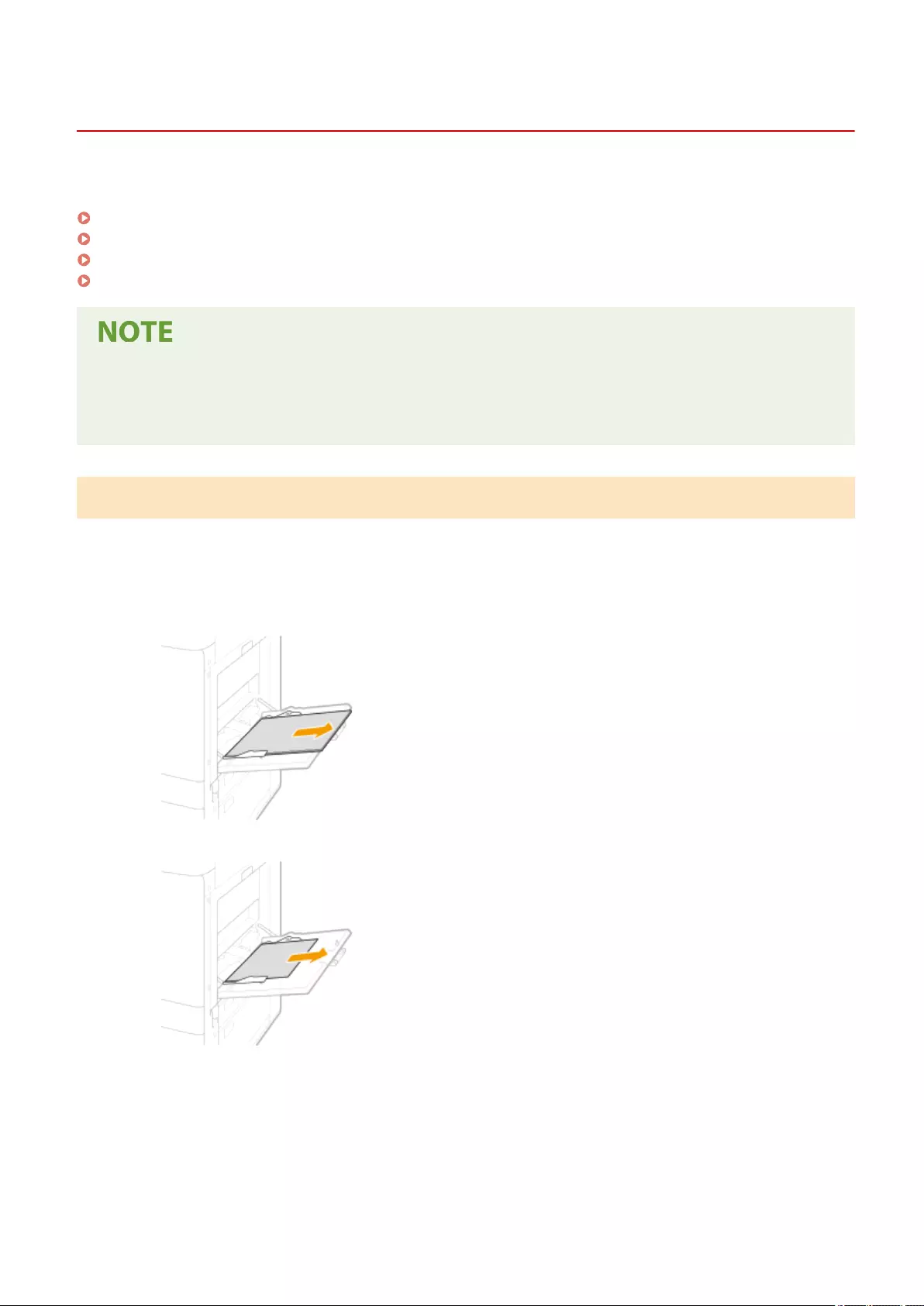
Paper Jams in a Paper Source
2579-0HY
Check the paper jam location on the screen, and follow the procedure below to remove the paper.
Paper Jams in the Multi-Purpose Tray(P. 695)
Clearing Paper Jams in Paper Drawers 1(P. 696)
Clearing Paper Jams in Paper Drawers 2(P. 696)
Clearing Paper Jams in Paper Drawers 3 and 4 (Optional)(P. 697)
Conrm before handling
●Before starting the operation to clear paper jams, conrm that the covers and paper drawers of the machine
and optional equipment are closed.
Paper Jams in the Multi-Purpose Tray
1Remove the jammed paper in the multi-purpose tray.
1Remove any paper loaded on the multi-purpose tray.
2Remove the jammed paper.
3Close the tray.
Frequently Asked Questions
695

Clearing Paper Jams in Paper Drawers 1
2Check whether paper is jammed in the paper drawer 1.
1Open the paper drawer 1.
2If paper is jammed, gently pull it out in the direction of the arrow.
3Push the paper drawer 1 in until it clicks.
●When closing the paper drawer, be careful not to get your ngers caught, as this may result in
personal injury.
●Continue following the instructions on the screen to proceed with the interrupted operation or continue
clearing paper jams.
Clearing Paper Jams in Paper Drawers 2
1Check whether paper is jammed in the side cover of the standard paper drawer.
1Open the side cover of the standard paper drawer.
Frequently Asked Questions
696
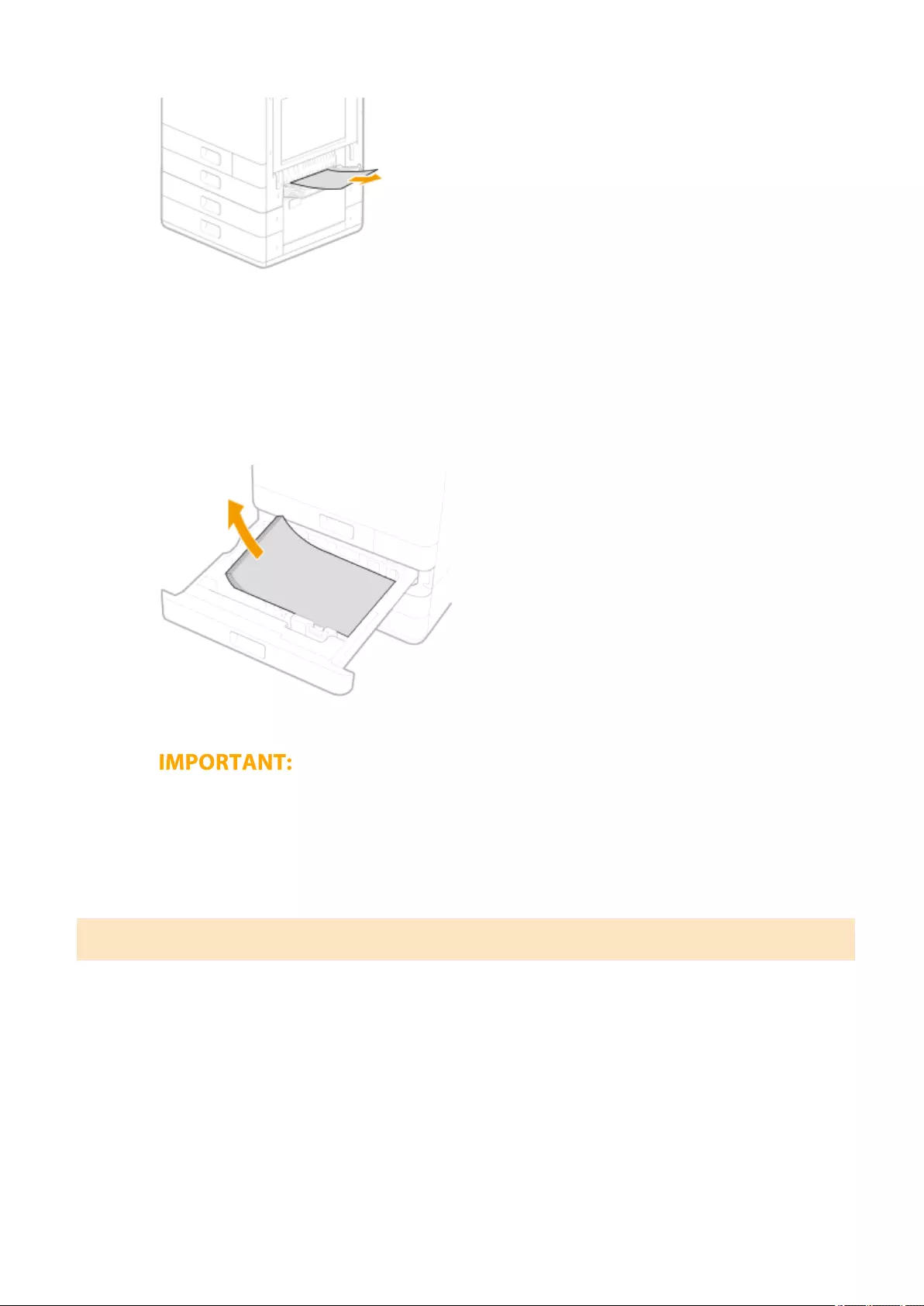
2If paper is jammed, gently pull it out in the direction of the arrow.
3Gently close the side cover of the standard paper drawer until it clicks.
2Check whether paper is jammed in the paper drawer 2.
1Open the paper drawer 2.
2If paper is jammed, gently pull it out in the direction of the arrow.
3Push the paper drawer 2 in until it clicks.
●When closing the paper drawer, be careful not to get your ngers caught, as this may result in
personal injury.
●Continue following the instructions on the screen to proceed with the interrupted operation or continue
clearing paper jams.
Clearing Paper Jams in Paper Drawers 3 and 4 (Optional)
1Check whether paper is jammed in the side cover of the cassette feeding unit.
1Open the side cover of the cassette feeding unit.
Frequently Asked Questions
697
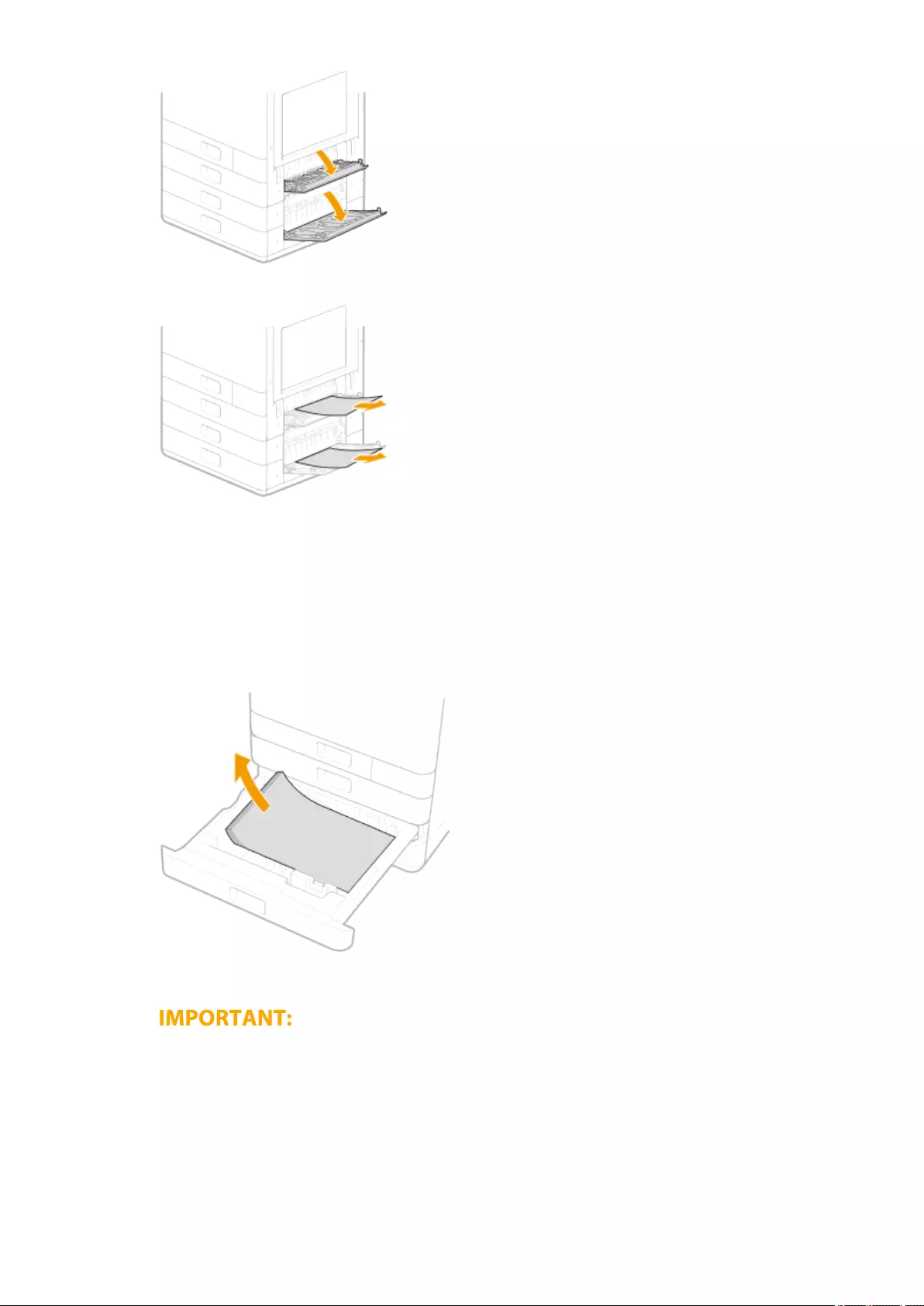
2If paper is jammed, gently pull it out in the direction of the arrow.
3Gently close the side cover of the cassette feeding unit it clicks.
2Check whether paper is jammed in the paper drawers 3 and 4.
1Open the paper drawer.
2If paper is jammed, gently pull it out in the direction of the arrow.
3Push the paper drawer in until it clicks.
●When closing the paper drawer, be careful not to get your ngers caught, as this may result in
personal injury.
●Continue following the instructions on the screen to proceed with the interrupted operation or continue
clearing paper jams.
Frequently Asked Questions
698
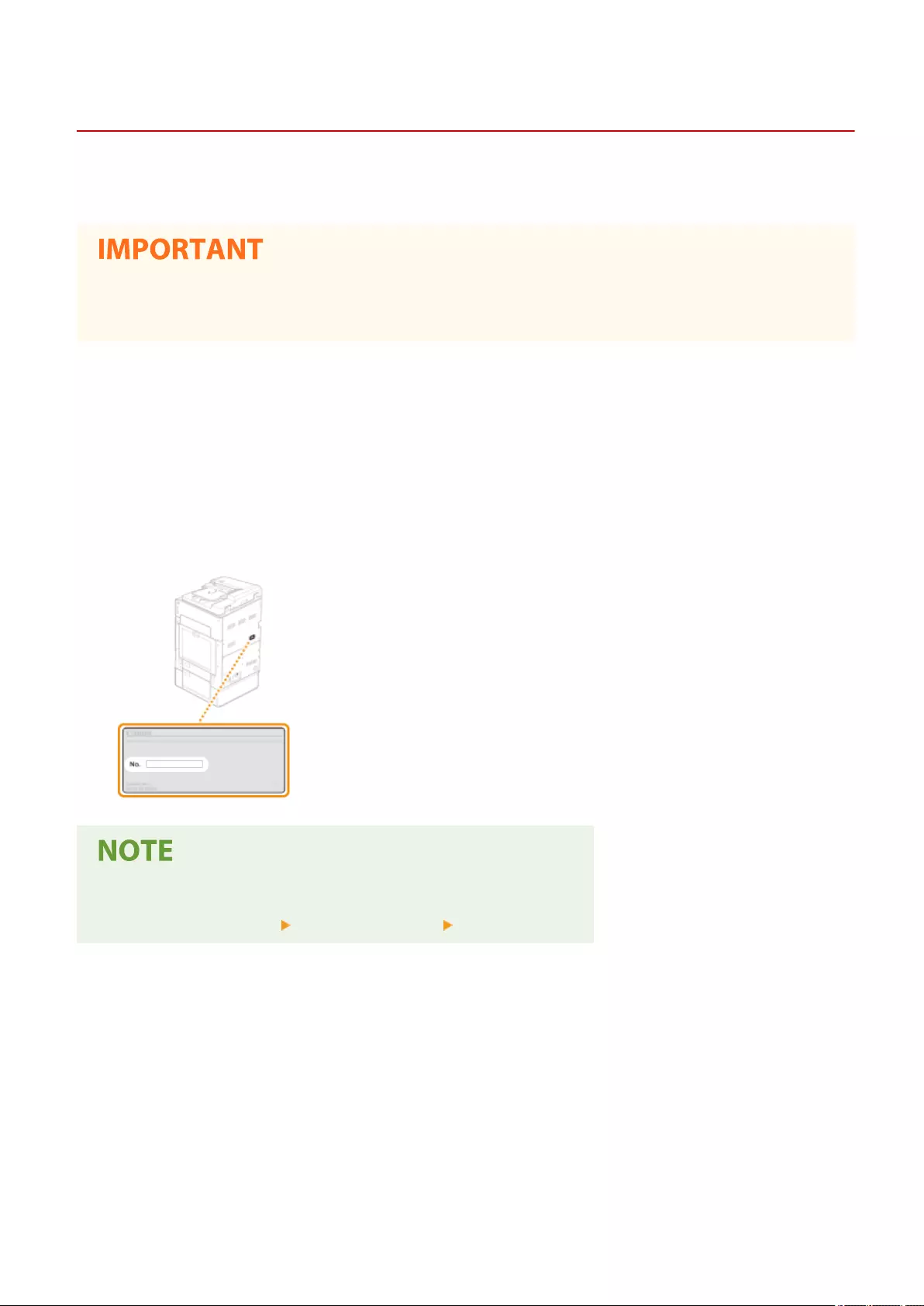
When a Problem Cannot Be Solved
2579-0AU
If you cannot solve a problem by referring to the information in this chapter, contact the Support page of the Canon
website or your nearest Canon service center.
Do not disassemble or repair the machine yourself
●If you disassemble or repair the machine yourself, it may not be covered by warranty.
◼When Contacting Canon
When contacting us, have the following information ready:
●Product name (WG7x50Z series / WG7x50F series / WG7x50 series / WG7x40 series)
●Dealer where you purchased the machine
●Details about your problem (such as what you did and what happened as a result)
●Serial number (found on the label on the back side of the machine)
Checking the serial number from the operation panel
●Select <Status Monitor> <Device Information> <Serial Number>.
Frequently Asked Questions
699

Appendix
Appendix ............................................................................................................................................................. 701
Third Party Software ......................................................................................................................................... 703
Feature Highlights ............................................................................................................................................ 704
Going Green and Saving Money ................................................................................................................... 705
Improving Eciency ..................................................................................................................................... 707
Going Digital ................................................................................................................................................ 709
So Much More .............................................................................................................................................. 711
Specications .................................................................................................................................................... 713
Printer .......................................................................................................................................................... 714
Scan .............................................................................................................................................................. 718
Copy ............................................................................................................................................................. 719
FAX ............................................................................................................................................................... 720
SEND ............................................................................................................................................................ 721
Network ....................................................................................................................................................... 722
Printing Solutions ......................................................................................................................................... 723
Other Specications ..................................................................................................................................... 724
Available Paper .................................................................................................................................................. 726
Options .............................................................................................................................................................. 731
Optional Equipment ..................................................................................................................................... 732
Manuals and Their Contents ............................................................................................................................. 733
Using Online Manual ......................................................................................................................................... 734
Screen Layout of Online Manual ................................................................................................................... 735
Viewing Online Manual ................................................................................................................................. 738
Basic Windows Operations ............................................................................................................................... 739
Notice ................................................................................................................................................................. 747
Appendix
700
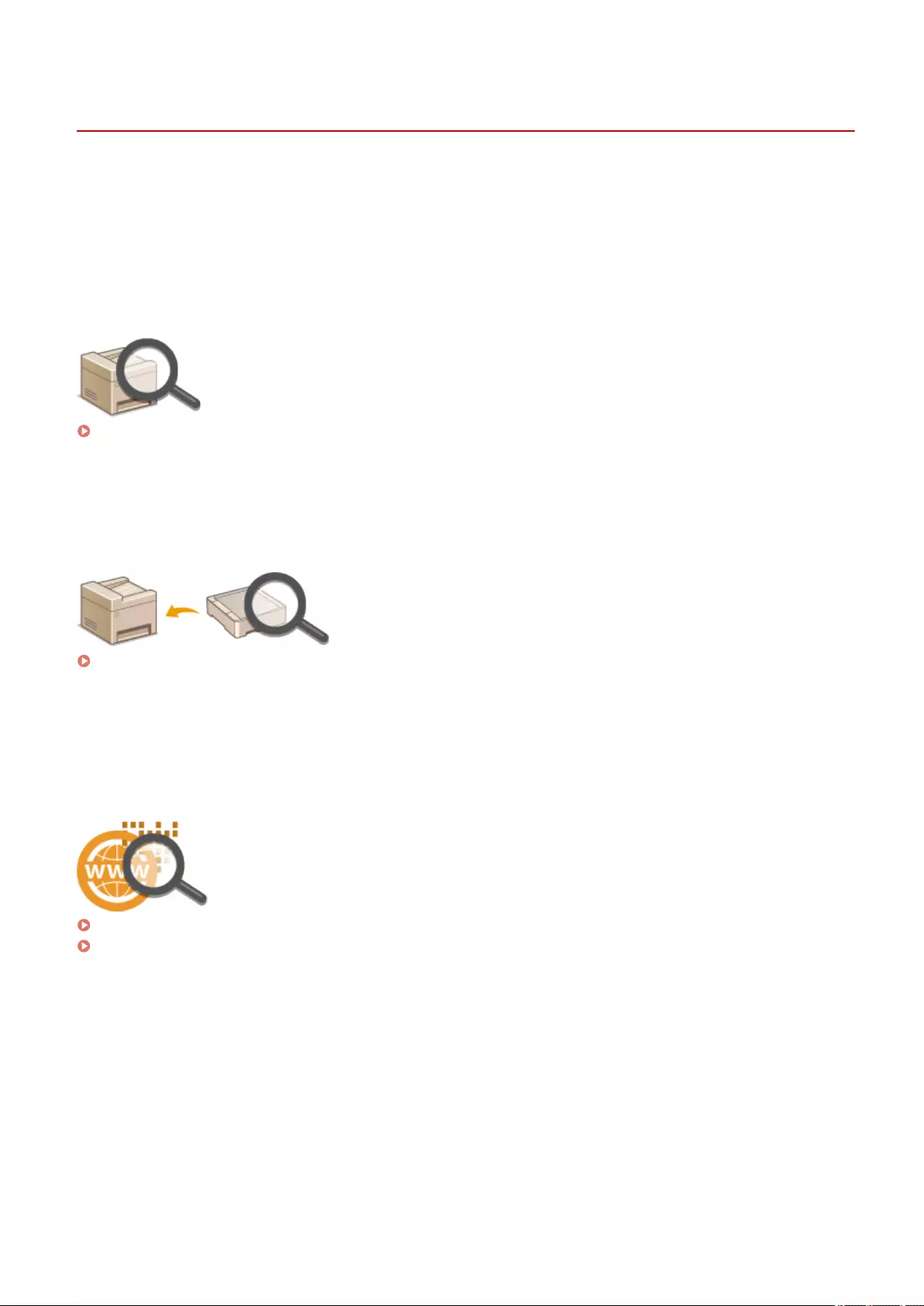
Appendix
2579-0J0
This chapter contains technical specications of this machine, instructions on how to use the Online Manual,
disclaimers, copyright information, and other important information for customers.
◼Machine Specications
See the following section(s) when you want to check the specications of the main unit and optional equipment,
network environment, print function, and so on.
Specications(P. 713)
◼Using Optional Equipment
See the following section(s) when you want to check what options are available to use this machine more conveniently
and more effectively.
Options(P. 731)
◼Referencing the Manual of This Machine
See the rst of the following sections when you want to be sure of the kinds of the manuals describing the functions of
the machine and how to operate the machine. When you want to know how to read and use the Online Manual (this
manual), see the second section.
Manuals and Their Contents(P. 733)
Using Online Manual(P. 734)
◼Others
See the following section(s) when you want to get useful information, and check the disclaimers and copyright
information.
Appendix
701

Third Party Software
2579-0AX
For information related to third-party software, click the following icon(s).
Appendix
703

Feature Highlights
2579-0AY
This section describes tips for leveraging the features of the machine by category. You can make use of the features
according to your intended purposes and operating environment.
Going Green and Saving Money(P. 705)
Improving Eciency(P. 707)
Going Digital(P. 709)
So Much More(P. 711)
Appendix
704
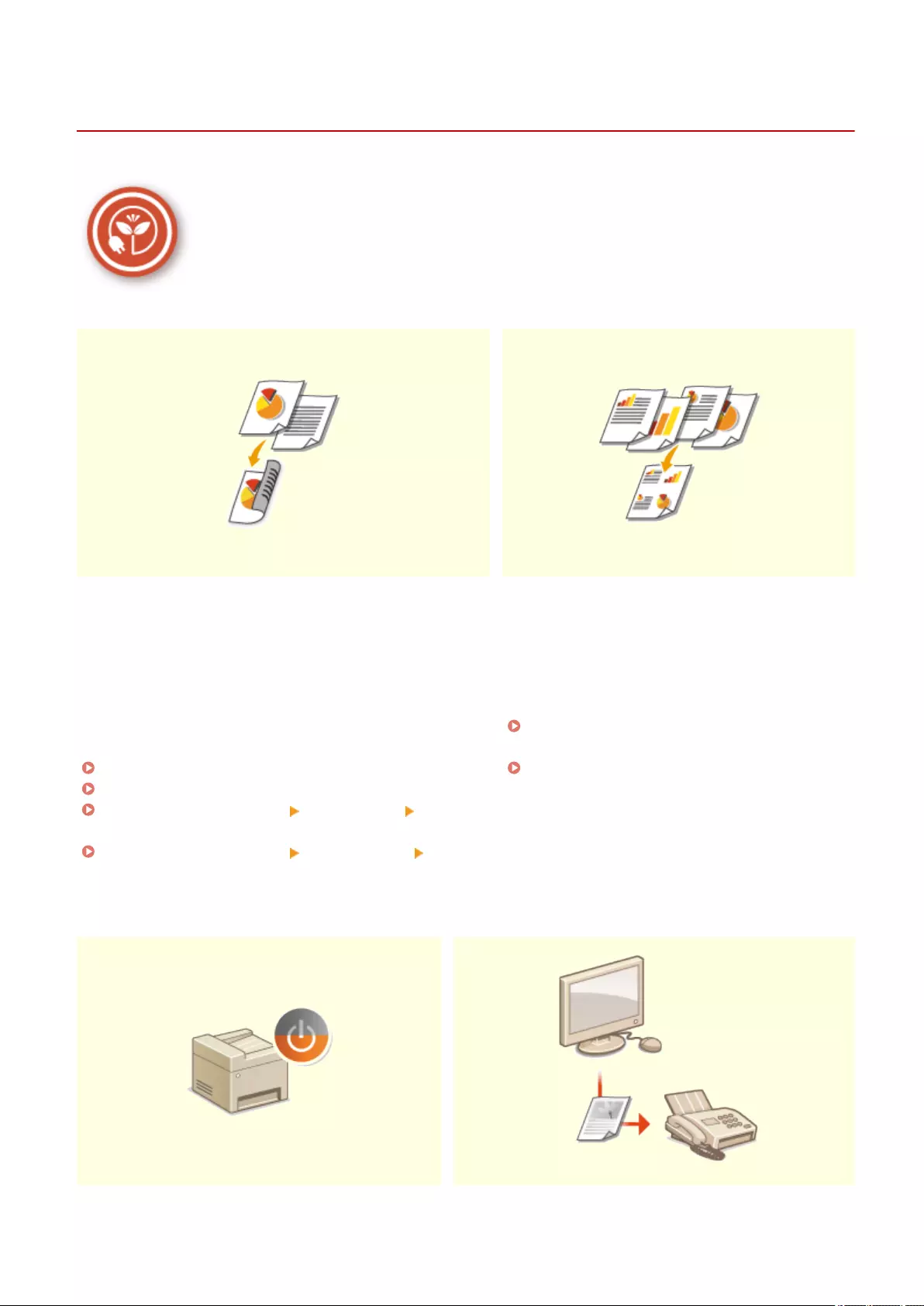
Going Green and Saving Money
2579-0C0
There are lots of ways to cut back on paper, ink, power, and expenses.
2-Sided Printing Print Multiple Pages on a Single Sheet
You can use 2-sided printing for copies, print jobs sent from
your computer, and even incoming faxes. Because you'll only
be using half the paper you would otherwise, you can cut
your paper costs in half. To save even more, combine 2-sided
printing with N on 1 printing of multiple pages on one sheet
of paper. You can print up to 32 pages on a single sheet,
which is both economical and environmentally friendly.
Basic Copy Operations(P. 194)
Printing from a Computer(P. 261)
<Receive/Forward>(P. 490) <Fax Settings> <Print on
Both Sides>
<Receive/Forward>(P. 490) <I-Fax Settings> <Print
on Both Sides>
To really start saving paper, shrink multiple pages
onto one side of a sheet - 2 or 4 pages for copies,
and up to 16 pages for print jobs sent from your
computer. This is even more effective when used
together with 2-sided printing.
Copying Multiple Documents onto One Sheet
(N on 1)(P. 209)
Printing from a Computer(P. 261)
Sleep Mode Paperless Faxing
Appendix
705

For saving energy and money, a sleep mode that
powers down a machine when nobody is using it has
become an essential feature. This machine will enter
sleep mode automatically, and can also be put to
sleep whenever you want. Press once to put the
machine to sleep. Press it again to instantly wake the
machine back into action.
Entering Sleep Mode(P. 179)
Assume you need paper to fax? Those old paper printouts
you always make are a thing of the past. Send documents
by fax just as they are, created on your computer. It's
paperless, so it's fast. And, received documents are rst
stored in memory, allowing you to print out only those
needed and eliminating worry about paper getting used on
direct mailings, etc.
Sending Faxes from Your Computer (PC Fax)(P. 247)
Saving Received Documents into the Machine
(Memory Reception)(P. 241)
Appendix
706
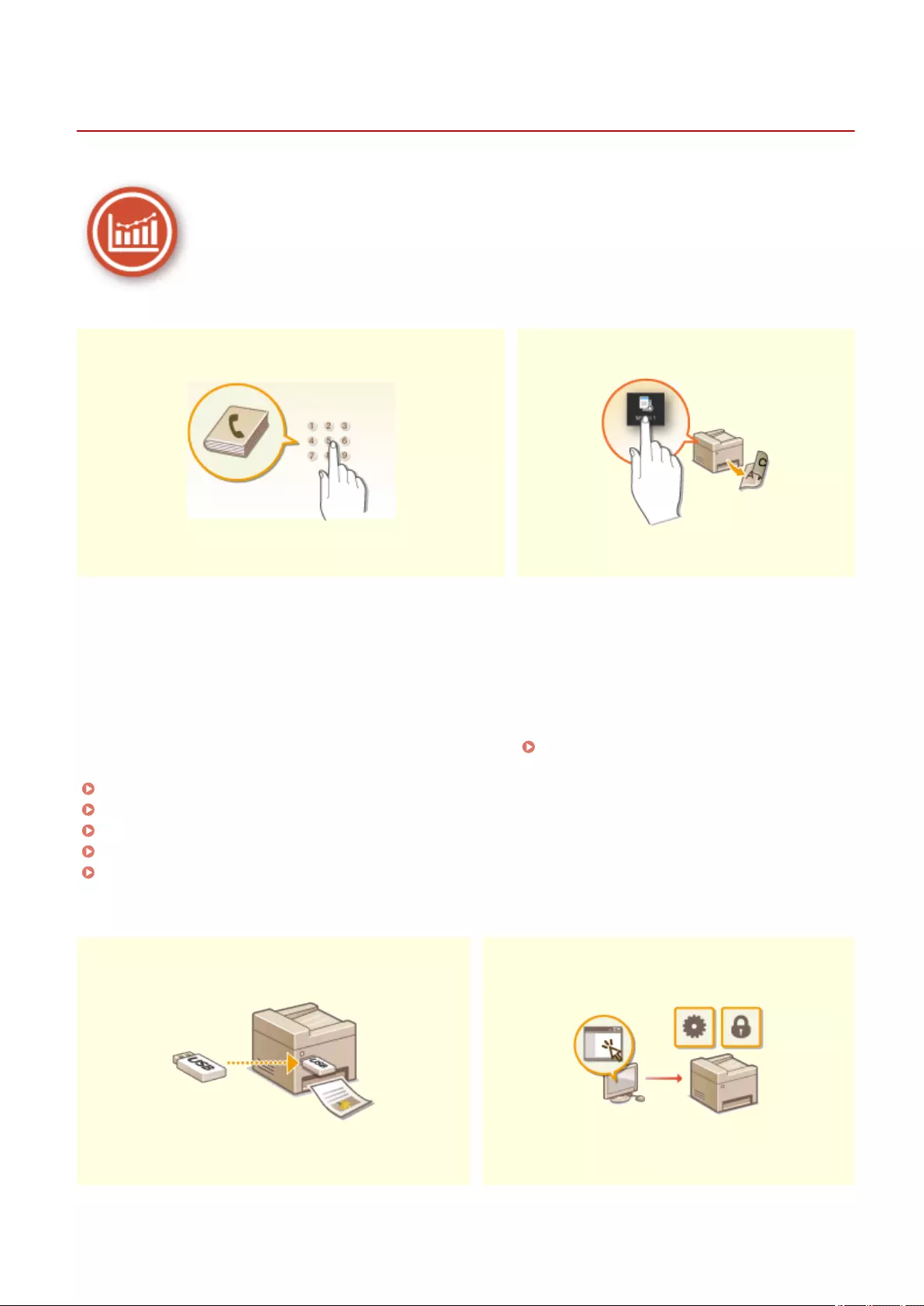
Improving Eciency
2579-0C1
Here are some simple operations that can make complicated tasks more ecient.
Address Book Frequently Used Settings in One Touch
Entering fax and e-mail addresses in the Address Book saves
you the inconvenience of entering them number-by-number,
letter-by-letter every time you have something to send. Display
the addresses you use most frequently with the <Favorites>
feature to quickly and easily send what you need to the people
who need it. You can save your Address Book data on your
computer and feel secure knowing that your important contact
information is backed up.
Registering Destinations(P. 181)
Registering Destinations from Remote UI(P. 419)
Basic Operations for Sending Faxes(P. 220)
Basic Operations for Scanning Originals(P. 286)
Importing/Exporting the Setting Data(P. 423)
Always making 2-sided copies. Always scanning in
the same format and to the same save
destination. Frequently used settings like these
can be registered to a single shortcut button. This
is convenient by allowing you to specify involved
operations all in a single touch.
Registering Frequently Used Settings(P. 173)
Print Images Right Off Your USB Memory Device Remote Management with Remote UI
Appendix
707
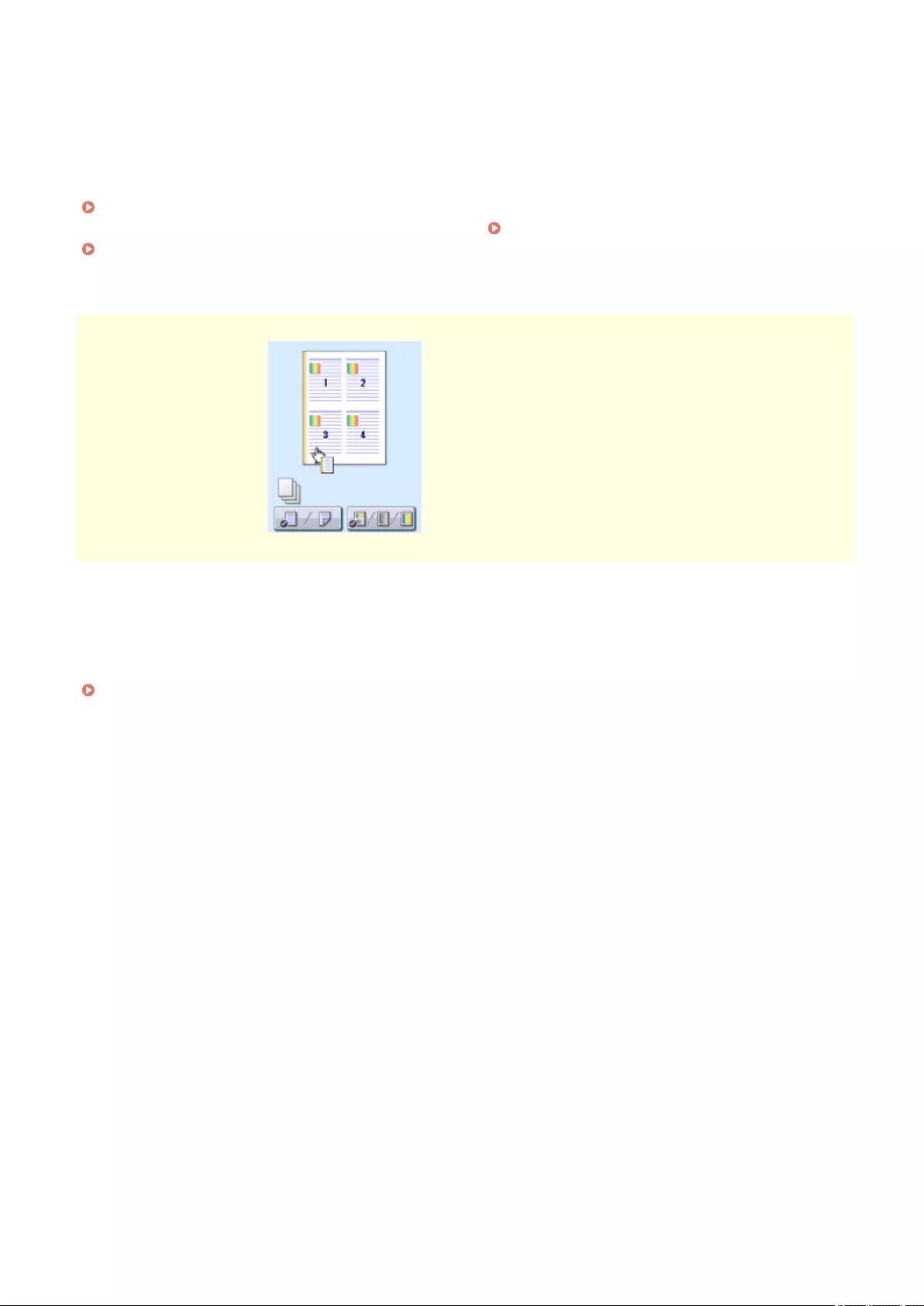
Plug a USB memory device into the machine and you can
print images and documents directly, without using a
computer. You can even preview JPEG and other images
before you print, so there is no wasted paper. You can also
scan handwritten memos, etc. and save them directly to a
USB memory device. Convenient for carrying about.
Printing from a USB Memory Device (Memory Media
Print)(P. 272)
Basic Operations for Scanning Originals(P. 286)
Remote UI lets you manage a lot from your computer,
all without having to go over to the machine. Congure
settings and keep an eye on the machine's status with
an intuitive, easy-to-understand Web browser interface
that you'll master immediately. Save your time and
energy for things other than taking care of the
machine.
Managing the Machine from a Computer (Remote
UI)(P. 407)
Make Print Settings Quickly with Intuitive Operation
You can easily specify the page layout as well as binding position, switching
between 1-sided and 2-sided printing, etc. intuitively on the preview image in
the printer driver. The simple click-operation allows you to conveniently make
settings while viewing how settings are applied.
Printing from a Computer(P. 261)
Appendix
708
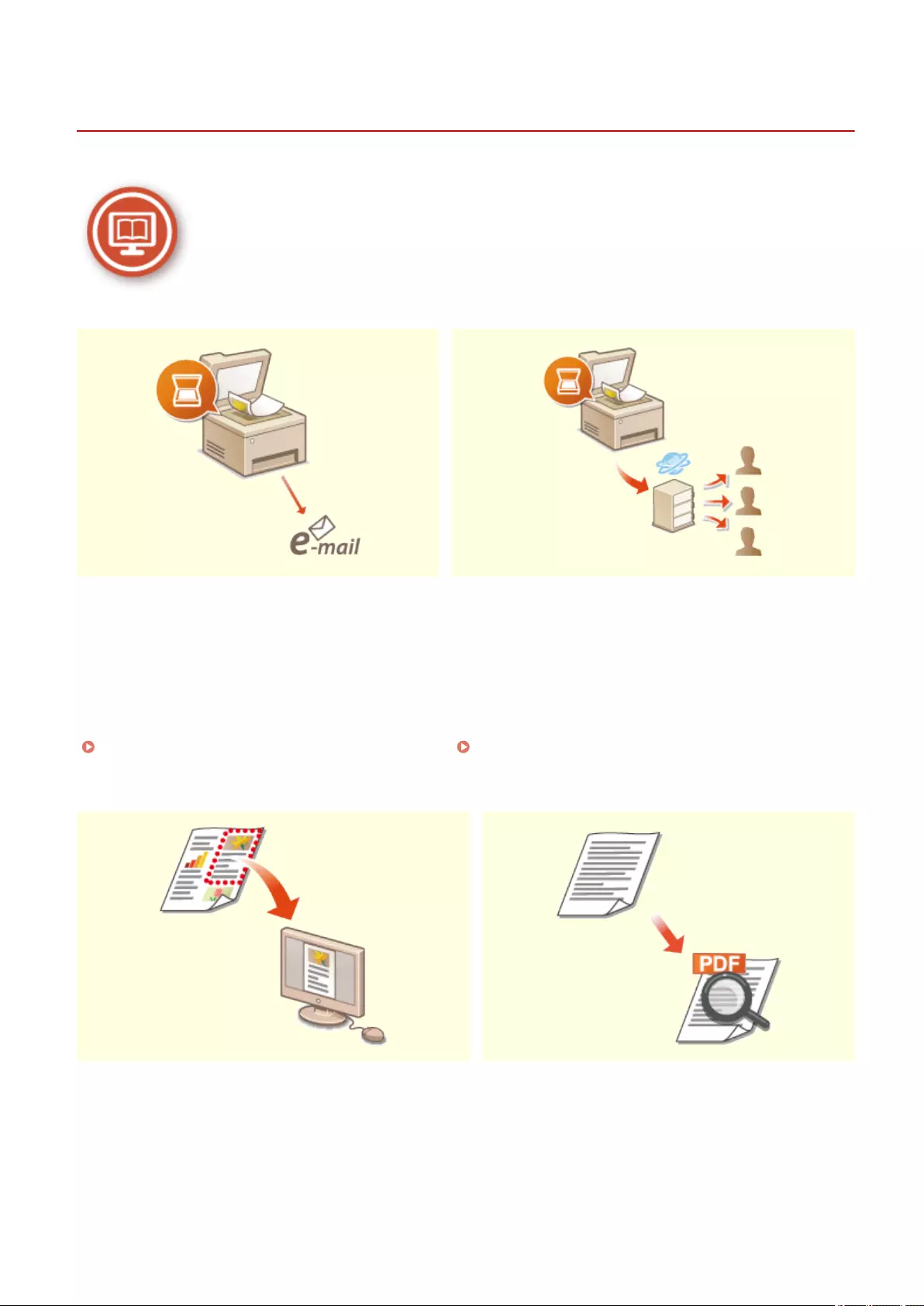
Going Digital
2579-0C2
Digitalizing a document enables editing using a computer as well as reducing cost and time by using e-mail.
Scan and E-Mail Scan and Share
E-mail scanned originals without even turning on
your computer. Just convert your scanned original
into an e-mail attachment right from the machine. If
you're one of those people who'd rather send a fax
than mess around with a computer, this feature is for
you.
Basic Operations for Scanning Originals(P. 286)
Say you've got a paper copy of a report for a company-wide
meeting. Scan it, convert it, and now everyone can see it.
It's saved directly in a shared folder on your network, so
there's no need to print out copies and pass them out. Once
you start talking about hundreds of pages of documents
that everyone needs, there's just no other way to go.
Basic Operations for Scanning Originals(P. 286)
Scan Only What You Need Searchable PDFs
Appendix
709
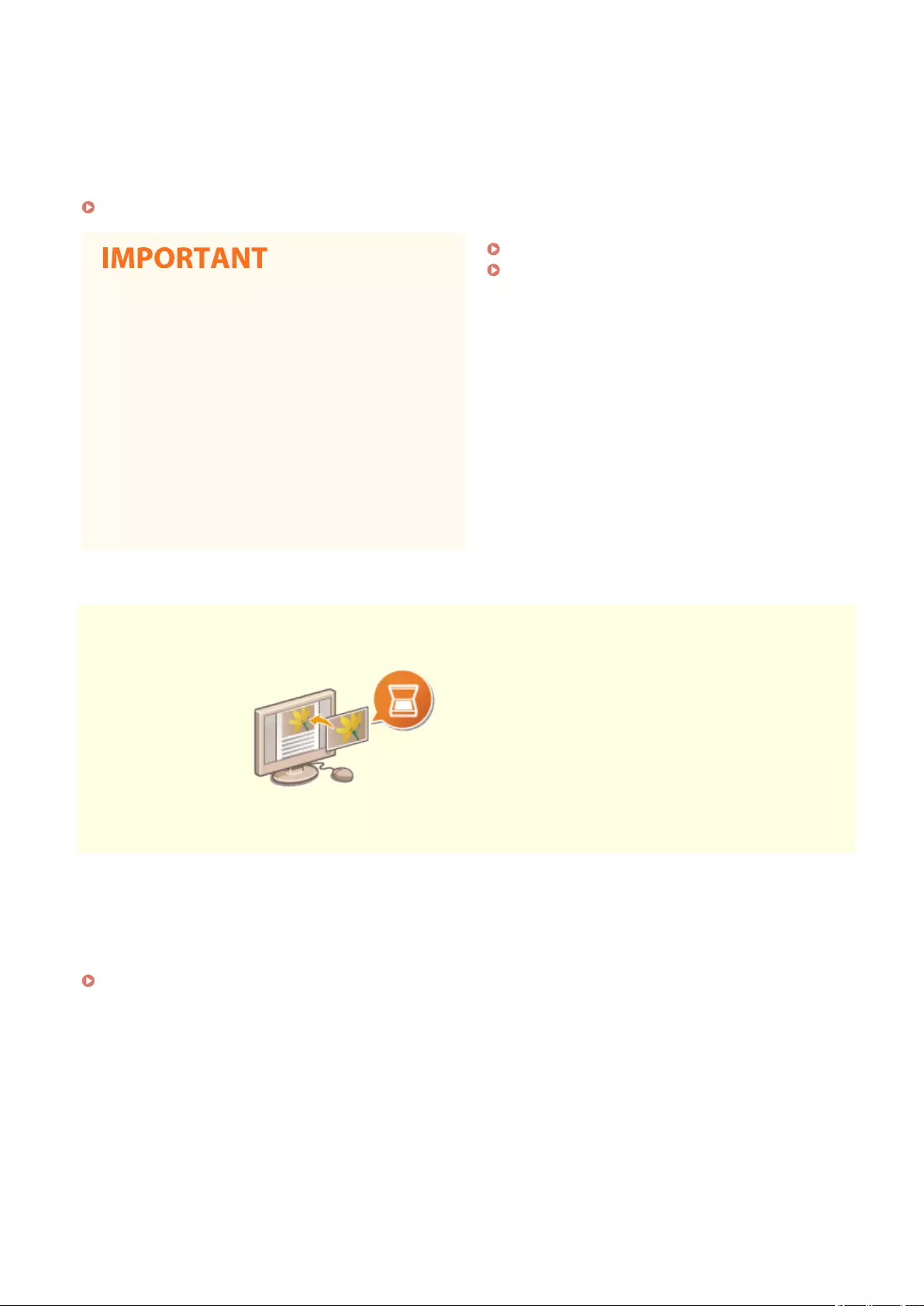
What if you're scanning a whole page of a newspaper but
all you're really interested in is a headline and a photo?
Use ScanGear WG. You can select what you want from a
preview, and then have the scanner disregard the rest.
Otherwise you'll have to use an editing program to crop
out everything you don't need.
Using ScanGear WG(P. 321)
●Using your product to scan, print or otherwise
reproduce certain documents, and the use of
such images as scanned, printed or otherwise
reproduced by your product, may be
prohibited by law and may result in criminal
and/or civil liability. If you are uncertain about
the legality of using your product to scan,
print or otherwise reproduce any particular
document, and/or of the use of the images
scanned, printed or otherwise reproduced,
you should consult in advance with your legal
advisor for guidance.
Searching of text in a PDF can be done with a
"searchable PDF." By scanning an original with both
text and images, text portions are converted by OCR
into text data. In addition to being able to search for
text information, you can also copy required portions
into an Excel spreadsheet or Word document in
Microsoft Oce. Eliminate the need to type in
customer data, addresses, etc. from scratch.
Basic Operations for Scanning Originals(P. 286)
Using Your Computer to Scan (Remote Scan)
(P. 318)
Add Images to a Work in Progress
Some applications work with the machine to let you easily import scanned
images directly into documents you're working on. This way you can skip the
steps of opening a separate application just for receiving the scanned images
and then exporting them to the application you're really using.
Scanning Documents from an Application(P. 319)
Appendix
710
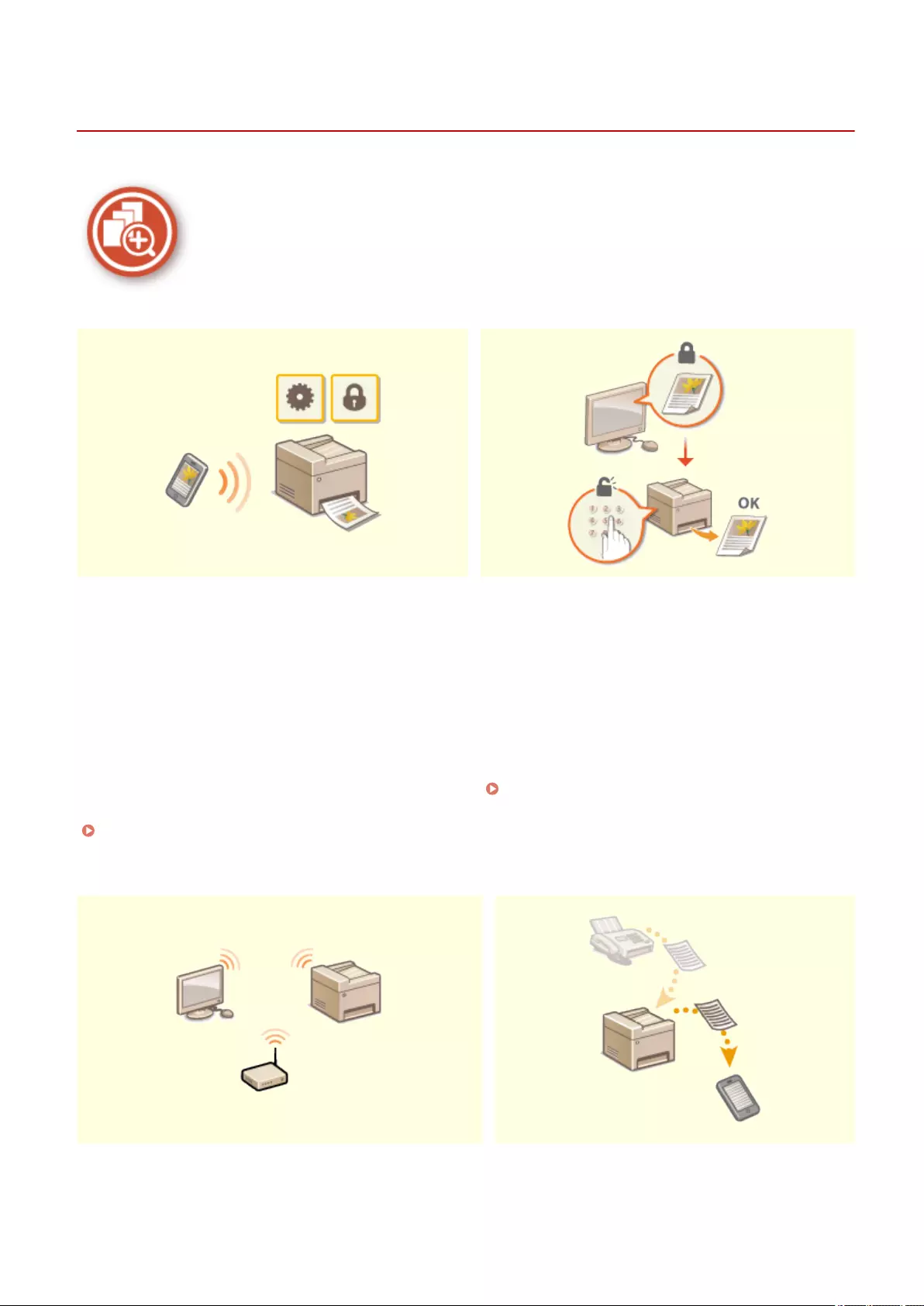
So Much More
2579-0C3
There are a variety of features for whatever you need to do - at home, in the oce, or even on the road.
Using a smartphone/tablet Keep Your Printouts Private
At times such as when you want to quickly print out a
proposal you completed on a tablet while travelling to a
business destination, or scan materials handed out at a
meeting using a smartphone, Canon Print Business comes
in handy. Even in environments without a wireless LAN
router, you can connect to the machine with a mobile
device wirelessly and directly.
PCless, quick, and easy! An even broader range of
possibilities for work/play with functionality made for this
age of speed.
Linking with Mobile Devices(P. 328)
Normally, when you print something from your
computer, it comes out of the printer right away.
However, if you have sensitive documents, this may not
be what you want. Just use secure printing and no one
will be able to print your documents without entering
your password on the machine's operation panel. Don't
let your condential documents lie exposed on the tray
for everyone to see.
Printing a Document Secured by a PIN (Secure
Print)(P. 268)
Go Wireless Get Faxes Wherever You Go
Appendix
711

No cables, easy installation, simple maintenance. If you've
got a WPS wireless LAN router, bypass the settings process
altogether and be ready to go before you know it. Enjoy the
kind of clutter-free and easy to use document system that
you can only get from wireless. Compatible with IEEE
802.11b/g/n for stress-free wireless, and also supports WEP
and WPA/WPA2-PSK (TKIP/AES-CCMP) for tighter security.
Connecting to a Wireless LAN(P. 21)
Never worry about missing a fax when you're out of
the oce. Set a forwarding destination and any fax
that comes in on the machine will go right to you.
Better yet, make the forwarding destination the e-
mail address for your tablet or mobile.
Forwarding the Received Documents
Automatically(P. 243)
Appendix
712

Specications
2579-0C4
Specications are subject to change without notice for product improvement or future release.
◼Functional / Machine Specications
Printer(P. 714)
Scan(P. 718)
Copy(P. 719)
FAX(P. 720)
SEND(P. 721)
Network(P. 722)
Printing Solutions(P. 723)
Other Specications(P. 724)
◼Available Paper
Available Paper(P. 726)
◼Optional Equipment
Cassette Feeding Unit CF10 (Cassette 3, 4)(P. 732)
Appendix
713

Printer
2579-0JR
WG7x50Z series WG7x50F series WG7x50 series WG7x40 series
Maximum Printing Resolution 1200 x 1200 dpi
Print Head / Ink Type Line Head w/FINE Technology
Ink Tank Black / Cyan / Magenta / Yellow
Print Speed Document : Col, B/W
*1
Simplex, General
Mode (600 dpi),
Cassette 1
Up to 50 ppm
Up to 40 ppm
Document : Col ,
B/W*2
Simplex, Oce
Document Mode
(300 dpi), Cassette 1
Up to 80 ppm
Up to 70 ppm
Document : Col, B/W
*1
Duplex, General
Mode (600 dpi),
Cassette 1
Up to 25 ppm Up to 20 ppm
Document : Col, B/W
*3
FPOT Ready/
simplex, Cassette 1
Approx. 6.5 sec
Maximum Media Size (W x L) Cassette : 297 x 431.8 mm (11.7" x 17")
Multi-Purpose Tray : 330.2 mm x 482.6 mm (13" x 19")*4
Supported Media Size
* Depending on area, custom size specication is
different. Please refer above "Maximum Media Size".
A5, A4, A3, B5, B4, Statement , Executive, Letter, Legal, 11 x 17, 12 x 18,
SRA3, 13 x 19, K8, K16, Foolscap / Folio, Ocio, G-Letter, A-Letter, G-
Legal, A-Foolscap, B-Ocio, M-Ocio, E-Ocio, A-Ocio, F4A, FS (Indian
Legal), 4 x 6", 5 x 7", 8 x 10", 10 x 12", 13 x 19", COM10, Monarch, ISO-
C5, DL, Custom size (Up to 13 " x 28 " or 13 " x 19 " / 330.2 mm x 711.2
mm or 330.2 mm x 482.6 mm)
Printing Margin Bordered Printing
Bordered Auto
Duplex Printing
Top, Bottom, Left, Right : 0.16 " (4 mm) each *5
Appendix
714
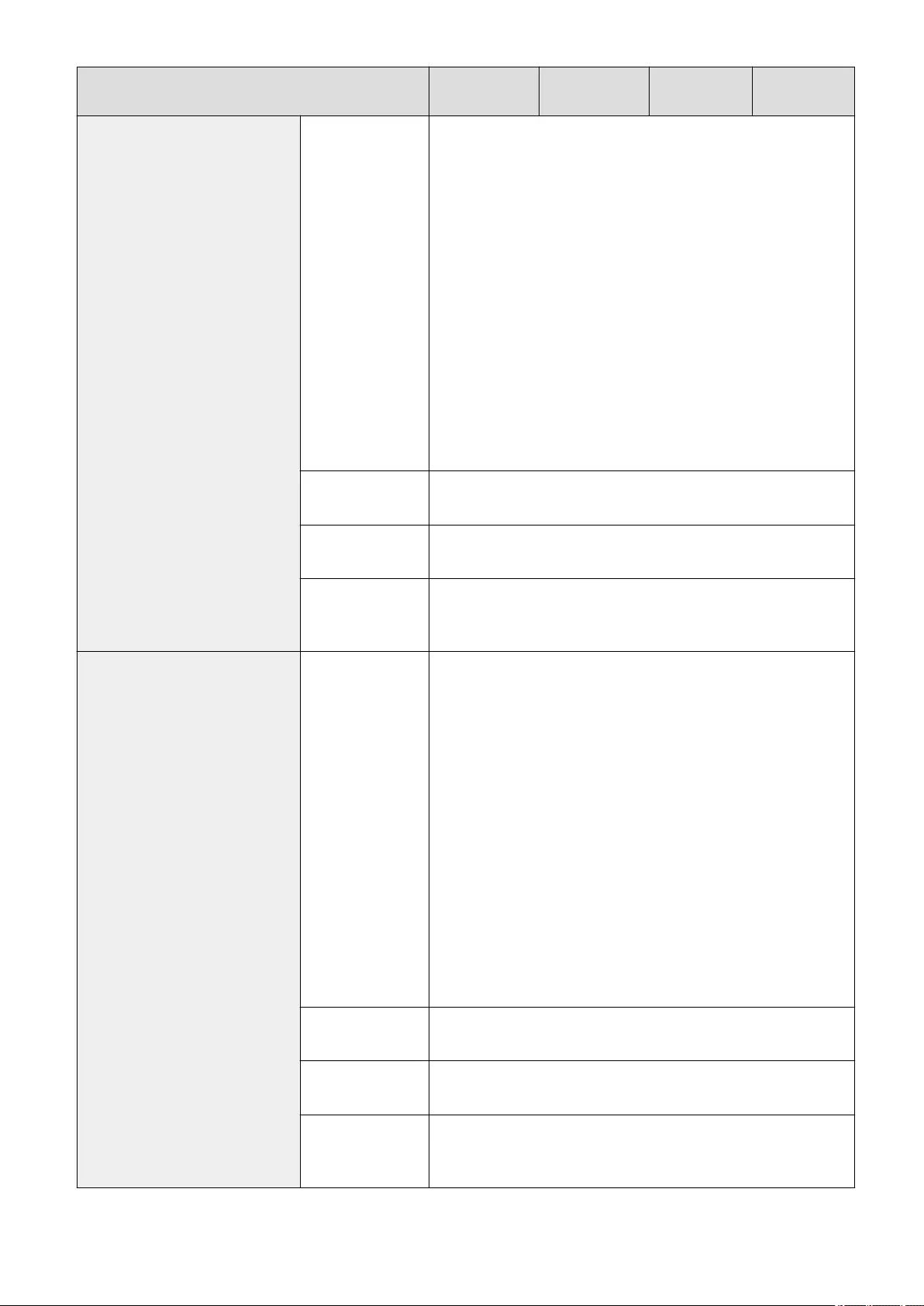
WG7x50Z series WG7x50F series WG7x50 series WG7x40 series
Supported Media Type and Size
per Cassette
-Cassette 1:
Thin Paper (14 to 16
lb bond / 52-63
g/m²)
Plain Paper (17 to 28
lb bond / 64-105
g/m²)
Thick Paper (29 to
80 lb bond / 106-220
g/m²)
Colored Paper (17 to
21 lb bond / 64-82
g/m²)
Recycled Paper (17
to 28 lb bond /
64-105 g/m²)
Bond Paper (22 to
26 lb bond / 83-99
g/m²)
A5, A4, B5, Statement, Executive, Letter, K16, G-Letter
Envelop (20 to 28 lb
bond / 75-105 g/m²)
COM10, Monarch, ISO-C5, DL
Canon Matte Photo
Paper
Not Available
Label (31 to 68 lb
bond / 118-185
g/m²)
Not Available
Supported Media Type and Size
per Cassette
-Cassette 2, 3:
Thin Paper (14 to 16
lb bond / 52-63
g/m²)
Plain Paper (17 to 28
lb bond / 64-105
g/m²)
Thick Paper (29 to
80 lb bond / 106-220
g/m²)
Colored Paper (17 to
21 lb bond / 64-82
g/m²)
Recycled Paper (17
to 28 lb bond /
64-105 g/m²)
Bond Paper (22 to
26 lb bond / 83-99
g/m²)
A5, A4, A3, B5, B4, Statement , Executive, Letter, Legal, 11 x 17, K16, K8,
Foolscap / Folio, Ocio, G-Letter, A-Letter, G-Legal, A-Foolscap, B-
Ocio, M-Ocio, E-Ocio, A-Ocio, F4A, FS (Indian Legal)
Envelop (20 to 28 lb
bond / 75-105 g/m²)
Not Available
Canon Matte Photo
Paper
Not Available
Label (31 to 68 lb
bond / 118-185
g/m²)
Not Available
Appendix
715
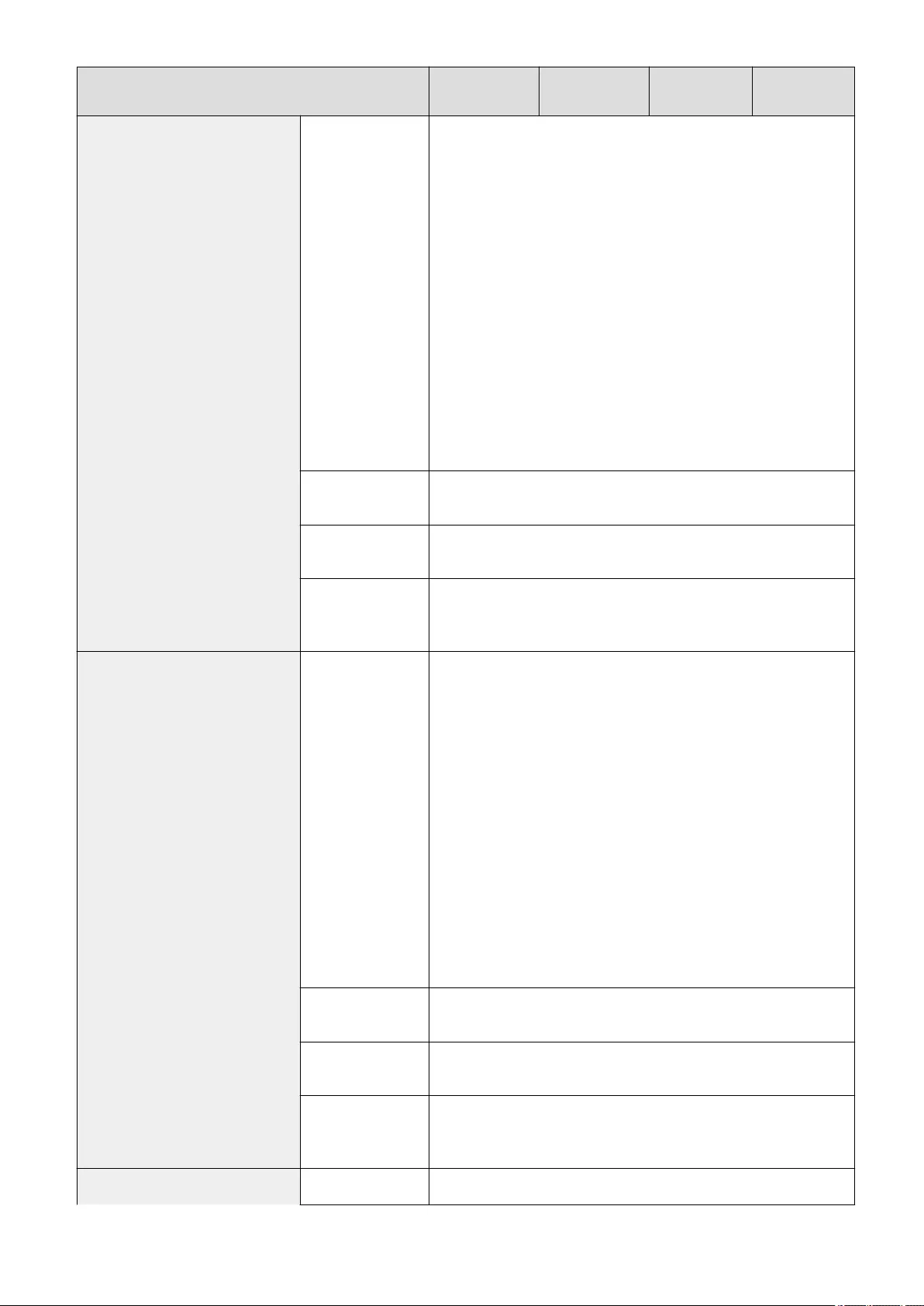
WG7x50Z series WG7x50F series WG7x50 series WG7x40 series
Supported Media Type and Size
per Cassette
-Cassette 4:
* Cassette 2 & 3 support
Thick Paper (29 to 80 lb bond /
106-220 g/m²) but cassette 4
supports 29 to 60 lb bond / 106-163
g/m² only
Thin Paper (14 to 16
lb bond / 52-63
g/m²)
Plain Paper (17 to 28
lb bond / 64-105
g/m²)
Thick Paper (29 to
60 lb bond / 106-163
g/m²)
Colored Paper (17 to
21 lb bond / 64-82
g/m²)
Recycled Paper (17
to 28 lb bond /
64-105 g/m²)
Bond Paper (22 to
26 lb bond / 83-99
g/m²)
A5, A4, A3, B5, B4, Statement , Executive, Letter, Legal, 11 x 17, K16, K8,
Foolscap / Folio, Ocio, G-Letter, A-Letter, G-Legal, A-Foolscap, B-
Ocio, M-Ocio, E-Ocio, A-Ocio, F4A, FS (Indian Legal)
Envelop (20 to 28 lb
bond / 75-105 g/m²)
Not Available
Canon Matte Photo
Paper
Not Available
Label (31 to 68 lb
bond / 118-185
g/m²)
Not Available
Supported Media Type and Size
-Multi-Purpose Tray:
Thin Paper (16 lb
bond / 60-63 g/m²)
Plain Paper (17 to 28
lb bond / 64-105
g/m²)
Thick Paper (29 lb
bond to 95 lb cover /
106-256 g/m²)
Colored Paper (17 to
21 lb bond / 64-82
g/m²)
Recycled Paper (17
to 28 lb bond /
64-105 g/m²)
Bond Paper (22 to
26 lb bond / 83-99
g/m²)
A5, A4, A3, B5, B4, Statement , Executive, Letter, Legal, 11 x 17, 12 x 18,
SRA3, 13 x 19, K16, K8, Foolscap / Folio, Ocio, G-Letter, A-Letter, G-
Legal, A-Foolscap, B-Ocio, M-Ocio, E-Ocio, A-Ocio, F4A, FS (Indian
Legal), 4 x 6
Envelop (20 to 28 lb
bond / 75-105 g/m²)
COM10, Monarch, ISO-C5, DL
Canon Matte Photo
Paper
4 x 6", 5 x 7", 8 x 10", 10 x 12", A4/LTR, A3, 13 x 19"
Label (31 to 68 lb
bond / 118-185
g/m²)
A4, B4, Letter
Paper Cassette Capacity (80 g/m² )Cassette 1, 2, 3, 4 550 sheets each
Appendix
716
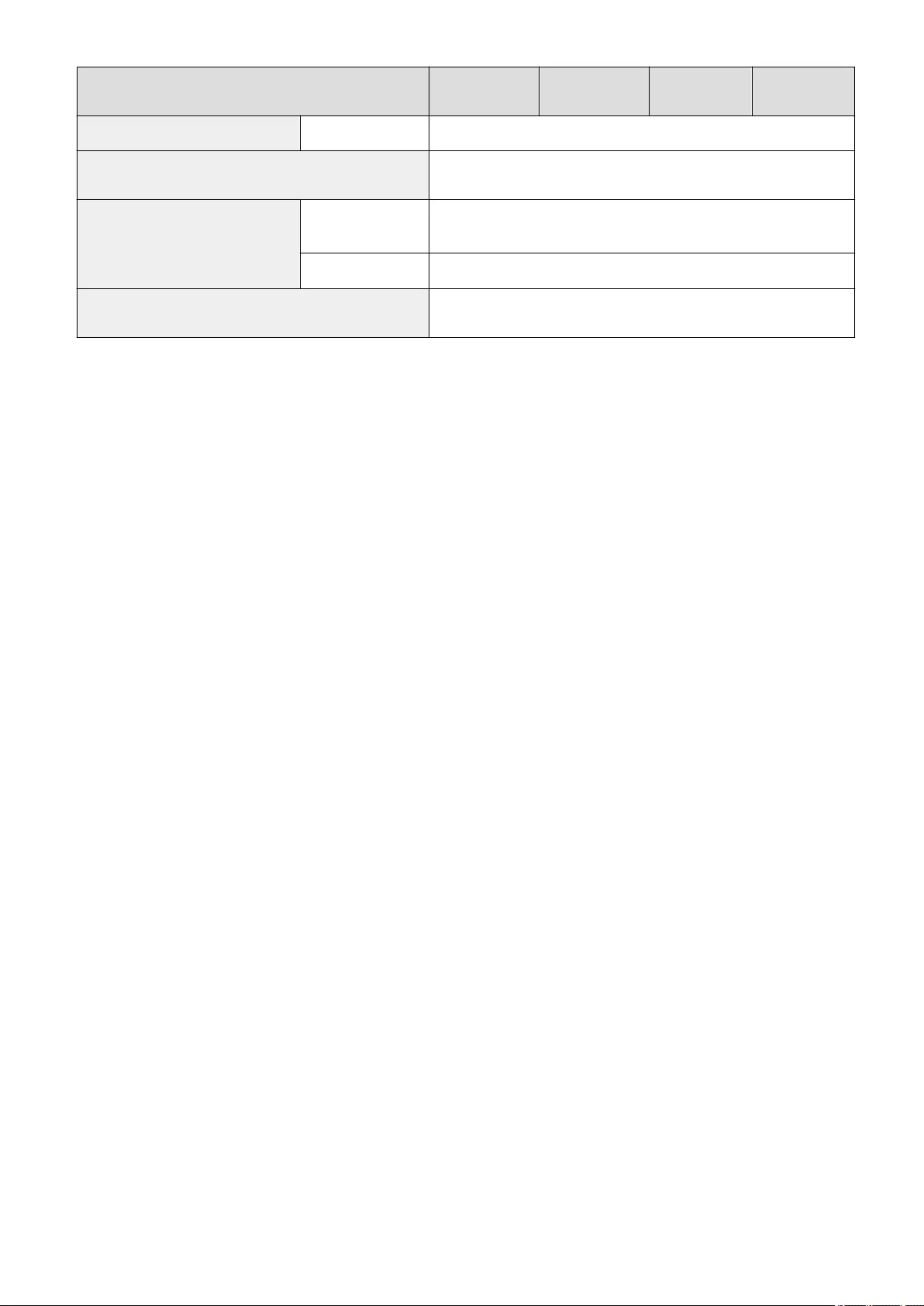
WG7x50Z series WG7x50F series WG7x50 series WG7x40 series
Multi-Purpose Tray 50 sheets
Maximum Output Tray Capacity (80 g/m² )A3: 100 sheets, A4/LTR: 250 sheets
Supported Media Type for Double
Side Printing Type Thin Paper, Thick Paper, Plain Paper, Colored Paper, Recycled Paper,
Bond Paper
Size / Weight A5 - 12 x 18", 14 lb bond to 80 lb cover (52-220 g/m²)
Print Head Alignment Automatic Adjustment
*1 Print Speed is based on ISO/IEC 24734. Measured in default mode (General Mode: 600 dpi) and calculated by Canon
original methodology. Print speed varies depending on system conguration, interface, software, content of document,
print mode, media type, weight and used cassette etc.
*2Print Speed is based on ISO/IEC 24734. Measured in fast mode (Oce Document Mode: 300 dpi) and calculated by
Canon original methodology. Print speed varies depending on system conguration, interface, software, content of
document, print mode, media type, weight and used cassette etc.
*3 Print Speed (FPOT) is based on ISO/IEC 17629. Print speed varies depending on system conguration, interface,
software, content of document, print mode, media type, weight and used cassette etc.
*4 With Custom setting, cassette 1 supports 3.5 " x 7.5 " to 8.5 " x 11.7 " (90.0 x 190.0 mm to 216.0 x 297.0 mm). Cassette
2, 3 and 4 supports 5.5 " x 8.3 " to 11.7 " x 17.0 " (139.7 x 210.0 mm to 297.0 x 431.8 mm). Multi-Purpose Tray supports 13
" x 19 " or 13 " x 28 " (330.2 mm x 482.6 mm or 330.2 mm x 711.2 mm) depending on your country or region.
*5Depending on the driver software, this margin varies.
Appendix
717
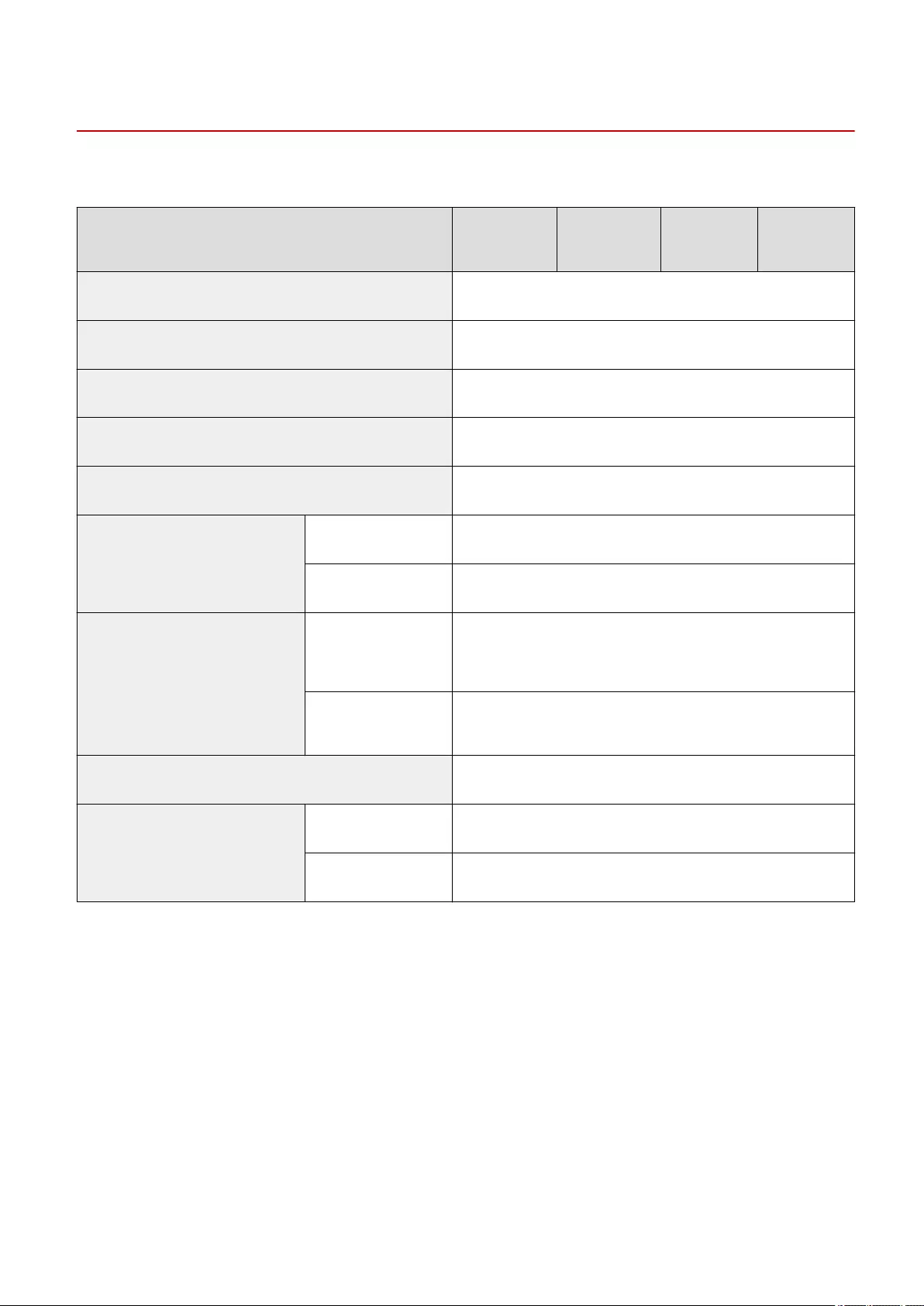
Scan
2579-0JS
TWAIN driver (ScanGear) is based on TWAIN Specications V 1.6.
WG7x50Z
series
WG7x50F
series
WG7x50
series
WG7x40
series
Scanner Type Flatbed & ADF
Scanner Sensor CIS x 2 sensors
Duplex Scanning Available (Single Pass)
Optical Resolution *1 600 x 600 dpi
Maximum Resolution *2 9600 x 9600 dpi
Scanning Bit Depth (Input /
Output)
Grayscale 10bit / 8bit
Color 30bit / 24bit (RGB10bit / 8bit each)
Scanning Speed *3 Document(ADF) :
Simplex Col, Simplex
B/W
Approx. 40 ipm
Document(ADF) :
Duplex Col, Duplex B/W Approx. 65 ipm
Maximum Paper Capacity (80 g/m 2 )100 sheets
Maximum Document Size Flatbed A3 / 11" x 17"
ADF A3 / 11" x 17"
*1 Optical Resolution is based on ISO/IEC 14473. This is the maximum sampling rate when scanning the original.
*2 When scanning in high resolution, scanning area size may be limited.
*3Average copy time from ADF. Set the original on ADF and measure time from pushing the scanning button to output
the copied paper.
Appendix
718
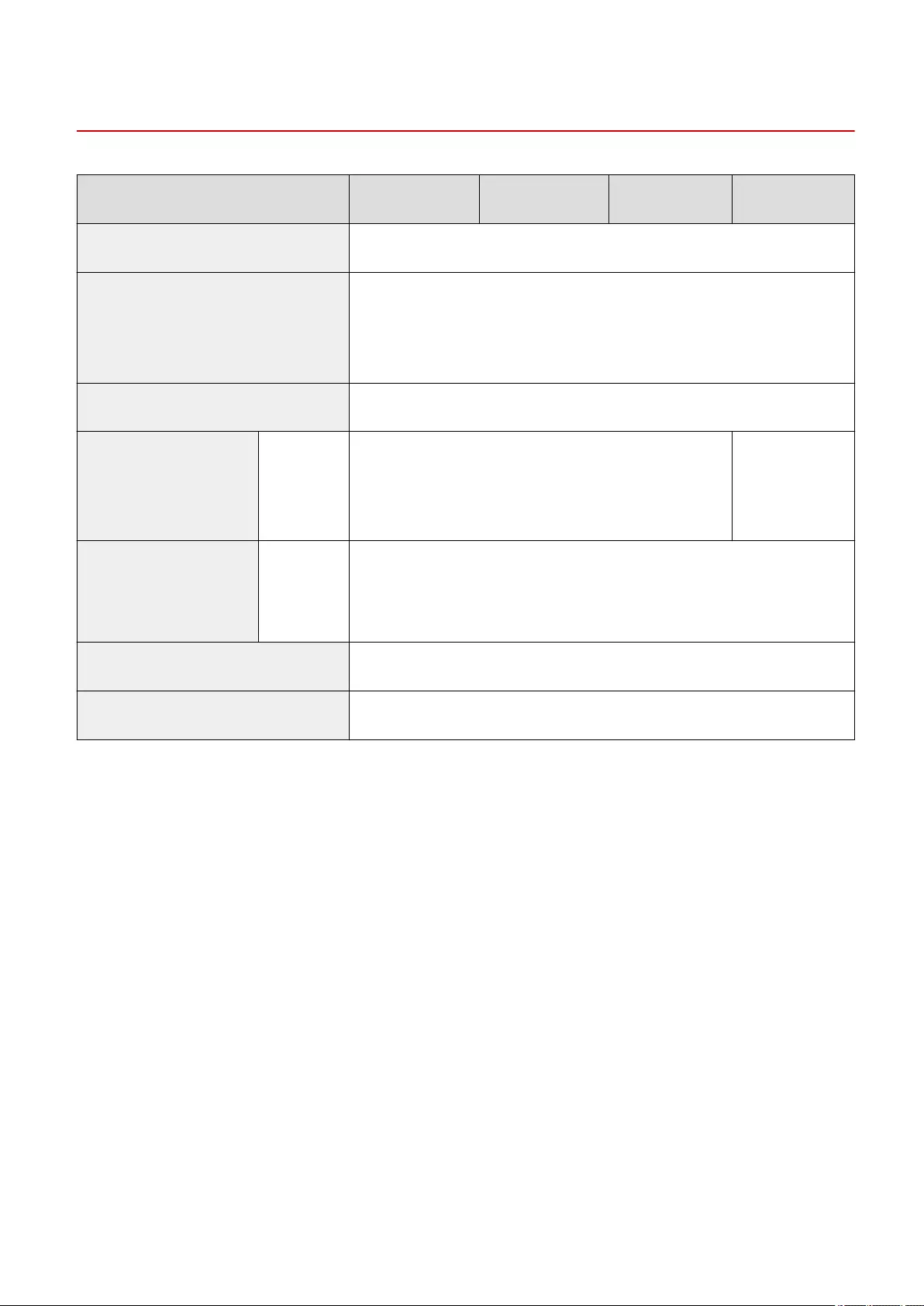
Copy
2579-0JU
WG7x50Z series WG7x50F series WG7x50 series WG7x40 series
Maximum Document Size A3 / 11" x 17"
Supported Media Size A5, A4, A3, B5, B4, Statement, Executive, Letter, Legal, 11 x 17, 12 x 18, SRA3, 13 x 19,
K8, K16, Foolscap/Folio, Ocio, G-Letter, A-Letter, G-Legal, A-Foolscap, B-Ocio, M-
Ocio, E-Ocio, A-Ocio, F4A, FS(Indian Legal), 4x6", 5x7", 8x10", 10x12", 13 x 19",
COM10, Monarch, ISO-C5, DL, Custom size (Up to 13 " x 28 " or 13 " x 19 " / 330.2
mm x 711.2 mm or 330.2 mm x 482.6 mm)
Copy Exposure 9 Levels
Copy Speed *1 Document
(A4/LTR)
Canon Oiginal
Method/
Simplex
50 ppm (Col, B/W) 40 ppm (Col, B/W)
First-Copy-Out Time *2 Document :
Color
sFCOT/
Simplex
Approx. 5.8 sec
Magnication 25-400 % (1 % Increments)
Multiple Copy Up to 999 copies
*1 Copy Speed is based on Canon original Method. With Canon original chart, execute the continuous copy and calculate
copy pages per minute.
*2 First-Copy-Out Time is based on ISO/IEC 29183.
Appendix
719
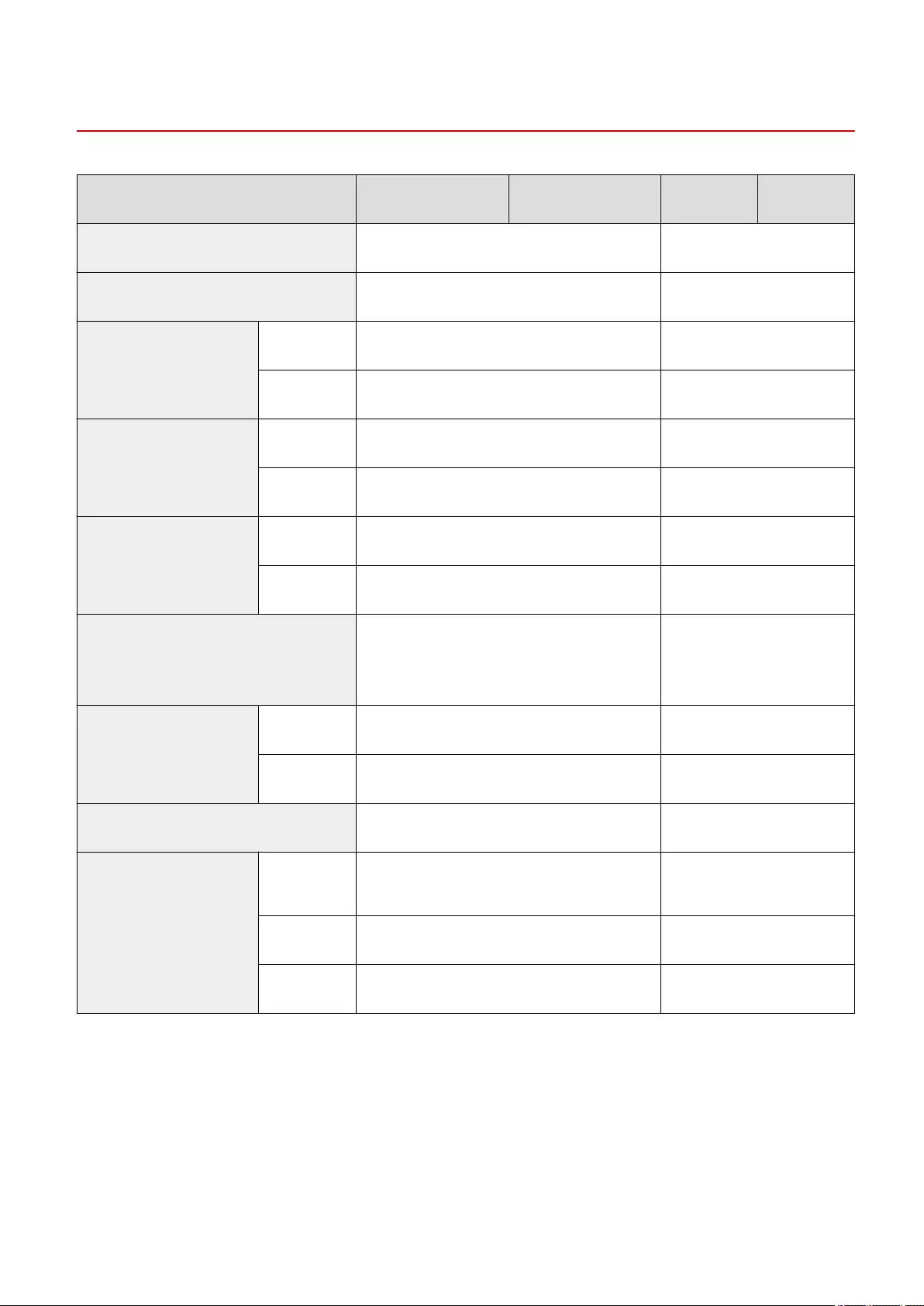
FAX
2579-0JW
WG7x50Z series WG7x50F series WG7x50 series WG7x40 series
Applicable Line PSTN (Public Switched Telephone Network) NOT Available
Modem Speed Super G3 (Up to 33.6 Kbps) / G3 (Up to 14.4 Kbps) NOT Available
Transmission Speed B/W Approx. 3 sec/page (33.6 kbps) NOT Available
Color Not Available NOT Available
Compression Method *1 B/W MH, MR, MMR, JBIG NOT Available
Color Not Available NOT Available
Gradation Black 256 Levels NOT Available
Color Not Available NOT Available
Fax Resolution 8 dots/mm x 3.85 lines/mm (Standard)
8 dots/mm x 7.7 lines/mm (Fine)
8 dots/mm x 15.4 lines/mm (Super Fine)
16 dots/mm x 15.4 lines/mm (Ultra Fine)
NOT Available
Media Size Send 11 x 17, LGL, LTR, STMT, A3, B4, A4, B5, A5 NOT Available
Print 11 x 17, LGL, LTR, STMT, A3, B4, A4, B5, A5, 8K, 16K NOT Available
Fax Memory *2 Up to 512 pages NOT Available
Automatic Dialing One-touch
Dialing Up to 19 (Best Member) NOT Available
Coded Dialing Up to 281 NOT Available
Group Dialing Up to 199 NOT Available
*1 Data transfer speed is measured in default mode with Canon original FAX testing chart. Actual speed varies
depending on content of document, receiving settings at the destination, transfer line status and etc.
*2 Fax memory is measured with Canon original FAX testing chart. This number varies depending on the available
memory size, content of document and etc.
Appendix
720

SEND
2579-0JX
WG7x50Z series WG7x50F series WG7x50 series WG7x40 series
Communication Protocol FTP (TCP/IP), SMB (TCP/IP), SMTP
Maximum Document Size (Same as Copy function)
Address Book 300 addresses
Send Resolution 204 dpi x 196 dpi, 300 dpi x 300 dpi
File Format Single Page TIFF (MMR), PDF, JPEG
Multi-Pages TIFF (MMR), PDF
Appendix
721
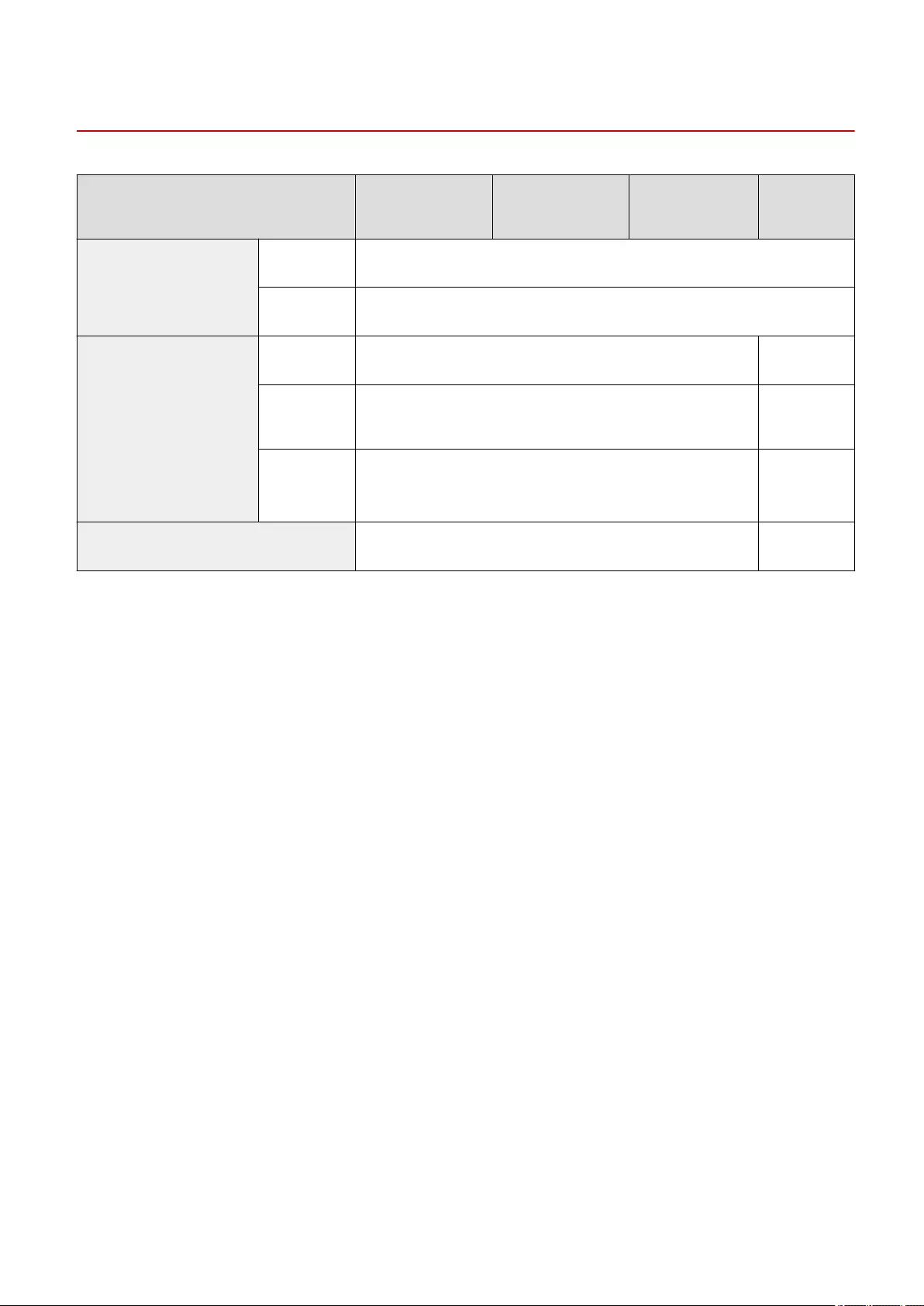
Network
2579-0JY
WG7x50Z series WG7x50F series WG7x50 series WG7x40
series
Wired LAN Network Type 1000 Base-T / 100Base-TX / 10Base-T
Data Rate 1Gbps (1000Mbps) / 100Mbps / 10Mbps
Wireless LAN Network Type IEEE 802.11 b/g/n Not Available
Frequency
Band 2.4 GHz Not Available
Security Infrastructure Mode; 128 (104) / 64 (40) bit WEP, WPA-PSK(TKIP/
AES), WPA2-PSK (TKIP/AES)
Access Point Mode; WPA2-PSK (AES-CCMP)
Not Available
Direct connection (Wireless LAN) Available Not Available
Appendix
722
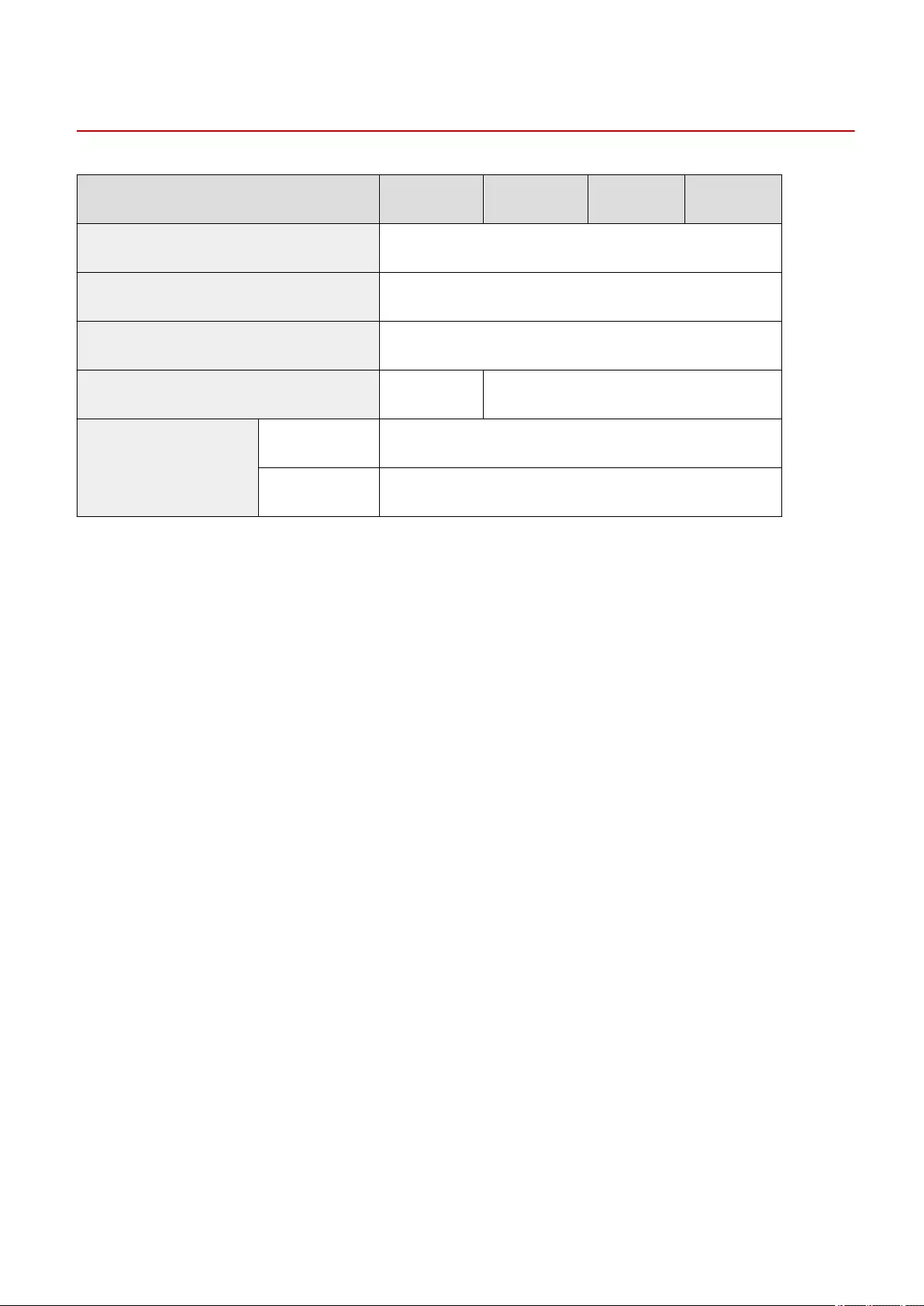
Printing Solutions
2579-0K0
WG7x50Z series WG7x50F series WG7x50 series WG7x40 series
Canon Print Business Available
Canon Print Service Available
Mopria Available
NFC Available NOT Available
Media Direct Print
(USB Memory)
Compatible Format USB 2.0 compatible
File Format JPEG / TIFF / PDF
Appendix
723
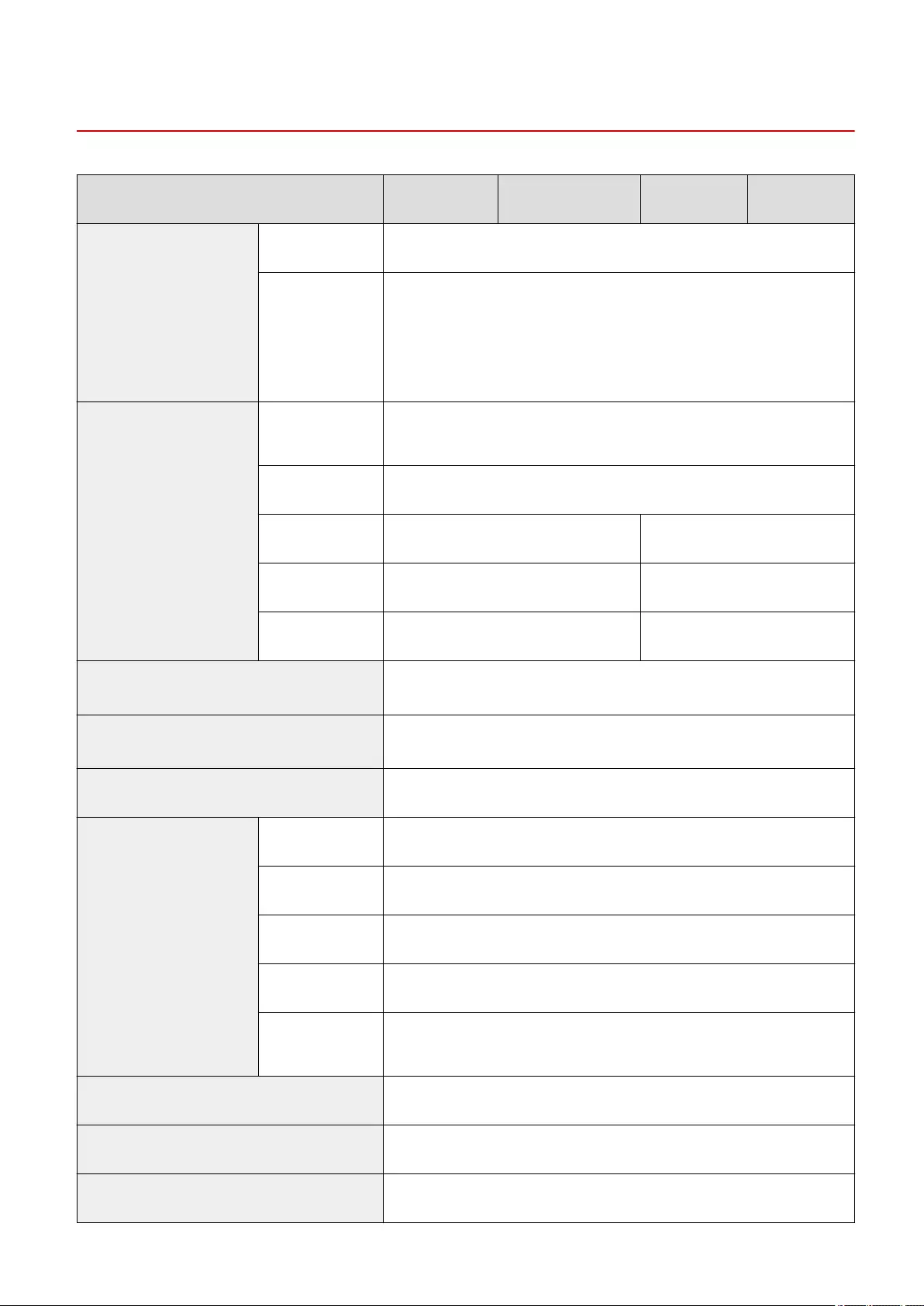
Other Specications
2579-0K1
WG7x50Z series WG7x50F series WG7x50 series WG7x40 series
Operation Panel Display LCD (5.0 inch / TFT color)
Language 35 Languages Selectable: Japanese / English /German /French / Italian /
Spanish / Dutch / Portuguese / Norwegian / Swedish / Danish / Finnish /
Russian / Czech / Hungarian / Polish / Slovene / Turkish / Greek / Simplied
Chinese / Traditional Chinese / Korean / Slovak / Estonian / Latvian /
Lithuanian / Romanian / Bulgarian / Croatian / Catalan / Arabic / Malay /
Basque / Thai / Vietnamese
Interface USB Port for USB
Memory USB 2.0 Hi-Speed
USB Port for PC USB 2.0 Hi-Speed
For Hand Set Available (Japanese Model Only) NOT Available
For Phone Available NOT Available
For Phone Line Available NOT Available
Operating Environment *1 Temperature: 5 to 35 °C (41 to 96 °F)
Humidity: 20 to 90 % RH (w/o condensation)
Recommended Operating Environment *1 Temperature: 15 to 30 °C (59 to 86 °F)
Humidity: 20 to 80 % RH (w/o condensation)
Power AC 100-240 V 50/60 Hz
Power Consumption
Copy/Print Approx. 110 W
Ready Approx. 55 W
Sleep Approx. 1.9 W
Off Approx. 0.1 W
Maximum Power
Consumption Approx. 300 W
TEC (Typical Electricity Consumption) *2 Approx. 1.25 kWh/week
Duty Cycle 100,000 pages
Recommended Montly Printing Volume 1,000 to 5,000 pages
Appendix
724
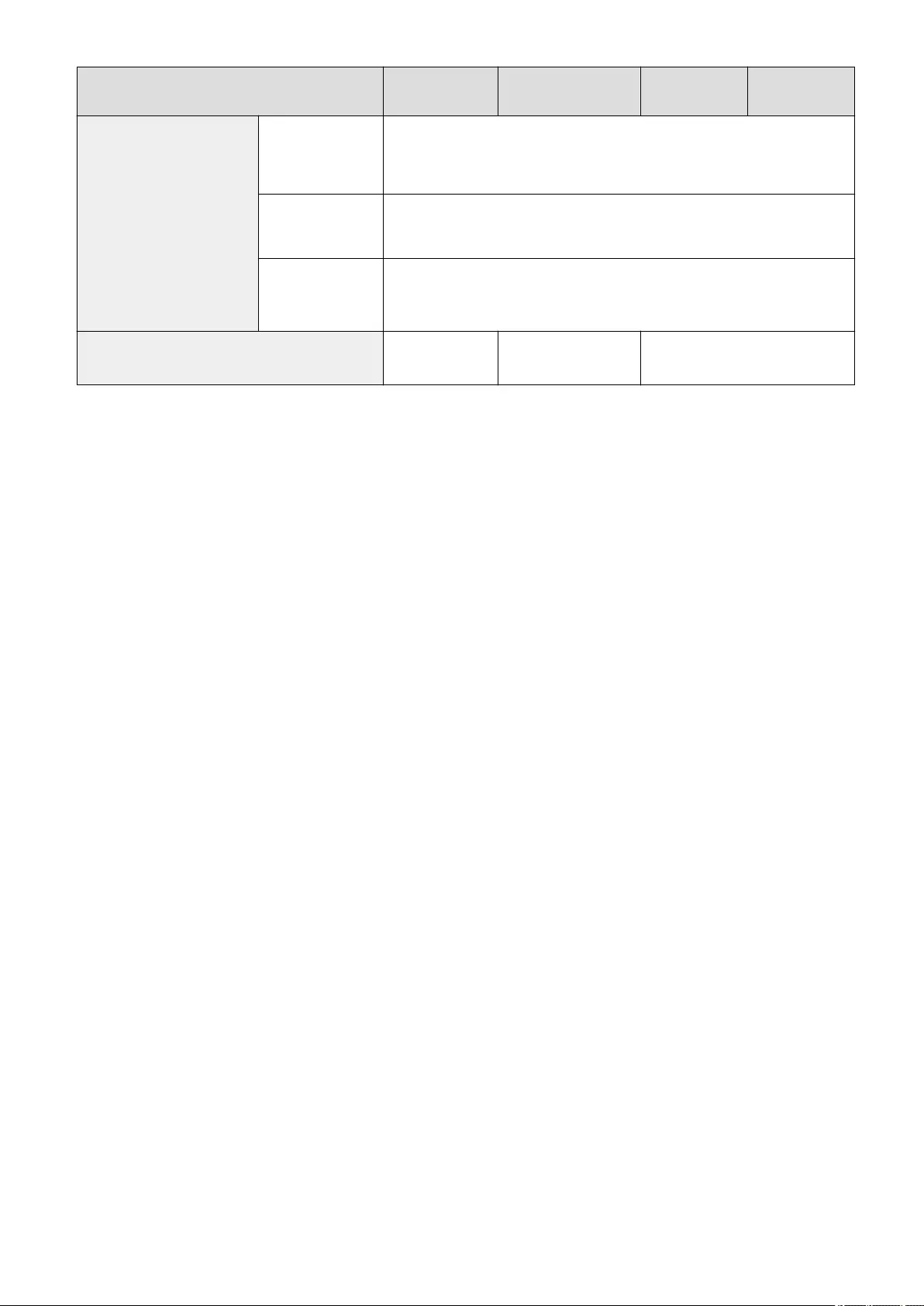
WG7x50Z series WG7x50F series WG7x50 series WG7x40 series
Dimension (W x D x H) Standard
Conguration(W x
D x H)
560 mm (W) x 590 mm (D) x 880 mm (H)
22.1 " (W) x 23.3 " (D) x 34.7" (H)
With Optional
Pedestal (W x D x H) 588 mm (W) x 590 mm (D) x 1,133 mm (H)
23.2 " (W) x 23.3 " (D) x 44.7 " (H)
Maximum Space (W
x D x H) 925 mm (W) x 1,208 mm (D) x 1,487 mm (H)
36.5" (W) x 47.6" (D) x 58.6" (H)
(*ADF is opened to 60°)
Weight (Inc. Print Head) Approx. 82.5 kg
(Approx. 181.2lb)
Approx. 82.1 kg
(Approx. 180.2 lb)
Approx. 81.5 kg
(Approx. 179.1 lb)
*1 Print quality might be lower depending on the operating environment.
*2 Typical Electricity Consumption (TEC) value: TEC value was calculated assuming the unit will be constantly switched
among operational mode, sleep mode, and power-off mode for 5 days, and that it will be either in sleep or power-off
mode for the remaining 2 days within the same week. The TEC value of this product is calculated by Canon on their own
accord using TEC measurement procedure regulated in International ENERGY STAR Program.
Appendix
725
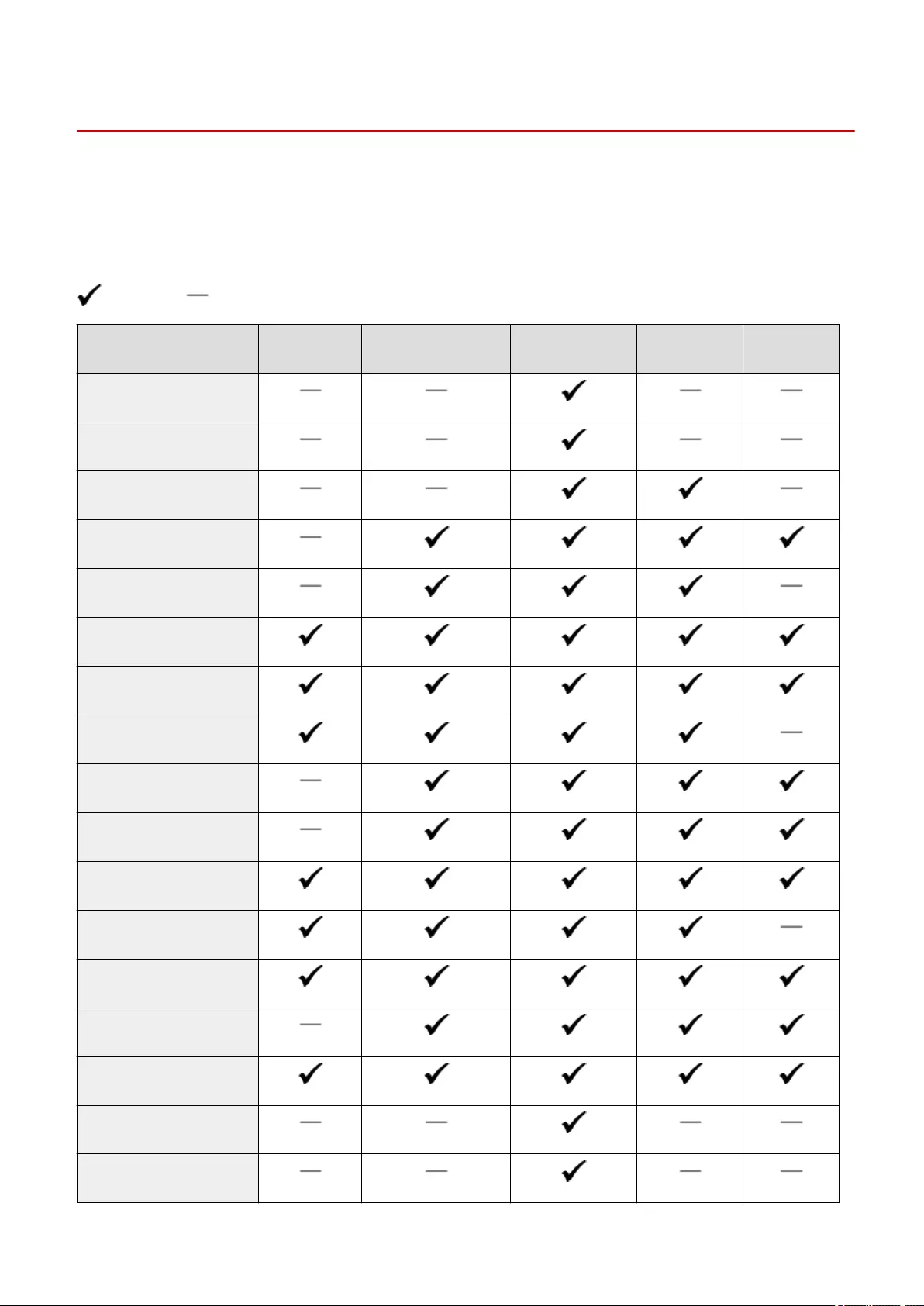
Available Paper
2579-0K3
The paper types that can be used with this machine are shown in the following table. For available paper with options
attached, see the specications of respective options. Also, conrm the precautions regarding paper use.
◼Supported Paper Sizes
: Available : Unavailable
Paper Sizes Paper Drawer 1 Paper Drawer 2, 3, or 4 Multi-Purpose Tray 2-Sided Printing Shift Sorter *1
13 x 19
SRA3 (320 x 450 mm)
305x457 mm
A3
B4
A4
B5
A5
11x17
Legal (LGL)
Letter (LTR)
Statement (STMT)
Executive (EXEC)
8K
16K
4 x 6
5 x 7
Appendix
726
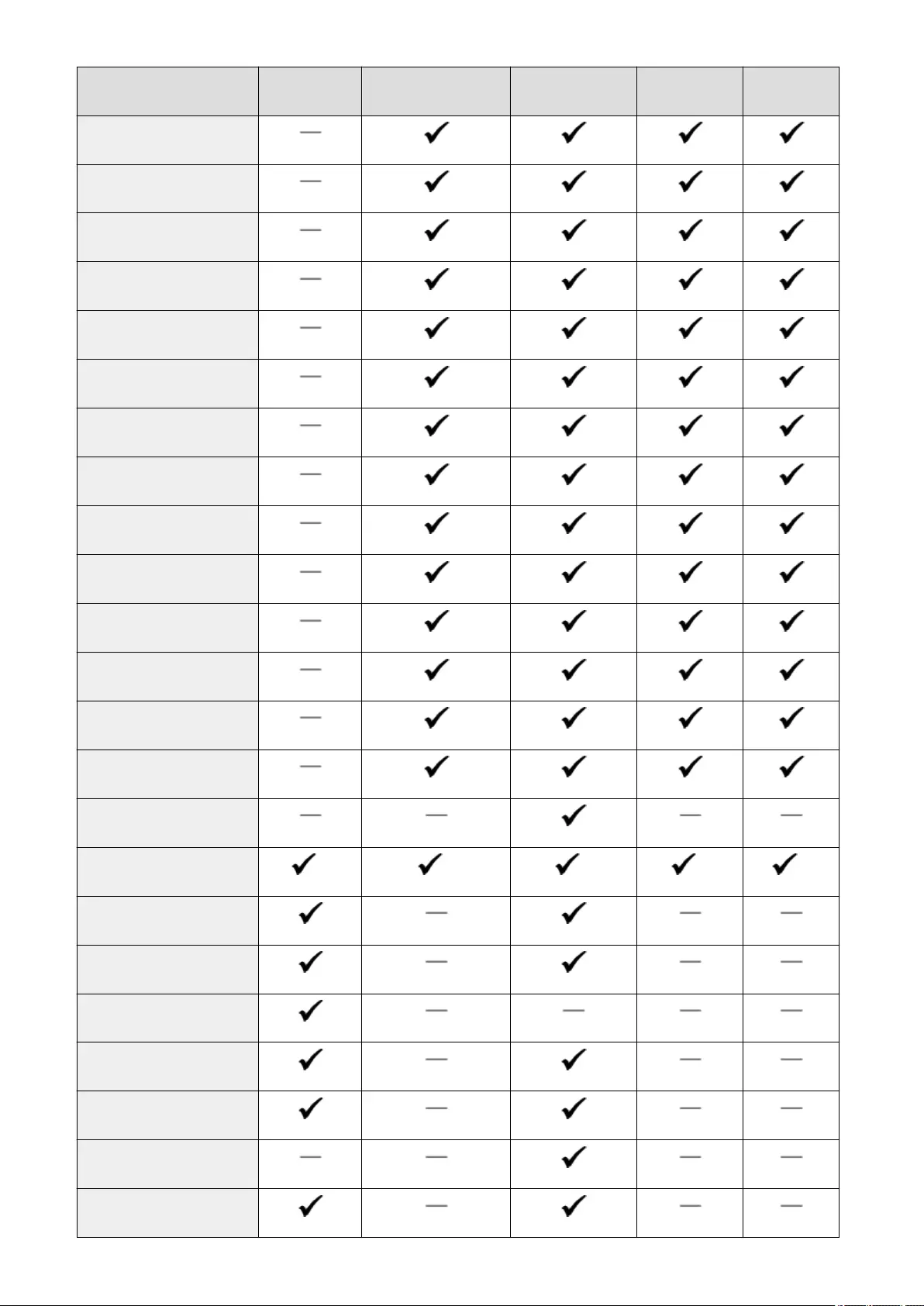
Paper Sizes Paper Drawer 1 Paper Drawer 2, 3, or 4 Multi-Purpose Tray 2-Sided Printing Shift Sorter *1
8 x10
10 x 12
Foolscap/Folio
Ocio
Legal (India)
Foolscap (Australia)
Letter (Government)
Legal (Government)
Ocio (Mexico)
Ocio (Ecuador)
Ocio (Argentina)
Letter (Argentina)
Ocio (Brazil)
F4A
Postcard
Custom (Custom Size) *2 *3 *4 *5 *6
Envelope Yougatanaga 3
Envelope Nagagata 3
Envelope Nagagata 4
Envelope Yougata 4
Envelope Yougata 6
Envelope Kakugata 2
Envelope No.10 (COM10)
Appendix
727
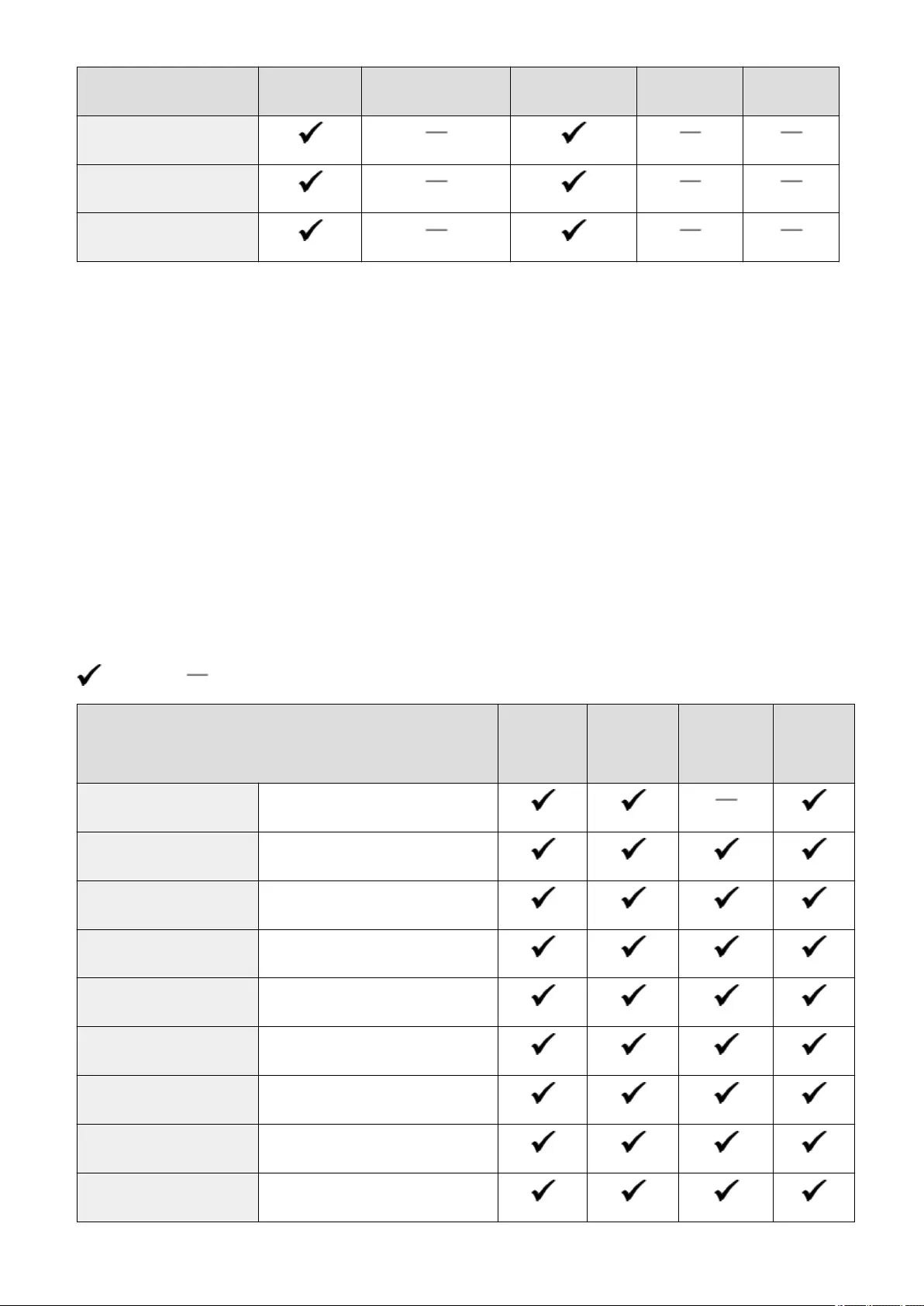
Paper Sizes Paper Drawer 1 Paper Drawer 2, 3, or 4 Multi-Purpose Tray 2-Sided Printing Shift Sorter *1
Envelope Monarch
Envelope DL
Envelope ISO-C5
*1 Models with shift sorting only
*2 Can use custom sizes from 3.54 x 7.48 inch (90.0 x 190.0 mm) to 8.50 x 11.69 inch (216.0 x 297.0 mm).
*3 Can use custom sizes from 5.50 x 8.27 inch (139.7 x 210.0 mm) to 11.69 x 17.00 inch (297.0 x 431.8 mm).
*4 Can use custom sizes from 3.86 x 5.83 inch (98.0 x 148.0 mm) to 13.00 x 28.00 inch (330.2 x 711.2 mm).
*5 With paper drawer 1, automatic 2-sided printing is possible in a range from 5.83 x 8.27 inch (148.0 x 210.0 mm) to 8.50
x 11.69 inch (216.0 x 297.0 mm).
With paper drawers 2, 3, and 4, automatic 2-sided printing is possible in a range from 5.83 x 8.27 inch (148.0 x 210.0 mm)
to11.69 x 17.00 inch (297.0 x 431.8 mm) .
With the multi-purpose tray, automatic 2-sided printing is possible in a range from 5.83 x 8.27 inch (148.0 x 210.0 mm) to
12.00 x 18.00 inch (304.8 x 457.2 mm).
*6 With custom sizes, shift sorting is possible in a range from 7.17 x 10.12 inch (182.0 x 257.0 mm) to 11.69 x 17.00 inch
(297.0 x 431.8 mm).
◼Supported Paper Types
Chlorine-free paper can be used with this machine.
Short grain paper is not recommended. Long grain paper is recommended.
: Available : Unavailable
Paper Type Paper
Drawer 1
Paper
Drawer 2, 3,
or 4
Multi-
Purpose Tray
Shift Sorter
*1
Thin 2 14 to 15 lb bond (52 to 59 g/m²)
Thin 1 16 lb bond (60 to 63 g/m²)
Plain 1 17 to 20 lb bond (64 to 75 g/m²)
Plain 2 21 to 24 lb bond (76 to 90 g/m²)
Plain 3 25 to 28 lb bond (91 to 105 g/m²)
Heavy 1 29 to 34 lb bond (106 to 128 g/m²)
Heavy 2 35 to 40 lb bond (129 to 150 g/m²)
Heavy 3 56 to 60 lb cover (151 to 163 g/m²)
Heavy 4 61 to 66 lb cover (164 to 180 g/m²)
Appendix
728
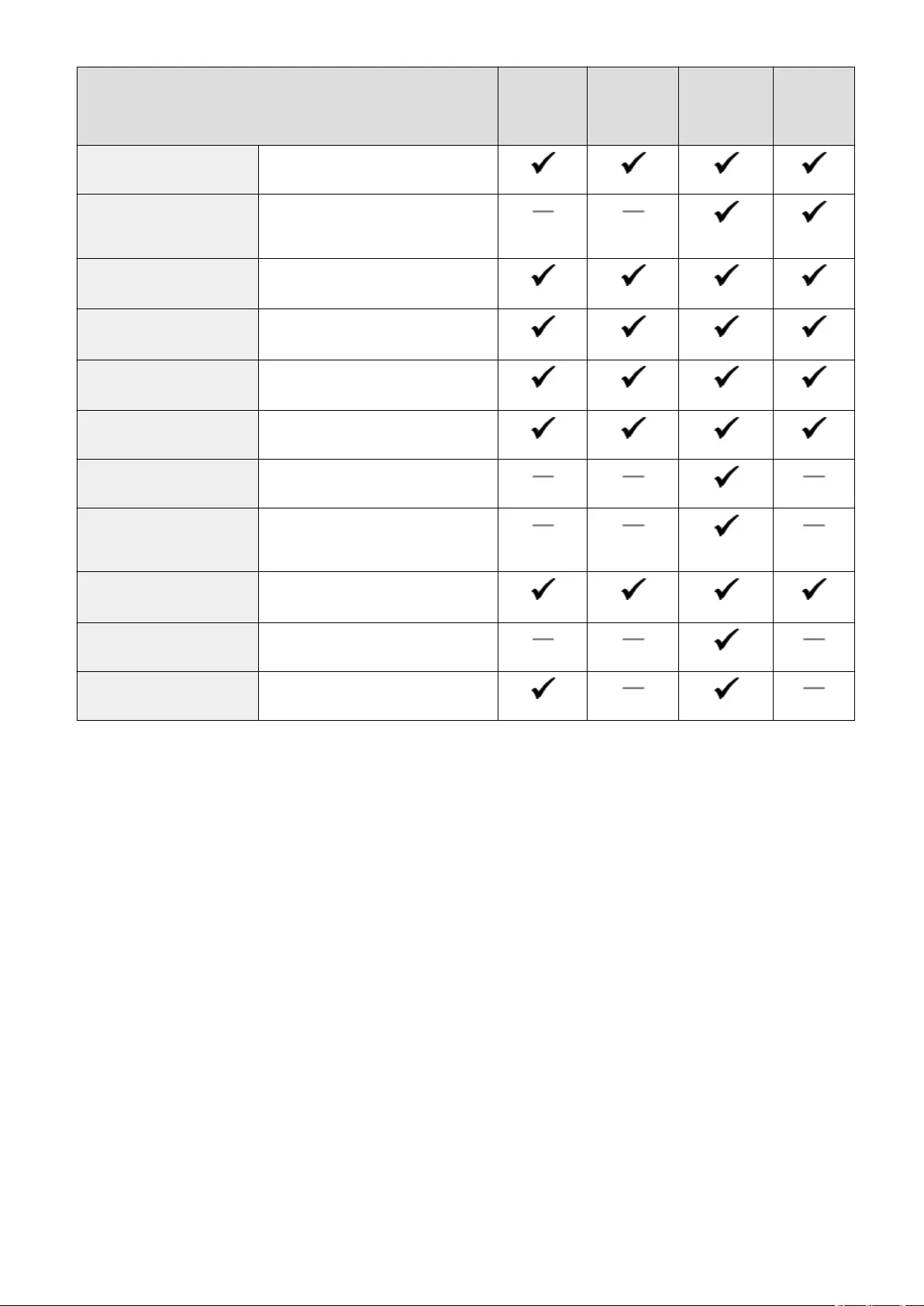
Paper Type Paper
Drawer 1
Paper
Drawer 2, 3,
or 4
Multi-
Purpose Tray
Shift Sorter
*1
Heavy 5 67 to 80 lb cover (181 to 220 g/m²)
Heavy 6 82 lb cover to 140 lb index (221 to 256
g/m²)
Recycled 1 *2 17 to 20 lb bond (64 to 75 g/m²)
Recycled 2 *2 21 to 24 lb bond (76 to 90 g/m²)
Recycled 3 *2 25 to 28 lb bond (91 to 105 g/m²)
Color 17 to 21 lb bond (64 to 82 g/m²)
Matte Photo Paper 63 lb Cover (170 g/m²)
Labels 31 lb bond to 68 lb cover (118 to 185
g/m²)
Bond *3 22 to 26 lb bond (83 to 99 g/m²)
Postcard 61 to 80 lb cover (164 to 220 g/m²)
Envelope 20 to 28 lb bond (75 to 105 g/m²)
*1 Models with shift sorting only
*2 100 % recycled paper can be used.
*3 LTR and EXEC size paper can be used.
◼Canon genuine paper
Paper suited to photo printing:
●Matte Photo Paper <MP-101>
◼Paper usable for copying
●Use the following papers for 2-sided copying.
Paper sizes: 12.0 x 18.0 inch (305 x 457 mm), A3, B4, A4, B5, A5, 11 x
17, LGL, LTR, STMT, EXEC, 8K, 16K, custom size*1
Paper thicknesses: 13.8 lb Bond to 81.4 lb Cover (52 to 220 g/m²)
*1 2-sided copying unavailable with labels, postcards, and envelopes. With paper drawer 1, 2-sided copying is possible in a
range from 5.83 x 8.27 inch (148.0 x 210.0 mm) to 8.50 x 11.69 inch (216.0 x 297.0 mm). With paper drawers 2, 3, and 4, 2-
sided copying is possible in a range from 5.83 x 8.27 inch (148.0 x 210.0 mm) to 11.69 x 17.00 inch (297.0 x 431.8 mm). With
the multi-purpose tray, 2-sided copying is possible in a range from 5.83 x 8.27 inch (148.0 x 210.0 mm) to 12.00 x 18.00 inch
(304.8 x 457.2 mm).
Appendix
729

●Finishing is unavailable when copying on labels, postcards, and envelopes.
●Finishing is available with custom sizes in a range from 7.17 x 10.12 inch (182.0 x 257.0 mm) to 11.69 x 17.00
inch (297.0 x 431.8 mm).
◼Paper usable for printing
●2-sided printing is unavailable for some paper sizes and paper types.
◼Print range
Print range is indicated by the gray area.
A: 0.16 inches (4 mm)
B: 0.16 inches (4 mm)
C: 0.16 inches (4 mm)
D: 0.16 inches (4 mm)
For Envelope, Yougata 4, 6:
A: 0.16 inches (4 mm)
B: 0.16 inches (4 mm)
C: 0.31 inches (8 mm)
D: 0.16 inches (4 mm)
For Postcard:
A: 0.16 inches (4 mm)
B: 0.08 inches (2 mm)
C: 0.16 inches (4 mm)
D: 0.16 inches (4 mm)
Appendix
730
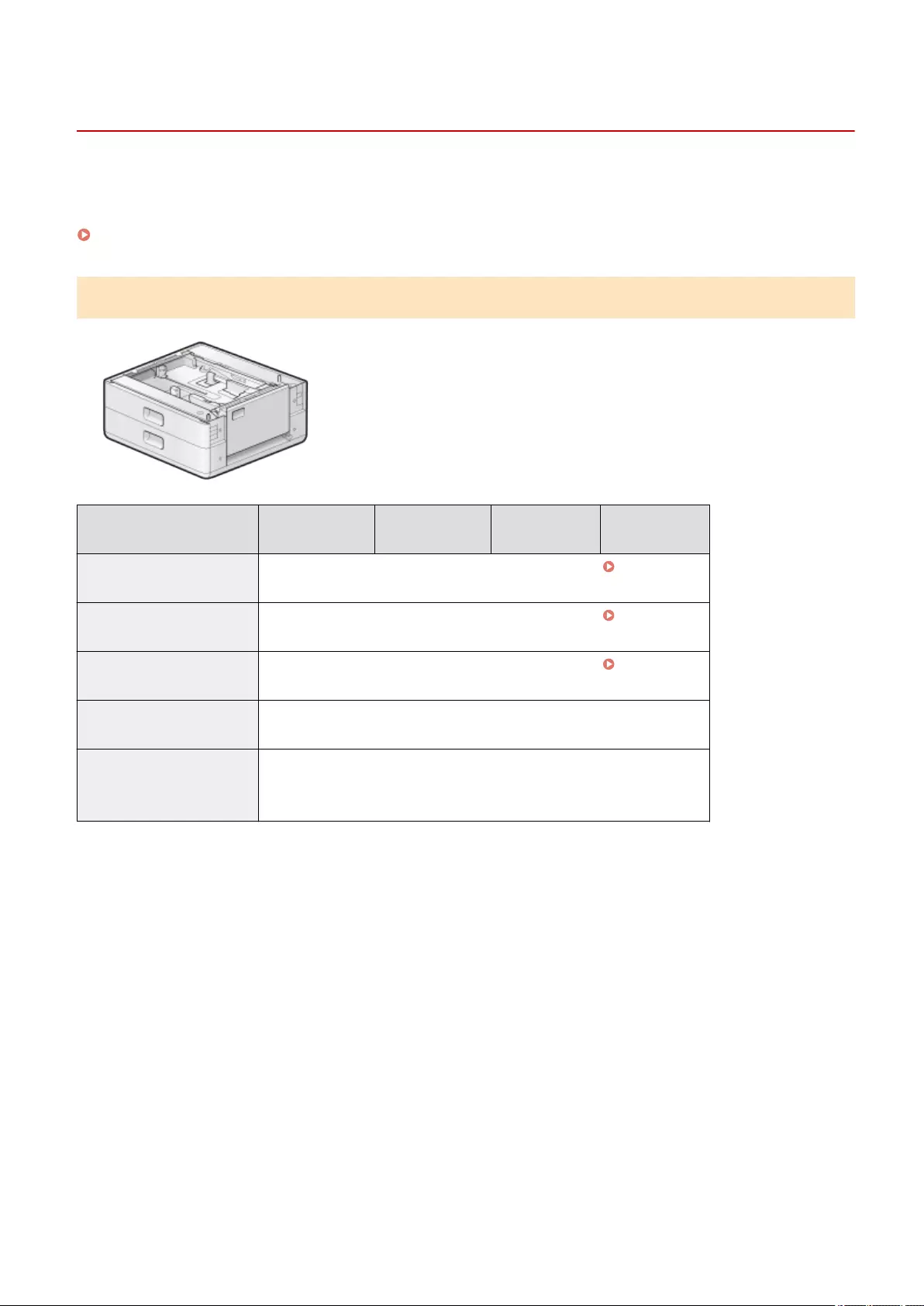
Optional Equipment
2579-0CL
The functionality of the machine can be fully utilized by using the optional equipment described below. Optional
equipment can be purchased from the retail outlet where you purchased the machine or from your local Canon dealer.
Cassette Feeding Unit CF10 (Cassette 3, 4)(P. 732)
Cassette Feeding Unit CF10 (Cassette 3, 4)
Installing this cassette feeding unit enables you to load paper of a different size
than that of paper loaded in the standard paper drawer. This surely reduces the
time and labor for paper replacement.
WG7x50Z series WG7x50F series WG7x50 series WG7x40 series
Media size Refer to Supported Media Type and Size per Cassette 3, 4 Printer(P. 714)
Media Weight Refer to Supported Media Type and Size per Cassette 3, 4 Printer(P. 714)
Media Capacity Refer to Supported Media Type and Size per Cassette 3, 4 Printer(P. 714)
Power Supplied from Main Unit
Dimension/Weight 560 mm x 590 mm x 253 mm (WxDxH)
22.1 " (W) x 23.3 " (D) x 10.0 " (H),
Approx. 19 kg, Approx. 41.2 lb
Appendix
732

Manuals and Their Contents
2579-0CS
The manuals listed below are included with the machine. Refer to them as necessary.
Getting Started Read this manual rst. It describes basic setup procedures, from removing the packing
materials to setting up the machine.
Online Manual (This Manual) This manual describes all the functions of the machine in a manual that is viewed using a
Web browser. You can browse information by category or enter a keyword to search for
pages on a specic topic. Using Online Manual(P. 734)
Installation for the Cassette
Feeding Unit CF10
This manual describes the installation procedure for the Cassette Feeding Unit CF10. The
attached PDF contains the procedure in 30 languages. If your required language is not
displayed after opening the PDF, scroll the PDF until the language appears.
Consumables Table This table describes the numbers of consumables required when replacing the print head
and transporting the machine.
Appendix
733

Using Online Manual
2579-0CU
The Online Manual is a manual that can be viewed on your computer or mobile device and it describes all of the
functions of the machine. You can search from your intended use or enter a keyword to quickly nd the page you are
looking for. The section describes the screen layout of the Online Manual and how to read the Guide. You can specify
how the appearance of the Online Manual looks.
◼Screen Layout of Online Manual
This section describes the screens conguring the Online Manual and how to use the on-screen buttons. Screen
Layout of Online Manual(P. 735)
◼Viewing Online Manual
This section describes the meaning of the marks used in the Online Manual, how the keys on the operation panel and
the buttons on the computer display are represented, and other matters that help you understand the information
contained in the Online Manual. Viewing Online Manual(P. 738)
◼Specifying How the Appearance of the Online Manual Looks
You can change the character size used in the Online Manual, and switch the screen layout to t to the device you use
to view the Online Manual.
●If you do not have access to Adobe Reader to view the manuals in PDF format, try other programs such as
PDF Preview developed by Vivid Document Imaging Technologies.
How to Find the Topic You Are Looking for
Search the contents
●You can nd the page you are looking for by selecting the topic from the "Contents" on the left side of the
screen.
Search by keyword
●Perform a search by entering a keyword, such as "envelope" or "ink tank," and the pages containing the
keyword are displayed. You can nd the page you are looking for from those results. You can also enter
phrases such as "connecting to a network." The keyword search also supports the AND Boolean to search for
multiple keywords. For the organization of the search screen and how to operate the search screen, see
Search(P. 737) .
Appendix
734
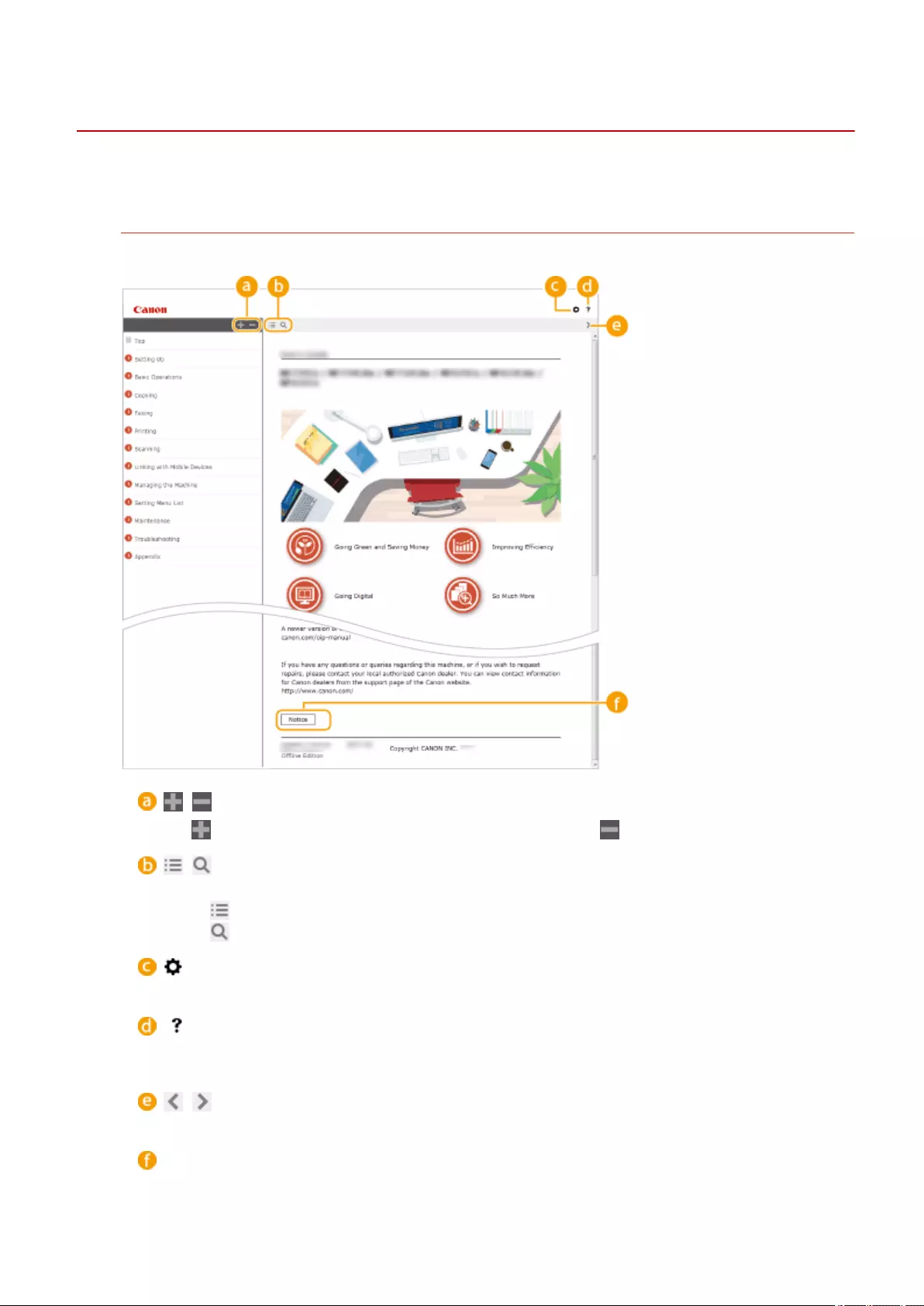
Screen Layout of Online Manual
2579-0CW
The Online Manual is divided into different screens, and the content of each screen varies.
Top Page
Appears when Online Manual is started.
/
Click to also display all of the sections under the chapters. Click to return to the previous display.
/
Click to toggle the display between the contents and search. When the table of contents is displayed, each
click on switches between hiding and showing the display. When the search display is shown, each
click on switches between hiding and showing the display.
Click to set parameters to determine how the Online Manual is displayed, such as character size or layout.
Click to display information on how to view the Online Manual, how to perform a search, and other
information.
/
Click to display the previous or following topic.
[Notice]
Click to view important information you should know when using the machine.
Appendix
735
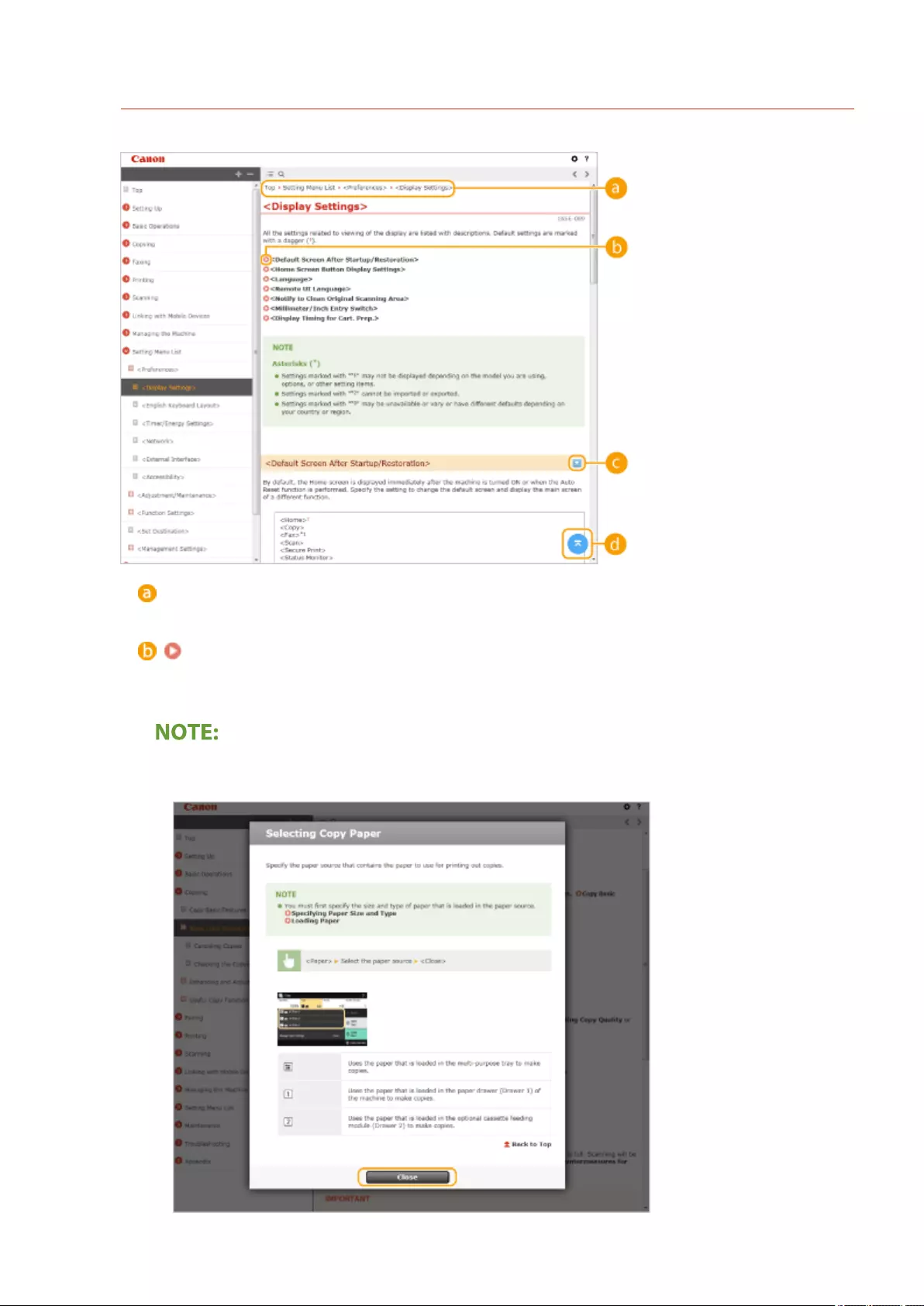
Topic Page
Contains information about how to congure and use the machine.
Navigation
See what chapter topic you are currently viewing.
Click to jump to the corresponding page. To return to the previous page, click "Back" on your Web
browser.
●When you click the icon, the current page may go dark and a pop-up window may appear. To return to
the page, click [Close] in the pop-up window.
Appendix
736
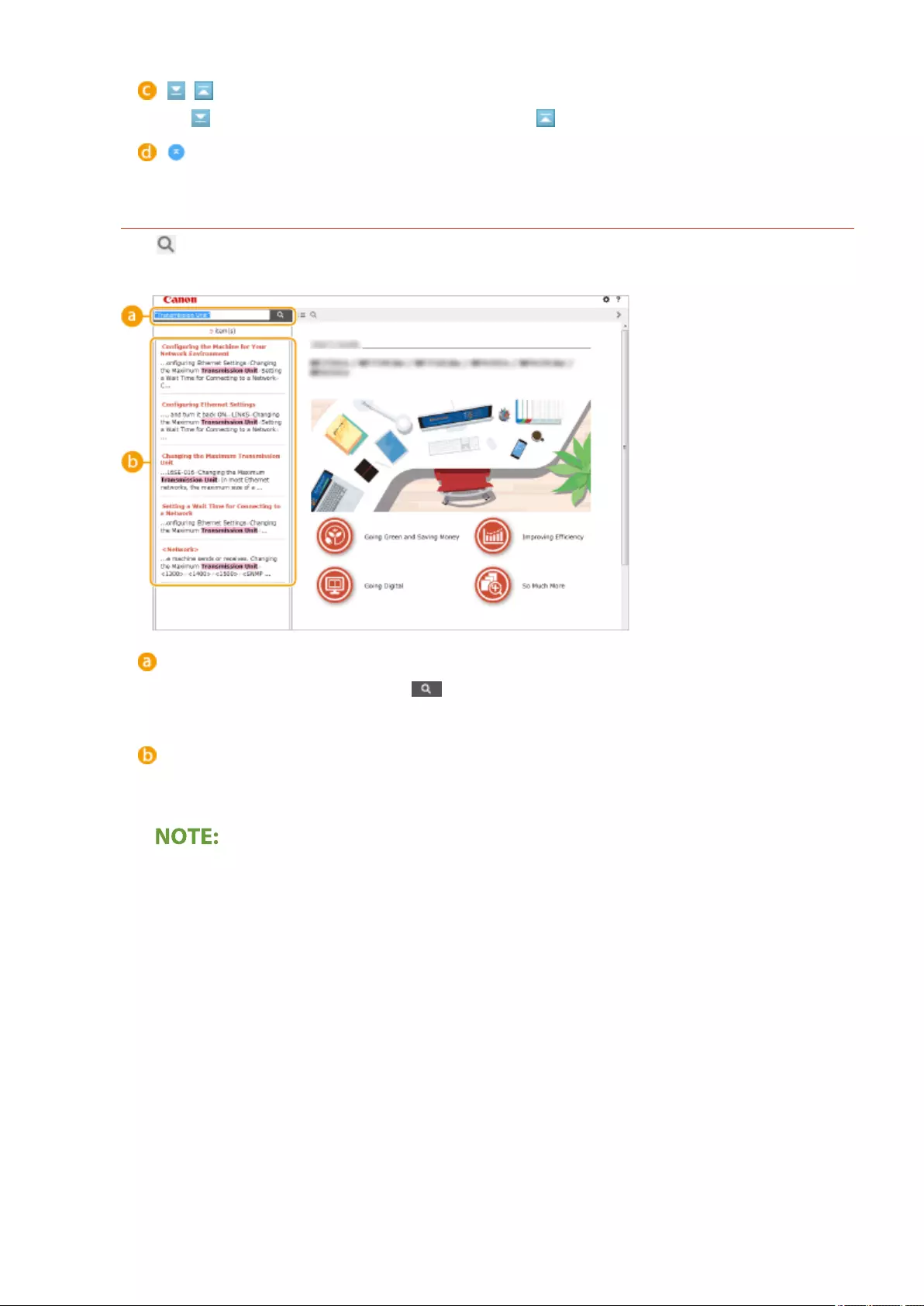
/
Click to display the hidden detailed descriptions. Click to close the detailed descriptions.
Click to return to the page top.
Search
Click to display the search window. Contains a text box to perform a search by keyword and nd the page
you are looking for.
[Enter keyword(s) here]
Enter a keyword or keywords and click to display the search results. You can search for pages
containing all the keywords by separating the keywords by a space (blank). Also you can only search for
pages containing an exact phrase by enclosing the keywords in double quotation marks.
Search result
Displays the search results of the pages that contain the specied keywords. From the results, locate the
page you are looking for and click the topic title of the page.
●The specied keyword(s) are shown in bold in the search results.
Appendix
737

Viewing Online Manual
2579-0CX
This section describes the marks, buttons, screens, and other items used in the Online Manual. The warnings and
cautions are also given in the "Important Safety Instructions" in the "Getting Started" included with the machine. See
also these instructions.
Marks
Cautions regarding safety, restrictions and cautions regarding the handling of the machine, useful tips, and
other information are indicated using the marks below.
Indicates an operation that must not be performed. Read these items carefully,
and make sure not to perform the described operations.
Indicates operational requirements and restrictions. Be sure to read these items
carefully to operate the machine correctly, and avoid damage to the machine or
property.
Indicates a clarication of an operation, or contains additional explanations for a
procedure.
Indicates useful functions or tips for using the machine.
Keys and Buttons Used in this Manual
Keys on the operation panel and buttons on the computer display appear in the following notation:
Type Example
Keys on the operation panel
Settings displayed on the operation panel <Timer/Energy Settings>
<Paper jammed.>
Buttons and other text interfaces displayed on the computer display [Preferences]
Computer Screens Used in This Manual
Unless otherwise noted, displays used in the Online Manual are those for the WG7x50Z series. Depending on
the model or operating system you are using, the appearance of the displays used in this manual may slightly
differ from the actual displays. Also, the appearance of drivers and software may differ depending on their
version.
Illustrations Used in This Manual
Unless otherwise noted, illustrations used in the Online Manual show the WG7x50Z series with the optional
Cassette Feeding Unit CF10 installed.
Appendix
738
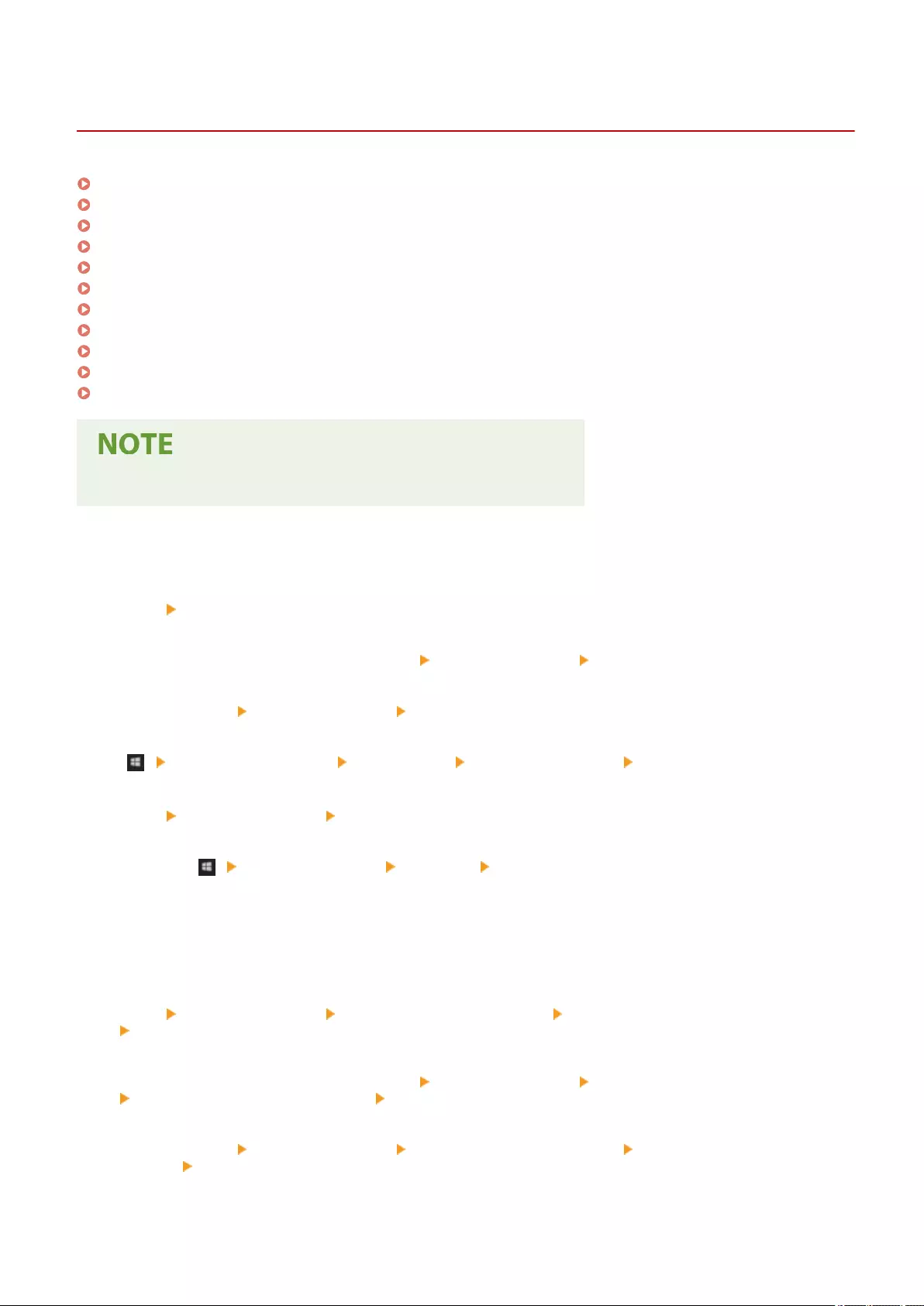
Basic Windows Operations
2579-0E0
Displaying the Printer Folder(P. 739)
Enabling [Network discovery](P. 739)
Displaying Shared Printers in the Print Server(P. 740)
Displaying the [Software Programs/Manuals Setup (Software Programs/Manuals Setup)] Screen(P. 741)
Printing a Test Page in Windows(P. 741)
Checking the Bit Architecture(P. 742)
Checking the Computer Name(P. 743)
Checking the Printer Port(P. 744)
Checking Bidirectional Communication(P. 745)
Checking the SSID to Which Your Computer is Connected(P. 746)
When Printing or Sending from the Windows Store App(P. 746)
●Depending on the computer that you use, the operation may differ.
◼Displaying the Printer Folder
Windows 7/Server 2008 R2
[Start] select [View devices and printers].
Windows Server 2012
Right-click the lower-left corner of the screen select [Control Panel] [View devices and printers].
Windows 8.1/Server 2012 R2
Right-click [Start] select [Control Panel] [View devices and printers].
Windows 10
[] select [Windows System] [Control Panel] [Hardware and Sound] [Devices and Printers].
Windows Server 2008
[Start] select [Control Panel] double-click [Printers].
Windows Server 2016
Right-click [ ] select [Control Panel] [Hardware] [Devices and Printers].
◼Enabling [Network discovery]
Enable [Network discovery] to view the computers on your network.
Windows 7/Server 2008 R2
[Start] select [Control Panel] [View network status and tasks] [Change advanced sharing settings]
select [Turn on network discovery] under [Network discovery].
Windows Server 2012
Right-click the lower-left corner of the screen select [Control Panel] [View network status and tasks]
[Change advanced sharing settings] select [Turn on network discovery] under [Network discovery].
Windows 8.1/Server 2012 R2
Right-click [Start] select [Control Panel] [View network status and tasks] [Change advanced sharing
settings] select [Turn on network discovery] under [Network discovery].
Windows 10
Appendix
739

[ ] select [Windows System] [Control Panel] [View network status and tasks] [Change advanced
sharing settings] select [Turn on network discovery] under [Network discovery].
Windows Server 2008
[Start] select [Control Panel] double-click [Network and Sharing Center] select [Turn on network
discovery] under [Network discovery].
Windows Server 2016
Right-click [ ] select [Control Panel] [View network status and tasks] [Change advanced sharing
settings] select [Turn on network discovery] under [Network discovery].
◼Displaying Shared Printers in the Print Server
1Open Windows Explorer.
Windows 7/Server 2008
[Start] select [All Programs] or [Programs] [Accessories] [Windows Explorer].
Windows Server 2012
Right-click the lower-left corner of the screen select [File Explorer].
Windows 8.1/Server 2012 R2
Right-click [Start] select [File Explorer].
Windows 10/Server 2016
Right-click [ ] select [File Explorer].
2Select the printer server in [Network] or [My Network Places].
●To view computers on the network, you may need to turn on network discovery or search the network for
computers.
➠Shared printers are displayed.
Appendix
740
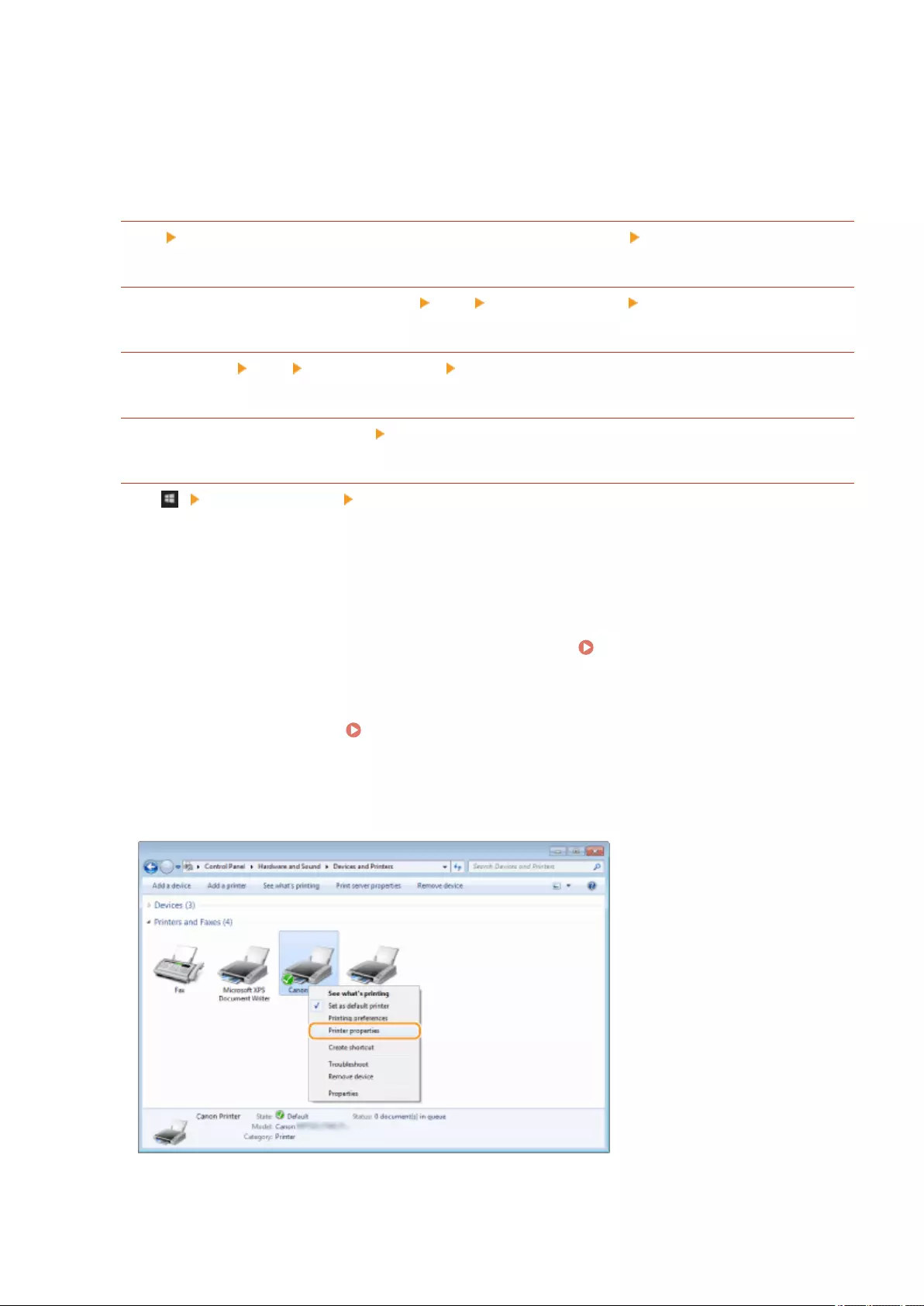
◼Displaying the [Software Programs/Manuals Setup (Software Programs/Manuals Setup)]
Screen
If your computer does not display the [Software Programs/Manuals Setup (Software Programs/Manuals Setup)] screen
after inserting the provided DVD-ROM, follow the procedure below. The DVD-ROM drive name is indicated as "D:" in
this manual. The DVD-ROM drive name may differ depending on the computer you are using.
Windows 7/Server 2008
[Start] enter "D:\MInst.exe" in [Search programs and les] or [Start Search] press the [ENTER] key.
Windows Server 2012
Right-click the lower-left corner of the screen [Run] Enter "D:\MInst.exe" click [OK]
Windows 8.1/Server 2012 R2
Right-click [Start] [Run] Enter "D:\MInst.exe" click [OK]
Windows 10
Enter "D:\MInst.exe" in the search box click [D:\MInst.exe] displayed as the search result.
Windows Server 2016
Click [ ] enter "D:\MInst.exe" click [D:\MInst.exe] displayed as the search result.
◼Printing a Test Page in Windows
You can check whether the printer driver is operational by printing a test page in Windows.
1Load A4/Letter size paper in the multi-purpose tray. Loading Paper in the Multi-
Purpose Tray(P. 141)
2Open the printer folder. Displaying the Printer Folder(P. 739)
3Right-click the printer driver icon for this machine, and click [Printer properties] or
[Properties].
4Click [Print Test Page] in [General] tab.
Appendix
741

➠The test page is printed.
◼Checking the Bit Architecture
If you are not sure whether your computer is running 32-bit or 64-bit Windows follow the procedure below.
1Display [Control Panel].
Windows 7/Server 2008
[Start] select [Control Panel].
Windows Server 2012
Right-click the lower-left corner of the screen select [Control Panel].
Windows 8.1/Server 2012 R2
Right-click [Start] select [Control Panel].
Windows 10/Server 2016
Proceed to step 2.
2Display [System].
Windows 7/Server 2008 R2/Server 2012
Click [System and Maintenance] or [System and Security] [System].
Windows 10/Server 2016
Click [ ] [Settings] [System] select [About].
Windows Server 2008
Double-click [System].
3Check the bit architecture.
For 32-bit versions
[32-bit Operating System] is displayed.
For 64-bit versions
[64-bit Operating System] is displayed.
Appendix
742

◼Checking the Computer Name
1Display [Control Panel].
Windows 7/Server 2008
[Start] select [Control Panel].
Windows Server 2012
Right-click the lower-left corner of the screen select [Control Panel].
Windows 8.1/Server 2012 R2
Right-click [Start] select [Control Panel].
Windows 10
Click [ ] select [Windows System] [Control Panel].
Windows Server 2016
Right-click [ ] select [Control Panel].
2Display [System].
Windows 7/10/Server 2008 R2/Server 2012/Server 2016
Click [System and Maintenance] or [System and Security] [System].
Windows Server 2008
Double-click [System].
3Check the computer name.
Appendix
743
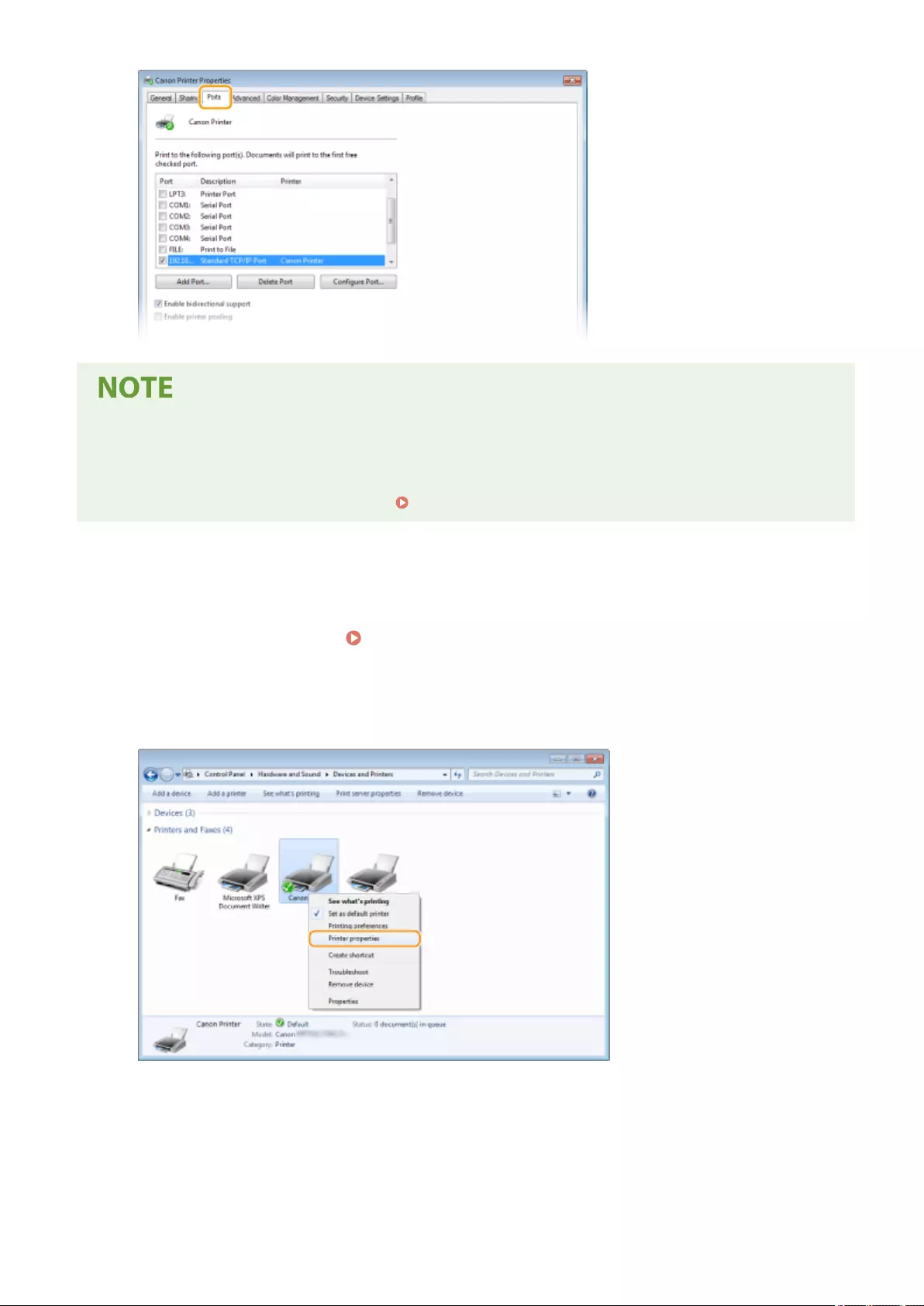
If you are using a network connection and have changed the machine's IP address
●If [Description] for the selected port is [Canon MFNP Port], and the machine and the computer are on the
same subnet, then the connection will be maintained. You do not need to add a new port. If it is [Standard
TCP/IP Port], you need to add a new port. Conguring Printer Ports(P. 47)
◼Checking Bidirectional Communication
1Open the printer folder. Displaying the Printer Folder(P. 739)
2Right-click the printer driver icon for this machine, and click [Printer properties] or
[Properties].
3In the [Ports] tab, make sure that the [Enable bidirectional support] check box is
selected.
Appendix
745
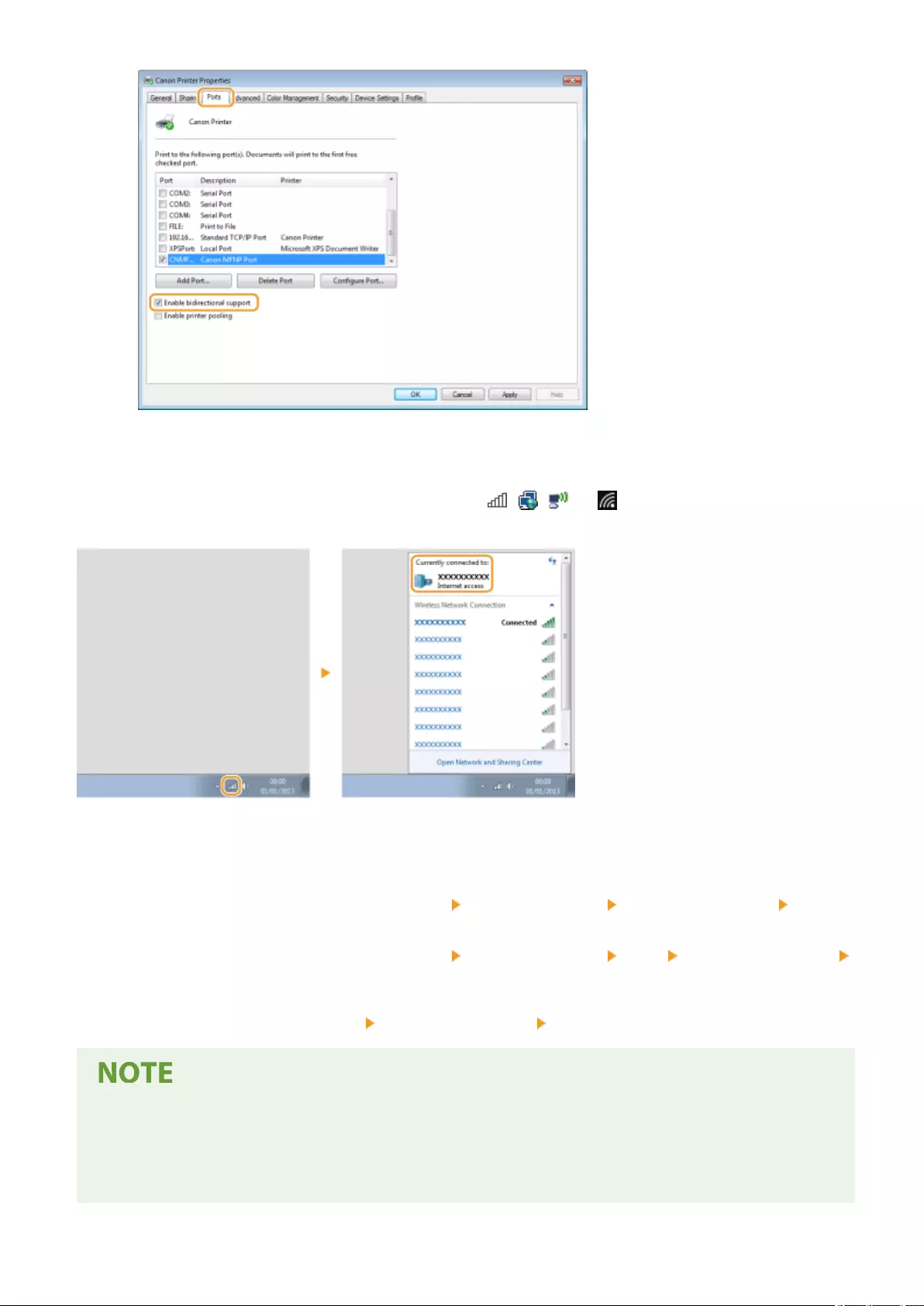
◼Checking the SSID to Which Your Computer is Connected
If your computer is connected to a wireless LAN network, click , , , or in the system tray to display the
SSID of the connected wireless LAN router.
◼When Printing or Sending from the Windows Store App
Windows 8/Server 2012
Display the charms on the right side of the screen Tap or click [Devices] The driver that you use [Print].
Windows 8.1/Server 2012 R2
Display the charms on the right side of the screen Tap or click [Devices] [Print] The driver that you use
[Print].
Windows 10
Tap or click [Print] on the application The driver that you use [Print].
●If you print a document or send a fax using this method, only a limited number of functions are available.
●If the message [The printer requires your attention. Go to the desktop to take care of it.] is displayed, go to
the desktop and perform the required operations. This message appears when the machine is set to display
the user name when printing documents, sending faxes or similar instances.
Appendix
746
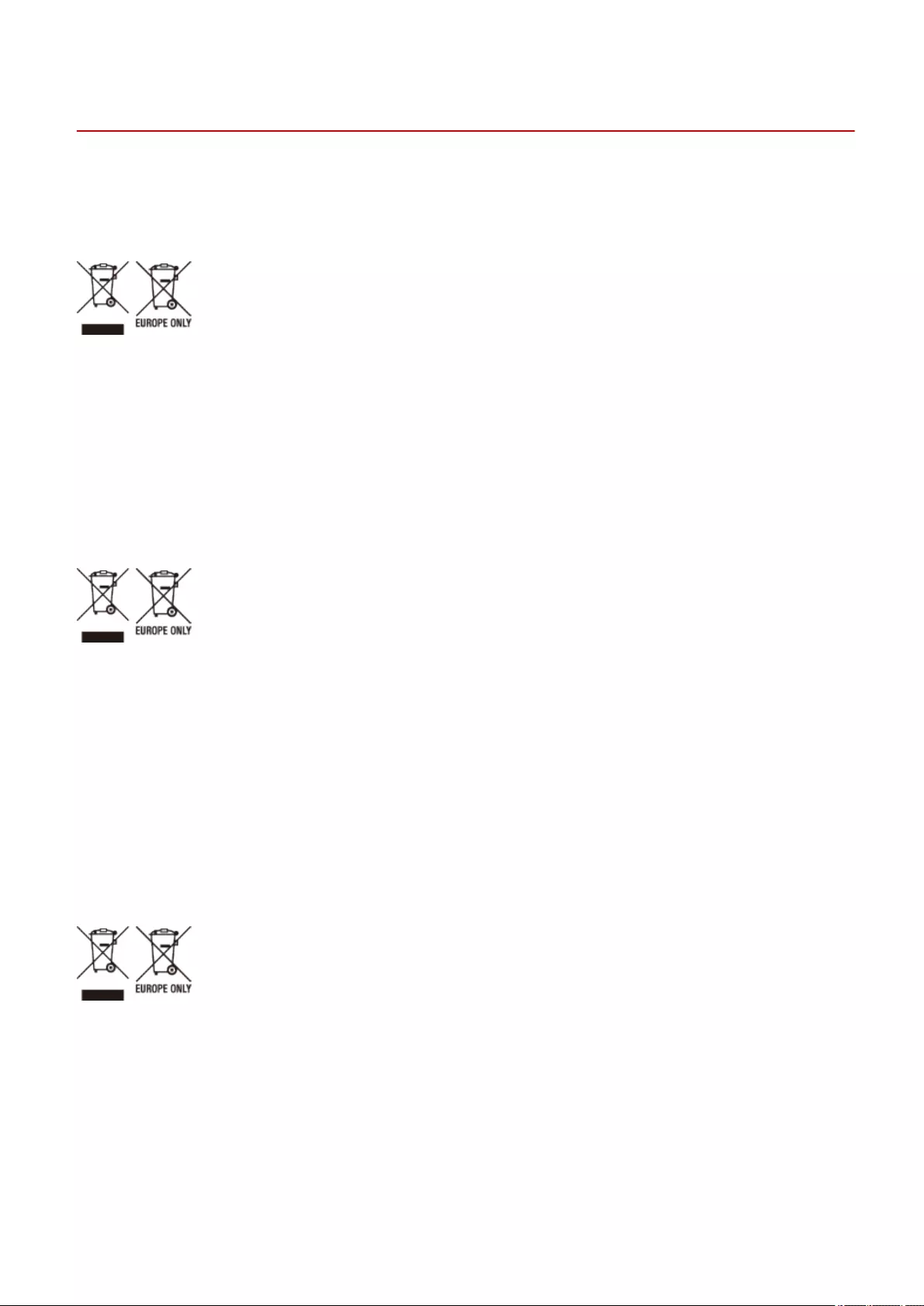
Notice
2579-0E2
◼WEEE (EU&EEA)
Only for European Union and EEA (Norway, Iceland and Liechtenstein)
These symbols indicate that this product is not to be disposed of with your household waste, according to the WEEE
Directive (2012/19/EU), the Battery Directive (2006/66/EC) and/or national legislation implementing those Directives. If
a chemical symbol is printed beneath the symbol shown above, in accordance with the Battery Directive, this indicates
that a heavy metal (Hg = Mercury, Cd = Cadmium, Pb = Lead) is present in this battery or accumulator at a
concentration above an applicable threshold specied in the Battery Directive. This product should be handed over to
a designated collection point, e.g., on an authorized one-for-one basis when you buy a new similar product or to an
authorized collection site for recycling waste electrical and electronic equipment (EEE) and batteries and accumulators.
Improper handling of this type of waste could have a possible impact on the environment and human health due to
potentially hazardous substances that are generally associated with EEE. Your cooperation in the correct disposal of
this product will contribute to the effective usage of natural resources. For more information about the recycling of
this product, please contact your local city oce, waste authority, approved scheme or your household waste disposal
service or visit www.canon-europe.com/weee, or www.canon-europe.com/battery.
Nur für Europäische Union und EWR (Norwegen, Island und Liechtenstein)
Diese Symbole weisen darauf hin, dass dieses Produkt gemäß WEEE-Richtlinie (2012/19/EU; Richtlinie über Elektro- und
Elektronik-Altgeräte), Batterien-Richtlinie (2006/66/EG) und nationalen Gesetzen zur Umsetzung dieser Richtlinien
nicht über den Hausmüll entsorgt werden darf. Falls sich unter dem oben abgebildeten Symbol ein chemisches
Symbol bendet, bedeutet dies gemäß der Batterien-Richtlinie, dass in dieser Batterie oder diesem Akkumulator ein
Schwermetall (Hg = Quecksilber, Cd = Cadmium, Pb = Blei) in einer Konzentration vorhanden ist, die über einem in der
Batterien-Richtlinie angegebenen Grenzwert liegt. Dieses Produkt muss bei einer dafür vorgesehenen Sammelstelle
abgegeben werden. Dies kann z. B. durch Rückgabe beim Kauf eines neuen ähnlichen Produkts oder durch Abgabe bei
einer autorisierten Sammelstelle für die Wiederaufbereitung von Elektro- und Elektronik-Altgeräten sowie Batterien
und Akkumulatoren geschehen. Der unsachgemäße Umgang mit Altgeräten kann aufgrund potenziell gefährlicher
Stoffe, die generell mit Elektro- und Elektronik-Altgeräten in Verbindung stehen, negative Auswirkungen auf die
Umwelt und die menschliche Gesundheit haben. Durch Ihre Mitarbeit bei der umweltgerechten Entsorgung dieses
Produkts tragen Sie zu einer effektiven Nutzung natürlicher Ressourcen bei. Um weitere Informationen über die
Wiederverwertung dieses Produkts zu erhalten, wenden Sie sich an Ihre Stadtverwaltung, den öffentlich-rechtlichen
Entsorgungsträger, eine autorisierte Stelle für die Entsorgung von Elektro- und Elektronik-Altgeräten oder Ihr örtliches
Entsorgungsunternehmen oder besuchen Sie www.canon-europe.com/weee, oder www.canon-europe.com/battery.
Union Européenne, Norvège, Islande et Liechtenstein uniquement.
Ces symboles indiquent que ce produit ne doit pas être mis au rebut avec les ordures ménagères, comme le spécient
la Directive européenne DEEE (2012/19/UE), la Directive européenne relative à l'élimination des piles et des
accumulateurs usagés (2006/66/CE) et les lois en vigueur dans votre pays appliquant ces directives. Si un symbole de
toxicité chimique est imprimé sous le symbole illustré ci-dessus conformément à la Directive relative aux piles et aux
accumulateurs, il indique la présence d'un métal lourd (Hg = mercure, Cd = cadmium, Pb = plomb) dans la pile ou
l'accumulateur à une concentration supérieure au seuil applicable spécié par la Directive. Ce produit doit être coné
au distributeur à chaque fois que vous achetez un produit neuf similaire, ou à un point de collecte mis en place par les
collectivités locales pour le recyclage des Déchets des Équipements Électriques et Électroniques (DEEE). Le traitement
inapproprié de ce type de déchet risque d'avoir des répercussions sur l'environnement et la santé humaine, du fait de
la présence de substances potentiellement dangereuses généralement associées aux équipements électriques et
électroniques. Votre entière coopération dans le cadre de la mise au rebut correcte de ce produit favorisera une
meilleure utilisation des ressources naturelles. Pour plus d'informations sur le recyclage de ce produit, contactez vos
Appendix
747
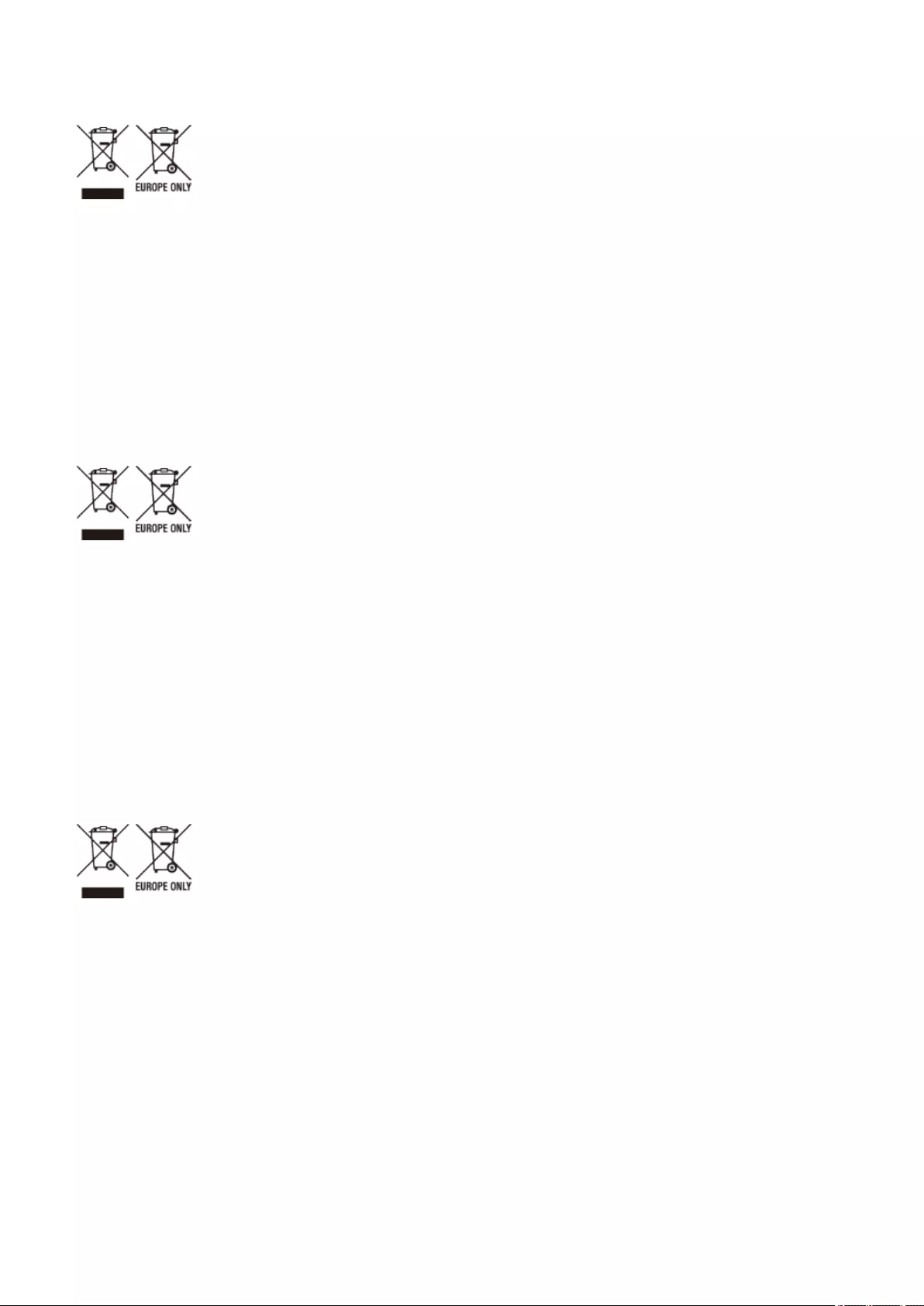
services municipaux, votre éco-organisme ou les autorités locales compétentes, ou consultez le site www.canon-
europe.com/weee, ou www.canon-europe.com/battery.
Uitsluitend bestemd voor de Europese Unie en EER (Noorwegen, IJsland en Liechtenstein)
Met deze symbolen wordt aangegeven dat dit product in overeenstemming met de AEEA-richtlijn (2012/19/EU), de
richtlijn 2006/66/EG betreffende batterijen en accu's en/of de plaatselijk geldende wetgeving waarin deze richtlijnen
zijn geïmplementeerd, niet bij het normale huisvuil mag worden weggegooid. Indien onder het hierboven getoonde
symbool een chemisch symbool gedrukt staat, geeft dit in overeenstemming met de richtlijn betreffende batterijen en
accu's aan dat deze batterij of accu een zwaar metaal bevat (Hg = kwik, Cd = cadmium, Pb = lood) waarvan de
concentratie de toepasselijke drempelwaarde in overeenstemming met de genoemde richtlijn overschrijdt. Dit product
dient te worden ingeleverd bij een hiervoor aangewezen inzamelpunt, bijv. door dit in te leveren bij een hiertoe erkend
verkooppunt bij aankoop van een gelijksoortig product, of bij een ociële inzameldienst voor de recycling van
elektrische en elektronische apparatuur (EEA) en batterijen en accu's. Door de potentieel gevaarlijke stoffen die
gewoonlijk gepaard gaan met EEA, kan onjuiste verwerking van dit type afval mogelijk nadelige gevolgen hebben voor
het milieu en de menselijke gezondheid. Uw medewerking bij het op juiste wijze weggooien van dit product draagt bij
tot effectief gebruik van natuurlijke hulpbronnen. Voor verdere informatie over recycling van dit product kunt u
contact opnemen met uw plaatselijke gemeente, afvaldienst, ociële dienst voor klein chemisch afval of
afvalstortplaats, of kunt u terecht op www.canon-europe.com/weee, of www.canon-europe.com/battery.
Sólo para la Unión Europea y el Área Económica Europea (Noruega, Islandia y Liechtenstein)
Estos iconos indican que este producto no debe desecharse con los residuos domésticos de acuerdo con la Directiva
sobre RAEE (2012/19/UE) y la Directiva sobre Pilas y Acumuladores (2006/66/CE) y/o la legislación nacional. Si aparece
un símbolo químico bajo este icono, de acuerdo con la Directiva sobre Pilas y Acumuladores, signica que la pila o el
acumulador contiene metales pesados (Hg = Mercurio, Cd = Cadmio, Pb = Plomo) en una concentración superior al
límite especicado en dicha directiva. Este producto deberá entregarse en un punto de recogida designado, por
ejemplo, entregándolo en el lugar de venta al adquirir un producto nuevo similar o en un centro autorizado para la
recogida de residuos de aparatos eléctricos y electrónicos (RAEE), baterías y acumuladores. La gestión incorrecta de
este tipo de residuos puede afectar al medio ambiente y a la salud humana debido a las sustancias potencialmente
nocivas que suelen contener estos aparatos. Su cooperación en la correcta eliminación de este producto contribuirá al
correcto aprovechamiento de los recursos naturales. Los usuarios tienen derecho a devolver pilas, acumuladores o
baterías usados sin coste alguno. El precio de venta de pilas, acumuladores y baterías incluye el coste de la gestión
medioambiental de su desecho, y no es necesario mostrar la cuantía de dicho coste en la información y la factura
suministradas a los usuarios nales. Si desea más información sobre el reciclado de este producto, póngase en
contacto con su municipio, el servicio o el organismo encargado de la gestión de residuos domésticos o visite
www.canon-europe.com/weee, o www.canon-europe.com/battery.
Només per a la Unió Europea i a l’Espai Econòmic Europeu (Noruega, Islàndia i Liechtenstein)
Aquests símbols indican que aquest producte no s’ha de llençar amb les escombraries de la llar, d’acord amb la RAEE
(2012/19/UE), la Directiva relativa a piles i acumuladors (2006/66/CE) i la legislació nacional que implementi aquestes
directives. Si al costat d’aquest símbol hi apareix imprès un símbol químic, segons especica la Directiva relativa a piles
i acumuladors, signica que la bateria o l’acumulador conté un metall pesant (Hg = mercuri, Cd = cadmi, Pb = plom) en
una concentració superior al límit aplicable especicat en la Directiva. Aquest producte s’hauria de lliurar en un dels
punts de recollida designats, com per exemple, intercanviant un per un en comprar un producte similar o lliurant-lo en
un lloc de recollida autoritzat per al reciclatge de residus d’aparells elèctrics i electrònics (RAEE) i piles i acumuladors.
La manipulació inadequada d’aquest tipus de residus podria tenir un impacte negatiu en l’entorn i en la salut humana,
a causa de les substàncies potencialment perilloses que normalment estan associades a l'RAEE. La vostra cooperació a
l’hora de rebutjar correctament aquest producte contribuirà a la utilització efectiva dels recursos naturals. Els usuaris
tenen dret a retornar les bateries o els acumuladors usats sense cap càrrec. El preu de venda de les bateries i els
acumuladors inclou el cost de la gestió ambiental dels residus i no es necessari mostrar l’import d’aquest cost en
aquest fullet o en la factura que es lliuri a l’usuari nal. Per a més informació sobre el reciclatge d’aquest producte,
contacteu amb l’ocina municipal, les autoritats encarregades dels residus, el pla de residus homologat o el servei de
recollida d’escombraries domèstiques de la vostra localitat o visiteu www.canon-europe.com/weee, o www.canon-
europe.com/battery.
Solo per Unione Europea e SEE (Norvegia, Islanda e Liechtenstein)
Appendix
748
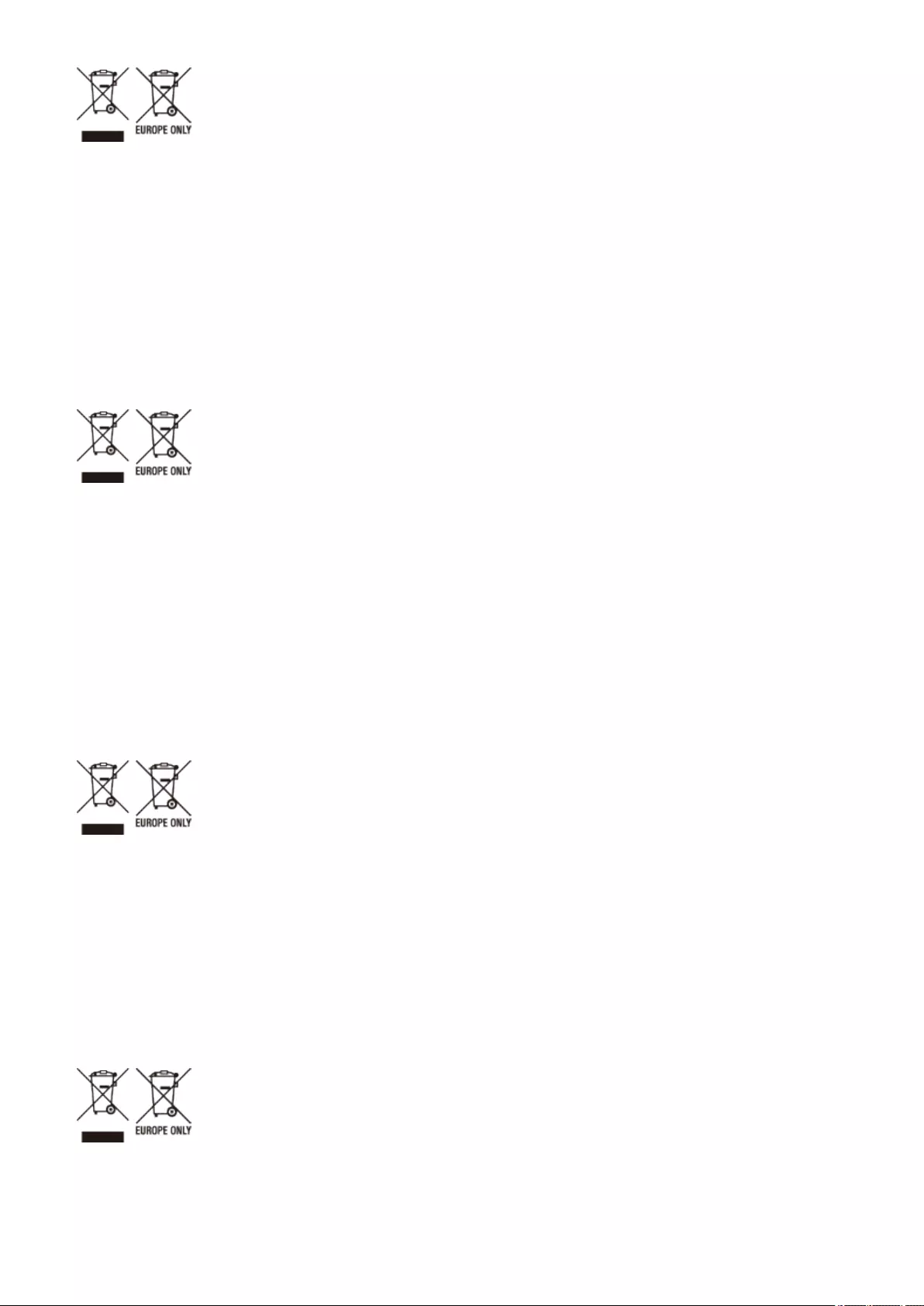
Questi simboli indicano che il prodotto non può essere smaltito con i riuti domestici, ai sensi della Direttiva RAEE
(2012/19/UE), della Direttiva sulle Batterie (2006/66/CE) e/o delle leggi nazionali che attuano tali Direttive. Se sotto il
simbolo indicato sopra è riportato un simbolo chimico, in osservanza della Direttiva sulle batterie, tale simbolo indica
la presenza di un metallo pesante (Hg = Mercurio, Cd = Cadmio, Pb = Piombo) nella batteria o nell'accumulatore con un
livello di concentrazione superiore a una soglia applicabile specicata nella Direttiva sulle batterie. Il prodotto deve
essere conferito a un punto di raccolta designato, ad esempio il rivenditore in caso di acquisto di un nuovo prodotto
simile oppure un centro di raccolta autorizzato per il riciclaggio di riuti di apparecchiature elettriche ed elettroniche
(RAEE) nonché di batterie e accumulatori. Un trattamento improprio di questo tipo di riuti può avere conseguenze
negative sull'ambiente e sulla salute umana a causa delle sostanze potenzialmente nocive solitamente contenute in
tali riuti. La collaborazione dell'utente per il corretto smaltimento di questo prodotto contribuirà a un utilizzo ecace
delle risorse naturali ed eviterà di incorrere in sanzioni amministrative ai sensi dell'art. 255 e successivi del Decreto
Legislativo n. 152/06. Per ulteriori informazioni sul riciclaggio di questo prodotto, contattare le autorità locali, l'ente
responsabile della raccolta dei riuti, un rivenditore autorizzato o il servizio di raccolta dei riuti domestici, oppure
visitare il sito www.canon-europe.com/weee, o www.canon-europe.com/battery.
Apenas para a União Europeia e AEE (Noruega, Islândia e Liechtenstein)
Estes símbolos indicam que este produto não deve ser eliminado juntamente com o seu lixo doméstico, segundo a
Diretiva REEE de 2012/19/UE, a Diretiva de Baterias (2006/66/CE) e/ou a sua legislação nacional que transponha estas
Diretivas. Se houver um símbolo químico impresso como mostrado abaixo, de acordo com a Diretiva de Baterias, isto
indica que um metal pesado (Hg = Mercúrio, Cd = Cádmio, Pb = Chumbo) está presente nesta pilha ou acumulador,
numa concentração acima de um limite aplicável especicado na Diretiva. Este produto deve ser entregue num ponto
de recolha designado, por exemplo num local autorizado de troca quando compra um equipamento novo idêntico, ou
num local de recolha autorizado para reciclar equipamento elétrico e eletrónico (EEE) em m de vida, bem como pilhas
e baterias. O tratamento inadequado deste tipo de resíduos pode ter um impacto negativo no ambiente e na saúde
humana, devido a substâncias potencialmente perigosas que estão associadas com equipamentos do tipo EEE. A sua
cooperação no tratamento correto deste produto irá contribuir para a utilização mais ecaz dos recursos naturais.
Para obter mais informações acerca de como reciclar este produto, por favor contacte as suas autoridades locais
responsáveis pela matéria, serviço de recolha aprovado para pilhas e baterias ou serviço de recolha de resíduos
sólidos domésticos da sua municipalidade, ou visite www.canon-europe.com/weee, ou www.canon-europe.com/
battery.
Gælder kun i Europæiske Union og EØS (Norge, Island og Liechtenstein)
Disse symboler betyder, at produktet ikke må bortskaffes sammen med dagrenovation i henhold til WEEE-direktivet
(2012/19/EU), batteridirektivet (2006/66/EF) og/eller den lokale lovgivning, som disse direktiver er gennemført i. Hvis
der i overensstemmelse med batteridirektivet er trykt et kemisk symbol under det symbol, der er vist ovenfor, betyder
det, at batteriet eller akkumulatoren indeholder tungmetaller (Hg = kviksølv, Cd = cadmium, Pb = bly) i en
koncentration, som ligger over de grænseværdier, der er beskrevet i batteridirektivet. Produktet skal aeveres på et
godkendt indsamlingssted, f.eks. i overensstemmelse med en godkendt én-til-én-procedure, når du indkøber et nyt
tilsvarende produkt, eller på et godkendt indsamlingssted for elektronikaffald samt for batterier og akkumulatorer.
Forkert håndtering af denne type affald kan medføre negative konsekvenser for miljøet og menneskers helbred på
grund af de potentielt sundhedsskadelige stoffer, der generelt kan forendes i elektrisk og elektronisk udstyr. Når du
foretager korrekt bortskaffelse af produktet, bidrager du til effektiv brug af naturressourcerne. Kontakt din kommune,
den lokale affaldsmyndighed, det lokale affaldsanlæg, eller besøg www.canon-europe.com/weee, eller www.canon-
europe.com/battery for at få ere oplysninger om genbrug af dette produkt.
Μόνο για την Ευρωπαϊκή Ένωση και τον ΕΟΧ (Νορβηγία, Ισλανδία και Λιχτενστάιν)
Αυτά τα σύμβολα υποδεικνύουν ότι αυτό το προϊόν δεν πρέπει να απορρίπτεται μαζί με τα οικιακά απορρίμματα,
σύμφωνα με την Οδηγία για τα Απόβλητα Ηλεκτρικού και Ηλεκτρονικού Εξοπλισμού (ΑΗΗΕ) (2012/19/ΕΕ), την Οδηγία
για τις Ηλεκτρικές Στήλες (2006/66/ΕΚ) ή/και την εθνική νομοθεσία που εφαρμόζει τις Οδηγίες εκείνες. Εάν κάποιο
χημικό σύμβολο είναι τυπωμένο κάτω από το σύμβολο που φαίνεται παραπάνω, σύμφωνα με την Οδηγία για τις
Appendix
749
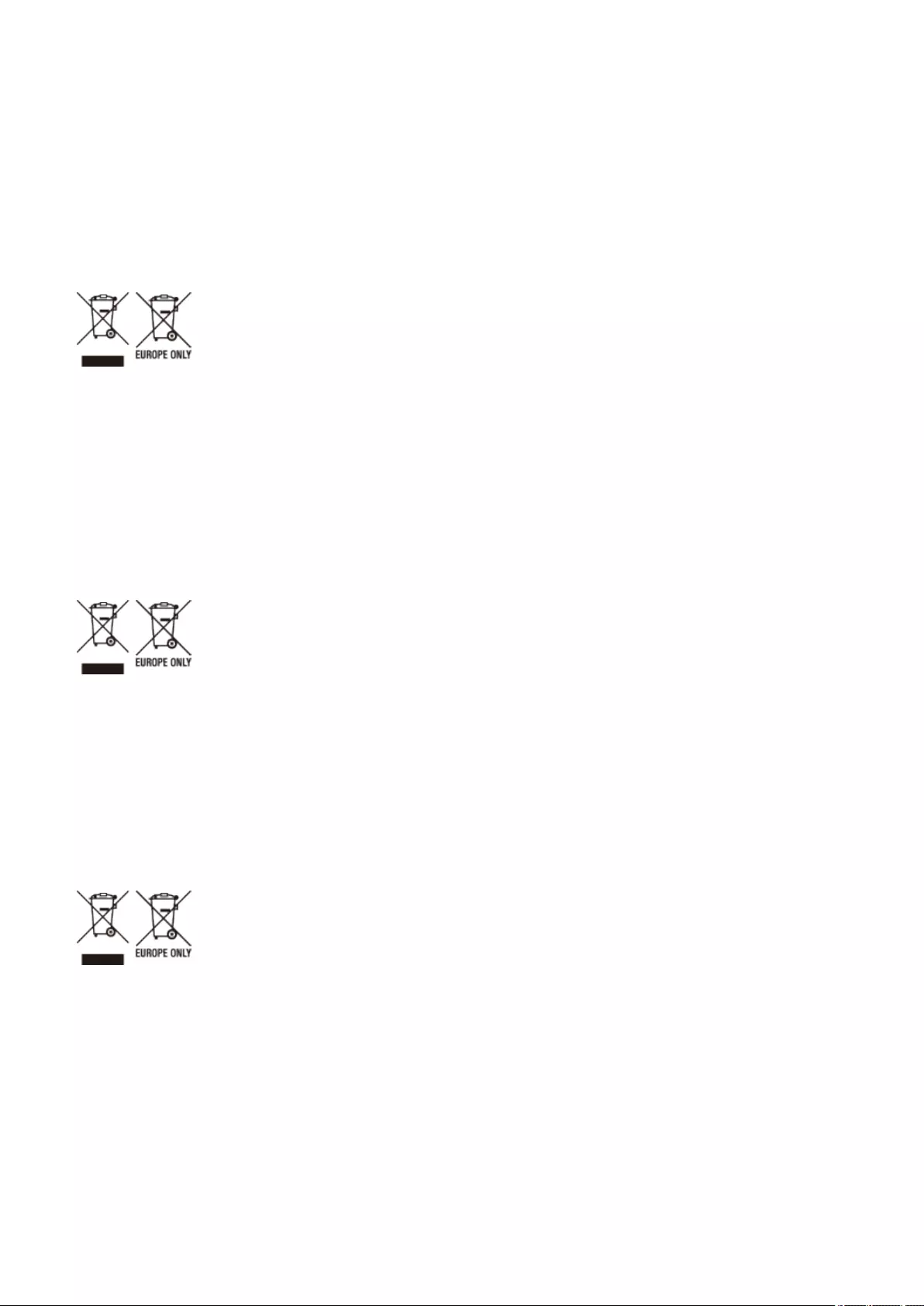
Ηλεκτρικές Στήλες, υποδηλώνει ότι κάποιο βαρύ μέταλλο (Hg = Υδράργυρος, Cd = Κάδμιο, Pb = Μόλυβδος) υπάρχει
στην μπαταρία ή τον συσσωρευτή σε συγκέντρωση μεγαλύτερη από το ισχύον επίπεδο που καθορίζεται στην Οδηγία
για τις Ηλεκτρικές Στήλες. Αυτό το προϊόν πρέπει να παραδίδεται σε καθορισμένο σημείο συλλογής, π.χ. σε μια
εξουσιοδοτημένη βάση ανταλλαγής όταν αγοράζετε ένα νέο παρόμοιο προϊόν ή σε μια εξουσιοδοτημένη θέση
συλλογής για την ανακύκλωση των αποβλήτων ηλεκτρικού και ηλεκτρονικού εξοπλισμού (ΗΗE) και των ηλεκτρικών
στηλών και συσσωρευτών. Ο ακατάλληλος χειρισμός αυτού του τύπου αποβλήτων μπορεί να έχει αρνητικό
αντίκτυπο στο περιβάλλον και την υγεία του ανθρώπου, λόγω δυνητικά επικίνδυνων ουσιών που γενικά συνδέονται
με τον ΗΗΕ. Η συνεργασία σας για τη σωστή απόρριψη αυτού του προϊόντος θα συμβάλει στην αποτελεσματική
χρήση των φυσικών πόρων. Για περισσότερες πληροφορίες σχετικά με ανακύκλωση αυτού του προϊόντος,
επικοινωνήστε με το τοπικό γραφείο της πόλης σας, την υπηρεσία απορριμμάτων, το εγκεκριμένο σχήμα ή την
υπηρεσία απόρριψης οικιακών αποβλήτων ή επισκεφθείτε τη διεύθυνση www.canon-europe.com/weee ή
www.canon-europe.com/battery.
Gjelder kun den europeiske union og EØS (Norge, Island og Liechtenstein)
Disse symbolene indikerer at dette produktet ikke skal kastes sammen med husholdningsavfall, i henhold til WEEE-
direktivet (2012/19/EU), batteridirektivet (2006/66/EF) og/eller nasjonal lov som har implementert disse direktivene.
Hvis et kjemisk symbol vises under symbolet vist ovenfor, i samsvar med batteridirektivet, indikerer dette at et
tungmetall (Hg = kvikksølv, Cd = kadmium, Pb = bly) nnes i batteriet eller akkumulatoren i en konsentrasjon over en
gjeldende øvre grense som er spesisert i batteridirektivet. Produktet må leveres til et dertil egnet innsamlingspunkt,
det vil si på en autorisert en-til-en-basis når en kjøper et nytt lignende produkt, eller til et autorisert innsamlingssted
for resirkulering av avfall fra elektrisk og elektronisk utstyr (EE-utstyr) og batterier og akkumulatorer. Feil håndtering
av denne typen avfall kan være miljø- og helseskadelig på grunn av potensielt skadelige stoffer som ofte brukes i EE-
utstyr. Din innsats for korrekt avhending av produktet vil bidra til effektiv bruk av naturressurser. Du kan få mer
informasjon om resirkulering av dette produktet ved å kontakte lokale myndigheter, avfallsadministrasjonen, et
godkjent program eller husholdningens renovasjonsselskap, eller gå til www.canon-europe.com/weee, eller
www.canon-europe.com/battery.
Vain Euroopan unionin sekä ETA:n (Norja, Islanti ja Liechtenstein) alueelle.
Nämä tunnukset osoittavat, että sähkö- ja elektroniikkalaiteromua koskeva direktiivi (SER-direktiivi, 2012/19/EU),
paristoista ja akuista annettu direktiivi (2006/66/EY) sekä kansallinen lainsäädäntö kieltävät tuotteen hävittämisen
talousjätteen mukana. Jos yllä olevan symbolin alapuolelle on paristodirektiivin mukaisesti painettu kemiallisen aineen
tunnus, kyseinen paristo tai akku sisältää raskasmetalleja (Hg = elohopea, Cd = kadmium, Pb = lyijy) enemmän kuin
paristodirektiivin salliman määrän. Tuote on vietävä asianmukaiseen keräyspisteeseen, esimerkiksi
kodinkoneliikkeeseen uutta vastaavaa tuotetta ostettaessa tai viralliseen sähkö- ja elektroniikkalaiteromun tai
paristojen ja akkujen keräyspisteeseen. Sähkö- ja elektroniikkalaiteromun virheellinen käsittely voi vahingoittaa
ympäristöä ja ihmisten terveyttä, koska laitteet saattavat sisältää ympäristölle ja terveydelle haitallisia aineita.
Tuotteen asianmukainen hävittäminen säästää myös luonnonvaroja. Jos haluat lisätietoja tämän tuotteen
kierrätyksestä, ota yhteys kunnan jätehuoltoviranomaisiin tai käyttämääsi jätehuoltoyhtiöön tai käy osoitteessa
www.canon-europe.com/weee, tai www.canon-europe.com/battery.
Endast för Europeiska unionen och EES (Norge, Island och Liechtenstein)
De här symbolerna visar att produkten inte får sorteras och slängas som hushållsavfall enligt WEEE-direktivet
(2012/19/EU), batteridirektivet (2006/66/EG) och/eller nationell lagstiftning som implementerar dessa direktiv. Om en
kemisk symbol förekommer under ovanstående symbol innebär detta enligt Batteridirektivet att en tungmetall (Hg =
Kvicksilver, Cd = Kadmium, Pb = Bly) förekommer i batteriet eller ackumulatorn med en koncentration som överstiger
tillämplig gräns som anges i Batteridirektivet. Produkten ska lämnas in på en avsedd insamlingsplats, t.ex. på en
återvinningsstation auktoriserad att hantera elektrisk och elektronisk utrustning (EE-utrustning) samt batterier och
ackumulatorer eller hos handlare som är auktoriserade att byta in varor då nya, motsvarande köps (en mot en).
Olämplig hantering av avfall av den här typen kan ha negativ inverkan på miljön och människors hälsa på grund av de
potentiellt farliga ämnen som kan åternnas i elektrisk och elektronisk utrustning. Din medverkan till en korrekt
avfallshantering av produkten bidrar till effektiv användning av naturresurserna. Om du vill ha mer information om
var du kan lämna in den här produkten, kontakta ditt lokala kommunkontor, berörd myndighet eller företag för
avfallshantering eller se www.canon-europe.com/weee, eller www.canon-europe.com/battery.
Pouze Evropská unie a EHP (Norsko, Island a Lichtenštejnsko)
Appendix
750
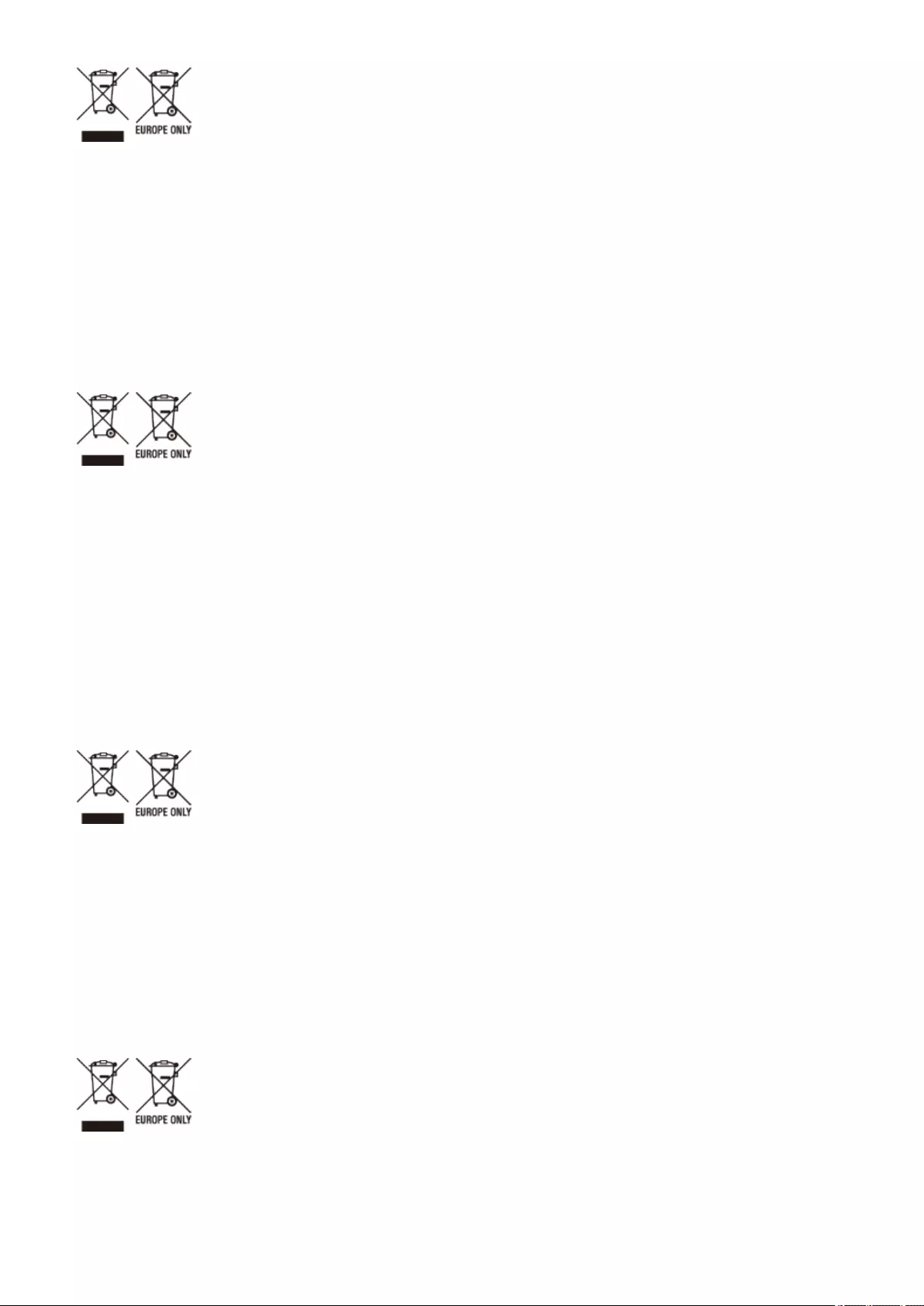
Tento symbol znamená, že podle směrnice OEEZ (2012/19/EU), směrnice o bateriích (2006/66/ES) a/nebo podle
vnitrostátních právních prováděcích předpisů k těmto směrnicím nemá být tento výrobek likvidován s odpadem z
domácností. Je-li v souladu s požadavky směrnice o bateriích vytištěna pod výše uvedeným symbolem chemická
značka, udává, že tato baterie nebo akumulátor obsahuje těžké kovy (Hg = rtuť, Cd = kadmium, Pb = olovo) v
koncentraci vyšší, než je příslušná hodnota předepsaná směrnicí. Tento výrobek má být vrácen do určeného sběrného
místa, např. v rámci autorizovaného systému odběru jednoho výrobku za jeden nově prodaný podobný výrobek, nebo
do autorizovaného sběrného místa pro recyklaci odpadních elektrických a elektronických zařízení (OEEZ), baterií a
akumulátorů. Nevhodné nakládání s tímto druhem odpadu by mohlo mít negativní dopad na životní prostředí a lidské
zdraví, protože elektrická a elektronická zařízení zpravidla obsahují potenciálně nebezpečné látky. Vaše spolupráce na
správné likvidaci tohoto výrobku napomůže efektivnímu využívání přírodních zdrojů. Chcete-li získat podrobné
informace týkající se recyklace tohoto výrobku, obraťte se prosím na místní úřad, orgán pro nakládání s odpady,
schválený systém nakládání s odpady či společnost zajišťující likvidaci domovního odpadu, nebo navštivte webové
stránky www.canon-europe.com/weee nebo www.canon-europe.com/battery.
Csak az Európai Unió és az EGT (Norvégia, Izland és Liechtenstein) országaiban
Ezek a szimbólumok azt jelzik, hogy a termék hulladékkezelése a háztartási hulladéktól különválasztva, az elektromos
és elektronikus berendezések hulladékairól (WEEE) szóló (2012/19/EU) irányelvnek és az elemekről és
akkumulátorokról, valamint a hulladék elemekről és akkumulátorokról szóló (2006/66/EK) irányelvnek megfelelően és/
vagy ezen irányelveknek megfelelő helyi előírások szerint történik. Amennyiben a fent feltüntetett szimbólum alatt egy
vegyjel is szerepel, az elemekről és akkumulátorokról szóló irányelvben foglaltak értelmében ez azt jelzi, hogy az elem
vagy az akkumulátor az irányelvben meghatározott határértéknél nagyobb mennyiségben tartalmaz nehézfémet (Hg =
higany, Cd = kadmium, Pb = ólom). E terméket az arra kijelölt gyűjtőhelyre kell juttatni – pl. hasonló termék
vásárlásakor a régi becserélésére vonatkozó hivatalos program keretében, vagy az elektromos és elektronikus
berendezések (EEE) hulladékainak gyűjtésére, valamint a hulladék elemek és hulladék akkumulátorok gyűjtésére
kijelölt hivatalos gyűjtőhelyre. Az ilyen jellegű hulladékok nem előírásszerű kezelése az elektromos és elektronikus
berendezésekhez (EEE) általánosan kapcsolható potenciálisan veszélyes anyagok révén hatással lehet a környezetre és
az egészségre. E termék megfelelő leselejtezésével Ön is hozzájárul a természeti források hatékony használatához. A
termék újrahasznosítását illetően informálódjon a helyi polgármesteri hivatalnál, a helyi közterület-fenntartó
vállalatnál, a hivatalos hulladéklerakó telephelyen vagy a háztartási hulladék begyűjtését végző szolgáltatónál, illetve
látogasson el a www.canon-europe.com/weee, vagy www.canon-europe.com/battery internetes oldalra.
Tylko dla krajów Unii Europejskiej oraz EOG (Norwegia, Islandia i Liechtenstein)
Te symbole oznaczają, że produktu nie należy wyrzucać razem z odpadami gospodarstwa domowego, zgodnie z
dyrektywą WEEE w sprawie zużytego sprzętu elektrycznego i elektronicznego (2012/19/UE) lub dyrektywą w sprawie
baterii (2006/66/WE) bądź przepisami krajowymi wdrażającymi te dyrektywy. Jeśli pod powyższym symbolem znajduje
się symbol chemiczny, zgodnie z dyrektywą w sprawie baterii oznacza to, że bateria lub akumulator zawiera metal
ciężki (Hg = rtęć, Cd = kadm, Pb = ołów) w stężeniu przekraczającym odpowiedni poziom określony w dyrektywie w
sprawie baterii. Użytkownicy baterii i akumulatorów mają obowiązek korzystać z dostępnego programu zwrotu,
recyklingu i utylizacji baterii oraz akumulatorów. Niewłaściwe postępowanie z tego typu odpadami może mieć wpływ
na środowisko i zdrowie ludzi ze względu na substancje potencjalnie niebezpieczne, związane ze zużytym sprzętem
elektrycznym i elektronicznym. Państwa współpraca w zakresie właściwej utylizacji tego produktu przyczyni się do
efektywnego wykorzystania zasobów naturalnych. W celu uzyskania informacji o sposobie recyklingu tego produktu
prosimy o kontakt z właściwym urzędem miejskim lub zakładem gospodarki komunalnej bądź zapraszamy na stronę
www.canon-europe.com/weee, lub www.canon-europe.com/battery.
Platí len pre štáty Európskej únie a EHP (Nórsko, Island a Lichtenštajnsko)
Tieto symboly označujú, že podľa Smernice o odpade z elektrických a elektronických zariadení (OEEZ) 2012/19/EÚ,
Smernice o batériách (2006/66/ES) a podľa platnej legislatívy Slovenskej republiky sa tento produkt nesmie likvidovať
spolu s komunálnym odpadom. Ak je chemická značka vytlačená pod vyššie uvedeným symbolom, znamená to, že táto
batéria alebo akumulátor obsahuje ťažký kov (Hg = ortuť, Cd = kadmium, Pb = olovo) v koncentrácii vyššej, ako je
príslušná povolená hodnota stanovená v Smernici o batériách. Produkt je potrebné odovzdať do určenej zberne, napr.
Appendix
751
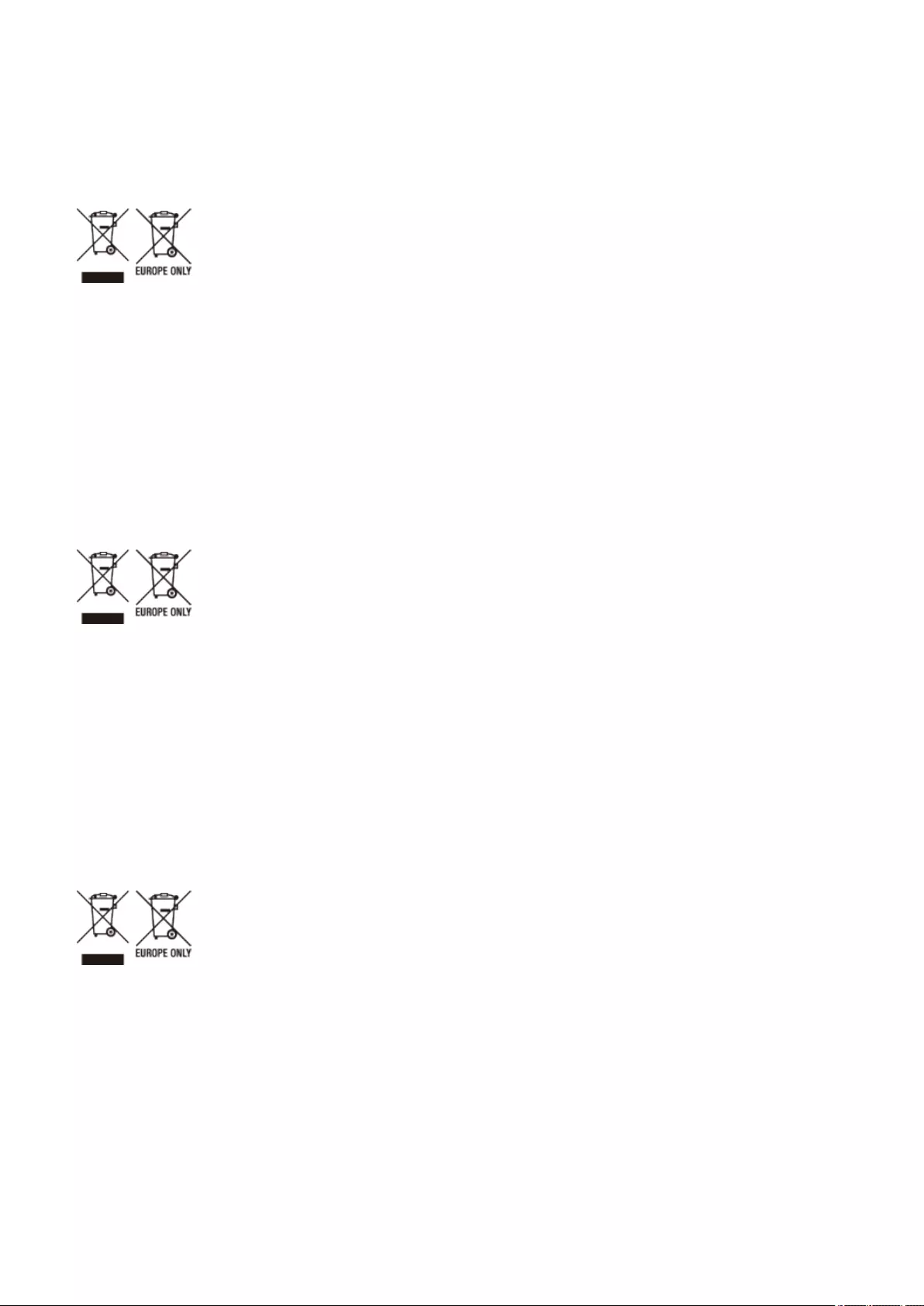
prostredníctvom výmeny za kúpu nového podobného produktu, alebo na autorizované zberné miesto, ktoré spracúva
odpad z elektrických a elektronických zariadení (EEZ), batérií a akumulátorov. Nesprávna manipulácia s takýmto typom
odpadu môže mať negatívny vplyv na životné prostredie a ľudské zdravie, pretože elektrické a elektronické zariadenia
obsahujú potenciálne nebezpečné látky. Spoluprácou na správnej likvidácii tohto produktu prispejete k účinnému
využívaniu prírodných zdrojov. Ďalšie informácie o recyklácii tohto produktu získate od miestneho úradu, úradu
životného prostredia, zo schváleného plánu OEEZ alebo od spoločnosti, ktorá zaisťuje likvidáciu komunálneho odpadu.
Viac informácií nájdete aj na webovej stránke: www.canon-europe.com/weee, alebo www.canon-europe.com/battery.
Üksnes Euroopa Liit ja EMP (Norra, Island ja Liechtenstein)
Antud sümbolid viitavad sellele, et vastavalt elektri- ja elektroonikaseadmete jäätmeid käsitlevale direktiivile (2012/19/
EL), patareisid ja akusid ning patarei- ja akujäätmeid käsitlevale direktiivile (2006/66/EÜ) ja/või nimetatud direktiive
rakendavatele riiklikele õigusaktidele ei või seda toodet koos olmejäätmetega ära visata. Kui keemiline sümbol on
trükitud eespool toodud sümboli alla, siis tähendab see, et antud patareis või akus leiduva raskemetalli (Hg =
elavhõbe, Cd = kaadmium, Pb = plii) kontsentratsioonitase on kõrgem kui patareisid ja akusid ning patarei- ja
akujäätmeid käsitlevas direktiivis sätestatud piirmäär. Antud tootest tekkinud jäätmed tuleb anda vastavasse
kogumispunkti, nt müügipunkti, mis on volitatud üks ühe vastu vahetama, kui ostate uue sarnase toote, või vastavasse
elektri- ja lektroonikaseadmete jäätmete ning patareide ja akude ümbertöötlemiseks mõeldud kogumispunkti. Antud
liiki jäätmete vale käitlemine võib kahjustada keskkonda ja inimeste tervist elektri- ja elektroonikajäätmetes tavaliselt
leiduvate potentsiaalselt ohtlike ainete tõttu. Antud tootest tekkinud jäätmete nõuetekohase kõrvaldamisega aitate
kasutada loodusvarasid efektiivselt. Täiendava teabe saamiseks elektri- ja elektroonikaseadmetest tekkinud jäätmete
ning patarei- ja akujäätmete tagastamise ja ümbertöötlemise kohta võtke ühendust kohaliku omavalitsusega,
asjakohase valitsusasutusega, asjakohase tootjavastutusorganisatsiooniga või olmejäätmete käitlejaga. Lisateavet
leitate ka Interneti-leheküljelt www.canon-europe.com/weee või www.canon-europe.com/battery.
Tikai Eiropas Savienībai un EEZ (Norvēģijai, Islandei un Lihtenšteinai)
Šie simboli norāda, ka atbilstoši ES Direktīvai (2012/19/ES) par elektrisko un elektronisko iekārtu atkritumiem (EEIA),
Direktīvai (2006/66/EK) par baterijām un akumulatoriem, un akumulatoru atkritumiem, ar ko atceļ Direktīvu 91/157/
EEK, un vietējiem tiesību aktiem šo izstrādājumu nedrīkst izmest kopā ar sadzīves atkritumiem. Ja zem iepriekš
norādītā simbola ir uzdrukāts ķīmiskais simbols, saskaņā ar direktīvu par baterijām un akumulatoriem tas nozīmē, ka
šīs baterijas vai akumulatori satur smagos metālus (Hg = dzīvsudrabs, Cd = kadmijs, Pb = svins) un to koncentrācijas
līmenis pārsniedz direktīvā par baterijām un akumulatoriem minēto piemērojamo slieksni. Šis izstrādājums ir jānodod
piemērotā savākšanas vietā, piemēram, apstiprinātā veikalā, kur iegādājaties līdzīgu jaunu produktu un atstājat veco,
vai apstiprinātā vietā izlietotu elektrisko un elektronisko iekārtu un bateriju un akumulatoru pārstrādei. Nepareiza
šāda veida atkritumu apsaimniekošana var apdraudēt vidi un cilvēka veselību tādu iespējami bīstamu vielu dēļ, kas
parasti ir elektriskajās un elektroniskajās iekārtās. Jūsu atbalsts pareizā šāda veida atkritumu apsaimniekošanā sekmēs
efektīvu dabas resursu izmantošanu. Lai saņemtu pilnīgāku informāciju par šāda veida izstrādājumu nodošanu
otrreizējai pārstrādei, sazinieties ar vietējo pašvaldību, atkritumu savākšanas atbildīgo dienestu, pilnvaroto
organizāciju vai iestādi, kas veic sadzīves atkritumu apsaimniekošanu, vai apmeklējiet tīmekļa vietni www.canon-
europe.com/weee, vai www.canon-europe.com/battery.
Tik Europos Sąjungai ir EEE (Norvegijai, Islandijai ir Lichtenšteinui)
Šie simboliai reiškia, kad šio gaminio negalima išmesti į buitines atliekas, kaip reikalaujama WEEE Direktyvoje
(2012/19/ES) ir Baterijų direktyvoje (2006/66/EB) ir (ar) jūsų šalies nacionaliniuose įstatymuose, kuriais šios Direktyvos
yra įgyvendinamos. Jeigu cheminio ženklo simbolis yra nurodytas žemiau šio ženklo, tai reiškia, kad vadovaujantis
Baterijų direktyvą, baterijų ar akumuliatorių sudėtyje yra sunkiųjų metalų (Hg = gyvsidabrio, Cd = kadmio, Pb = švino),
kurių koncentracija viršija Baterijų direktyvoje nurodytas leistinas ribas. Šį gaminį reikia pristatyti į specialųjį surinkimo
punktą, pavyzdžiui, mainais, kai jūs perkate naują panašų gaminį, arba į specialiąją surinkimo vietą, kurioje
perdirbamos elektrinės ir elektroninės įrangos atliekos bei naudotos baterijos ir akumuliatoriai. Dėl netinkamo šio tipo
atliekų tvarkymo gali nukentėti aplinka ir iškilti grėsmė žmogaus sveikatai dėl galimai kenksmingų medžiagų, iš esmės
susijusių su elektrine ir elektronine įranga. Bendradarbiaudami ir teisingai utilizuodami šiuos gaminius, jūs padėsite
efektyviai naudoti gamtinius išteklius. Daugiau informacijos apie gaminio perdirbimą jums gali suteikti vietinis biuras,
atliekų tvarkymo bendrovė, sertikuoti organai ar buitinių atliekų surinkimo įmonės. Taip pat siūloma apsilankyti
interneto svetainėje www.canon-europe.com/weee, arba www.canon-europe.com/battery.
Samo za Evropsko unijo in EGP (Norveška, Islandija in Lihtenštajn)
Appendix
752

Ti simboli pomenijo, da tega izdelka skladno z Direktivo OEEO (2012/19/EU), Direktivo 2006/66/ES in/ali nacionalno
zakonodajo, ki uvaja ti direktivi, ne smete odlagati z nesortiranimi gospodinjskimi odpadki. Če je pod zgoraj prikazanim
simbolom natisnjen kemijski simbol, to v skladu z Direktivo pomeni, da je v tej bateriji ali akumulatorju prisotna težka
kovina (Hg = živo srebro, Cd = kadmij, Pb = svinec), in sicer v koncentraciji, ki je nad relevantno mejno vrednostjo,
določeno v Direktivi. Ta izdelek je potrebno odnesti na izbrano zbirno mesto, t. j. pooblaščeno trgovino, kjer ob nakupu
novega (podobnega) izdelka vrnete starega, ali na pooblaščeno zbirno mesto za ponovno uporabo odpadne električne
in elektronske opreme (EEO) ter baterij in akumulatorjev. Neustrezno ravnanje s to vrsto odpadkov lahko negativno
vpliva na okolje in človeško zdravje zaradi potencialno nevarnih snovi, ki so pogosto povezane z EEO. Vaše sodelovanje
pri pravilnem odlaganju tega izdelka predstavlja pomemben prispevek k smotrni izrabi naravnih virov. Za več
informacij o ponovni uporabi tega izdelka se obrnite na lokalen mestni urad, pristojno službo za odpadke,
predstavnika pooblaščenega programa za obdelavo odpadkov ali na lokalno komunalo. Lahko pa tudi obiščete našo
spletno stran www.canon-europe.com/weee, ali www.canon-europe.com/battery.
Само за Европейския съюз и ЕИП (Норвегия, Исландия и Лихтенщайн)
Тези символи показват, че този продукт не трябва да се изхвърля заедно с битовите отпадъци съгласно
Директивата за ИУЕЕО (2012/19/ЕC), Директивата за батерии (2006/66/ЕО) и/или Вашето национално
законодателство, прилагащо тези Директиви. Ако под показания горе символ е отпечатан символ за химически
елемент, съгласно разпоредбите на Директивата за батерии, този втори символ означава наличието на тежък
метал (Hg = живак, Cd = кадмий, Pb = олово) в батерията или акумулатора в концентрация над указаната
граница за съответния елемент в Директивата. Този продукт трябва да бъде предаден в предназначен за целта
пункт за събиране, например на база размяна, когато купувате нов подобен продукт, или в одобрен
събирателен пункт за рециклиране на излязло от употреба електрическо и електронно оборудване (ИУЕЕО),
батерии и акумулатори. Неправилното третиране на този тип отпадъци може да доведе до евентуални
отрицателни последствия за околната среда и човешкото здраве поради потенциално опасните вещества,
които обикновено са свързани с ЕЕО. В същото време Вашето съдействие за правилното изхвърляне на този
продукт ще допринесе за ефективното използване на природните ресурси. За повече информация относно
това къде можете да предадете за рециклиране на този продукт, моля свържете се с Вашите местни власти, с
органа, отговорен за отпадъците, с одобрената система за ИУЕЕО или с Вашата местна служба за битови
отпадъци, или посетете www.canon-europe.com/weee, или www.canon-europe.com/battery.
Doar pentru Uniunea Europeană şi EEA (Norvegia, Islanda şi Liechtenstein)
Aceste simboluri indică faptul că acest produs nu trebuie aruncat împreună cu deşeurile menajere, în conformitate cu
Directiva DEEE (2012/19/UE), Directiva referitoare la baterii (2006/66/CE) şi/sau legile dvs. naţionale ce implementează
aceste Directive. Dacă un simbol chimic este imprimat sub simbolul de mai sus, în conformitate cu Directiva referitoare
la baterii, acest simbol indică prezenţa în baterie sau acumulator a unui metal greu (Hg = Mercur, Cd = Cadmiu, Pb =
Plumb) într-o concentraţie mai mare decât pragul admis specicat în Directiva referitoare la baterii. Acest produs
trebuie înmânat punctului de colectare adecvat, ex: printr-un schimb autorizat unu la unu atunci când cumpăraţi un
produs nou similar sau la un loc de colectare autorizat pentru reciclarea reziduurilor de echipament electric şi
electronic (EEE) şi baterii şi acumulatori. Administrarea neadecvată a acestui tip de deşeuri, ar putea avea un impact
asupra mediului şi asupra sănătăţii umane datorită substanţelor cu potenţial de risc care sunt în general asociate cu
EEE. Cooperarea dvs. în direcţia reciclării corecte a acestui produs va contribui la o utilizare ecientă a resurselor
naturale. Pentru mai multe informaţii despre reciclarea acestui produs, vă rugăm să contactaţi biroul dvs. local,
autorităţile responsabile cu deşeurile, schema aprobată sau serviciul dvs. responsabil cu deşeurile menajere sau
vizitaţi-ne la www.canon-europe.com/weee, sau www.canon-europe.com/battery.
Samo za Europsku uniju i EEA (Norveška, Island i Lihtenštajn)
Oznaka pokazuje da se ovaj proizvod ne smije odlagati s komunalnim i ostalim vrstama otpada, u skladu s direktivom
WEEE (2012/19/EC), Direktivom o baterijama (2006/66/EC) i Pravilnikom o gospodarenju otpadnim baterijama i
akumulatorima te Pravilnikom o gospodarenju otpadnim električnim i elektroničkim uređajima i opremom. Ako je
ispod prethodno prikazane oznake otisnut kemijski simbol, u skladu s Direktivom o baterijama, to znači da se u ovoj
bateriji ili akumulatoru nalazi teški metal (Hg = živa, Cd = kadmij, Pb = olovo) i da je njegova koncentracija iznad razine
Appendix
753
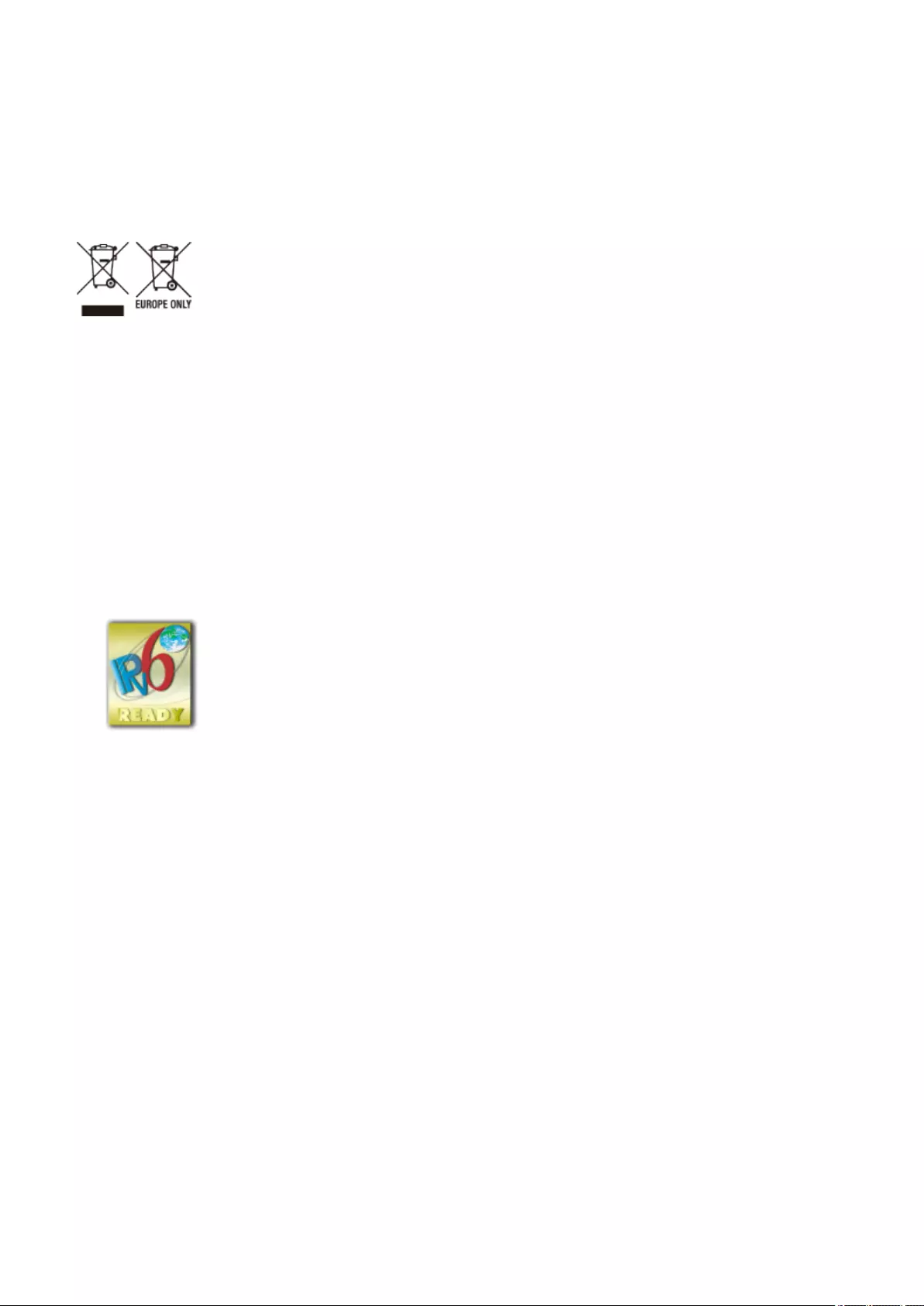
propisane u Direktivi o baterijama. Ovaj bi proizvod trebalo predati ovlašenom skupljaču EE otpada ili prodavatelju koji
je dužan preuzeti otpadni proizvod po sistemu jedan za jedan, ukoliko isti odgovara vrsti te je obavljao primarne
funkcije kao i isporučena EE oprema. Otpadne baterije i akumulatori predaju se ovlaštenom skupljaču otpadnih
baterija ili akumulatora ili prodavatelju bez naknade i obveze kupnje za krajnjeg korisnika. Neodgovarajuće rukovanje
ovom vrstom otpada može utjecati na okoliš i ljudsko zdravlje zbog potencijalno opasnih supstanci koje se najčešće
nalaze na takvim mjestima. Vaša suradnja u pravilnom zbrinjavanju ovog proizvoda pridonijet će djelotvornom
iskorištavanju prirodnih resursa. Dodatne informacije o recikliranju ovog proizvoda zatražite od svog lokalnog
gradskog ureda, službe za zbrinjavanje otpada, odobrenog programa ili komunalne službe za uklanjanje otpada ili pak
na stranicama www.canon-europe.com/weee ili www.canon-europe.com/battery.
Korisnici u Srbiji
Ovaj simbol označava da ovaj proizvod ne sme da se odlaže sa ostalim kućnim otpadom, u skladu sa WEEE Direktivom
(2012/19/EU), Direktivom o baterijama (2006/66/EC) i nacionalnim zakonima. Ukoliko je ispod gore navedenog simbola
odštampan hemijski simbol, u skladu sa Direktivom o baterijama, ovaj simbol označava da su u ovoj bateriji ili
akumulatoru prisutni teški metali (Hg – živa, Cd – kadmijum, Pb - olovo) u koncentracijama koje premašuju prihvatljivi
prag naveden u Direktivi o baterijama. Ovaj proizvod treba predati određenom centru za prikupljanje, npr. po principu
„jedan-za-jedan“ kada kupujete sličan novi proizvod, ili ovlašćenom centru za prikupljanje za reciklažu istrošene
električne i elektronske opreme (EEE), baterija i akumulatora. Nepravilno rukovanje ovom vrstom otpada može imati
negativne posledice po životnu sredinu i ljudsko zdravlje usled potencijalno opasnih materijala koji se uglavnom vezuju
za EEE. Vaša saradnja na ispravnom odlaganju ovog proizvoda će doprineti ekasnom korišćenju prirodnih resursa.
Više informacija o tome kako možete da reciklirate ovaj proizvod potražite od lokalnih gradskih vlasti, komunalne
službe, odobrenog plana reciklaže ili servisa za odlaganje kućnog otpada, ili posetite stranicu www.canon-europe.com/
weee, ili www.canon-europe.com/battery.
◼IPv6 Ready Logo
The protocol stack included in this machine has obtained the IPv6 Ready Logo Phase-2
established by the IPv6 Forum.
◼Disclaimers
●The information in this document is subject to change without notice.
●CANON INC. MAKES NO WARRANTY OF ANY KIND WITH REGARD TO THIS MATERIAL, EITHER EXPRESS OR IMPLIED,
EXCEPT AS PROVIDED HEREIN, INCLUDING WITHOUT LIMITATION, THEREOF, WARRANTIES AS TO MARKETABILITY,
MERCHANTABILITY, FITNESS FOR A PARTICULAR PURPOSE OF USE, OR NON-INFRINGEMENT. CANON INC. SHALL
NOT BE LIABLE FOR ANY DIRECT, INCIDENTAL, OR CONSEQUENTIAL DAMAGES OF ANY NATURE, OR LOSSES OR
EXPENSES RESULTING FROM THE USE OF THIS MATERIAL.
◼Trademarks
Adobe, Acrobat, and Reader are registered trademarks of Adobe Systems Incorporated in the United States and/or
other countries.
Apple, Bonjour, iPad, iPhone, iPod touch, Mac, macOS, OS X and Safari are trademarks of Apple Inc.
Microsoft, Windows, Windows Server, Internet Explorer, Word and Excel are either registered trademarks or
trademarks of Microsoft Corporation in the United States and/or other countries.
iOS is a trademark or registered trademark of Cisco in the U.S. and other countries and is used under license.
Android is a registered trademark of Google Inc.
This product contains the Universal Font Scaling Technology or UFST® under license from Monotype Imaging, Inc.
UFST® is a trademark of Monotype Imaging, Inc. registered in the United States Patent and Trademark Oce and may
be registered in certain jurisdictions.
UFST: Copyright © 1989 - 1996, 1997, 2003, 2004, 2008, all rights reserved, by Monotype Imaging Inc.
Appendix
754

Adobe, PostScript, and the PostScript logo are either registered trademarks or trademarks of Adobe Systems
Incorporated in the United States and/or other countries.
Copyright © 2007 -08 Adobe Systems Incorporated. All rights reserved.
Protected by U.S. Patents 5,737,599; 5,781,785; 5,819,301; 5,929,866; 5,943,063; 6,073,148; 6,515,763; 6,639,593;
6,754,382; 7,046,403; 7,213,269; 7,242,415; Patents pending in the U.S. and other countries.
All instances of the name PostScript in the text are references to the PostScript language as dened by Adobe Systems
Incorporated unless otherwise stated. The name PostScript also is used as a product trademark for Adobe Systems'
implementation of the PostScript language interpreter.
Except as otherwise stated, any reference to a "PostScript printing device," "PostScript display device," or similar item
refers to a printing device, display device or item (respectively) that contains PostScript technology created or licensed
by Adobe Systems Incorporated and not to devices or items that purport to be merely compatible with the PostScript
language.
Adobe, the Adobe logo, PostScript, the PostScript logo, and PostScript 3 are either registered trademarks or
trademarks of Adobe Systems Incorporated in the United States and/or other countries.
Linux is a registered trademark of Linus Torvalds. Microsoft and Windows are either registered trademarks or
trademarks of Microsoft Corporation in the United States and/or other countries.
All other trademarks are the property of their respective owners.
The PDF logo is a trademark or registered trademark of Adobe Systems Incorporated in the United States and other
countries.
Copyright © 2008 Adobe Systems Incorporated. All rights reserved.
Protected by U.S. Patents 6,185,684; 6,205,549; 7,213,269; 7,272,628; 7,278,168; Patents pending in the U.S. and other
countries.
Appendix
755

All instances of the name PostScript in the text are references to the PostScript language as dened by Adobe Systems
Incorporated unless otherwise stated. The name PostScript also is used as a product trademark for Adobe Systems'
implementation of the PostScript language interpreter.
Except as otherwise stated, any reference to a "PostScript printing device," "PostScript display device," or similar item
refers to a printing device, display device or item (respectively) that contains PostScript technology created or licensed
by Adobe Systems Incorporated and not to devices or items that purport to be merely compatible with the PostScript
language.
Adobe, the Adobe logo, Adobe LiveCycle® Policy Server, PostScript, the PostScript Logo, and PostScript 3 are either
registered trademarks or trademarks of Adobe Systems Incorporated in the United States and/or other countries.
All other trademarks are the property of their respective owners.
All other product and brand names are registered trademarks, trademarks or service marks of their respective owners.
◼Copyright
Reproduction of the contents of this document in whole or in part without prior permission is prohibited.
Appendix
756

Drivers
Drivers .................................................................................................................................................................. 758
Windows ............................................................................................................................................................. 759
macOS ................................................................................................................................................................ 761
Drivers
757

Windows
2579-0J3
Manuals are available on how to install and use the Windows printer drivers, FAX drivers, and scanner drivers. Click on
the link for the required manual.
Printer Drivers(P. 759)
FAX Drivers(P. 759)
Scanner Drivers(P. 759)
V4 Printer Drivers(P. 760)
Printer Drivers
◼WG Driver
Install Guide
◼UFR II Printer Driver
User's Guide
◼PCL6 Printer Driver
User's Guide
◼PS3 Printer Driver
User's Guide
FAX Drivers
User's Guide
Scanner Drivers
◼ScanGear WG
User's Guide
◼WG Scan Utility
User's Guide
Drivers
759

V4 Printer Drivers
Install & User's Guide
Drivers
760

macOS
2579-0J4
Manuals are available on how to install and use the macOS printer drivers, FAX drivers, and scanner drivers. Click on
the link for the required manual.
Printer Drivers(P. 761)
FAX Drivers(P. 761)
Scanner Drivers(P. 761)
Printer Drivers
◼UFR II Printer Driver
User's Guide
FAX Drivers
User's Guide
Scanner Drivers
◼ScanGear MF
User's Guide
Drivers
761

This Font Software is licensed under the SIL Open Font License,
Version 1.1.
This license is copied below, and is also available with a FAQ at:
http://scripts.sil.org/OFL
-----------------------------------------------------------
SIL OPEN FONT LICENSE Version 1.1 - 26 February 2007
-----------------------------------------------------------
PREAMBLE
The goals of the Open Font License (OFL) are to stimulate worldwide
development of collaborative font projects, to support the font
creation efforts of academic and linguistic communities, and to
provide a free and open framework in which fonts may be shared and
improved in partnership with others.
The OFL allows the licensed fonts to be used, studied, modied and
redistributed freely as long as they are not sold by themselves. The
fonts, including any derivative works, can be bundled, embedded,
redistributed and/or sold with any software provided that any reserved
names are not used by derivative works. The fonts and derivatives,
however, cannot be released under any other type of license. The
requirement for fonts to remain under this license does not apply to
any document created using the fonts or their derivatives.
DEFINITIONS
"Font Software" refers to the set of les released by the Copyright
Holder(s) under this license and clearly marked as such. This may
include source les, build scripts and documentation.
"Reserved Font Name" refers to any names specied as such after the
copyright statement(s).
"Original Version" refers to the collection of Font Software
components as distributed by the Copyright Holder(s).
"Modied Version" refers to any derivative made by adding to,
deleting, or substituting -- in part or in whole -- any of the
components of the Original Version, by changing formats or by porting
the Font Software to a new environment.
"Author" refers to any designer, engineer, programmer, technical
writer or other person who contributed to the Font Software.
PERMISSION & CONDITIONS
Permission is hereby granted, free of charge, to any person obtaining
a copy of the Font Software, to use, study, copy, merge, embed,
modify, redistribute, and sell modied and unmodied copies of the
Font Software, subject to the following conditions:
SIL OPEN FONT LICENSE
762

1) Neither the Font Software nor any of its individual components, in
Original or Modied Versions, may be sold by itself.
2) Original or Modied Versions of the Font Software may be bundled,
redistributed and/or sold with any software, provided that each copy
contains the above copyright notice and this license. These can be
included either as stand-alone text les, human-readable headers or
in the appropriate machine-readable metadata elds within text or
binary les as long as those elds can be easily viewed by the user.
3) No Modied Version of the Font Software may use the Reserved Font
Name(s) unless explicit written permission is granted by the
corresponding Copyright Holder. This restriction only applies to the
primary font name as presented to the users.
4) The name(s) of the Copyright Holder(s) or the Author(s) of the Font
Software shall not be used to promote, endorse or advertise any
Modied Version, except to acknowledge the contribution(s) of the
Copyright Holder(s) and the Author(s) or with their explicit written
permission.
5) The Font Software, modied or unmodied, in part or in whole,
must be distributed entirely under this license, and must not be
distributed under any other license. The requirement for fonts to
remain under this license does not apply to any document created using
the Font Software.
TERMINATION
This license becomes null and void if any of the above conditions are
not met.
DISCLAIMER
THE FONT SOFTWARE IS PROVIDED "AS IS", WITHOUT WARRANTY OF ANY KIND,
EXPRESS OR IMPLIED, INCLUDING BUT NOT LIMITED TO ANY WARRANTIES OF
MERCHANTABILITY, FITNESS FOR A PARTICULAR PURPOSE AND NONINFRINGEMENT
OF COPYRIGHT, PATENT, TRADEMARK, OR OTHER RIGHT. IN NO EVENT SHALL THE
COPYRIGHT HOLDER BE LIABLE FOR ANY CLAIM, DAMAGES OR OTHER LIABILITY,
INCLUDING ANY GENERAL, SPECIAL, INDIRECT, INCIDENTAL, OR CONSEQUENTIAL
DAMAGES, WHETHER IN AN ACTION OF CONTRACT, TORT OR OTHERWISE, ARISING
FROM, OUT OF THE USE OR INABILITY TO USE THE FONT SOFTWARE OR FROM
OTHER DEALINGS IN THE FONT SOFTWARE.
SIL OPEN FONT LICENSE
763

- 1 -
Third-Party Services
If you use third-party services through the PRODUCT, use of the services are subjected the conditions below.
When you access and/or obtain some third party content (such as text, images, videos, audios, or software)
through the SOFTWARE, except as expressly permitted by the content owner or by applicable law, you may
not (a) scrape, build databases or otherwise create permanent copies of such content, or keep cached copies
longer than permitted by the cache header; (b) copy, translate, modify, create a derivative work of, sell, lease,
lend, convey, distribute, publicly display or sublicense to any third party; (c) misrepresent the source or
ownership; and (d) remove, obscure, or alter any copyright, trademark or other proprietary rights notices, falsify
or delete any author attributions, legal notices or other labels of the origin or source of material.
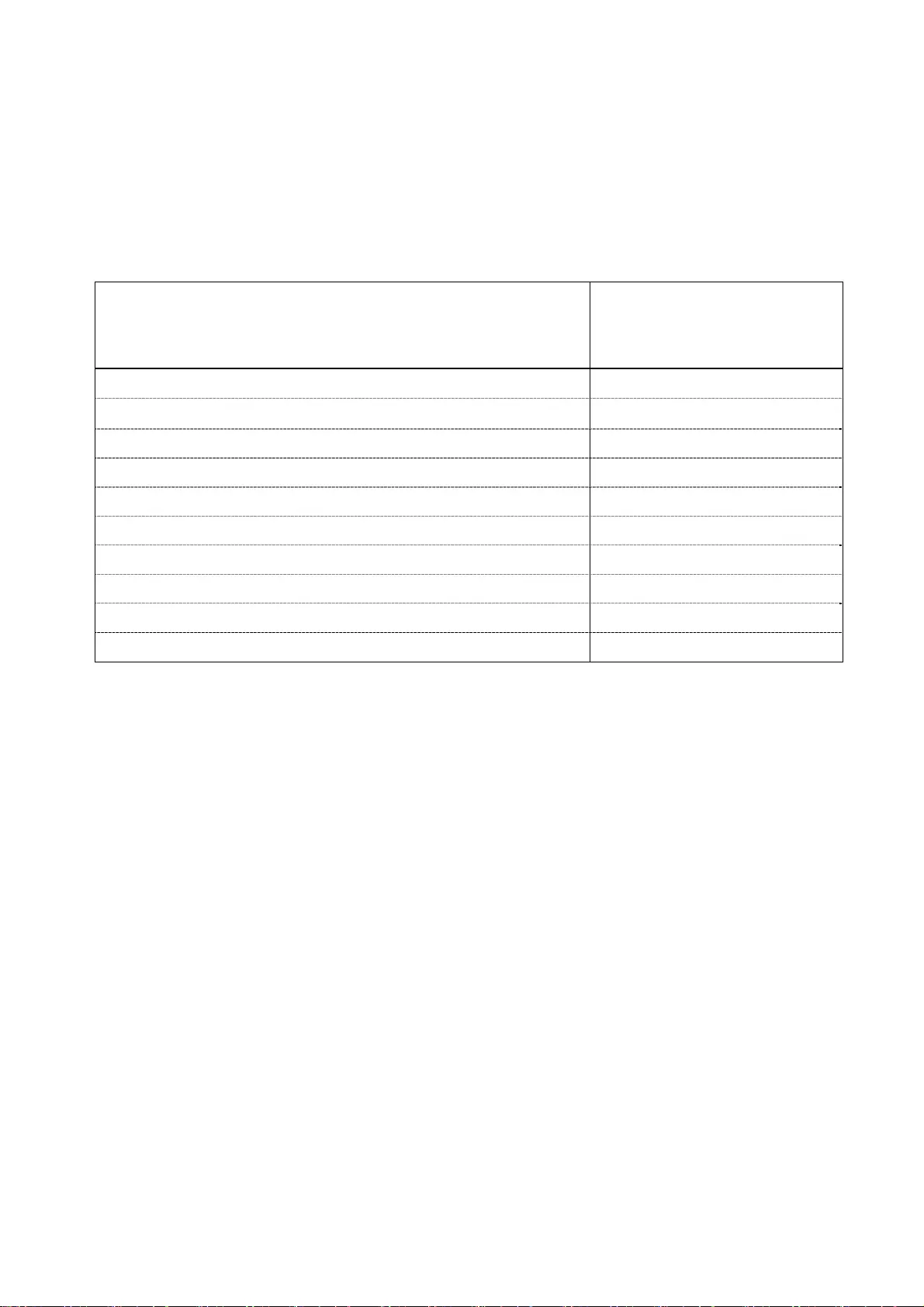
- 2 -
The Software Subjected to Other License Conditions
Please refer to Table of Software and respective License terms below, for more detail and corresponding
license conditions.
Table of Software
Names of Software Terms and Conditions of the
License:
See Page
Adobe PDF Scan Library 3
Adobe PostScript 3 6
expat 13
HarfBuzz 2012-07-30 14
libjingle 15
Lua 16
LuaSocket 17
MD4 18
Net-SNMP 19
OpenSSL 27

- 3 -
Adobe PDF Scan Library
Portions use software under the following terms:
______________________________________________________________________________________
This product contains either BSAFE and/or TIPEM software by RSA Security Inc.
______________________________________________________________________________________
This product includes software developed by the Apache Software Foundation (http://www.apache.org/).
Copyright (c) 1998-2000 The Apache Software Foundation. All rights reserved.
Redistribution and use in source and binary forms, with or without modification, are permitted provided that the
following conditions are met:
1. Redistributions of source code must retain the above copyright notice, this list of conditions and the
following disclaimer.
2. Redistributions in binary form must reproduce the above copyright notice, this list of conditions and the
following disclaimer in the documentation and/or other materials provided with the distribution.
3. The end-user documentation included with the redistribution, if any, must include the following
acknowledgment:
"This product includes software developed by the Apache Software Foundation (http://www.apache.org/)."
Alternately, this acknowledgment may appear in the software itself, if and wherever such third-party
acknowledgments normally appear.
4. The names "Xerces" and "Apache Software Foundation" must not be used to endorse or promote products
derived from this software without prior written permission. For written permission, please contact
apache@apache.org.
5. Products derived from this software may not be called "Apache", nor may "Apache" appear in their name,
without prior written permission of the Apache Software Foundation.
THIS SOFTWARE IS PROVIDED ``AS IS'' AND ANY EXPRESSED OR IMPLIED WARRANTIES,
INCLUDING, BUT NOT LIMITED TO, THE IMPLIED WARRANTIES OF MERCHANTABILITY AND FITNESS
FOR A PARTICULAR PURPOSE ARE DISCLAIMED. IN NO EVENT SHALL THE APACHE SOFTWARE
FOUNDATION OR ITS CONTRIBUTORS BE LIABLE FOR ANY DIRECT, INDIRECT, INCIDENTAL,
SPECIAL, EXEMPLARY, OR CONSEQUENTIAL DAMAGES (INCLUDING, BUT NOT LIMITED TO,
PROCUREMENT OF SUBSTITUTE GOODS OR SERVICES; LOSS OF USE, DATA, OR PROFITS; OR
BUSINESS INTERRUPTION) HOWEVER CAUSED AND ON ANY THEORY OF LIABILITY, WHETHER IN
CONTRACT, STRICT LIABILITY, OR TORT (INCLUDING NEGLIGENCE OR OTHERWISE) ARISING IN
ANY WAY OUT OF THE USE OF THIS SOFTWARE, EVEN IF ADVISED OF THE POSSIBILITY OF SUCH
DAMAGE.

- 4 -
This software consists of voluntary contributions made by many individuals on behalf of the Apache Software
Foundation and was originally based on software copyright (c) 1999, International Business Machines, Inc.,
http://www.ibm.com. For more information on the Apache Software Foundation, please see
<http://www.apache.org/>.
______________________________________________________________________________________
March 27, 2003
Portions of this product are based on Modifications created from the Original Code known as the "Sablotron
XSLT Processor". The Sablotron XSLT Processor is subject to the Mozilla Public License Version 1.1 (the
"License"). You may obtain a copy of
the License at http://www.mozilla.org/MPL/
Software distributed under the License is distributed on an "AS IS" basis, WITHOUT WARRANTY OF ANY
KIND, either express or implied. See the License for the specific language governing rights and limitations
under the License.
The Original Code is the Sablotron XSLT Processor.
The Initial Developer of the Original Code is Ginger Alliance Ltd. Portions created by Ginger Alliance are
Copyright (C) 2000 Ginger Alliance Ltd. All Rights Reserved.
Pursuant to sections 3.2 and 3.6 of the License, the Modifications created by Adobe Systems Incorporated
are available as Source Code. The Modifications may be downloaded via the Internet from:
http://partners.adobe.com/asn/tech/xml/sablotron/index.jsp
The Original Code may be downloaded via the Internet from:
https://sourceforge.net/projects/sablotron/
______________________________________________________________________________________
Portions Copyright (c) 1997-1999 Silicon Graphics Computer Systems, Inc.
Permission to use, copy, modify, distribute and sell this software and its documentation for any purpose is
hereby granted without fee, provided that the above copyright notice appear in all copies and that both that
copyright notice and this permission notice appear in supporting documentation. Silicon Graphics makes no
representations about the suitability of this software for any purpose. It is provided "as is" without express or
implied warranty.
______________________________________________________________________________________

- 5 -
The Loki Library
Portions Copyright (c) 2001 by Andrei Alexandrescu . This code accompanies the book: Alexandrescu,
Andrei. "Modern C++ Design: Generic Programming and Design Patterns Applied".
Portions Copyright (c) 2001. Addison-Wesley. Permission to use, copy, modify, distribute and sell this
software for any purpose is hereby granted without fee, provided that the above copyright notice appear in all
copies and that both that copyright notice and this permission notice appear in supporting documentation.
The author or Addison-Wesley Longman make no representations about the suitability of this software for any
purpose. It is provided "as is" without express or implied warranty.
______________________________________________________________________________________
Updated Information/Additional Third Party Code Information available at
http://www.adobe.com/go/thirdparty .
______________________________________________________________________________________

- 6 -
Adobe PostScript 3
Copyright 2007-2008 Adobe Systems Incorporated and its licensors. All rights reserved.
Portions include software under the following terms:
______________________________________________________________________________________
This product contains either BSAFE and/or TIPEM software by RSA Security Inc.
______________________________________________________________________________________
Portions of Pool.c_Copyright 1987 - NeXT, Inc., and portions of Graphics.c_Copyright 1988 NeXT, Inc. as an
unpublished work. All Rights Reserved.
______________________________________________________________________________________
The Apache Software License, Version 1.1
This product includes software developed by the Apache Software Foundation (http://www.apache.org/).
Portions Copyright (c) 1998-2000 The Apache Software Foundation. All rights reserved.
Redistribution and use in source and binary forms, with or without modification, are permitted provided that the
following conditions are met:
1. Redistributions of source code must retain the above copyright notice, this list of conditions and the
following disclaimer.
2. Redistributions in binary form must reproduce the above copyright notice, this list of conditions and the
following disclaimer in the documentation and/or other materials provided with the distribution.
3. The end-user documentation included with the redistribution, if any, must include the following
acknowledgment:
"This product includes software developed by the Apache Software Foundation (http://www.apache.org/)."
Alternately, this acknowledgment may appear in the software itself, if and wherever such third-party
acknowledgments normally appear.
4. The names "Xerces" and "Apache Software Foundation" must not be used to endorse or promote products
derived from this software without prior written permission. For written permission, please contact
apache@apache.org.
5. Products derived from this software may not be called "Apache", nor may "Apache" appear in their name,
without prior written permission of the Apache Software Foundation.
THIS SOFTWARE IS PROVIDED ``AS IS'' AND ANY EXPRESSED OR IMPLIED WARRANTIES,
INCLUDING, BUT NOT LIMITED TO, THE IMPLIED WARRANTIES OF MERCHANTABILITY AND FITNESS
FOR A PARTICULAR PURPOSE ARE DISCLAIMED. IN NO EVENT SHALL THE APACHE SOFTWARE
FOUNDATION OR ITS CONTRIBUTORS BE LIABLE FOR ANY DIRECT, INDIRECT, INCIDENTAL,
SPECIAL, EXEMPLARY, OR CONSEQUENTIAL DAMAGES (INCLUDING, BUT NOT LIMITED TO,

- 7 -
PROCUREMENT OF SUBSTITUTE GOODS OR SERVICES; LOSS OF USE, DATA, OR PROFITS; OR
BUSINESS INTERRUPTION) HOWEVER CAUSED AND ON ANY THEORY OF LIABILITY, WHETHER IN
CONTRACT, STRICT LIABILITY, OR TORT (INCLUDING NEGLIGENCE OR OTHERWISE) ARISING IN
ANY WAY OUT OF THE USE OF THIS SOFTWARE, EVEN IF ADVISED OF THE POSSIBILITY OF SUCH
DAMAGE.
This software consists of voluntary contributions made by many individuals on behalf of the Apache Software
Foundation and was originally based on software copyright (c) 1999, International Business Machines, Inc.,
http://www.ibm.com. For more information on the Apache Software Foundation, please see
<http://www.apache.org/>.
______________________________________________________________________________________
This product includes software developed by the University of California, Berkeley and its contributors.
Portions Copyright (c) 1990 The Regents of the University of California. All rights reserved.
Redistribution and use in source and binary forms, with or without modification, are permitted provided that the
following conditions are met:
1. Redistributions of source code must retain the above copyright notice, this list of conditions and the
following disclaimer.
2. Redistributions in binary form must reproduce the above copyright notice, this list of conditions and the
following disclaimer in the documentation and/or other materials provided with the distribution.
3. All advertising materials mentioning features or use of this software must display the following
acknowledgement:
This product includes software developed by the University of California, Berkeley and its contributors.
4. Neither the name of the University nor the names of its contributors may be used to endorse or promote
products derived from this software without specific prior written permission.
THIS SOFTWARE IS PROVIDED BY THE REGENTS AND CONTRIBUTORS "AS IS" AND ANY EXPRESS
OR IMPLIED WARRANTIES, INCLUDING, BUT NOT LIMITED TO, THE IMPLIED WARRANTIES OF
MERCHANTABILITY AND FITNESS FOR A PARTICULAR PURPOSE ARE DISCLAIMED. IN NO EVENT
SHALL THE REGENTS OR CONTRIBUTORS BE LIABLE FOR ANY DIRECT, INDIRECT, INCIDENTAL,
SPECIAL, EXEMPLARY, OR CONSEQUENTIAL DAMAGES (INCLUDING, BUT NOT LIMITED TO,
PROCUREMENT OF SUBSTITUTE GOODS OR SERVICES; LOSS OF USE, DATA, OR PROFITS; OR
BUSINESS INTERRUPTION) HOWEVER CAUSED AND ON ANY THEORY OF LIABILITY, WHETHER IN
CONTRACT, STRICT LIABILITY, OR TORT (INCLUDING NEGLIGENCE OR OTHERWISE) ARISING IN
ANY WAY OUT OF THE USE OF THIS SOFTWARE, EVEN IF ADVISED OF THE POSSIBILITY OF SUCH
DAMAGE.
______________________________________________________________________________________
Portions Copyright (c) 1985, 1986 The Regents of the University of California. All rights reserved.

- 8 -
This code is derived from software contributed to Berkeley by James A. Woods, derived from original work by
Spencer Thomas and Joseph Orost.
Redistribution and use in source and binary forms are permitted provided that the above copyright notice and
this paragraph are duplicated in all such forms and that any documentation, advertising materials, and other
materials related to such distribution and use acknowledge that the software was developed by the University
of California, Berkeley. The name of the University may not be used to endorse or promote products derived
from this software without specific prior written permission.
THIS SOFTWARE IS PROVIDED ``AS IS'' AND WITHOUT ANY EXPRESS OR IMPLIED WARRANTIES,
INCLUDING, WITHOUT LIMITATION, THE IMPLIED WARRANTIES OF MERCHANTIBILITY AND FITNESS
FOR A PARTICULAR PURPOSE.
Portions Copyright (c) 1993 X Consortium
Permission is hereby granted, free of charge, to any person obtaining a copy of this software and associated
documentation files (the "Software"), to deal in the Software without restriction, including without limitation the
rights to use, copy, modify, merge, publish, distribute, sublicense, and/or sell copies of the Software, and to
permit persons to whom the Software is furnished to do so, subject to the following conditions:
The above copyright notice and this permission notice shall be included in all copies or substantial portions of
the Software.
THE SOFTWARE IS PROVIDED "AS IS", WITHOUT WARRANTY OF ANY KIND, EXPRESS ORIMPLIED,
INCLUDING BUT NOT LIMITED TO THE WARRANTIES OF MERCHANTABILITY,FITNESS FOR A
PARTICULAR PURPOSE AND NONINFRINGEMENT. IN NO EVENT SHALL THEX CONSORTIUM BE
LIABLE FOR ANY CLAIM, DAMAGES OR OTHER LIABILITY, WHETHER INAN ACTION OF CONTRACT,
TORT OR OTHERWISE, ARISING FROM, OUT OF OR INCONNECTION WITH THE SOFTWARE OR THE
USE OR OTHER DEALINGS IN THE SOFTWARE.
Except as contained in this notice, the name of the X Consortium shall not be used in advertising or otherwise
to promote the sale, use or other dealings in this Software without prior written authorization from the X
Consortium.
______________________________________________________________________________________
NOTICE REGARDING SABLOTRON
March 27, 2003

- 9 -
Portions of this product are based on Modifications created from the Original Code known as the "Sablotron
XSLT Processor". The Sablotron XSLT Processor is subject to the Mozilla Public License Version 1.1 (the
"License"). You may obtain a copy of
the License at http://www.mozilla.org/MPL/
Software distributed under the License is distributed on an "AS IS" basis, WITHOUT WARRANTY OF ANY
KIND, either express or implied. See the License for the specific language governing rights and limitations
under the License.
The Original Code is the Sablotron XSLT Processor.
The Initial Developer of the Original Code is Ginger Alliance Ltd. Portions created by Ginger Alliance are
Copyright (C) 2000 Ginger Alliance Ltd. All Rights Reserved.
Pursuant to sections 3.2 and 3.6 of the License, the Modifications created by Adobe Systems Incorporated
are available as Source Code. The Modifications may be downloaded via the Internet from:
http://partners.adobe.com/asn/tech/xml/sablotron/index.jsp
The Original Code may be downloaded via the Internet from:
https://sourceforge.net/projects/sablotron/
______________________________________________________________________________________
This product includes software developed by the University of California, Berkeley and its contributors.
Portions Copyright (c) 1982, 1986, 1987, 1988, 1989, 1990, 1991, 1992, 1993, 1994 The Regents of the
University of California. All rights reserved.
Redistribution and use in source and binary forms, with or without modification, are permitted provided that the
following conditions are met:
1. Redistributions of source code must retain the above copyright notice, this list of conditions and the
following disclaimer.
2. Redistributions in binary form must reproduce the above copyright notice, this list of conditions and the
following disclaimer in the documentation and/or other materials provided with the distribution.
3. All advertising materials mentioning features or use of this software must display the following
acknowledgement: This product includes software developed by the University of California, Berkeley and
its contributors.
4. Neither the name of the University nor the names of its contributors may be used to endorse or promote

- 10 -
products derived from this software without specific prior written permission.
THIS SOFTWARE IS PROVIDED BY THE REGENTS AND CONTRIBUTORS "AS IS" AND ANY EXPRESS
OR IMPLIED WARRANTIES, INCLUDING, BUT NOT LIMITED TO, THE IMPLIED WARRANTIES OF
MERCHANTABILITY AND FITNESS FOR A PARTICULAR PURPOSE ARE DISCLAIMED. IN NO EVENT
SHALL THE REGENTS OR CONTRIBUTORS BE LIABLE FOR ANY DIRECT, INDIRECT, INCIDENTAL,
SPECIAL, EXEMPLARY, OR CONSEQUENTIAL DAMAGES (INCLUDING, BUT NOT LIMITED TO,
PROCUREMENT OF SUBSTITUTE GOODS OR SERVICES; LOSS OF USE, DATA, OR PROFITS; OR
BUSINESS INTERRUPTION) HOWEVER CAUSED AND ON ANY THEORY OF LIABILITY, WHETHER IN
CONTRACT, STRICT LIABILITY, OR TORT (INCLUDING NEGLIGENCE OR OTHERWISE) ARISING IN
ANY WAY OUT OF THE USE OF THIS SOFTWARE, EVEN IF ADVISED OF THE POSSIBILITY OF SUCH
DAMAGE.
______________________________________________________________________________________
Portions Copyright (c) 2001 by Andrei Alexandrescu. This code accompanies the book:
Alexandrescu, Andrei. "Modern C++ Design: Generic Programming and Design Patterns Applied". Copyright
(c) 2001. Addison-Wesley.
Permission to use, copy, modify, distribute and sell this software for any purpose is hereby granted without fee,
provided that the above copyright notice appear in all copies and that both that copyright notice and this
permission notice appear in supporting documentation. The author or Addison-Welsey Longman make no
representations about the suitability of this software for any purpose. It is provided "as is" without express or
implied warranty.
______________________________________________________________________________________
Portions developed by the University of California, Berkeley.
______________________________________________________________________________________
Portions Copyright © 1991-2005 Unicode, Inc. All rights reserved. Distributed under the Terms of Use in
http://www.unicode.org/copyright.html.
Permission is hereby granted, free of charge, to any person obtaining a copy of the Unicode data files and
associated documentation (the "Data Files") or Unicode software and associated documentation (the
"Software") to deal in the Data Files or Software without restriction, including without limitation the rights to
use, copy, modify, merge, publish, distribute, and/or sell copies of the Data Files or Software, and to permit
persons to whom the Data Files or Software are furnished to do so, provided that (a) the above copyright
notice(s) and this permission notice appear in all copies of the Data Files or Software, (b) both the above
copyright notice(s) and this permission notice appear in associated documentation, and (c) there is clear
notice in each modified Data File or in the Software as well as in the documentation associated with the Data
File(s) or Software that the data or software has been modified.
THE DATA FILES AND SOFTWARE ARE PROVIDED "AS IS", WITHOUT WARRANTY OF ANY KIND,

- 11 -
EXPRESS OR IMPLIED, INCLUDING BUT NOT LIMITED TO THE WARRANTIES OF MERCHANTABILITY,
FITNESS FOR A PARTICULAR PURPOSE AND NONINFRINGEMENT OF THIRD PARTY RIGHTS. IN NO
EVENT SHALL THE COPYRIGHT HOLDER OR HOLDERS INCLUDED IN THIS NOTICE BE LIABLE FOR
ANY CLAIM, OR ANY SPECIAL INDIRECT OR CONSEQUENTIAL DAMAGES, OR ANY DAMAGES
WHATSOEVER RESULTING FROM LOSS OF USE, DATA OR PROFITS, WHETHER IN AN ACTION OF
CONTRACT, NEGLIGENCE OR OTHER TORTIOUS ACTION, ARISING OUT OF OR IN CONNECTION
WITH THE USE OR PERFORMANCE OF THE DATA FILES OR SOFTWARE.
Except as contained in this notice, the name of a copyright holder shall not be used in advertising or otherwise
to promote the sale, use or other dealings in these Data Files or Software without prior written authorization of
the copyright holder.
Unicode and the Unicode logo are trademarks of Unicode, Inc., and may be registered in some jurisdictions.
All other trademarks and registered trademarks mentioned herein are the property of their respective owners.
______________________________________________________________________________________
Adobe shall retain and reproduce, and require its Sublicensees to retain and reproduce JIM's following
copyright notice within each copy of the licensed programs in any form, in whole or in part: "© 1981, 1990 JMI
Consultants, Inc. All rights reserved."
______________________________________________________________________________________
This product includes software developed by the University of California, Berkeley and its contributors.
Portions Copyright (c) 1990, 1993 The Regents of the University of California. All rights reserved.
This code is derived from software contributed to Berkeley by Chris Torek.
Redistribution and use in source and binary forms, with or without modification, are permitted provided that the
following conditions are met:
1. Redistributions of source code must retain the above copyright notice, this list of conditions and the
following disclaimer.
2. Redistributions in binary form must reproduce the above copyright notice, this list of conditions and the
following disclaimer in the documentation and/or other materials provided with the distribution.
3. All advertising materials mentioning features or use of this software must display the following
acknowledgement:
This product includes software developed by the University of California, Berkeley and its contributors.
4. Neither the name of the University nor the names of its contributors may be used to endorse or promote
products derived from this software without specific prior written permission.
THIS SOFTWARE IS PROVIDED BY THE REGENTS AND CONTRIBUTORS "AS IS" AND ANY EXPRESS

- 12 -
OR IMPLIED WARRANTIES, INCLUDING, BUT NOT LIMITED TO, THE IMPLIED WARRANTIES OF
MERCHANTABILITY AND FITNESS FOR A PARTICULAR PURPOSE ARE DISCLAIMED. IN NO EVENT
SHALL THE REGENTS OR CONTRIBUTORS BE LIABLE FOR ANY DIRECT, INDIRECT, INCIDENTAL,
SPECIAL, EXEMPLARY, OR CONSEQUENTIAL DAMAGES (INCLUDING, BUT NOT LIMITED TO,
PROCUREMENT OF SUBSTITUTE GOODS OR SERVICES; LOSS OF USE, DATA, OR PROFITS; OR
BUSINESS INTERRUPTION) HOWEVER CAUSED AND ON ANY THEORY OF LIABILITY, WHETHER IN
CONTRACT, STRICT LIABILITY, OR TORT (INCLUDING NEGLIGENCE OR OTHERWISE) ARISING IN
ANY WAY OUT OF THE USE OF THIS SOFTWARE, EVEN IF ADVISED OF THE POSSIBILITY OF SUCH
DAMAGE.
______________________________________________________________________________________
The Loki Library
Portions Copyright (c) 2001 by Andrei Alexandrescu // This code accompanies the book: Alexandrescu,
Andrei. "Modern C++ Design: Generic Programming and Design Patterns Applied". Copyright (c) 2001.
Addison-Wesley.
Permission to use, copy, modify, distribute and sell this software for any purpose is hereby granted without fee,
provided that the above copyright notice appear in all copies and that both that copyright notice and this
permission notice appear in supporting documentation. The author or Addison-Wesley Longman make no
representations about the suitability of this software for any purpose. It is provided "as is" without express or
implied warranty.
______________________________________________________________________________________
Updated Information/Additional Third Party Code Information available at
http://www.adobe.com/go/thirdparty .
______________________________________________________________________________________

- 13 -
expat
Copyright (c) 1998, 1999, 2000 Thai Open Source Software Center Ltd
and Clark Cooper
Copyright (c) 2001, 2002, 2003, 2004, 2005, 2006 Expat maintainers.
Permission is hereby granted, free of charge, to any person obtaining a copy of this software and associated
documentation files (the "Software"), to deal in the Software without restriction, including without limitation the
rights to use, copy, modify, merge, publish, distribute, sublicense, and/or sell copies of the Software, and to
permit persons to whom the Software is furnished to do so, subject to the following conditions:
The above copyright notice and this permission notice shall be included in all copies or substantial portions of
the Software.
THE SOFTWARE IS PROVIDED "AS IS", WITHOUT WARRANTY OF ANY KIND, EXPRESS OR IMPLIED,
INCLUDING BUT NOT LIMITED TO THE WARRANTIES OF MERCHANTABILITY, FITNESS FOR A
PARTICULAR PURPOSE AND NONINFRINGEMENT. IN NO EVENT SHALL THE AUTHORS OR
COPYRIGHT HOLDERS BE LIABLE FOR ANY CLAIM, DAMAGES OR OTHER LIABILITY, WHETHER IN
AN ACTION OF CONTRACT, TORT OR OTHERWISE, ARISING FROM, OUT OF OR IN CONNECTION
WITH THE SOFTWARE OR THE USE OR OTHER DEALINGS IN THE SOFTWARE.

- 14 -
HarfBuzz 2012-07-30
Copyright (C) 2006 Behdad Esfahbod
Copyright (C) 1998-2004 David Turner and Werner Lemberg
Copyright (C) 2008 Nokia Corporation and/or its subsidiary(-ies)
Copyright (C) 2004,2007 Red Hat, Inc.
Permission is hereby granted, without written agreement and without license or royalty fees, to use, copy,
modify, and distribute this software and its documentation for any purpose, provided that the above copyright
notice and the following two paragraphs appear in all copies of this software.
IN NO EVENT SHALL THE COPYRIGHT HOLDER BE LIABLE TO ANY PARTY FOR DIRECT, INDIRECT,
SPECIAL, INCIDENTAL, OR CONSEQUENTIAL DAMAGES ARISING OUT OF THE USE OF THIS
SOFTWARE AND ITS DOCUMENTATION, EVEN IF THE COPYRIGHT HOLDER HAS BEEN ADVISED OF
THE POSSIBILITY OF SUCH DAMAGE.
THE COPYRIGHT HOLDER SPECIFICALLY DISCLAIMS ANY WARRANTIES, INCLUDING, BUT NOT
LIMITED TO, THE IMPLIED WARRANTIES OF MERCHANTABILITY AND FITNESS FOR A PARTICULAR
PURPOSE. THE SOFTWARE PROVIDED HEREUNDER IS ON AN "AS IS" BASIS, AND THE COPYRIGHT
HOLDER HAS NO OBLIGATION TO PROVIDE MAINTENANCE, SUPPORT, UPDATES, ENHANCEMENTS,
OR MODIFICATIONS.

- 15 -
libjingle
Copyright 2004--2007, Google Inc.
Redistribution and use in source and binary forms, with or without modification, are permitted provided that the
following conditions are met:
1. Redistributions of source code must retain the above copyright notice, this list of conditions and the
following disclaimer.
2. Redistributions in binary form must reproduce the above copyright notice, this list of conditions and the
following disclaimer in the documentation and/or other materials provided with the distribution.
3. The name of the author may not be used to endorse or promote products derived from this software without
specific prior written permission.
THIS SOFTWARE IS PROVIDED BY THE AUTHOR ``AS IS'' AND ANY EXPRESS OR IMPLIED
WARRANTIES, INCLUDING, BUT NOT LIMITED TO, THE IMPLIED WARRANTIES OF
MERCHANTABILITY AND FITNESS FOR A PARTICULAR PURPOSE ARE DISCLAIMED. IN NO EVENT
SHALL THE AUTHOR BE LIABLE FOR ANY DIRECT, INDIRECT, INCIDENTAL, SPECIAL, EXEMPLARY,
OR CONSEQUENTIAL DAMAGES (INCLUDING, BUT NOT LIMITED TO, PROCUREMENT OF
SUBSTITUTE GOODS OR SERVICES; LOSS OF USE, DATA, OR PROFITS; OR BUSINESS
INTERRUPTION) HOWEVER CAUSED AND ON ANY THEORY OF LIABILITY, WHETHER IN CONTRACT,
STRICT LIABILITY, OR TORT (INCLUDING NEGLIGENCE OR OTHERWISE) ARISING IN ANY WAY OUT
OF THE USE OF THIS SOFTWARE, EVEN IF ADVISED OF THE POSSIBILITY OF SUCH DAMAGE.

- 16 -
Lua
Copyright © 1994–2014 Lua.org, PUC-Rio.
Permission is hereby granted, free of charge, to any person obtaining a copy of this software and associated
documentation files (the "Software"), to deal in the Software without restriction, including without limitation the
rights to use, copy, modify, merge, publish, distribute, sublicense, and/or sell copies of the Software, and to
permit persons to whom the Software is furnished to do so, subject to the following conditions:
The above copyright notice and this permission notice shall be included in all copies or substantial portions of
the Software.
THE SOFTWARE IS PROVIDED "AS IS", WITHOUT WARRANTY OF ANY KIND, EXPRESS OR IMPLIED,
INCLUDING BUT NOT LIMITED TO THE WARRANTIES OF MERCHANTABILITY, FITNESS FOR A
PARTICULAR PURPOSE AND NONINFRINGEMENT. IN NO EVENT SHALL THE AUTHORS OR
COPYRIGHT HOLDERS BE LIABLE FOR ANY CLAIM, DAMAGES OR OTHER LIABILITY, WHETHER IN
AN ACTION OF CONTRACT, TORT OR OTHERWISE, ARISING FROM, OUT OF OR IN CONNECTION
WITH THE SOFTWARE OR THE USE OR OTHER DEALINGS IN THE SOFTWARE.

- 17 -
LuaSocket
LuaSocket 2.0.2 license
Copyright © 2004-2007 Diego Nehab
Permission is hereby granted, free of charge, to any person obtaining a
copy of this software and associated documentation files (the "Software"),
to deal in the Software without restriction, including without limitation
the rights to use, copy, modify, merge, publish, distribute, sublicense,
and/or sell copies of the Software, and to permit persons to whom the
Software is furnished to do so, subject to the following conditions:
The above copyright notice and this permission notice shall be included in
all copies or substantial portions of the Software.
THE SOFTWARE IS PROVIDED "AS IS", WITHOUT WARRANTY OF ANY KIND, EXPRESS OR
IMPLIED, INCLUDING BUT NOT LIMITED TO THE WARRANTIES OF MERCHANTABILITY,
FITNESS FOR A PARTICULAR PURPOSE AND NONINFRINGEMENT. IN NO EVENT SHALL THE
AUTHORS OR COPYRIGHT HOLDERS BE LIABLE FOR ANY CLAIM, DAMAGES OR OTHER
LIABILITY, WHETHER IN AN ACTION OF CONTRACT, TORT OR OTHERWISE, ARISING
FROM, OUT OF OR IN CONNECTION WITH THE SOFTWARE OR THE USE OR OTHER
DEALINGS IN THE SOFTWARE.

- 18 -
MD4
"RSA Data Security, Inc. MD4 Message-Digest Algorithm"

- 19 -
Net-SNMP
Various copyrights apply to this package, listed in various separate
parts below. Please make sure that you read all the parts.
---- Part 1: CMU/UCD copyright notice: (BSD like) -----
Copyright 1989, 1991, 1992 by Carnegie Mellon University
Derivative Work - 1996, 1998-2000
Copyright 1996, 1998-2000 The Regents of the University of California
All Rights Reserved
Permission to use, copy, modify and distribute this software and its
documentation for any purpose and without fee is hereby granted,
provided that the above copyright notice appears in all copies and
that both that copyright notice and this permission notice appear in
supporting documentation, and that the name of CMU and The Regents of
the University of California not be used in advertising or publicity
pertaining to distribution of the software without specific written
permission.
CMU AND THE REGENTS OF THE UNIVERSITY OF CALIFORNIA DISCLAIM ALL
WARRANTIES WITH REGARD TO THIS SOFTWARE, INCLUDING ALL IMPLIED
WARRANTIES OF MERCHANTABILITY AND FITNESS. IN NO EVENT SHALL CMU OR
THE REGENTS OF THE UNIVERSITY OF CALIFORNIA BE LIABLE FOR ANY SPECIAL,
INDIRECT OR CONSEQUENTIAL DAMAGES OR ANY DAMAGES WHATSOEVER RESULTING
FROM THE LOSS OF USE, DATA OR PROFITS, WHETHER IN AN ACTION OF
CONTRACT, NEGLIGENCE OR OTHER TORTIOUS ACTION, ARISING OUT OF OR IN
CONNECTION WITH THE USE OR PERFORMANCE OF THIS SOFTWARE.
---- Part 2: Networks Associates Technology, Inc copyright notice (BSD) -----
Copyright (c) 2001-2003, Networks Associates Technology, Inc
All rights reserved.

- 20 -
Redistribution and use in source and binary forms, with or without
modification, are permitted provided that the following conditions are met:
* Redistributions of source code must retain the above copyright notice,
this list of conditions and the following disclaimer.
* Redistributions in binary form must reproduce the above copyright
notice, this list of conditions and the following disclaimer in the
documentation and/or other materials provided with the distribution.
* Neither the name of the Networks Associates Technology, Inc nor the
names of its contributors may be used to endorse or promote
products derived from this software without specific prior written
permission.
THIS SOFTWARE IS PROVIDED BY THE COPYRIGHT HOLDERS AND CONTRIBUTORS ``AS
IS'' AND ANY EXPRESS OR IMPLIED WARRANTIES, INCLUDING, BUT NOT LIMITED TO,
THE IMPLIED WARRANTIES OF MERCHANTABILITY AND FITNESS FOR A PARTICULAR
PURPOSE ARE DISCLAIMED. IN NO EVENT SHALL THE COPYRIGHT HOLDERS OR
CONTRIBUTORS BE LIABLE FOR ANY DIRECT, INDIRECT, INCIDENTAL, SPECIAL,
EXEMPLARY, OR CONSEQUENTIAL DAMAGES (INCLUDING, BUT NOT LIMITED TO,
PROCUREMENT OF SUBSTITUTE GOODS OR SERVICES; LOSS OF USE, DATA, OR PROFITS;
OR BUSINESS INTERRUPTION) HOWEVER CAUSED AND ON ANY THEORY OF LIABILITY,
WHETHER IN CONTRACT, STRICT LIABILITY, OR TORT (INCLUDING NEGLIGENCE OR
OTHERWISE) ARISING IN ANY WAY OUT OF THE USE OF THIS SOFTWARE, EVEN IF
ADVISED OF THE POSSIBILITY OF SUCH DAMAGE.
---- Part 3: Cambridge Broadband Ltd. copyright notice (BSD) -----
Portions of this code are copyright (c) 2001-2003, Cambridge Broadband Ltd.
All rights reserved.
Redistribution and use in source and binary forms, with or without
modification, are permitted provided that the following conditions are met:
* Redistributions of source code must retain the above copyright notice,
this list of conditions and the following disclaimer.

- 21 -
* Redistributions in binary form must reproduce the above copyright
notice, this list of conditions and the following disclaimer in the
documentation and/or other materials provided with the distribution.
* The name of Cambridge Broadband Ltd. may not be used to endorse or
promote products derived from this software without specific prior
written permission.
THIS SOFTWARE IS PROVIDED BY THE COPYRIGHT HOLDER ``AS IS'' AND ANY
EXPRESS OR IMPLIED WARRANTIES, INCLUDING, BUT NOT LIMITED TO, THE
IMPLIED WARRANTIES OF MERCHANTABILITY AND FITNESS FOR A PARTICULAR
PURPOSE ARE DISCLAIMED. IN NO EVENT SHALL THE COPYRIGHT HOLDER BE
LIABLE FOR ANY DIRECT, INDIRECT, INCIDENTAL, SPECIAL, EXEMPLARY, OR
CONSEQUENTIAL DAMAGES (INCLUDING, BUT NOT LIMITED TO, PROCUREMENT OF
SUBSTITUTE GOODS OR SERVICES; LOSS OF USE, DATA, OR PROFITS; OR
BUSINESS INTERRUPTION) HOWEVER CAUSED AND ON ANY THEORY OF LIABILITY,
WHETHER IN CONTRACT, STRICT LIABILITY, OR TORT (INCLUDING NEGLIGENCE
OR OTHERWISE) ARISING IN ANY WAY OUT OF THE USE OF THIS SOFTWARE, EVEN
IF ADVISED OF THE POSSIBILITY OF SUCH DAMAGE.
---- Part 4: Sun Microsystems, Inc. copyright notice (BSD) -----
Copyright © 2003 Sun Microsystems, Inc., 4150 Network Circle, Santa Clara,
California 95054, U.S.A. All rights reserved.
Use is subject to license terms below.
This distribution may include materials developed by third parties.
Sun, Sun Microsystems, the Sun logo and Solaris are trademarks or registered
trademarks of Sun Microsystems, Inc. in the U.S. and other countries.
Redistribution and use in source and binary forms, with or without
modification, are permitted provided that the following conditions are met:
* Redistributions of source code must retain the above copyright notice,

- 22 -
this list of conditions and the following disclaimer.
* Redistributions in binary form must reproduce the above copyright
notice, this list of conditions and the following disclaimer in the
documentation and/or other materials provided with the distribution.
* Neither the name of the Sun Microsystems, Inc. nor the
names of its contributors may be used to endorse or promote
products derived from this software without specific prior written
permission.
THIS SOFTWARE IS PROVIDED BY THE COPYRIGHT HOLDERS AND CONTRIBUTORS ``AS
IS'' AND ANY EXPRESS OR IMPLIED WARRANTIES, INCLUDING, BUT NOT LIMITED TO,
THE IMPLIED WARRANTIES OF MERCHANTABILITY AND FITNESS FOR A PARTICULAR
PURPOSE ARE DISCLAIMED. IN NO EVENT SHALL THE COPYRIGHT HOLDERS OR
CONTRIBUTORS BE LIABLE FOR ANY DIRECT, INDIRECT, INCIDENTAL, SPECIAL,
EXEMPLARY, OR CONSEQUENTIAL DAMAGES (INCLUDING, BUT NOT LIMITED TO,
PROCUREMENT OF SUBSTITUTE GOODS OR SERVICES; LOSS OF USE, DATA, OR PROFITS;
OR BUSINESS INTERRUPTION) HOWEVER CAUSED AND ON ANY THEORY OF LIABILITY,
WHETHER IN CONTRACT, STRICT LIABILITY, OR TORT (INCLUDING NEGLIGENCE OR
OTHERWISE) ARISING IN ANY WAY OUT OF THE USE OF THIS SOFTWARE, EVEN IF
ADVISED OF THE POSSIBILITY OF SUCH DAMAGE.
---- Part 5: Sparta, Inc copyright notice (BSD) -----
Copyright (c) 2003-2012, Sparta, Inc
All rights reserved.
Redistribution and use in source and binary forms, with or without
modification, are permitted provided that the following conditions are met:
* Redistributions of source code must retain the above copyright notice,
this list of conditions and the following disclaimer.
* Redistributions in binary form must reproduce the above copyright
notice, this list of conditions and the following disclaimer in the
documentation and/or other materials provided with the distribution.

- 23 -
* Neither the name of Sparta, Inc nor the names of its contributors may
be used to endorse or promote products derived from this software
without specific prior written permission.
THIS SOFTWARE IS PROVIDED BY THE COPYRIGHT HOLDERS AND CONTRIBUTORS ``AS
IS'' AND ANY EXPRESS OR IMPLIED WARRANTIES, INCLUDING, BUT NOT LIMITED TO,
THE IMPLIED WARRANTIES OF MERCHANTABILITY AND FITNESS FOR A PARTICULAR
PURPOSE ARE DISCLAIMED. IN NO EVENT SHALL THE COPYRIGHT HOLDERS OR
CONTRIBUTORS BE LIABLE FOR ANY DIRECT, INDIRECT, INCIDENTAL, SPECIAL,
EXEMPLARY, OR CONSEQUENTIAL DAMAGES (INCLUDING, BUT NOT LIMITED TO,
PROCUREMENT OF SUBSTITUTE GOODS OR SERVICES; LOSS OF USE, DATA, OR PROFITS;
OR BUSINESS INTERRUPTION) HOWEVER CAUSED AND ON ANY THEORY OF LIABILITY,
WHETHER IN CONTRACT, STRICT LIABILITY, OR TORT (INCLUDING NEGLIGENCE OR
OTHERWISE) ARISING IN ANY WAY OUT OF THE USE OF THIS SOFTWARE, EVEN IF
ADVISED OF THE POSSIBILITY OF SUCH DAMAGE.
---- Part 6: Cisco/BUPTNIC copyright notice (BSD) -----
Copyright (c) 2004, Cisco, Inc and Information Network
Center of Beijing University of Posts and Telecommunications.
All rights reserved.
Redistribution and use in source and binary forms, with or without
modification, are permitted provided that the following conditions are met:
* Redistributions of source code must retain the above copyright notice,
this list of conditions and the following disclaimer.
* Redistributions in binary form must reproduce the above copyright
notice, this list of conditions and the following disclaimer in the
documentation and/or other materials provided with the distribution.
* Neither the name of Cisco, Inc, Beijing University of Posts and
Telecommunications, nor the names of their contributors may
be used to endorse or promote products derived from this software
without specific prior written permission.
THIS SOFTWARE IS PROVIDED BY THE COPYRIGHT HOLDERS AND CONTRIBUTORS ``AS

- 24 -
IS'' AND ANY EXPRESS OR IMPLIED WARRANTIES, INCLUDING, BUT NOT LIMITED TO,
THE IMPLIED WARRANTIES OF MERCHANTABILITY AND FITNESS FOR A PARTICULAR
PURPOSE ARE DISCLAIMED. IN NO EVENT SHALL THE COPYRIGHT HOLDERS OR
CONTRIBUTORS BE LIABLE FOR ANY DIRECT, INDIRECT, INCIDENTAL, SPECIAL,
EXEMPLARY, OR CONSEQUENTIAL DAMAGES (INCLUDING, BUT NOT LIMITED TO,
PROCUREMENT OF SUBSTITUTE GOODS OR SERVICES; LOSS OF USE, DATA, OR PROFITS;
OR BUSINESS INTERRUPTION) HOWEVER CAUSED AND ON ANY THEORY OF LIABILITY,
WHETHER IN CONTRACT, STRICT LIABILITY, OR TORT (INCLUDING NEGLIGENCE OR
OTHERWISE) ARISING IN ANY WAY OUT OF THE USE OF THIS SOFTWARE, EVEN IF
ADVISED OF THE POSSIBILITY OF SUCH DAMAGE.
---- Part 7: Fabasoft R&D Software GmbH & Co KG copyright notice (BSD) -----
Copyright (c) Fabasoft R&D Software GmbH & Co KG, 2003
oss@fabasoft.com
Author: Bernhard Penz <bernhard.penz@fabasoft.com>
Redistribution and use in source and binary forms, with or without
modification, are permitted provided that the following conditions are met:
* Redistributions of source code must retain the above copyright notice,
this list of conditions and the following disclaimer.
* Redistributions in binary form must reproduce the above copyright
notice, this list of conditions and the following disclaimer in the
documentation and/or other materials provided with the distribution.
* The name of Fabasoft R&D Software GmbH & Co KG or any of its subsidiaries,
brand or product names may not be used to endorse or promote products
derived from this software without specific prior written permission.
THIS SOFTWARE IS PROVIDED BY THE COPYRIGHT HOLDER ``AS IS'' AND ANY
EXPRESS OR IMPLIED WARRANTIES, INCLUDING, BUT NOT LIMITED TO, THE
IMPLIED WARRANTIES OF MERCHANTABILITY AND FITNESS FOR A PARTICULAR
PURPOSE ARE DISCLAIMED. IN NO EVENT SHALL THE COPYRIGHT HOLDER BE
LIABLE FOR ANY DIRECT, INDIRECT, INCIDENTAL, SPECIAL, EXEMPLARY, OR
CONSEQUENTIAL DAMAGES (INCLUDING, BUT NOT LIMITED TO, PROCUREMENT OF
SUBSTITUTE GOODS OR SERVICES; LOSS OF USE, DATA, OR PROFITS; OR

- 25 -
BUSINESS INTERRUPTION) HOWEVER CAUSED AND ON ANY THEORY OF LIABILITY,
WHETHER IN CONTRACT, STRICT LIABILITY, OR TORT (INCLUDING NEGLIGENCE
OR OTHERWISE) ARISING IN ANY WAY OUT OF THE USE OF THIS SOFTWARE, EVEN
IF ADVISED OF THE POSSIBILITY OF SUCH DAMAGE.
---- Part 8: Apple Inc. copyright notice (BSD) -----
Copyright (c) 2007 Apple Inc. All rights reserved.
Redistribution and use in source and binary forms, with or without
modification, are permitted provided that the following conditions
are met:
1. Redistributions of source code must retain the above copyright
notice, this list of conditions and the following disclaimer.
2. Redistributions in binary form must reproduce the above
copyright notice, this list of conditions and the following
disclaimer in the documentation and/or other materials provided
with the distribution.
3. Neither the name of Apple Inc. ("Apple") nor the names of its
contributors may be used to endorse or promote products derived
from this software without specific prior written permission.
THIS SOFTWARE IS PROVIDED BY APPLE AND ITS CONTRIBUTORS "AS IS" AND
ANY EXPRESS OR IMPLIED WARRANTIES, INCLUDING, BUT NOT LIMITED TO,
THE IMPLIED WARRANTIES OF MERCHANTABILITY AND FITNESS FOR A
PARTICULAR PURPOSE ARE DISCLAIMED. IN NO EVENT SHALL APPLE OR ITS
CONTRIBUTORS BE LIABLE FOR ANY DIRECT, INDIRECT, INCIDENTAL,
SPECIAL, EXEMPLARY, OR CONSEQUENTIAL DAMAGES (INCLUDING, BUT NOT
LIMITED TO, PROCUREMENT OF SUBSTITUTE GOODS OR SERVICES; LOSS OF
USE, DATA, OR PROFITS; OR BUSINESS INTERRUPTION) HOWEVER CAUSED AND
ON ANY THEORY OF LIABILITY, WHETHER IN CONTRACT, STRICT LIABILITY,
OR TORT (INCLUDING NEGLIGENCE OR OTHERWISE) ARISING IN ANY WAY OUT
OF THE USE OF THIS SOFTWARE, EVEN IF ADVISED OF THE POSSIBILITY OF
SUCH DAMAGE.
---- Part 9: ScienceLogic, LLC copyright notice (BSD) -----

- 26 -
Copyright (c) 2009, ScienceLogic, LLC
All rights reserved.
Redistribution and use in source and binary forms, with or without
modification, are permitted provided that the following conditions are
met:
* Redistributions of source code must retain the above copyright notice,
this list of conditions and the following disclaimer.
* Redistributions in binary form must reproduce the above copyright
notice, this list of conditions and the following disclaimer in the
documentation and/or other materials provided with the distribution.
* Neither the name of ScienceLogic, LLC nor the names of its
contributors may be used to endorse or promote products derived
from this software without specific prior written permission.
THIS SOFTWARE IS PROVIDED BY THE COPYRIGHT HOLDERS AND CONTRIBUTORS
``AS IS'' AND ANY EXPRESS OR IMPLIED WARRANTIES, INCLUDING, BUT NOT
LIMITED TO, THE IMPLIED WARRANTIES OF MERCHANTABILITY AND FITNESS FOR
A PARTICULAR PURPOSE ARE DISCLAIMED. IN NO EVENT SHALL THE COPYRIGHT
HOLDERS OR CONTRIBUTORS BE LIABLE FOR ANY DIRECT, INDIRECT,
INCIDENTAL, SPECIAL, EXEMPLARY, OR CONSEQUENTIAL DAMAGES (INCLUDING,
BUT NOT LIMITED TO, PROCUREMENT OF SUBSTITUTE GOODS OR SERVICES; LOSS
OF USE, DATA, OR PROFITS; OR BUSINESS INTERRUPTION) HOWEVER CAUSED AND
ON ANY THEORY OF LIABILITY, WHETHER IN CONTRACT, STRICT LIABILITY, OR
TORT (INCLUDING NEGLIGENCE OR OTHERWISE) ARISING IN ANY WAY OUT OF THE
USE OF THIS SOFTWARE, EVEN IF ADVISED OF THE POSSIBILITY OF SUCH
DAMAGE.

- 27 -
OpenSSL
OpenSSL License
---------------
/* ====================================================================
* Copyright (c) 1998-2011 The OpenSSL Project. All rights reserved.
*
* Redistribution and use in source and binary forms, with or without
* modification, are permitted provided that the following conditions
* are met:
*
* 1. Redistributions of source code must retain the above copyright
* notice, this list of conditions and the following disclaimer.
*
* 2. Redistributions in binary form must reproduce the above copyright
* notice, this list of conditions and the following disclaimer in
* the documentation and/or other materials provided with the
* distribution.
*
* 3. All advertising materials mentioning features or use of this
* software must display the following acknowledgment:
* "This product includes software developed by the OpenSSL Project
* for use in the OpenSSL Toolkit. (http://www.openssl.org/)"
*
* 4. The names "OpenSSL Toolkit" and "OpenSSL Project" must not be used to
* endorse or promote products derived from this software without
* prior written permission. For written permission, please contact
* openssl-core@openssl.org.
*
* 5. Products derived from this software may not be called "OpenSSL"
* nor may "OpenSSL" appear in their names without prior written
* permission of the OpenSSL Project.
*
* 6. Redistributions of any form whatsoever must retain the following
* acknowledgment:
* "This product includes software developed by the OpenSSL Project
* for use in the OpenSSL Toolkit (http://www.openssl.org/)"

- 28 -
*
* THIS SOFTWARE IS PROVIDED BY THE OpenSSL PROJECT ``AS IS'' AND ANY
* EXPRESSED OR IMPLIED WARRANTIES, INCLUDING, BUT NOT LIMITED TO, THE
* IMPLIED WARRANTIES OF MERCHANTABILITY AND FITNESS FOR A PARTICULAR
* PURPOSE ARE DISCLAIMED. IN NO EVENT SHALL THE OpenSSL PROJECT OR
* ITS CONTRIBUTORS BE LIABLE FOR ANY DIRECT, INDIRECT, INCIDENTAL,
* SPECIAL, EXEMPLARY, OR CONSEQUENTIAL DAMAGES (INCLUDING, BUT
* NOT LIMITED TO, PROCUREMENT OF SUBSTITUTE GOODS OR SERVICES;
* LOSS OF USE, DATA, OR PROFITS; OR BUSINESS INTERRUPTION)
* HOWEVER CAUSED AND ON ANY THEORY OF LIABILITY, WHETHER IN CONTRACT,
* STRICT LIABILITY, OR TORT (INCLUDING NEGLIGENCE OR OTHERWISE)
* ARISING IN ANY WAY OUT OF THE USE OF THIS SOFTWARE, EVEN IF ADVISED
* OF THE POSSIBILITY OF SUCH DAMAGE.
* ====================================================================
*
* This product includes cryptographic software written by Eric Young
* (eay@cryptsoft.com). This product includes software written by Tim
* Hudson (tjh@cryptsoft.com).
*
*/
Original SSLeay License
-----------------------
/* Copyright (C) 1995-1998 Eric Young (eay@cryptsoft.com)
* All rights reserved.
*
* This package is an SSL implementation written
* by Eric Young (eay@cryptsoft.com).
* The implementation was written so as to conform with Netscapes SSL.
*
* This library is free for commercial and non-commercial use as long as
* the following conditions are aheared to. The following conditions
* apply to all code found in this distribution, be it the RC4, RSA,
* lhash, DES, etc., code; not just the SSL code. The SSL documentation
* included with this distribution is covered by the same copyright terms
* except that the holder is Tim Hudson (tjh@cryptsoft.com).
*

- 29 -
* Copyright remains Eric Young's, and as such any Copyright notices in
* the code are not to be removed.
* If this package is used in a product, Eric Young should be given attribution
* as the author of the parts of the library used.
* This can be in the form of a textual message at program startup or
* in documentation (online or textual) provided with the package.
*
* Redistribution and use in source and binary forms, with or without
* modification, are permitted provided that the following conditions
* are met:
* 1. Redistributions of source code must retain the copyright
* notice, this list of conditions and the following disclaimer.
* 2. Redistributions in binary form must reproduce the above copyright
* notice, this list of conditions and the following disclaimer in the
* documentation and/or other materials provided with the distribution.
* 3. All advertising materials mentioning features or use of this software
* must display the following acknowledgement:
* "This product includes cryptographic software written by
* Eric Young (eay@cryptsoft.com)"
* The word 'cryptographic' can be left out if the rouines from the library
* being used are not cryptographic related :-).
* 4. If you include any Windows specific code (or a derivative thereof) from
* the apps directory (application code) you must include an acknowledgement:
* "This product includes software written by Tim Hudson (tjh@cryptsoft.com)"
*
* THIS SOFTWARE IS PROVIDED BY ERIC YOUNG ``AS IS'' AND
* ANY EXPRESS OR IMPLIED WARRANTIES, INCLUDING, BUT NOT LIMITED TO, THE
* IMPLIED WARRANTIES OF MERCHANTABILITY AND FITNESS FOR A PARTICULAR PURPOSE
* ARE DISCLAIMED. IN NO EVENT SHALL THE AUTHOR OR CONTRIBUTORS BE LIABLE
* FOR ANY DIRECT, INDIRECT, INCIDENTAL, SPECIAL, EXEMPLARY, OR CONSEQUENTIAL
* DAMAGES (INCLUDING, BUT NOT LIMITED TO, PROCUREMENT OF SUBSTITUTE GOODS
* OR SERVICES; LOSS OF USE, DATA, OR PROFITS; OR BUSINESS INTERRUPTION)
* HOWEVER CAUSED AND ON ANY THEORY OF LIABILITY, WHETHER IN CONTRACT, STRICT
* LIABILITY, OR TORT (INCLUDING NEGLIGENCE OR OTHERWISE) ARISING IN ANY WAY
* OUT OF THE USE OF THIS SOFTWARE, EVEN IF ADVISED OF THE POSSIBILITY OF
* SUCH DAMAGE.
*
* The licence and distribution terms for any publically available version or

- 30 -
* derivative of this code cannot be changed. i.e. this code cannot simply be
* copied and put under another distribution licence
* [including the GNU Public Licence.]
*/


































